TO
WILLIAM TENNANT GAIRDNER,
M.D.,LL.D.,F.R.S.,
In admiration of his noble character,
Philosophic teaching, wide culture, and
many labours devoted with exemplary fidelity to
the interpretation of nature and the service of man.
This book
is respectfully dedicated
by The Author.
FROM A PREFACE TO THE SECOND EDITION.
Little positive was known about the Buddhism of Tibet- that far off vast isolated towering tableland and “Forbidden land” on the roof of the World in Middle Asia, separated by the icy walls of the Himalayas from the Indian plains, the homeland of the Buddha and Buddhism before the publication of this book in 1895.
It was written under uniquely favourable circumstances for penetrating for the first time the frigid reserve and jealously guarded mysteries of the Tibetan Buddhist priests or “Lāmas.” This Tibetan term “Lāma” means in Tibetan literally “the Superior or Exalted One” and significantly it is the literal Tibetan translation of “Arya” or “Aryan” or Sumerian Ar ”exalted or noble “); but used in an ecclesiastical Buddhistic, and not in a racial sense.
PREFACE.
NO apology is needed for the production at the present time of a work on the Buddhism of Tibet, or “Lāmaism ” as it has been called, after its priests. Notwithstanding the increased attention which in recent years has been directed to Buddhism by the speculations of Schopenhauer and Hartmann, and the widely felt desire for fuller information as to the conditions and sources of Eastern religion, there exists no European book giving much insight into the jealously guarded religion of Tibet, where Buddhism wreathed in romance has now its chief stronghold. The only treatise on the subject in English, is Emil Schlagintweit’s Buddhism in Tibet
[ Leipzig and London, 1863 That there is no lack of miscellaneous literature on Tibet and Lāmaism may be seen from the bibliographical list in the appendix ; but it is all of a fragmentary and often conflicting character]
published over thirty years ago, and now out of print. A work which, however admirable with respect to the time of its appearance, was admittedly fragmentary, as its author had never been in contact with Tibetans. And the only other European book on Lāmaism, excepting Giorgi’s curious compilation of last century, is Koppen’s “Die Lāmaische Hierarchie und Kirche” published thirty-five years ago, and also a compilation and out of print. Since the publication of these two works much new information has been gained, though scattered through more or less inaccessible Russian, German, French, and Asiatic journals. And this, combined with the existing opportunities for a closer study of Tibet and its customs, renders a fuller and more systematic work now possible. Some reference seems needed to my special facilities for undertaking this task. In addition to having personally studied “southern Buddhism” in Burma and Ceylon ; and “northern Buddhism” in Sikkim, Bhutan and Japan; and exploring Indian Buddhism in its remains in ” the Buddhist Holy Land,” and the ethnology of Tibet and its border tribes in Sikkim, Assam, and upper Burma ; and being one of the few Europeans who have entered the territory of the Grand Lāma, I have spent several years in studying the actualities of Lāmaism as explained by its priests, at points much nearer Lhāsa than any utilized for such a purpose, and where I could feel the pulse of the sacred city itself beating in the large communities of its natives, many of whom had left Lhāsa only ten or twelve days previously. On commencing my inquiry I found it necessary to learn the language, which is peculiarly difficult, and known to few Europeans. And afterwards, realizing the rigid secrecy maintained by the Lāmas in regard to their seemingly chaotic rites and symbolism, I felt compelled to purchase a Lāmaist temple with its fittings ; and prevailed on the officiating priests to explain to me in full detail the symbolism and the rites as they proceeded. Perceiving how much I was interested, the Lāmas were so obliging as to interpret in my favor a prophetic account which exists in their scriptures regarding a Buddhist incarnation in the West. They convinced themselves that I was a reflex of the Western Buddha, Amitabha, and thus they overcame their conscientious scruples, and imparted information freely. With the knowledge thus gained, I visited other temples and monasteries critically, amplifying my information, and engaging a small staff of Lāmas in the work of copying manuscripts, and searching for texts bearing upon my researches. Enjoying in these ways special facilities for penetrating the reserve of Tibetan ritual, and obtaining direct from Lhāsa and Tashi-lhunpo most of the objects and explanatory material needed, I have elicited much information on Lāmaist theory and practice which is altogether new. The present work, while embodying much original research, brings to a focus most of the information on Lāmaism scattered through former publications. And bearing in mind the increasing number of general readers interested in old world ethics, custom and myth, and in the ceaseless effort of the human heart in its insatiable craving for absolute truth ; as well as the more serious students of Lāmaism amongst orientalists, travelers, missionaries and others, I have endeavored to give a clear insight into the structure, prominent features and cults of this system, and have relegated to smaller type and footnotes the more technical details and references required by specialists. The special characteristics of the book are its detailed accounts of the external facts and curious symbolism of Buddhism, and its analyses of the internal movements leading to Lāmaism and its sects and cults. It provides material culled from hoary Tibetan tradition and explained to me by Lāmas for elucidating many obscure points in primitive Indian Buddhism and its later symbolism. Thus a clue is supplied to several disputed doctrinal points of fundamental importance, as for example the formula of the Causal Nexus. And it interprets much of the interesting Mahayana and Tantrik developments in the later Indian Buddhism of Magadha. It attempts to disentangle the early history of Lāmaism from the chaotic growth of fable which has invested it. With this view the nebulous Tibetan ” history ” so-called of the earlier periods has been somewhat critically examined in the light afforded by some scholarly Lāmas and contemporary history ; and all fictitious chronicles, such as the Mani-kah-‘bum, hitherto treated usually as historical, are rejected’ as authoritative for events which happened a thousand years before they were written and for a time when writing was admittedly unknown in Tibet. If, after rejecting these manifestly fictitious “histories” and whatever is supernatural, the residue cannot be accepted as altogether trustworthy history, it at least affords a fairly probable historical basis, which seems consistent and in harmony with known facts and unwritten tradition. It will be seen that I consider the founder of Lāmaism to be Padma-sambhava — a person to whom previous writers are wont to refer in too incidental a manner. Indeed, some careful writers omit all mention of his name, although he is considered by the Lāmas of all sects to be the founder of their order, and by the majority of them to be greater and more deserving of worship than Buddha himself. Most of the chief internal movements of Lāmaism are now for the first time presented in an intelligible and systematic form. Thus, for example, my account of its sects may be compared with that given by Schlagintweit, 1 to which nothing practically had been added. [1 Op.cit., 72.] As Lāmaism lives mainly by the senses and spends its strength in sacerdotal functions, it is particularly rich in ritual. Special prominence, therefore, has been given to its ceremonial, all the more so as ritual preserves many interesting vestiges of archaic times. My special facility for acquiring such information has enabled me to supply details of the principal rites, mystic and other, most of which were previously undescribed. Many of these exhibit in combination ancient Indian and pre-Buddhist Tibetan cults. The higher ritual, as already known, invites comparison with much in the Roman Church ; and the fuller details now afforded facilitate this comparison and contrast. But the bulk of the Lāmaist cults comprise much deep-rooted devil-worship and sorcery, which I describe with some fullness. For Lāmaism is only thinly and imperfectly varnished over with Buddhist symbolism, beneath which the sinister growth of poly-demonist superstition darkly appears. The religious plays and festivals are also described. And a chapter is added on popular and domestic Lāmaism to show the actual working of the religion in every-day life as a system of ethical belief and practice.
3 A few of the drawings are by Mr. A. D. McCormick from photographs, or original objects ; and some have been taken from Giorgi, Hue, Pander, and others.
A full index has been provided, also a chronological table and bibliography . I have to acknowledge the special aid afforded me by the learned Tibetan Lāma, Ladma Chho Phel ; by that venerable scholar the Mongolian Lāma She-rab Gya-ts’o; by the Nin-ma Lāma, Ur-gyan Gya-ts’o, head of the Yang-gang monastery of Sikkim and a noted explorer of Tibet; by Tun-yig Wang-dan and Mr. Dor-je Ts’e-ring; by S’ad-sgra S’ab-pe, one of the Tibetan governors of Lhāsa, who supplied some useful information, and a few manuscripts; and by Mr. A.W. Paul, C.I.E., when pursuing my researches in Sikkim. And I am deeply indebted to the kind courtesy of Professor C.Bendall for much special assi stance and advice ; and also generally to my friend Dr. Islay Muirhead. Of previous writers to whose books I am specially under obligation, foremost must be mentioned C’soma Korosi, the enthusiastic Hungarian scholar and pioneer of Tibetan studies, who first rendered the Lāmaist stores of information accessible to Europeans. 1 Though to Brian Boughton Hodgson, the father of modern critical study of Buddhist doctrine, belongs the credit of discovering 2 the Indian nature of the bulk of the Lāmaist literature and of procuring the material for the detailed analyses by Csoma and Burnouf. My indebtedness to Koppen and Schlagfntweil has already been mentioned.
1. Alexander Csoma of Koros, in the Transylvanian circle of Hungary, like most of the subsequent writers on Lāmaism, studied that system in Ladak. After publishing his Dictionary , Grammar, and Analysis, he proceeded to Darjiling in the hope of penetrating thence to Tibet, but died at Darjiling on the 11th April, 1842, a few days after arrival there, where his tomb now bears a suitable monument, erected by the Government of India. For details of his life and labours, see his biography by Dr. Duka. 2.Asiatic Researches, XVI 1828.
Jaeschke’s great dictionary is a mine of information on technical and doctrinal definitions. The works of Giorgi, Vasiliev, Schiefner, Foucaux, Rockhill, Eitel, and Pander, have also proved most helpful. The Narrative of Travels in Tibet by Babu Saratcandra Das, and his translations from the vernacular literature, have afforded some useful details. The Indian Survey reports and Markham’s Tibet have been of service ; and the systematic treatises of Professors Rhys Davids, Oldenberg and Beal have supplied several useful indications. The vastness of this many-sided subject, far beyond the scope of individual experience, the backward state of our knowledge on many points, the peculiar difficulties that beset the research, and the conditions under which the greater part of the book was written — in the scant leisure of a busy official life — these considerations may, I trust, excuse the frequent crudeness of treatment, as well as any errors which may be present, for I cannot fail to have missed the meaning occasionally, though sparing no pains to ensure accuracy. But, if my book, not- withstanding its shortcomings, proves of real use to those seeking information on the Buddhism of Tibet, as well as on the later Indian developments of Buddhism, and to future workers in these fields, I shall feel amply rewarded for all my labours.
L. Austine Waddell.
London,
31st October, 1894.
CONTENTS.
Preface I. Introductory — Division of Subject 1-4
A. HISTORICAL
II. Changes in Primitive Buddhism Leading to Lāmaism 5-17 III. Rise, Development and Spread of Lāmaism. 18-53 IV. Two sects of Lāmaism 54-75
B. DOCTRINAL.
V. Metaphysical Sources of the Doctrine 76-131 VI. The Doctrine and its Morality 132-154 VII.SCRIPTURES AND LITERATURE 155-168
C. MONASTIC.
VIII. The Order of Lāmas 169-211 IX. Daily Life and Routine … 212-225 X. Hierarchy and Re-incarnate Lāmas 226-254
D. BUILDINGS.
XI. Monasteries 255-286 XII. Temples and Cathedrals 287-304 XIII. Shrines and Relics (And Pilgrims) 305-323
E. MYTHOLOGY AND GODS.
XIV. PANTHEON AND IMAGES 324-386 XV. SACRED SYMBOLS AND CHARMS. 387-419
F. RITUAL AND SORCERY
XVI. Worship and Ritual 420-449 XVII. Astrology and Divination 450-474 XVIII. Sorcery and Necromancy. 475-500
G. FESTIVALS AND PLAYS
XIX. Festivals and Holidays … 501-514 XX. Sacred Dramas, Mystic Plays and Masquerades. 515-565
II.POPULAR LAMAISM
XXI. Domestic and Popular Lamaism 566-573
APPENDICES
PRONUNCIATION. The general reader should remember as a rough rule that in the oriental names the vowels are pronounced as in German, and the consonants as in English, except c which is pronounced as ” ch,” ṅ as ” ng ” and ñ as ” ny.” In particular, words like Buddha are pronounced as if spelt in English ” Bood-dha,” Sākya Muni as ” Sha-kya Moo-nee,” and Karma as ” Kur-ma.” The spelling of Tibetan names is peculiarly uncouth and startling to the English reader. Indeed, many of the names as transcribed from the vernacular seem unpronounceable, and the difficulty is not diminished by the spoken form often differing widely from the written, owing chiefly to consonants having changed their sound or dropped out of speech altogether, the so-called ” silent consonants.” ‘ Thus the Tibetan word for the border-country which we, following the Nepalese, call Sikhim is spelt ‘bras-ljoṅs, and pronounced ” Den-jong,” and bk-ra-s’is is “Ta-shi.” When, however, I have found it necessary to give the full form of these names, especially the more important words translated from the Sanskrit, in order to recover their original Indian form and meaning, I have referred them as far as possible to footnotes.
1 Somewhat analogous to the French ils parlent. 2 The exceptions mainly are those requiring very specialized diacritical marks, the letters which are there (Jaeschke’s Dict., p. viii.), pronounced ga as a prefix, cha, nya”. the ha in several forms as the basis for vowels ; these I have rendered by g, ch’ ñ and ‘ respectively. In several cases I have spelt words according to Csoma’s system, by which the silent consonants are italicized.
For the use of readers who are conversant with the Indian alphabets, and the system popularly known in India as “the Hunterian,” the following table, in the order in which the sounds are physiologically produced — an order also followed by the Tibetans — will show the system of spelling Sanskritic words, which is here adopted, and which it will be observed, is almost identical with that of the widely used dictionaries of Monier- Williams and Childers. The different forms used in the Tibetan for aspirates and palato-sibilants are placed within brackets : — (palatals) c(c’) ch(ch’) j jh ñ (cerebals) ṭ ṭh ḍ ḍh ṇ (dentals) t th(t’) d dh n (labials) P ph(p’) b bh m (palato-sibil.) (ts) (ts’) (z & ds) (z’) y v r l (sibilants) ṣ sh(s’) s ABBREVIATIONS. B. Ac. Ptsbg. = Bulletin de la Classe Hist. Philol. de l’Academie de St. Petersbourg. Burn. I. — Burnouf’s Introd. au Budd.indien. Burn. II. = ” ” Lotus de bonne Loi. cf. = confer, compare. Csoma An. = Csoma Korosi Analysis in Asiatic Researches Vol.XX Csoma Gr. = ” ” Tibetan Grammar. Davids = Rhys Davids’ Buddhism. Desg. = Desgodins’ Le Tibet, etc. Eitel = Eitel’s Handbook of Chinese Buddhism, Jaesch. D. = Jaeschke’s Tibetan Dictionary. J.A.S.B. = Jour, of the Asiatic Soc. of Bengal. J.R.A.S. = Journal of the Royal Asiatic Soc, London. Hodgs. = Hodgson’s Essays on Lang., Lit., etc. Hue = Travels in Tartary, Tibet, etc., Hazlitt’s trans. Kopp n = Koppen’s Lāmaische Hier. Markham = Markham’s Tibet. Marco P. = Marco Polo, Yule’s edition. O.M. = Original Mitt. Ethnolog. Konigl. Museum fur Volkerkunde Berlin. Pander = Pander’s Das Pantheon, etc. pr. = pronounced. Rock. L. = Rockhill’s Land of the Lāmas. Rock. B. = „ Life of the Buddha, etc. Sarat = Saratcandra Dās. S.B.E. = Sacred Books of the East. Schlag. = E. Schlagintweit’s Buddhism in Tibet. Skt. = Sanskrit. S.R. = Survey of India Report. T. = Tibetan. Tāra. = Tāranātha’s Geschichte, etc., Schiefner’s trans. Vasil. = Vasiliev’s or Wassiljew’s Der Buddhismus.
INTRODUCTORY . .
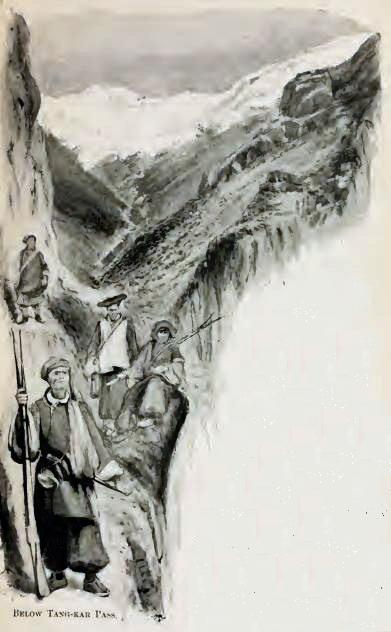 TIBET, the mystic Land of the Grand Lāma, joint God and King of many Millions, is still the most impenetrable country in the world. Behind its icy barriers, reared round it by Nature herself, and almost insurmountable, its priests guard its passes jealously against foreigners Few Europeans have ever entered Tibet; and none for half a century have reached the sacred city. Of the travellers of later times who have dared to enter this dark land, after scaling its frontiers and piercing its passes, and thrusting themselves into its snow-swept deserts, even the most intrepid have failed to penetrate farther than the outskirts of its central province.And the information, thus perilously gained, has, with the exception of Mr. Rockhill’s, been almost entirely geographical, leaving the customs of this forbidden land still a field for fiction and romance.
TIBET, the mystic Land of the Grand Lāma, joint God and King of many Millions, is still the most impenetrable country in the world. Behind its icy barriers, reared round it by Nature herself, and almost insurmountable, its priests guard its passes jealously against foreigners Few Europeans have ever entered Tibet; and none for half a century have reached the sacred city. Of the travellers of later times who have dared to enter this dark land, after scaling its frontiers and piercing its passes, and thrusting themselves into its snow-swept deserts, even the most intrepid have failed to penetrate farther than the outskirts of its central province.And the information, thus perilously gained, has, with the exception of Mr. Rockhill’s, been almost entirely geographical, leaving the customs of this forbidden land still a field for fiction and romance.
View into S.W. Tibet (from Tang-kar La Pass, 16,600ft.).
1 The Few Europeans who have penetrated Central Tibet have mostly been Roman missionaries. The first European to reach Lhāsa seems to have been Friar Odoric, of Pordenne, about 1330 A.D. on his return from Cathay (Col. Yule’s “Cathay and the Road Thither”,I,149; and C. Markham’s Tibet, xlvi.). The capital city of Tibet referred to by him with its “Abassi ” or Pope is believed to have been Lhāsa. In 1661 the Jesuits Albert Dorville and Johann Gruher visited Lhāsa on their way from China to India.
In 1706 the Capuchine Fathers Josepho de Asculi and Francisco Marie de Toun penetrated to Lhāsa from Bengal, in 1716 the Jesuit Desideri reached it From Kashmir and Ladāk. In 1741 a Capuchine mission under Horacio de la Penna also succeeded in getting there, and the large amount of information collected by them supplied Father A. Giorgi with this material for his Alphabetum Tibetanum, published at Rome in 1762.
The friendly reception accorded this party created hopes of Lhāsa becoming a centre For Roman missionaries; and a Vicar apostolicus for Lhāsa is still nominated and appears in the “Annuario pontificio,” though of course he cannot reside within Tibet. In l81l Lhāsa was reached by Manning, a Friend of Charles Lamb, and the only Englishman who seems ever to have got there; For most authorities are agreed that Moorcroft, despite the story told to M, Hue, never reached it. But Manning unfortunately left only a whimsical diary, scarcely even descriptive of his fascinating adventures. The subsequent, and the last, Europeans to reach Lhāsa were the Lazarist missionaries, Hue and Gabet, in 1845. Hue’s entertaining account of his journey is well known. He was soon expelled, and since then China has aided Tibet in opposing foreign ingress by strengthening its political and military barriers, as recent explorers : Prejivalskj , Rockhill, Bonvalot, Bower, Miss Taylor, etc, have found to their cost; though some are sanguine that the Sikhim Trade Convention of this year (1894)is probably the thin edge of the wedge to open up the country, and that no distant date Tibet will be prevailed on to relax its jealous exclusiveness, so that, ‘ere 1900, even Cook’s tourists may visit the Lāmaist Vatican.
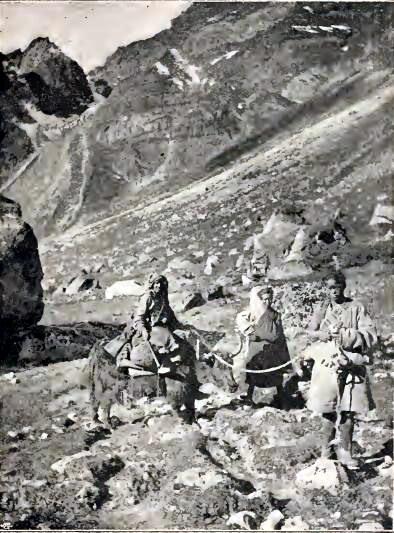 Captain of the Guard of DONGXYA PASS. (S.-Western Tibet.) ; Thus we are told that, amidst the solitudes of this ” Land of the Supernatural ” repose the spirits of ” The Masters,” the Mahātmas, whose astral bodies slumber in unbroken peace, save when they condescend to work some petty miracle in the world below. In presenting here the actualities of the cults and customs of Tibet ; and lifting higher than before the veil which still hides its mysteries from European eyes, the subject may be viewed under the following sections: — a. Historical. The changes in primitive Buddhism leading to Lāmaism, and the origins of Lāmaism and its sects. b. Doctrinal. The metaphysical sources of the doctrine. The doctrine and its morality and literature. c. Monastic. The Lāmaist order. Its curriculum, daily life, dress, etc., discipline, hierarchy and incarnate-deities and reembodied saints. d. Buildings. Monasteries, temples, monuments, and shrines. e. Pantheon and Mythology, including saints, images. fetishes, and other sacred objects and symbols. f. Ritual and Sorcery, comprising sacerdotal services for the laity ,astrology, oracles and divination, charms and necromancy. g. Festivals and Sacred Plays, with the mystic plays and masquerades. h. Popular and Domestic Lāmaism in every-day life, customs, and folk-lore. Such an exposition will afford us a fairly full and complete survey of one of the most active, and least known, forms of existing Buddhism; and will present incidentally numerous other topics of wide and varied human interest. For Lāmaism is, indeed, a microcosm of the growth of religion and myth among primitive people; and in large degree an object -lesson of their advance from barbarism towards civilization. And it preserves for us much of the old-world lore and petrified beliefs of our Aryan ancestors.
Captain of the Guard of DONGXYA PASS. (S.-Western Tibet.) ; Thus we are told that, amidst the solitudes of this ” Land of the Supernatural ” repose the spirits of ” The Masters,” the Mahātmas, whose astral bodies slumber in unbroken peace, save when they condescend to work some petty miracle in the world below. In presenting here the actualities of the cults and customs of Tibet ; and lifting higher than before the veil which still hides its mysteries from European eyes, the subject may be viewed under the following sections: — a. Historical. The changes in primitive Buddhism leading to Lāmaism, and the origins of Lāmaism and its sects. b. Doctrinal. The metaphysical sources of the doctrine. The doctrine and its morality and literature. c. Monastic. The Lāmaist order. Its curriculum, daily life, dress, etc., discipline, hierarchy and incarnate-deities and reembodied saints. d. Buildings. Monasteries, temples, monuments, and shrines. e. Pantheon and Mythology, including saints, images. fetishes, and other sacred objects and symbols. f. Ritual and Sorcery, comprising sacerdotal services for the laity ,astrology, oracles and divination, charms and necromancy. g. Festivals and Sacred Plays, with the mystic plays and masquerades. h. Popular and Domestic Lāmaism in every-day life, customs, and folk-lore. Such an exposition will afford us a fairly full and complete survey of one of the most active, and least known, forms of existing Buddhism; and will present incidentally numerous other topics of wide and varied human interest. For Lāmaism is, indeed, a microcosm of the growth of religion and myth among primitive people; and in large degree an object -lesson of their advance from barbarism towards civilization. And it preserves for us much of the old-world lore and petrified beliefs of our Aryan ancestors. 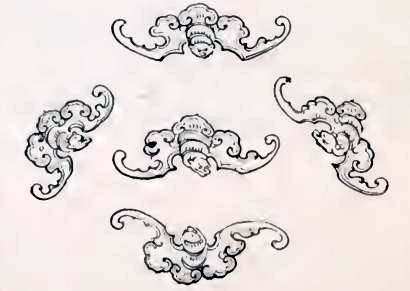
CHANGES IN PRIMITIVE BUDDHISM LEADING TO LĀMAISM.
” Ah ! Constantine, of how much ill was cause,
Not thy conversion, but those rich domains
That the first wealthy Pope received of thee.” 1
TO understand the origin of Lāmaism and its place in the Buddhist system, we must recall the leading features of primitive Buddhism, and glance at its growth, to see the points at which the strange creeds and cults crept in, and the gradual crystallization of these into a religion differing widely from the parent system, and opposed in so many ways to the teaching of Buddha. 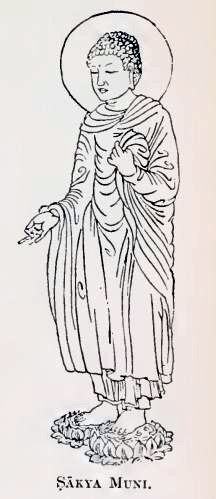 No one now doubts the historic character of Siddhārta Gautama, or Sākya Muni, the founder of Buddhism ;though it is clear the canonical accounts regarding him are overlaid with legend, the fabulous addition of after days. 2 Divested of its embellishment, the simple narrative of the Buddha’s life is strikingly noble and human. Some time before the epoch of Alexander the Great, between the fourth and fifth centuries before Christ, 3Prince Siddharta appeared in India as an original thinker and teacher, deeply conscious of the degrading thraldom of caste and the priestly tyranny of theBrāhmans
No one now doubts the historic character of Siddhārta Gautama, or Sākya Muni, the founder of Buddhism ;though it is clear the canonical accounts regarding him are overlaid with legend, the fabulous addition of after days. 2 Divested of its embellishment, the simple narrative of the Buddha’s life is strikingly noble and human. Some time before the epoch of Alexander the Great, between the fourth and fifth centuries before Christ, 3Prince Siddharta appeared in India as an original thinker and teacher, deeply conscious of the degrading thraldom of caste and the priestly tyranny of theBrāhmans
1. Dante, Paradiso, XX. (Milton’s trans.) 2 See Chapter V. for details of the gradual growth of the legends.3 See Chronological Table, Appendix i.
1 and profoundly impressed with the pathos and struggle of Life, and earnest in the search of some method of escaping from existence which was clearly involved with sorrow. His touching renunciation of his high estate,2 of his beloved wife, and child. and home, to become an ascetic, in order to master the secrets of deliverance from sorrow; his unsatisfying search for truth amongst the teachers of his time ; his subsequent austerities and severe penance, a much-vaunted means of gaining spiritual insight; his retirement into solitude and self-communion; his last struggle and final triumph — latterly represented as a real material combat, the so-called “Temptation of Buddha”: — 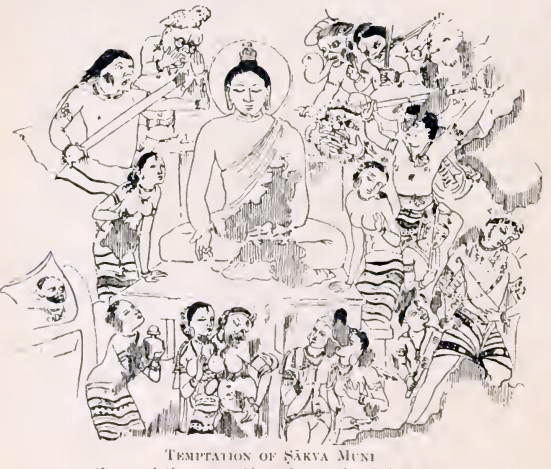
(from a sixth century Ajanta fresco, after Raj. Mitral.)
1 The treatises on Vedic ritual, called the Brahmanas, had existed for about three centuries previous to Buddha’s epoch, according to Max Muller’s Chronology [ Hibbert Lectures.1891,p58] the initial dates there given are Rig Veda, tenth century B.C. ; Brahmanas, eighth century B.C; Sutra sixth, and Buddhism fifth century B.C.
2 The researches of Vasiliev, etc., render it probable that Siddhartha’s father was only a petty lord or chief (cf. also OLDENBURG’S Life, Appendix), and that Sakya’s pessimistic view of Life may have been forced upon him by the loss of his territories through conquest by a neighbouring king,
3.Milton’s Paradise Regained, Book IV
his reappearance, confident that he had discovered the secrets of deliverance ; his carrying the good tidings of the truth from town to town; his effective protest against the cruel sacrifices of the Brahmans, and his relief of much of the suffering inflicted upon helpless animals and often human beings, in the name of religion ; his death, full of years and honours, and the subsequent 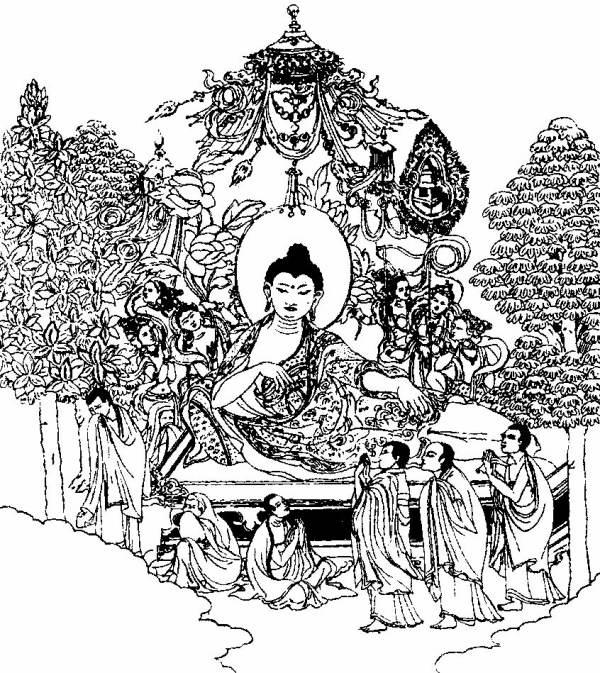
Buddha’s Death (from a Tibetan picture, after Grunwedel).
burial of his relics,— all these episodes in Buddha’s life are familiar to English readers in the pages of Sir Edwin Arnold’s Light of Asia, and other works. His system, which arose as a revolt against the one-sided development of contemporary religion and ethics, the caste-debasement of man and the materializing of God, took the form, as we shall see, of an agnostic idealism, which threw away ritual and sacerdotalism altogether. Its tolerant creed of universal benevolence, quickened by the bright example of a pure and noble life, appealed to the feelings of the people with irresistible force and directness, and soon gained for the new religion many converts in the Ganges Valley. And it gradually gathered a brotherhood of monks, which after Buddha’s death became subject to a succession of “Patriarchs,” 1 who, however, possessed little or no centralized hierarchical power, nor, had at least the earlier of them, any fixed abode. About 250 B.C. it was vigorously propagated by the great Emperor Asoka, the Constantine of Buddhism, who, adopting it as his State-religion, zealously spread it throughout his own vast empire, and sent many missionaries into the adjoining lands to diffuse the faith. Thus was it transported to Burma, 2 Siam, Ceylon, and other islands on the south, to Nepal 3 and the countries to the north of India, Kashmir, Bactria, Afghanistan, etc.
l The greatest of all Buddha’s disciples, Ṣāriputra and Mandgalyayāna, who from their prominence in the system seem to have contributed materially to its success,having died before their master , the first of the patriarchs was the senior surviving disciple, Mahākāṣyapa. As several of these Patriarchs are intimately associated with the Lāmaist developments, I subjoin a list of their names, taken from the Tibetan canon and Tāranātha’s history, supplemented by some dates from modern sources.After Nāgārjuna, the thirteenth (or according to some the fourteenth) patriarch, the succession is uncertain.
List of the Patriarchs.
1. Mahākāṣyapa, Buddha’s senior disciple
2. Ananda, Buddha’s cousin and favourite attendant.
3. Ṣaṇāvāsu.
4. Upagupta, the spiritual adviser of Asoka,250 B.C
5. Dhṛiṭaka.
6. Micchaka or Bibhakala.
7. Buddhananda.
8. Buddhamitra (=? Vasumitra, referred to as president of Kanishka’a Council).
9. Pārṣva, contemporary of Kanishka, circa 78 CE.
10. Suṇaṣata (? or Puṇyayaṣas).
11. Aṣvaghosha, also contemporary of Kanishika circa 100 CE.
12. Maṣipala (Kapimala).
13. Nāgārjuna, ཀླུ་སྒྲུབ་ klu sgrub, circa 150-250 CE
14. Deva or Kānadeva.
15. Rāhulata (?).
16. Saṅghanandi.
17. Saṅkhayaseta
18. Kumarada.
19. Jayata.
20. Vasubandhu, circa 400 CE.
21. Manura.
22. Haklenayaṣas.
23. Siṅhalaputra.
24. Vaṣasuta.
25. Puṇyamitra.
26. Prajñatāra.
27. Bodhidharma, who visited China by sea in 526 CE.
2 By SONA and UTTARO (Mahavamso p. 71). 3 BUCHANAN-HAMILITON (acct. of Nepal, p.190) gives dates of introduction as A.D.33; probably this was its reintroduction. 4. During the reign of the Emperor Ming Ti . BEAL (Budd.in China, p 58) gives date of introduction as 71 A.D
___________________________
in the sixth century A.D., to Japan, taking strong hold on all of the people of these countries, though they were very different from those among whom it arose, and exerting on all the wilder tribes among them a very sensible civilizing influence. It is believed to have established itself at Alexandria. 1 And it penetrated to Europe, where the early Christians had to pay tribute to the Tartar Buddhist Lords of the Golden Horde ; and to the present day it still survives in European Russia among the Kalmaks on the Volga, who are professed Buddhists of the Lāmaist order. Tibet, at the beginning of the seventh century, though now surrounded by Buddhist countries, knew nothing of that religion, and was still buried in barbaric darkness. Not until about the year 640 A.D., did it first receive its Buddhism, and through it some beginnings of civilization among its people. But here it is necessary to refer to the changes in Form which Buddhism meanwhile had undergone in India. Buddha, as the central figure of the system, soon became invested with supernatural and legendary attributes. And as the religion extended its range and influence, and enjoyed princely patronage and ease, it became more metaphysical and ritualistic, so that heresies and discords constantly cropped up, tending to schisms, for the suppression of which it was found necessary to hold great councils. Of these councils the one held at Jalandhar, in Northern India, towards the end of the first century A.D., under the auspices of the Scythian King Kanishka, of Northern India, was epoch-making, for it established a permanent schism into what European writers have termed the ” Northern ” and ” Southern ” Schools : the Southern being now represented by Ceylon, Burma, and Siam ; and the Northern by Tibet, Sikhim, Bhutan, Nepal, Ladāk, China, Mongolia, Tartary, and Japan. This division, however, it must be remembered, is unknown to the Buddhists themselves, and is only useful to denote in a rough sort of way the relatively primitive as distinguished from the developed or mixed forms of the faith, with especial reference to their present-day distribution.
1 The Mahāvanso (Turnour’s ed.,p.171) notes that 30,000 Bhikshus, or Buddhist monks, came from “Alasadda,” considered to be Alexandria.
The point of divergence of these so-called “Northern” and “Southern” Schools was the theistic- Mahāyāna doctrine, which substituted for the agnostic idealism and simple morality of Buddha, a speculative theistic system with a mysticism of sophistic nihilism in the background. Primitive Buddhism practically confined its salvation to a select few; but the Mahayana extended salvation to the entire universe. Thus, from its large capacity as a ” Vehicle ” for easy, speedy, and certain attainment of the state of a Bodhisattva or potential Buddha, and conveyance across the sea of life (saṃsāra) to Nirvāṇa, the haven of the Buddhists, its adherents called it “The Great Vehicle” or Mahāyāna ; l while they contemptuously called the system of the others— the Primitive Buddhists, who did not join this innovation — ” The Little or Imperfect Vehicle,” the Hinayāna,2 which could carry so few to Nirvāṇa, and which they alleged was only fit for low intellects. This doctrinal division into the Mahāyāna and Hinayāna, however, does not quite coincide with the distinction into the so-called Northern and Southern Schools; for the Southern School shows a considerable leavening with Mahāyāna principles,3 and Indian Buddhism during its most popular period was very largely of the Mahāyāna type. Who the real author of the Mahāyāna was is not yet known. The doctrine seems to have developed within the Mahā-saṅghika or “Great Congregation” — a heretical sect which arose among the monks of Vaisāli, one hundred years after Buddha’s death, and at the council named after that place. 4 Aṣvaghosha, who appears to have lived about the latter end of the first century CE., is credited with the authorship of a work entitled On raising Faith in the Mahāyāna. 5 But its chief expounder and developer was Nāgārjuna, who was probably a pupil of Aṣvaghosha, as he ____________________________
1 The word Yāna, (Tib., Teg-pa ch’en-po) or “Vehicle” is parallel to the Platonic δχμηα, is noted by BEAL in Catena, p.124. 2 Tib., Teg-pa dman-pa.3 Cf. HIUEN TSIANG’S Si-yu Ki (Beal’s), ii., p.133; EITEL, p. 90; Dharmapāla in Mahā bodhi Jour., 1892; Taw Sein Ko, Ind. Antiquary, June, 1892. 4 The orthodox members of this council formed the sect called Sthaviras or “elders.” 5 He also wrote a biography of Buddha, entitled Buddha-Carita Kārya, translated by Cowell, in S.B.E. It closely resembles the Lalita Vistara, and a similar epic was brought to China as early as 70 A.D. (Beal’s Chinese Buddhism, p. 90). He is also credited with the authorship of a clever confutation of Brāhmanism, which was latterly entitled Vajra Sūci (Cf. Hodgs., III., I27).
___________________________
followed the successor of the latter in the patriarchate. He could not, however, have taken any active part in Kanishka’s Council, as the Lāmas believe. Indeed, it is doubtful even whether he had then been born. 1 Nāgārjuna claimed and secured orthodoxy for the Mahāyāna doctrine by producing an apocalyptic treatise which he attributed to Sākya Muni, entitled the Prajñāpāramitā, or ” the means of arriving at the other side of wisdom,” a treatise Which he alleged the Buddha Nāgārjuna
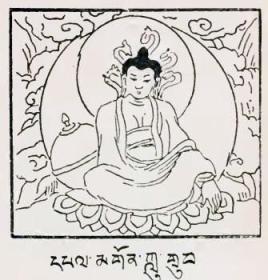 had himself composed, and had hid away in the custody of the Nāga demigods until men were sufficiently enlightened to comprehend so abstruse a system. And, as his method claims to be a compromise between the extreme views then held on the nature of Nirvāṇa,it was named the Mādhyamika, or the system “of the Middle Path.” 2 This Mahayana doctrine was essentially a sophistic nihilism ; and under it the goal Nirvāṇa, or rather Pari- Nirvāṇa, while ceasing to be extinction of Life, was considered a mystical state which admitted of no definition.By developing the supernatural side of Buddhism and its objective symbolism, by rendering its
had himself composed, and had hid away in the custody of the Nāga demigods until men were sufficiently enlightened to comprehend so abstruse a system. And, as his method claims to be a compromise between the extreme views then held on the nature of Nirvāṇa,it was named the Mādhyamika, or the system “of the Middle Path.” 2 This Mahayana doctrine was essentially a sophistic nihilism ; and under it the goal Nirvāṇa, or rather Pari- Nirvāṇa, while ceasing to be extinction of Life, was considered a mystical state which admitted of no definition.By developing the supernatural side of Buddhism and its objective symbolism, by rendering its
1 Nāgārjuna(T., kLu-grub.) appears to belong to the second century CE. He was a native of Vidarbha (Berar) and a monk of Nālanda, the headquarters of several of the later patriarchs. He is credited by the Lāmas (J.A.S.B., 1882, 115) with having erected the stone railing round the great Gandhola Temple of “Budh Gāya,” though the style of the lithic inscriptions on these rails would place their date earlier. For a biographical note from the Tibetan by H. Wenzel, see .J. Pali Text Soc., 1880, p. 1, also by Sarat, J.A.S.B;., 51, pp. l and 115. The vernacular history of Kashmīr (Rājatāranginī) makes him a contemporary and chief monk of Kanishka’s successor, King Abhimanyu (cf. also Eitel, p. 103; Schl., 21, 301-3; Kopp., ii., 14 ; O.M., 107, 2; Csoma, Gr., xii., 182).
2 It seems to have been a common practice for sectaries to call their own system by this title, implying that it only was the true or reasonable belief. Sākya Muni also called his system “the Middle Path*’ (Davids, p. 47). claiming in his defense of truth to avoid the two extremes (of superstition on the one side, and worldliness or infidelity on the other. Comp. the Via media of the Anglican Oxford movement.
salvation more accessible and universal, and by substituting good words for the good deeds of the earlier Buddhists, the Mahāyāna appealed more powerfully to the multitude and secured ready popularity. About the end of the first century of our era, then, Kanishka’s Council affirmed the superiority of the Mahāyāna system, and published in the Sanskrit language inflated versions of the Buddhist Canon, from sources for the most part independent of the Pāli versions of the southern Buddhists, though exhibiting a remarkable agreement with them. 1 And this new doctrine supported by Kanishka, who almost rivaled Asoka in his Buddhist zeal and munificence, became a dominant form of Buddhism throughout the greater part of India ; and it was the form which first penetrated, it would seem, to China and Northern Asia.Its idealization of Buddha and his attributes led to the creation of metaphysical Buddhas and celestial Bodhisattva s, actively willing and 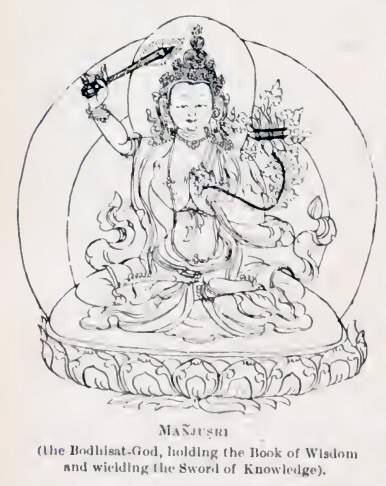 able to save, and to the introduction of innumerable demons and deities as objects of worship, with their attendant idolatry and sacerdotalism, both of which departures Buddha had expressly condemned. The gradual growth of myth and legend, and of the various set in, are sketched in theistic developments which now detail in another chapter.
able to save, and to the introduction of innumerable demons and deities as objects of worship, with their attendant idolatry and sacerdotalism, both of which departures Buddha had expressly condemned. The gradual growth of myth and legend, and of the various set in, are sketched in theistic developments which now detail in another chapter.
As early as about the first century CE., Buddha is made to be existent from all eternity and without beginning And one of the earliest forms given to the Greatest of these metaphysical Buddhas — Amitābha, The Buddha of Boundless Light
1. Several of the Chinese and Japanese Scriptures are translated from the Pāli in BEAL’s Buddhism in China p.50 and also a few Tibetan (Cf. Chap.VII)
— evidently incorporated a Sun-myth, as was indeed to be expected where the chief patrons of this early Mahāyāna Buddhism, the Scythian s and In-do-Persians, were a race of Sun-worshippers. The worship of Buddha’s own image seems to date from this period, the first century of our era, and about four or five centuries after Buddha’s death ;1 and it was followed by a variety of polytheistic forms, the creation of which was probably facilitated by the Grecian Art influences then prevalent in Northern India.2 The worship of Buddha’s own image seems to date from this period, the first century of our era, and about four or five centuries after Buddha’s death ;1 and it was followed by a variety of polytheistic forms, the creation of which was probably facilitated by the Grecian Art influences then prevalent in Northern India.2 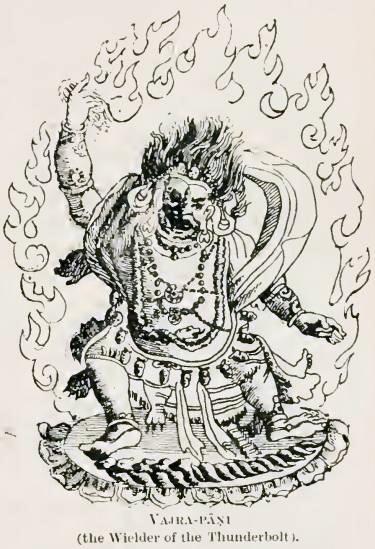 Different forms of Buddha’s image, his life, were afterwards idealized into originally intended to represent different epochs in various Celestial Buddhas, from whom the human Buddhas were held to be derived as material reflexes. About 500 CE. 3 arose the next great Development in Indian Buddhism with the importation into it of the pantheistic cult of Yoga, or the ecstatic union of the individual with the Universal Spirit, a cult which had been introduced into Hinduism by Patanjali about 150 B.C. Buddha himself had attached much importance to the practice of
Different forms of Buddha’s image, his life, were afterwards idealized into originally intended to represent different epochs in various Celestial Buddhas, from whom the human Buddhas were held to be derived as material reflexes. About 500 CE. 3 arose the next great Development in Indian Buddhism with the importation into it of the pantheistic cult of Yoga, or the ecstatic union of the individual with the Universal Spirit, a cult which had been introduced into Hinduism by Patanjali about 150 B.C. Buddha himself had attached much importance to the practice of
VAJRA-PĀṆI(the Wielder of the Thunderbolt )
1.Cf. statue of Buddha found at Ṣrvāsti, Cunningham’s Stupa of Barhut, p. vii. So also in Christianity, Archdeacon Farrar, in his recent lecture on “The Development of Christian Art.” states that for three centuries there were no pictures of Christ, but only symbols, such as the fish, the lamb, the dove.The catacombs of St. Callistus contained the first picture of Christ, the date being 313. Not even a cross existed in the early catacombs, and still less a crucifix. The eighth century saw the first picture of the dead Christ. Rabulas in 586 first depicted the crucifixion in a Syriac Gospel. 2 SMITH’s Greco-Roman infl. on Civilization of Ancient India, J. A. S.B., 58 et seq.. 1889, and GRUNWEDEL’s Buddh. Kunst. 3 The date of the author of this innovation, Asaṅga, the brother of Vasubandhu,
abstract meditation among-st his followers; and such practices under the mystical and later theistic developments of his system, readily led to the adoption of the Brāhmanical cult of Yoga, which was grafted on to the theistic Mahāyāna by Asaṅga, a Buddhist monk of Grandhārā (Peshawar), in Northern India. Those who mastered this system were called Yogācārya Buddhists. The Yogācārya mysticism seems to have leavened the mass of the Mahāyāna followers, and even some also of the Hinayāna; for distinct traces of Yoga are to be 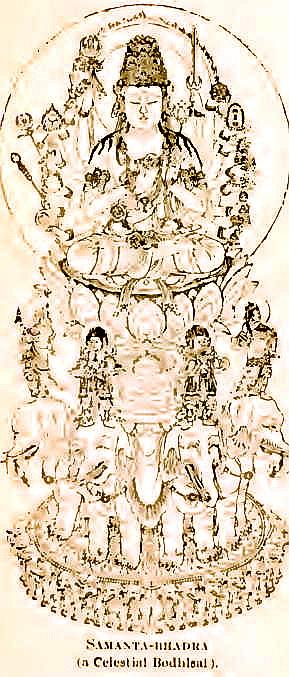 found in modern Burmese and Ceylonese Buddhism. And this Yoga parasite, containing within itself the germs of Tantrism, seized strong hold of its host and soon developed its monster outgrowths, which crushed and cankered most of the little life of purely Buddhist stock yet Left in the Mahāyāna. About the end of the sixth century CE., Tantrism or Ṣivaic mysticism, with its worship of female energies, spouses of the Hindū god Ṣiva, began to tinge both Buddhism and Hindūism. Consorts were allotted to the several Celestial Bodhisattva and most of the other gods and demons, and most of them were given forms wild and terrible, and often monstrous, according to the supposed moods of each divinity at different times. And as these goddesses and fiendesses were bestowers of supernatural power, and were especially malignant, they were especially worshipped. By the middle of the seventh century CE., India contained many images of Divine Buddhas and Bodhisats with their female energies and other Buddhist gods and demons, as we know from Hiuen Tsiang’s narrative and the lithic remains in India; 1 and the growth of myth and ceremony had invested the dominant form of Indian Buddhism with organised litanies and full ritual.
found in modern Burmese and Ceylonese Buddhism. And this Yoga parasite, containing within itself the germs of Tantrism, seized strong hold of its host and soon developed its monster outgrowths, which crushed and cankered most of the little life of purely Buddhist stock yet Left in the Mahāyāna. About the end of the sixth century CE., Tantrism or Ṣivaic mysticism, with its worship of female energies, spouses of the Hindū god Ṣiva, began to tinge both Buddhism and Hindūism. Consorts were allotted to the several Celestial Bodhisattva and most of the other gods and demons, and most of them were given forms wild and terrible, and often monstrous, according to the supposed moods of each divinity at different times. And as these goddesses and fiendesses were bestowers of supernatural power, and were especially malignant, they were especially worshipped. By the middle of the seventh century CE., India contained many images of Divine Buddhas and Bodhisats with their female energies and other Buddhist gods and demons, as we know from Hiuen Tsiang’s narrative and the lithic remains in India; 1 and the growth of myth and ceremony had invested the dominant form of Indian Buddhism with organised litanies and full ritual.
Such was the distorted form of Buddhism introduced into Tibet about 640 CE. ; and during the three or four succeeding centuries Indian Buddhism became still more debased. Its mysticism became a silly mummery of unmeaning jargon and ” magic circles,” dignified by the title of Mantrāyāna or “The Spell- Vehicle”; and this so-called ” esoteric,” but properly” exoteric,” cult
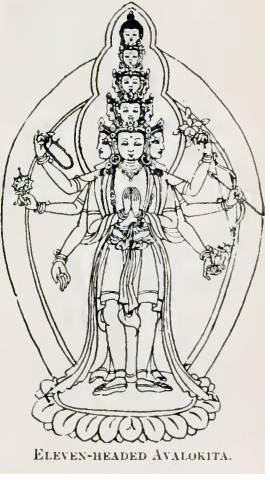 was given a respectable antiquity by alleging that its real founder was Nāgārjuna,who had received it from the Celestial Buddha Vairocana through the divine Bodhisat Vajrasattva at “the iron tower ” in Southern India. In the tenth century CE,’ 2 the Tantrik phase developed in Northern India, KashmĪr, and Nepal, into the monstrous and polydemonist doctrine, the Kālacākra,3 with its demoniacal Buddhas, which incorporated the Mantrāyāna practices, and called itself the Vajra-yāna, or “The Thunderbolt-Vehicle,” and its followers were named Vajrācārya, or ” Followers of the Thunderbolt”
was given a respectable antiquity by alleging that its real founder was Nāgārjuna,who had received it from the Celestial Buddha Vairocana through the divine Bodhisat Vajrasattva at “the iron tower ” in Southern India. In the tenth century CE,’ 2 the Tantrik phase developed in Northern India, KashmĪr, and Nepal, into the monstrous and polydemonist doctrine, the Kālacākra,3 with its demoniacal Buddhas, which incorporated the Mantrāyāna practices, and called itself the Vajra-yāna, or “The Thunderbolt-Vehicle,” and its followers were named Vajrācārya, or ” Followers of the Thunderbolt”
1 See my article on Uren, J.A.S.B., 1891, and on Indian Buddhist Cult, etc., in J.R.A.S., 1894, p. 51 et seq. 2 About 965 CE. (CS0MA, Gr., p. 192). 3 Tib., ‘Dus-Kyi-‘K’or-lo, or Circle of Time , see Chap. vi. It is ascribed to the fabulous country of Sambhala (T., De-juṅ) to the North of India, a mythical country probably founded upon the Northern land of St. Padma-Sambhava, to wit Udyāna,
In these declining days of Indian Buddhism, when its spiritual and regenerating influences were almost dead, the Muhammadan invasion swept over India, in the latter end of the twelfth century CE., and effectually stamped Buddhism out of the country. The fanatical idol-hating Afghan soldiery 1 especially attacked the Buddhist monasteries, with their teeming idols, and they massacred the monks wholesale;2 –
NĀRO (an Indian Buddhist Vajrācārya Monk of the Eleventh Century CE.).
and as the Buddhist religion, unlike the more domestic Brāhmanism, is dependent on its priests and monks for its vitality, it soon disappeared in the absence* of these latter. It lingered only for a short rime longer in the more remote parts of the peninsula, to which the fiercely fanatical Muhammadans could not readily penetrate. 3 But it has now been extinct in India for several centuries, leaving, however, all over that country, a legacy of gorgeous architectural remains and monuments of decorative art, and its
l See article by me in J.A.S.B., LXVI., 1892, p. 20 et seq., illustrating this fanaticism and massacre with reference to Magadha and Asam. 2 Tabaqat-i-Nāsiri, Elliot’s trans., ii., 306, etc. 3 Tāranātha – says it still existed in Bengal till the middle of the fifteenth century CE., under the ” Chagala ” Raja, whose kingdom extended to Delhi and who was converted to Buddhism by his wife Be died in 1448 CE., and Prof. Bendall finds (Cat.Buddh.Skt. MSS. intr.p. iv)that Buddhist MSS. were copied in Bengal up to the middle of the fifteenth century, namely, to 1446. Cf. also his note in J.R.A.S.,New Series.,XX., 552, and mine in J.A.S.B. (Proc), February, 1893
living effect upon its apparent offshoot Jainism, and upon Brāhmanism, which it profoundly influenced for good. Although the form of Buddhism prevalent in Tibet, and which has been called after its priests ” Lāmaism,” is mainly that of the mystical type, the Vajra-yāna, curiously incorporated with Tibetan mythology and spirit-worship, still it preserves there, as we shall see, much of the loftier philosophy and ethics of the system taught by Buddha himself. And the Lāmas have the keys to unlock the meaning of much of Buddha’s doctrine, which has been almost inaccessible to Europeans.
1 From a photograph by Mr. Hoffman
III. RISE, DEVELOPMENT, AND SPREAD OF LĀMAISM.
TIBET emerges from barbaric darkness only with the dawn of its Buddhism, in the seventh century of our era. Tibetan history, such as there is — and there is none at all before its Buddhist era, nor little worthy of the name till about the eleventh century A..D. — is fairly clear on the point that previous to King Sron Tsan Gampo’s marriage in 638-641 CE., Buddhism was quite unknown in Tibet. 1 And it is also fairly clear on the point that Lāmaism did not arise till a century later than this epoch. Up till the seventh century Tibet was inaccessible even to the Chinese. The Tibetans of this prehistoric period are seen, from the few glimpses that we have of them in Chinese history about the end of the sixth century, 2 to have been rapacious savages and reputed cannibals, without a written language, 3 and followers of an animistic and devil-dancing or Shamanist religion, the Bön, resembling in many ways the Taoism of China.Early in the seventh century, when Muhammad (” Mahomet “) ________________
1 The historians so-called of Tibet wrote mostly inflated bombast, almost valueless for historical purposes. As the current accounts of the rise of Buddhism in Tibet are so overloaded with legend, and often inconsistent, I have endeavoured to sift out the more positive data from the mass of less trustworthy materials. I have looked into the more disputed historical points in the Tibetan originals, and, assisted by the living traditions of the Lāmas, and the translations provided by Rockhill and Bushell especially, but also by Schlagintweit, Sarat, and others, 1 feel tolerably confident that as regards the questions of the mode and date of the introduction of Buddhism into Tibet, and the founding of Lāmaism, the opinions now expressed are in the main correct.
The accounts of the alleged Buddhist events in prehistoric Tibet given in the Maṇi-Kāh-‘bum, Gyal-rabs, and other legendary books, are clearly clumsy fictions. Following the example of Burma and other Buddhist nations (cf. Hiuen Tsiang, Julien’s trans., i., 179 ; ii., 107, etc.) who claim for their King an ancestry from the Sākya stock, we find the Lāmas foisting upon their King a similar descent. A mythical exiled prince, named gNah-K’ri-b Tsan-po, alleged to be the son of King Prasenjit, Buddha’s first royal patron, and a member of the Licchavi branch of the Ṣākya tribe, is made to enter Tibet in the fifth century B.C. as the progenitor of a millennium of Sroṅ Tsan Gampo’s ancestors; and an absurd story is invented to account for the etymology of his name, which means “the back chair”; while the Tibetan people are given as progenitors a monkey (” Hilumandju,” evidently intended for Hanumānji, the Hindu monkey god, cf. Rock., LL., 355) sent by Avalokiteṣwara and a rakshasi fiendess. Again, in the year 331 CE, there fell from heaven several sacred objects (conf. Rock., B., p. 210), including the Om mani formula, which in reality was not invented till many hundred (probably a thousand) years later. And similarly the subsequent appearance of five foreigners before a King, said to have been named T’o-t’ori Ñyan-tsan, in order to declare the sacred nature of the above symbols, without, however, explaining them, so that the people continued in ignorance of their meaning. And it only tends still further to obscure the points at issue to import into the question, as Lassen does (Ind. Alt., ii., 1072), the alleged erection on Mt. Kailās, in 137 B.C, of a temporary Buddhist monastery, for such a monastery must have belonged to Kashmir Buddhism, and could have nothing to do with Tibet, 2 Bushell, loc. cit, p. 435. They used knotched wood and knotted cords (Remusat’s Researches, p. 384,
was founding his religion in Arabia, there arose in Tibet a warlike king, who established his authority over the other wild clans of central Tibet, and latterly his son, Sroṅ Tsan Gampo, 1 harassed the western borders of China; so that the Chinese Emperor T’aitsung, of the T’ang Dynasty, was glad to come to terms with this young prince, known to the Chinese as Ch’itsung-luntsan, and gave him in 641 CE. 2 the Princess 3 Wench’eng, of the imperial house, in marriage. 4 Two years previously Sroṅ Tsan Gampo had married Bhṛikuṭi, a daughter of the Nepal King, Aṃṣuvarman ; 5 and both of these wives being bigoted Buddhists, they speedily effected the conversion of their young husband, who was then, according ________________ 1 Called also, prior to his accession (says Rockhill, Life, p. 211) Khri-ldan Sroṅ -btsan (in Chinese, Ki-tsung hm-tsan). His father, g’Nam-ri Sroṅ -tsan, and his ancestors had their headquarters at Yar-luṅ, or “the Upper Valley,” below the Yar-lha sam-po, a mountain on the southern confines of Tibet, near the Bhutan frontier. The Yar-luṅ river flows northwards into the Tsang-po, below Lhāsa and near Samye. This Yar-luṅ is to be distinguished from that of the same name in the Kham province, east of Bathang, and a tributary of the Yangtse Kiang. The chronology by Bu-ton (t’am-c’ad K’an-po) is considered the most reliable, and Sum-pa K’an-po accepted it in preference to the Baidyur Kar-po, composed by the Dalai Lāma’s orders, by De-Srid Saṅ-gyas Gya-mts’o, in 1686. According to Bu-ton, the date of Sroṅ Tsan Gampo’s birth was 617 CE. (which agrees with that given by the Mongol historian, Sasnang Setzen), and he built the palace Pho-daṅ-Marpo on the Lhāsa hill when aged nineteen, and the Lhāsa Temple when aged twenty-three. He married the Chinese princess when he was aged nineteen, and he died aged eighty-two. The Chinese records, translated by Bushell, make him die early. Csoma’s date of 627 {Grammar, p. 183) for his birth appears to be a clerical error for 617. His first mission to China was in 634 (Bushell, J.R.A.S., New Ser., xii., p. 440). 2 According to Chinese annals (Bushell, 435), the Tibetan date for, the marriage is 639 (C, G.,p.183), that is, two years after his marriage with the Nepalese princess. 3 Kong-jo = “princess” in Chinese. 4 The Tibetan tradition has it that there were three other suitors for this princess’s hand, namely, the three greatest kings they knew of outside China, the Kings of Magadha, of Persia (sTag-zig), and of the Hor (Turki) tribes. See also Hodgson’s Ess. and Rockhill’s B., 213 ; (Csoma’s Gr., 196; Bodhimur, 338. 5 Aṃṣuvarman, or “Glowing Armour,” is mentioned by Hiuen Tsiang (Beal’s Ed. Si-yu-ki, ii-. p. 81) as reigning about 637, and he appears as a grantee in FLEET’s Corpus Insern. Ind. (iii., p. 190) in several inscriptions ranging from 635 to 650 a.d., from which it appears that he was of the Ṭhākurī dynasty and a feudatory of King of Harshavardhana of Kanauj, and on the death of the latter seems to have become independent. The inscriptions show that devi was a title of his royal ladies, and his 635 CE. inscription recording a gift to his nephew,a svāmin (an officer), renders it probable that he had then an adult daughter. One of his inscriptions relates to Sivaist lingas, but none are expressedly Buddhist. The inscription 635 was discovered by C. BENDALL. and published in Ind. Ant. for 1885, and in his Journey, pp. 13 and 73. Cf. also Ind. Ant., IX., 170, and his description of coins in Zeitchr. der Deutsch. to Tibetan annals, only about sixteen years of age, 1 and who, under their advice, sent to India, Nepal, and China for Buddhist books and teachers. 2 It seems a perversion of the real order of events to state, as is usually done in European books, that Sroṅ Tsan Gampo first adopted Buddhism, and then married two Buddhist wives. Even the vernacular chronicle, 3 which presents the subject in its most flattering form, puts into the mouth of Sroṅ Tsan Gampo, when he sues for the hand of his first wife, the Nepalese princess, the following words : ” I, the King of barbarous 4 Tibet, do not practise the ten virtues, but should you be pleased to bestow on me your daughter, and wish me to have the Law, 5 I shall practise the ten virtues with a five-thousand-fold body . . , though I have not the arts . . . if you so desire . . . I shall build 5,000 temples.” Again, the more reliable Chinese history records that the princess said ” there is no religion in Tibet “; and the glimpse got of Sroṅ Tsan in Chinese history shows him actively engaged throughout his life in the very un-Buddhist pursuit of bloody wars with neighbouring states. The messenger sent by this Tibetan king to India, at the instance of his wives, to bring Buddhist books was called Thonmi Sam-bhota. 6 The exact date of his departure and return are uncertain, 7 and although his Indian visit seems to have been within the period covered by Hiuen Tsiang’s account, this history makes no mention even of the country of Tibet, After a stay in India 8 of several years, during which Sam-bhota studied under the _____________
1 The Gyal-rabs Sel-wai Meloṅ states that S. was aged sixteen on his marriage with the Nepalese princess, who was then aged eighteen, and three years later’ he built his Pho daṅ-Marpo Palace on the Red Hill at Lhāsa. 2 The monks who came to Tibet during Sroṅ Tsan Gampo’s reign were Kusara (? Kumāra) and Saṅkara Brāhmana, from India ; Sila Mañju, from Nepal • Hwa shang Mahā-ts’e, from China, and (E.SCHLAGT., Gyal-rabs, p. 49) Tabuta and Ganuta from Kashmīr. 3 Mirror of Royal pedigree, Gyal-rabs Sel-wai Meloṅ. 4 mT’ah-‘k’ob. 5 K’rims. 6 Sambhota is the Sanskrit title for ” The good Bhotiya or Tibetan.” His proper name is Thon-mi, son of Anu. 7 632 CE. is sometimes stated as date of departure, and 650 as the return ; but on this latter date Sroṅ Tsan Gampo died according to the Chinese accounts, although he should survive for many (48) years longer, according to the conflicting Tibetan record. 8 “Southern India”(Bodimur; p. 327).
Brāhman Livikara or Lipidatta 1 and the pandit Devavid Siṅha (or Siṅha Ghosha), he returned to Tibet, bringing several Buddhist books and the so-called “Tibetan” alphabet, by means of which he now reduced the Tibetan language to writing and composed for this purpose a grammar. 2 This so-called “Tibetan” character, however, was merely a somewhat fantastic reproduction of the north Indian alphabet current in India at the time of Sam-bhota’s visit. It exaggerates the nourishing curves of the ” Kuṭila ” which was then coming into vogue in India, and it very slightly modified a few letters to adapt them to the peculiarities of Tibetan phonetics. 3 Thonmi translated into this new character several small Buddhist texts, 4 but he does not appear to have become a monk or to have attempted any religious teaching. Sroṅ Tsan Gampo , being one of the. greatest kings of Tibet and the first patron of learning and civilization in that country, and having with the aid of his wives first planted the germs of Buddhism in Tibetan soil, he is justly the most famous and popular king of the country, and latterly he was canonized as an incarnation of the most popular of the celestial Bodhisattvas, Avalokita ; and in keeping with this legend he is figured with his hair dressed up into a high conical chignon after the fashion of the Indian images of this Buddhist god, ” The Looking-down-Lord.” His two wives were canonized as incarnations of Avalokita’s consort, Tārā, “the Saviouress,” or Goddess of Mercy; and the fact that they bore him no children is pointed to as evidence of their divine nature. 5 The Chinese princess Wench’eng was deified
1 Li-byin = Li + “to give.” 2 sGrahi bstan bch’os sum ch’u-pa. 3 The cerebrals and aspirates not being needed for Tibetan sounds were rejected. And when afterwards the full expression of Sanskrit names in Tibetan demanded these letters, the live cerebrals were formed by reversing the dentals and the aspirates obtained by suffixing an h, -while the palato-sibilants ts, tsh, and ds were formed by adding a surmounting crest to the palatals ch, chh, and j. it is customary to say that the cursive style, the “headless” or U-med (as distinguished from the full form with the head the U-ch’en) was adapted from the sO-called “Wartu” form of Devanagri— Hodgson, As. Res.,XVI.,420; SCHMIDT, Mem. del’Ac.de Pet.,i.,41 ; CSOMA.Gr.,204 ; SARAT, J.A.S.B., 1888, 12. 4 The first book translated Seems to have been the Karanda-vyuha Sutra, a favourite in Nepal ; and a few other translations still extant in the Tan-gyur are ascribed to him (CSOMA, .A.. and ROCK.,B., 212. 5 His issue proceeded from two or four Tibetan wives.
as ” The white Tāra,” 1 as in the annexed figure ; while the Nepalese princess “Bri-bsun” said to be a corruption of Bhṛikuṭi,was apotheosised as the green Bhṛi-kuṭi Tāra, 2 as figured in the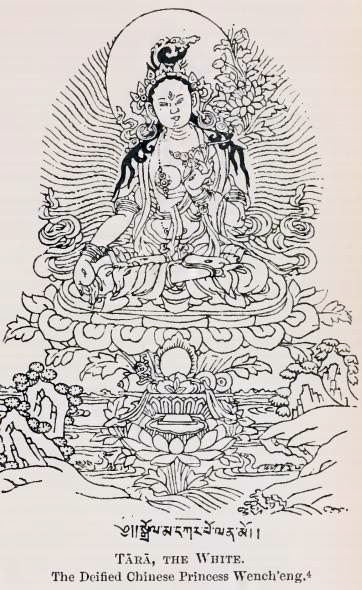 chapter on the pantheon. But he was not the saintly person the grateful Lāmas picture, for he is seen from reliable Chinese history to have been engaged all his life in bloody wars, and more at home in the battlefield than the temple. And he certainly did little in the way of Buddhist propaganda, beyond perhaps translating a few tracts into Tibetan, and building a few temples to shrine the images received by him in dower, 3 and others which he constructed. He built no monasteries. Tara, the White. The Deified Chinese Princess Wench’eng.4
chapter on the pantheon. But he was not the saintly person the grateful Lāmas picture, for he is seen from reliable Chinese history to have been engaged all his life in bloody wars, and more at home in the battlefield than the temple. And he certainly did little in the way of Buddhist propaganda, beyond perhaps translating a few tracts into Tibetan, and building a few temples to shrine the images received by him in dower, 3 and others which he constructed. He built no monasteries. Tara, the White. The Deified Chinese Princess Wench’eng.4
1 E. Schlagintweit (p. 66) transposes the forms of the two princesses, and most subsequent writers repeat his confusion. 2 She is represented to have been of a fiery temper, and the cause of frequent brawls on account of the precedence given to the Chinese princess. 3 He received as dower with the Nepalese princess, according to the Gyal-rabs, the images of Akshobhya Buddha, Maitreya and a sandal-wood image of Tāra ;and from his Chinese wife a figure of Ṣākya Muni as a young prince. To shrine the images of Akshobhya and the Chinese Ṣākya he built respectively the temples of Ramoch’e and another at Rāsa, now occupied by the Jo-wo K’an at Lhāsa. The latter temple was called Rasa-‘p’rul snan gi gtsug-lha-K ‘an, and was built in his twenty-third year, and four years after the arrival of the Chinese princess (in 644 CE., Bushell). The name of its site, Ra-sa, is said to have suggested the name by which it latterly became more widely known, namely, as Lhā-sa, or “God’s place.” The one hundred and eight temples accredited to him in the Mani-Kāh-‘bum are of course legendary, and not even their sites are known to the Lāmas themselves.
1 After Pander.
After Sroṅ Tsan Gampo’s death, about 650 CE.,1 Buddhism made little headway against the prevailing Shamanist superstitions, and seems to have been resisted by the people until about a century later in the reign of his powerful descendant Thi-Sroṅ Detsan, 2 who extended his rule over the greater part of Yunnan and Si-Chuen, and even took Changan,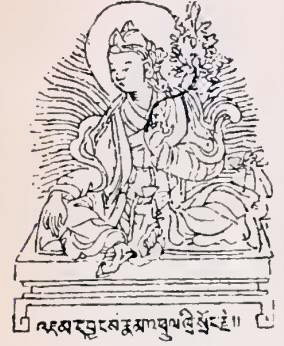 the then capital of China. This king was the son of a Chinese princess, 3 and inherited through his mother a strong prejudice in favour of Buddhism. He succeeded to the throne when only thirteen years old, and a few years later 4 . he sent to India for a celebrated Buddhist “King Thi-Sroṅ Detsan” priest King Thi- Sroṅ Detsan. to establish an order in Tibet; and he was advised, it is said, by his family priest, the Indian monk Ṣānta-rakshita, to secure if possible the services of his brother-in- law, 5 Guru Padma-sambhava, a clever member of the then popular Tantrik Yogācārya school, and at that time, it is said, a resident of the great college of Nālanda, the Oxford of Buddhist India. This Buddhist wizard, Guru Padma-sambhava, promptly responded to the invitation of the Tibetan king, and accompanied the messengers back to Tibet in 747 CE. 6 As Guru Padma-sambhava was the founder of Lāmaism, and is now deified and as celebrated in Lāmaism as Buddha himself, than whom, indeed, he receives among several sects more worship, he demands detailed notice.
the then capital of China. This king was the son of a Chinese princess, 3 and inherited through his mother a strong prejudice in favour of Buddhism. He succeeded to the throne when only thirteen years old, and a few years later 4 . he sent to India for a celebrated Buddhist “King Thi-Sroṅ Detsan” priest King Thi- Sroṅ Detsan. to establish an order in Tibet; and he was advised, it is said, by his family priest, the Indian monk Ṣānta-rakshita, to secure if possible the services of his brother-in- law, 5 Guru Padma-sambhava, a clever member of the then popular Tantrik Yogācārya school, and at that time, it is said, a resident of the great college of Nālanda, the Oxford of Buddhist India. This Buddhist wizard, Guru Padma-sambhava, promptly responded to the invitation of the Tibetan king, and accompanied the messengers back to Tibet in 747 CE. 6 As Guru Padma-sambhava was the founder of Lāmaism, and is now deified and as celebrated in Lāmaism as Buddha himself, than whom, indeed, he receives among several sects more worship, he demands detailed notice.
1 He was succeeded in 650 by his grandson Mang- Sroṅ-Mang-tsan under the regency of Sroṅ Tsan’s Buddhist minister, Gar (mk’ar), known to the Chinese as Chushih (BUSHELL, loc. cit., 446). 2 K’ri- Sroṅ Ideu-btsan. (Of. Kopp., ii., 67-72 ; Schlag., 67 ; J.A.S.B., 1881, p. 224.) ROCK.,B., quotes p. 221 contemporary record in bsTan-gyur (XCIV., f.387-391), proving that in Thi- Sroṅ Detsan’s reign in the middle of the eighth century, Tibet was hardly recognized as a Buddhist country. 3 Named Chin cheng (Tib., Kyim Shaṅ), adopted daughter of the Emperor Tchang tsong (BUSHELL, 456). 4 In 747 (Csoma,Gr.,183) ; but the Chinese date would give 755 (BUSHELL). 5 The legendary life of the Guru states that he married the Princess Mandāravā, a sister of Ṣānta-rakshita. 6 Another account makes the Guru arrive in Tibet in anticipation of the king’s wishes.
The Founder of Lāmaism, St. Padma-sambhava, in his Eight Forms.
is usually called by the Tibetans Guru Rin-po-ch’e, or ” the precious Guru ” ; or simply Lo-pon, 2 the Tibetan equivalent of the Sanskrit ” Guru ” or “teacher.” He is also called ” Ugyan” or ” Urgyan,” as he was a native of Udyāna or Urgyan, corresponding to the country about Ghazni 3 to the north-west of Kashmīr. Udyāna, his native land, was famed for the proficiency of its priests in sorcery, exorcism, and magic. Hiuen Tsiang, writing a century previously, says regarding Udyāna : ” The people are in disposition somewhat sly and crafty. They practise the art of using charms. The employment of magical sentences is with them an art and a study.” 4 And in regard to the adjoining country of Kashmīr also intimately related to Lāmaism, Marco Polo a few centuries later says : ” Keshimur is a province inhabited by people who are idolaters (i.e., Buddhists). . . . They have an astonishing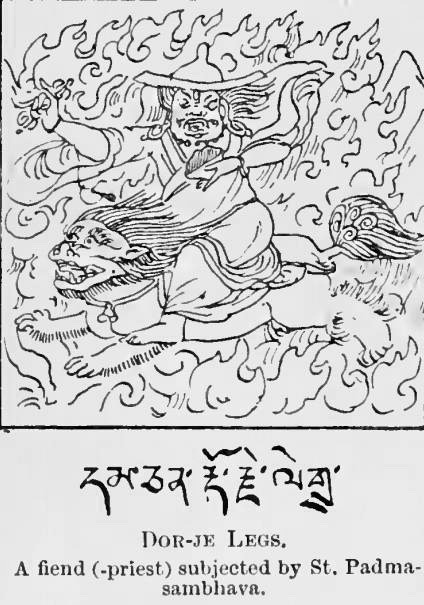 acquaintance with the devilries of enchantment, insomuch as they can make their idols speak. They can also by their sorceries bring on changes of weather, and produce darkness, and do a number of things so extraordinary that no one without seeing them would believe them. Indeed, this country is the very original source from which idolatry has spread abroad.”5 The Tibetans, steeped in superstition which beset them on every side by malignant devils, warmly welcomed the Guru as he brought them deliverance from their terrible tormentors. Arriving in Tibet
acquaintance with the devilries of enchantment, insomuch as they can make their idols speak. They can also by their sorceries bring on changes of weather, and produce darkness, and do a number of things so extraordinary that no one without seeing them would believe them. Indeed, this country is the very original source from which idolatry has spread abroad.”5 The Tibetans, steeped in superstition which beset them on every side by malignant devils, warmly welcomed the Guru as he brought them deliverance from their terrible tormentors. Arriving in Tibet
1For legend of his birth from a lotus see p. 380. 2 sLob-dpon. 3 The Tibetans state that it is now named Ghazni, but Sir H. Yule, the great geographer, writes (MARCO P.,i.,155) : ” Udyāna lay to the north of Peshāwar, on the Swat river, but from the extent assigned to it by Hwen Thsang, the name probably covered a large part of the whole hill region south of the Hindu Kush, from Chitral to the Indus, as indeed it is represented in the Map of Vivien de St. Martin (Pelerins Bouddhistes, ii.).” It is regarded by Fahian as the most northerly Province of India, and in his time the food and clothing of the people were similar to those of Gangetic India.
4. BEAL’s Si-Yu-Ki, i.,120. 5 MARCO P., i., 155.
in 747 a.d., he vanquished all the chief devils of the land, sparing most of them on their consenting to become defenders of his religion, while he on his part guaranteed that in return for such services they would be duly worshipped and fed. Thus, just as the Buddhists in India, in order to secure the support of the semi- aborigines of Bengal admitted into their system the bloody Durga and other aboriginal demons, so on extending their doctrines throughout Asia they pandered to the popular taste by admitting within the pale of Buddhism the pantheon of those new nations 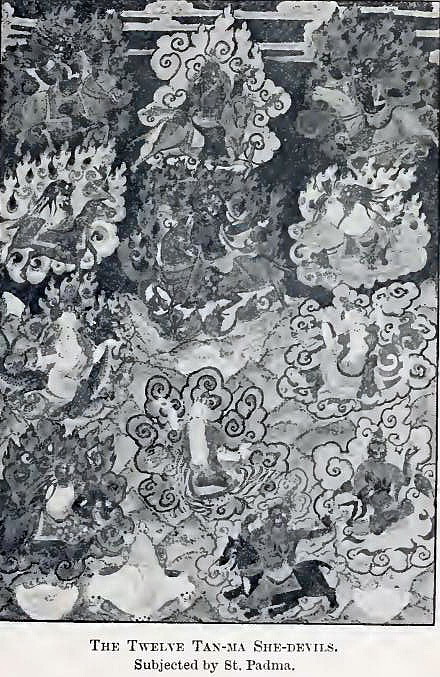
they sought to convert. And similarly in Japan, where Buddhism was introduced in the sixth century CE., it made little progress till the ninth century, when Kobo Daishi incorporated it with the local Shintoism, by alleging that the Shinto deities were embodiments of the Buddhist. The Guru’s most powerful weapons in warring with the demons were the “Vajra “ The Twelve Tan-ma She-devils. Subjected by St. Padma.(Tibetan, dor-je), symbolic of the thunderbolt of India (Jupiter), and spells extracted from the Mahāyāna gospels, by which he shattered his supernatural adversaries. As the leading events of his march through Tibet and his subjugation of the local devils are of some interest, as indicating the original habitats of several of the pre-Lāmaist demons, I have given a condensed account of these in the chapter on the pantheon at page 382.Under the zealous patronage of King Thi-Sroṅ Detsan he built at Sām-yās in 749 CE. the first Tibetan monastery. The orthodox account of the miraculous creation of that building is referred to in our description of that monastery. On the building of Sām-yās, 1 said to be modelled after the Indian Odantapura of Magadha, the Guru, assisted by the Indian monk 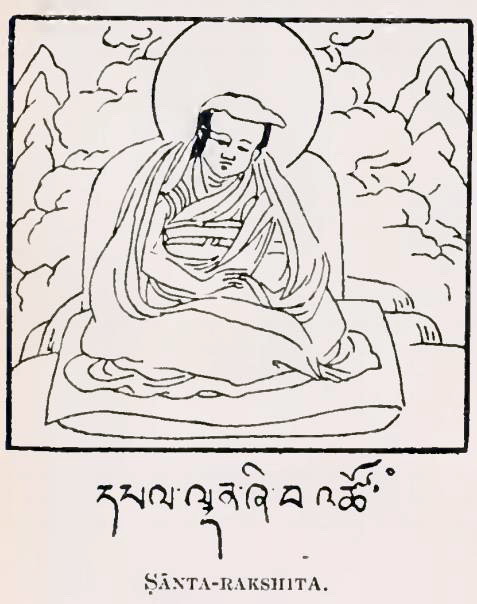 Ṣānta -rakshita, instituted there the order of the Lāmas. Ṣānta -rakshita was made the first abbot and laboured there for thirteen years. He now is entitled Acārya Bodhisat. 2 Lā-ma 3 is a Tibetan word meaning the ” Superior One,”and corresponds to the Sanskrit Uttara. It was restricted to the head of the monastery, and still is strictly applicable only to abbots and the highest monks; though out of courtesy the title is Indian Buddhist monk of the Eighth Century CE. now given to almost all Lāmaist monks and priests. The Lāmas have no special term for their form of Buddhism. They simply call it ” The religion ” or “Buddha’s religion”; and its professors are “Insiders,” or “within the fold” (naṅ -pa), in contradistinction to the non-Buddhists or “Out-siders ” (chi-pa or pyi-‘lin), the so-called ” pe-ling ” or foreigners of English writers. And the European term “Lāmaism” finds no counterpart in Tibetan.
Ṣānta -rakshita, instituted there the order of the Lāmas. Ṣānta -rakshita was made the first abbot and laboured there for thirteen years. He now is entitled Acārya Bodhisat. 2 Lā-ma 3 is a Tibetan word meaning the ” Superior One,”and corresponds to the Sanskrit Uttara. It was restricted to the head of the monastery, and still is strictly applicable only to abbots and the highest monks; though out of courtesy the title is Indian Buddhist monk of the Eighth Century CE. now given to almost all Lāmaist monks and priests. The Lāmas have no special term for their form of Buddhism. They simply call it ” The religion ” or “Buddha’s religion”; and its professors are “Insiders,” or “within the fold” (naṅ -pa), in contradistinction to the non-Buddhists or “Out-siders ” (chi-pa or pyi-‘lin), the so-called ” pe-ling ” or foreigners of English writers. And the European term “Lāmaism” finds no counterpart in Tibetan.
1 The title of the temple is Zan-yad Mi-gyur Lhun-gyi dub-pahi tsug-lha-Ksan, Or the “Self-sprung immovable shrine,” and it is believed to be based on immovable foundations of adamantine laid by the Guru. 2 And is said to have been of the Svatantra school, following Ṣāriputra, Ananda, Nāgārjuna, Subhaṅkara, Ṣrī Gupta, and Jñāna-garbha (cf. SCHL.,67; KOPP., ii., 68; J.A.S.B., 1881, p. 226; PAND., No. 25.) 3 bLa-ma. The Uighurs (?Hor) call their Lāmas “tain ” (YULE’s, Cathay, p. 211,note).
The first Lāma may be said to be Pal- baṅs, who succeeded the Indian abbot Ṣānta -rakshita ; though the first ordained member of this Tibetan order of monks was Bya-Khri-gzigs. 1 The most learned of these young Lāmas was Vairocana, who translated many Sanskrit works into Tibetan, though his usefulness was interrupted for a while by the Tibetan wife of Thi-Sroṅ Detsan ; who in her bitter opposition to the King’s reforms, and instigated by the Bonpa priests, secured the banishment of Vairocana to the eastern province of Kham by a scheme similar to that practised by Potiphar’s wife. But, on her being forthwith afflicted with leprosy, she relented, and the young « Bairo-tsana ” was recalled and effected her cure. She is still, however, handed down to history as the ” Red Rahulā she-devil,” 2 while Vairocana is made an incarnation of Buddha’s faithful attendant and cousin Ānanda ; and on account of his having translated many orthodox scriptures, he is credited with the composition or translation and hiding away of many of the fictitious scriptures of the unreformed Lāmas, which were afterwards ” discovered” as revelations. It is not easy now to ascertain the exact details of the creed the primitive Lāmaism— taught by the Guru, for all the extant works attributed to him “were composed several centuries later by followers of his twenty-five Tibetan disciples. But judging from the intimate association of his name with the essentials of Lāmaist sorceries, and the special creeds of the old unreformed section of the Lāmas— the Ñin-ma-pa— who profess and are acknowledged to be his immediate followers, and whose older scriptures date back to within two centuries of the Guru’s time, it is evident that his teaching was of that extremely Tāntrik and magical type of Mahāyāna Buddhism which was then prevalent in his native country of Udyān and Kashmīr. And to this highly impure form of Buddhism, already covered by so many foreign accretions and saturated with so much demonolatry, was added a
1 The first seven novices (Sad-mi mi) who formed the nucleus of the order were dBah dpal dbaṅs, rtsaṅs-devendra and Branka Mutik, ‘K’on Nāgendra, Sagor Vairocana, rMa Ācārya rin-ch’en mch’og, gLaṅ-Ka Tanana, of whom the first three were elderly. 2 gZa-mar gyal. The legend is given in the T’aṅ-yik Ser-t’en.
portion of the ritual and most of the demons of the indigenous Bon-pa religion, and each of the demons was assigned its proper place in the Lāmaist pantheon. Primitive Lāmaism may therefore be defined as a priestly mixture of Ṣivaite mysticism, magic, and Indo-Tibetan demonolatry, overlaid by a thin varnish of Mahāyāna Buddhism. And to the present day Lāmaism still retains this character. In this form, as shaped by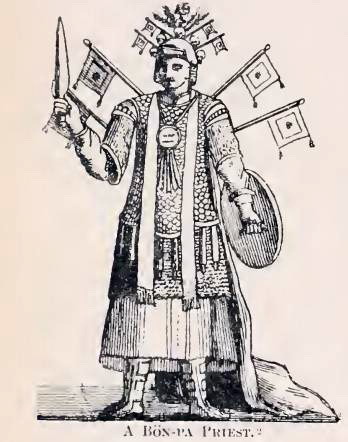 the Guru, Buddhism proved more attractive to the people, and soon became popular. Its doctrine of Karma, or ethical retribution, appealed to the fatalism which the Tibetans share with most eastern races. And the zealous King, Thi-Sroṅ Detsan, founded other monasteries freely and initiated a period of great literary activity by procuring many talented Indian and Kashmīri scholars for the work of translating the Indian canonical works and commentaries into Tibetan. 1 The now religion was actively opposed by the priests of the native religion, called Bon, 3 and these were supported by one of the most powerful ministers. 4
the Guru, Buddhism proved more attractive to the people, and soon became popular. Its doctrine of Karma, or ethical retribution, appealed to the fatalism which the Tibetans share with most eastern races. And the zealous King, Thi-Sroṅ Detsan, founded other monasteries freely and initiated a period of great literary activity by procuring many talented Indian and Kashmīri scholars for the work of translating the Indian canonical works and commentaries into Tibetan. 1 The now religion was actively opposed by the priests of the native religion, called Bon, 3 and these were supported by one of the most powerful ministers. 4
1 The chief translators employed at this time were the Indian monks, Vimala Mitra, Buddha Guhya, Ṣāntigarbha, Viṣuddhi Siṇha, the Tāntrik Achārya Dharma-kīrti (who translated the Vajradhātu Yoga works). The Kashmīri monks, Jina-Mitra, Dāna-Ṣīla and Ananda, assisted by the Tibetan novices, chief of whom was Vairocana. No translations it works ascribed to Padma-sambhava himself occur in the Tibetan Tripiṭaka canon. 2 After Giorgi. 3 The word is derived by Gen. Cunningham (MARCO P., i.. 287) From Puṇya, one of the names, if the Svastikas, or worshippers of the mystic fly-foot cross, called in Tibetan gyun drun, though Puṇya is simply “a holy man,” and seems original of the Burmese title for monk, Pongyī. The Bon religion resembles the Taoism of China (see YULE, loc.cit.; ROCK.,B.,p206 et seq., and his L.L., p. 217 n., and J.R. Geog. Soc., May, 1894). It is especially associated with the worship of dragons, or nāgās, and its reputed founder is gS’en-rabs Mi-bo. As now practised, it is deeply impregnated by Buddhism. For a list of some of its deities aee SARAT, Jour. Indian Buddhist Text Soc., Vol. I. 4 Named NamMa-Shanrom-pa-skyes. The ministers who aided the King were Go Shaṅ-Shi, and Da-gyab-ts’an.
[Page31] OPPOSED BY INDIGENOUS PRIESTS.
Some of the so-called devils which are traditionally alleged to have been overcome by the Guru were probably such human adversaries. It is also stated that the Bon-pa were now prohibited making human and other bloody sacrifice as was their wont; and hence is said to have arisen the practice of offering images of men and animals made of dough. Lāmaism was also opposed by some Chinese Buddhists, one of whom, entitled the Mahāyāna Hwa-shang,1 protested against the kind of Buddhism which Ṣānta -rakshita and Padma-sambhava were teaching.2 But he is reported to have been defeated in argument and expelled from the country by the Indian monk Kamalaṣīla,3 who, like Ṣānta -rakshita, is alleged to be of the Sva-tantra Mādhyamika school, and the author of many treatises still extant in the great commentary (Tän-gyur). The excellent Sanskrit- Tibetan dictionaries (Vyutpatti) date from this literary epoch.
1 A Chinese term for a Buddhist monk corresponding to Skt. Upādhyāya or “master.” (See Edkin’s Dict, and Mayer’s Hdbk.) 2 Two works by Hwa-shang zab-mo are found in the Tan-gyur (mDo, xxx., xxxiii. (Rockhill’s B., p. 220). 3 Kamalaṣīla was author of an Indianwork | Tarka) expounding the various philosophic systems of India. (Prof. G. BUEHLER, J. Buddhist Text Soc.of India, i., pt. ii.,p. x.) [4] 1. Nam-k’a ñiṅ -po mounted the sunbeams. 2. Saṅ -gye-ye- ṣe drove iron Bolts into rocks. 3. Gyal-wa-ch’og-yan changed his head into a horses, and neighed thrice. 4. K’ar-ch’en Ch’o-gyal revived the slain. 5. Pal-ki-ye- ṣe overcame three fiendesses. 6.Pal-ki-Seṅ -ge enslaved demons, nymphs, and genii. 7. Vairocana obtained the five heavenly eyes of knowledge. 8. Ṅah-dag-gyalpo attained Samadhi. 9. Yu-druṅ-Niṅ-po acquired divine knowledge. 10. Jñāna-kumāra worked miracles. 11. Dorje-Duṅ Jem travelled invisibly as the wind. 12. Ye-ṣe-Naṅ visited the fairy world. 13. Sog-pu-Lha-pal (a Mongol ) ensnared ferocious beasts. 14. Na-nam-yese soared in the sky. 15. Pal-ki-Waṅ-p’yug killed his enemies by signs, 16. Den-ma-tse-Waṅ had perfect memory. 17. Ka-Wa-pal-tseg perceived the thoughts of others. 18. Shu-bu-pal-seṅ made water run upwards. 19. Khe-hu-c’ug-lo caught flying birds. 20. Gyal-Wai-Lodoi raised ghosts and converted the corpse into gold. 21. Ten-pai-nam-k’a tamed wild yaks of the northern desert. 22. ‘Odau-Waṅ-pyug dived into water like a fish. And these disciples he instructed in the way of making magic circles for coercing the demons and for exorcism.
23. Ma-t’og rin-ch’en crushed adamant to powder and ate it like meal. 24. Pal-kyj Dor-je passed through rocks and mountains. 25. Laṅ -dod Kon-ch’og wielded and repelled thunderbolts. And a twenty-sixth is added : Gyal-wai-Ch’aṅ c’ub sat cross-legged in the air. 1 After residing in Tibet for about fifty years (say the chronicles, though it is probable he only remained a few years), and founding Lāmaism securely, the Guru, in 802 CE., much to the grief of the Tibetans, announced his approaching departure for fresh religious triumphs in other lands. Addressing the King, he said: “In Jambudvīp are five Raksha countries with 500 towns apiece. The Central Raksha country is named Saṅ-do-pal-ri (zahs-mdog-dpal-ri), the king of which is named Langka of the ten necks (? the ten-headed Raven). To its east lies Lankapuri, to its south dGā -bu-c’an, or “The happy” (Skt., Sukhāvāti or Nandavati), to its west Ko-sha t’ang-dmar-gling, to its north is Byan-lag fort, to its south-east is Bam-ril-t’od-pa-mk’ar, to its north-west is Mala-gnam-lchags-rtse, to its north-east is Nal-byih cemetery, and in the south-east is the lake of Phuri. These Raksha countries are crowded with men-eating devils, who if not conquered will depopulate the whole world of Jambudvīp, and except me none other can subdue them. I therefore must go to the stronghold of the Raksha at Saṅ-do-pal-ri in the country of rṄa-yab-gliṅ or ‘The Yak-tail continent,’ which lies to the south-west of Tibet. Thither must I now go.” Then, accompanied by the King and nobles and his two fairy wives (the Tibetan one of which, named Yes’e-ts’o-gyal was to be left behind), he went to the Gungthang La in Mang-yul on the northern confines of Tibet, and there, after giving farewell advice to the king, priests, and the assembled multitude to keep the doctrine he had taught them, and the revelations he had hidden in caves throughout the land, he was enveloped in a glorious rainbow-halo, within which appeared the four great heroes (dPa-bo) of the world, who assisted him in mounting the celestial horse-car (named ” balaha ” or Chang-sal) in which he was now borne away through the sky in a south-westerly direction, attended by the four heroes and a host of fairies amid heavenly music and showers of flowers. On his departure the assembled multitude were distracted with grief and remained transfixed as if dead. Ultimately they retired below the pass to Srang-hdah-sho-ytsang-dor and the plain Thang-dpal-mo-dpal-thang, where they remained for twenty-five days and nights, and were able to see the Guru’s celestial party, like a shooting star, sailing away through the sky towards the horizon till lost to sight. After much prayer and worship they sadly departed on King- Thi-Sroṅ Detsan telling them of the Guru’s safe arrival at Saṅ-do-pal-ri, which event he(the king) was able to see through the magical insight he had acquired from the Guru, it appeared that the Guru reached Singala after about two days’ journey, and penetrating the iron palace, he entered the body of the Raksha king- named “He of the Skull rosary,” and preached the doctrine to the thousand daughters of the Raksha and the folk of that country, a few days afterwards he departed for Ṅa-yab-gliṅ,and reached the capital Saṅ-do-pal-ri, where instantly abstracting the life of the demon-king named Yaksha Me-wal, and entering his body, the Guru reigns there supreme over the Rakshas, even up till the present day. and in perpetual youth is preaching there the doctrine of Lāmaism in a paradise which rivals that of Amitābha’s Western heaven of Sukhāvatī. And notwithstanding his grotesque charlatanism and non celibate life, he is deified and worshipped as the ” second Buddha,” and his image under “The eight worshipful Forms” 1 is found in every Tibetan temple of the old sect, as figured at page 25. Thus established, and lavishly endowed, Lāmaism made steady progress, and was actively patronized by Thi-Sroṅ Detsan’s successors for two generations. 2 The eras of Lāmaism may be divided into (1) primitive or “Augustine” (from King Thi-Sroṅ Detsan’s reign to the persecution), (2) mediaeval, including the reformation, (3) modern Lāmaism, from the priest-kingship of the Dalai Lāma in the seventeenth century. An interesting glimpse into the professed religion of the earlier period is given in the bilingual edict pillars ” do-ring,” erected at Lhāsa in 822 CE.,3 in treaty with the Chinese. In the text of these edicts, which has been translated by Dr. Bushell, 4 occurs the following sentence : ” They [? the Fan (Tibetan) and the Han (Chinese)] have looked up to the three precious ones, to all the holy saints, to the sun, moon, stars, and planets, and begged them to be their witnesses.”
1 Guru ts’an gye. For description of those see p. 379. 2 Thi-Sroṅ Detsan died in 786 (CSOMA, Gr., 183), and was succeeded by his son, Mu-thi tsan-po, who, on being poisoned by his mother soon after his accession, was succeeded by his brother (Sad-na-legs) under the same name (ROCKHILL, Life, 222), and he induced Kamalaṣīla to return to Tibet and permanently reside in that country. This latter was succeeded by his son Ralpachan. 3 These monoliths are assigned by Tibetan tradition (as translated by SARAT.,J.A.S.B., 1881, p. 228) to Thi-Sroṅ Detsan’s grandson, Ralpachan. 4 Op. cit., 521. 5 According to Tibetan chronology; but the Chinese make Ralpachan’s accession 816 CE. (ROCKHILL’s B., 223). 6 These two were pupils of Sthiramati (VASILIEV, Tāranātha, 320) of their hands.1 And he endowed most of the monasteries with state-lands and the right to collect tithes and taxes. He seems to have been the first Tibetan sovereign who started a regular record of the annals of his country, for which purpose he adopted the Chinese system of chronology. His devotion to Buddhism appears to have led to his murder about 899 CE.,2 at the instigation of his younger brother Laṅ Darma, — the so-called Julian of Lāmaism — who then ascended the throne, and at once commenced to persecute the Lāmas and did his utmost 3 to uproot the religion. He desecrated the temples and several monasteries, burned many of their books, and treated the Lāmas with the grossest indignity, forcing many to become butchers. But Laṅ Darma’s persecution was very mild for a religious one, and very short-lived. He was assassinated in the third year of his reign by a Lāma of Lhaluṅ named Pal-dorje,who has since been canonized by 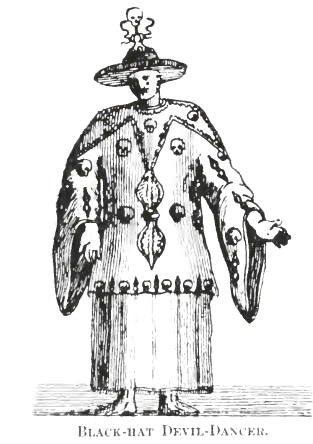 his grateful church, and this murderous incident forms a part of the modern Lāmaist masquerade.4 This Lāma,to effect his purpose, assumed the guise of a strolling black-hat devil-dancer, and hid in his ample sleeves a bow and arrow. His dancing below the king’s palace, which stood near the north end of the present cathedral of Lhāsa,5 attracted the attention of the king,who summoned the dancer to his presence, where the disguised Lāma seized an opportunity while near the king to shoot him with the arrow, which proved almost immediately fatal. In the re- 1 ROCK.,B., 225. 2 The date is variously given, ranging from 838( BUSHELL ,439 and 522) to 899 CE. (CSOMA, Gr.,183); 902(SANANG SETSEN,49); 914 (KOPPEN.II., 72) 3 Actively aided by his minister, sBas-stay-Snas. 4 See Chap.XX. 5 And not on the Red Hill latterly named “Potala “ sulting tumult the Lāma sped away on a black horse, which was tethered near at hand, and riding on, plunged through the Kyi river on the outskirts of Lhāsa, whence his horse emerged in its natural white colour, as it had been merely blackened by soot, and he himself turned outside the white lining of his coat, and by this stratagem escaped his pursuers.1 The dying words of the king were : “Oh, why was I not killed three years ago to save me committing so much sin, or three years hence, that I might have rooted Buddhism out of the land ? ” On the assassination of Laṅ Darma the Lāmas were not long in regaining their lost ground.2 Their party assumed the regency during the minority of Laṅ Darma’s sons, and although Tibet now became divided into petty principalities, the persecution seems to have imparted fresh vigour to the movement, for from this time forth the Lāmaist church steadily grew in size and influence until it reached its present vast dimensions, culminating in the priest-kings at Lhāsa. By the beginning of the eleventh century CE., numerous Indian and Kashmīri monks were again frequenting Tibet. 3 And in 1038 CE. arrived Atīṣa, the great reformer of Lāmaism, 4 whose biography is sketched in outline below, as he figures conspicuously in Lāmaism, and especially in its sects.
his grateful church, and this murderous incident forms a part of the modern Lāmaist masquerade.4 This Lāma,to effect his purpose, assumed the guise of a strolling black-hat devil-dancer, and hid in his ample sleeves a bow and arrow. His dancing below the king’s palace, which stood near the north end of the present cathedral of Lhāsa,5 attracted the attention of the king,who summoned the dancer to his presence, where the disguised Lāma seized an opportunity while near the king to shoot him with the arrow, which proved almost immediately fatal. In the re- 1 ROCK.,B., 225. 2 The date is variously given, ranging from 838( BUSHELL ,439 and 522) to 899 CE. (CSOMA, Gr.,183); 902(SANANG SETSEN,49); 914 (KOPPEN.II., 72) 3 Actively aided by his minister, sBas-stay-Snas. 4 See Chap.XX. 5 And not on the Red Hill latterly named “Potala “ sulting tumult the Lāma sped away on a black horse, which was tethered near at hand, and riding on, plunged through the Kyi river on the outskirts of Lhāsa, whence his horse emerged in its natural white colour, as it had been merely blackened by soot, and he himself turned outside the white lining of his coat, and by this stratagem escaped his pursuers.1 The dying words of the king were : “Oh, why was I not killed three years ago to save me committing so much sin, or three years hence, that I might have rooted Buddhism out of the land ? ” On the assassination of Laṅ Darma the Lāmas were not long in regaining their lost ground.2 Their party assumed the regency during the minority of Laṅ Darma’s sons, and although Tibet now became divided into petty principalities, the persecution seems to have imparted fresh vigour to the movement, for from this time forth the Lāmaist church steadily grew in size and influence until it reached its present vast dimensions, culminating in the priest-kings at Lhāsa. By the beginning of the eleventh century CE., numerous Indian and Kashmīri monks were again frequenting Tibet. 3 And in 1038 CE. arrived Atīṣa, the great reformer of Lāmaism, 4 whose biography is sketched in outline below, as he figures conspicuously in Lāmaism, and especially in its sects.
1 He hid in a cave near the monastery of Brag-Yal-pa, about one day’s journey east of Lhāsa. 2 Sanang Setsen says (p. 51) that Laṅ Darma’s son reigned without the Law. 3 Among whom were Smṛiti, who wrote a Tibetan vocabulary named ” The Weapon of Speech”; Dharmapāla, who arrived in 1013 CE., accompanied by Siddhapāla,Gunapala,and Prajñā-pāla from Eastern India; and Subhūti Ṣṛi Ṣānti, who translated some of the Prajñā -pāramitā. 4 His legendary biography, attributed to his pupil Brom-ton, but apparently of later date (and probably written by the Dalai in the sixteenth century, as it credits Brom-ton with being Avalokita’s incarnation), has been translated by SARAT in Jour. Ind. Budd. Text Soc, 1893. I have also consulted the original. (Cf. also TĀRA. 241, 243; KOPP.,ii., 78, 79, 117,127, 295; SCHL., 69, 136; PAND.,No. 29.) Atīṣa’s proper Indian name is Dīpaṅkara Ṣṛi-jñāna, but he is usually called by the Lāmas Jo-vo-rje-dpal-ldan Atīṣa, or “The Illustrious Noble Lord Atisha.” And he is held to be an incarnation of Mañjuṣṛī, the Celestial Bodhisattva of Wisdom ; though this seems merely a pious way of stating that Atīṣa was the Mañjuṣṛī of Tibet, or the most learned in scholastic and astrological lore of all the monks who had previously visited Tibet ; as India, Nepal, and China already possessed their especial apotheosized wise man as a Mañjuṣṛī incarnation. He was born in 980 CE. (according to his Tibetan chronicles), of the royal family of Gaur at Vikramanipur (?), in Bengal, his father being named Kalyāṇa-ṣṛī, and his mother Prabhāvati, and was ordained at
Atīṣa was nearly sixty years of age when he visited Tibet. 1 He at once started a movement which may be called the Lāmaist Reformation, and he wrote many treatises. 2 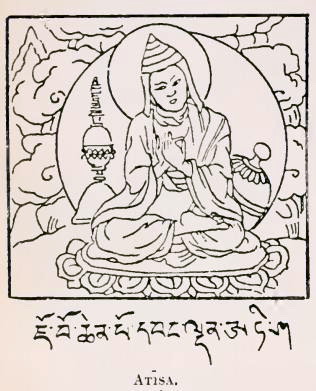 His chief disciple was Ḍomton,3 the first hierarch of the new reformed sect, the Kadam-pa, which, three-and-a- half centuries later, became the Ge-lug-pa, now the dominant sect of Tibet, and the established church of the country. Atīṣa’s reformation resulted not only in the new sect, Kadam-pa, with which he most intimately identified himself, but it also initiated, more or less directly, the semi-reformed sects of Kar-gyu-pa and Sakya-pa, as detailed in the section on Sects.The latter end of the eleventh century saw Lāmaism firmly
His chief disciple was Ḍomton,3 the first hierarch of the new reformed sect, the Kadam-pa, which, three-and-a- half centuries later, became the Ge-lug-pa, now the dominant sect of Tibet, and the established church of the country. Atīṣa’s reformation resulted not only in the new sect, Kadam-pa, with which he most intimately identified himself, but it also initiated, more or less directly, the semi-reformed sects of Kar-gyu-pa and Sakya-pa, as detailed in the section on Sects.The latter end of the eleventh century saw Lāmaism firmly
the Odantapuri Vihara. He underwent training under both Mahāyāna teachers and the Mahā Siddhi (grub-ch’en) or wizard-priests, his most notable masters being Chandrakirti, the Abbot of Suvarnadvīp, or Sudharmanagar, the “Chryse” of the ancients, near “Thaton” in Pegu, Mativitara of the Mahābodhi Vihara, and the Mahā-ṣiddhi Nāro, who is especially related to the Kar-gyu-pa Sect. On starting for Tibet, he was a professor of the Vikramasila monastery in Magadha, and a contemporary of Nayapāla, son of King Mahīpāla.
1 He visited Tibet by way of Ṅari K’or-sum in 1038 CE. in the company of the Lāma Nag-tsho, and after starting what may be called the Reformed Lāmaism, died in the’ sÑe-t’aṅ monastery, near Lhāsa, in 1052. It is stated that he came from Vikramasila at the invitation of the Tibetan King, named Lha Lāma Ye-shes-‘od, but his route via Ṅari renders this unlikely, and this Lha Lāma seems to have been a petty Chief of N.W. Tibet, who was captured about that time by the Nepalese. 2 The following works by Atīṣa occur in mDo of bsTan ‘gyur: 1, Bodhipatha pradīpa ; 2, Caryā sangraha pradīpa; 3, Satya dvayāvatāra; 4. Madhyamopadesa ; 5, Sangraha garbha; 6, Hridaya nischita; 7, Bodhisattva manyāvali; 8, Bodhisattva karmādimargāvatāra; 9, Saranagatādesa ; 10, Mahāyānapatha sādhana varna sangraha; 11. Mahāyānapatha sādhana sangraha; 12,Sutrārtha samuchhayopadesa ; 13, Dasakusala karmopadesa ; 14. Karma Vibhanga ; 15, Samādhi sambhara parivarta : 16, Lokottarasaptaka vidhi ; 17, Guru Kriyākrama ; 18, Chittotpāda samvara vidhi krama; 19. Sikshā samucchaya abhi samaya, delivered by Ṣrī Dharmapāla, king of Suvarnadvīpa to Dīpaṅkara and Kamala; 20, Vimala ratna lekhana, an epistle by Dīpaṅkara to Naya Pāla, King of Magadha by Atīṣa on his departure for Tibet. 3 Brom-ston.
Just as Charlemagne created the first Christian pope, so the
1 The Tibetan accounts state that he was born in 1182 CE., and was the son of the Mongol God (? deified ancestor) “The White Gnam-t’e.”
emperor Kublai recognized 1 the Lāma of Saskya, or the Sakya Paṇḍita, as head of the Lāmaist church, and conferred upon him temporary power as the tributary ruler of Tibet, in return for which favour he was required to consecrate or crown the Chinese emperors. And the succession in this hereditary primacy was secured to the Paṇḍit’s nephew, Lodoi G-yal-ts’an (or Matidhvaja), a young and able Lāma, who was given the title of Highness or Sublimity (p’ags-pa). Khubilai actively promoted Lāmaism and built many monasteries in Mongolia, and a large one at Pekin. Chinese history 2 attributes to him the organisation of civil administration in Tibet, though it would appear that he exerted his authority only by diplomacy through these spiritual potentates without any actual conquest by arms. The Sakya pope, assisted by a staff of scholars, achieved the great work of translating the bulky Lāmaist canon (Kah-gyur) into Mongolian after its revision and collation with the Chinese texts. Indeed, the Lāmaist accounts claim for the Sakya Pope the invention of the Mongolian character, though it is clearly modelled upon the Syrian ; and Syriac and nestorian missionaries are known to have worked in Mongolia long prior to this epoch. Under the succeeding Mongol emperors, the Sakya primacy seems to have maintained much of its political supremacy, and to have used its power as a church-militant to oppress its rival sects. Thus it burned the great Kar-gyu-pa monastery of Dikung about 1320 CE. But on the accession of the Ming dynasty in 1368 CE. the Chinese emperors deemed it politic, while conciliating the Lāmas, as a body, by gifts and titles, to strike at the Sakya power by raising the heads of two other monasteries 3 to equal rank with it, and encouraged strife amongst them. At the beginning of the fifteenth century a Lāma named Tsoṅ-K’a-pa re-organized Atīṣa’s reformed sect, and altered its title to “The virtuous order,” or Ge-lug-pa. This sect soon eclipsed all the others; and in five generations it obtained the priest-kingship of Tibet, which it still retains to this day. Its first Grand Lāma was Tsoṅ-K’a-pa’s nephew, Geden- ḍub, with his succession based on the idea of re-incarnation, a theory
1 In 1270 CE 2 MARCO P., ii.,38. 3 The Ka-gyupa, Dikung, and the Ka-dam-pa Ts’al.
UNDER GE-LUG-PA .
which was afterwards, apparently in the reign of the fifth Grand Lāma, developed into the fiction of re-incarnated reflexes of the divine Bodhisat Avalokita, as detailed in the chapter on the Hierarchy. In 1640, the Ge-lug-pa leapt into temporal power under the fifth Grand Lāma, the crafty Ṅag-waṅ Lo-zang. At the request of this ambitious man, a Mongol prince, Gusri Khan, conquered Tibet, and made a 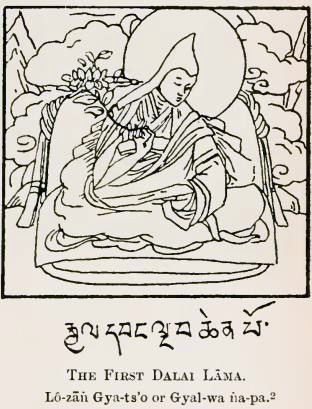 present of it to this Grand Lāma, who in 1650 was confirmed in his sovereignty by the Chinese emperor, and given the Mongol title of Dalai, or “(vast as) the Ocean.” And on account of this title he and his successors are called by some Europeans “the Dalai (or Tale) Lāma” though this title is almost unknown to Tibetans, who call these Grand Lāmas” the great gem of majesty ” (Gyal-wa Kin-po- ch’e). This daring Dalai Lāma, high-handed and resourceful, lost no time in consolidating his rule as priest-king and the extension of his sect by the forcible appropriation of many monasteries of the other sects, and by inventing legends magnifying the powers of the Bodhisat Avalokita and posing himself as the incarnation of this divinity, the presiding Bodhisat of each world of re-birth, whom he also identified with the controller of metempsychosis, the dread Judge of the Dead before whose tribunal all mortals must appear. Posing in this way as God-incarnate, he built 3 himself the huge palace-temple on the hill near Lhāsa, which he called Potala, after the mythic Indian residence of his divine prototype
present of it to this Grand Lāma, who in 1650 was confirmed in his sovereignty by the Chinese emperor, and given the Mongol title of Dalai, or “(vast as) the Ocean.” And on account of this title he and his successors are called by some Europeans “the Dalai (or Tale) Lāma” though this title is almost unknown to Tibetans, who call these Grand Lāmas” the great gem of majesty ” (Gyal-wa Kin-po- ch’e). This daring Dalai Lāma, high-handed and resourceful, lost no time in consolidating his rule as priest-king and the extension of his sect by the forcible appropriation of many monasteries of the other sects, and by inventing legends magnifying the powers of the Bodhisat Avalokita and posing himself as the incarnation of this divinity, the presiding Bodhisat of each world of re-birth, whom he also identified with the controller of metempsychosis, the dread Judge of the Dead before whose tribunal all mortals must appear. Posing in this way as God-incarnate, he built 3 himself the huge palace-temple on the hill near Lhāsa, which he called Potala, after the mythic Indian residence of his divine prototype
1 Cf. Csoma, Gr., 192 and 198; KOPP.,ii., 168, 235; J.A.S.B.,1882, p. 27 2 After Pander. 3 In 1643, CSOMA, Gr.,p.190
Avalokita, “The Lord who looks down from on high,” whose symbols he now invested himself with. He also tampered unscrupulously with Tibetan history in order to 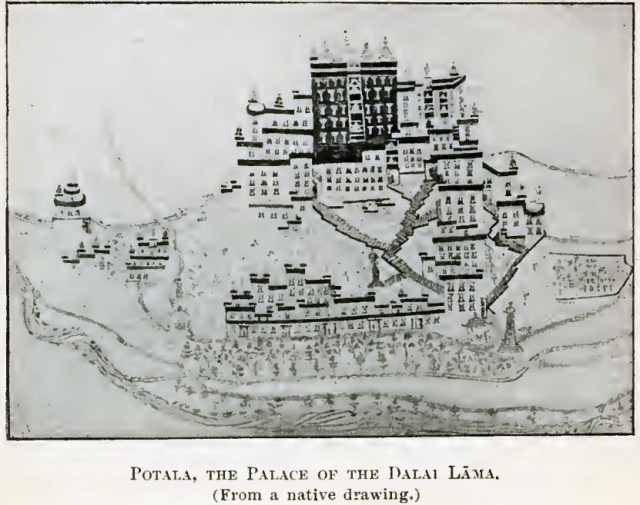 lend colour to his divine pretensions, and he succeeded perfectly. All the other sects of Lāmas acknowledged him and his successors to be of divine descent, the veritable Avalokita-in-the-flesh. And they also adopted the plan of succession by re-incarnate Lāmas and by divine reflexes. As for the credulous populace, they recognized the Dalai Lāma to be the rightful ruler and the existing government as a theocracy, for it flattered their vanity to have a deity incarnate as their king. The declining years of this great Grand Lāma, Ṅag-waṅ , were troubled by the cares and obligations of the temporal rule, and his ambitious schemes, and by the intrigues of the Manchus, who sought the temporal sovereignty. On account of these political troubles his death was concealed for twelve years by the minister De-Si, 1 who is believed to have been his natural son. And the succeeding Grand Lāma, the sixth, proving hopelessly dissolute, he was executed at the instigation of the Chinese government, 1 sDe-srid. Csoma’s Gram., 191 ; GIORGI’s Alph. which then assumed the suzerainty, and which has since continued to control in a general way the temporal affairs, especially its foreign policy, 1 and also to regulate more or less the hierarchical succession,2 as will be referred to presently. But the Ge-lug-pa sect, or the established church, going on the lines laid down for it by the fifth Grand Lāma, continued to prosper, and his successors, despite the presence of a few Chinese officials, are now, each in turn, the de facto ruler of Tibet, and recognized by the Lāmas of all denominations as the supreme head of the Lāmaist church. In its spread beyond Tibet, Lāmaism almost everywhere exhibits the same tendency to dominate both king and people and to repress the national life. It seems now to have ceased extending, but shows no sign of losing hold upon its votaries in Tibet. The present day distribution of Lāmaism extends through states stretching more or less continuously from the European Caucasus to near Kamschatka; and from Buriat Siberia down to Sikhim and Yun-nan. But although the area of its prevalence is so vast, the population is extremely sparse, and so little is known of their numbers over the greater part of the area that no trustworthy figures can be given in regard to the total number of professing Lāmaists.
lend colour to his divine pretensions, and he succeeded perfectly. All the other sects of Lāmas acknowledged him and his successors to be of divine descent, the veritable Avalokita-in-the-flesh. And they also adopted the plan of succession by re-incarnate Lāmas and by divine reflexes. As for the credulous populace, they recognized the Dalai Lāma to be the rightful ruler and the existing government as a theocracy, for it flattered their vanity to have a deity incarnate as their king. The declining years of this great Grand Lāma, Ṅag-waṅ , were troubled by the cares and obligations of the temporal rule, and his ambitious schemes, and by the intrigues of the Manchus, who sought the temporal sovereignty. On account of these political troubles his death was concealed for twelve years by the minister De-Si, 1 who is believed to have been his natural son. And the succeeding Grand Lāma, the sixth, proving hopelessly dissolute, he was executed at the instigation of the Chinese government, 1 sDe-srid. Csoma’s Gram., 191 ; GIORGI’s Alph. which then assumed the suzerainty, and which has since continued to control in a general way the temporal affairs, especially its foreign policy, 1 and also to regulate more or less the hierarchical succession,2 as will be referred to presently. But the Ge-lug-pa sect, or the established church, going on the lines laid down for it by the fifth Grand Lāma, continued to prosper, and his successors, despite the presence of a few Chinese officials, are now, each in turn, the de facto ruler of Tibet, and recognized by the Lāmas of all denominations as the supreme head of the Lāmaist church. In its spread beyond Tibet, Lāmaism almost everywhere exhibits the same tendency to dominate both king and people and to repress the national life. It seems now to have ceased extending, but shows no sign of losing hold upon its votaries in Tibet. The present day distribution of Lāmaism extends through states stretching more or less continuously from the European Caucasus to near Kamschatka; and from Buriat Siberia down to Sikhim and Yun-nan. But although the area of its prevalence is so vast, the population is extremely sparse, and so little is known of their numbers over the greater part of the area that no trustworthy figures can be given in regard to the total number of professing Lāmaists.
The population of Tibet itself is probably not more than 4,000,000, 3 but almost all of these may be classed as Lāmaists, for although a considerable proportion of the people in eastern Tibet are adherents of the Bon. many of these are said to patronize the Lāmas as well, and the Bon religion has become assimilated in great part to un-reformed Lāmaism. 4
1 Thus it procured for Tibet satisfaction from the Gorkhas under Pṛithivī -nārāyan for their invasion of Western Tibet and sack of Tashi-lhunpo in 1768 (KIRKPATRICK’s Acct. of Nepal, p. 268 ; BUCHANAN-HAMILTON, Nepal, p. 244), and the present seclusion of Tibet against Europeans is mainly due to Chinese policy. 2 An interesting glimpse into the country of that period is got in the contemporary record of the friar Horace della Penna, translated into English by Markham (op. cit., p. 320 et seq.) 3 Rockhill, L., p. 296, estimates it at 3,500,000. 4 Though it must be remembered that Mr. Rockhill found a large tract of N.E. Tibet exclusively occupied by Bön-pa . In the north-eastern province of Gya-de, with about 50,000 people, between the Dang River and Chamdo, Mr. Rockhill found that the Bön-pa religion reigns supreme, and in order to save these people from persecution at the hands of the Lāmaist Government at Lhāsa, China itself supervises the administration of this province. And “all along the eastern borderland of Tibet from the
The European outpost of the Lāmaist Church, situated amid the Kālmuk Tartars on the banks of the Volga, has been described in some detail by Koppen. 1 After the flight of the Torgots, about 12,000 cottages of the Kālmuk Tartars still remained in Russian territory, between the Don and the Yaik. Now they number at least 20,000, and contain more than 100,000 souls, of which by far the great majority retain the Lāmaist faith. Of course, since the flight, all intercourse with the priest-god at Lhāsa is strictly forbidden, nor are they allowed to accept from him any orders or patents, nor to send him any ambassadors or presents. Nevertheless, he gives them secret advice by oracle and otherwise, and maintains their religious enthusiasm. Thus, even now, he exercises an important influence on his pious flock on the Volga, so that they can be considered of the Lāmaist church, although the head Lāma (for the Kālmuks still call their head priest ” Lāma “) is sanctioned at present by the Russian government, and no longer by the Dalai Lāma. Altogether, evidently for a reason not far to seek, the number of priests has greatly increased since their connection with Lhāsa has been cut off. Formerly the Dalai Lāma had also on the Volga a quite disproportionate number of bondsmen or Schabinaren, whose contributions (taxes) went to Lhāsa ; but since the flight of the Torgots the money remains there, and the Schabinars of the remaining Ulusse have been divided amongst the several Churulls. These clergy also would appear to have developed extraordinary zeal, for in the year 1803 it was reported that the Kālmuk priests formed a tenth part of the whole population, that they perpetually enriched themselves at the expense of the people, that they meddled in everything, and received all the young men who were averse to labour at their proper calling, etc., etc.
Since 1838 the Russian government has succeeded, through the head Lāma Jambo Namka, in preventing in some measure these abuses, and severer laws were issued, especially against the
Kokonor to Yun-nan, it (the Bön-pa religion) flourishes side by side with the Lāmaist faith …. and in all the southern portions of Tibet, not under the direct rule of Lhāsa, its Lāmaseries may be found. So it seems that this faith obtains in over two-thirds of Tibet, and that it is popular with at least a fifth of the Tibetan-speaking tribes.”— Geographical Jour., May, 1894. 1 Op. cit., ii., 385 et seq.
priests interfering in civil affairs ; also several hundred worthless priests were expelled. A more precise census of the Russian empire gives the number of Lāmaist people at 82,000 Kirghiz, and 119,162 Kālmuks ; while the Buryats in Siberia, near the Baikal lake, are estimated at about 190,000.1 Pallas 2 calculated when he visited the Kālmuk country last century that there was one Lāma to every one hundred and fifty or two hundred tents. In China, except for a few monasteries at Pekin, etc., and these mostly of Mongol monks, the Lāmaist section of Chinese Buddhists seems confined to the extreme western frontier, especially the former Tibetan province of Amdo. Probably the Lāmaists in China number no more than about 1,000,000. Mongolia may be considered almost wholly Lāmaist, and its population is about 2,000,000. Its Buddhism became extinct on the expulsion of the race from China in 1368 ; and its reconversion to Lāmaism did not occur till 1577, as detailed in the Mongol history by Sanang Setzen, 3 who was a great grandson of one of the chief agents in this movement. Some details of its history are cited in connection with the Tāranātha Grand Lāma in the chapter on hierarchy. The number of Lāmas are estimated 4 at 10,000 in Urgya in north Mongolia, 2,000 in Tchaitschi in south Mongolia, 2,000 in Altan Zuma, and 2,000 in Kukukhotum. Manchuria is largely” Lāmaist, with a population of about 3,000,000. Ladāk, to which Asoka missionaries are believed to have penetrated, is now entirely Lāmaist in its form of Buddhism, and this is the popular religion. Its history is given by Cunningham 5 and Marx. 6 The population was estimated by Cunningham 7 at 158,000 and the Lāmas at 12,000, giving one Lāma to thirty laity
1 Koppen, Bulletin Hist. Phil, de l’ Acad. de St. Petersburg, ix., p. 335 ; KEITH JOHNSTON’s Atlas, p. 34. Schlagintweit says, op. cit, p. 12, that among the Buriats Buddhism is still extending. 2 Reisen, i., 557 (French ed.). 3 Op. cit. 4 KOPPEN, i., p. 381, chiefly based on Hue’s data. 5 Ladāk, p. 357, et. seq. 6 J.A.S.B., loc.cit. Op. cit., p. 287.
Recent estimates place the population at about 178,000. Spiti in 1845 had a population of 1,414, and the Lāmas were one hundred and ninety-three, or about one to seven. 1 The vernacular history of its introduction into eastern Turkestan or Khoten (Tib., Li-yul) has been translated by Rockhill. 2 In Nepal, the number of Buddhists grows every year less under the active proselytizing Hindū influences of the Gorkha Government, which places disabilities upon professing Buddhists. But the majority of the Nepalese Buddhists are now Lāmaist. Bhutan 3 is wholly Lāmaist, both in its religion and temporal government. Its population has been given at about 40,000 to 50,000 families, or a total of 145,200. 4 But although it is believed to be almost as priest-ridden as Sikhim, the number of its priests is estimated 5 only at about 5,000, distributed in the six districts as follows : In Tassis Udon 500, in Punakha also 500, in Paro 300, in Tongso also 300, in Tagna 250, and in Andipur (or Wandipur) 250, in round sum 2,000. Then come 3,000 Lāmas who do not reside in cloisters, but are employed as officers, making a total of 5,000, besides which there are a lot of hermits and nuns. In regard to Sikhim, where Lāmaism is the state religion, I have elicited from original documents and local Lāmas full details of the mode in which Lāmaism was introduced into that country. Some of these are worth recording as showing in a credible manner the mode in which Lāmaism was propagated there, and it was probably introduced in a similar manner into several of the other areas in which it is now prevalent.
The Lāmas and laity of Sikhim 6 and Tibet implicitly believe that St. Padma-sambhava (Guru Rim-bo-ch’e), the founder of Lāmaism, visited Sikhim during his journeyings in Tibet and its western borderlands ; and although he left no converts and erected no buildings, he is said to have hid away in caves many holy books for the use of posterity, and to have personally consecrated every sacred spot in Sikhim.
1 Major Hay, J.A.S.B., xix., 437. 2 Life, etc., p. 230, et. seq. See also Dr. Huth’s German translation of the Hor history. 3 The word is Sanskritic, and its full form is ” Bhotanta,” or ” the end of Bhot or Tibet” (cf. HODGS.,L., i., p. 30). 4 Pemberton’s Mission, p. 151. 5 Koppen, ii., p. 363. 6 The annexed illustration is from a photograph by Mr. Hoffmann.
IN SIKHIM. The authorities for such beliefs are, however, merely the accounts given in the works of the patron saint of Sikhim, Lha-tsun Ch’em-bo, and the fictitious ” hidden revelations ” of the Tertons, all of which are unreliable. And Lha-tsun rather overdoes it by asserting that the Guru visited Sikhim a hundred times. Sikhim seems to have been unknown to Tibetans previous to the latter half of the sixteenth century A.D., and Lha-tsun Ch’em-bo’s own account of his attempts to enter Sikhim testify to the prevailing ignorance in regard to it, owing to its almost impenetrable 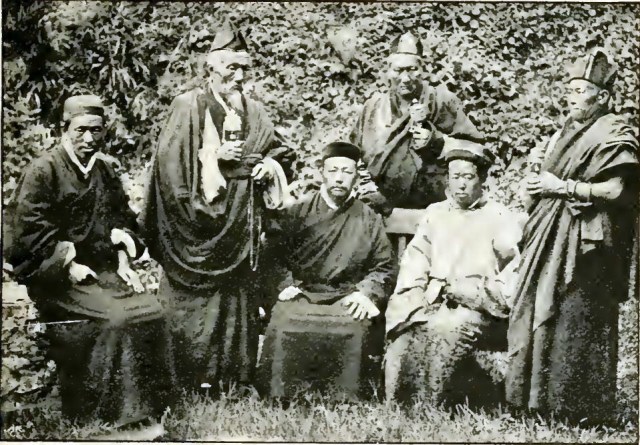
Some Sikhim Lāmas.
Mongol Lāma She-rab A Kar-gyu Lam
Lāma Ugyen Gya-ts’o. A Karma Lāma.
mountain and icy barriers. And the Tan-yik Ser-t’en, which gives the fullest account of St, Padma’s wanderings, and considered the most reliable authority, seems to make no mention of Sikhim. It is extremely improbable that the Guru ever entered Sikhim, especially as, as we have seen, he certainly did not pass through that country either when going to or returning from Tibet.
In keeping, however, with the legendary accounts of his visit, it is alleged by Sikhimite Lāmas that their Lord St. Padma entered the country by the ” Lordly pass ” Jo-la (Ang., Cho-la) and on the east side of the pass is pointed out a rock on which he sat down, called Z’u-ti, or throne, 1 and near the pass. a spot named Sinmoi gyip-tsu, 2 where he surprised a party of female devils preparing to cook their food : here are pointed out two masses of columnar rock alleged to be two of the stones of the tripod used to support the cooking-pot of these demons. And he is said to have returned to Tibet by way of the Je-lep pass, resting en route on the Ku-phu and creating the Tuko La by ” tearing ” up the rock to crush an obnoxious demon. The introduction of Lāmaism into Sikhim certainly dates from the time of Lha-tsun’s arrival there about the middle of the seventeenth century CE. By this time Lāmaism had become a most powerful hierarchy in Tibet, and was actively extending its creed among the Himalayan and central Asian tribes. Three generations of Tibetan colonists from the adjoining Chumbi valley had settled on the eastern border of Sikkim, near Gangtok. And it is highly probable that these Tibetan settlers were privy to the entry of the Lāmas; as it is traditionally reported that the ancestor of that Sikhimite-Tibetan, who was promptly elected king of Sikkim, by Lha-tsun, was a protégé and kinsman of the Sakya Grand Lāma. And Lha-tsun Ch’em-bo seems to have approached Sikhim via Sakya, and his incarnations subsequently appeared in the neighbourhood of Sakya, and even now his spirit is believed to be incarnate in the body of the present Sakya Lāma. Lha-tsun was a native of Kongbu, in the lower valley of the Tsang-po (Brahmaputra), which has a climate and physical appearance very similar to Sikhim, and teems with traces of St. Padmasambhava, “discovered” by celebrated Lāmas, and it had been a happy hunting ground for the Tertons, or discoverers of the fictitious treatises called ” hidden revelations.” Arriving, then, in a country so like his own, and having the virgin soil of Sikhim to work upon, Lhatsün seems to have selected the most romantic spots and clothed them in suitable legendary dress in keeping with his ingenious discovery of St. Padma’s previous visits. And
1 bz’ugs khri. 2 Srin-mohi rgyib gtsuc ” The prophetic mirror of Sikhim.” 1 He seems to have been a man of considerable genius, with a lively sense of the picturesque ; and he certainly left his mark on his adopted country of Sikhim, where his name is now a household word. The traditional account of his entry to Sikhim associates with him two other Lāmas, to wit, a Kar-tok-pa and a Na-dak-pa ; but they play an inconspicuous part in the work of introducing Lāmaism, and it is extremely doubtful whether any representative of these Ñiṅ -ma sub-sects arrived in Sikhim at so early a period. As Lhatsün is so intimately identified with Sikhim Lāmaism, being its de facto founder, it is desirable here to give a summary of his life as extracted from the local histories. Life of Saint Lhatsün,
THE PATRON SAINT OF SIKHIM. (1597-1654)
Lhatsün Chen-bo (also known as Lhatsün Namkha Jimi)2 is a title meaning ” The great Reverend God.” His ordinary religious name is Kun-zan nam-gye or ” The entirely victorious Essence of Goodness.” He is also known by the title of Lhatsün Namkha Jig-med,4 or ” The Reverend God who fears not the sky,” with reference to his alleged power of flying. And he is sometimes called Kusho Dsog-ch’en Chembo, or ” The great Honourable Dsog-ch’en “—Dsog-ch’en, literally ” The Great End,” being the technical name for the system of mystical insight of the Ñiṅ-mapa, and Kusho means ” the honourable.” He was born in the fire-bird year of the tenth of the sixty-year cycles corresponding to 1595 CE., in the district of Kongbu, in south-eastern Tibet. Having spent many years in various monasteries and in travelling throughout Tibet and Sikkim, he ultimately, in the year 1648, arrived in Lhāsa, and obtained such great repute by his learning that he attracted the favourable notice of Ṅag-waṅ, the greatest of the Grand Lāmas, who shortly afterwards became the first Dalai Lāma. Indeed, it is alleged that it was mainly through the special instruction given by Lhatsün to the Grand Lāma that the latter was so favourably treated by the Chinese emperor and confirmed in the temporal rule of Tibet. The detailed account of the saint’s meeting with the Grand Lāma is worth citing in illustration of the curious mixture of the crude and the marvellous which make up the bulk of these indigenous narratives. In
1 Den-joṅ Lungten Sel-wai Meloṅ. 2 Chhem-bo is the Sikhimite mode of pronouncing ” Ch’en-po.” 3 Kun-bzaṅ-rnam-rgyal. 4 lha-btsun nam mk’ah ‘jigs-med.
the year previous to that on which the fifth Grand Lāma went to China, which Csoma gives 1 as 1649 CE., the Grand Lāma, while in his palace at Potala told his attendants, by inspiration, that a sage would that day visit him, and should be admitted to his presence. Lhatsün, arriving at the site now named Pargo-K’aliṅ, immediately below Potala — the Lāmaist Vatican — blew loudly a k’āliṅ, or trumpet of human thigh-bone;- but the castle guard, in ignorance of who the man really was, seized him and tied him to the Do-ring monolith in the neighbourhood, as a punishment for daring to trumpet so close to the’ castle. 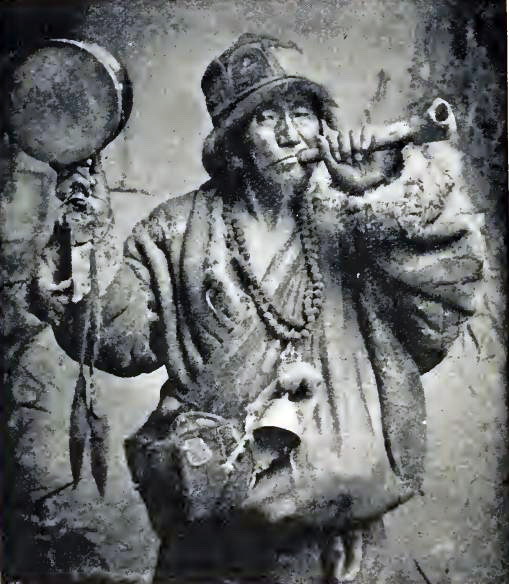
Mendicant Lāma blowing Thigh-bone trumpet 2
1 Gr., p. 190. 2 The illustration is from a photo by Mr. Hoffmann.
, who ordered his instant release and admission. On coming into the presence of the Grand Lāma he walked boldly up and struck the latter with his fist and then vomited before him, much to the astonishment of the courtier Lāmas. The Saint then explained : ” You are shortly going to China ; on the way a great danger besets you, but my striking you has rid you of that danger. In China you will find yourself in great peril some clay ; then consult this paper I now give you, and you will be relieved. My vomiting in your presence means that you will ultimately be invested with great power and riches through me.” The dilemma here prophesied was a query by the Chinese emperor regarding the ” essence of the rainbow colour,” 1 which quite confounded the Grand Lāma, till he, remembering the episode with the Saint, consulted the paper and found full information noted therein, and having completely satisfied the emperor, he received great honour and riches. The Grand Lāma, on his return from China, in gratitude for services rendered, offered Lha-tsun much treasure, which the Saint, however, refused. Previous to his visit to Lhāsa, it is said that the Saint, accompanied by a few disciples, journeyed to the south-west of Tibet, saying : ” According to the prophecy of Guru Rim-bo-ch’e, I must go and open the northern gate of the hidden country of the rice- valleys — De-mo-jong 2, i.e., Sikkim, and I must develop that country religiously.” He then proceeded by way of Tashi-lhunpo and Sakya to Zar, a short distance to the north of Tashi-rabkha near the Nepal frontier, where he then, or afterwards, founded a monastery. He then attempted to enter Sikkim by way of Dsong-ri (Jongri), but could find no path, and remained many days in a cave named Ñam- gah ts’al, 3 ” the very pleasant grove,” near Kaṅ-la naṅ-ma. There ” the everlasting summit of the five repositories (of snow),” the mountain god, Kaṅ-ch’en dso-ṅa 4 transformed himself into a wild goose and conversed with the sage ; and here, ” according to the prophecy of Guru Rim-boch’e,” he composed” the book 5 named ” the complete Book of Worship and offerings for Kaṅ ch’en dso-ṅa. 6 “ At this time another Lāma of the Kar-tok-pa sub-sect came by Kangla Nangma searching for a path into Sikkim, and also tried without success the sPreu-gyab-tak (i.e., ” Monkey-back rock,” with reference to its semblance to a monkey sitting with hands behind back), and Dsong-ri, and the western shoulder of sKam-pa Khab-rag — a ridge of ” Kabru,” which runs down to the Rāthong river. He then arrived at the cave of ” the very pleasant grove,” and met the Saint, who told him that as he was not destined to open the northern gate, he should go round and try the western. Then Lha-tsun, traversing the Kangla Nangma and finding no road beyond the cave of Skam-pa Kha-bruk, flew miraculously to the upper 1 ‘Dsah ts’on sñiṅ po. 2 bras-bmo-ljoṅs. 3 mñam dgah-ts’al. 4 mdsod-lṅa rtag-rtse. 5 ‘rtsom ” is the word used. 6 gaṅs-ch’en mdsod-lṅa mch’od sprin las gnas-yoṅ dsog. part of ” Kabru ” (24,000 feet), and there blew his kang-ling, and after an absence of two weeks flew down to where his servants were collected and guided them by a road via Dsongri to Norbu-gang, in Sikkim. Here soon after arrived two other Ṅiṅ-ma Lāmas. By ” the western gate ” of Single La came the Kar-tok-pa Lāma above mentioned, named “The Great Soul,” 1 and a Lāma of the Na-dak-pa sub-sect, named The Great Sage, 2 who had opened ‘ ; the southern gate” by way of Darjeeling and Namchi respectively. The place where these three Lāmas met was then called by the Lepchas Yoksam, which means ” the three superior ones or noblemen,” a literal translation of “the three Lāmas.” The three Lāmas held here a council at which Lhatsun said : “We three Lāmas are in a new and irreligious country. We must have a ‘ dispenser of gifts ‘ 3 (i.e., a king) to rule the country on our behalf.” Then the Na-dak-pa Lāma said : “l am descended from the celebrated Terton Na-dak Nan-rel, who was a king; I should therefore be the king.” While the Kar-tok-pa Lāma declared : ” As I too am of royal lineage I have the right to rule.” Then Lhatsun said : ” In the prophecy of Guru Rim-bo-ch’e it is written that four noble brothers shall meet in Sikkim and arrange for its government. We are three of these come from the north, west, and south. Towards the east, it is written, there is at this epoch a man named P’un-ts’ok, a descendant of brave ancestors of Kham in Eastern Tibet. According, therefore, to the prophecy of the Guru we should invite him.” Two messengers were then dispatched to search for this P’un-ts’ok. Going towards the extreme east near Gangtok they met a man churning milk and asked him his name. He, without replying, invited them to sit down, and gave them milk to drink. After they were refreshed, he said his name was P’un-ts’ok. He was then conducted to the Lāmas, who coronated him by placing the holy water-vase on his head and anointed him with the water ; and exhorting him to rule the country religiously, they gave him Lha-tsun’s own surname of Namgye 4 and the title of ” religious king.” P’un-ts’ok Namgye was at this time aged thirty-eight years, and he became a Lāma in the same year, which is said to have been 1641 CE. Lhatsun then spent the greater part of the rest of his life in Sikkim, exploring its caves and mountain recesses, composing its Lāmaist legends, and fixing sites for temples and monasteries. He first of all built a hut at Dub-de, which afterwards became the monastery of that name. And he is believed to have built rude shrines at Tashiding, Pemiongchi, and Sang-ṅa-ch’o-ling ; though others assert that Tashiding was first occupied by the original Ṅa-dak-pa Lāma. In appearance Lha-tsun is usually represented as seated on a leopard-skin mat –
1 Sems dpah ch’en-po. 2 Rig-‘dsin ch’en-po. 3 sbyin-dag. 4 rnam-rgyal.
with the right leg hanging down and his body almost bare — one of his titles is He-ru-ka-pa, which means “unclad.” His complexion is of a dark blue hue. Otherwise he is somewhat like his prototype Guru Rim-bo-ch’e. A chaplet of skulls encircles his brow. In his left hand is a skull cup filled with blood, and a trident topped with human heads rests in front of the left shoulder. The right hand is in a teaching attitude. He is believed to be the incarnation of the great Indian teacher Bhīma Mitra. And he himself is held to have been subsequently incarnated twice as a Sikkim Lāma, the last reincarnation being Jik mi Pa-wo, born at Ok-ja-ling near Sakya, who built the present monastery of Pemiongchi. I cannot ascertain the place of his death or what became of his body, but he is currently reported to have died in Sikkim of fever contracted during a visit to India. The dark livid hue of his skin is said to refer to his death from malignant fever. His chief object in visiting India was, according to a popular saying, to obtain a rare variety of ruddy leopard-skin (the sala leopard) which is highly prized by ascetics as a mat. 1 All his clothing and personal effects are carefully treasured in Sikkim and worshipped as most sacred relics. They were all stored at Pemiongchi monastery until the Gorkha invasion of last century, when, for greater safety, most of them were taken to the remote To-lung monastery. At Pemiongchi are kept one set of his full dress robes after the style of Guru Rim-bo-ch’e, including hat and boots, his hand-drum, bell, and dorje, and a miraculous p’urbu dagger for stabbing the demons. These objects are only shown at Pemiongchi on special occasions to wealthy worshippers, and they are highly celebrated as a certain cure for barrenness. Couples afflicted in this way, and who can afford the necessary expense, have a preliminary worship conducted in the Pemiongchi chapel, lasting one or two days. Then the box containing the holy relics is brought forth and ceremoniously opened, and each article is placed on the heads of the suppliant pair, the officiating priest repeating meanwhile the charm of his own tutelary deity. Of the marvellous efficacy of this procedure numerous stories are told. And should two sons result, one of them is certainly dedicated to the Church. Subsequent to Lhatsun Ch’em-bo’s death in the latter end of the seventeenth century, Lāmaism steadily progressed in Sikkim till latterly monks and monasteries filled the country. The list and detailed description of these are given in the next chapter under the heading of Monasteries. What civilization and literature the Sikhimites now possess they owe to Lāmaism, and the Lepcha alphabet too was derived from the Tibetan.
1 Sa gya-gar-tu p’yin ba, don-gsah lai pags-pa.
The religions displaced by Lāmaism were the Pon (Bon), which is usually identified with Taoism, and the earlier animistic and fairy worship of the Lepchas, which can scarcely be called a religion. Numerous traces of both of these primitive faiths are to be found incorporated in Sikkim Lāmaism, which owes any special features that it possesses to the preponderance of these two elements. Only two sects of Lāmas are established in Sikkim, namely, the Ñiṅ-ma-pa and the Kar-gyu-pa as represented by the Kar-ma-pa. There are no Duk-pa monasteries in Sikkim, nor does there seem ever to have been any. The Lāmas number nearly one thousand, and are very numerous in proportion to the Buddhist population of the country. In 1840 1 the Lepchas and Bhotiyas of Sikkim were estimated at 3,000 and 2,000 respectively, but Mr. White, in his census of Sikhim in March, 1891, gives the population roughly as : —
Lepchas … … … 5,800
Bhotiyas … ..’. … 4,700
Nepalese, etc…. 19,500
30,000
As the Nepalese, who are of very recent immigration, are all professing Hindus, the Lāmas are now dependent on the Bhotiyas and Lepchas for support ; and we thus get a proportion of one Lāmaist priest to every ten or eleven of the indigenous population. But this does not represent the full priest-force of those two races, as it takes no count of the numerous devil-dancers and Lepcha priests patronized both by Bhotiyas and Lepchas. In British Sikhim and the Kalim-pong section of British Bhutan, the Lāmaists numbered in the census of 1891 40,520, of which 3,657 were resident in the town of Darjiling. 2 There is no sign of any decrease of Lāmaism in Sikhim, although large numbers of Hindūized Nepalese have lately been introduced into the country, and the government is no longer in the hands of Lāmas.
1 Dr. Campbell in The Oriental, p. 13. 2 ” Census of 1891 Rept.,” p. 47. The total Buddhists in Bengal, including a few thousands of Burmese convicts in Bengal jails, numbered 189,122.
Its Lāmaism is so deeply rooted that, in the absence of any actively anti-Buddhist policy such as has operated in Nepal, it is unlikely to be much affected by the recent political changes, at least for many years to come. Tashiding Monastery (in Sikhim). 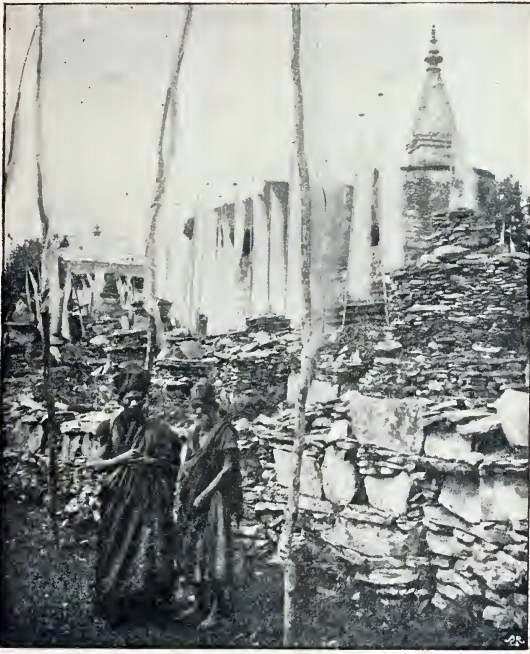
IV. THE SECTS OF LĀMAISM.
The light shed by the lamp of Lamaism, like that of most other religions, has been broken into variegated fragments by the prisms of later priests. No sects appear to have existed prior to Laṅ-Darma’s persecution, nor till more than a century and a half later. The sectarial movement seems to date from the Reformation startedby the Indian Buddhist monk Atīṣa, who, as we have seen, visited Tibet in 1038 CE. 1 Atīṣa, while clinging to Yoga and Tāntrism, at once began a reformation on the lines of the purer Mahāyāna system, by enforcing celibacy and high morality, and by deprecating the general practice of the diabolic arts. Perhaps the time was now ripe for the reform, as the Lāmas had become a large and influential body, and possessed a fairly full and scholarly translation of the bulky Mahāyāna Canon and its Commentaries, which taught a doctrine very different from that then practised in Tibet.A glance at the annexed ” Genealogical Tree of Lāmaist Sects ” will show that Atīṣa was the only profound reformer of Lāmaism.
1 Part of this chapter appeared in the Asiatic Quarterly for January, 1894. 2 bKah-gdams-pa.
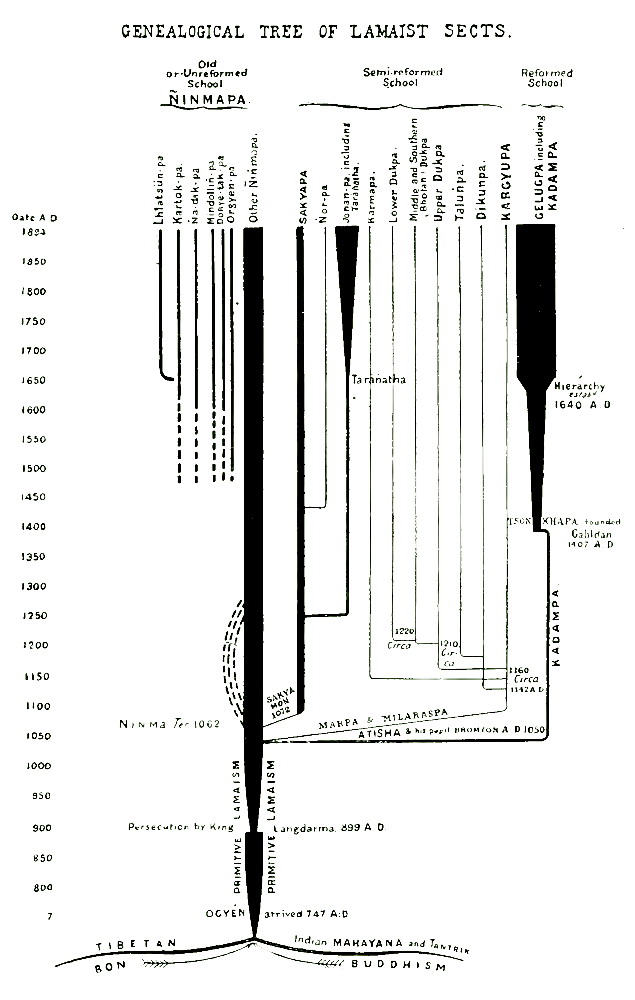 Atīṣa’s chief Tibetan disciple was Ḍom-ton, 1 or “Dom Bakshi,” 2 to whom he taught the mystic Mahāyāna and Tāntrik doctrines which he himself had learned in India and Pegu. Two other noted pupils were K’u and Nak; but Ḍom-ton was the recognized head of the Kah-dam-pa, and he built, in 1058, the Ra-Deng 3 monastery to the north-east of Lhāsa, which was the first lāmasery of the new sect, though the monastery of T’o-din, 4 in Pu-rang, built in 1025, is considered to have become a Kah-dam- pa institution by Atīṣa’s residence therein. Ḍom-ton’s successor was Potova. The rise of the Kāh-dam-pa (Ge-lug-pa) sect was soon followed by the semi-reformed movements of Kar-gyu-pa and Sakya-pa, which were directly based in great measure on Atīṣa’s teaching. The founders of those two sects had been his pupils, and their new sects may be regarded as semi-reformations adapted for those individuals who found his high standard too irksome, and too free from their familiar demonolatry. The residue who remained wholly unreformed and weakened by the loss of their best members, were now called the Ñiṅ -ma-pa or ” the old ones,” as they adhered to the old practices. And now, to legitimize many of their unorthodox practices which had crept into use, and to admit of further laxity, the Ñiṅ -ma-pa resorted to the fiction of Ter-ma or hidden revelations. Just as the Indian monk Nāgārjuna in order to secure an orthodox reception for his new creed had alleged that the Mahāyāna doctrine was entirely the composition of Ṣākya Muni, who had written it during his lifetime and entrusted the volumes to the Naga demigods for preservation until men were sufficiently enlightened to comprehend so abstruse a system, so in the same way several Ñiṅ -ma Lāmas now began to discover new gospels, in caves and 1 ‘Brom-ston rGyal-wahi ‘Byuṅ-gnas. 2 Bakshi is a general term in Central Asia for those monks called in Tibetan Lob-pon, or Teacher ; and it is used by Marco Polo (Yule, i., 305). Pallas says it is Mongolian for sTon, which means “Guide,” and is applied only to the oldest and most learned priest of a community. But the title sTon (-pa) is usually reserved for Buddha. Yule and others believe it to be probably a corruption of ” Bhikhshu,” a Buddhist mendicant monk, and Yule shows it to be used as an equivalent for Lāma by Rashiduddin, and in the Ain-i-Akbāri. Possibly it is also related to the ” Abassi ” of Friar Odoric (Markham, p. xlvi.). Conf. also Koppen, ii., 105. 3 Rva-sgren. 4 mT’o ldin. elswhere, which they alleged were hidden gospels of the Guru, Saint Padma. And these so-called ” revealers,” but really the composers of these Ter-ma treatises, also alleged as a reason for their ability to discover these hidden gospels, that each of them had been, in a former birth, one or other of the twenty-five disciples of St. Padma. Table Showing Descent and Inter-relations of the CREEDS OF THE REFORMED LĀMAIST SECTS.
Atīṣa’s chief Tibetan disciple was Ḍom-ton, 1 or “Dom Bakshi,” 2 to whom he taught the mystic Mahāyāna and Tāntrik doctrines which he himself had learned in India and Pegu. Two other noted pupils were K’u and Nak; but Ḍom-ton was the recognized head of the Kah-dam-pa, and he built, in 1058, the Ra-Deng 3 monastery to the north-east of Lhāsa, which was the first lāmasery of the new sect, though the monastery of T’o-din, 4 in Pu-rang, built in 1025, is considered to have become a Kah-dam- pa institution by Atīṣa’s residence therein. Ḍom-ton’s successor was Potova. The rise of the Kāh-dam-pa (Ge-lug-pa) sect was soon followed by the semi-reformed movements of Kar-gyu-pa and Sakya-pa, which were directly based in great measure on Atīṣa’s teaching. The founders of those two sects had been his pupils, and their new sects may be regarded as semi-reformations adapted for those individuals who found his high standard too irksome, and too free from their familiar demonolatry. The residue who remained wholly unreformed and weakened by the loss of their best members, were now called the Ñiṅ -ma-pa or ” the old ones,” as they adhered to the old practices. And now, to legitimize many of their unorthodox practices which had crept into use, and to admit of further laxity, the Ñiṅ -ma-pa resorted to the fiction of Ter-ma or hidden revelations. Just as the Indian monk Nāgārjuna in order to secure an orthodox reception for his new creed had alleged that the Mahāyāna doctrine was entirely the composition of Ṣākya Muni, who had written it during his lifetime and entrusted the volumes to the Naga demigods for preservation until men were sufficiently enlightened to comprehend so abstruse a system, so in the same way several Ñiṅ -ma Lāmas now began to discover new gospels, in caves and 1 ‘Brom-ston rGyal-wahi ‘Byuṅ-gnas. 2 Bakshi is a general term in Central Asia for those monks called in Tibetan Lob-pon, or Teacher ; and it is used by Marco Polo (Yule, i., 305). Pallas says it is Mongolian for sTon, which means “Guide,” and is applied only to the oldest and most learned priest of a community. But the title sTon (-pa) is usually reserved for Buddha. Yule and others believe it to be probably a corruption of ” Bhikhshu,” a Buddhist mendicant monk, and Yule shows it to be used as an equivalent for Lāma by Rashiduddin, and in the Ain-i-Akbāri. Possibly it is also related to the ” Abassi ” of Friar Odoric (Markham, p. xlvi.). Conf. also Koppen, ii., 105. 3 Rva-sgren. 4 mT’o ldin. elswhere, which they alleged were hidden gospels of the Guru, Saint Padma. And these so-called ” revealers,” but really the composers of these Ter-ma treatises, also alleged as a reason for their ability to discover these hidden gospels, that each of them had been, in a former birth, one or other of the twenty-five disciples of St. Padma. Table Showing Descent and Inter-relations of the CREEDS OF THE REFORMED LĀMAIST SECTS. 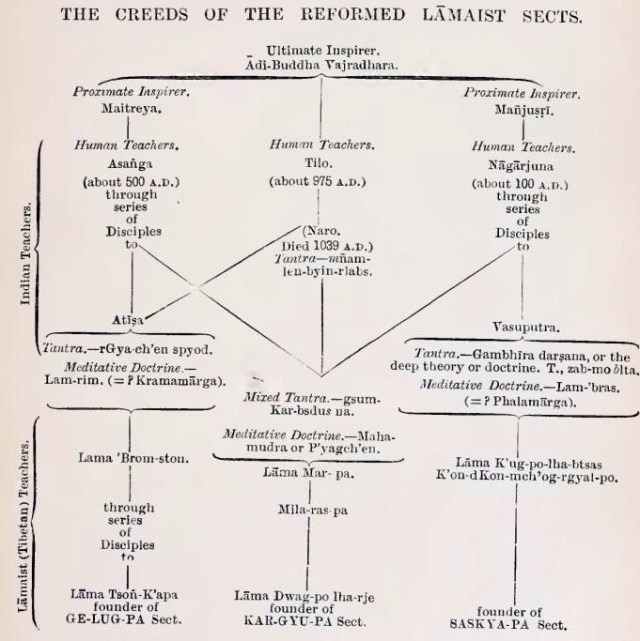 These ” Revelations ” treat mainly of Shamanist Bon-pa and other demoniacal rites which are permissible in Lāmaist practice ; and they prescribed the forms for such worship. About thirty of these revelations have been discovered; but as the number has been oracularly fixed at one hundred and eight, future contingencies are well provided for. These ” Revelations,” relaxing still further the Lāmaist obligations, were eagerly accepted by most Lāmas, and they play an important part in the schisms which subsequently occurred in both old and reformed sects. Indeed, many of the sub-sects differ from their parent sects merely in having adopted a different Ter-ma work as an ordinary code of demoniacal worship. The sectarian distinctions are of a creedal character, entailing different ritualistic and other practices, and expressed by a difference in dress and symbols. The creedal differences may be categorically classed under the heads of — 1. The personality of the primordial deity or Ādi-Buddha ; 2. Special source of divine inspiration ; 3. The saintly transmitters of this inspiration ; 4. Meditative doctrine or system of mystical insight ; 1 5. Special Tāntra-revelation. 6. Personal Tutelary— a Tāntrik demoniacal Buddha of Sivaist type ; 7. Religious ” Guardian “-demon, usually of Tibetan type. In considering the sects individually, let us look first at the sect forming the Established Church — the Ge-lug-pa — as it represents the oldest of the sects, the Kah-dam-pa, and is the purest and most powerful of all, having now the temporal government of Tibet in its hands. The G-e-lug-pa Sect, or Established Church.The G-e-lug-pa arose at the beginning of the fifteenth century CE. as a regeneration of the Kah-dam-pa by Tsoṅ-K’a-pa or Lo-zaṅ -tak-pa 2 or Je-Kim-po-ch’e, though he is better known to Europeans by his territorial title of Tsoṅ-K’a-pa, that is, ” Native of the Onion Country,” the district of his birth, in the province of Amdo, now within the border of China. 3
These ” Revelations ” treat mainly of Shamanist Bon-pa and other demoniacal rites which are permissible in Lāmaist practice ; and they prescribed the forms for such worship. About thirty of these revelations have been discovered; but as the number has been oracularly fixed at one hundred and eight, future contingencies are well provided for. These ” Revelations,” relaxing still further the Lāmaist obligations, were eagerly accepted by most Lāmas, and they play an important part in the schisms which subsequently occurred in both old and reformed sects. Indeed, many of the sub-sects differ from their parent sects merely in having adopted a different Ter-ma work as an ordinary code of demoniacal worship. The sectarian distinctions are of a creedal character, entailing different ritualistic and other practices, and expressed by a difference in dress and symbols. The creedal differences may be categorically classed under the heads of — 1. The personality of the primordial deity or Ādi-Buddha ; 2. Special source of divine inspiration ; 3. The saintly transmitters of this inspiration ; 4. Meditative doctrine or system of mystical insight ; 1 5. Special Tāntra-revelation. 6. Personal Tutelary— a Tāntrik demoniacal Buddha of Sivaist type ; 7. Religious ” Guardian “-demon, usually of Tibetan type. In considering the sects individually, let us look first at the sect forming the Established Church — the Ge-lug-pa — as it represents the oldest of the sects, the Kah-dam-pa, and is the purest and most powerful of all, having now the temporal government of Tibet in its hands. The G-e-lug-pa Sect, or Established Church.The G-e-lug-pa arose at the beginning of the fifteenth century CE. as a regeneration of the Kah-dam-pa by Tsoṅ-K’a-pa or Lo-zaṅ -tak-pa 2 or Je-Kim-po-ch’e, though he is better known to Europeans by his territorial title of Tsoṅ-K’a-pa, that is, ” Native of the Onion Country,” the district of his birth, in the province of Amdo, now within the border of China. 3
1 lTa-wa. Skt., Darṣana. 2 bLo-bzan tak-po (Cf. Koppen, ii., 18). O.M., 115 ; J.A.S.B., 1882, p. 53-57; Pand.,No. 41 ; Howorth, op. cit. 3 He was born in 1355-57 at Kum-bum (see its photograph at page 280).
He was probably, as Huc notes, 1 influenced by the Roman Catholic priests, who seem to have been settled near the place of his birth. Huc’s tradition runs that Tsoṅ-K’a-pa had intercourse with a stranger from the West with a long nose and piercing eyes, who is believed to have 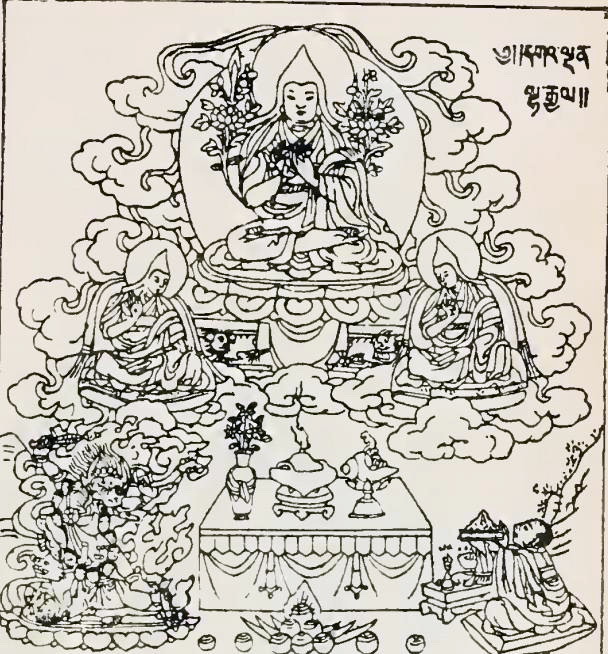 Tsoṅ-K’a-pa rGgyal-ts’ab-rje (disciple). niK’as-gmb-rje (disciple). Vajra-bhairava (tutelary). A votary. been a Christian missionary. He studied at Zhar-Ch’uṅ, in Amdo, and thereafter at Saskya, DiRung, and Lhāsa. He wrote many books, 2 and most of the extant sacerdotal manuals of the Ge- lug-pa sect are attributed to him. He died (or, as is popularly believed, ascended to Heaven 3 ) in 1417,and was canonized as an incarnation of Mañjuṣṛī (or, some say, Amitābha, or Vajrap Tsoṅ-K’a-pa ṇi). And by the Ge-lug-pa he is considered superior even to St. Padma and Atīṣa, and is given the chief place in most of their temples. His image is placed above, and usually between, those of the dual Grand Lāmas — the Dalai and Pan-ch’en — and, like these, he is given the title of Gyal-wa, or The Jina or Victor. His image is also worn as a charm in amulet boxes. Tsoṅ-K’a-pa received the traditions of the Kah-dam-pa sect from the Lāma Ch’os skyabs-bzaṅ-po, the seventy-eighth abbot in succession from Ḍom-ton. Unlike Atīṣa, Tsoṅ-K’a-pa was an ardent proselytizer, and spent most of his strength in organization. He collected the scattered members of the Kah-dam-pa from their retreats, and housed them in monasteries, together with his new followers, under rigid discipline, setting them to keep the two hundred and thirty-five Vinaya rules, 1 and hence obtaining for them the title
Tsoṅ-K’a-pa rGgyal-ts’ab-rje (disciple). niK’as-gmb-rje (disciple). Vajra-bhairava (tutelary). A votary. been a Christian missionary. He studied at Zhar-Ch’uṅ, in Amdo, and thereafter at Saskya, DiRung, and Lhāsa. He wrote many books, 2 and most of the extant sacerdotal manuals of the Ge- lug-pa sect are attributed to him. He died (or, as is popularly believed, ascended to Heaven 3 ) in 1417,and was canonized as an incarnation of Mañjuṣṛī (or, some say, Amitābha, or Vajrap Tsoṅ-K’a-pa ṇi). And by the Ge-lug-pa he is considered superior even to St. Padma and Atīṣa, and is given the chief place in most of their temples. His image is placed above, and usually between, those of the dual Grand Lāmas — the Dalai and Pan-ch’en — and, like these, he is given the title of Gyal-wa, or The Jina or Victor. His image is also worn as a charm in amulet boxes. Tsoṅ-K’a-pa received the traditions of the Kah-dam-pa sect from the Lāma Ch’os skyabs-bzaṅ-po, the seventy-eighth abbot in succession from Ḍom-ton. Unlike Atīṣa, Tsoṅ-K’a-pa was an ardent proselytizer, and spent most of his strength in organization. He collected the scattered members of the Kah-dam-pa from their retreats, and housed them in monasteries, together with his new followers, under rigid discipline, setting them to keep the two hundred and thirty-five Vinaya rules, 1 and hence obtaining for them the title
1 Travels in Tartary, etc., Hazlett’s trans., ii., 48. 2 Chief of which was The Gradual Way (Lām-rim). 3 His ascension is celebrated during the Lāmaist festival of Lamps.
Ge-lug-pa Monk and Attendant.
of Vinaya-keepers or ” Dul-wa Lāmas:” He also made them carry a begging-bowl, anardhachuna, 2 prayer -carpet, 3 and wear patched robes 4 of a yellow colour, after the fashion of the Indian mendicant monks. And he attracted followers by instituting a
1 Including retirement during Lent for meditation, etc. 2 The zla-gam or crescentic cope or cape. 3 gding-wa. 4 dras-drubs. See detailed description at p. 200.
highly ritualistic service, in part apparently borrowed from the Christian missionaries, who undoubtedly were settled at that time in Tsoṅ-K’a, the province of his early boyhood in Western China. He gave the hat named pān-ssa-sne-riṅ, or the “Pundit’s long-tailed cap ” ; and as it was of a yellow colour like their dress, and the old Lāmaist body adhered to their red hat, the new sect came to be popularly called the S’a-ser or ” Yellow-cap,” in contradistinction to the S’a-mar or ” Red-cap ” and their more aboriginal Bon-pa co-religionists the S’a-nak or “Black-caps.” 1 This seems to be the origin of the sect-titles depending on the colour of the cap. The Kah-dam-pa are said to have worn red caps, and certainly the extant pictures of Atīṣa and other Kah-dam-pa Lāmas give them red caps. Tson-K’a-pa named his own monastery, which he built in 1409 about thirty miles east of Lhāsa, Gah-dan 2 or Paradise, and it is said that his followers at first went by the name of Gah-lug- pa or ” Followers of the Gah-dan fashion ” ; but as this name was ill-sounding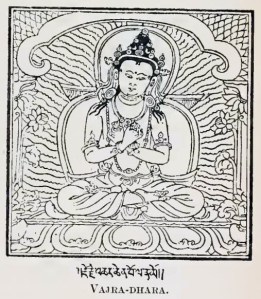 it was changed to the more euphonic Ge-lug-pa or ” Followers of the Virtuous order.” The special sectarian distinctions of the Ge-lug-pa, which represent the earlier Kah-dam-pa sect,are that this sect has the mythical Vajradhara as its Ādi-Buddha ; and derives its divine inspiration from Maitreya — “the coming Buddha,” through the Indian Saints ranging from Asaṅga down to Atīṣa, and through the Tibetan Saints from his disciple Brom-ton to Tsoṅ-K’a-pa (Je-Rim-po-ch’e). The Ge-lug-pa mystical insight (Ta-wa) is termed the Lam-rim or “the Graded Path,” and their Tantra is the “Vast Doer” (rgya-ch’en spyod).
it was changed to the more euphonic Ge-lug-pa or ” Followers of the Virtuous order.” The special sectarian distinctions of the Ge-lug-pa, which represent the earlier Kah-dam-pa sect,are that this sect has the mythical Vajradhara as its Ādi-Buddha ; and derives its divine inspiration from Maitreya — “the coming Buddha,” through the Indian Saints ranging from Asaṅga down to Atīṣa, and through the Tibetan Saints from his disciple Brom-ton to Tsoṅ-K’a-pa (Je-Rim-po-ch’e). The Ge-lug-pa mystical insight (Ta-wa) is termed the Lam-rim or “the Graded Path,” and their Tantra is the “Vast Doer” (rgya-ch’en spyod).
1 See page 196 for pictures of the caps. 2 Skt., “Tushita” or the Happy place.
Its tutelary demoniacal Buddha is Vajra-bhairava (Dorje-‘jig-je), supported by Samvara (Dem-ch’og) and Guhya-kālā (Sang-dū). And its Guardian demons are “The Six-armed Gon-po or Lord ”
The Tutelary Tam-ḍin’s Charm.
and the Great horse-necked Hayagriva (Tam-ḍin), or the Red Tiger-Devil.
But, through Atīṣa, the Ge-lug-pa sect, as is graphically shown in the foregoing table, claims also to have received the essence of Mañjuṣṛī ‘s doctrine, which is the leading light of the Sakya-pa sect. For Atīṣa is held to be an incarnation of Mañjuṣṛī, the Bodhisattva of Wisdom : which is merely a way of stating that he was the greatest embodiment of Buddhist Wisdom that ever visited Tibet. And in the person of Atīṣa were also united the essentials of the Kar-gyu-pa sect by his pupilage to the Indian sage Nāro. Thus the Ge-lug-pa sect claims that through Atīṣa it has received the special inspiration of Maitreya, and in addition all that is best in the special systems professed by the other two reformed sects. The purer morality practised by the Ge-lug monks gained them general respect. So, despite their internecine feuds with the Sakya-pa and other rival sects, its Church grew in size and influence, and became a powerful hierarchy with the succession of its chief abbot based upon the theory of Re-incarnation, namely, that the spirit of the dead chief after his death is re-born in a child, who was forthwith found by oracular presage, and installed in the vacant chair. Tsoṅ-K’a-pa’s nephew, Ge-dun-dub, was installed in 1439 as the first Grand Lāma of the Ge-lug-pa Church, and he built the monastery of Tashi-lhunpo, in 1445, while his fellow workers Je-She-rabSeṅ-age Gyal-Ts’ab-je and Khas-grub-je had built respectively De-p’ung (in 1414), and Se-ra (in 1417), the other great monasteries of this sect. Under the fourth of these Grand Lāmas, the Ge-lug-pa Church was vigorously struggling for supreme power and was patronized by the Mongol minister of the Chinese Government named Chong- Kar, who, coming to Lhāsa as an ambassador, usurped most of the power of the then king of Tibet, and forced several of the Kar-gyu and Ñiṅ-ma monasteries to join the Ge-lug-pa sect, and to wear the yellow caps. And, as we have seen in the previous chapter, the Ge-lug-pa sect in 1640, under its fifth Grand Lāma, leapt into temporal power as the dominant sect in Tibet, and has ever since remained the Established Church of the country. Since then, however, the Ge-lug-pa sect has gradually retrograded in its tenets and practice, till now, with the exception of its distinctive dress and symbols, celibacy and greater abstinence, and a slightly more restricted devil-worship, it differs little from the other Lāmaist sects, which in the pride of political power it so openly despises.
The Kar-gyu-pa Sect.
The Kar-gyu-pa, the next great reformed sect after the Ge-lug-pa, was founded in the latter half of the eleventh century CE. by Lāma Marpa 1 of Lha-brag, who had visited India and obtained special instructions from the Indian Pandit Atīṣa and his teacher P’am-thiṅ and Naro, the janitor of Nālanda University, who never visited Tibet. But as Marpa and his successor Milara-pa, while nominally having 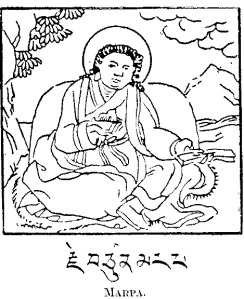 a monastery at Gro-bu-luṅ and sG-rub – p’ug – matogs, respectively, led hermit lives, the real organizer of this sect was the Kah-dam-pa Lāma, Dvag-po lha-rje, 2 who founded the monastery of Ts’ur-lha about 1150. The name Kar-gyu-pa 3 means a ” follower of the successive orders,” expressive of the fact that the sect believes that the rulings of its later sages are inspired. Naro’s teacher, the monk Tilo or Telo (about 950 a.d.) 4 is held to have been directly inspired by the metaphysical Buddha Vajra-dhara. Its distinctive features are its hermit practices, meditation in caves and other retired places, and the following specialities : — Its inspiration was attributed by their saint Tilo directly to the Ādi-Buddha Vajra-dhara. Its mode of mystic insight (Ta-wa) is named Mahāmudra 5 or ” the Great Attitude,” also called U-mahi Lam or ” the Middle Path,” and its Tantra is ” Sum-
a monastery at Gro-bu-luṅ and sG-rub – p’ug – matogs, respectively, led hermit lives, the real organizer of this sect was the Kah-dam-pa Lāma, Dvag-po lha-rje, 2 who founded the monastery of Ts’ur-lha about 1150. The name Kar-gyu-pa 3 means a ” follower of the successive orders,” expressive of the fact that the sect believes that the rulings of its later sages are inspired. Naro’s teacher, the monk Tilo or Telo (about 950 a.d.) 4 is held to have been directly inspired by the metaphysical Buddha Vajra-dhara. Its distinctive features are its hermit practices, meditation in caves and other retired places, and the following specialities : — Its inspiration was attributed by their saint Tilo directly to the Ādi-Buddha Vajra-dhara. Its mode of mystic insight (Ta-wa) is named Mahāmudra 5 or ” the Great Attitude,” also called U-mahi Lam or ” the Middle Path,” and its Tantra is ” Sum-
1 Marpa, according to Sum-pa K’an-po’s Ch’os-‘byuṅ, was born at Gro-bu-luṅ po gsar, as the second son of dbAṅ-p’yug-‘od, his mother being sKal-ldan sKyd gñis. His son when riding to Talung monastery to witness a Lāma’s dance was thrown down the cliff and fearfully mangled owing to his horse in a rocky defile taking fright at the flight of some rock pigeons. This scene is pictured often in Kar-gyu-pa temples. (Cf. also Pand., No. 32.) 2 Also called
kar-bsuds-sum. 1 Its tutelary demon is Samvara. Its guardian deity “The Lord of the Black Cloak. 2 Its hat is “the meditation hat with the cross-knees,” bearing on its front this emblem as a badge like a St. Andrew’s cross (X), and a conical centre-piece representing a cave elsewhere. And with these technicalities was associated a stricter observance of the monastic rules and discipline. The most popular Kar-gyu-pa saint, and one who, while founding no monastery, did more even than Marpa, to establish the sect, was Marpa’s pupil, Mila-ra-pa. 3 He never visited India, but led a wandering ascetic life among the mountains of Tibet, and his 100,000 songs 4 containing much Tibetan colouring are popular amongst all the sects of Lāmas, and his name is now a household word throughout Tibet. He is pictured, as seen in the annexed illustration, as a thinly-clad ascetic almost on the Indian model, enduring great hardships of climate and exposure, and a great magician conquering many demons. His picture is surrounded by scenes illustrative of the leading events of his life. His biography is sketched here in a footnote, 5 as he is a person of importance in Lāmaism. It is contained in a bulky volume
1 Marpa’s scripture was based upon the ” mñam-len byin rlabs,” which he diluted and mixed with more mystic Tantras; hence his Tantra is called “the mixed” (zuṅ-‘jug). The so-called esoteric is the ” mdo lugs-stong-pa-nyid,” and the esoteric” sṅags lugs bde stoṅ dbyer med, which are referred to in the chapter on Doctrine. For some technical details regarding; several sects, see transl. by SARAT, J.A.S.B., 1883 ; also Ramsay’s Dict. 2 mGon-po bar-nag. 3 Mi-la-ras-pa or ” the Cotton-clad.” (Cf. CSOMA, Gr., 181; TĀRA., 328 ; PAND., No. 31.) 4 glu-‘bum. 5 He was born at Kya-ṅan-tsa in the year 1038 a.d., on the 28th day of the month, under the planet phur-bu, and named Thos-pa-dgal. His father, Mila-shes-rab-rgyal-mts’an, was a wealthy merchant of the K’uṅ-po clan of Uru-chaṅ-ch’og, and his mother was Gyaṅ-tsa dkar-rgyan. The father died when Thos-pa-dgal (the young Mila) was only seven years old, leaving his property in his brother’s charge till his son reached his majority at fifteen. This uncle, however, appropriated everything to himself, and left young Mila and his mother destitute, and even persecuted them. Young Mila’s mother, therefore, sent her son to become a Lāma in order to learn the Mt’u-art of destroying people by sorcery. So he started off for Lhun-grub grong K’ah in Guṅ-t’oṅ-stod, and there joined a party of monks on their way from Upper Ṅari to Ü (or Central Tibet). Passing Yag-sde, and crossing Mar-tsaṅ, he reached T’on-luṅ-raga in Ü), and found at Yar-luṅ skyo-mo-Kruṅ a learned ” mt’u ” teacher named Yuṅ sTon-p’ro-rgyal, who taught him sorcery for several years, until he obtained the power to destroy his cruel uncle’s house and gear. After being instructed in the mode of compelling hailstorms, he went to Magon (or gTsaṅ- roṅ-gi-nari, and then to Ch’os-la sgang, where he became a pupil of Lāma Marpa, who had visited India. Here he was set many tiresome tasks by Marpa, such as building forts and pulling them to pieces again
ascribed to his disciple Räs-ch’uṅ, and dated from the hermitage of the latter. AFFILIATION OF SUB-SECTS OF THE KAR-GYU-PA. 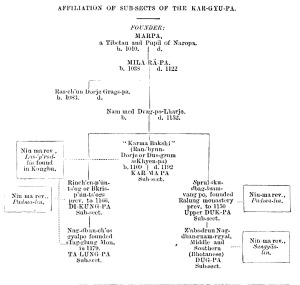 , and the pictures of these tasks are favourite subjects for frescoes in Kar-gyu-pa monasteries. As the tasks seemed endless and Marpa still withheld instruction, the young Mila fled, taking with him the Indian saint Naropa’s six-bone ornaments and padma-raga-rosary, which had been in Marpa’s keeping as relics ; and which young Mila obtained possession of by the connivance of Marpa’s wife, bDag-med-ma. These relics he offered to Lāma rṄog-pa, who in return gave him instruction and the meditation of Groṅ-ldan p’ug-pa. Then Marpa recalled him and initiated him into the mysteries of the magic circles, and gave him the esoteric name of dPal-s’es-pa and the common name of Mila-rdo-rje rgyal mts’an, and set him severe ascetic exercises. Meanwhile Marpa went to India, and met the monk Naropa at the monastery of Bula-hari, and was taught ‘p’o-wa-stoṅ-‘jug, and returned to Tibet by Ch’os-la gaṅ. When Mila returned home, he found his mother dead, so he dwelt in a cave near by named Kaṅ-mdsod phug. Then his uncle and aunt assaulted him on his begging excursions, but though possessing the power of destroying them, he preferred to flee from them to Brag Kar-rta-so, near Kyi-roṅ, where he remained in meditation for eighteen years, living solely on Mila-ra-pa’s chief pupils were Dvag-po-lha-rje, 1 who continued the succession of the orthodox Kar-gyu-pa doctrine, and Ra-ch’uṅ Dor-je Tag-pa, 2 who did not interest himself in organization. The hermit-feature of this sect rendered it so unattractive, that several sub-sects soon arose which dispensed with the necessity for hermitage. Thus appeared the sub-sects Kar-ma-pa, Dī-kung-pa, Ta-lung-pa, and Duk-pa (the form dominant in Bhutan), which differ from each other merely in having each adopted a different revelation from the Ñiṅ -ma sect as a code of demoniacal worship, and so relaxing the purity of the former Kar-gyu-pa practice. These differences are shown in the foregoing table. And the image of the particular founder of the sub-sect shares with that of their Ādi-Buddha, Vajradhara, the chief place in their temples. The Kar-ma-pa sub-sect was founded in the middle of the twelfth century by Kar-ma-pa Raṅ-ch’uṅ Dor-je, also named Du-sum K’yen-po, 3 a pupil of the aforesaid Dvag-po-lha-rje. His monastery of S’u-Ts’ur Lha-luṅ, 4 built in 1154, at Ts’ur-p’u, about one day’s journey to the north of Lhāsa beyond Sera, is still the headquarters of this, the most powerful of all the Kar-gyu-pa subsects. 5 This Kar-ma Lāma does not appear to be identical with the famous ” Kar-ma-Bakshi,” 6 whose image is the central one in all Kar-ma-pa temples, for “his birth is placed by Csoma later. 7 The ninth head Kar-ma-pa Lāma was named dGu-pa-bar Phyug Dor-je, and was alive in 1725 CE., when the then raja of Sikkim visited him in Tibet and was prevailed on by him to establish some Kar-ma-pa monasteries in Sikkim.
, and the pictures of these tasks are favourite subjects for frescoes in Kar-gyu-pa monasteries. As the tasks seemed endless and Marpa still withheld instruction, the young Mila fled, taking with him the Indian saint Naropa’s six-bone ornaments and padma-raga-rosary, which had been in Marpa’s keeping as relics ; and which young Mila obtained possession of by the connivance of Marpa’s wife, bDag-med-ma. These relics he offered to Lāma rṄog-pa, who in return gave him instruction and the meditation of Groṅ-ldan p’ug-pa. Then Marpa recalled him and initiated him into the mysteries of the magic circles, and gave him the esoteric name of dPal-s’es-pa and the common name of Mila-rdo-rje rgyal mts’an, and set him severe ascetic exercises. Meanwhile Marpa went to India, and met the monk Naropa at the monastery of Bula-hari, and was taught ‘p’o-wa-stoṅ-‘jug, and returned to Tibet by Ch’os-la gaṅ. When Mila returned home, he found his mother dead, so he dwelt in a cave near by named Kaṅ-mdsod phug. Then his uncle and aunt assaulted him on his begging excursions, but though possessing the power of destroying them, he preferred to flee from them to Brag Kar-rta-so, near Kyi-roṅ, where he remained in meditation for eighteen years, living solely on Mila-ra-pa’s chief pupils were Dvag-po-lha-rje, 1 who continued the succession of the orthodox Kar-gyu-pa doctrine, and Ra-ch’uṅ Dor-je Tag-pa, 2 who did not interest himself in organization. The hermit-feature of this sect rendered it so unattractive, that several sub-sects soon arose which dispensed with the necessity for hermitage. Thus appeared the sub-sects Kar-ma-pa, Dī-kung-pa, Ta-lung-pa, and Duk-pa (the form dominant in Bhutan), which differ from each other merely in having each adopted a different revelation from the Ñiṅ -ma sect as a code of demoniacal worship, and so relaxing the purity of the former Kar-gyu-pa practice. These differences are shown in the foregoing table. And the image of the particular founder of the sub-sect shares with that of their Ādi-Buddha, Vajradhara, the chief place in their temples. The Kar-ma-pa sub-sect was founded in the middle of the twelfth century by Kar-ma-pa Raṅ-ch’uṅ Dor-je, also named Du-sum K’yen-po, 3 a pupil of the aforesaid Dvag-po-lha-rje. His monastery of S’u-Ts’ur Lha-luṅ, 4 built in 1154, at Ts’ur-p’u, about one day’s journey to the north of Lhāsa beyond Sera, is still the headquarters of this, the most powerful of all the Kar-gyu-pa subsects. 5 This Kar-ma Lāma does not appear to be identical with the famous ” Kar-ma-Bakshi,” 6 whose image is the central one in all Kar-ma-pa temples, for “his birth is placed by Csoma later. 7 The ninth head Kar-ma-pa Lāma was named dGu-pa-bar Phyug Dor-je, and was alive in 1725 CE., when the then raja of Sikkim visited him in Tibet and was prevailed on by him to establish some Kar-ma-pa monasteries in Sikkim.
vegetables, and performing many miracles. Then he went to Dig-ri plain, where he met Pari, the translator, and his pupils. Thereafter he went to ‘Brin-yul, and afterwards to a cave in Lab-śi-śu-gar (? Mount Everest), where he died. His favourite god was Kuvera, the King of the Yaksha genii. 1 Also called rJe-Tsun sGam-po. See PANDER, No. 33. 2 Ras-ch’uṅ rdo-rje grags-pa, born 1083, founded Ras-ch’uṅ p’ug monastery. 3 Raṅ-‘byuṅ-rdo-rje dus-gsum-mk’yen-po, born 1109, ordained 1124, died 1192. 4 Ts’u-mts’ur. 5 It was zealously patronized by De-si Zaṅ-po, a King of Western Tibet, with his capital at Shigatse. 6 Cf. CSOMA, Gr., 186 ; J.A.S.B., 51, p. 53 ; PAND. No. 39. 7 In Gram., 185, Kar-ma-Bakshi’s birth is given as 1177 CE. It differs from its parent sect in having retrograded towards the Ñiṅ-ma -pa practices by adopting the Ñiṅ-ma revelation found in Kong-bo and entitled Le-to Liṅ-pa, 1 or ” the locally revealed merit,” and some also have ‘Jah-ts’on-pa. Few of the Kar-ma Lāmas are celibate, and Marpa, the founder of the parent sect (Kar-gyu-pa), was married. The next great sub-sect is the Dug-pa, 2 which also arose with a pupil of Mila-ra-pa’s disciple, Dvag-po. Its founder was Pag-Sam-Wang-po, 3 and it originated in the gNam province of Tibet about the middle of the twelfth century, at the Ralung monastery, near Gyan-tse, in Tod or Upper Tibet, To emphasize the change the monastery was called Dug-Ralung, and a legend of the thunderdragon or Dug is related in connection therewith, and gives the sectarian title. It adopted the same revelation as the Di-kung-pa, but there seems some other distinctive tenet which I have not yet elicited. Much confusion has been caused in European books by misusing the name Dug-pa, employing it as a synonym for the ” red-hat ” sect, which properly is the Ñiṅ-ma. The Middle Dug-pa and the Lower Dug-pa arose soon afterwards. The Middle Dug-pa adopted the revelation of Saṅ-gyas-liṅ-pa. This is the form of Kar-gyu-pa which now prevails in Bhutan under the name of Lho Dug-pa or ” Southern ” Dug-pa. Its chief Lāma is Z’ab-druṅ Nag-baṅ-nam-gyal, 4 a pupil of Padma dKkar-po” or “The omniscient white lotus,” who leaving Southern Tibet in the seventeenth century CE., 5 settled at ” lChags-ri rta mgo ” in Bhutan, and soon displaced the Karthok-pa and other forms of Ñiṅ-ma Lāmaism then existing in that country, and which are reputed to have been founded there directly by St. Padma himself, who entered Bhutan via gZ’as-ma gaṅ and left it by mDuṅ tsaṅ, and at rfGron-ts’al p’u are still shown his footprints on a rock, and at the sPa-te tak-ts’aṅ or tiger’s den. 6
1 Las-‘prod-liṅ-pa. 2 ‘brug-pa. It is Sanskritised in the Chronicle of Ṅag-waṅ Nam-gyal as Megha Svara or ” Cloud-voice,” thunder being regarded as the dragon’s roar. 3 dPag-bsam dbaṅ-po, who seems to be identical with, or patronized by, ‘Gro-mgon rtsaṅ-pa rgyal ras, ” The Victory-clad Patron of Animals ” (? born 1160 CE.). 4 His title is bdud-‘jom-rdorje, or “the Vajra which Softened the Devils.” 5 CSOMA, J.A.S.B., 1832, 126. 6 According to the Thaṅ-yig sde-lṅa. some historic notes on the history of Lāmaism in Bhutan are to be found in the book Lho-Ch’os ‘byuṅ.
THE DUG-PA AND SA-KYA-PA. In Bhutan the Dug-pa sect possesses the temporal as well as the spiritual power, and has suppressed all other sects there. Some details of its chief monasteries and hierarchs are given in the special chapters on these two subjects. The Dī-kung-pa,1 another large sub-sect, also originated with a pupil of Dvag-po. It takes its title from the Dī-kung monastery founded by Rinch’en-p’un-ts’og and Je-spyan-sṅa-wa, in 1177 CE. 2 Its revelation is Ñiṅ-ma the Padma-liṅ-pa. The Ta-lung-pa 3 issued from the Dī-kung-pa and takes its title from the Ta-lung monastery founded by Ṅag-dbaṅ-ch’os-gyalpo in 1178. They differ from their parent Dī -kung-pa in admitting also the revelation work adopted by the Kar-ma-pa, namely, the Le-to liṅ-pa. The Sa-kya-pa Sect. The last great reformed sect is the Sa-skya-pa 4 or Sakya, taking its name from the yellow colour of the scanty soil at the site of its first monastery in western Tibet, founded in 1071 CE. It grew into a most powerful hierarchy, and attained for a time the temporal sovereignty over the greater part of Tibet before it was eclipsed by its Ge-lug-pa rival.Its founder was K’on-dkon-mch’og rgyal-po, 5 a pupil of K’ug-pa lha-btsas, who claimed inspiration from the celestial Bodhisat of wisdom, Mañjuṣṛī, through the Indian sages ranging from Nāgārjuna 6 to Vasuputra, 7 and he mixed together the “old” and the “new” Tantras, calling his doctrine the “new-old occult mystery ” 8 of “The deep sight.” 9 Its mystic insight is called ” The fruitful path.” 10 Its special gospels are Nāgārjuna ‘s Avataṅsaka, Vasubandhu’s Paramārtha. Its tutelary demon is Vajra
1 ‘Bri-guṅ. 2 CSOMA, Gram., 185. 3 sTag-luṅ. 4 Sa-skya-pa, from Sa-skya = “tawny earth.” 5 Born 1033. Details of the sect are found in its records, The Sa-skya Yig-ts’aṅ. 6 These are given as Candra-Kirti, Rig-pahi-K’u-p’yug, Buddha “dgoṅs “-pāla. 7 Yab-sras. — Vasuputra seems a title of the great Indian monk Vasubandhu, the brother of Asaṅga, and the special transmitter of Nāgārjuna ‘s purer Sautrāntika doctrines, inspired by Mañjuṣṛī. 8 gṣar-ñiṅ. 9 zab-mo-blta — Gambhira darṣana. 10 mgon-po gur.
phurpa, for whose and other demonist worship it borrowed the Ñiṅ-ma books, Dorje phurpach’i ch’oga ; and from the newer school were taken Dem-ch’ok, Dorje-kando, Den-z’i, Mahā-mahā- ma-yab, Saṅgya t’opa, and Dorje- dutsi. Its demoniacal Guardians are ” the Guardian of the Tent,”1 and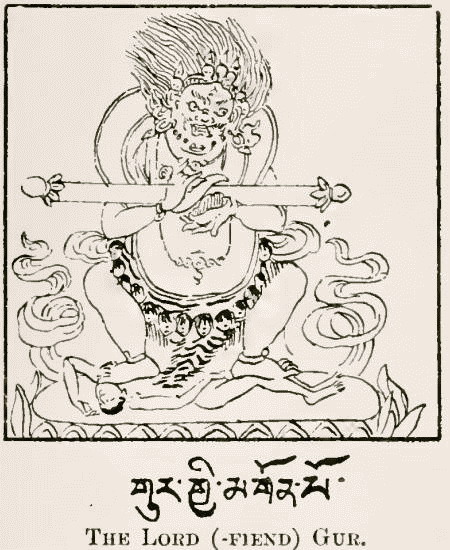 ” The Face-Lord.” 2 Its Hat is sā-z’u. But now except in a few externals it is practically indistinguishable from the Ñiṅ-ma -pa. The Sa-kya-pa has two re-formed subsects, namely, the Ṅor-pa and the Jonaṅ-pa. These differ from one another only in founders. The Jo-naṅ -po issued from the Sa-kya-pa in the person of Je-Kun-gah-dol-ch’og 3 in the beginning of the fourteenth century. To this sect belonged the illustrious historiographer, Lāma-Tāranātha. Tāranātha, son of Nam-gyal P’un-ts’ogs, was born in Tsang on the 8th day of the pig-male-tree year, corresponding to 1573 CE., and was called Kun-dgah sṄyiṅ-po, 4 or ” The essence of happiness.” He studied in the Jonang monastery, north of Sakya under the religious name of Tāranātha, and in his forty-first year built himself a monastery in the neighbourhood, which he named rTag-brten, and filled it with many images, books, and cetiyas.
” The Face-Lord.” 2 Its Hat is sā-z’u. But now except in a few externals it is practically indistinguishable from the Ñiṅ-ma -pa. The Sa-kya-pa has two re-formed subsects, namely, the Ṅor-pa and the Jonaṅ-pa. These differ from one another only in founders. The Jo-naṅ -po issued from the Sa-kya-pa in the person of Je-Kun-gah-dol-ch’og 3 in the beginning of the fourteenth century. To this sect belonged the illustrious historiographer, Lāma-Tāranātha. Tāranātha, son of Nam-gyal P’un-ts’ogs, was born in Tsang on the 8th day of the pig-male-tree year, corresponding to 1573 CE., and was called Kun-dgah sṄyiṅ-po, 4 or ” The essence of happiness.” He studied in the Jonang monastery, north of Sakya under the religious name of Tāranātha, and in his forty-first year built himself a monastery in the neighbourhood, which he named rTag-brten, and filled it with many images, books, and cetiyas.
He latterly proceeded to Mongolia at the invitation of the people of that country, and founded there several monasteries under the auspices of the Chinese Emperor. He died in Mongolia, and was canonized under the title of “The Reverend Holiness “Je-tsun dam-pa. 5 And his “re-incarnate” successors are now installed with great magnificence as Grand Lāmas at Urgya in the Kalkha
1 mGon-po gur. 2 mGon-zhal. 3 Who seems also to be called Dol-bu sher-rgyan. Born 1290, and died 1353. 4 Skt, Anandagarbha. Another account gives the name as Srī -gcod rdorje. 5 rJe-btsun dam-pa.
province of Mongolia, to the east of Lob-Nor. Shortly after his death, both Urgya and his old monastery — which was renamed — ” P un-ts’o-lin,” 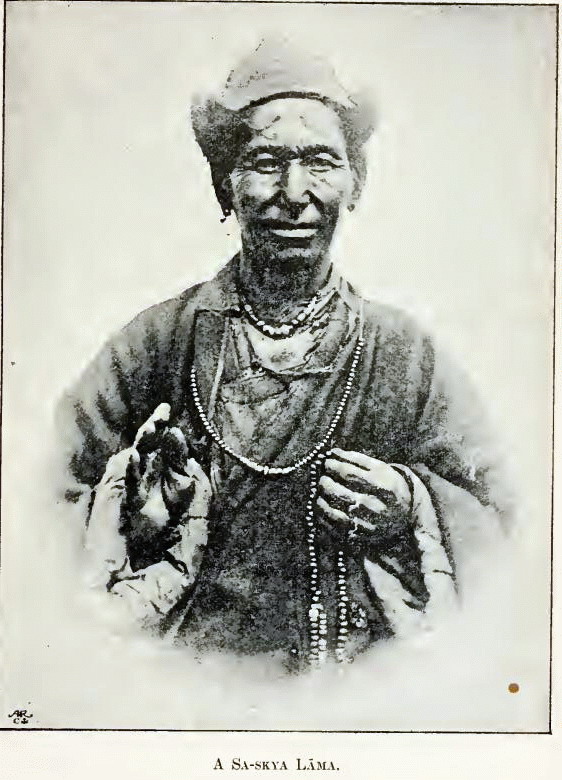
A Sa-skya Lāma.
were forcibly converted into Ge-lug-pa institutions, by the aggressive Dalai Lāma on his becoming priest-king. The Ṅor-pa, founded by Kun-gah Zaṅ-po in 1427, issued from the Sa-kya-pa at the time of Tsoṅ-K’apa. Its founder discarded the Ñiṅ-ma element in its Tāntrik system, retaining only the ” new.” It has many monasteries in eastern Tibet.
The Ñiṅ-ma-pa Sects.
The wholly unreformed section of the Lāmas was, as we have seen, named Ñiṅ-ma -pa, or ” the old school. It is more freely, than any other ,tinged with the native Bon or pre-Buddhist practices ; and celibacy and abstinence are rarely practised. This 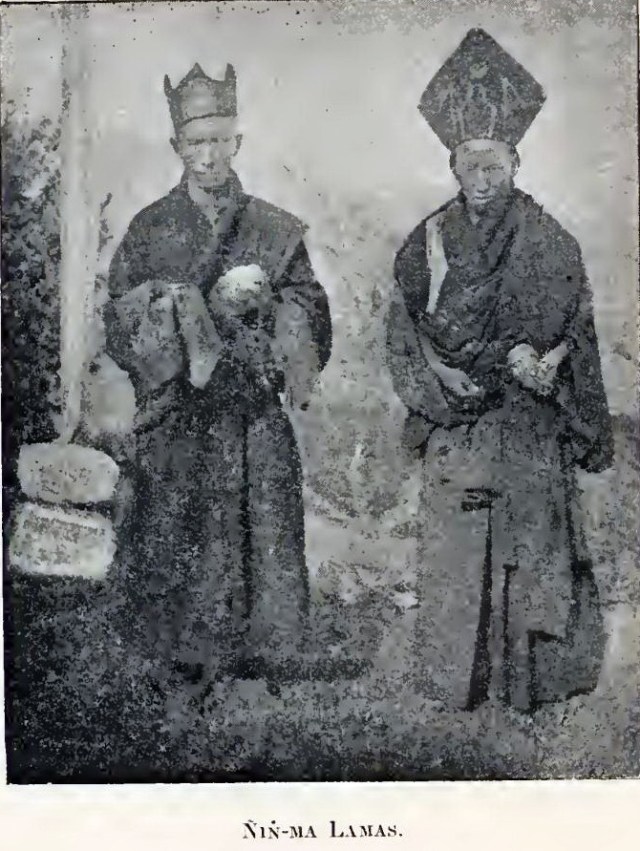
Ñiṅ-ma Lāmas.
is the real ” red-hat ” sect of Lāmas, and not the Dug-pa as is stated in European books. It regards the metaphysical Buddha Samanta-bhadra as its primordial deity or Ādi-Buddha. Its mystic insight is Maha-utpanna (Dsog-ch’en) or “the great ultimate perfection.” Its tutelages are ” The fearful Vajra” (Vajra-“phurba”) and Dub-pa- kah-gye. 1 Its guardian demon is ” The Lord Gur ” 2 It worships the Gruru Padma-sambhava
1 sGrub-pa bkah-brgyad— the tutelary of the Guru St. Padma. 2 Gur-gon, a two-handed demon, the highest of the live ” Pal-gon.”
, the founder of Lāmaism, in a variety of forms, both divine and demoniacal, expressive of his different moods at different times, and also his favourite Kashmirī teacher, Ṣrī Siṅba, and the Indian teacher of the latter, Grah-rab Dorje, who derived his inspiration from the celestial Buddha, Vajra- satwa, who in turn was inspired by the primordial deity, Saman- ta-bhadra Buddha. Its peculiar red cap is named after the Guru ” Urgyen-pān- z’u,” and with these characteristics it exhibits a greater laxity in living than any other sect of Lāmas. But even the Ñiṅ-ma -pa, too, has its sub-sects, based on the adoption of different revelations. Its chief sub-sects are the Dorje- ṭak-pa, Mindol-liṅ, Kar-tok-pa, and Ṅa-dak-pa, named after their respective founders or parent monastery. But their differences are very trifling. The Dorje-ṭak-pa 1 is named after the greatest of the existent Ñiṅ-ma monasteries, to wit, Dorje-ṭak, near Sam-yas. It follows the revelation “found” by rGod-ldem in Zaṅ-Zaṅ Lha brag, and its chief branches seem to be at Hug-pa-gliṅ, Tsa-ṅgi Lhā- ri zim-p’ug, and T’eg-mc’og gliṅ. An offshoot of it is the Ṅah-dag-pa, 2 taking its name from its founder, Ṅah-dag, ” the owner of dominion,” and of royal lineage, and represented in several Sikkim monasteries. Scarcely inferior in extent and repute to the Dorje-ṭak is the Min-dol-liṅ-pa, 3 also named after its chief monastery, Min-dol-liṅ. Its revelation was found by bDag-ling-pa, and its chief branches are at sLe-luṅ, P’uṅ-po ri-wo-ch’e. And in Sikkim it is represented by the large Pemiongchi monastery, which until a few years ago was in the habit of sending to Min-dol-liṅ batches of its young monks for instruction in the higher discipline and ritual.
1 rdo-rje-brag-pa. – 2 mNah-bdag-pa. 3 sMin-grol Gliṅ. 4 bKah-rlog-pa,. Lho-brag-lha-luṅ-pa follow the revelation of Padma-liṅ-pa like the Dī -kung-pa sub-sect of the Kar-gyu-pa. The Lha-t sun-pa, named after the “founder of Sikkim Lāmaism, adopt the revelation of ‘Jah-ts’on-pa, found in Kong-bu, named the La-t’o-liṅ-pa.
The Z’i-jed-pa.
The Z’i-jed-pa (” the mild doer”), or passionless Ascetic, is a homeless mendicant of the Yogi class, and belonging to no sect in particular, though having most affinity with the Kar-gyu-pa. They are now almost extinct, and all are regarded as saints, who in their next birth must certainly attain Nirvāṇa. They carry thigh-bone trumpets, skull-drums, etc., and in the preparation of these instruments from human bones, they are required to eat a morsel of the bone or a shred of the corpse’s skin. The founder of the order was P’a-dam-pa Saṅs-rgyas ( ? Jñanaka- or Pita-Buddha), born at Jara Sin(d)ha, in India, his father being named brTson-‘grus-go- ch’a and his mother Rasha. He visited Tibet, via Kashmīr and Ṅa-ri, about the beginning of the twelfth century CE., his final visit being in 1112 CE. As this order is highly esteemed in Tibet, I subjoin some details of its chief saints. 1 Summary of Sects. It will thus be seen that Lāmaist sects seem to have arisen in Tibet, for the first time, in the latter part of the eleventh century C.E., in what may be called the Lāmaist Reformation, about three centuries after the foundation of Lāmaism itself.
1 In Tibet P’a-dam-pa taught his doctrines to Zhan-zkun-glin-Fawa and bon po k’ra-ch’un-bruk. Meeting rMan gra-Serpo, of Yar-kluns, he accompanied him to Tsang, where he gave instruction to Lāma sKyo-bsod-nam, who succeeded him. The second successor was the hermit rMa-sgom, born at Yar-stod-skyer-snar, in 1054 CE., and forming the rMa order. His pupil was So-ch’un-pa, a dwarf. The Yogini Ma-gci’g-lab-sgron, born at the southern Ph’a-druk, in 1054 a.d., was the devoted pupil of rMa. sKam, another great z’i-jed-pa, was a pupil of dge-s’es-gra-pa, and suffering injury from a sa-gdon demon, he burned its effigy. The demon afflicted him with dropsy and leprosy ; but by his zhi-cjed rites he recovered. He died 1119 CE. Z’aṅ -dgah-ldan, also a pupil of rMa, was born at Yar-stod-gtsan-z’al, in the tribe of mTshims zaṅ. His pupils were gÑal-ston-dyah ch’uṅ -‘bor, sKyog-sgom bsam-tan, K’u-sgom jo-dgah, rGya-dar-sen, aud Ch’us-pa-dar brtson. and witchcraft. Abandoning the grosser charlatanism, the new sects returned to celibacy and many of the purer Mahāyāna rules. In the four centuries succeeding the Reformation, various sub-sects formed, mostly as relapses towards the old familiar demonolatry. And since the fifteenth century CE., the several sects and subsects, while rigidly preserving their identity and exclusiveness, have drifted down towards a common level where the sectarian distinctions tend to become almost nominal. But neither in the essentials of Lāmaism itself, nor in its sectarian aspects do the truly Buddhist doctrines, as taught by Ṣākya Muni, play a leading part. 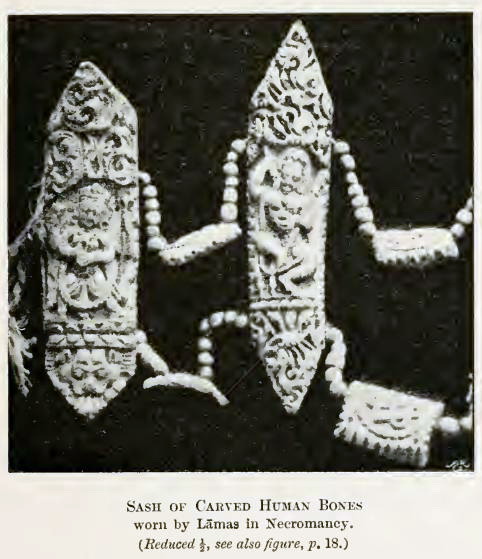 Sash of Carved Human Bones worn by Lāmas in Necromancy. {Reduced §, see also figure, p. 18.) THE METAPHYSICAL SOURCES OF THE DOCTRINE. AS Buddhism is a highly philosophical religion, and Lāmaism, though deeply tinged with non-Buddhist beliefs, still retains much of the loftier philosophy and doctrines of Primitive Buddhism and its earlier developments, we must, in considering the metaphysical basis of the Lāmaist doctrine, glance at the metaphysics of Buddha himself, as well as that of the Mahāyāna and the later “developments.” And as Buddha’s philosophy is based upon his working theory of the Universe, our subject will fall conveniently under the heads of (a) Buddha’s Theory of the Universe, 1 (b) his Metaphysics, and (c) the Metaphysics of the Lāmas. However inconsistent materialism and theistic theories may appear, with a system avowedly idealistic and practically atheistic, it certainly seems that Buddha, himself a Hindu and a teacher of Hindūs, did adopt the Hindū mythology and cosmic notions current in his day, with slight modifications, which were directed merely towards depriving the gods of their creative functions and rendering them finite and subject to death and the general law of metempsychosis. 2 His sutras, or sermons, contain numerous references to these divinities, and the earliest of all authentic Buddhist records extant, namely, the Asoka edict pillars of the third century B.C.,
Sash of Carved Human Bones worn by Lāmas in Necromancy. {Reduced §, see also figure, p. 18.) THE METAPHYSICAL SOURCES OF THE DOCTRINE. AS Buddhism is a highly philosophical religion, and Lāmaism, though deeply tinged with non-Buddhist beliefs, still retains much of the loftier philosophy and doctrines of Primitive Buddhism and its earlier developments, we must, in considering the metaphysical basis of the Lāmaist doctrine, glance at the metaphysics of Buddha himself, as well as that of the Mahāyāna and the later “developments.” And as Buddha’s philosophy is based upon his working theory of the Universe, our subject will fall conveniently under the heads of (a) Buddha’s Theory of the Universe, 1 (b) his Metaphysics, and (c) the Metaphysics of the Lāmas. However inconsistent materialism and theistic theories may appear, with a system avowedly idealistic and practically atheistic, it certainly seems that Buddha, himself a Hindu and a teacher of Hindūs, did adopt the Hindū mythology and cosmic notions current in his day, with slight modifications, which were directed merely towards depriving the gods of their creative functions and rendering them finite and subject to death and the general law of metempsychosis. 2 His sutras, or sermons, contain numerous references to these divinities, and the earliest of all authentic Buddhist records extant, namely, the Asoka edict pillars of the third century B.C.,
1 General mythology forms’a special chapter (xv), but it is necessary at this stage to sketch the mythology which bears directly upon the doctrinal developments. 2 Even in Brahmanic mythology the hosts of the gods, including Indra, the greatest god in Vedic times, are subject to the universal law of dissolution at the end of a Kalpa, or cycle of time, when the Triad god-head A.U.M. becomes simple soul (Kevalātman).
THE BUDDHIST UNIVERSE.
The gods and genii are represented with functions identical with those now allotted to them in the latter-day Buddhism of both Burma and Tibet, where, as in the orthodox scriptures of both schools, the gods receive more or less worship on account of the power which they are believed to possess of bestowing temporal blessings. And the coming Buddha is believed by all Buddhists to be even now resident in the Tushita heavens of the gods. So intimately have these mythological figures been woven into the texture of Buddism, and especially of Lāmaism, which peoples the world with gorgons and hydras and other dire chimeras, that without having gained a general idea of their nature and position, it is impossible to understand the allusions to them which constantly crop out in Buddhist rites and dogma. And, indeed, many of these fantastic beliefs with their deified heroes and Nature-worship are in reality petrified survivals of the archaic beliefs of our Indo-Germanic ancestors.
Buddhist Theory of the Universe.
In sketching the Buddhist world-system, with its ” antres vast and deserts idle,” existing mostly on the map of the imagination, it is deemed advisable, in order to avoid needless repetition, to give at once the Lāmaist version, even though this is slightly more ” developed ” than the cosmogony of Buddha’s day ; although it cannot be very different after all, for the Lāmaist accounts of it are in close keeping with the Barhut lithic remains, and almost identical with the versions found among the Ceylonese and other Buddhists of the south, and the Chinese and Japanese Buddhists. 1 This, our human, world is only one of a series (the others being fabulous) which together form a universe or chiliocosm, 2 of which there are many.
1 Cf. also GIORGI, whose figure is attached ; and summary by BURNOUF, ii., 599. 2 Skt., Sarva-loka-dhātu.
Olympus— Mt. Meru 1 (Su-meru, Tib., Ri-rab) 84,000 miles 2 high, surmounted by the heavens, and overlying the hills. In the ocean around this central mountain, the axis of the universe, are set (see figures) the four great continental worlds with their satellites, all with bases of solid gold in the form of a tortoise — as this is a familiar instance to the Hindū mind of a solid floating on the waters. And the continents are separated from Mt. Meru by seven concentric rings of golden mountains, the inmost being 40,000 miles high, 3 and named ” The Yoke ” (Yugandara), 1 alternating with seven oceans, of fragrant milk, 5 curds, butter, blood or sugar-cane juice, poison or wine, fresh water and salt water. These oceans diminish in width and depth from within outwards from 20,000 to 625 miles, and in the outer ocean lie the so-called continental worlds. And the whole system is girdled externally by a double iron-wall (Cakravāla) 312.5 miles high and 3,602,625 miles in circumference, — for the oriental mythologist is nothing if not precise. This wall shuts out the light of the sun and moon, whose orbit is the summit of the inmost ring of mountains, along which the sun, composed of “glazed fire” enshrined in a crystal palace, is driven in a chariot with ten (seven) horses ; and the moon, of ” glazed water,” in a silver shrine drawn by seven horses, and between these two hang the jewelled umbrella of royalty and the banner of victory, as shown in the figure. And inhabiting the air, on a level with these, are the eight angelic or fairy mothers.
1 Its prototype, as with the Greek Olympus, is terrestrial, namely, Mt. Kailās, 22,000ft., directly north of Lake Manaśarovara in the Himalayas (cf. MARKHAM. xxiv.).
2 The 84,000 is a mathematical figure expressing multitude. The Tibetan measure is a ” dpag-tshad,” which, according to CSOMA (Dict.), equals 4,000 fathoms, and hence a geographical mile, but it is used as the equivalent of the Indian unit of measure which is translated in the Ceylonese scriptures as a Yojana, i.e., a unit of about 4 kos, about five or six geographical miles.
3 These mountains are severally named the Ox Yoke-holder, Plough-holder, Sandal-holder, Pleasing Mount, Horse-ear Hill, Demon or Assembly Mount, and Circle or Edge-holder.
4 The names of the others are Isadara, Karavīka. Sudarsana, Asvakarna, Vināyaka and Nemiñdhara.
5 This ocean of milk was churned by the Brahmanical gods for the recovery of their elixir vitae and the thirteen precious objects. And the churning produced the beautiful goddess Lakshmi.— Compare with Aphrodite from the froth of the ocean, and the proverbial beauty of the Naga water nymphs— the Hindu mermaids.
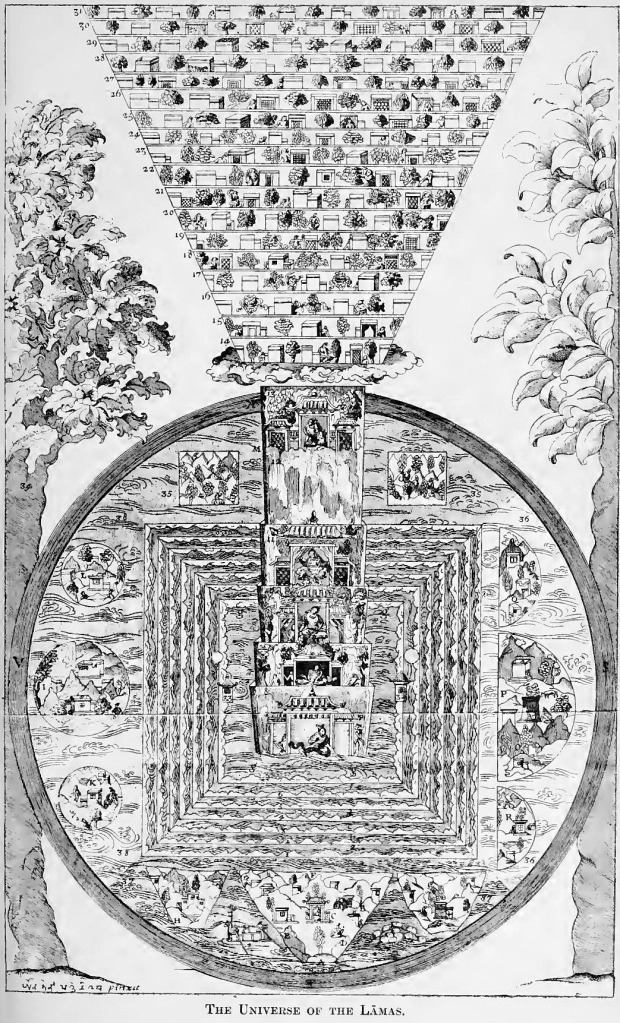 Of the four “continents” all except ” Jambudvīpa “1 are fabulous. They are placed exactly one in each of the four
Of the four “continents” all except ” Jambudvīpa “1 are fabulous. They are placed exactly one in each of the four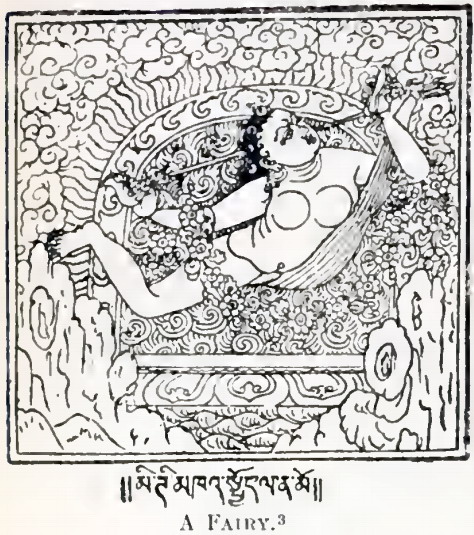 directions, and each has a smaller satellite on either side, thus bringing the total up to twelve. And the shapes given to these continents, namely, crescentic, triangular, round, and square, are evidently symbolic of the four elements. These continents, shown in the annexed figure, are thus described: — On the East is Videha 2 or ” vast body ” (P). This is shaped like the crescent moon, and is white in colour. It is 9,000 miles in diameter, and the inhabitants are described as tranquil and mild, and of excellent conduct, and with faces of same shape as this continent, i.e., crescentic like the moon. On the South is Jambudvīpa 4 ( F), or our own world, and its centre is the Bodhi-tree at Budh Gaya. It is shaped like the shoulder-blade of a sheep, this idea being evidently suggested by the shape of the Indian peninsula which was the prototype of Jambudvīpa, as Mt. Kailās in the Himalayas and N.E. of India was that of Mt. Meru. It is blue in colour; and it is the smallest of all. being only 7000 miles in diameter. Here abound riches and sin as well as virtue. The inhabitants have faces of similar shape to that of their continent, ie. somewhat triangular. On the West is Godhanyā 5 or ” wealth of oxen ” (I), which in shape is like the sun and red in colour. It is 8,000 miles in diameter. Its inhabitants are extremely powerful, and (as the name literally means. cow + ox + action) they are believed to be specially addicted to eating cattle, and their faces are round like the sun. On the North is Uttara-Kuru or “northern Kuru ” tribe (M), of square shape and green in colour, and the largest of all the continents,
directions, and each has a smaller satellite on either side, thus bringing the total up to twelve. And the shapes given to these continents, namely, crescentic, triangular, round, and square, are evidently symbolic of the four elements. These continents, shown in the annexed figure, are thus described: — On the East is Videha 2 or ” vast body ” (P). This is shaped like the crescent moon, and is white in colour. It is 9,000 miles in diameter, and the inhabitants are described as tranquil and mild, and of excellent conduct, and with faces of same shape as this continent, i.e., crescentic like the moon. On the South is Jambudvīpa 4 ( F), or our own world, and its centre is the Bodhi-tree at Budh Gaya. It is shaped like the shoulder-blade of a sheep, this idea being evidently suggested by the shape of the Indian peninsula which was the prototype of Jambudvīpa, as Mt. Kailās in the Himalayas and N.E. of India was that of Mt. Meru. It is blue in colour; and it is the smallest of all. being only 7000 miles in diameter. Here abound riches and sin as well as virtue. The inhabitants have faces of similar shape to that of their continent, ie. somewhat triangular. On the West is Godhanyā 5 or ” wealth of oxen ” (I), which in shape is like the sun and red in colour. It is 8,000 miles in diameter. Its inhabitants are extremely powerful, and (as the name literally means. cow + ox + action) they are believed to be specially addicted to eating cattle, and their faces are round like the sun. On the North is Uttara-Kuru or “northern Kuru ” tribe (M), of square shape and green in colour, and the largest of all the continents,
1 T., Jambu-li ṅ. 2 Lus-pags 3 After Pander. 4 Some Lāmas state that this name is derived from the Jambu tree (Eugenia Jambotans), while others believe that the name is onomatopoetic for the sound “Jamb,” emitted when the world thrown by the gods into the outer ocean. 5 ba-glaṅ spyod. 6 sgra-mi-sñan,
being 10,000 miles in diameter. Its inhabitants are extremely fierce and noisy. They have square faces like horses; and live on trees, which supply all their wants. They become tree-spirits on their death; and these trees afterwards emit “bad sounds ” (this is evidently, like many of the other legends, due to a puerile and false interpretation of the etymology of the word). The satellite continents resemble their parent one in shape, and each is half its size. The left satellite of Jambudvīpa, namely, “The ox- tail-whisk continent,” is the fabulous country of the Rakshas, to which Padma-Sambhava is believed to have gone and to be still reigning there. And each of the latter presents towards Mount Meru one of the following divine objects respectively, 1 viz., on the east (? south) the mountain of jewels, named Amo-likha, shaped like an elephant’s head, 2 and on the south, the wish-granting tree, 3 on the west the wish-granting cow, 4 and on the north the self-sprung crops. 5 In the very centre of this cosmic system stands ”The king of mountains,” Mount Meru, towering erect ” like the handle of a mill-stone,” while half-way up its side is the great wishing tree,” 6 the prototype of our ” Christmas tree,” and the object of contention between ihe gods and the Titans. Meru has square sides of gold and jewels. Its eastern face is crystal (or silver), the south is sapphire or lapis lazuli ( vaidūrya ) stone, the west is ruby (padmaraga), and the north is gold, and it is clothed with fragrant flowers and shrubs. It has four lower compartments before the heavens are reached. The lowest of these is inhabited by the Yaksha genii — holding wooden plates. Above this is “the region of the wreath-holders” (Skt., Srag-dharā), which seems to be a title of the bird-like, or angelic winged Garuḍas. Above this dwell the “eternally exalted ones,*’ 7 above whom are the Titans.
THE GODLINGS AND TITANS.
The Titans. The Titans [Asuras 8) or “ungodly spirits”. These are pictured in the “Wheel of Life ” (at page 108), in the upper right section. Their leading trait is pride, and this is the world of rebirth
1 These, according to other accounts, are situate on the flanks of Meru itself. 2 The Yama rocks are on the south. 3 Tib.,Yond-‘dus-sa-gtol. 4 ‘dod-‘zo-i-ba. 5 ma-smos-pi lo-t’og. 6 The Ri-wo ña-s’iṅ. 7 rtag myos, here the rta may represent “horse”— the horse-headed musicians. 8 T., Lha-ma-yin.
for those who, during their human career, have boasted of being more pious than their neighbours. The Titans were originally gods ; but, through their pride, they were, like Satan, expelled from heaven; hence their name, which means ” not a god.”1 And their position at the base of the Mount Meru is intermediate between heaven and earth. The duration of their life is infinitely greater than the human, and they have great luxury and enjoyment; but in pride they envy the greater bliss of the gods, and die prematurely, fighting vainly against the gods for the fruits of the heavenly tree and the divine nectar. Their region is represented in the picture, of an almost colourless atmosphere. They live in fortified houses. The ground, both inside and outside the fort, is carpeted with flowers of which the inhabitants, male and female, make the wreaths and garlands which they wear. They are dressed in silk ; and when the heroes are not engaged in fighting they spend their time in all sorts of gaiety with their wives. In the right-hand corner is shown their birth from a lotus-flower and their obtaining a wish-granting tree and cow. The rest of the picture is devoted to their misery, which consists in their hopeless struggle and fatal conflict with the gods. The commander of the forces is seen in conclave with his leaders, 2 horses are being saddled and the ” heroes ” are arming themselves with coats of mail and weapons. Another scene shows the battle raging along the border separating their county from heaven, and the general mounted with his staff as spectators in the background. The warriors of the first line are all hurled at them by the gods. One of the weapons possessed alike by gods and Titans is a spiked disc.
1 Analogous to this is the common colloquial term mi-ma-yin or “not a man applied to those who lead vicious and dissolute lives. 2 Note that greatness of rank is shown in pictures by enlarged bodily dimensions.
Above the region of the Titans, at a distance of 168,000 miles, are the bright realms of the gods. In the lowest compartment of the heavens are the four ” great guardian kings of the quarters” (Tib.,rgyal-c’en de-z’i ; Skt., Cātur-Mahārāja), namely:— 1. Dhṛitarāshṭra (Yul-k’or-sruṅ 1), the white guardian of the east, and king of the Gandharvas 2 (see figure below). 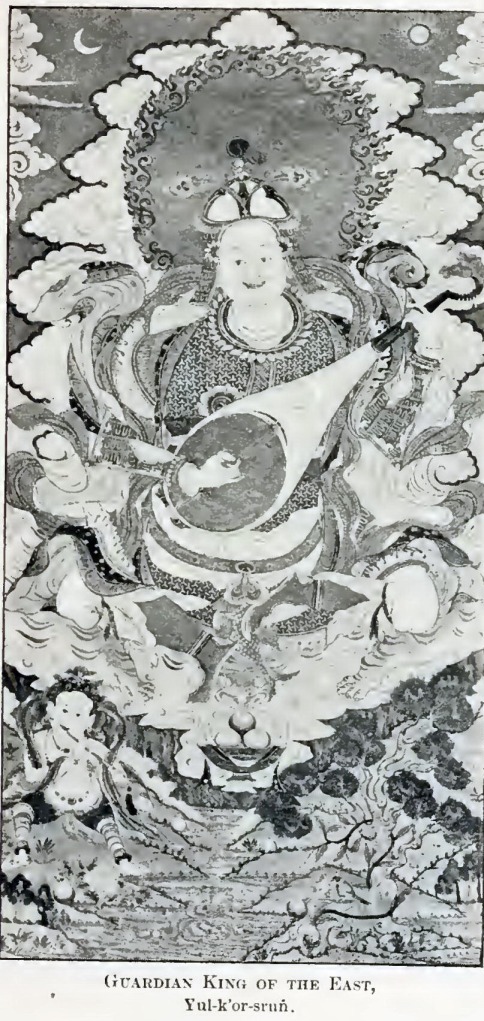 2. Virūḍhaka (P’ag-kye-po 3 ), the green 4 guardian of the south, and king of the K’umbhandas 5 (see figure page 330). 3. Virūpāksha (Ja-mi-zaṅ 6 ), the red guardian of the west and king of the Nāgās 7 (see figure page 289). 4. Vaiṣravana (Nam-t’o-sra 8 ), the yellow guardian of the north and king of the Yakshas. 9 He is an especial favourite, as he is also, in another aspect, the god of Riches (see figure on page 370). Indeed, it would seem that all of the gods, even Indra (Jupiter) himself, were originally considered to be Yaksha genii. The subjects of these kings are members of the eight great classes of supernatural beings. 10 These great celestial kings guard the heavens from the attacks of the outer demons; and have to be distinguished from a more extended category of guardian gods, the ten Lokpals who guard the world from its ten directions ; namely, Indra on the east, Agni (the fire-god) on the south-east, Yama (the death-god) on the south, Rakshas (? Sura) on the south-west, Varuṇa (the water-god) on the west, Vāyu (the wind-god) on the north-west, Yakshas on the north, Soma (the moon) on the north-east, Brāhma, above; Bhūpati, below. The Buddhists divide every universe into three regions, in imitation, apparently, of the Brāhmanic Bhavanatraya, substituting for the physical categories (Bhū earth, Bhuva heaven, and Svar space) of the Brahmans, the ethical categories of Desire (Kāma), Form (Rūpa ) and Formlessness (Arūpa), which collectively are known as ” The Three Regions ” (Trailokya 11 ), and mostly placed in heaven. They are : —
2. Virūḍhaka (P’ag-kye-po 3 ), the green 4 guardian of the south, and king of the K’umbhandas 5 (see figure page 330). 3. Virūpāksha (Ja-mi-zaṅ 6 ), the red guardian of the west and king of the Nāgās 7 (see figure page 289). 4. Vaiṣravana (Nam-t’o-sra 8 ), the yellow guardian of the north and king of the Yakshas. 9 He is an especial favourite, as he is also, in another aspect, the god of Riches (see figure on page 370). Indeed, it would seem that all of the gods, even Indra (Jupiter) himself, were originally considered to be Yaksha genii. The subjects of these kings are members of the eight great classes of supernatural beings. 10 These great celestial kings guard the heavens from the attacks of the outer demons; and have to be distinguished from a more extended category of guardian gods, the ten Lokpals who guard the world from its ten directions ; namely, Indra on the east, Agni (the fire-god) on the south-east, Yama (the death-god) on the south, Rakshas (? Sura) on the south-west, Varuṇa (the water-god) on the west, Vāyu (the wind-god) on the north-west, Yakshas on the north, Soma (the moon) on the north-east, Brāhma, above; Bhūpati, below. The Buddhists divide every universe into three regions, in imitation, apparently, of the Brāhmanic Bhavanatraya, substituting for the physical categories (Bhū earth, Bhuva heaven, and Svar space) of the Brahmans, the ethical categories of Desire (Kāma), Form (Rūpa ) and Formlessness (Arūpa), which collectively are known as ” The Three Regions ” (Trailokya 11 ), and mostly placed in heaven. They are : —
1 yul-‘k’or bsruṅ. 2 Dri-za ” the Small-eaters”. 3 ‘p’ags skyes-pa. 4 Sometimes the colours of the North and South Guardians are transposed. 5 Grul-bum. 6 spyan mig-bzaṅ 7 kLu. 8 rnamt ‘os sras. 9 gNod-sbyin or ” the injurers.” 10 See chapter on Mythology. 11 ” K’ams gsum.”
II. The region of Form, Rūpadhātu (Tib., grZugs kyi k’ams) is in the purer heavens of Brāhma where form is free from sensuality. It comprises the sixteen Brāhmalokas ; which are divided into four regions of contemplation (dhyāna). III. The region of Formlessness, Arūpadhātu (Tib., gZugs med-pahi k’ams) comprises the four highest of the Brāhma heavens and near to Nirvāṇa. The heavens are thus diagrammatically shown in the form of the funeral monument or cetiya; though in other pictures, as in the foregoing chart of the universe, they form an inverted pyramid, increasing in size from below upwards. The celestial Buddhas therein shown are, it is needless to say, additions of later days. 1
Diagram of The Heavens of the Buddhists.
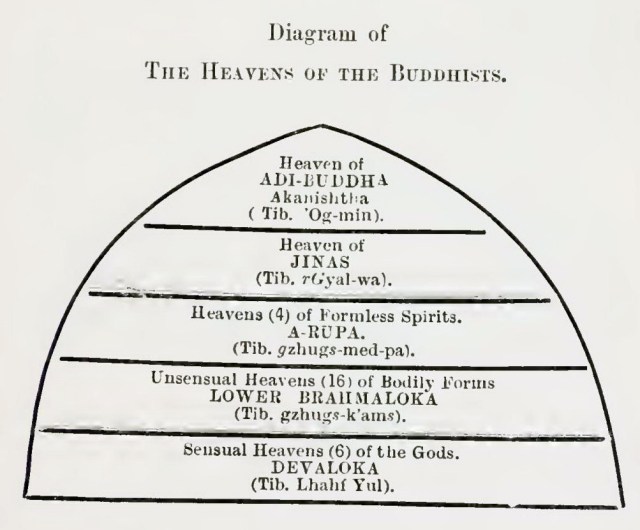 The Six Devalokas are in series from below upwards : — 1. Cātur-mahārājakāyikas. — The abode of the four guardian kings of the quarters, already mentioned.
The Six Devalokas are in series from below upwards : — 1. Cātur-mahārājakāyikas. — The abode of the four guardian kings of the quarters, already mentioned.
3. Yama, the Hindū Pluto, the king and judge of the dead. 4. Tushita. (Tib., dGah ldan) or “Joyful place” — the paradise of the Bodhisats prior to their final descent to the human world as Buddhas. Maitreya, the coming Buddha, dwells at present in this heaven. 5. Nirmānarati (Tib., ‘p’rul dgah). 6. Paranirmita Vasavartin (Tib., grz’an ‘p’rul dbaṅ byed) — the highest of the heavens of the gods and the abode of Māra. The Brāhmaloka worlds are subject to the God Brāhma, and existence ranges from intellectual tranquillity to unconsciousness. These worlds of meditation (dhyana) are accounted eighteen in number, and arranged in five groups (3, 3, 3, 2, and 5) corresponding to the five-fold division of Brāhma’s world, and are usually named from below upwards as follows : (1) Brāhma parsādyā, (2) Brāhma purohitā, (3) Mahā Brāhmana, (4) Paritābhā, (5) Apramāna, (6) Abhāsvara, (7) Paritasubhā, (8) Apramānasubha, (9) Subhakrishnā, (10) Utpala, (11) Asañasatya, (12) Avriha or Vrihatpalā, (13) Atapa, (14) Sudasa, (15) Sudasi, (16) Puṇyaprasava, (17) Anabhraka, (18) Akanishtba (Tib., Og-min) or ” The Highest ” — the abode of the Primordial Buddha-God, the Ādi-Buddha of the Lāmas, viz., Samantabhadra (T., Kuntu-zaṅpo). This last, together with the next subjacent Brahmaloka, are according to the Lāmaists eternal, and are placed above the Arūpa Brāhmalokas. The Four Arūpa Brāhmalokas are 1. Akāsānantāyatana, 2. Vijñānāntayatana,3. Akincañāyatana, 4. Naivāsañjñana Sañjñayatana. The duration of existence in each of those states is for vastly increasing periods from below upwards, till beyond the sixteenth immortality itself is reached; and according to some of the later Buddhists, each Bodhisat must traverse each of these stages (Bhum) before he attains Buddhahood. The typical heaven of the gods — Indra’s paradise — is pictured in the Wheel of Life at page 108. Its atmosphere is yellow, and in it are portrayed the four states of godly birth, bliss, passion and misery and death. Godly Birth. The god is born at once fully developed within a halo of glory from a lotus-flower, — the oriental symbol of immaterial birth and is provided with the special attributes of a god,— viz., (1) a lotus-footstool, (2) splendid dress and ornaments, (3) goddess-companions,1 (4) a wish-granting tree, or pag-sam-shin (Skt., Kalpadaru ) 2 which instantly yields any fruit or food wished for, and bends to the hand of the gatherer, its leaves yielding luscious food, its juice nectar, and its
1 Apsaras, celestial nymphs — the “houris” awarded to heroes. 2 The wish-granting tree of Indra’s heaven is described in the 45th Section of the S’ilpa S’astra.
THE HEAVENS OF INDRA (JUPITER). fruit jewels, (5) a wish-granting cow (Kāma-dhenu or Surabha 1 ) which yields any drink wished for, (6) self-sprung crops (usually painted as Indian corn or maize), (7) in a golden stall a jewelled horse-of-fore-knowledge which Pegasus-like carries his rider wherever wished, through-out the worlds of the past, present, and future, (8) a lake of perfumed nectar or ambrosia (Skt., Amrita ) which is the elixir vitae and the source of the divine lustre. 2 Shining is a peculiarly divine attribute, and the etymology of the word “divinity,” is the root Div, “to shine,” the parent of the Skt. Deva and Latin Deus. Heavenly Birth. 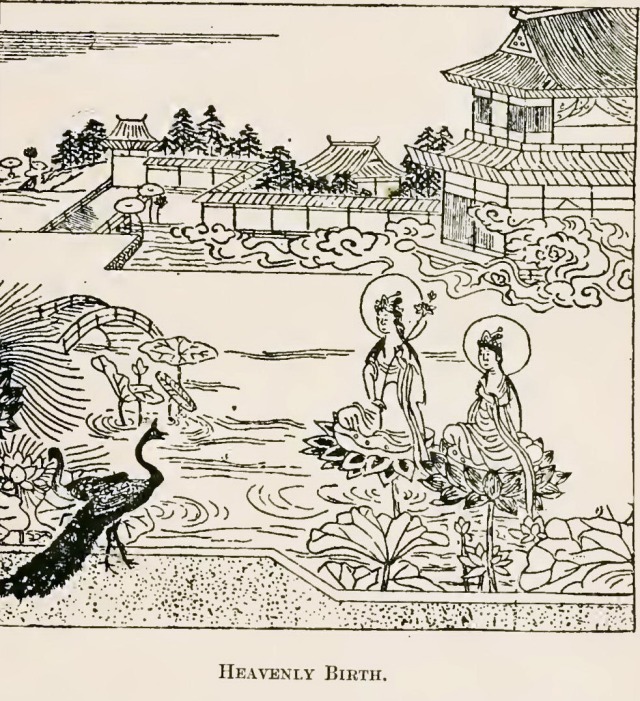
1 Images of these are sold in the Indian bazaars as toys for children. Compare this myth of the wishing-cow with the parallels related by Professor Weber in Sitzungsberichte der Kaenig Preuss., Acad, zu Berlin., xxvii., 1890. 2 The cup-bearer is Dhanwantari, the Indian Ganymede.
Deva-nagari or sacred language of India. One of the blissful conditions of godly life especially dwelt upon, is that the most dainty morsels may be eaten without sense of repletion, the last morsel being as much relished as the first. In the centre of this paradise is the great city of Belle-vue (Sudarṣana), within which is the celestial palace of Vaijayanta (Amarāvati) the residence of Indra (Jupiter), the king of the gods. It is invested by a wall and pierced by four gates, which are guarded by the four divine kings of the quarters. It is a three-storied building ; Indra occupying the basement, Brāhma the middle, and the indigenous Tibetan war-god — the dGra-lha — as a gross form of Māra, the god of Desire, the uppermost story. This curious perversion of the old Buddhist order of the heavens is typical of the more sordid devil-worship of the Lāmas who, as victory was the chief object of the Tibetans, elevated the war-god to the highest rank in their pantheon, as did the Vikings with Odin where Thor, the thunder-god, had reigned supreme. The passionate war-god of the Tibetans is held to be superior even to the divinely meditative state of the Brāhma. War with the Titans. The gods wage war with the Titans, who, as we have seen, are constantly trying to seize some of the precious fruit of the great Yoṅ-du sa-tol (Skt.,Pārijāta 1 ) tree, or ” tree of the concentrated essence of earth’s products,” whose branches are in heaven, but whose roots are in their country. The climber which encircles this tree is called the Jambuti tree, and is the medium by which the quintessence of the most rare delicacies of Jambudvīp are instilled into the Larger tree. And the war-god directs the divine army. To account for the high position thus given to the war-god, it is related that he owes it to the signal assistance rendered by him to the gods in opposing the Asuras.2 The misery of the gods.
1 Identified with the beautiful Indian Coral Tree ( Erythrina Indica) . 2 It is related that in former times the gods were defeated by the Asuras in fighting for the fruits of the great wishing-tree of Paradise; and the defeated gods under Indra besought gSaṅ-bahi-bdag-po for council. This divinity advised the gods to call to their aid the war-god dGra-lha, and also to obtain from .the depths of the central ocean the invisible armour and the nine self-created weapons, viz. : — (1) rMog~bya khyung-keng-riis, a helmet of the skeleton bones of the Garuḍa bird; (2) Kkrab-ñi-shar-lto-rgyab, the coal of mail shining like the sun; (3) Lba-khebs-rdorje-
nectar dries up ; his wish-granting tree, cow and horse die ; his splendid dress and ornaments grow dim and disappear ; his palace gets dilapidated; his flowers and garden fade; his body, no longer bathed by nectar, loses its lustre and sweats like mortals, so that his person becomes loathsome to his goddess-companions and the other gods, who shun him, and so the poor god dies miserably. 1 If he has led a virtuous life during his existence as a god then he may be re-born in heaven, otherwise he goes to a lower region and may even be sent to hell. Buddha was born twenty times as the god Sakra or Indra (Jupiter) and four times as Brahma.2
The Buddhist Hell.
The antithesis to heaven is hell, which with its awful lessons looms large on the horizon of the Buddhists. For according to their ethical doctrine of retribution, and in the case of the more theistic developments, their conception of God as the supreme type of right-doing, they picture him like a human judge trying and punishing the evil-doers; 3 although, with truly Buddhist idealism, these tortures are believed by the more philosophical Lāmas to be morbid creations of the individual’s own ideas, a sort of hellish nightmare. The majority of the Lāmas, however, and (go-c’a, necklet; (4) Lak-hag-me’son-c’a-lam-lok, a weapon resisting and returning glove; (5) sÑin-khebs-mdah-mts ‘on-kun thub, a breast-plate entirely able to withstand arrows and other weapons; (6) Pus-khebs-ñes-pa-skyobs-c’ed, a knee-cap which defends against destruction; (7) Phubm-sba-dmar-gling-drug, a six-embossed shield The nine sorts of weapons are:— (1) a ‘K’orlo or spiked-disc which completely routes the enemy; (2) a dGra-sta or an axe which chops the enemy; (3) a ral-gri or sword which slices the enemy; (4) a Zhu or bow which scatters’ the brains of the enemy; (5) a “mDah” or arrow that pierces the vitals; (6) a Zhagspa or noose which ensnares the enemy; (7) a mDung or spear which pierces the hearts of the foe ; ( 8 ) a Ur-rdo, a whirring sling-stone that produces the ” ur-r-r ” sound of a thunder-dragon; and (9) a Dorje or thunder-bolt which demolishes the enemy. The story seems founded on the Brahmanical legend of Indra (Jupiter) obtaining from the sea the talismanic banner which conferred victory over his enemies ; cf. Brihat Saṅhita, translated by Dr. KERN, J.R.A.S., vi., p. 44. The gods having obtained these weapons and armour, invited the war-god, who came enveloped in thunder-clouds and attended by his nine sons, and receiving worship from Indra and the other gods as the price of his assistance, they assailed and utterly routed the Titans.
1 Compare HARDY, Man, 143. 2 R.D. Buddhist Birth Stories Ci. 3 Cf. MAINE’s works on Early Law.
the laity, believe in the real material character of these hells and their torture. The Buddhist hell (Naraka 1 ) is a true inferno situated in the bowels of the human earth like Hades, and presided over by the Indian Pluto, Yama, the king and judge of the dead, who however is himself finite and periodically tortured. Every day he is forced to swallow molten metal. So, as the shade of Achilles says, ” it is better to live on earth as the poorest peasant than to rule as a prince of the dead.” 2 The Great Judgment is determined solely by the person’s own deeds, and it is concretely pictured by the ordeal of scales, where the good deeds, as white pebbles, are weighed against the sins, as black counters, in balances, and the judge holds a mirror which reveals the soul in all its nakedness. ” Not in the heavens, not in the midst of the sea, not if thou hidest thyself in the clefts of the mountains wilt thou find a place where thou canst escape the force resulting from thy evil actions.” 3 ” Through the six states of transmigration does the power of our actions lead us. A life in heaven awaits the good. The warders of hell drag the wicked before the king of hell, Yama, who says to them : — ” Did you not when on earth see the five divine messengers sent to warn you — the child, the old man, the sick, the criminal suffering punishment, and the dead corpse ? ‘ And the wicked man answers — ‘ I did see them.’ ” ‘ And didst thou not think within thyself : ” I also am subject to birth, old age, and death. Let me be careful to do good works ” ? ‘ And the wicked man answers : ‘ 1 did not, sire ; I neglected in my folly to think of these things.’ ” Then the king, Yama, pronounces his doom : ‘ These thy evil deeds are not the work of thy mother, father, relatives, friends, advisers. Thou alone hast done them all ; thou alone must gather the fruit.’ And the warders of hell drag him to the place of torment, rivet him to red hot iron, plunge him in glowing seas of blood, torture him on burning coals, and he dies not till the last residue of his guilt has been expiated.”‘ 4 Nor is hell a complete expiation of offences, for Buddha is credited with saving, “A harsh word uttered in past time is not lost, but returns again,” and the Jataka tales are full of incidents in illustration.
1 dmyal-k’ams, or “the region of torment.” Compare with Chinese version in BEAL ‘s Catena, p. 56, seq. 2 Odyssey, xi. 81. 3 Dhammapada, 127. 4 Deva-dutta-suta, transl, by H.OLDENBERG
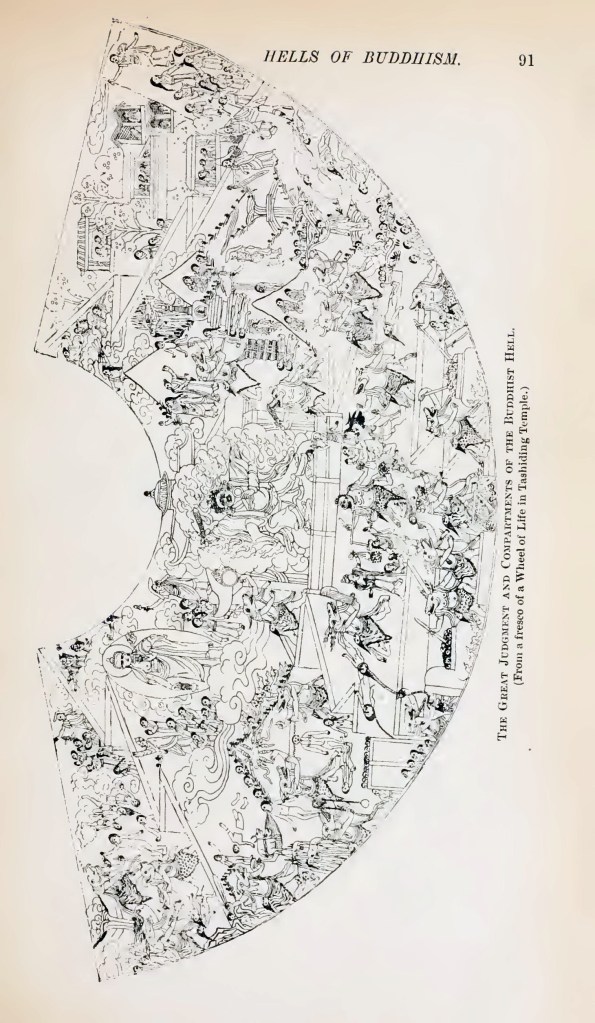 Hell is divided into numerous compartments, each with a special sort of torture devised to suit the sins to be expiated. Only eight hells are mentioned in the older Buddhist books, but the Lāmas and other “northern ” Buddhists describe and figure eight hot and eight cold hells and also an outer hell (Pratyeka naraka), through which all those escaping from hell must pass without a guide. The Brāhmanical hells are multiples of seven instead of eight ; some of them bear the same names as the Buddhists, but they are not systematically arranged, and as the extant lists date no earlier than Manu, about 400 CE.,they are probably in great part borrowed from the Buddhists.1
Hell is divided into numerous compartments, each with a special sort of torture devised to suit the sins to be expiated. Only eight hells are mentioned in the older Buddhist books, but the Lāmas and other “northern ” Buddhists describe and figure eight hot and eight cold hells and also an outer hell (Pratyeka naraka), through which all those escaping from hell must pass without a guide. The Brāhmanical hells are multiples of seven instead of eight ; some of them bear the same names as the Buddhists, but they are not systematically arranged, and as the extant lists date no earlier than Manu, about 400 CE.,they are probably in great part borrowed from the Buddhists.1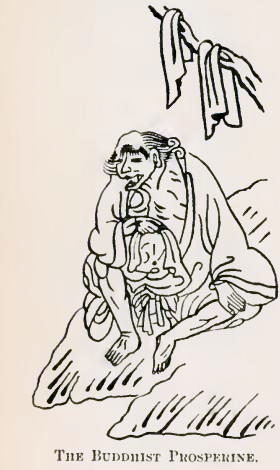 The foregoing figure 2 shows the Lāmaist hells, but they are seen in greater detail in ” The Wheel of Life,” at page 109. At the entrance to the great hell on the bank of the Hindū Styx — the Baitarāni 3 or “three path” river —sits, according to one version, an old hag, a sort of Prosperine, who strips off the clothes from the new arrivals, and hangs them on a tree behind her. 4 She is 160 feet in stature, with eyes like burning wheels, and she despatches the condemned souls along their respective roads in accordance with the judgment, but sometimes she delays them with endless tasks of heaping up stones on the banks of the Styx, and so prolongs their agony, The hot hells stand in tiers, one upon another, beginning at a depth of 11,900 miles below the surface of the earth, and reach to a depth of 40,000 miles; each hell has four gates, outside each of which are four ante-hells, thus making altogether 136 hot hells.
The foregoing figure 2 shows the Lāmaist hells, but they are seen in greater detail in ” The Wheel of Life,” at page 109. At the entrance to the great hell on the bank of the Hindū Styx — the Baitarāni 3 or “three path” river —sits, according to one version, an old hag, a sort of Prosperine, who strips off the clothes from the new arrivals, and hangs them on a tree behind her. 4 She is 160 feet in stature, with eyes like burning wheels, and she despatches the condemned souls along their respective roads in accordance with the judgment, but sometimes she delays them with endless tasks of heaping up stones on the banks of the Styx, and so prolongs their agony, The hot hells stand in tiers, one upon another, beginning at a depth of 11,900 miles below the surface of the earth, and reach to a depth of 40,000 miles; each hell has four gates, outside each of which are four ante-hells, thus making altogether 136 hot hells.
1 See an article by M. Leon Feer, “L’Enfer indien,” in the Journal Asiatique, XX.( 1892), and i. ( New Series 1983), for lists and description ol the Brāhmanist hells. 2 For the tracing of which I am indebted to Mr. J. C. White. 3 =”The sedent queen.” 4 Her picture is given from the Japanese.
The atmosphere of the hells is of the deepest black :
” Light was absent all. Bellowing there groan ‘d
A noise, as of a sea in tempest torn
By warring winds, the stormy blast of hell.”
Dante, Canto v., 29.
Each hell is enveloped by a wall of fire, and the horrible torments are fit to illustrate Dante’s Inferno. Indeed, it has been suggested that Dante must have seen a 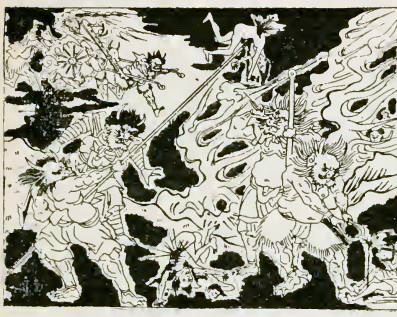 Buddhist picture of these hells before writing his famous classic, so remarkable is the agreement between them. The lictors (s’in-je) are savage flame-enveloped monsters with heads of various animals, and all their pincers, and other instruments of torture, are red-hot.
Buddhist picture of these hells before writing his famous classic, so remarkable is the agreement between them. The lictors (s’in-je) are savage flame-enveloped monsters with heads of various animals, and all their pincers, and other instruments of torture, are red-hot.
Hot Hell No. 1
The following are the eight great hot hells.
1. Sañjīva 1 = “again revived.” Here the wretches are cut and torn to pieces and then re-united and revived only to suffer the same process repeated ad infinitum throughout the period spent in this hell.
“ Because our wounds heal ever and anon
Ere we appear before the fiend again.”
DANTE, Canto xxviii., 36.
This restoration of the body, in order to subject it to fresh torture, is an essential part of the process in all the hells. The body when thoroughly mangled is restored and the racking torture applied afresh, so that the agony never ceases. This is the special hell for suicides,murderers, ignorant physicians who killed their patients, fraudulent trustees, and tyrants. 2. Kālasūtra 2 = ” black lines.” Here the victims are nailed down and eight or sixteen black lines drawn by the lictors along the body, which is then sawn asunder along these lines by a burning hot saw. Another
1 Yaṅ -sos. 2 tig-nag.
punishment here is the especial one of the slanderer, or busy-body, who has his or her tongue enlarged and pegged out and constantly harrowed by spikes ploughing through it. To this hell are assigned those who during life were disrespectful to their parents, or to Buddha, or the priests. 3. Saṃghāta, ‘ = ” concentrated oppression.” Here the guilty are
HOT HELL, NO. 3. squeezed and crushed between animal-headed mountains, or monster iron books. This last is an especial punishment for monks, laymen and infidels who have disregarded or profaned the scriptures, and also for priests who have taken money for masses which they have not performed. Others here are pounded in iron mortars and beaten on anvils. Here are tortured thieves, those who indulged in hatred, envy, passion, the users of light weights and measures, and those who cast refuse or dead animals on the public roads. 4. Raurava, 2 = ” weeping and screaming.” The torture here is to have molten iron poured down the throat. Those who were prisoners, obstructed watercourses, or grumbled against the weather (? clearly the English hell ! ), or wasted food, are here tortured.
1 bsdus ‘joms. 2 ṅu ‘bod
5. Mahāraurava, 1 = ” greater weeping and screaming.” Here they are cooked in seething cauldrons of molten iron. This is the hell for heretics. 6. Tāpana,2 = ” heat.” The condemned is enclosed in a red-hot fiery chamber. In this hell are punished those who roasted or baked animals for their food. 7. Pratāpana,3 = ” highest heat.” A three-spiked burning spear is thrust into the wretch’s body, which is then rolled up within red-hot iron plates. It is the special torture for apostates and those who reject the truth. 8. Avīchi ,4 = ” endless torture.” This is the most severe and longest of all the infernal torments. The guilty is perpetually kept in flames, though never consumed. This is the hell for those who have reviled Buddha, and others who have harmed or attempted to harm Lāmaism or shed the blood of a Lāma or holy-man. The Cold Hells, apparently an invention of the northern Buddhists, as cold was an idea rather foreign to the Indian mind, are situated on the edge of the universe below its encircling wall (Cakravala). They are encircled by icy mountains (see plate, page 109), and have attendants of appalling aspect, as in the hot hells. They are thus described : — 1. Arbuda,5 = “ blistered or chapped.” The torture here is constant immersion of the naked person in ice and glacier water, under which the body becomes covered with chilblains (which torture may be compared with the curse invented by a scribe in the reign of Athelstan for anyone who should break the terms of his charters : ” May he be tortured by the bitter blasts of glaciers and the Pennine army of evil spirits.” 6) 2. Nirarbuda. 7 The chilblains are rudely scarified, producing raw sores. 3. Atata, 8 Ach’u ” or ” A-ta-ta,” an exclamation of anguish beyond articulate expression — which resounds through this hell. 4. Hahava.9 A worse degree of cold in which the tongue is paralyzed and the exclamation Kyi-ii or Ha-ha alone possible. 5. Ahaha. 10 Here both jaws and teeth are spasmodically clenched through cold.
1 Ṅu-bod Ch’en-po. 2 Ts’a-ba. 3 Rab-tu t’sa-wa. 4 mnar-med. 5 Ch’u-bur ch’en. Arbu sounds suspiciously like Mount Abu (B) 6 Quoted by Mr. D. W. Freshfield in J. R. Geog. S., 1894. 7 Ch’u-bur-brol-wa. 8 A-ch’u. 9 Kyi-‘ud. 10 So-t’am-pa. 11 Ut-pal-ltar gas-pa.
7. Pad-ma.1 The raw sores become like red Lotus-flowers. 8. Puṇḍarīka. 2 Raw sores where the flesh falls away from the bones like the petals of the great Lotus ; and which are continually pecked and gnawed by birds and insects with iron beaks. The frontier or anterior hells at the exit from the great hell are called “The near (to re-birth) cycle,” 3 and are divided into four sections. 4 The first bordering hell consists of hot suffocating ashes with foul dead bodies and all kinds of offal. Then is reached a vast quagmire, beyond which is a forest of spears and spikes, which must be traversed like the razor-bridge in Muhammadanism and in Banyan’s Pilgrim’s Progress. Then succeeds a great river of freezing water; on the further shore of which the ground is thickly set with short squat tree-trunks, each surmounted by three spiked leaves which impale the unwary groping fugitives. Reference to these last two localities occurs in the ordinary litany for the dead, which says “may his c’hu-wo-rab-med ocean become a small rivulet, and the ts’al-ma-ri tree a divine wish-granting tree.” In addition to the hot and cold hells are eighty-four thousand external hells (Ñe-ts’e-wa, Skt. ? Lokāntarika) situated mostly on the earth, in mountains, deserts, hot springs, and lakes.
1 Padma-ltar-gas-pa. 2 Padma ch’en-po-ltar-gas pa. 3 ñe-‘k’or (=? Skt., Prateyka naraka) meaning near to re-birth. 4 Named Agni-khadā (me-ma-mur gyi ‘obs) or the fiery pit, Kunapanka (Ro-myags Kyi ‘dams) or quagmire of carcases, Khuradhārācana (spu-gri gtams ts’al) or forest of spikes, and Asidhāravana (ral-gri loma nays-ts’al) or forest of sword-leaves. 5 Thirty-six species arc described in five groups, namely : (1) p’yii sgrib-pa chan or “the foreign or gentile horrid beings,” (2) Nang-gi sgrib-pa chan, or the Buddhist horrid beings, (3) Zas-skom-gyi sgrib-pa chan or the eating and drinking horrid beings — these are they who on eating and drinking have the ingested material converted into lacerating weapons, (4) and (5) kha-thor or free Yi-dags. The latter are not confined in the Preta-prison, but are free to roam about in the human world— in graveyards, etc.,— and injure man. These are ( Beal ‘s Catena, 67)1, Flat-bodied; 2, Needle-mouthed; 3, Vomit-eaters ; 4, Filth-eaters; .5, Mist-eaters: 6. Water-feeders; 7. Scarcely seen: 8, Spittle-feeders; 9, Hair-eaters ; 10, Blood-suckers ; 11, Notion-feeders; 12, Flesh-eaters; 13, Incense-feeders ; 14, Fever-makers ; 15, Secret pryers; 16, Earth lurkers; 17 , Spirit-rappers ; 18, Flame-burners ; 19, Baby-snatchers ; 20, Sea-dwellers ;21 …..22 King Yama’s club-holders; 23, Starvelings ; 24, Baby-eaters ; 25, Vital-eaters; 26 Rakshas; 27, Smoke-eaters; 28, Marsh-dwellers; 29, Wind-eaters; 30, Ash-feeders; 31, Poison-eaters ; 32, Desert-livers; 33, Spark-feeders; 34, Tree-dwellers; 35, Road-dwellers; 36, Body-killers. ‘
THE MANES OR PRETA. Life, also in the annexed figure. This is the special torment for those who, in their earthly career, were miserly, covetous, uncharitable, or gluttonous. Jewels, food, and drink are found in plenty, but the Pretas have mouths no bigger than the eye of a needle, and gullets no thicker in diameter than a hair, through which they can never ingest a satisfying amount of food for their huge bodies. And when any food is taken it becomes burning hot, and changes in the stomach into sharp knives, saws, and other weapons, which lacerate their way out from the bowels to the surface, making large painful wounds. They are constantly crying “water, water, give water!” And the thirst is expressed in the picture by a name which is seen to issue from their parched mouths, and whenever they attempt to touch
Tantalized Spirits.
water it changes to liquid fire. Avalokita is frequently figured in the act of giving water to these Pretas to relieve their misery. 1 And a famous story of Buddha credits the great Māudgalyāyāna, the right-hand disciple of ” the Blessed One,” with having descended into the Preta-world to relieve his mother. As this story, the Avalambana Sutra, dating to before the third century CE., gives a very vivid picture of this tantalizing purgatory, and also illustrates the rites for extricating the starveling ghosts, 2 it is here appended. Māudgalyāyāna ‘s descent into the PRETA purgatory. Thus have I heard. Buddha at one time was residing in the country of Sravasti, in the garden of Jeta, the friend of the orphans. At this time Mugalan, having begun to acquire the six supernatural powers (irrdhi), desiring above all things, from a motive of piety, to deliver his father and mother, forthwith called into use his power of supernatural sight, and looking throughout the world he beheld his unhappy mother existing without food or drink in the world of Pretas (hungry ghosts), nothing but skin and bone. Mugalan, moved with filial pity, immediately presented to her his alms-bowl filled with rice. His mother then taking the bowl in her left hand, endeavoured with her right to convey the rice to her mouth, but before it came near to her lips, lo ! the rice was converted into fiery ashes, so that she could not eat thereof. At the sight of this Mugalan uttered a piteous cry, and wept many tears as he bent his way to the place where Buddha was located. Arrived there, he explained what had happened, and awaited Buddha’s instruction. On this the Master opened his mouth, and said, “The sin which binds your mother to this unhappy fate is a very grievous one ; from it you can never by your own strength rescue her, no ! nor yet all the powers of earth or heaven, men or divine beings : not all these are equal to the task of deliverance. But by assembling the priests of
1 See my ” Indian Cult of Avalokita,” .J. R. A.S., p. 1 , and plates ii, and iii., 1894. 2 Translated by S. BEAL in The Oriental, November 6th, 1875. A dramatized version is common in China. — Cf. Les Fêtes annuellement célèbrés à Emoin, J. J. M. de GROOT. taught his followers certain words to be repeated at the offering of sacrifices, by which the virtue thereof would be certainly secured. On this Mugalan with joy accepted the instruction, and by means of this institution rescued his mother from her sufferings. And so for all future time this means of deliverance shall be effectual for the purpose designed as year by year the offerings are presented according to the form delivered by Buddha. Having heard these words, Mugalan and the rest departed to their several places, with joyous hearts and glad thoughts. Related apparently to this story is the Lāmaist account of « The queen of the Pretas with the fiery mouth,” whom the Lāmas identify with the celebrated Yakshini fiendess Hariti, for whom and her five hundred sons they daily reserve some of their food relating in support of this practice the following story,evidently borrowed from the story of Hariti in the Ratnakūṭa Sutra :— ” Hariti, the child-eating Yakshini, and “Queen of pretas.” Hariti queen of the hungry ghouls with the burning mouths, had five hundred children, whom she fed on living children. The great Buddha, “Mohugalaputra” coming to her dwelling, hid away Pingala the youngest and most beloved of her sons, in his begging bowl, unknown to the gods or demons. The mother, on her return, was drowned in sorrow at the loss of her favourite son, and in her distress appealed to the omniscient Mohugalaputra for aid to recover him. The Buddha then showed her Pingala within his bowl, yet all the efforts of Hariti and her demons failed to release him. So she besought Buddha for aid. You, with five hundred children, mercilessly devour the children of men who have only two or three, yet you grieve at the loss of only one!”™ The Preta-queen declared that this one was the most precious ot all and she vowed that were he released she never again would devour human children. The Buddha, consenting, restored her child, and gave her the three Refuges and the five Precepts , and (say the Lāmas) he promised that in future all Buddhist monks would give her a handful of their daily food. 1 This practice is probably derived from the Hindū offering of food and drink to the manes of departed relatives, the Sraddha ceremonial.
1 The Japanese version of this legend and its pictorial illustration are published by Sir A W Franks F.R.S .,in Jour. Soc. Antiquities, Vol. LIII., 1892. Buddha further informed her that “You were the ninth daughter of King Chia-ye at the time of Buddha Kāṣyapa, and performed many great and meritorious actions. But because you did not keep the precepts you received the form of a demon ” Odysseu’s and Dante’s visits to purgatory, are found in Lāmaism, where they are known as De-lok, or “the ghostly returning,” and are used for stirring the people to good behaviour.
Buddhist Metaphysics.
Buddha, being a Hindū, accepted the Hindū theory of the universe and its fantastic world-system, with the modifications above indicated, and he started also with the current notions of metempsychosis and Karma as part of his mental furniture. According to the theory of metempsychosis, or more properly palingenesis, which was not unknown to the ancient Hellenic and even Jewish literature, and western fairy-tales,
” The soul that rises with us, our life’s star
Hath had elsewhere its setting.” — Wordsworth
Death merely alters the form, but does not break the continuity of the life, which proceeds from death to re-birth, and fresh deaths to fresh re-births in constant succession of changing states, dissolving and evolving until the breaking up of the universe after a kalpa, or almost an eternity of ages. How Buddha modified this doctrine will be referred to presently. Karma, 1 or the ethical doctrine of retribution, is accepted as regards its general principle, even by such modern men of science as Huxley.2 It explains all the acts and events of one’s life as 1 Tibetan, las and p’rin-las. 2 Professor Huxley in his Lecture on Evolution and Ethics says:—
“Everyday experience familiarizes us with the facts which are grouped under, the name of heredity. Every one of us bears upon him obvious marks of his parentage, perhaps of remoter relationships. More particularly the sum of tendencies to act in a certain way, which we call ‘character ‘ is often to be traced through a long series of progenitors and collaterals. So we may justly say that this ‘character,’ this moral and intellectual essence of a man does veritably pass over from one fleshy tabernacle to another and does really transmigrate from generation to generation, in the new-born infant the character of the stock lies latent, and the Ego is little more than a bundle of potentialities, but, very early, these become actualities: from childhood to age they manifest themselves in dullness or brightness, weakness or strength, viciousness or uprightness: and with each feature modified by confluence with another character, if by nothing else, the character passes on to its incarnation in new bodies.
“The Indian philosophers called character, as thus defined, ‘Karma.’ It is this Karma which passed from life to life and linked them in the chain of transmigrations ; and they held that it is modified in each life, not merely by confluence of parentage but by its own acts” ” In the theory of evolution the tendency of a germ to develop according to a certain specific type, e.g., of the kidney-bean seed to grow into a plant having all the characters of Phaseolus vulgaris, is its ‘ Karma.’ It is the ‘last inheritor and the last result of all the conditions that have effected a line of ancestry which goes back for many millions of years to the time when life first appeared on earth.” As Professor Rhys Davids aptly says, the snowdrop ‘ is a snowdrop and not an oak, and just that kind of a snowdrop, because it is the outcome of the Karma of an endless series of past existences.’ ”
the results of deeds done in previous existences, and it creates a system of rewards and punishments, sinking the wicked through the lower stages of human and animal existence, and even to hell, and lifting the good to the level of mighty kings, and even to the gods. In this way Buddha explained all the acts and events of his life, his joys and sorrows, his success and failures, his virtues and weaknesses, as results of things done by him in previous states of life, which he recalled to mind as occasion arose for teaching purposes. And thus those anecdotes of the antecedent lives of the Buddha, — the so-called ” Jātaka tales” — with the moral lessons derived from them, came to be among the most cherished items of Buddhist belief. 1 The various regions of re-birth or ” ways ” of life, the so-called Gati 2 are pictorially represented in the accompanying drawing called ” The Wheel of Life.” They are given as six (or five, as with the primitive Buddhists when the Titans were not separately represented), and are thus enumerated in the order of their superiority : — 1st. The Gods (Sura or Deva, Tibetan, Lha). 2nd. Titans (Asura, T., Lha-ma-yin). 3rd. Man (Nara, T., Mi). 4th. Beasts (Tiryak, T., Du-do 3 ). 5th. Tantalized Ghosts (Preta, T., Yi-dvag). 6th. Hell (Naraka, T., Nal-k’am). Bournouf 4 writing from Chinese and Ceylonese sources, classes man above the Titans, but the order now given is that adopted by the Lāmas. 1 Existence in the first three worlds is considered superior or good, and in the last three inferior or bad. And these
1 Buddha’s births are usually numbered at 550, of which the latter and more important are called “the Great Births.” For list of different forms of existence ascribed to Buddha in his previous births see RHYS DAVIDS’ Jātaka Tales. (Cf. also COWELL’s edition of the Jātakas translated from the Pāli, and RALSTON’s Tales from the Tibetan. 2”Skt.,Gāti ; Tib., gro-bahi rigs.” 3 Literally ” the bent goers.” 4 Lotus de la bonne Loi . p. 377.
worlds are shown in this relation in the picture, the highest being heaven, and the lowest hell. The six regions of re-birth are shown in the middle whorl. 1 Conf.,HARDY’s Man.of Buddhism, p. 37. The Lāmaist account is contained in the “mnon-pa-i mdsod,” translated by Lotsawa Bande-dpal rtsegs from the work of the Indian Pandit Vasubandhu, etc. They are demarcated from each other by rainbow-coloured cordons representing the atmospheric zones that separate the different worlds. No place is allotted to the other phases of existence believed in by the Lāmas, namely, the everlasting existence in the western paradise of Sukhāvati and of the celestial Buddhas and demoniacal protectors of Lāmaism, and the expressed absence of such expressions of the current modern beliefs favors the claim of this picture to considerable antiquity. Of these six states all have already been described except the third and fourth, namely, the state of being a man or a beast, a reference to the Buddhist conception of which is necessary to understand the picture of The Wheel of Life. The most pessimistic view is of course taken of human life. It is made to be almost unalloyed misery, its striving, it perennially unsatisfied desire, its sensations of heat and cold, thirst and hunger, depression even by surfeiting with food, anxiety of the poor for their daily bread, of the farmer for his crops and cattle, unfulfilled desires, separation from relatives, subjection to temporal laws, infirmities of old age and disease, and accidents are among st the chief miseries referred to. The miseries of human existence are classed into eight sections, viz.: The miseries of (1) birth; (2) old age; (3) sickness; (4) death; (5) ungratified wishes and struggle for existence ; (6) misfortunes and punishments for law-breaking ; (7) separation from relatives and cherished objects; (8) offensive objects and sensations. In the picture the following phases of life are depicted amongst others : — 1st. Birth in a cottage. 2nd. Children at play. 3rd. Manhood, village scenes, people drinking wine under shade of a tree, a man playing a flute, women spinning and weaving, a borrower, two traders, a drunken man. 4th. Labour by sweat of brow, men tilling a field, gathering fuel in a forest, carrying a heavy load. 5th. Accident, a man and horse falling into a river. 6th. Crime, two men fighting, one under trial before the judge, and one undergoing corporal punishment. 7th. Temporal government : the king and his ministers. 8th. Old age — decrepit old people. 9th. Disease, a physician feeling the pulse of a patient. 10th. Death, a corpse with a Lāma feeling whether breath be extinct, and a Lāma at the head doing worship, and a woman and other relatives weeping. 11th. Funeral ceremonies. A corpse being carried off to the funeral pyre on the top of a hill, preceded by a Lāma blowing a thigh-bone trumpet and rattling a hand drum : he also has hold of the end of a white scarf which is affixed to the corpse. The object of this scarf is to guide the soul by the white path to the pyre so that it may be disposed of in the orthodox manner, and have the best chance of a good re-birth, and may not stray and get caught by outside demons. Behind the corpse-bearer is a porter with food and drink offerings, and last of all a mourning relative. 12th. Religion is represented by a temple placed above all other habitations with a Lāma and monk performing worship ; and a hermit in his cell with bell, vajra-sceptre, and thigh-bone trumpet; and a stupa or cetiya (ch’orten) circumambulated by a devotee. The state of the beasts is one of greater misery even than the human. In the picture are shown land and aquatic animals of various kinds devouring one another, the larger preying on the small ; and also small ones combining to catch and kill the larger ones. Human hunters also are setting nets for, and others are shooting game. Domestic animals are shown laden with burdens, or ploughing and being goaded ; some are being milked and shorn of their wool, others are being branded or castrated or having their nostrils bored, others killed for their flesh or skin, etc. All are suffering great misery through the anxiety and pains of preying or being preyed upon. In the water is shown a Nāga or merman’s house, with its inmates in grief at being preyed upon by the Garuda, a monster bird, like the fabled roc, which by the rush of air from its wings cleaves the sea to its depths in its search for Nāgas. We are now in a position to consider Buddha’s conception of Human Life —
Buddha’s Conception of the Cause of Life and of Misery. 1
Apart from its importance as an illustration of the earlier intellectual life of humanity, the Buddhist ontology, the most wonderful, perhaps, the world has seen, possesses a paramount interest for all who would arrive at a right understanding of the religion and ethics with which it is associated. Buddha formulated his view of life into a twelve-linked closed chain called “the Wheel of Life or of ‘Becoming’
1 The bulk of this article appeared in the J.R.A.S. (1894), pp. 367, etc.
2 Vinaya Texts, Vol. i., pp. 74-84.
3 ” Of all objects which proceed from a Cause
The Tathāgatha has explained the cause,
And he has explained their cessation also ;
This is the doctrine of the great Samana.”
Vinaya Texts, i., 146.
4 This famous stanza, says Professor Rhys Davids ( Vinaya Texts, i., 146), doubtless alludes to the formula of the twelve Nidānas. ” The Chain of Causation, or the doctrine of the twelve Nidānas (causes of existence) contains, as has often been observed in a more developed form, an answer to the same problem to which the second and third of the four Noble Truths (Ariya Sacca) also try to give a solution, viz., the problem of the origin and destruction of suffering. The Noble Truths simply reduce the origin of suffering to thirst or desire (Tanhā) in its threefold form, thirst for pleasure, thirst for existence, thirst for prosperity (see i., 6, 20). In the system of the twelve nidānas Thirst also has found its place among the causes of suffering, but it is not considered as the immediate cause. A concatenation of other categories is inserted between taroha and its ultimate effect ; and, on the other hand, the investigation of causes is carried on further beyond Tanhā. The question is here asked, what does Tanhā come from ? and thus the series of causes and effects is led back to Aviggā (Ignorance) as its deepest root. We may add that the redactors of the Pitakas who, of course, could not but observe this parallelity between the second and third Ariya Saccas and the system of the twelve Nidānas go so far in one instance (Aṅguttara Nikāya, Tika Nipāta, fol. ke of the Phayre MS.) as to directly replace in giving the text of the four Ariya Saccas the second and third of these by the twelve Nidānas in direct and reverse order respectively.” — Vinaya Texts, i., 75.
METAPHYSICS.
Yet though this chain forms the chief corner-stone of Buddhism, it is remarkable that scarcely any two European scholars are agreed upon the exact nature and signification of some of its chief links, while the sequence of several links is deemed self- contradictory and impossible; and even the alleged continuity of the whole is doubted. The best western authorities who have attempted its interpretation, Childers 1 and Prof. H. Oldenberg, have practically given up the problem in despair ; the latter exclaiming, ” it is utterly impossible for anyone who seeks to find out its meaning, to trace from beginning to end a connected meaning in this formula.” 2 Such conflict of opinion in regard to this ” chain” is mainly due to the circumstance that no commentary on its subtle formula has ever been published ; and that the only means hitherto available for its interpretation have been the ambiguous Pāli and Sanskrit terminology for the links themselves. Thus, for one only of these links, namely, Saṅskāra, the following are some of the many renderings which have been attempted : —” Constructing, preparing, perfecting, embellishing, aggregation ; matter ; Karma, the Skandhas. — (‘As a technical term, Sankāro has several decided shades of meaning … in fact, Sankāro includes everything of which impermanence may be predicated, or, what is the same thing, everything which springs from a cause ‘ — Childers.) 3 Les Concepts. — (Burnouf ) 4 ; Composition notion (Csoma) ; Willen (Schmidt) ; Discrimination (Hardy) ; Les idees (Foucaux) 5 ; Tendencies, potentialities, confections (Rhys Davids) ; G Gestaltungen : shapes and forms (H. Oldenberg) ; Conformations (W. Hoey). This bewildering obscurity of its terminology has somewhat 1 COLEBROOKE’s Mis. Essays 2nd ed., ii., 453 seq. 2 Buddha, etc., Eng. trans, by Dr. W. Hoey, p. 226. Recently Mr. H. C. Warren, of Cambridge, Mass. (Proc. American Oriental Society, Ap. 6-8, 1893, p. xxvii), has advocated a looser meaning for the word paccaya, usually translated “cause,” without, however, getting rid of the more serious difficulties which beset the interpretation of the chain. 3 Pali Dict., p. 453. 4 P. 503. 5 These last four authors are quoted through Koppen, i., 604. 6 Buddhism, p. 91, where the fifty-two divisions are enumerated. displaced the chain from its due prominence in the European books on the system, notwithstanding the importance claimed for it by Buddhists. Now I have lately discovered among the frescoes of the ancient Buddhist caves of Ajanta, in central India, a picture, over thirteen centuries old, which supplies a valuable commentary on this subject. It portrays in concrete form those metaphysical conceptions — the so-called Nidāna — which, in their Pali and Sanskrit terminology, have proved so puzzling to European scholars. And, as this picture, supplemented by its Tibetan versions and its detailed explanation as given me by learned Lāmas, who are thoroughly familiar with it, and possess its traditional interpretation, 1 affords a clue to much that is imperfectly understood,” and helps to settle disputed points of fundamental importance, these advantages seem to justify my bringing it to notice, and may also, I hope, justify my attempt, however crude, at exhibiting its continuity as a complete authentic account of human life from the absolute standpoint of the earliest Buddhist philosophy. One important result of this new interpretation of the ancient formula will be to show that it seems to possess more in common with modern philosophic methods and speculations than is usually suspected. Indeed, it would scarcely be going too far to say that at a period before the epoch of Alexander the Great, in the valley of the Ganges, and at a time when writing was still unknown in India, an Indian anchorite evolved in the main by private study and meditation an ontological system which, while having much in common with the philosophy of Plato and of Kant, 2 and the most profound and celebrated speculations of modern times (such as those of Bishop Berkeley, and Schopenhauer, and Hartmann), yet far surpassed these in elaborateness. And as this bold system formed the basis of Buddhist ethics, its formulas came to be represented for teaching purposes in concrete pictorial form in the vestibules of the Indian monasteries and temples, as they still are in Tibet and China ; and although the impermanence of the
1 As current in mediaeval Indian Buddhism. 2 Buddha seems to have propounded the same truth which Plato and latterly Kant were never tired of repeating, that ” this world which appears to the senses has no true Being, but only ceaseless Becoming ; it is and it is not, and its comprehension is not so much knowledge as illusion.”
THE PICTORIAL WHEEL OF LIFE. 109
The Tibetan form of the picture 1 here given should be studied with its Key (p. 102). It is a disc or wheel, symbolizing the endless cycle of Life (saṃsāra), of which each re-birth is a revolution. The wheel is held in the clutches of a monster, who represents the hideousness of the Clinging to Life. The broad tire is occupied by the Causal Nexus, and the nave by the three vices or delusions, ” The Daughters of Desire,” the three vices — Rāga, Dvesa, Moha. Lust, ill-will, stupidity, which lie at the core of re-birth, and are figured here, as in the other Indian picture on page 6, as a dove, serpent, and pig, appropriately coloured red, green, and black ; while the body of the wheel, which is considered to be in continuous revolution, is filled with pictorial details of Life in its several forms, or ” The Whirling on the Wheel ” of Life. And outside the wheel is a figure of Buddha, showing that he has escaped from the cycle, to which he is represented as pointing the way of escape.
1 Skt., Bhavacakramudra ; T., Srid-pahī ‘K’or-lohi p’yag-rgya, or shortly ” Si-pa K’or -lo.” The Tibetan form of the picture is of two styles, the “old” and “new.” The latter is given in the attached plate, and it differs from the ” old ” only in the introduction of a figure of Avalokita or the God of Mercy, in the form of a Sage or Muni, into each of the six worlds of re-birth, and in one or two different pictorial symbols for the causes of re-birth. 2 Cf. note by Prof. C. Bendall on “Platonic Teaching in Ancient India.'” — Athenaeum, 10th January, 1891. Mrs. Rhys Davids, commenting on my article (J R.A.S., 1894, p. 338), writes: ” In the Orphic theogony we come across the notion of re-birth considered as a weary unending cycle of fate or necessity — from which the soul longs to escape, and entreats the gods, especially Dionysos, for release. In the verses inscribed on one of three golden funereal tablets dug up near the site of Sybaris the line occurs: ‘And thus I escaped from the cycle, the painful, misery-laden’ (Inscr.gr. Sicil. et Ital.641). These allusions may be referred to at second-hand in Herr Erwin Rohde’s study of Hellenic ideas respecting the soul and immortality, entitled Psyche (4to. Halfte, pp. 416 et seq.; 509), recently completed. Pindar, Empedocles, and Plato, as is well known, all entertained the notion of repeated re-birth in this world at intervals ranging from nine to one thousand years, repeated twice, thrice, or an indefinite number of times, and, according to the two latter writers, often including in its phases incarnation as an animal, or even as a vegetable. And throughout there runs the Orphic ideas of each re-birth being a stage in a course of moral evolution and effort after purification. But I do not know whether the actual image of the wheel occurs in other instances besides those I have quoted. Empedocles, for instance sees rather a toilsome road or roads of life — With Plato, again, we more readily associate his simile of a re-birth as a fall of the soul from heaven to earth, as it drives its chariot after the procession of the gods, through the steed of Epithumia being dragged down by its craving for carnal things — or, as the Buddhist might say, the steed of Chandarāgo overcome by Upādāna for the skandhas. “The question of a genetic connection between oriental and Hellenic notions as to re-birth is of the greatest interest, Prof. Leopold von Schroeder’s opinion that such a connection exists ( Pythagoras und die Inder, especially pp. 25-31) seems <m the whole to be well founded.” In the pictorial diagram of human life, as conceived by Buddhist philosophy, the causal nexus begins at the left-hand side of the top partition. The twelve links round the rim follow in the usual order and in evolutionary fashion as follows : —
|
Causal category |
Evolutionary stage |
|
|
Sanskrit |
||
| I. Unconscious Will | Avidyā | Stage of passing from Death to Re-birth. |
| II. Conformations | Saṅskara | Shaping of formless physical and mental materials (in the Gāta). |
| III. Consciousness | Vijñāna | Rise of Conscious Experience |
| IV. Self- consciousness | Nama-rupa | Rise of Individuality distinction between self and not-self |
| V. Sense surfaces and Understanding | Chadāyatana | Realizes possession of Sense-Surfaces and Understanding with reference to outside world. |
| VI. Contact | Sparṣa | Exercise of Sense – organs on outer world. |
| VII. Feeling | Vedanā | Mental and physical sensations. |
| VIII. Desire | Tṛishṇā | Desire, as experience of pain or delusive pleasure. |
| IX. Indulgence | Upādāna | Grasping greed, as satifying Desire, inducing clinging to Worldly Wealth and desire of heir to it. |
| X. Fuller Life | Bhava | Life in fuller form, as enriched by satisfying desired of married life and as means of obtaining heir. |
| XI. Birth (of Heir) | Jāti | Maturity by birth of heir (which afford re-birth to another spirit). |
| XII. Decay and Death | Jarāmaraṇa | Maturity leads to Decay and to Death. |
| I. Unconscious Will | Avidyā | Passing from Death to Re-birth. |
he adopted the then, as now, current Hindū notion of metempsychosis or palingenesis, the doctrine, namely, that death merely alters the form, but does not break the continuity of life 2 which proceeds from Death to Re-birth, and fresh Deaths to fresh Re-births in constant succession of changing states dissolving and evolving until the breaking up of the universe after a Kalpa, or almost an eternity of countless ages ; though it would appear probable that Buddha and the primitive Buddhists denied the real existence of the material and physical world as well as the vital. In his ontological scheme, while adopting an agnostic attitude towards the Hindū gods and their creative functions, Buddha does not begin by attempting to account for the first life. He accepts the world as a working system on metempsychological lines, and he evades the necessity for a supernatural creator by interpreting the Universe, as Will and Idea, and by placing the Karma or ethical doctrine of retribution in the position of the Supernatural Con- trolling Intelligence or Creator. Perceiving the relativity of knowledge and that nature furnishes presumptive evidence that some evolution has taken place in her methods, he throws his theory of the vital process into a synthetical or developmental form, showing a gradual transition from the simple to the complex, and proceeding .from the homogeneous to the heterogeneous by an ever-changing cosmic order in which everything is dominated by causality.
1 Pāli, Aniccam Dukkham Anattam ; in Tibetan, Mi-rtag-pa sdug-bsnal-ba, bdag-med-ba. 2 But see hereafter. sorrow. He expressly avoided the use of the term ” Soul ” (Ātman), as this word was already in use in Brāhmanism with the implication of supernatural and theistic creation. Some say that he taught there is no continuity between the old life and the new, that the Karma attaches itself to any spirit which may chance to be re-born at the time of the person’s death. But if this be so. where is the justice of the Karma doctrine? It is said by some that the sole-surviving thing is Karma, yet this term is used so elastically as to include products which belong rather to the category of the Will-to-live. Others say that Vijñāna, or consciousness alone, survives ; and so on. 1 The view adopted in this paper is based upon that held by one of the Lāmas who explained to me the pictorial Nidānas ; and it has the advantages of being not only intelligible, but consistent, and seems as reasonable as any ontological theory well can be which postulates a metaphysical absolute. Our view holds that there is actual continuity of the Individual life (or Sattva) between death and re-birth. And this identity of being is supported by the doctrine of Ekotībhāva, which word, according to its Tibetan etymology, means ” to become one uninterruptedly.” 2
1 See J.R.A.S., 1892, p. 1 seq., for a tabular abstract by Prof. Rhys Davids on the authorities for such conflicting views. 2 Ekotībhāva, is another crux of Buddhism. Childers, in quoting; Thero Subhuti’s etymology from eko udeti, writes : ” Ekodibhāvo,, the second Jhāna, is said to be cetaso ekodibhavo, which Burnouf renders ‘ Unity of the mind ‘ ; but that this is its true meaning is very doubtful, as will be seen from the full extract sent me. … In accordance with this gloss I would be inclined to render Ekodibhāvo by ‘ predominance,’ rather than by unity, but I do not feel competent to give a decided opinion as to its meaning.”— Dict., p. 134. Dr. Morris (in the Academy, 27th March, 1886, p. 222) has a note on the subject, followed by Prof. Max Muller (Academy, 3rd April, 1886, p. 241), who would derive it from eka+kodi; and Professor Eggeling has a supplementary note in the Pali Text Soc. Jour. (p. 32, 1885), in which it is considered a mental state, and rendered by Prof. Rhys Davids as “exaltation.” Prof. Kern (Introd. to his translation of the Saddkarma Pundarika, xvii.) in noting the occurrence of the word Ekotībhāva in the Lalita Vistara (p. 147, 8, and 439, 6), rejects Subhuti’s etymology of the word, without assigning any reasons. The Tibetan etymology, however, entirely supports Subhuti. It is translated rGyud-gch’ig-tu-gyur-pa, which means ” to become or to be transformed + one + a thread continuous, uninterrupted ” ; and my Manuscript Tibeto-Sanskrit Dictionary restores the word to Eka+urthānaṅ+ bhāva. Unconscious Will”; and to this is attached the Karma or retribution of deeds done in former lives. This, the first link of the Ontological Chain, begins at the instant when the mortal envelope is thrown off or changed, that is at ” death,” and was termed by Buddha the stage of Avidyā, which literally means “Want of Knowledge” and usually rendered into English as “Ignorance” or ” Nescience.” But the word Avidyā is used in different senses. Its ordinary sense is thus defined in the Vinaya Texts, i., 76 : ” Not to know Suffering, not to know the Cause of suffering, not to know the Cessation of suffering, not to know the Path which leads to the cessation of suffering, this is called Ignorance.” But Avidyā, as the initial link of the Causal Nexus, is, according to our information, what may be termed the Ignorant Unconscious-Will-to-Live. The pictorial representation of this link is a blind she-camel (” Ignorant ” Productive Unconscious Will) led by a driver (the Karma). 1 The camel vividly suggests the long and trying journey of the Unconscious Will across the desert valley of the shadow of death, past death itself to the dawn of the new life beyond. The sex of the camel seems to indicate the potential productiveness of the Unconscious Will. The blindness of the beast represents the darkness of the passage and the blind ignorance of the Unconscious Will, which through spiritual ignorance or stupidity (Moha) believes in the reality of external objects. And the ignorant animal is led blindly onwards by its Karma. In the body of the picture are given the details of the progress across this initial stage to the next link in the chain of casuality. The manner in which the Karma determines the kind of new life is concretely represented as a “judgment scene.” Here the sins are figured as black pebbles, and the good deeds as white, which are weighed against each other in scales. And according to whichever preponderates so is the place of re-birth in one or other of the six states. Thus the kind of new life is entirely determined by the individual’s own deeds or Karma, which creates a system of 1 The Tibetan picture usually depicts “a blind old woman” led by a man. This perversion of the Indian picture seems to be due to a mistranslation on the part of the Lamas, who appear to have constructed their picture from a written description in which the little known word nga-mo, a she-camel, is interpreted as ga-mo, an old woman. rewards and punishments, sinking the wicked through the lower stages of human and animal existence and even to hell ; and lifting the good to the level of mighty kings and sages, and even to the gods. Here it may be noted that hell is an idealistic state, a sort of hellish nightmare, the product of the morbid sinful imagination. The ignorant Unconscious Will, as a homogeneous aggregate under the influence of the three fires of illusion (Trividagni, lust, ill-will, and stupidity), is thus led by its Karma to one or other of the six gati or forms of existence with which begins link number II., namely, CONFORMATIONS (Saṅskāra). Here our picture and its Lāmaist tradition have come to our aid, and rendered it certain that out of the manifold renderings of Saṅskāra attempted by European scholars, as detailed on a previous page, “Conformations ” was the one intended by the primitive Buddhists ; and the Tibetan translation of the Sanskrit word gives ” impression ” or ” formation ” + ” action.” The picture is a potter modelling clay on his wheel, and is identical with the Egyptian image of the creator. It represents the shaping of the crude and formless physical and mental aggregates of the Unconscious Will by the Karma, in accordance with ” The Judgment.”
” Our mind is but a lump of clay,
Which Fate, grim Potter, holds
On sorrow’s wheel that rolls alway
And, as he pleases, moulds.”
C. H. TAWNEY’s trans. Vairāgya Salakam.
These so-called aggregates or Skandha (Pāli, Khandha) require some notice. The Buddhists, in their theory of the nature of sentient beings, pre-suppose the existence of ideal atoms, external and internal, which, by aggregation, constitute man and the rest of the universe. These aggregates or Skandha are grouped into five classes, which are rendered by Professor Rhys Davids as (1) the Material Properties and Attributes (Rūpa) ; (2) the Sensations (Vedanā) ; (3) Abstract Ideas (Sañña); (4) Tendencies or Potentialities (Sankhāra) ; and (5) Reason (Viññāna). 1 Only the first of these sets, or the Rūpa Skandha, appear to be operated on in link number II. or Conformations.
1 Buddhism, p. 90. with the rise of Consciousness, or Conscious Experience (Vijñāna), as the third link in the evolutionary process. This is figured by a monkey, which some learned Lāmas explained to me as showing that the rudimentary man is becoming anthropoid, but still is an unreasoning automaton. From this it will be seen that however abstract its basis of metaphysical conceptions, or transcendental the causal machinery by which it is set in motion, Buddha’s evolutionary scheme, in its practical aspects, must necessarily depend on a tolerably comprehensive and subtle interpretation of human nature. The rise of Self-Consciousness (Nāma-rupa, literally ” Name ” + ” Form “), as a result of conscious experience, forms the fourth link or stage, and is represented by a physician feeling the pulse of a sick man. Here the pulse denotes the individuality or distinction between ” Self ” and ” Not Self.” And its Sanskrit title of ” Name and Form ” expresses the commonest features of Individuality, ” comes Nāma-rupa, local form, and name and bodiment, bringing the man with senses naked to the sensible, a helpless mirror of all shows which pass across his heart.” 1 A variant of this picture in some Lāmaist temples is a man in the act of being ferried across an ocean. It is the Individual crossing the Ocean of Life. As a result of Self-Consciousness, the individual now realises his possession of The Sense-Surface and Understanding (Chadāyatana). And here again the relatively low place given to the understanding is quite in keeping with modern philosophy. The picture represents this link by a mask of a human face, ” The empty house of the Senses”; 2 and the understanding is indicated by a pair of extra eyes gleaming through the brow of the mask. At this stage seems to be effected the full union of the hitherto passive will with the active
1 Arnold’s Light of Asia. 2 The Tibetan picture represents this literally as ” an empty house.” 3 These Three Fires (Skt., Trividhāgni) seem to have been substituted by Buddha for the Brāhmanical “Three Guna,” or moral qualities of animated beings — the “binding qualities of matter ” (MON. WILLIAMS’s Hind., p. 88) — namely, sattva (Goodness or Virtue), rajas (Activity), and tamas (Darkness or Stupidity), which in a mystical sense are interpreted as A, U, M (or OM), the Creator, Preserver, and Destroyer. Those three fires which, according to the Buddhists, lie at the core of re-birth, are Lust (T., ‘dod- c’ags, cf. JAESCH., p. 281), Anger or Ill-will (T., z’e-sdaṅ), and Stupidity (T., gti-mug or p’rag-sdog, cf. JAESCH., 207 ; Kopp., i., 33). The exercise of the sense organs and the understanding is Contact (Sparsa) forming the sixth link or stage, bringing the individual into relation with the outside world. It is pictured by kissing, and in some Tibetan frescoes by a man grasping a plough. It illustrates the exercise of one of the senses. From Contact comes Feeling (Vedanā ), both physical and mental, including delusive pleasure, pain, and indifference. It is pictured by an arrow entering a man’s eye, 1 evidently a symbolic of ” Perception,” but explained by the Lāmas in such a way as to render it translatable by “Feeling.” From the operation of Feeling comes Desire or thirst (Tṛishṇa). This stage, dealing with the origin of Desire, perhaps the most psychologically interesting in Buddhism, is pictured by a man drinking wine, and the same metaphor, namely, thirst, which is the literal meaning of the word for this link, and is adopted by Sir Edwin Arnold in his graceful lines — ” Tṛishṇa, that thirst which makes the living drink Deeper and deeper of the false salt waves Whereon they float, pleasures, ambitions, wealth, Praise, fame, or domination Conquest, love, Rich meats and robes and fair abodes and pride Of ancient lines, and lust of days, and strife To live, and sins that flow from strife, some sweet; Some bitter. Thus Life’s thirst quenches itself With draughts which double thirst.” 2 Thus the conquest of Desire is the greatest step towards Buddhist salvation. The Satisfying of Greed, or Indulgence of Desire (Upādāna) forms the next stage. It is pictured by a man grasping fruit and storing it up in big baskets. It appears to be, and is so explained by the Lāmas, as a clinging or attachment to worldly objects, rather than to worldly ” existence ” as Oldenberg has interpreted it.
1 In this particular Tibetan picture the sixth and seventh links have been transposed. 2 The Light of Asia, p. 165. (Bhava), we reach one of the alleged obstacles in the chain, an irreconcilable link which puzzles Oldenberg, and which, together with the next link, is deemed inexplicable and altogether out of place. Up to the preceding link, the ninth, the evolution has clearly been that of the life history of a man. The tenth link is rendered by Oldenberg thus : ” From ‘ Clinging to Existence ‘ comes Re-birth and the Continuance of Being for yet another existence.” Very naturally he goes on to say that it is strange to find a man who has long ago ” entered on real life ” suddenly becoming a child again. And adds, ” How can a man be born again when he is old,” and before he dies ? for death only happens in the twelfth stage. But here it would seem as if Oldenberg has misled himself by introducing the term ” Existence” into the previous link and by interpreting Bhava as ” Re-birth.” For we find that Bhava is pictured by a married woman ; and the Lāmas explain the picture by saying that she is the wife of the individual whose life-history is being traced. The word is thus given somewhat the sense of Bhavanaṅ (Childers’ Dict. : ” a house-dwelling “) ; or, as it might be rendered, ” husbandship ” ; it is the result of the previous link, namely, Greed or Indulgence in Worldliness. It is literally fuller ” Becoming ” (Bhava) — Life as enriched by satisfying the worldly desire of home, and as a means of obtaining an heir to the wealth amassed by Greed. The eleventh stage or link is another of the alleged stumbling-blocks, which, however, ceased to present any difficulty in the light of the picture and the Lāmas’ explanation of it. The picture shows a parent and child. It is the Maturing of the man’s life by the Birth (Jāti) of an heir, and as a result of the married existence of the tenth stage. It must be remembered that according to Buddhist belief there is no propagation of species. Life is held to be indivisible ; hence the child is no relation to his parents, as the wandering individual finds its family through its own inherent Karma. This dogma so opposed to experience and science carried with it its own refutation ; but it forms no essential part of the evolutionary chain. Maturity of Life then leads to Decay and Death (Jarāmaraṇa), the twelfth and final stage, which in turn leads on to link No. 1 — Re-birth — and so on as before. This stage is pictured as a corpse being carried off to cremation or burial. Let us now look at the Chain as a whole. Here we are met by the difficulty of finding a suitable expression for the word which connects the several links, the Pali paccaya, usually translated ” cause ” or ” concurrent occasion.” Prof. Rhys Davids writes (Vinaya Texts, i., 146): ” Hetu and paccaya (the word so frequently used in the formula of the Nidanas) are nearly synonymous. Colebrooke (Life and Essays, Vol. ii., p. 419) says that the Bauddhas distinguish between hetu ‘ proximate cause,’ and paccaya (pratyaya) ‘ concurrent occasion ‘ ; but in practical use this slight difference of meaning, if it really existed, has but little weight attached to it.” 1 Mr. Warren believes 2 that the term ” cause ” should be used in a very loose and flexible way, and in different senses, in discussing different members of the series of links. But as Prof. Oldenberg’s rendering — ” From …….comes ” — seems sufficient for our purpose, while it preserves uniformity and continuity, it is here adopted. The Chain then runs as follows : 1 This same difference is observed by Tibetan writers. Pratitya is rendered by rkyen, defined by Jaeschke (Lict., p. 17) as “a co-operating cause” of an event as distinguished from its proximate (or, rather, primary original) cause rgyu (Skt., hetu). 2 Loc. cit. He writes: “Now a great deal of the difficulty experienced by scholars on this subject appears to me to arise from the too strict way in which they use the word ‘ cause,’ and from the idea which they labour under that Time plays an important part here, whereas it would appear to have but a secondary role. ” The term ‘ cause ‘ should be used in a very loose and flexible way, and in different senses, in discussing different members of this series. The native phrase, of which Chain of Causation is supposed to be a translation, is paticca-samuppāda. Paticca is a gerund, equivalent to the Sanskrit pratītya, from the verbal root i ‘ go,’ with the prefix prati, ‘back’ ; and samuppāda stands for the Sanskrit samutpāda, meaning a ‘spring- ing up.’ Therefore the whole phrase means a ‘ springing up ‘ [into existence] with reference to something else, or, as I would render it, ‘origination by dependence.’ The word ‘chain’ is a gratuitous addition, the Buddhist calling it a wheel, and making Ignorance depend on Old Age, etc. Now it is to be noted that if a thing springs up — that is to say, comes into being — with reference to something else, or in dependence on something else, that dependence by no means needs to be a causal one. In the Pāli, each of these members of the so-called Chain of Causation is said to be the paccaya of the one next following, and paccaya is rendered” ’cause.’ But Buddhaghosa, in the Visuddhi-Magga, enumerates twenty-four different kinds of paccaya, and in discussing each member of the paticca-samuppāda, states in which of these senses it is a paccaya of the succeeding one. ” The Pali texts very well express the general relation meant to be conveyed by the word paccaya when they say ‘ If this one [member of the series] is not, then this [next following] one is not.’ ” ” From the Ignorance (of the Unconscious Will) come Conformations. From Conformations comes Consciousness. From Consciousness comes Self-Consciousness. From Self-Consciousness come The Senses and Understanding. From the Senses and Understanding comes Contact. From Contact come Feeling. From Feeling comes Desire. From Desire come Indulgence, Greed, or Clinging (to Worldly Objects). From Clinging (to Worldly Objects) comes (Married or Domestic) Life. From (married) Life comes Birth (of an heir and Maturity of Life). From Birth (of an heir and Maturity of Life) come Decay and Death. From Decay and Death comes Re-birth with its attendant Sufferings. Thus all existence and suffering spring from the Ignorance (of the Unconscious Will).” The varying nature and relationship of these formulae is noteworthy, some are resultants and some merely sequences ; characteristic of Eastern thought, its mingling of science and poetry ; its predominance of imagination and feeling over intellect ; its curiously easy and naive transition from Infinite to Finite, from absolute to relative point of view. But it would almost seem as if Buddha personally observed much of the order of this chain in his ethical habit of cutting the links which bound him to existence. Thus, starting from the link short of Decay and Death, he cut off his son (link 11), he cut off his wife (link 10), he cut off his worldly wealth and kingdom (link 9), then he cut off all Desire (link 8), with its “three fires.” On this he attained Buddhahood, the Bodhi or ” Perfect Knowledge ” dispelling the Ignorance (Avidyā), which lay at the root of Desire and its Existence. Nirvāṇa, or ” going out,” 1 thus seems to be the ” going out ” of the three Fires of Desire, which are still figured above him even at so late a stage as his ” great temptation”; 2 and this sinless calm, as believed by Professor Rhys Davids, 3 is reachable in this life. On the extinction of these three fires there result the sinless perfect peace of Purity, Good-will, and Wisdom, as the antitypes to the Three Fires, Lust, Ill-will, and Stupidity ; while Parinirvāṇa or Extinction of Life
1 In Tibetan it is translated ” The Sorrowless State ” (mya-naṅ -med). Cf . also Burnouf, i., 19 ; BEAL’s Catena, 174, 183, etc. 2 See Ajanta picture, p. 6. 3 Buddhism, p. 14; also O. Frankfurter, Ph.D. (in J.R.A.S., 1880, p. 549), who shows that the three “fires” are also called the three “obstacles” (Kiñcaṇa).
(or Becoming) was reached only with the severing of the last fetter or physical ” Death,” and is the ” going out ” of every particle of the elements of ” becoming.” 1 Amongst the many curious perversions of the latter Buddhism of India was the belief that by mystical means, the Sattva or personal entity may, short of death, and whilst yet retaining a body, be liberated from the influence of Avidyā, and thus form the operation of the causal nexus, and so secure immortality. Upagupta and many other noted Buddhist sages are believed to be yet living through this happy exemption. 2 Buddha’s metaphysics appears in the light afforded by the chain, to borrow — like so many other world principles professing to solve the problem of existence — from the distinctions of psychology, and to be based on Will. Schopenhauer indeed admits the affinity of his theory with Buddhism. He writes : ” If I were to take the results of my philosophy as the standard of truth I would be obliged to concede to Buddhism the pre-eminence over the rest. In any case it must be a satisfaction to me to see my teaching in such close agreement with a religion which the majority of men upon the earth hold as their own.” 3 Hartmann’s absolute or his
1 These are the so-called Skandhas.
2 Although it is a common belief amongst the Burmese that Upagupta still survives in this way, and, in consequence, is an object with them almost of worship, the monks cannot point to any ancient scripture in support of this popular belief.
3 The World as Will and Idea, by A. SCHOPENHAUER, Eng. trans, by Haldane and Kemp, 1883, ii., p. 371. Schopenhauer indeed claims to have arrived at such agreement independently of Buddha’s teaching. He writes : ” This agreement, however, must be the more satisfactory to me because, in my philosophising, I have certainly not been under its influence ; for up till 1818, when my work appeared, there were very few exceedingly incomplete and scanty accounts of Buddhism to be found in Europe, which were almost entirely limited to a few essays in the earlier volumes of ‘Asiatic Researches,’ and were principally concerned with the Buddhism of the Burmese” (loc. cit., 371). It is, however, probable that Schopenhauer, such an omnivorous reader, and withal so egotistic, minimizes his indebtedness to Buddha, For the Vedānta philosophy, to which Schopenhauer admits his indebtedness, is very deeply tinged by Buddhist beliefs, and Schopenhauer in his system generally follows the lines of Buddhism ; and in his later writings he frequently uses Buddhist works to illustrate his speculations. Thus: “We find the doctrine of metempsychosis …. in its most subtle form, however, and coming nearest to the truth …. in Buddhism ” (loc. cit., iii., 302). And illustrating his theme “of Denial of the Will to Live,” he refers (loc. cit., iii., 445) to Fausboll’s Dhammapadam and Burnouf’s Introduction; and (p. 303) Spence Hardy’s Manual, Obry’s Du Nirvana lndien (p. 308) ; Colebrooke, Sangermano, Transactions St. Petersburg Academy of Science ; and frequently to the Asiatic Researches.
Unconscious includes Unconscious intelligence as well as Unconscious Will. In Buddhism intelligence is not denied to Will and accorded a secondary and derivate place as in German pessimism, and we may even infer, from what is set forth as to the directing function of the Karma, as well as from its pictorial representation, that Buddhism in some sense felt the necessity of attributing an intelligent quality to the unconscious principle in order that it might pass from the state of migratory abstractness to that of determinate being. But, on the other hand, there is not here as an essential feature of the system a deliberate ascription of intelligence to the unconscious as with Hartmann. The Unconscious Will-to-live maintains the changes of phenomena. ” The world is the World’s process.” All ” is becoming,” nothing ” is.” It is indeed, as has been suggested to me, the Flux of Heraclitus, who also used the same simile of Fire and Burning. ” The constant new-births (palingenesis) constitute,” as Schopenhauer, a Neo-Buddhist says, ” the succession of the life-dreams of a will, which in itself is indestructible until instructed and improved, by so much and such various successive knowledge in a constantly new form, it abolishes or abrogates itself.” 1 As a philosophy, Buddhism thus seems to be an Idealistic Nihilism ; an Idealism which, like that of Berkeley, holds that ” the fruitful source of all error was the unfounded belief in the reality and existence of the external world”; and that man can perceive nothing but his feelings, and is the cause to himself of these. That all known or knowable objects are relative to a conscious subject, and merely a product of the ego, existing through the ego, for the ego, and in the ego, — though it must be remembered that Buddha, by a swinging kind of positive and negative mysticism, at times denies a place to the ego altogether. But, unlike Berkeley’s Idealism, this recognition of the relativity and limitations of knowledge, and the consequent disappearance of the world as a reality, led directly to Nihilism, by seeming to exclude the knowledge, and by implication the existence, not only of a Creator, but of an absolute being. As a Religion, Buddhism is often alleged to be theistic. But although Buddha gives no place to a First Cause in his system,
1 Schopenhauer’s Will and Idea. Eng. trans., iii., 300.
yet, as is well known, he nowhere expressly denies an infinite first cause or an unconditioned Being beyond the finite ; and he is even represented as refusing to answer such questions on the ground that their discussion was unprofitable. In view of this apparent hesitancy and indecision he may be called an agnostic. In the later developments, the agnostic idealism of primitive Buddhism swung round into a materialistic theism which verges on pantheism, and where the second link of the Causal Chain, namely, Saṅskāra, comes closely to resemble the modi of Spinoza ; 1 and Nirvāṇa, or rather Pari-nirvāṇa, is not different practically from the Vedāntic goal : assimilation with the great universal soul :
” The dew-drop slips into the shining sea.”
And the latter developments generally have been directed towards minimizing the inveterate pessimism of Buddha’s ethics which tends to bring the world to a standstill, by disparaging that optimistic bias which is commonly supposed to be an essential element in the due direction of all life-processes. Lāmaist Metaphysics. After Buddha’s death his personality soon became invested with supernatural attributes ; and as his church grew in power and wealth his simple system underwent academic development, at the hands of votaries now enjoying luxurious leisure, and who thickly overlaid it with rules and subtle metaphysical refinements and speculations. Buddha ceases even to be the founder of Buddhism, and is made to appear as only one of a series of (four or seven) equally perfect Buddhas who had ” similarly gone ” before, and hence called Tathāgata, 2 and implying the necessity for another ” coming Buddha,” who was called Maitreya, or ” The Loving One.”
1 “All Sentient beings exist in the essence (garbha) of the Tathāgata.”— Angulimaliya Sutra (Kah-gyur ; Do, xvi. f. 208, transl. by Rock., B., p. 196). 2 This theory of multiple Buddhas and the introduction of the name Tathāgata seems to have been introduced by the Sautrāntika School (Wass., B., 314). This doctrine is held by the southern Buddhists. Rhys Davids (B., p. 179) writes : ” It is not so necessarily implied in or closely connected with the most important parts of his scheme as to exclude the possibility of its having arisen after his death ” (cf .also Davids, p. 13, Buddhist Birth Stories; Senart’s La Legende du Buddha).
Then these (four or seven) Buddhas or Tathāgatas are extended into series of 24, 35 and 1 ,000 ; in addition to which there are also Pratyeka or solitary non-teaching Buddhas. In the second century after the Nirvāṇa 1 arose the Mahāsāṅghika sect (latterly grouped under Vaibhāshika) which asserted that the Buddhas are illusory and metaphysical; that the traditions respecting the Buddha having been born into the world as men are incorrect, that the law is Tathāgata, 2 that the ” Buddhas have passed beyond all worlds ( =Lokottaravadina); 3 that ” Tathāgata is infinitely extended immeasurably glorious, eternal in duration, that to his power *of recollection (ni-smṛti), his power of faith (srādhabala), his experience of joy, and his life there is no end ; he sleeps not, he speaks, asks, reflects not, they say that his existence is ever one, and uniform (one heart), that all things born may obtain deliverance by having his instruction.” 4 This theistic phase of Buddhism seems foreshadowed even in orthodox Hinayāna scriptures. Thus in the Mahāvagga (i., 6, 8) Ṣākya Muni is made to say of himself, ” I am the all-subduer ; the all-wise ; I have no stains, through myself I possess knowledge; I have no rival; I am the Chief Arhat — the highest teacher, I alone am the absolutely wise, I am the Conqueror (Jina). ” And the Mahāsāṅghika sect of the Hinayāna discussed the eternity and omnipotence of the Buddha. While the Sautrāntika section asserted the plurality of the Buddhas. Indeed, even in southern Buddhism, the expressed deification of Buddha can scarcely be said to be altogether absent. For Ceylon monks, following an ancient ritual, chant : — ” I worship continually The Buddhas of the ages that are past, I worship the Buddhas, the all-pitiful, I worship with bowed head. I bow my head to the ground and worship “ 1 Mahāwanso, 20-21. 116 years after Nirvāṇa, Beal in Ind. Antiq., p. 301. The Tibetan gives the date 110 years and also (Rockhill, B., p. 182) 160, which is probably a mistake for the 116 of the Chinese. 2 Beal, loc. cit. 3 Rockhill, B., 183, where is given a detailed translation of the features of the eighteen Hinayāna sects. 4 Beal, loc. cit.
The sacred dust of his holy feet,
If in aught I have sinned against Buddha,
May Buddha forgive me my sin.” 1
Here Buddha seems prayed to as an existing and active divinity. 2 About four centuries after Buddha’s death the Mahāyāna doctrine had evolved specialized celestial Buddhas and Bodhisatvas residing in worlds as fabulous as themselves; and the human Buddhas are made mere manifestations, and reflexes from celestial counterparts. The Mahāyāna development seems an offshoot of the Mahāsāṅghika sect of primitive Buddhism. It assumed a concrete form about the end of the first century CE. under Aṣvaghosha, who wrote the Mahāyāna Sraddhotanda Sastra; but its chief expounder was, as we have already seen, Nāgārjuna. Buddha, it will be remembered, appears to have denied existence altogether. In the metaphysical developments after his death, however, schools soon arose asserting that everything exists (Sarvāstivada 3 ), that nothing exists, or that nothing exists except the One great reality, a universally diffused essence of a pantheistic nature. The denial of the existence of the ” Ego ” thus forced the confession of the necessary existence of the Non-ego. And the author of the southern Pāli text, the Milinda Pañha, writing about 150 CE., puts into the mouth of the sage Nāgasena the following words in reply to the King of Sagala’s query, ” Does the all-wise (Buddha) exist ?”4 ” He who is the most meritorious does exist,” and again ” Great King ! Nirwana is.” 5
1 Pātimokkha, Dickson, p. 5. 2 Though some hold this to be merely a chant for luck and not real prayer. 3 In the middle of the third century after the nirvāṇa (Beal, loc. cit.) arose the realistic Sarvāstivāda as a branch of the Sthaviras, ” those who say all exists, the past, future and the present,” and are called in consequence ” they who say that all exists,” or Sarvāstivādina (ROCKHILL,, B., 184). 4 Eastern Mon., p. 300, and Rhys Davids’ Questions of Milinda. 5 East. Mon., p. 295.
SOPHISTIC NIHILISM. anything either exists or did not exist. By a sophistic nihilism he ” dissolved every problem into thesis and antithesis and denied both.” There is nothing either existent or non-existent,and the state of Being admits of no definition or formula. The Prajñā pāramitā 1 on which Nāgārjuna based his teaching consist of mythical discourses attributed to Buddha and addressed mostly to supernatural hearers on the Vulture Peak, etc. It recognizes several grades of metaphysical Buddhas and numerous divine Bodhisats, who must be worshipped and to whom prayers should be addressed. And it consists of extravagant speculations and metaphysical subtleties, with a profusion of abstract terminology. His chief apocalyptic treatises 2 are the Buddhāvatāṇsaka, Samādhiraja and Ratnakūṭa Sutras. The gist of the Avataṅsaka Sutra may be summarized 3 as ” The one true essence is like a bright mirror, which is the basis of all phenomena, the basis itself is permanent and true, the phenomena are evanescent and unreal ; as the mirror, however, is capable of reflecting images, so the true essence embraces all phenomena and all things exist in and by it.” An essential theory of the Mahāyāna is the Voidness or Nothingness of things, Sūnyatā, 4 evidently an enlargement of the last term of the Trividyā formula, Anātma. Ṣākya Muni is said to have declared that ” no existing object has a nature, 5 whence it follows that there is neither beginning nor end — that from time immemorial all has been perfect quietude 6 and is entirely immersed in Nirvāṇa.” But Sūnyatā, or, as it is usually translated, ” nothingness ” cannot be absolute nihilism for there are, as Mr. Hodgson tells us, ” a Sūnyatā and a Mahā- Sūnyatā. We are dead. You are a little Nothing ; but I am a big Nothing. Also there are eighteen degrees of Sūnyatā. 7 You are annihilated,
1 Prajñā begins with chaos. She produced all the Tathāgatas, and is the mother of all Bodhisattvas Pratyeka-Buddhas and Disciples (Conf. Cowell and Eggeling’s Catal, Skt. MS., J.R.A.S., N.S. viii., 3). 2 For some details of these see Csoma’s An., p. 400. 3 Beal’s Catena, 125. 4 Tib., Tong-pa ñid. 5 Ṅo-vo-ñid. 6 Zod-manas Zi-ba — “nothing has manifested itself in any form ” (Schl., 343). 7 Hodgson’s Essays, etc., 59.
but I am eighteen times as much annihilated as you.” 1 And the Lāmas extended the degrees of ” Nothingness ” to seventy. This nihilistic doctrine is demonstrated by The Three Marks and the Two Truths and has been summarized by Schlagintweit. The Three Marks are : 1. Parikalpita (Tib., Kun-tag) the supposition or error ; unfounded belief in the reality of existence ; two-fold error in believing a thing to exist which does not exist, and asserting real existence when it is only ideal. 2. Paratantra (T., Z’an-vaṅ) or whatever exists by a dependent or causal connexion, viz., the soul, sense, comprehension, and imperfect philosophical meditation. 3. Parinishpanna (T., Yoṅ-grub) “completely perfect” is the unchangeable and unassignable true existence which is also the scope of the path, the summum bonum, the absolute. The two Truths are Samvritisatya (T., Kun-dsa-bch’i-den-pa) The relative truth ; the efficiency of a name or characteristic sign. And Paramārthasatya (Don-dam-pahi den-pa) the absolute truth obtained by the self-consciousness of the saint in self-meditations. The world (or Saṃsāra), therefore, is to be renounced not for its sorrow and pain as the Hinayāna say, but on account of its unsatisfying unreality. The idealization of Buddha’s personality led, as we have just seen, to his deification as an omniscient and everlasting god ; and traces of this development are to be found even in southern Buddhism. And he soon came to be regarded as the omnipotent primordial god, and Universal Essence of a pantheistic nature. About the first century CE. Buddha is made to be existent from all eternity ( Anada). Professor Kern, in his translation of The Lotus of the True Law, which dates from this time, 2 points out that although the theistic term Ādi-Buddha or Primordial Buddha does not occur in that work, Ṣākya Muni is identified with Ādi-Buddha in the words, ” From the very beginning (ādita eva) have I roused, brought to maturity, fully developed them (the innumerable Bodhisats) to be fit for their Bodhisattva position.” 3 And with respect to the modes of manifestations of the universal essence, ” As there is no limit to the immensity of reason and measurement to the universe, so all the Buddhas are possessed of infinite wisdom and infinite mercy. 1 A. Lillie, J.R.A.S., xiv., 9. 2 Saddharma Puṇḍarika, xxii. 3 Loc. cit., xxv. There is no place throughout the universe where the essential body of Vairocana(or other supreme Buddha, varying with different sects) is not present. Far and wide through the fields of space he is present, and perpetually manifested. 1 The modes in which this universal essence manifests itself are the three bodies (Tri-kaya), namely — (1) Dharma-kāya 2 or Law-body, Essential Bodhi, 3 formless and self-existent, the Dhyāni Buddha, usually named Vairocana Buddha or the ” Perfect Justification,” or Ādi-Buddha. (2) Sambhoga-kāya 1 or Compensation-body, Reflected Bodhi, the Dhyāni Bodhisats, usually named Lochana or “glorious” 5 ; and (3) Nirmāṇa-kāya 6 or Transformed-body, Practical Bodhi, the human Buddhas, as Ṣākya Muni. 7 Now these three bodies of the Buddhas, human and super-human, are all included in one substantial essence. The three are the same as one — not one, yet not different. When regarded as one the three persons are spoken of as Tathāgata. But there is no real difference, these manifestations are only different views of the same unchanging substance. One of the earliest of these celestial Buddhas was given the title of ” The Infinite Light ” (Amitābha), and his personality soon crystallized into a concrete theistic Buddha of that name, residing in a glorious paradise (Sukhavati) in the West, where the daily suns hasten and disappear in all their glory, and hence supposed by some to include a sun myth or to be related to sun-worship, probably due to Persian influence; for the chief patrons of the early Mahāyāna, about the time of the invention of this myth, were Indo-Scyths, a race of sun-worshippers.After Nāgārjuna,the chief expounder of the Mahāyāna philosophy
1 Beal’s Catena, 123. 2 T., ch’os-sku. 3 Eit., p. 180. 4 long-sku. 5 It is singular to find these Buddhist speculations bearing so close a resemblance to the later Greek theories on the same subject, especially in the plain resemblance of the luciform body, to the Lochana (Rajana) or ” Glorious Body ” of the Buddhists. Vide the whole subject of these ” bodies ” treated by Cudworth Intellec. System, ii., 788; Beal’s Cat., 123. 6 sprul-sku. 7 On these bodies see also Vasiliev, B. (French ed.), p. 127, and Eitel, 179 seq. 8 Beal’s Catena, 123.
was Vasubandhu, who was less wildly speculative than many of his predecessors and composed many commentaries. 1 Previous to his day, the nihilism of the Mahāyāna had become almost mystic in its sophistry. This intense mysticism of the Mahāyāna led about the fifth century to the importation into Buddhism of the pantheistic idea of the soul (ātman) and Yoga, or the ecstatic union of the individual with the Universal Spirit, a doctrine which had been introduced into Hindūism about 150 B.C. by Patanjāli. This innovation originated with Asaṅga, 2 a monk of Gāndhāra (Peshawar), whose system is known as the Yogācārya, or “contemplative” Mahāyāna. Asaṅga is credited with having been inspired directly by the celestial Bodhisat Maitreya, the coming Buddha, and it is believed that he was miraculously transferred to the Tushita heavens and there received from Maitreya’s hands the gospels called “The Five Books of Maitreya,” the leading scripture of this party. His school, the Yogācārya, and especially its later development (into which magic circls with mantras or spells were introduced about 700 CE.), was entitled ” Mantrayāna ” or ” the Mantra -vehicle.” And Yoga seems indeed to have influenced also the Ceylonese and other forms of southern Buddhism, among whom flying through the air and other supernatural powers (Irdhi) are obtainable by ecstatic meditation (though not expressedly pantheistic), and the recitation of dhāraṇis 3 ; and the ten ” iddhis ” or miraculous supernatural powers, are indeed regarded as the attribute of every perfected saint or Arhat. 4 ” Rahāts (Arhats) flying ” is a frequent expression in the southern scriptures, and is illustrated by numerous paintings in the early caves of Ajanta, in central India.
1 Amitayus sūtropedesa, Buddhagotra Sāstra, on the Saddharma Puṇḍarīka, Vajra Ch’edikā, Dasabhūmika, etc. ; and also ” the Treasury of Metaphysics” (Abidharma Koṣ-ṣa sāstra), containing many Sautrāntika principles. 2 For his date conf. Vasil., 225, 230 and previous note. The works of his younger brother Vasubandhu, were translated into Chinese 557 a.d. 3 Conf. Hardy’s E.M., p., 252, and Grimblot, Sept. Suttas pali, p. 323. 4 Childers’ Pali Dict.
so-called ” esoteric Buddhism ” would better be termed exoteric, as Professor C. Bendall has suggested to me, for it is foreign to the principles of Buddha. Nor do the Lāmas know anything about those spiritual mediums — the Mahātmas (” Koot Hoomi “) — which the Theosophists place in Tibet, and give an important place in Lāmaist mysticism. As we shall presently see, the mysticism of the Lāmas is a charlatanism of a mean necromantic order, and does not even comprise clever jugglery or such an interesting psychic phenomenon as mesmerism, and certainly nothing worthy of being dignified by the name of ” natural secrets and forces.” But with its adoption of Tantrism, 1 so-called, Buddhism entered on its most degenerate phase. Here the idolatrous cult of female energies was grafted upon the theistic Mahāyāna and the pantheistic mysticism of Yoga. And this parasite seized strong hold of its host and soon developed its monstrous growths, which crushed and strangled most of the little life yet remaining of purely Buddhist stock. Tantrism, which began about the seventh century CE. to tinge Buddhism, is based on the worship of the Active Producing Principle (Prakṛiti) as manifested in the goddess Kāli or Durga, the female energy (Sakti) of the primordial male (Purusha or Siva), who is a gross presentation of The Supreme Soul of the universe. In this cult the various forces of nature— physical, physiological, moral and intellectual — were deified under separate personalities, and these presiding deities were grouped into Mātri (divine mothers), Ḍākkinī and Yogini (goddesses with magical powers), etc. And all were made to be merely different manifestations of the one great central goddess, Kāli, Ṣiva’s- spouse. Wives were thus allotted to the several celestial Bodhisattvas, as well as to most of the other gods and demons ; and most of them were given a variety of forms, mild and terrible, according to the supposed moods of each divinity at different times. And as goddesses and
1 Vasiliev designates this stage as “Mysticism” ; but surely the developed Mahāyāna and Yogācārya doctrines were already mystic in a high degree ; while the name Tāntrik expresses the kind of mysticism and also conveys a sense of Ṣivaist idolatry, although the word ” Tāntra,” according to its Tibetan etymology (rgyud), literally means ” a treatise,” it is restricted both in Buddhism and Hindūism to the necromantic books on Ṣākta mysticism.
she-devils were the bestowals of natural and supernatural powers and were especially malignant, they were especially worshipped.
About this time the theory of Ādi-Buddha, 1 which, it has been seen, existed about the first century CE., underwent more concrete theistic development. He becomes the primordial god and creator, and evolves, by meditation, five celestial Jinas or Buddhas of Meditation (Dhyāni Buddhas), almost impassive, each of whom, through meditation, evolves an active celestial Bodhisat-son, who possesses creative functions, 2 and each human Buddha, though especially related to a particular one of the five celestial Buddhas of Meditation, is produced by a union of reflexes from each of these latter. For pictures of these deities, see the chapter on the pantheon, where also I give a table presenting the inter-relations of these various celestial Buddhas, Bodhisats, and human Buddhas, and also incorporate their mystic symbolism, although this was probably added in the later Mantra-yāna stage.
It will be seen that the five celestial Jinas are so distributed as to allot one to each of the four directions, 3 and the fifth is placed in the centre. And the central position thus given him, namely, Vairocana, is doubtless associated with his promotion to the Ādi-Buddhaship amongst certain northern Buddhists; though the reformed and unreformed sects of Lāmas, differ as regards the specific name which they give the Ādi-Buddha, the former calling him Vajradhara, doubtless selected as bearing the title
1 Tib., mCh’og-hi daṅ-pohi Saṅs-rgyas. 2 “According to this system,” says Mr. Hodgson, J.A.S.B., xii., 400, “from an eternal, infinite and immaterial Ādi-Buddha proceeded divinely, and not generatively, five lesser Buddhas, who are considered the immediate sources (Ādi-Buddha being the ultimate source) of the five elements of matter, and of the five organs and five faculties of sensation. The moulding of these materials into the shape of an actual world is not, however, the business of the five Buddhas, but it is devolved by them upon lesser emanations from themselves denominated Bodhisattvas, who are thus the tertiary and active agents of the creation and government of the world, by virtue of powers derived immediately from the five Buddhas, ultimately from the one supreme Buddha. This system of five Buddhas provides for the origin of the material world and for that of immaterial existences. A sixth Buddha is declared to have emanated divinely from Ādi-Buddha, and this sixth Buddha, Vajrasattva by name, is assigned the immediate organization of mind and its powers of thought and feeling.” 3 The five “wisdoms” which the human Buddha embodies are: Ch’o-ki byiṅ ki ye-s’es, Meloṅ ta-bahi, Nambar-ṅed-ki, Sosor tog-pahi, Gya-wa du-pahi ye-s’es.
of ” Vajra ” so dear to Tāntrik Buddhists, while the unreformed sects consider him to be Samantabhadra, that is, the celestial son of Vairocana. And the Ādi-Buddha is not considered wholly inactive or impassive, for he is frequently addressed in prayers and hymns.
Ṣākya Muni is the fourth of the Manushi or human Buddhas of this age, and his Dhyāni Buddha is Amitābha, and his corresponding celestial Bodhisat is Avalokiteṣvara, the patron-god of Lāmaism, who is held to be incarnate in the Grand Lāma.
The extreme development of the Tāntrik phase was reached with the Kāla-cakra, which, although unworthy of being considered a philosophy, must be referred to here as a doctrinal basis. It is merely a coarse Tāntrik development of the Ādi-Buddha theory combined with the puerile mysticisms of the Mantra- yāna, and it attempts to explain creation and the secret powers of nature, by the union of the terrible Kāli, not only with the Dhyāni Buddhas, but even with Ādi-Buddha himself. In this way Ādi-Buddha, by meditation, evolves a procreative energy by which the awful Samvharā and other dreadful Dākkini-fiendesses, all of the Kāli-type, obtain spouses as fearful as themselves, yet spouses who are regarded as reflexes of Ādi-Buddha arid the Dhyāni Buddhas. And these demoniacal “Buddhas,” under the names of Kāla-cakra, Heruka, Achala, Vajra- vairabha, 1 etc., are credited with powers not inferior to those of the celestial Buddhas themselves, and withal, ferocious and bloodthirsty; and only to be conciliated by constant worship of themselves and their female energies, with offerings and sacrifices, magic-circles, special mantra-charms, etc.
These hideous creations of Tāntrism were eagerly accepted by the Lāmas in the tenth century, and since then have formed a most essential part of Lāmaism; and their terrible images fill the country and figure prominently in the sectarian divisions.
Afterwards was added the fiction of re-incarnate Lāmas to ensure the political stability of the hierarchy.
Yet, while such silly and debased beliefs, common to the Lāmas of all sects, determine the character of the Tibetan form of the doctrine, the superior Lāmas, on the other hand, retain much of the higher philosophy of the purer Buddhism.
1 Compare with the Pancha Rakshā, and see chapter on pantheon, pp. 353 and 363.
Lāmas sending Paper-horses to Travellers. 1
VI.
THE DOCTRINE AND ITS ETHICS.
THE simple creed and rule of conduct which won its way over myriads of Buddha’s hearers is still to be found in Lāmaism, though often obscured by the mystic and polydemonist accretions of later days. All the Lāmas and most of the laity are familiar with the doctrinal elements taught by Ṣākya Muni and give them a high place in their religious and ethical code.
A keen sense of human misery forms the starting-point of Buddha’s Law or Dharma 2 the leading dogma of which is propounded in ” The Four noble Truths,” 3 which may be thus summarized : —
1. Existence in any form involves Suffering or Sorrow. 4 ”
1 After Hue. 2 Dharma is best rendered, says Rhys Davids {Buddh., p. 45), by “truth” cr righteousness, and no’ by “Law,” which suggests ceremonial observances and outward rules, which it was precisely the object of Buddha’s teaching to do away with. 3 Arya Sātyani. T., ‘p’ag.s-pa 6den-pa bz’i. 4 The word for MISERY (Skt., Aṣrava; T. ‘zag-pa) means “drops,” so-called because it oozes or drops (zag) from out the different regions of the six āyatanas (or sense -surfaces) as drops water through holes (Rockhill’s Udānavarga, 10). It seems to convey the idea of tears as expressive of misery.
2. The Cause of Suffering is Desire and Lust of Life.
3. The Cessation of Suffering is effected by the complete conquest over and destruction of Desire and Lust of Life.
4. The Path leading to the Cessation of Suffering is ” The noble Eight-fold Path,” the parts 1 of which are : —
1. Right Belief 5. Right Means of Livelihood
2. „ Aims 6. „ Endeavour
3. „ Speech 7. „ Mindfulness
4. „ Actions 8. „ Meditation.
Thus Ignorance (of the illusive idealism of Life) is made the source of all misery, and the right Knowledge of the nature of Life is the only true path to emancipation from re-birth or Arhatship ; and practically the same dogma is formulated in the well-known stanza called by Europeans ” the Buddhist Creed.” 2 And
1 Anga.
2 ” The Buddhist Creed,” found so frequently on votive images, is : —
Ye dharmā hetuprabhavā
Hetun teshān tathāgato
Hyavadata teshān ca yo nirodha
Evaṃ vādī mahāsrama’ṇah.
It has been translated by Rhys Davids ( Vin. Texts., i., p. 146) as follows : —
Of all objects which proceed from a Cause
The Tathāgata has explained the cause,
And he has explained their Cessation also ;
This is the doctrine of the great Samana.
The Second Stanza, also found frequently on Buddhist votive images in India (see
Buknouf’s Lotus, p. 523, and Cunningham’s Arch. Surv. Rep. Ind., i., pl. xxxiv., fig.
1, First Stanza), is according to its Tibetan form : —
Sarvapāpasyā karaṇaṃ
Kuṣalasyopasapradāṃ
Svacittaṃ paridamanu
Etad Buddhānuṣāsanaṃ.
Which has been translated by Csoma thus :—
” No vice is to be committed ;
Every virtue must be perfectly practised ;
The mind must be brought under entire subjection.
This is the teaching of Buddha.”
In Tibetan the first stanza of ” the Creed ” is widely known, and is : —
Ch’os-nam t’am-c’ad rgyu-las byuṅ
De-rgyu de-z’in-gs’egs-pas gsuṅs
rGyu-la ‘gog-pa gaṅ -yin-pa
‘Di-skad gsuṅ -ba dge-spyoṅ -ch’i.
the bulk of the Buddhist scriptures is devoted to the proofs and illustrations of the above dogma.
The Moral Code, as expressed in its most elementary form of rules for the external conduct, forms the well-known decalogue (dasa-sila) which enunciates its precepts in a negative and prohibitive form, namely : —
1. Kill not.
2. Steal not.
3. Commit not Adultery.
4. Lie not.
5. Drink not Strong Drink.
6. Eat no Food except at the stated times.
7. Use no Wreaths, Ornaments or Perfumes.
8. Use no High Matted Beds or Thrones.
9. Abstain from Dancing, Singing, Music, and Worldly Spectacles.
10. Own no Gold or Silver and accept none.
Buddha preaching the Law
(in the Deer-park [Mriga-dawa] at Benares).
The first five (the pañca-sīla) are binding upon the laity ; the whole ten are binding only on the young novices and monks; but the layman on certain fast-days, in accordance with a pious vow, observes also three more of the next four (Nos. 6 to 9). The more austere rules for monastic discipline are indicated in the chapter on the monkhood.
BUDDHA’S SERMONS. 135
Ṣākya Muni’s sermons, as presented in the earlier and more authentic scriptures, have all the simple directness and force which belong to sayings of ” the inspired.” As an illustration of his moral teaching, his popular sermon on ” What is the Greatest Blessing ? ” (the Mangala Sutra) 1 is here appended : —
Buddha’s Sermon on What is the Greatest Blessing ?
Praise be to the Blessed One, the Holy One, the Author of all Truth!
1. Thus I have heard. On a certain day dwelt the Blessed One 2 at
Srivastava, at the Jetavana monastery, in the Garden of Anathapindika.
And when the night was far advanced, a certain radiant celestial
being, illuminating the whole of Jetavana, approached the Blessed One
and saluted him, and stood aside, and standing aside addressed him
with this verse : —
Many gods and men yearning after good have held diverse things to
be blessings ; say thou what is the greatest blessing ?
1. To serve wise men and not serve fools, to give honour to whom
honour is due, this is the greatest blessing.
2. To dwell in a pleasant land, to have done good deeds in a former
existence, to have a soul filled with right desires, this is the greatest
blessing.
3. Much knowledge and much science, the discipline of a well-
trained mind, and a word well spoken, this is the greatest blessing.
4. To succour father and mother, to cherish wife and child, to follow
a peaceful calling, this is the greatest blessing.
5. To give alms, to live religiously, to give help to relatives, to do
blameless deeds, this is the greatest blessing.
6. To cease and abstain from sin, to eschew strong drink, to be
diligent in good deeds, this is the greatest blessing.
7. Reverence and lowliness and contentment and gratitude, to receive
religious teaching at due seasons, this is the greatest blessing.
8. To be long-suffering and meek, to associate with the priests of
Buddha, to hold religious discourse at due seasons, this is the greatest
blessing.
9. Temperance and chastity, discernment of the four great truths,
the prospect of Nirvāṇa, this is the greatest blessing.
10. The soul of one unshaken by the changes of this life, a soul
inaccessible to sorrow, passionless, secure, this is the greatest blessing.
11. They that do these things are invincible on every side, on every
side they walk in safety, yea, theirs is the greatest blessing. Indeed, Buddha’s teaching is not nearly so pessimistic as it is
1 From Professor Childers’ translation. 2 Bhagavā.
usually made to appear by its hostile critics. His sermon on Love (Mitra Sutra) shows that Buddhism has its glad tidings of great joy, and had it been wholly devoid of these, it could never have become popular amongst bright, joyous people like the Burmese and Japanese.
The stages towards Arhatship 1 or emancipation from re-birth are graduated into a consecutive series of four (cattaro-margā) paths, a fourfold arrangement of ” the eightfold paths “above mentioned ; and these depend upon the doctrinal comprehension of the devotee, and his renunciation or not of the world, for the higher stages were only reachable by celibate monks (sramaṇa) or nuns (sramaṇerā), and not by the ordinary laity or hearers (sravaka). Those who have not yet entered any of these stages or paths are “the ignorant and unwise ones.” And Meditation (dhyāna) is the chief means of entry. The first and lowest stage or step towards Arhatship is the Srottāpatti, or the entering the stream — the state of the new convert to Buddhism. He is called Sotāpanno, ” One who has entered the stream,” inevitably carrying him onward — though not necessarily in the same body — to the calm ocean of Nirvāṇa. 2 He, now, can only be re-born 3 as a god or man, and not in any lower births, though his metempsychoses may yet last countless ages. 4 In the second stage the graduate is called Sakrid-āgāmin, or ” he who receives birth once more ” on earth. He has freed himself from the first five fetters. In the third stage he is called An-āgāmi, or ” one who will not come back ” to earth. Such a person can only be re-born in a Brāhma heaven, whence he reaches Nirvāṇa. The fourth and highest stage is the attainment of Arhatship in this life. Such a graduate will at death experience no re-birth. After Buddha’s death seems to have arisen the division of
1 Arhant {Pāli, Arahā, Rahan, Rahat) as its Tibetan equivalent, dgra-bcom-pa, shows, is derived from Ari, an enemy, and han, to extirpate, i.e., ” he who has extirpated his passions.” It seems to have been applied in primitive Buddhism to those who comprehended the four Truths, and including Buddha himself, but lately it was restricted to the perfected Buddhist saint (LAIDLAY’s FaHian Ki, 94 ; BURN., i., 295 ; ii., 297 ; Kopp., i., 400; Jaesch., 88). 2 Hardy’s Eastn. Mon., Chap. xxii. 3 Only seven more births yet remain for him. 4 According to northern Buddhism for 80,000 kalpas, or cycles of time.
ARHATSHIP AND BODHISATSHIP.
Arhats into the three grades of Simple Arhat, Pratyeka-Buddha, and Supreme Buddha, which is now part of the creed of the southern school.
Firstly, ” the Simple Arhat who has attained perfection through his own efforts and the doctrine and example of a Supreme Buddha, but is not himself such a Buddha and cannot teach others how to attain Arhatship.
” Secondly, and second in rank, but far above the Simple Arhat, the Pratyeka-Buddha or Solitary Saint, who has attained perfection himself and by himself alone and not . . . through the teaching of any Supreme Buddha.
“Thirdly, the Supreme Buddha, or Buddha par excellence (once a Bodhisattva), who, having by his own self- enlightening insight attained perfect knowledge (sambodhi) . . . has yet delayed this consummation (Parinirvāṇa) that he may become the saviour of a suffering world … by teaching men how to save themselves. 1
The leading religious feature of the Mahāyāna doctrine was its more universal spirit. Its ideal was less monastic than the Hinayāna, which confined its advantages practically to its coenobitic monks. The Mahāyāna endeavoured to save all beings by rendering Bodhisatship accessible to all, and thus saving all beings in the ages to come. It also called itself the ” Vehicle of Bodisats,” thus constituting three vehicles (Triyāna) which it described as — (1) Of the hearers or disciples (Ṣrāvaka), whose vehicle was likened to a sheep crossing the surface of a river ; (2) of the Pratyeka-Buddhas, or solitary non-teaching Buddhas, whose vehicle was likened to a deer crossing a river; and (3) of the Bodhisats, whose vehicle is likened to a mighty elephant which in crossing a river grandly fathoms it to the bottom. These vehicles ” are, in plain language, piety, philosophy, or rather Yogism, and striving for the enlightenment and weal of our fellow-creatures. . . . Higher than piety is true and self-acquired knowledge of eternal laws ; higher than knowledge is devoting oneself to the spiritual weal of others.” 2 It thus gave itself the highest place.
Its theory of Bodhisatship is, to use the words of Professor
1 Summary by Mon. Williams’s Buddhism, p. 134. 2 Kern, op. cit., p. xxxiv.
Rhys Davids, “the keynote of the later school just as Arhatship is the keynote of early Buddhism. 1 The Arhats being dead cannot be active, the Bodhisattvas as living beings can : ” the Bodhisattvas represent the ideal of spiritual activity ; the Arhats of inactivity.”
But, as Professor Kern shows, one of the earliest of the Mahāyāna scriptures, the Saddharma Puṇḍarika, dating at least about the second century CE., goes further than this. It teaches that every-one should try to become a Buddha. “It admits that from a practical point of view one may distinguish three means, so-called Vehicles (ydncts), to attain summum bonum, Nirvāṇa, although in a higher sense there is only one Vehicle — the Buddha Vehicle.” 2
To obtain the intelligence (Bodhi) of a Buddha, and as a Bodhisat to assist in the salvation of all living beings, the six Pāramitā or transcendental virtues must be assiduously practised.
These cardinal virtues are : —
1. Charity (Skt., dāna 3 ) 4. Industry (vīrya 6 )
2. Morality (sīla 4) 5. Meditation (dhyāna 7 )
3. Patience (kshānti 5 ) 6. Wisdom (prajñā 8 )
To which four others sometimes are added, to wit : —
7. Method (upāya 9 ) 9. Fortitude (bala 11)
8. Prayer (pranidhāna 10 ) 10. Foreknowledge (? dhyāna 12 )
Ṣākya Muni, in his last earthly life but one, is held to have satisfied the Pāramitā of Giving (No. 1 of the list) as prince Visvantara (” Vessantara “) as detailed in the Jātaka of the same name. Aṣoka, in his gift of Jambudvīpa; and Ṣīlāditya, in his gifts at Prayāg (Allahabad), as described by Hiuen Tsiang, are cited as illustrations of this Pāramitā. Meditation, the fifth Pāramitā, was early given an important place in the doctrine, and it is insisted upon in the Vinaya. 13 Through it one arrives at perfect tranquillity (samādhi), which is believed to be the highest condition of mind. And in the later
1 Origin, p. 254. 2 Sacr: Bks. East, xxi., p. xxxiv. 3 sbyin-pa, Csoma, Analy., 399 ; Burnouf, Lotus, p. 544. 4 ts’ul-k’rims. 5 bzod-pa. 6 botson-‘gru*. 7 bsam-gtan. 8 s’es-rab. 9 t’abs. 10 smon-lam. n stobs. 12 ye-s’es. 13 For stages of meditation see Bigandet’s Legends, etc., 446. Bodhidharma in the fifthcentury CE. exalted meditation as the means of self-reformation.
days of mysticism this led to the ecstatic meditation of Yoga, by which the individual becomes united with and rapt in the deity.
The ten stages through which a Bodhisat must pass in order to attain perfection. These stages are called ” The Ten 1 Heavens ” (dasa bhūmīṣvara 2 ), and are objectively represented by the ten ” umbrellas ” surmounting the spire of a cetiya, and one of the treatises of the “nine canons” is devoted to their description. 3
In the natural craving after something real and positive, ” When the theory of a universal void became the leading feature of the Buddhist scholastic development, the question pressed upon the mind was this : If all things around us are unreal and unsubstantial, is there anything in the universe real or any true existence ? The answer to this question was that ” on the other shore,” that is, in that condition which admits of no birth or death, no change or suffering, there is absolute and imperishable existence.” 4
The chief of these regions is the western paradise of Amitābha, named Sukhāvatī, or ” the Happy Land,” 5 a figure of which is here given, as it is the goal sought by the great body of the Buddhists of Tibet, as well as those of China and Japan. Its invention dates at least to 100 CE., 6 and an entry to it is gained by worshipping Amitābha’s son, Avalokita, which is a chief reason for the spell of the latter, the Om maṇi padme Hūṃ, being so popular.
In the seventh century CE., under Buddha-palita, and in the eighth or ninth, under Candrakirti, a popular development arose named the Prasanga Madhyamika (Tib.,T’al gyur-va 7 ), which by a hair-splitting speculation deduces the absurdity and erroneousness of every esoteric opinion, and maintained that Buddha’s doctrines establish two paths, one leading to the highest heaven of the universe, Sukhāvatī, where man enjoys perfect happiness, but con-
1 They are sometimes accounted thirteen in Nepal (Hodgson, Lang., 16) and also by the Ñiṅ-ma Lāmas. 2 See also LAIDLAY’s FaHian,-p. 93; J.R.A.S.,xi., 1,21. Sometimes they are extended to thirteen. 3 HODGS., supra cit. 4 Beal’s Catena, 275. 5 For its description see Beal’s Catena, p. 117 seq.; MAX MULLER’s trans, of Sukhāvatīvyūha, S.B.E., xlix. ; and SARAT, J.A.S.B., 1891. 6 MAX MULLER, op. cit., supra ii., xxiii. Avalokita’s name also occurs here. 7 VASILIEV, B., 327, 357 ; CSOMA, J.A.S.B., vii., 144.
Fig. Above :Sukhāvatī,
MAGICAL POWERS—SIDDHI.
nected with personal existence, the other conducting to entire emancipation from the world, namely, Nirvāṇa. 1
The Yoga doctrine of ecstatic union of the individual with the Universal Spirit had been introduced into Hindūism about 150 B.C. by Patanjali, and is not unknown to western systems. 2 It taught spiritual advancement by means of a self-hypnotizing to be learned by rules. By moral consecration of the individual to Iṣvara or the Supreme Soul, and mental concentration upon one point with a view to annihilate thought, there resulted the eight great Siddhi or magical powers, namely (1) “the ability to make one’s body lighter, or (2) heavier, or (3) smaller, (4) or larger than anything in the world, and (5) to reach any place, or (6) to assume any shape, and (7) control all natural laws, to
‘ Hang like Mahomet in the air,
Or St. Ignatius at his prayer,’ 3
and (8) to make everything depend upon oneself, all at pleasure of will — Iddhi or Riddi ” On this basis Asaṅga, importing Patanjali’s doctrine into Buddhism and abusing it, taught 4 that by means of mysticformulas — dhāraṇīs extracts from Mahāyāna sutras and other
(short prayers to
deities) — as spells,
“the reciting of which
should be accompanied
by music and certain
distortion of the fingers
(mudrā), a state of Mystic Attitudes of Fingers
mental fixity (samādhi) might be reached characterized – by neither thought nor annihilation of thoughts, and consisting of sixfold
1 Schlagt., 41-42. 2 Compare the remark of Beal, ” the end to which Plotinus directed his thoughts was to unite himself to the Great God ; he attained it by the unitive method of the Quietists.” — Critical Dict., art. Plotinus, quoted through Beal’s Catena, 150. 3 Hudibras, Gesta Roman, 326. 4 His doctrine is contained in the treatise entitled Yogicarya-bhūmi Sāstra.
bodily and mental happiness (Yogi), whence would result endowment with supernatural miracle-working power.” These miraculous powers were alleged to be far more efficacious than mere moral virtue, and may be used for exorcism and sorcery, and for purely secular and selfish objects. Those who mastered these practices were called Yogācārya.
But even in early Buddhism mantras seem to have been used as charms, 1 and southern Buddhism still so uses them in Paritta service for the sick, 2 and also resorts to mechanical contrivances for attaining Samadhi, somewhat similar to those of the Yogācārya. 3 And many mystic spells for the supernatural power of exorcism are given in that first or second century CE. work, Saddharma Puṇḍarika. 4 ‘
In the mystic nihilist sense, as the name of a thing was as real as the thing itself, the written spell was equally potent with the spoken, and for sacerdotal purposes even more so on account of the sacred character of letters, as expressing speech and so exciting the intense veneration of barbarians. No Tibetan will wantonly destroy any paper or other object bearing written characters.
The general use of the mystic OM, symbolic of the Hindū Triad AUM, The Creator, Preserver, and Destroyer, probably dates from this era ; though in the Amaravati tope is figured a pillar of glory surmounted by OM proceeding from the throne supposed to be occupied by Buddha. 5 It is doubtful whether its occurrence in some copies of the Lalita Vistara and other early Mahāyāna works, as the first syllable of the Opening Salutation, may not have been an after addition of later scribes. The monogram figured on page 386 is entitled “The All-powerful ten,” 6 and is in a form of the Indian character called Ranja or ” Lantsa.”
The Tāntrik cults 7 brought with them organized worship, litanies, and pompous ritual, offerings and sacrifice to the bizarre
1 Kullavagga, v., 6. 2 East. Mon. Rhys Davids’ Milinda, 213. 3 Hardy’s E.M., chap. “Ascetic Rites.” See also the mandala diagrams, p.252 ; and “The Contemplation Stone,” J.R.A.S., 1894, p. 564. 4 See also Beal’s Catena, p. 284, etc. 5 Fergusson’s Tree and Serp. Worship, pi. lxxi., figs. 1 and 2. 6 Nam-bc’u-dbaṅ-ldan ; cf. also Chinese name fur the Svastika. The letters are O ,U, H, K, S, M, L, V, R, Y. 7 Cf. my Indian- Buddhist Cult of Avalokita, etc., J.R.A.S., 1894 ; Burnouf’s Intro., 465.
SPELLS— MANTRAS AND DHARANIS.
or terrible gods and goddesses for favours, temporal and spiritual. A supreme primordial Buddha-god and superhuman Buddhas and Bodhisats, together with their female energies,mostly demoniacal,
Magic-” Circle.” 1 From Japan.
demand propitiation by frequent worship and sacrificial offerings. This Tāntric ritual is illustrated in the chapters on worship.
The excessive use of these mystic Mantras, consisting mostly of unmeaning gibberish, resulted in a new vehicle named the Mantra-yāna, which is a Tāntric development of the Yoga phase of Buddhism. Charmed sentences (dhāraṇī ) supposed to have been composed by these
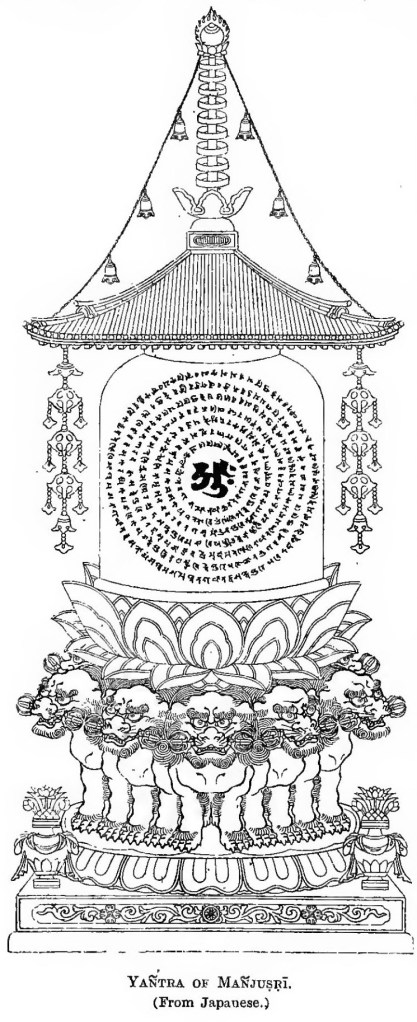 several divinities themselves,
several divinities themselves,
are used as incantations for
procuring their assistance
in peril as well as in
ordinary temporal affairs.
And by means of these
spells and mummery
the so-called
” magic circles ” are
formed by which the
divinities are coerced
into assisting the
votary to reach
“the other shore.”
And the authors of
this so-called “esoteric”
system gave it a
respectable antiquity by
alleging that its
founder was really
Nāgārjuna, who had
received it in two sections of vajra and garbha-dhatu from the celestial Buddha Vajra-sattva, within ” the iron tower ” insouthern India. Its authorship is, as even Tāranātha himself admits, most obscure. 1 The Mantra-yāna asserts that the state of the ” Great en-
1 Tāran.,118.
lighted or perfected” 1 that is, Buddhaship, may be attained in the present body (composed of the six elements) by following the three great secret laws regarding the body, speech, and thought, 2 as revealed by the fictitious Buddha, Vajrasattva.
Its silly secrets so-called comprise the spells of the several divinities, and the mode of making the magic-circles (maṇḍala) of the two sorts — the outer and inner (vajradhātu and garbha–dhātu) ; though something very like, or analogous to, magic-circles are also used in southern Buddhism. 3
Some idea of its contemptible mummery and posturing and other physical means for spiritual advancement is to be gained from the following three exercises which every Lāma should daily perform : —
The ” meditative posture of the seven attitudes ” is daily assumed by the Lāma with his associates, in order to subjugate the five senses. These attitudes are — (1) sitting with legs flexed in the well-known attitude of Buddha ; (2) the hands resting one above the other in the lap ; (3) head slightly bent forward j (4) eyes fixed on the tip of the nose ; (5) shoulders ” expanded like the wings of a vulture ; ” (6) spine erect and “straight like an arrow”; (7) tongue arching up to the palate like the curving petals of the eight-leaved lotus. While in this posture he must think that he is alone in a wilderness. And he now, by physical means, gets rid of Rāga, Moha, Dvesa— the three ” original sins ” of the body — and these are got rid of according to the humoral physiology of the ancients in the three series of dbuma, roma, and rkyaṅ-ma. After taking a deep inspiration, the air of the roma veins is expelled three times, and thus ” the white wind ” is let out from the right nostril three times in short and forcible expiratory gusts. This expels all anger. Then from the left nostril is thrice expelled in a similar way “the red air” which rids from lust. The colourless central air is thrice expelled, which frees from ignorance. On concluding these processes, the monk must mentally conceive that all
1 Mahā-utpanna or ” Atiyoga, Tib., dsog-ch’,en. 2 sKu, Sun, T’ug. This doctrine seems almost identical with that of the Shingon-shu sect of Japan described by B. Nanjio in his Jap. Buddh. Sects, p. 78. Tāranātha also mentions Nāgārjuna’s name in connection with its origin, which he admits is most obscure. It probably arose at the end of the seventh century CE., as in 720 CE. Vajrabodhi brought it with its magic-circles to China.
3 These elaborate circles of coloured clay, etc., are described in detail by HARDY, E. M., 252, etc., and I have seen diagrams of an apparently similar character in Burmese Buddhism. Compare also with the mechanical contrivance “the Octagon” (Tib., Dab-c’ad) used in the rite sGrub-byed, to concentrate the thoughts and coerce the she-devils (Ḍākkinī who confer miraculous powers described. SCHLAG;., p. 247. Cf. also ” Meditation-stone.”
ignorance, lust and anger — the three original sins — have “disappeared like frost before a scorching sun.”
He then says the ” a-lia-ki,” keeping his tongue curved like a lotus petal. This is followed by his chanting ” the Yoga of the Lāma,” during which he must mentally conceive his Lāma-guide as sitting over-head upon a lotus-flower.
The mere recital of mystic words and sentences (mantra or
Mystic Attitudes. (Lāmas of Established Church.)
dhāraṇī [T., Z’uṅ]), and their essential syllable (the germs or seed, so-called vīja) is held to be equivalent to the practice of the Pāramitās, and subdues and coerces the gods and genii, and procures long life and other temporal blessings, and obtains the assistance of the Buddhas and Bodhisats. Although these Dhāraṇī s 1 were likely introduced to supply the need for
incantations their use is alleged to be based upon the doctrine of unreality of things. As existence is ideal, the name of a thing is equivalent to the thing itself, and of a like efficacy are the attitudes (mudra) of the fingers, symbolic of the attributes of the gods. Thus OM is an acceptable offering to the Buddhas, HRI dispels sorrow, and by uttering HO, samādhi is entered.
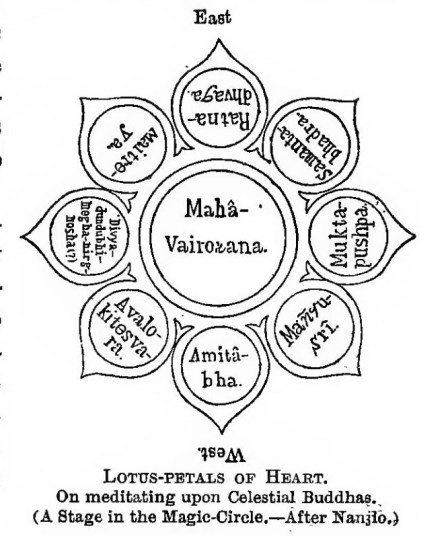 Of such an ideal nature also were the paper horses of Huc’s amusing story, which the Lāmas with easy charity be-stowed on belated and helpless travellers, as figured at the top of this chapter.
Of such an ideal nature also were the paper horses of Huc’s amusing story, which the Lāmas with easy charity be-stowed on belated and helpless travellers, as figured at the top of this chapter.
These postures and parrot-like exercises, as practised by the unreformed and semi-re-formed sects, according to the book entitled The complete esoteric Tāntra 2 and the reputed work of Padma-sambhava, are as follows.
The corresponding Gre-lug-pa rites are not very much different : —
1st. — The mode of placing the three mystic words, body, speech
and thought (leu, suṅ and t’uk).
2nd. — The nectar-commanding rosary.
3rd.— The jewelled rosary-guide for ascending.
ith. — Secret counsels of the four Yogas.
5th. — The great root of the heart.
6th. — The lamp of the three dwellings.
7th. — The bright loosener of the illusion.
8th. — The water-drawing ” dorje.”
9th. — The secret guide to the fierce Ḍākkinī.
10th. — The drawing of the essence of the stony nectar.
11th. — Counsel on the Ḍākkinī ‘s habits.
12th. — Fathoming the mystery of the Ḍākkinī s
13th. — Counsel for the Ḍākkinī ‘s heart-root.
14th. — The four words for the path of Pardo (limbo).
15th. — The Pardo of the angry demons.
1Conf. Burnouf, i., 522-74 ; Vasiliev, 153, 193 12 gsaṅ -sṅgags lpyi rgyud
148 THE DOCTRINE AND ITS MORALITY.
16th. — To recognize the Gyalwa Rig-na or the five celestial Buddhas. Then “Happiness” is reached — this goal is the sensuous happiness of the Jina’s Paradise or of Sukhāvati, that of Amitābha, the Buddha of Infinite Light. The transcendental efficacy attributed to these spells fully accounts for their frequent repetition on rosaries and by mechanical means in the ” prayer-wheel,” flags, etc.
Thus, the commonest mystic formula in Lāmaism, the ” Om maṇi padme Hūṃ,” — which literally means ” Oml The Jewel in the Lotus ! Hūṃ ! ” — is addressed to the Bodhisat Padmapāṇi
who is represented like Buddha as seated or standing within a lotus-flower. He is the patron-god of Tibet and the controller of metempsychosis. And no wonder this formula is so popular and constantly repeated by both Lāmas and laity, for its mere utterance is believed to stop the cycle of re-births and to convey the reciter directly to paradise. Thus it is stated in the Māṇi-kah- bum with extravagant rhapsody that this formula ” is the essence of all happiness, prosperity, and knowledge, and the great means of deliverance ” ; for the Om closes re-birth amongst the gods, ma, among the Titans ṇi, as a man, pad as a beast, me as a Tantalus, and Hūṃ as an inhabitant of hell. And in keeping with this view each of these six syllables is given the distinctive colour of these six states of rebirth, namely Om, the godly white; ma, the Titanic blue ; ṇi, the human yellow ; pad, the animal green ; me, the ” Tantalic ” red; and Hūṃ, the hellish black.
But the actual articulation is not even needed. The mere inspection of this formula is equally effective, and so also is the passing of this inscription before the individual. And to be effective it does not require to be actually visible, it is therefore printed thousands and millions 1 of times on long ribbons and coiled into cylinders and inserted into the ” prayer-wheels ” so- called, which are revolved everywhere in Tibet, in the hand (see pages’ 45, 218, etc.), and as great barrels turned by hand or water or wind, 2 and also printed on stones and on cloth-flags which flutter from every house, so as to ensure the cessation of metempsychosis by re-birth in the western paradise .The origin of this formula is obscure. The earliest date for it yet found is the thirteenth century CE. 3
What seems to be a more expanded version of this spell is known to a few Lāmas and is met with in Japanese Buddhism, namely, ” OM! Amogha Vairocana Mahāmudra MAṆI PADMA Jvala-pravarthtaya Hūṃ! ” But this is addressed to the first of the Dhyāni 4 Buddhas, namely, Vairocana, to whom also the Japanese Mantrayāna sect ascribe their esoteric doctrine, but the ordinary Lāmaist formula is unknown in Japan, where its place is taken by ” Nāmo O-mi-to Fo,” or ” Hail to Amitābha, the Buddha of Boundless Light.”
1 In some of the larger prayer-wheels it is printed 100,000,000 times (Baron Schilling, Cf. SCHLAG., 121. 2 For wind-prayer vanes, cf. Rock., L., p. 147 cf. ; also Giorgi, 508. 3 Rockhill, in The Land of the Lāmas, London, 1891, page 326, notes that Wilhelm de Rubruk, writing in the second half of the thirteenth century a.d. (Soc. de Geoff, de Paris, iv., page 283) states regarding the Buddhist monks of Karakorum : “Habent etiam quocumque vadunt semper in manibus quandam testem centum vel ducentorum nucleorum sicut nos portamus paternoster et dicunt semper hec verba on man baccam, hoc est Deus, tu nosti, secundum quod quidam coram interpretatus est michi, et totiens exspectat, remunerationem a Deo quotiens hoc dicendo memoratur.” Mr. Rockhill also, I find, independently arrives at a similar conclusion to myself as regards the relatively modern composition of the Mani-bkāh-sbum. Cf. also Huc, ii. ; Kopp., ii., 59-61. 4 W. Anderson, CataL Jap. Paintings Brit. Mus.
From its mystic nature the Om maṇ i formula is interpreted in a great variety of ways, including amongst others the phallic, 1 though this latter sense is seldom accorded it. The heterodox Bon-pa followers repeat it in reverse fashion, thus making it mere gibberish. 2
THE MYSTIC FORMULAS FOR THE ROSARIES.
The repetition of the mystic formulas for the beads follows the prayer, properly so-called, and is believed to contain the essence of a formal prayer, as well as to act as a powerful spell. The formulas are of a Sanskritic nature, usually containing the name of the deity addressed, but are more or less wholly unintelligible to the worshipper. Different mantras are needed for different deities ; but the one most frequently used by the individual Lāma is that of his own tutelary deity, which varies according to the sect to which the Lāma belongs. The formulas most frequently used are shown in the following table : —
The formulas most frequently used are shown in the following table : —
| Name of Deity. | The Spell. | Special kind of Rosary USED. |
| 1. Dor-je jik-je. 3Skt., Vajra-bhairava | Om ! Ya-mān-ta-taka Hūṃ phat ! | Human skullor ” stomach – stone.” |
| 2. Cha-na dorje. 4Skt. , Vajrapāṇi. . | Om ! Vajrapāṇi hūṃ phat ! Om ! Vajra dsan -da mahā ro-khana hūṃ ! | Raksha.Ditto |
| 3. Tam-din. 5Skt., Hayagriva. | Om ! pad-ma ta krid hūṃ phat! | Red sandal or coral. |
| 4. Cha-ra-si or T’ug-je- ch’enbo.6Skt., Avalokita. | Om maṇi padme Hūṃ, | Conch-shell or crystal |
| 5. Dol-ma jaṅ-k’u. 7Skt,, Tārā | Om ! Tā-re tut-tā-re ture svā-hā ! | Bo-dhi-tse or turquoise. |
| 6 Do-kar. 8Skt. , Sitātārā. | Om ! Tā-re tut-tā-re mama ā – yur punye-dsanyana pusph-pi-ta ku-ru svā-ha ! | Bodhitse. |
| 7 Dor-je p’ag-mo. 9Skt., Vajravarahi. | Om ! sar-ba Bud-dha dakkinnī hūṃ phat ! – | Ditto. |
| 8. ‘O-zer-can-ma. 10Skt., Marīcī. | Om ! Ma-rī-cye mam svā hā ! | Ditto. |
| 9. Gon-po nag-po. 11Skt., Kālanātha. | Om ! Sri Ma-hā-kā-la hūṃ phat svā-hā ! | Raksha. |
| 10. Nam-se.’ 12Skt., Kuvera. | Om ! Vaī -srā-va-na ye svā hā ! | Nanga-pāni. |
| 11. Dsam-b’a-la. 13Skt., Jambhala. | Om ! Jam-bha-la dsalen dra ye svā-hā ! | Ditto. |
| 12. Sen-ge-da. ‘ 14Skt., Siṅhanāda. | Om ! ā-hrīh Siṅ-ha- nāda hūṃ phat ! | Conch-shell or crystal.. |
| 13. Jam-yang. 15Skt. ,mañjughosha.14. Dem-ch’ok. 16Skt., Sam vara.15. Pad-ma juṅ-na. 17Skt., Padma-sambhava. | Om ! a-ra-pa-ca-na-ḍhi !Om ! hrih ha-ha hūṃ hūṃ phat !Om ! Vajra Gu-ru Padma sīd-dhī huṃ ! | Yellow rosary.BodhitseCoral or bodhitse.. |
1 As noted by Hodgson. 2 The characteristic Bon-pa mantra is however: ‘ Ma-tri-mu-tri sa-la dzu.” Cf. Jaesch., D., 408; DESGODINS, 242. 3 rdo-rje-‘jigs-byed. 4 p’yag-na rdo-rje. 5 rta-mgrin. 6 T’ugs-cje-c’en-po. 7 sgrol-ma jan-k’u. 8 sgrol-dkar. 9 do-rje p’ag-mo. 10 od-zer-c’an-ma. 11 mgon-po nag-po. 12 rnam-sras. 13 dsam b’a-la. 14 seṅ-ge-sgra. 15 ‘jam-dbyangs. 16 bde-mch’og. 17 pad-ma byuṅ-gnas. 18 REMUSAT, As. Misc. Most conspicuous amongst the authors of diatribes against Buddhist worship was Han Yii in the eighth or ninth centuries CE. Cf. Mayers.
The concluding word phat which follows the mystic hūṃ in many of these spells is cognate with the current Hindūstani word phat, and means ” may the enemy be destroyed utterly ! “The laity through want of knowledge seldom use with their rosaries any other than the well-known ” Jewel-Lotus ” formula.
Such mechanical means of spiritual advancement by promising immediate temporal benefits, have secured universal popularity ; and possess stronger attractions for gross and ignorant intellects over the moral methods of early Buddhism. The Chinese literati ridicule the repetition of these mantras by saying, 18 ” Suppose that you had committed some violation of the law, and that you were being led into the judgment-hall to receive sentence; if you were to take to crying out with all your might ‘ Your Worship ‘ some thousands of times, do you imagine that the magistrate would let you off for that ? ”
On the evolution, in the tenth century, of the demoniacal Buddhas of the Kalacakra, the ” Mantra “-vehicle was developed into ” The Thunderbolt -vehicle ” or Vajrayāna, the proficient in which is called Vajrācārya. According to this, the most depraved form of Buddhist doctrine, the devotee endeavours with the aid of the demoniacal Buddhas and of fiendesses (Dākkinī) and their magic-circles to obtain the spiritual powers of Siddhi 1 or ” The accomplishment of perfection or of one’s wishes.” Although the attainment of Siddhi is below the stage of Arhatship, the Lāmas value it more highly than the latter on account of its power of witchcraft. Its mystic insight is classed as the external (Ch’ir-dub), internal (Naṅ-dub), and esoteric or hidden (Saṅ-dub), and correspond to the body, speech, and thought. Its followers are called Vajrācārya and its rules are detailed by Tsoṅ K’hapa. Its recognized divisions'” are: —
VAJRAYĀNA
In only the last, or Anuttara Tantra, have the tutelary demons spouses. 3
The rampant demonolatry of the Tibetans seems to have developed the doctrine of tutelary deities far beyond what is found even in the latest phase of Indian Buddhism, although I find at many of the mediaeval Buddhist sites in Magadha, images of several of the. devils which are so well-known in Tibet as tutelaries.
Each Lāmaist sect has its own special tutelary fiend, which may or may not be the personal tutelary of all the individual Lāmas of that particular sect; for each Lāma has a tutelary of his own selection, somewhat after the manner of the ishṭā devatā of the Hindūs, who accompanies him wherever he goes and guards his footsteps from the minor fiends. Even the purest of all the Lāmaist sects — the Gre-lug-pa — are thorough-paced devil-worshippers, and value Buddhism chiefly because it gives them the whip-hand over the devils which everywhere vex humanity with disease and disaster, and whose ferocity weighs heavily upon all. The purest Gre-lug-pa Lāma on awaking every morning,
1 Siddhi, which seems (according to sir MON. WILLIAMS, Budd., 536) , to correspond to the stage below Arhatship. Eighty Siddhas (saints) are sometimes mentioned. And amongst their supernatural Irdhi powers they obtain “the Rainbow Body” (‘jah-lus), which vanishes like the rainbow, leaving no trace behind. 2 Cf. JAESCH., D., 112. 3 The directions for these cults are found chiefly in the Ñiṅ-ma “revelations” or terma books.
and before venturing outside his room, fortifies himself against assault by the demons by first of all assuming the spiritual guise of his fearful tutelary, the king of the demons, named Vajrabhairava or Samvara, as figured in the chapter on the pantheon. The Lāma, by uttering certain mantras culled from the legendary sayings of Buddha in the Mahāyāna Tantras, coerces this demon-king into investing the Lāma’s person with his own awful aspect. 1
Thus when the Lāma emerges from his room in the morning, and wherever he travels during the day, he presents spiritually the appearance of the demon-king, and the smaller malignant demons, his would-be assailants, ever on the outlook to harm humanity, being deluded into the belief that the Lāma is indeed their own vindictive king, they flee from his presence, leaving the Lāma unharmed.
A notable feature of Lāmaism throughout all its sects, and decidedly un-Buddhistic, is that the Lāma is a priest rather than a monk. He assigns himself an indispensable place in the religion and has coined the current saying ” Without a Lāma in front there is no (approach to) God.” He performs sacerdotal functions on every possible occasion ; and a large proportion of the order is almost entirely engaged in this work. And such services are in much demand ; for the people are in hopeless bondage to the demons, and not altogether unwilling slaves to their exacting worship.
The Chinese contempt for such rites is thus expressed in a sacred edict of the emperor Yung-Ching. 2 ” If you neglect to burn paper in honour of Buddha, or to lay offerings on his altars,he will be displeased with you, and will let his judgments fall upon your heads. Your god Buddha, then, is a mean fellow. Take for a pattern the magistrate of your district. Even if you never go near him to compliment him or pay court to him, so long as you
1 This process, called lha-sgrub-pa, implies (says Jaeschke, D., 52) not so much the making a deity propititious to man (Csoma’s definition in his Dict.) as rendering a god subject to human power, forcing him to perform the will of man. This coercion of the god is affected by saints continuing their profound meditation (sgom-pa) for months and years until the deity, finally, overcome, stands before them visible and tangible; nay, until they have been personally united with and, as it were, incorporated into the invoked and subjected god. The method of effecting this coercion, of obliging a god to make his appearance, is also called sgrub-tābs. 2 Remusat, As. Miscell.
are honest folk and attentive to your duty, he will be none the less ready to attend to you ; but if you transgress the law, if you commit violence, or trespass on the rights of others, it would be useless for you to try a thousand ways of flattering him ; you will always be subject to his displeasure.”
Thus had these various influences warped the Buddhist doctrine in India, ere it reached Tibet, and there the deep-rooted demon- worship made Lāmaism what it is : a priestly mixture of Shamanist cults and poly-demonist superstitions, overlaid by quasi-Buddhist symbolism, relieved by universal charity and other truly Buddhist principles, and touched here and there by the brighter lights of the teaching of Buddha.
But notwithstanding its glaring defects, Lāmaism has exerted a considerable civilizing influence over the Tibetans. The people are profoundly affected by its benign ethics, and its maxim, ” as a man sows he shall reap,” has undoubtedly enforced the personal duty of mastery over self in spite of the easier physical aids to piety which are prevalent.
And it is somewhat satisfactory to find that many of the superior Lāmas breathe much of the spirit of the original system. They admit the essentially un-Buddhist nature of much of the prevalent demonolatry, and the impropriety of its being fostered by the church. They regard this unholy alliance with the devils as a pandering to popular prejudice. Indeed, there are many Lāmas who, following the teaching of the earlier Buddhism, are inclined to contemn sacerdotalism altogether, although forced by custom to take part in it.
Novice-Lāma reading Scriptures.
VII.
THE SCRIPTURES AND LITERATURE.
The sacred books embodying the “Word” of Buddha are regarded by the Lāmas, in common with all other Buddhists, as forming the second member of the Trinity — “The Three precious Ones” — in whom the pious Buddhist daily takes his ” refuge.” The books themselves receive divine honours. They are held materially sacred, placed in high places, and worshipped with incense, lamps, etc.; 1 and even fragments of books or manuscripts bearing holy words are treasured with the utmost reverence. It is deemed the grossest profanity for anyone to throw even a fragment of holy writ upon the ground or to tread upon it, and in this way the Tibetans, like the Chinese, not infrequently express their contempt for Christianity by utilizing, as soles for their shoes, the bundles of tracts which the missionaries supply to them.
But Buddha, like “the Light of the World,” and unlike Moses and Muhammad, wrote nothing himself; nor does it appear that his words were even reduced to writing until about 400 years or more after his death, 2 so it is unlikely that most of his sayings have preserved their original form, wholly unaltered, in the process of handing them down orally during several centuries.
The Lāmaist scriptures are faithful translations 3 from the Sanskrit texts, 4 and a few also from the Chinese, made mostly in the eighth and ninth, and the eleventh to the thirteenth centuries
1 The scriptures are actively worshipped even by southern Buddhists. ” The books are usually wrapped in cloth, and when their names are mentioned an honorific is added equivalent to reverend or illustrious. Upon some occasions they are placed upon a kind of rude altar near the roadside, as I have seen the images of saints in Roman Catholic countries, that those who pass by may put money upon it in order to obtain merit ” (Hardy’s East Mon., 192). Compare also with Hindūs paying respect to their Sastras with garlands and perfumes and grains of rice, and the Sikhs to their Granth . 2 The words were at first transmitted down orally; their recital (bhāna = to speak ) is one of the duties of a monk even now. The southern (Pāli) scriptures are stated to have been first reduced to writing in Ceylon in 88-76 B.C., in the reign of King Vartagāmani (TURNOUR, Mahavanso, 207), and the northern by king Kanishka in the second half of the first century CE. But as writing was certainly in use in Asoka’s ‘ day— 250 B.C.— it is probable that some scriptures were committed to writing at an earlier period than here assigned to the complete collect, Cf. Oldenberg, Vinaya Trip. xxxviii. 3 The verbal accuracy of these translations has been testified by Max Muller, Rhys Davids, Cowell, Foucaux, Peer, Vasiliev, Rockhill, etc. 4 Indian, Kashmiri and Nepalese scriptures. A few of the Tibetan translations were made from the Pāli, e.g., vol. 30 of Sutras (Rockhill’s Udvanavarga, x). Some very old Indian MSS. still exist in Tibet. His Excellency Shad-sgra Shab-pe, one of the Tibetan governors (bKāh-blon) of Lhāsa, while at Darjiling about a year ago, on political business, informed me that many ancient Buddhist manuscripts, which had been brought from India by mediaeval Indian and Tibetan monks, are still preserved in Tibet, especially at the old monasteries of Sām-yas, Sakya, Nar-thāng and Phun-tsho- ling. These manuscripts, however, being worshipped as precious relics, and written in a character more or less unknown to the Lāmas, are kept sealed up and rarely seen by the Lāmas themselves.
CE. ; and a very few small volumes, those first translated into Tibetan, date to the epoch of Thon-mi Sambhota, about 645 CE. None of these Tibetan translations, however, seem to have been printed until comparatively recent times, though the exact date of the introduction of printing into Tibet is as yet unknown.
The Tibetan so-called “books” are, strictly speaking, only xylographs, being printed from rudely carved wooden blocks. Movable type is unknown, and a large proportion of the books are still written in manuscript. The great canon, the Kāh-gyur, was, it seems, only printed for the first time, at least in its collected form, about two hundred years ago.
The paper, which is remarkably tough, is made from the inner bark of a shrub, 1 and comes mostly from Nepal and other parts of the sub -Himalayas, and the Chinese border-lands. The smaller abstracts from the scriptures, used by the more wealthy devotees, are sometimes written on ornate cardboard, consisting of several sheets of paper pasted together, and varnished over with a black pigment, upon which the letters are written in silver or gold; occasionally they are illuminated like missals.
Books now abound in Tibet, and nearly all are religious. The literature, however, is for the most part a dreary wilderness of words and antiquated rubbish, but the Lāmas conceitedly believe that all knowledge is locked up in their musty classics, outside which nothing is worthy of serious notice.
The Lāmaist scriptures consist of two great collections, the canon and the commentaries, commonly called the ” Kāng-gyur, or properly the. Kāh-gyur, 2 and Taṅ-gyur.” 3
The great code, the Kāh-gyur, or ” The Translated Commandment,” is so called on account of its text having been translated from the ancient Indian language, 4 and in a few cases from the Chinese. The translators were learned Indian and Kashimrī Paṇḍits and a few Chinese monks, assisted by Tibetan scholars. 5
The code extends to one hundred or one hundred and eight volumes of about one thousand pages each, comprising one thousand and eighty-three distinct works .
1 The Daphne Cannabina. See Hodgson in J.A.S.B., 1832, i., p. 8, for an account of its manufacture. 2 bkah-‘gyur. 3 bstaṅ-‘gyur. 4. rgya-gar-skad, or ” Indian language,” and usually employed as synonymous with “Sanskrit.” 5 Lo-tsa-wa.
The bulk of this colossal bible may be imagined from the fact that each of its hundred or more volumes weighs about ten pounds, and forms a package measuring about twenty-six inches long by eight inches broad and about eight inches deep. Thus the code requires about a dozen yaks for its transport ; and the carved wooden blocks from which this bible is printed require, for their storage, rows of houses like, a good-sized village.
The Kāh-gyur is printed, I am informed, only at two places in Tibet : the older edition at Narthang, 1 about six miles from Tashi-lhunpo, the capital of western Tibet and headquarters of the Grand Panch’en-Lāma. It fills one hundred volumes of about one thousand pages each. The later edition is printed at Der-ge 2 in eastern Tibet (Kham) and contains the same matter distributed in volumes to reach the mystic number of one hundred and eight. In Bhutan an edition is printed at Punakha ; 3 and I have heard of a Kumbum (Mongolian) edition, and of one printed at Peking. The ordinary price at Narthang is about eight rupees per volume without the wooden boards. Most of the large monasteries even in Sikkim possess a full set of this code. The Peking edition published by command of the emperor Khian-Lung, says Koppen, sold for £600 ; and a copy was bartered for 7,000 oxen by the Buryats, and the same tribe paid 1,200 silver roubles for a complete copy of this bible and its commentaries. 4 The Kah-gyur was translated into Mongolian about 1310 CE. by Saskya Lāma Ch’os-Kyi ‘Od-zer under the Saskya Pandita, who, assisted by a staff of twenty-nine learned Tibetan, Ugrian, Chinese and Sanskrit scholars, had previously revised the Tibetan canon by collating it with Chinese and Sanskrit texts, under the patronage of the emperor Kublai Khan.
The contents of the Kāh-gyur and Taṅ-gynr were briefly analyzed by Csoma, 5 whose valuable summary, translated and
1 sN’ar-taṅ. 2 sDe-dge. 3 So I have been told. 4 And a copy also of this edition seems to be in the St. Petersburg Academy of Sciences, obtained about 1830 by Baron Schilling de Canstadt, together with about 2,000 Mongolian and Tibetan treatises. — Bulletin Historico-philologique del ‘Academie de St. Peterbourg, tom, iv., 1848, pp. 321-329. 5 Vol. XX., As. Researches.
indexed by Feer, 1 and supplemented in part by Schiefner and Rockhill, forms the basis of the following sketch. Hodgson’s copy of the Kāh-gyur, on which Csoma worked at Calcutta, contained one hundred volumes, and appears to have been printed from the wooden types prepared in 1731, and which seem to be still in use at Narthang. The Kāh-gyur is divisible into three 2 great sections, the Tripitaka, 3 or three vessels or repositories, corresponding generally to the less inflated Pali version of the Tripitaka of the southern Buddhists, which has, however, no counterpart of the mystical Sivaist treatises, the Tantras. The three sections are : —
I. The Dul-va (S’kt., Vinaya), or Discipline, the compilation of which is attributed to Upali, 4 in thirteen volumes.
II. The Do (Skt., Sutra), or Sermons (of the Buddhas), compiled by Ananda 5 in sixty-six volumes inclusive of Tantras. As these discourses profess to be the narrative of the disciple Ananda, 6 who is believed to have been present at the originals as uttered by Buddha, most of these Sutras commence with the formula : Evam mayā srutam, ” Thus was it heard by me ; ” but this formula now is almost regarded by many European scholars as indicating a fictitious sutra, so frequently is it prefixed to spurious sutras, e.g., the Amitābha, which could not have been spoken by Buddha or recited by Ananda. The Lāmas, like the southern Buddhists, naively believe that when Buddha spoke, each individual of the assembled hosts of gods, demons, and men, as well as the various kinds of lower animals, 7 heard himself addressed in his own vernacular.
III. The Ch’ os-non-pa (Skt. Abidharma), or Metaphysics,
1 M. Leon Feer published in 1881 a translation of Csoma’s Analysis under the title Analyse du Kandjour et du Tandjour in the second volume of the “Annates du Musee Guimet,” and appended a vocabulary giving all the names which occur in Csoma’s Analysis, with an Index and Table Alphabetique de Ouvrages dus Kandjour.And he gave further extracts in Vol. v. of the same serial. 2 Another classification of the canonical scriptures, especially amongst the Nepalese, is given by Hodgson (Lang. 13, 49) as ” The nine scriptures (Dharmas),” namely : 1. Prajñā pāramitā. 2. Gandha-vyuha. 3. Daṣa-bhūmīsvara. 4. Samādhi-rāja. 5. Laṅkāvatāra. 6. Saddharma Puṇḍarīka. 7. Tathāgatha guhyaka (containing the secret Tāntrik doctrines). 8. Lalita Vistara. 9. Suvarna-prabhasa. 3 sde-snod gsum. 4 Ñye-var-‘K’or. 5 ‘Kun-dgah-wo. 6 At the first great council when Buddha’s word was collated 7 Cf. also Beal’s Romantic Legend, 244-254, Gya Tscher Rol-pa, ch. 26.
including Transcendental Wisdom (S’er-p’yin, Skt., Prajñā pāramitā), attributed to Mahā Kāṣyapa, in twenty-one volumes.
These three sections are mystically considered to be the antidotes for the three original sins ; thus the discipline cleanses from lust (Rāga), the sermons from ill-will. (Dvesa), and the wisdom from stupidity (Moha).
By subdividing the Do or Sutra section into five portions, the following sevenfold division of the canon results : —
” I. Discipline or Dul-va (Skt., Vinaya), in thirteen volumes, deals with the religious discipline and education of those adopting the religious life, and also contains Jātakas, avadanas, vyakaranas, sutras, and ridānas.” (It is the Vinaya of the Sarvastivadins and its greater portion has been abstracted by Rockhill. 1 ) It is sub-divided into seven parts :
1. “The Basis of Discipline or Education (clul-va-gz’i, Skt., Vinaya Vastu), in four volumes (K, K’, G, and N), translated from the Sanskrit in the ninth century by the Pandits Sarvajñyādeva and Dharmakara of Kashmīr and Vidyakara-prabha of India, assisted by the Tibetan Bandes dPal-gyi lhunpo and dPal-brtsegs. (The chief Jātaka and other tales interspersed through these volumes form the bulk of Schiefner’s collection of Tibetan tales, translated into English by Ralston.) 2. ” Sūtra on Emancipation (So-vor-t’ar-paī-mdo, Skt., Pratimoksha Sūtra), 2 in 30 leaves.
3. ” Explanation of Education (Dul-va nam-par-‘byed-pa, Skt., Vinaya vibhāga) in four volumes. Enumerates the several rules (K’rims) of conduct, 253 in number, with examples of the particular transgression which led to the formation of these laws. Directions for dress and etiquette.
4. ” Emancipation for Nuns (dGe-sloṅ mahi so-sor thar pai mod, Skt., Bhikshuni pratimoksha Sūtra), 36 leaves in the ninth volume (T).
5. “Explanation of the Discipline of the Nuns (Skt. , Bhik. Vinaya vibhāga) in preceding volume (T).
6. ” Miscellaneous Minutiae concerning Religious Discipline (Dul-va p’ran-ts’egs-kyi gz’i, Skt., Vinaya Kshudraka Vastu ), in two volumes.
7. ” The highest text book on Education ” (Dul-va gzuṅ bla-ma Vinaya Uttara Grantha), in two volumes (N and P), and when spoken of as ” the four classes of precepts ” (liṅ -de-zhi) the division comprises
1, 2 and 3, 6 and 7.
II. Transcendental Wisdom (“Ṣes-rab kyi p’a-rol-tu pyin-pa” or curtly, ” Ser-ch’in ” (Skt., Prajñā pāramitā), in twenty-one volumes.
1 The Life of the Buddha, etc. Also in part, but not directly for the Dulva, by Schiefner in his Tibetische Liebenbescriebung Sakra, impl., St. Petersburg, 1849.
2 Cf. translation from the Tibetan by Rockhill, and from the Pāli by Rhys Davids and Oldenberg, Vinaya Texts.
They contain, in addition to the metaphysical terminology, those extravagantly speculative doctrines entitled Prajñā pāramitā, which the Mahāyāna school attributes to Buddha’s latest revelations in his mythical discourses mostly to supernatural hearers at the Vultures’ Peak at Rājgriha. 1 There is no historical matter, all is speculation, and a profusion of abstraction. The first twelve volumes, called ‘Bum (Skt., Ṣata Sahasrikā) or “the 100,000 (slokas of Transcendental Wisdom),” treat fully of the Prajñā pāramitā at large, and the remaining volumes are merely various abridgments of these twelve. Thus the three volumes called Ñi-k’ri (pron. Nyi- ṭhi) or ” the 20,000 (slokas)” is intended for those monasteries or individuals who cannot purchase or peruse the full text ; while the single volume, entitled the brgyad-stoṅ-pan (ashta sahasrika) or 8,000 (slokas), contains in one volume the gist of the Prajñā pāramitā , and is intended for the average and junior monks. This is the volume which is figured on the lotus which Mañjuṣṛī, the Bodhisattva of wisdom, holds in his left hand. And for the use of the schoolboys and the laity there is a recension of three or four leaves, entitled “Transcendental Wisdom in a few letters” or Yige-ñuṅ-du (Skt., Alpa akshara). 2 And mystically the whole is further condensed into the letter A, which is considered ” the mother of all wisdom,” and therefore of all men of genius ; all Bodhisattvas and Buddhas are said to have been produced by “A” since this is the first element for forming syllables, words, sentences, and a whole discourse.
One of the most favourite Sūtras and a common booklet in the hands of the laity, is “the Diamond-cutter” (rDo-rje gc’od-pa, Skt., Vajrach’edikā) In it Bhagavati (Ṣākya) instructs Subhūti, one of his disciples, in the true meaning of the Prajñā pāramitā. 3
The full text (‘Bum) was translated from the Sanskrit in the ninth century by the Indian pandits Jina Mitra and Surendra Bodhi, and the Tibetan interpreter Ye-s’es-sde.
III. ” Association of Buddhas ” (P’al-c’ar, Skt., Buddhāvataṅsaka), in six volumes. Description of several Tathagatas or Buddhas, their provinces, etc. Enumeration of several Bodhisats, the several degrees of their perfections, etc. This great Vaipulya (or developed Sūtra) is alleged to have been preached by Buddha in the second week of his Buddhahood and before he turned the ” Wheel of the Law ” at Benares. And it is asserted to have been delivered in nine assemblies at seven different places, and is thus given pre-eminence over the first historic discourse at Sarnath.
IV. ” The Jewel-peak ” (dkon-brtsegs, Skt., Ratna-kūta). Enumeration of several qualities and perfections of Buddha and his doctrine.
1 They are alleged to have been delivered in sixteen assemblies at the following sites : Gridhrakūta, Ṣrāvaṣtī, Veṇuvana, and the abode of the Paranirmita-vasavartins. cf. Bun. Nanjio’s Jap. Budd. Sects, p. xvii.
2 This probably corresponds to the Mahā Prajñā pāramitā hridaya Sūtra, translated by Beal (Catena, 282), and perhaps the original of the more expanded treatises. 3 It has been translated from the Sanskrit by Cowell, Mahāyāna Texts, ii., xii.
V. The Aphorisms (Tib., mDo or mDo-sde Sūtra or Sūtrānta).
The amplified or developed Sūtras are called Vaipulya. In a general sense, when the whole Khā-gyur is divided into two parts, mDo and rGyud, all the other divisions except the rGyud are comprehended in the mDo class. But in a particular sense there are some treatises which have been arranged under this title. They amount to about 270, and are contained in thirty volumes. The subject of the works is various. The greatest part of them consist of moral and metaphysical doctrine of the Buddhistic system, the legendary accounts of several individuals, with allusions to the sixty or sixty-four arts, to medicine, astronomy, and astrology. There are many stories to exemplify the consequences of actions in former transmigrations, descriptions of orthodox and heterodox theories, mural and civil laws, the six kinds of animal beings, the places of their habitations, and the causes of their being born there, cosmogony and cosmography according to Buddhist notions, the provinces of several Buddhas, exemplary conduct of life of any Bodhisat or saint, and in general all the twelve kinds of Buddhist Scriptures 1 are to be found here.
The second volume (K’) contains the romantic biography of Buddha — the Lalita Vistara, translated by M. Foucaux. 2 The seventh volume (J) contains the Saddharma Puṇḍarīka 3 or White Lotus of the Holy Law, translated from the Sanskrit into French by Burnouf, and into English by Prof. H. Kern, 4 and the most popular treatise with Japanese Buddhists. The eighth volume (N) contains “the Great Decease” (Mahāparinirvāna). The ninth volume has, amongst others, the Suraṅgama Samādhi Sūtra referred to by FaHian. The twenty-sixth volume (L), folios 329-400, or chapters of “joyous utterance” (Udānas), contains the Udānavarga,5 which Schiefner showed to be the Tibetan version of the Dhammapada ; and which has been translated into
1 This twelve-fold division (gsuṅ rab yan-lay bc’u-gñis) I here extract from the Vyutpatti in the Taṅ-gyur: 1. Sutran (mdo-sdehi-sde) discourses. 2. geyam (dbyaṅs kyis bsñad), mixed prose and verse. 3. Vyakaraṅaṅ (luṅ du-btan), exposition. 4. Gāthā (Tshigs-su-bc’ad), verse. 5. Udānan (C’ed-du-brjod). 6. Nidānaṅ (gliṅ-gzhi). 7. Avadānan (rtogs-pa-brjod). 8. Itivrittahan (de-lta bw byuṅ). 9. Jātaka (skyes-pa-rabs). 10. Vaipulyan (shin-tu-rgyas), very expanded. 11. Atbhūtdharmmah (rmad- du byuṅ), mysteries. 12. Upadesah (gtun-la-dbab). This division, says BURNOUF (Introd., p. 45-60), writing of Nepalese Buddhism, is made up of the older nine angas mentioned by Buddhagosha, CE. 450, to which were added at a later period Nidana, Avadana, and Upadesa. Conf. also CHILDERS’ Dict., Burnouf’s Lotus, 355, 356; Hardy’s Man.,Hodgson’s Ess., 15; Rhys Davids’ Budd., 214.
2 Also summarised by CSOMA(Anal.,413) and VASIL.,B.,3,4,176; FEER’s Intro., p. 72. Also abstracted by Rockhill, B., ii. ; and in part from the Sanskrit by Raj. Mitra. 3 Dam-pahi ch’os padma dkar-po. 4 Vol. xxi., Sacred Books of the East. 5 Ch’ed-dubrjod pai ts’oms; see also Csoma’s An., p. 477. Its commentary by Prajñāvarmarj (a native of Bengal who lived in Kashmīr in the ninth century— Tāranātha, p. 204, Rockhill, xii.) is in Vol. lxxi. of Tan-gyur.
English with copious notes by Mr. Rockhill. It contains three hundred verses, which ” are nearly identical with verses of the Dhammapada , one hunched and fifty more resemble verses of that work.” The variations show that the northern translation was made from a different version than the Pāli, 1 and from, as Mr. Rockhill believes, 2 a ” Sanskrit version in the dialect prevalent in Kashmīr in the first century CE., at which period and in which place the compiler, Dharmatrāta, 3 probably lived.”
From this (Do) division of the Kah-gyur are culled out the Indian mystic formulas, mostly in unintelligible gibberish, which are deemed most potent as charms, and these form the volume named mDo-maṅ gzuṅ. 4 bsdus, or curtly, Do-maṅ or “assorted aphorisms” — literally “many Sūtras.” These formulas are not used in the worship of the Buddhas and superior gods, but only as priestly incantations in the treatment of disease and ill-fortune. And as these spells enter into the worship of which the laity have most experience, small pocket editions of one or other of these mystic Sūtras are to be found in the possession of all literate laymen, as the mere act of reading these charms suffices to ward off the demon-bred disease and misfortune.
The remaining divisions of the canons are : —
VI. Nirvāṇa (Mya-naṅ-las-‘das-pa), in two volumes. An extended version, part of the eighth volume of the mDo on ” The Great Decease, or Entire deliverance from Pain.” “Great lamentation of all sorts of animal beings on the approaching death of Shākya; their offerings or sacrifices presented to him ; his lessons, especially with regard to the soul. His last moments ; his funeral; how his relics were divided and where deposited.” 5
VII. Tantra (rgyud), in twenty-two volumes. ” These volumes in general contain mystical theology. There are descriptions of several gods and goddesses. Instruction for preparing mandalas or circles for the reception of those divinities. Offerings or sacrifices presented to them for obtaining their favour. Prayers, hymns, charms, etc.. addressed to them. There are also some works on astronomy, astrology, chronology, medicine, and natural philosophy.”
In the first volume (K) are found the Kālacakra doctrine 7 and Sambara. In the third the history of the divine mothers Vārāhi, etc.
1 ROCKHILL’S Udānavarga, ix. 2 Loc cit., x. 3 Tāranātha, p. 54, lig. 8. 4 gz’uṅs = skt. dharani, which is a mystic spell like the Hindū Mantra. 5 Csoma, An., p. 487. 6 Csoma, An., p. 487. 7 Csoma, Gram.,p. 172: Dict., 488.
In the seventeenth volume (M) the expelling of devils and Nāgā-worship. The Tathāgata-guhyaka contains a summary of the Sivaic esoteric doctrine.
The word ” Tantra” according to its Tibetan etymology, literally means 1 ” treatise or dissertation,” but in Buddhism as in Hindūism, it is restricted to the necromantic books of the later Sivaic or Sākti mysticism.
The Tantras are arranged into ” The four classes” (gyucl sde bzhi) :
1. Kriyā Tantra (bya-bai-rgyud).
2. Cāryā T. (spyod-pai rgyud).
3. Yoga T. (rual-‘byor rgyud).
4. Anuttara Toga T. (rnal-‘byor bla-na med-pai rgyud) or “The peerless Yoga.”
The first two form together the lower division (og-ma), and the latter two the higher division (gon-ma). It is only in the Anuttara Yoga tantras, including the Atiyoga (Ds og-ch’en), that the tutelary fiends and their Jinas have female energies or Mātris.
Those translated from the eighth to the eleventh centuries CE. are called “the Old,” while the latter are “the New.” Amongst those composed in Tibet are the Hayagriva, Vajraphurba and sKu-gsuṅ-t’ugs yon-tan ‘p’rin las.
THE COMMENTARIES (TAṄ -GYUR).
The Buddhist commentators, like those of the Talmud, overlay a line or two with an enormous excrescence of exegesis.
The Tibetan commentary or TAṄ -GYUR is a great cyclopedic compilation of all sorts of literary works, written mostly by ancient Indian scholars and some learned Tibetans in the first few centuries after the introduction of Buddhism into Tibet, commencing with the seventh century of our era. The whole makes two hundred and twenty-five volumes. It is divided into
the classes — the rGyud and mDo (Tantra and Sutra, classes in Sanskrit). The rGyud, mostly on tantrika rituals and ceremonies, make eighty-seven volumes. The mDo on science and literature one hundred and thirty-six volumes. One separate volume contains hymns or praises on several deities and saints. And one volume is the index for the whole. 2 The first sixteen volumes of the mDo class are all commentaries on the Prajñā pāramitā . Afterwards follow several volumes explanatory of the Madhyamikā philosophy (of Nāgārjuna) which is founded on the Prajñā pāramitā 3
1 Jaeschke, p. 112. 2 Csoma, An., 553. 3 A few of the individual treatises have been translated, either in full or abstract, by Schiefner, Rockhill, etc. Nāgārjuna’s Friendly Epistle (bches-pahi p’rin yig), by Wenzel in J. Pāli Text Soc., 1886
One volume contains the Tibeto-Sanskrit dictionary of Buddhist terminology, the ” bye-brag-tu rtogs byad (pron. je-tak-tu tog-je) — the Mahāvyutpati. 1 Under this heading would also come the later commentaries, such as the Bodhi-patha (in Mongolian — Bodhi Mur). Its contents include rhetoric, grammar, prosody, mediaeval mechanics, and alchemy. But its contents have not yet been fully examined. 2
THE INDIGENOUS TIBETAN LITERATURE.
The indigenous works composed in Tibet are for the most part devoted to sacred subjects. The secular books exist, as a rule, in manuscript, as the printing is in the hands of the monks. 3 The sacred books may be divided into (a) apocryphal and (b) authentic or quasi-authentic.
The apocryphal works are the most numerous and most popular. Chief amongst these are the fictitious “revelations” or Terma books, already referred to in describing the part which they played in the origin of the sects of Lāmaism. These Terma books may be recognized by their style of caligraphy. For instead of the opening sentences and chapters commencing with the hook-like symbol for Om, duplicated or triplicated, as on the cover of this book, and the punctuation periods being vertical lines, as in ordinary orthodox books, the Terma books commence with the ordinary anusvāra (aṃ), or a vertical stroke enshrined in a trefoil-like curve, and their periods are marked by two small circles one over the other, like the Devanagari visarga, but with a curved line with its concavity upwards, intervening. These
” revelations,” it will be remembered, pretend to be the composition of St. Padma, the founder of Lāmaism.’ 4
1 The Sanskrit text of which has been published by Maiyaneff ; and much of it is abstracted in the Buddhistische Triglotte, printed by Schiefner, St. Petersburg, 1859. 2 The 2nd vol. of the Annates dn Musee Guimet contains some additional notes on the Taṅ-gyur by M. Leon Feer. 3 Most of the printing-monastic establishments issue lists of the books which they sell. 4 Amongst the better known are : The Golden Rosary, of Displayed Letters (T’ug-
yig gser-‘p’reṅ), found by Sang-gyas gling-pa ; The Displayed Lotus Orders (Padma bkāh-t’an), found by O-rgyan gling-pa ; Kā -t’ang Zang-gling ma ; The Lamp Enlightener of Prophecy (Lung-brtan gsal-baī sgron-me). Also of this nature are .- The Directions for the Departed Soul to find its way to bliss (Pa-cha-to’s-sgrol).
To this revelation class belong also the fictitious works attributed to King Sroṅ Tsan Gampo. 1
Of the other most common apocryphal works found in Sikhim are the Na-yik, or ” Story of the Sacred Sites of Sikhim,” and Lhatsun’s inspired manual of worship for the great mountain god
Kaṅch’en-dso-ṅa (English, Kinchinjunga). Each monastery possesses in manuscript a more or less legendary account of its own history (deb-t’er), although this is kept out of sight. In the
Lepcha monasteries and in the possession of a few Lepcha laymen are found the following, mostly translations from the Tibetan :
(1) Tāshi Suṅ, a fabulous history of St. Padma-sambhava; (2) Guru Ch’o Waṅ; (3) Sākun de-lok, the narrative of a visit to Hades by a resuscitated man named Sākun; 2 (4) Ek-doshi man-lom — forms of worship.
The large work on the Nāga demigods — the Lu-‘bum dkar-po — is regarded as a heterodox Bon-po book. 3
As authentic works may be instanced, the religious chronologies (Ch’os-‘byuṅ) and records (Deb-t’er) by Bu-ton, and Padma-kar- po ; the histories (Suṅ-‘bum) of Zhvā-lu Lo-tsa, and Tāranātha’s well-known history of Buddhism in India, and a useful cyclopedia by an Amdo Lāma entitled T’ub-dbaṅ bstan-pāhi Ñima ; and as quasi-authentic the fifth Grand Lāma’s ” royal pedigree.*’ 4 All begin with pious dedicatory sentences and usually end with the Buddhist wish that the writer may acquire merit through his literary work.
But most of the autobiographies so-called (rNam-t’ar) and records (Yig-tsaṅ or deb-t’er) are legendary, especially of the earlier Lāmas and Indian monks are transparently fictitious, not only on account of their prophetic tone, though always ” discovered ” after the occurrence of the events prophesied, but their almost total absence of any personal or historic details. Some of the later ones
1 (1) Mani bKāh-bum (already referred to), the legendary history of Avalokita and a maze of silly fables. (2) S’aleh’em or Sroṅ Tsan Gampo’s Honourable Will or Testament, and (3) an exoteric volume entitled ” The Sealed Commands,” bkā-rgga- ma, which is kept carefully secreted in some of the larger monasteries. It belongs to
the silly esoteric class of books called Saṅ-ṅak. 2 Cf. also the play of Naṅsa, The Brilliant Light, Chap. xx.
3 A German translation by Schiefner of the smaller version has been published by the St. Petersburg Acad. (Das Weisse Nāga Hunderh tausend.) Cf. also ROCKHILL. L, p. 217, n. 4 gyal-rabs [Skt., Rājvansa].
167. INDIGENOUS BOOKS.
dealing with modern personages are of a somewhat more historical character, but are so overloaded by legends as to repel even enthusiastic enquirers.
The leading ritualistic manuals of the various sects are of a more or less authentic character, and small pocket editions of these prayer books (smon-lam) and hymns (bstod-tsogs) are very
numerous. 1 Individual Lāmas possess special books according to their private means and inclinations, such as the 100,000 songs 2 of the famous mendicant sage Mila-ra-pa on the worship of Tārā and other favourite or tutelary deities, and the mode of making
their magic-circles. Mongol Lāmas have the Dsang-lun. The specialist in medicine has one or more fantastic medical works, such as Mannag-rgyud, S’ad-gyud; and the Tsi-pa or astrologer
has the Baidyur karpo and other books on astrological calculations and sorcery, many of which are translated from the Chinese.
Some further details of ritualistic books are found in the chapters on the monkhood and on ritual, where several abstracts are given.
The secular works, through most of which runs a more or less Buddhistic current, are mainly annals or chronicles (lo-rgyu).
Good and clever sayings and reflections (rtogs-brjod), as ” The precious rosary ” (rin-ch’en-p’reṅ-wa), a collection of proverbs, and drinking songs.
Tales more or less fabulous (sgruṅs). The best known of these is that of Ge-sav (==? Czar or Cesar), who is described as a mighty war-like king of northern Asia, and who is made to figure as a suitor for the hand of the Chinese princess before her marriage with Sroṅ Tsan Gampo, although it is evident the legendary accounts of him must be more ancient. Baber 3 refers to the story-book named Djriung-yi 4 songs. 5
1 The Ge-lug-pa monk’s manual is ” The Bhikshu’s Timely Memoranda (dGre-sloṅ- gi-du-dran), and his other special books are the two volumes by Tsoṅ K’apa entitled : The Gradual Path (Lam rim c’en-bo),a doctrinal commentary based on Atīṣa’s version of the Bodi Patha Pradip, and The Gradual Path of Vajradhara (rDor-c’aṅ Lam-rim), a highly Tāntrik book. (Cf. Csoma, Or., 197.) For Bodhi-mur (Bodhi-patha I, see Schmidt’s Ssanang Ssetsen. 2 gLu-b’um. 3 Op. cit., p. 88. 4 Rock., B., p. 288, suggests this maybe rGyus-yi-dpe. 5 Amongst indigenous geographical works is ” A Geography of the World ” (Dsam liṅ gye-she). The references to countries outside Tibet are mainly confined to India, and are even then very inexact. Its most useful section is that descriptive of Tibet, translated by Sarat, J.A.S.B., 1887, pp. 1 et seq. See also Wei-tshang thu shi, abstracted by Klaproth from the Chinese. Cf. also Csoma’s enumeration of Tibetan works, J.A.S.B., vii., 147 ; ix., 905.
THE LĀMAIST LIBRARY.
The Lāmaist library is usually situated within the temple. The large books are deposited in an open pigeon-holed rackwork. The sheets forming the volume are wrapped in a napkin ; and
the bundle is then placed between two heavy wooden blocks, as covers, which bear on their front end the name of the book in letters graved in relief and gilt. The whole parcel is firmly bound by a broad tape and buckle tied across its middle. These ponderous tomes are most unwieldy and not easy of reference. When the book is read away from tables as is usually the case, it is held across the knees, and the upper board and the leaves as they are read are lifted towards the reader and repiled in order in his lap.
Before 1 opening its fastenings, and also on retying the parcel, the monk places the book reverently on his head, saying, “May I obtain the blessing of thy holy word.”
Copyists of manuscript, as well as composers and translators, usually conclude their work with a short stanza expressing their pious hope that ” this work here finished may benefit the (unsaved) animals.”
An enormous mass of Lāmaist literature is now available in Europe in the collections at St. Petersburg, mainly obtained from Peking, Siberia, and Mongolia ; at Paris, and at the India Office, and Royal Asiatic Society 1 in London, and at Oxford, mostly gifted by Mr. Hodgson. 2 The St. Petersburg collection is the lar Catalogue of these, by Dr. H. Wexzel, in J.R.A.S., 1891. 2 The India Office copy of the canon was presented to Mr. Hodgson by the Dalai Lāma. Notices of these occur in various volumes of the Melang. Asiat. de St. Petersb.
Lāmaist PROCESSION.’
VIII.
THE LĀMAIST ORDER- AND PRIESTHOOD.
” Without the Lāma in front,
God is not (approachable).” — Tibetan Proverb.
As in primitive Buddhism, the monastic order or congregation of the Virtuous Ones 2 forms the third member of the Trinity, “The Three most Precious Ones” of Lāmaism. But owing to the rampant sacerdotalism of Tibet, the order is in a much higher position there than it ever attained in Indian Mahāyāna Buddhism, according to the current Tibetan saying above cited.
The order is composed of Bodhisats both human and celestial. The latter occupy, of course, the highest rank, while the so-called incarnate Lāmas, 3 who are believed to be incarnated reflexes from
1 After Giorgi. 2 Skt., Saṅgha ; Tib., dGe-dun. 3 sprul-sku, or ku-s’o
a superhuman Buddha or Bodhisat or a reborn saint, are given an intermediate position, as is detailed in the chapter on the hierarchy.
The Lāmas are ” the Bodhisats who have renounced the world,” l and thus are held to correspond to the Saṅgha of primitive Buddhism consisting of the Bhikshus (mendicants), Srāmaneras (ascetic) and Arhats. The nuns, excepting the so-called incarnations of celestial Bodhisats (e.g., Dorje-p’agmo), are given an inferior position scarcely higher than lay devotees; While the laity, corresponding to ” the pious householders and hearers ” 2 of the primitive Buddhists, who under the Mahāyāna system should be ” the Bodhisatta who reside in their houses,” are practically excluded from the title to Bodhisat Ship or early Buddhahood like the Lāmas, and are contemptuously called the ” Owners of Alms,” 3 those ” bound by fear,” 4 and the ” benighted people ; ” 5 although the lay devotees are allowed the title of Upāsaka and Upāsikā 6 if keeping the five precepts, and those who are uncelibate are called ” the pure doer ” 7; while the Ñen-t’o or Ñen-na 8 keep four of the precepts.
The supreme position which the Lāmas occupy in Tibetan society, both as temporal and spiritual rulers, and the privileges which they enjoy, as well as the deep religious habit of the people, all combine to attract to the priestly ranks enormous numbers of recruits. At the same time it would appear that compulsion is also exercised by the despotic priestly government in the shape of a recognized tax of children to be made Lāmas, named bTsun-gral Every family thus affords at least one of its sons to the church. The first-born or favourite son is usually so dedicated in Tibet. 9 The other son marries in order to continue the family name and inheritance and to be the bread-winner ; and many families contribute more than one, as the youths are eager to join it.
1 Pravrajya. 2 Hodgs., Illus., p. 98; Hardy, E.M., p. 12. 3 sbyin-bdags 4 ‘jigs-rten-pa 5 mi-nag-pa. 6 dGe-bsñen This title is also applied to a novice, probationer, or candidate. Cf. Kopp.,ii., 252; Schlag., 162: Jaeschk., D., 85. 7 mts’an-spyod. 8 gsñen-gnas. 9 Conf. also Pandit, A. K. In Sikhim it is the second son ; and also in Ladāk (Marx, loc. cit.).
GRADES OF MONKS.
Thus in Tibet, where children are relatively few, it is believed that one out of every six or eight of the population is a priest. In Sikhim the proportion is one to ten. 1 In Ladāk one-sixth.” In Bhutan one to about ten. In every monachism there are naturally three hierarchical senioritis or ranks, namely : the scholars or novices, the ordained, and the reverend fathers or the priests, just as in the common guilds or arts are the grades of the apprentice, the journeyman, and the master. Indian Buddhism had its grades of the Sramaṇera (or the novice), of the expert Sramaṇa or Bhikshu (the moderate one or beggar), and of the Sthavira or Upāyāhya (master or teacher).
Lāmaism has naturally these necessary degrees of clerical maturity and subordination, and by dividing the novitiate into two sections it counts four, thus : —
1. The clerical apprentice or scholar. The customary title of this first beginner in holy orders is Ge-ñen, which means ” to live upon virtue,” and is a translation of the Sanskrit word Upāsaka or lay-brother. This word has a double meaning ; it shows firstly the simple lay believer, who has promised to avoid the five great sins; and secondly the monastic devotee or scholar, who keeps the ten precepts and is preparing for the holy orders to which he partly belongs through the clothes he wears and the official acknowledgment which he has received. He is also called Rabbyuṅ or ” excellent born.” The Mongols call these ” Schabi“and Bandi, Banda, or ” Bante” 3 which latter word seems to be of Indian origin. The Kalmaks call them Manji. 4
2. The Ge-tsul, the commencing, but not quite fully ordained monk, an under priest, or deacon, who keeps the thirty- six rules.
3. Ge-long or ” virtuous or clerical beggar,” the real monk, the priest, over twenty-five years of age, and who has been fully ordained, and keeps the two hundred and fifty-three rules.
1 See my Lāmaism in Sikhim. 2 Knight, op. cit., p. 130. 3 Cf. Jaeschke, D., 364 4 The Santāls of Bengal, who are believed to be of the so-called Turanian descent, call their chiefs Manji.
4. The K’an-po, which means the master or Abbot (Skt., Upādhyāya). He is the end, the true extremity of the Lāmaist monachism, because he has under him all the scholars, novices and common monks.
A Tibetan Doctor of Divinity. An Abbot.
And although the regenerated or re-incarnated monks, the Chutuk Tus, and sovereign priest-gods are above him, 1 their originals were essentially nothing else than abbots. He it is, who in the early time was probably the only one to be honoured by the title Lāma (Guru or master), and to whom is given this title even to the present time; although he may be called a Grand Lāma to distinguish him from the other cloister inhabitants. Only the larger cloisters have a K’an-po, who has the right to supervise several smaller Lāmaseries and temples, and whose position seems to be such that he is compared as a rule with the catholic bishop. 2
THE CURRICULUM.
In sketching the details of the curriculum of the Lāma, I give the outlines of the course followed in the greatest of the monastic colleges of the established church of Tibet — the Ge-lug-pa — as related to me by Lāma-graduates of these institutions, namely, of Drepung, Sera, Gāh-ldan, and Tashi-lhunpo, as these set the high standard which other monasteries of all sects try to follow, and marked departures from this standard are indicated in a subsequent note.
The child who is the Lāma-elect (btsan-ch’uṅ) stays at home till about his eighth year (from six to twelve), wearing the red or yellow cap when he is sent to a monastery, and educated as in a sort of boarding-school or resident college, passing through the stages of pupil-probationer (ḍā-pa), novice (gets ul), to fully- ordained monk (ge-loṅ), and, it may be, taking one or other of the degrees in divinity, or a special qualification in some particular academic department.
As, however, the applicants for admission into these monastic colleges have usually passed the elementary stage and have already reached, or nearly reached, the stage of novitiate at some smaller monastery, I preface the account of the course in great monastic colleges by the preliminary stage as seen at the leading monastery in Sikkim, the Preminchi, which is modelled on that of the great Ñiṅ-ma monastery of Mindolling.
Preliminary Examination — Physical. — When the boy-candidate for admission is brought to the monastery his parentage is
– 1 Those K’an-pos who have gone through the Tantra or rgyud-pa course have a higher repute than the others. 2 Koppen, ii., 254.
enquired into, as many monasteries admit only the more respectable and wealthier class. 1 The boy is then physically examined to ascertain that he is free from deformity or defect in his limbs and faculties. If he stammers, or is a cripple in any way, or bent in body, he is rejected. When he has passed this physical examination he is made over by his father or guardian to any senior relative he may have amongst the monks. Should he have no relative in the monastery, then, by consulting his horoscope, one of the elder monks is fixed upon as a tutor, who receives from the lad’s father a present of money, 2 tea, eatables, and beer. 3 The tutor or elder (Grer-gan) 4 then takes the boy inside the great hall where the monks are assembled, and publicly stating the parentage of the boy and the other details, and offering presents of beer, he asks the permission of the elder monks ((dbU-ch’os) to take the boy as a pupil. On this being accorded the boy becomes a probationer.
As a probationer he is little more than a private schoolboy under the care of his tutor, and doing various menial services. His hair is cropped without any ceremony, and he may even wear his ordinary lay dress. He is taught by his tutor the alphabet (the ” Ka, K’a, Ga,” as it is called), 5 and Jafter wards to read and recite by heart the smaller of the sacred books, 6 such as : —Leū bdun ma, or ; ‘ The Seven Chapters ” — A prayer-book of St. Padma.
Bar-c’ad lam gsel or ” Charms to clear the way from Danger and Injury ” — A prayer to St. Padma in twelve stanzas.
Sher-phyin — An abstract of transcendental wisdom in six leaves.
sKu-rim — A sacrificial service for averting a calamity.
Mon-lam — Prayers for general welfare.
sDig sags, or “The Confession of Sins.” 1 The mere act of reading
1 At Preminchi only those candidates who are of relatively pure Tibetan descent by the father’s side are ordinarily admitted. 2 In Sikkim definite fees are payable al the different ceremonies for admission to the order, as detailed in my Lāmaism in Sikkim, amounting to about 150 Rs., in the case of the highest monastery Pemiongchi. in Bhutan it is stated (PEMBERTON’S Report, p. 118; TURNER’s Embassy, 170) that the fee is 100 Bhutanese rupees. 3 This, of course, would not be offered in a Ge-lug-pa monastery. 4 dge-rgan, or “the Virtuous Elder.” 5 See p. xviii. 6 Such small manuals arc about eight or ten inches long by two to three inches broad, and usually have the leaves stitched together.
this holy booklet even as a school exercise cleanses from sin. Most of the monasteries possess their own blocks for printing this pamphlet. Both the text and its translation are given by Schlagintweit. 2
rDor gchod— A Sūtra from the book of transcendental wisdom.
Pyogs-bc’ui-p’yogs-dral, or description of the ten directions 6 Pages –
Namo Guru—” Salutation to the Guru ” 5 ”
mC’od-‘bul — To give offerings 6 Pages
gTorma — Sacred cake 8 Pages
bSaṅs bsur — Incense and butter-incense … … … 5 ” ”
lTo-mc’od — Rice offering … … … 4 ” ”
Rig-‘dsin snon-‘gro — The first essay of the sage 4 ” ”
Drag-dmar snon-‘gro — The primer of red fierce deity … 4 ” ”
bKā brgyed — ” The eight commands ” or precepts … 4 ” ”
bDe gs’egs kun ‘dus — The collection of the Tathāgatas … 4 ” ”
Yes’es sku mc’og — The best foreknowledge … … 5 ” ”
rTsa-gduṅ bs’ag-gsal — The root-pillar of clear confession … 4 ” ”
The young probationer is also instructed in certain golden maxims of a moral kind, of which the following are examples : —
Buddhist Proverbs: — Whatever is unpleasing to yourself do not to another.
Whatever happiness is in the world has all arisen from a wish for the welfare of others. Whatever misery there is has arisen from indulging selfishness.
There is no eye like the understanding, no blindness like ignorance, no enemy like sickness, nothing so dreaded as death.
A king is honoured in his own dominions, but a talented man everywhere.
“The four Precipices in Speech. — If speech be too long, it is tedious ; if too short, its meaning is not appreciated ; if rough, it ruffles the temper of the hearers ; if soft, it is unsatisfying.
” The Requirements of Speech. — Speech should be vigorous or it will not interest ; it must be bright or it will not enlighten ; it must be suitably ended, otherwise its effect is lost.
“ The Qualities of Speech. — Speech must be bold as a lion, gentle and soft as a hare, impressive as a serpent, pointed as an arrow, and evenly balanced as a dorje held by its middle (literally ” waist “).
“The Four Relations of Speech. — -The question should first be stated. The arguments should be duly connected, the later with the earlier. Essential points should be repeated. The meanings should be illustrated by examples.
1 The word for sin is ” scorpion,” thus conveying the idea of a vile, venomous, clawing, acrid thing. 2 Op. cit., pages 122 to 142
” The religious king Sroṅ-Tsan Gampo has said (in the Maṇi-kah-‘bum) : ” Speech should float freely forth like a bird into the sky, and be clothed in charming dress like a goddess. At the outset the object of the speech should be made clear like an unclouded sky. The speech should proceed like the excavation of treasure. The arguments should shoot forth nimbly like a deer chased by fresh hounds, without hesitation or pause.”
” Assemblies. — People assemble for three purposes, namely, for, (a) happiness, (6) sorrow, and (c) worldly gossip. The assemblies for happiness are three, namely, (1) for virtuous acts, (2) for worship in the temples, and (3) for erecting houses and for feasts. The assemblies for virtuous acts are four, viz., the gathering of the monks, the gathering of the laity for worship, writing and copying holy books, and giving away wealth in charity. There are six kinds of assemblies for worship, namely, the gathering of the rich, the gathering in a separate place of the common men, the gathering for thanksgiving of those who have escaped from their enemy’s grasp, traders returned safely and successfully, sick men who have escaped from the devouring jaws of death, and youths on gaining a victory.
” The eight acts of Low-born persons. — Using coarse language, impoliteness, talking with pride, want of foresight, harsh manners, staring, immoral conduct, and stealing.
The ten Faults. — Unbelief in books, disrespect for teachers, rendering one’s self unpleasant, covetousness, speaking too much, ridiculing another’s misfortune, using abusive language, being angry with old men or with women, borrowing what cannot be repaid, and stealing.
Invoking ” The Blessing of Eloquence ” (ṅag-byin-rlabs). This is a Mantrayāna rite instituted by the “great saint” K’yuṅ-po (Skt., Garuḍa or Puna, or Brika.) 1
” I go for refuge to the Three Holy Ones ! May I attain perfection and benefit the animal beings. The one who brought me to the light is at the tip of my tongue and the white Om made up of the words is above the moon : the white Ali (vowels) go by the right circle, the red Ka-li (consonants) go by the left and the blue Ktan-sñiṅ by the right.”
I repeat them secretly after deep contemplation :
” Om ! a, a, i, i, u, u, ri, ri, li, li, e, ai, o, ou, angah ! swaha ! (This is to be repeated thrice.) Om ! Ka, Kha, Ga, Gha, Ṅa (and here follow all the letters of the alphabet). (Three times). Om ! ye dhorma (here follows ‘The Buddhist Creed’ thrice.) Through the rays of the seed of the mantra-rosary and the power of the blessings of speech, I summon the accomplishments of the seven precious rgyal-srid and ‘ The eight glorious signs.'” By repeating the above one attains accomplishment in speech.
During this training the boy’s relatives call about once a month
1 Cf. also the ” Garuḍa Charm,” figured at p. 387
177 NOVICIATE.
to enquire after his progress and health, and to pay the tutor his fees for the lad’s board and education.
After two or three years of such rudimentary teaching, when the boy has committed to memory the necessary texts (amounting to about one hundred and twenty-five leaves), his tutor sends in an application for his admission as a novice.
The mode of admission to the novitiate ship in the great Drepung monastery is as follows : —THE NOVICIATE.
The tutor-Lāma of the applicant for the noviciateship addresses the head monk (spyi-rgan) of his section for permission to admit the applicant, and at the same time offers a ceremonial scarf 1 and the fee of ten rupees. Then, if the applicant be found free from bodily defects and otherwise eligible, a written agreement is made out in the presence of the head monk and sealed by the thumb.
To get his name registered in the books of that particular school of the monastery to which he is to be attached, the pupil and his tutor go to the abbot 2 or principal of that school and proffer their request through the butler or cup-bearer, 3 who conducts them to the abbot, before whom they offer a scarf and a silver coin (preferably an Indian rupee), and bowing thrice before him, pray for admission.
Amongst the questions now put are : Does this boy come of his free will ? Is he a slave, debtor, or soldier ? Does anyone oppose his entry ? Is he free from deformity, contagious disease, or fits ? Has he neglected the first three commandments ? Has he committed theft, or thrown poison into water, or stones from a hillside so as to destroy animal life, etc. ? What is his family ? and what their occupation ? and where their residence ? On giving satisfactory replies, he is then required to recite by heart the texts he has learned ; and if approved, then the names of the pupil and his tutor are written down and duly sealed by the thumbs, and a scarf is thrown around their necks, and the boy, who has been dressed in princely finery, has his dress exchanged for the yellow or red robe in imitation of Ṣākya Muni’s renunciation of the world ; while, if he is rejected, he is ejected from the monastery,
1 lha-rdsas. 2 mk’an-po. 3 gsol.
and his tutor receives a few strokes from a cane, and is fined several pounds of butter for the temple lamps.
The approved pupil and his tutor then proceed to the head Lāma (z’al-ṅo) of the great cathedral (common to the colleges of the university), and, offering a scarf and a rupee, repeat their requests to him, and the names of the pupil and tutor and his sectional college or residentiary club are registered, so that should the pupil misconduct himself in the cathedral, his teachers, as well as himself, shall be fined.
The neophyte is now a registered student (ḍa-pa), 1 and on returning to his club, he is, if rich, expected to entertain all the residents of the club to three cups of tea. If he has no relatives to cook for him, he is supplied from the club stores; and any allowance 2 he gets from his people is divided into three parts, one-third being appropriated by his club for messing expenses. Then he gets the following monkish robes and utensils, viz., a sTod-‘gag, bs’am-t’abs, gzan, zla-gam, z’wa-ser, sgro-lugs, a cup, a bag for wheaten flour, and a rosary.
Until his formal initiation as an ascetic, ” the going forth from home” (pravrajyā-vrata), by which he becomes a novice (Gre-ts’ul, Skt., Ṣramaṇa), the candidate is not allowed to join in the religious services in the monastery. So he now addresses a request to the presiding Grand Lāma 3 to become a novice, accompanying his request with a scarf and as much money as he can offer.
The ceremony of initiation is generally similar to that of the southern Buddhists. 4 On the appointed day — usually on one of the fast clays (Uposatha), the candidate has his head shaven all but a small tuft on the crown 5 ; and he is conducted by his spiritual tutor (upadhyāya) before a chapter in the assembly hall, clad in the mendicant’s robes, on putting on which he has muttered a formula to the effect that lie wears them only for modesty and as a protection
1 grva-pa. 2 ‘gyed. 3 dGe-lden-K’ri-rin-po-c’he, or s’Kyabs-mgon-rin-poch’e. 4 Cf. Mahāvanso, i., 12. UpaSampudā-Kammavāka, translated by F. Spiegel, op. cit. Rhys Davids, B., p. 159. 5 My friend, Mr. A. von Rosthorn, informs me that the Lāmas of eastern Tibet usually pass through an ordeal 0f initiation in which six marks arc seared in their crown with an iron lamp, and called Dipaṃkara, or “the burning lamp.”
against heat, cold, etc. The officiating head Lāma, sometimes the Grand Lāma, addressing the student by his secular name, asks, ” Do you subject yourself to the tonsure cheerfully ? ” On receiving a reply in the affirmative, the presiding Lāma cuts off the remaining top tuft of hair from the head of the novice, who is like Chaucer’s monk,
“His head was balled, and shone like any glas.”
The Lāma also gives the kneeling novice a religious name, by which he is henceforth known, 1 and exhorting him to keep the thirty-six precepts and the thirty-six rules, and to look upon the Grand Lāma as a living Buddha, he administers the vows to the novice, who repeats clearly three times the formula, “I take refuge in Buddha, in the Law, and in the Assembly.” The ceremony concludes with the presentation of a scarf and ten silver coins. 2
At the next mass, the boy is brought into the great assembly hall, carrying a bundle of incense sticks ; and is chaperoned by a monk named the ” bride-companion ” (ba-grags), as this ceremony is regarded as a marriage with the church. He sits down on an appointed seat by the side of the ” bride-companion,” who instructs him in the rules and etiquette (sGris) of the monkish manner of sitting, walking, etc.
The initiation into the Tantrik Buddhist priesthood of the Vajracaryas is detailed below in a foot-note. 3 The novice is now admitted to most of the privileges of a monk, and after a period of three years he passes out of the preliminary stage (rig-ch’uṅ), and is then entitled to have a small chamber or cell to himself, though he is still called a student (ḍa-pa), and, indeed, all the monks, from the novice to the more senior (par-pa), and even the full monk (ge-loṅ) retain the same title in the chief monasteries of Tibet — the term “Lāma” being reserved to the heads of the monastery. The novice now undergoes a severe course of instruction, during which corporal punishment is still, as heretofore, freely inflicted. The instruction is mainly in ritual and dogma, but crafts and some arts, such as painting, are also taught to those showing special aptitude. The spiritual adviser of the young monk is called “the radical Lāma,” 4 and as he initiates the novice into
1 Extra titles are also bestowed, says Sarat, on the descendants of the old nobility. Thus, Ṅag-tshang families are given title of Shab-dung; the sons of high officials and landowners Je-duṅ ; and the gentry and Sha-ngo family Choi-je. 2 Tankas. 4 visa wai blāma. This is not, as Schlagintweit states (op. cit., 139), in any way restricted to particular ” priests who originated a specific system of Buddhism.” 3 The following account of the initiation of the Vajrācārya priests, as given by Mr.Hodgson for Nepal (Ill., p. 139) :— ” Early in the morning the following things, viz., the image of a Chaitya, those of the Tri Ratna or Triad, the Prajñā pāramitā scripture, and other sacred scriptures, a kalas, or water-pot, filled with a few sacred articles, a platter of curds, four other water-pots filled with water only, a chivara, mendicants’ upper and lower garments, a Pinda pātra (alms-bowl) and a religious staff, a pair of wooden sandals, a small mixed metal plate spread over with pounded sandal-wood, in which the image of the moon is inscribed, a golden razor and a silver one, and lastly, a plate of dressed rice, are collected, and the aspirant is seated in the svastikāsana and made to perform worship to the Guru Mandala, and the Chaitya, and the Tri Ratna and the Prajñā pāramitā Sāstra. Then the aspirant, kneeling with one knee on the ground with joined hands, entreats the Guru to make him a Bandya, and to teach him whatsoever it is needful ‘for him to know. The Guru answers, O ! disciple, if you desire to perform the Pravrajya Vrata, first of all devote yourself to the worship of the Chaitya and of the Tri Ratna : you must observe the five precepts or Pancha Siksha, the fastings and the vows prescribed ; nor speak or think evilly ; nor touch any intoxicating liquors or drugs ; nor be proud of heart in consequence of your observance of your religious and moral duties.”
” Then the aspirant pledges himself thrice to observe the whole of the above precepts ; upon which the Guru tells him, ‘ If while you live you will keep the above rules, then will I make you a Bandya.’ He assents, when the Guru, having again given the three Rakshās abovementioned to the Chela, delivers a cloth for the loins to him to put on. Then the Guru brings the aspirant out into the court-yard, and having seated him, touches his hair with rice and oil, and gives those articles to a barber. The Guru next puts on the ground a little pulse and desires a Chela to apply it to his own feet. Then the Guru gives the Chela a cloth of four fingers’ breadth and one cubit in length, woven with threads of five colours, and which is especially manufactured for this purpose, to bind round his head. Then he causes the aspirant to perform his ablutions, after which he makes pūjā to the hands of the barber in the name of Visvakarma, and then causes the barber to shave all the hair, save the forelock, off the aspirant’s head. Then the paternal or maternal aunt of the aspirant takes the vessel of mixed metal above noted and collects the hair into it. The aspirant is now bathed again and his nails pared, when the above party puts the parings into the pot with the hair. Another ablution of the aspirant follows, after which the aspirant is taken again within, and seated. Then the Guru causes him to eat, and also sprinkles upon him the Pancha Garbha, and says to him, ‘ Heretofore you have lived a house-holder, have you a real desire to abandon that state and assume the state of a monk ? ‘ The aspirant answers in the affirmative, when the Guru, or maternal uncle, cuts off with his own hand the aspirant’s forelock. Then the Guru puts a tiara adorned with the images of the five Buddhas on his own head, and taking the kalas or water-pot, sprinkles the aspirant with holy water, repeating prayers at the same time over him.
” The neophyte is then again brought below, when four Nāyakas or superiors of proximate Viharas and the aspirant’s Guru perform the Pancha Abhisheka, i.e., the Guru takes water from the kalsa and pours it into a conch ; and then ringing a bell and repeating prayers, sprinkles the water from the conch on the aspirant’s head ; whilst the four Nāyakas taking water from the other four water-pots named above, severally baptize the aspirant. The musicians present then strike up, when the Nāyakas and Guru invoke the following blessing on the neophyte : ‘ May you be happy as he who dwells in the hearts of all, who is the universal Atman, the lord of all, the Buddha called Ratnasambhava.’ The aspirant is next led by the Nāyakas and Guru above stairs, and seated as before. He is then made to perform pūjā to the Guru Mandal and to sprinkle rice on the images of the deities. The Guru next gives him the Chivara and Nivasa and golden earrings, when the aspirant thrice says to the Guru, ‘O Guru, I, who am such an one, have abandoned the state of a householder for this whole birth, and have become a monk.’ Upon which the aspirant’s former name is relinquished and a new one given him, such as Ananda,Shari, Putra, Kāṣyapa, Dharma, Srī Mitra, Paramita Sagar. Then the Guru causes him to perform pūjā to the Tri Ratna, after having given him a golden tiara, and repeated some prayers over him. The Guru then repeats the following praises of the Tri Ratna.- ‘1 salute that Buddha who is the lord of the three worlds, whom gods and men alike worship, who is apart from the world, long-suffering, profound as the ocean, the quintessence of all good, the Dharma Raja and Munindra, the destroyer of desire and affection, and vice and darkness ; who is void of avarice and lust, who is the icon of wisdom. I ever invoke him, placing my head on his feet.
” ‘ I salute that Dharma, who is the Prajñā pāramitā, pointing out the way of perfect tranquillity to mortals, leading them into the paths of perfect wisdom ; who, by the testimony of all the sages, produced or created all things ; who is the mother of all Bodhisattvas and Sravakas. I salute that Sangha, who is Avalokiteṣvara and Maitreya, and Gagan Ganja, and Samantabhadra, and Vajrapani, and Manjughosha, and Sarvanivarana Vishkambhin, and Kshiti Garbha and Kha Garbha.’ The aspirant then says to the Guru, ‘ I will devote my whole life to the Tri Ratna, nor ever desert them.’ Then the Guru gives him the Dasa S’ikshā or ten precepts observed by all the Buddhas and Bhikshukas, and commands his observance of them. They are: 1. Thou shalt not destroy life. 2. Thou shalt not steal. 3. Thou shalt not follow strange faiths. 4. Thou shalt not lie. 5. Thou shalt not touch intoxicating liquors or drugs. 6. Thou shalt not be proud of heart. 7. Thou shalt avoid music, dancing, and all such idle toys. 8. Thou shalt not dress in fine clothes nor use perfumes or ornaments. 9. Thou shalt sit and sleep in lowly places. 10. Thou shalt not eat out of the prescribed hours.
” The Guru then says, ‘ All these things the Buddhas avoided. You are now become a Bhikshu and you must avoid them too ; ‘ which said, the Guru obliterates the Tri Ratna Mandala. Next, the aspirant asks from the Guru the Chivara and Nivasa, the Pinda Pātra and Khaksari and Gandhar, equipments of a Buddha, a short staff surmounted by a Chaitya and a water-pot. Add thereto an umbrella and sandals to complete it. The aspirant proceeds to make a Mandal,. and places in it five flowers and five Drubakund, and some Khil, and some rice ; and assuming the Utkutak Asan, and joining his hands, he repeats the praises of the Tri Ratna above cited, and then again requests his Guru to give him suits of the Chivara and the like number of the Nivasa, one for occasions of ceremony as attending the palace, another for wearing at meals, and the third for ordinary wear. He also requests from his Guru the like number of Gandhār or drinking cups of Pinda Pātra, and of Khikshari. One entire suit of these the aspirant then assumes, receiving them from the hands of the Guru, who, previously to giving them, consecrates them by prayers. The aspirant then says, ‘ Now I have received the Pravrajya Vrata, I will religiously observe the Sītla-Skandha and Samādhi-Skandha, the Prajña-Skandha and the Vimukti-Skandha.'”
mysterious rites he is held by the latter in especial reverence all through life. Frequent examinations are held and also wrangling or public disputations.
In every cloister is a teacher of the law, who, as a rule, takes the highest rank after the chief. But in the larger ones are regular schools or universities, in which the holy books are systematically explained, and theology, etc., is taught. The most celebrated ones of these are of course those near Lhāsa and Tashi-lhunpo, which are visited by students from all provinces of the Lāmaist church. In the countries of southern Buddhism the cloister schools are divided after the three branches of the codes, into three sections, the Sūtras,Vinayas and Abhidharmas. In Tibet the division practically is the same, though sometimes is added a medical one, and also a mystic faculty for magic and conjuration, which, however, seems to be united as a rule with the section for philosophy and metaphysics (Abhidharma), for which in some Lāmaseries special schools are established.
Every Lāma belongs to one or other of these faculties, and the position which he occupies inside the brotherhood depends on the number and class of holy books which he has gone through and understands thoroughly.
As soon as the bell sounds he has to go to his respective room or class, to start with his lection, to receive new ones, to listen to the explanations of the professor, etc., etc., and to prepare for examinations and disputations.
Examinations. — Within a year after his admission to the order he must attempt to pass the first professional examination, and in the following year or two the second examination for promotion. And until he passes these examinations he must perform for the first three years the menial offices of serving out tea, etc., to the elder monks in the assembly hall.
The examinations are conducted in the presence of the heads of the monastery and the assembled monks, who observe a solemn silence, and the test is for the candidate to stand up in the assembly and recite by heart all the prescribed books. 1 The ordeal is a
1 An idea of the nature of this is got from the following list of text books for the first examination at Pemiongchi, which comprise the worship necessary for three ” magic-circles,” viz. : The first is the magic-circle of dKon-c’og spyi ‘dus Rig-‘dsin
very trying one, so that the candidate is given a companion to prompt and encourage him. The first examination lasts for three days; and nine intervals are allowed daily during the examination,
‘dsah ms’an ñing-poī c’os ‘k’or (or ” Banquet to the whole assembly of the Gods and Demons “). This book contains about sixty pages, and its recitation takes nearly one whole day. It comprises the chapters : —
(1) Ts’e-sgrub or The obtaining of long life.
(2) Z’i-k’ro — The mild and angry deities.
(3) Guru-drag — The fierce form of Padma-sambhava.
(4) Seṅ -gdoṅma — The lion-faced demoness.
(5) Ch’osskyoṅ Mahākāla Yes’es mgonpo.
(6) T’aṅ-lha (Mt. Thang-lha with its spirit ” Kiting ” is a northern guardian of Sikhim), mDsod-lṅa, Lha-ch’en and sMan-bstun — Local and mountain deities.
(7) bsKaṅ bs’ag^t, ts’ogs and Tas’i-smon-lam.
The second comprises the magic-circle of the collection of the Tathāgathas and ” the powerful great pitying one ” (Avalokita) — bDe-gs’eg.^-kun ‘dus-gar-dbaṅ, T’ugs-rje chen-po, of about 40 pages.
Then follow the magic circles of the fierce and demoniacal deities Guru-drag-dmar, K’rowo-rol waī gtor-zlog and Drag poī las Guruī-gsol-‘deb* len-bdun-ma, K’a ‘don ch’os spyod.
The books for the second examination, requiring to be recited by heart, are the following :—
(1) The worship of “The lake-born Vajra” (mTs’o-skyes-rdorje) — i.e., St. Padma-sambhava — and “the sage Guru who has obtained understanding*’ (Rig ‘dsin rtog sgrub-guru). .
(2) The three roots of sagedom (Rig ‘dsin rtsa-gsum) —
(a) Rig ‘dsin lhamaī-las.
(b) Ts’e-sgrub k’og dbugs.
(c) gSang sgrub doṅyi sñiṅ-po.
(3) The deeds of Dorje P’agmo (rDorje p’ag-moī-las), the great happiness of zag-med (zag-med bde-ch’en), and the four classes of the fierce guardians— c’os sruṅ drag-po sde bzhi. The names of these demons are — on the east, kLu-bdud Munpa nagpo ; on the south, Srinpo Lanka-mgrim-bchu ; on the west, Mamo S’a-za p’ra-gral nag-po ; on the north, gS’enpa sPu-gri-dmarpo.
(4) The subjugation of the host of demons— The offering to the Dhyāni Buddhas bdud dpuṅ zil non, Kun-bzaṅ, mc’od-sprin.
(5) The sacrificial ceremony bskang bshāgs, viz., Rig ‘dsin bskang-bshāgs, Phagmaī bskang bshags.
(6) The prayer of the glorious ” Tāshi ” — the Lepcha name for Padma-sambhava — Tāshi smon-lam.
The above books reach to about fifty-five pages.
(7) The circle of the eight commanders of the collected Buddhas. BKāh-bgyad bde gsegs ‘duspaī dkyil-‘khor kyi las and Khrowo-rol waī gtor-zlog gyi skorī bkah brgyad. This has about forty pages. [The names of the eight commanders, BKāh -bgyads, are — (1) C’e-mch’og, (2) Yaṅ -dag, (3) gS’in-rje, (4) rTa-mgrin, (5) Phurpa, (6) Mamo, (7) ‘Gad st ṅ, (8) Rig-‘dsin.]
When the young monk recites by heart all these books satisfactorily, and so passes this examination, he is not subject to any further ordeal of examination : this being the final one.
and these intervals are utilized by the candidates in revising the next exercise, in company with their teacher.
Those who disgracefully fail to pass this examination are taken outside and chastised by the provost. 1 And repeated failure up to a limit of three years necessitates the rejection of the candidate from the order. Should, however, the boy be rich and wish re-entry, he may be re-admitted on paying presents and money on a higher scale than formerly, without which no re-admission is possible. If the rejected candidate be poor and he wishes to continue a religious life, he can only do so as a lay-devotee, doing drudgery about the monastery buildings. Or he may set up in some village as an unorthodox Lāma-priest.The majority fail to pass at the first attempt. And failure on the part of the candidate attaches a stigma to his teacher, while in the event of the boy chanting the exercises correctly and with pleasing voice in the orthodox oratorical manner, his teacher is highly complimented.
PUBLIC DISPUTATIONS.
The public disputations are much more attractive and favourite exercises for the students than the examinations. Indeed, the academic feature of the monastic universities of Tibet is perhaps seen at its best in the prominence given to dialectics and disputations, thus following the speculative traditions of the earlier Indian Buddhists. In the great monastic universities of De-pung, Tashi-lhunpo, Serra and Gāh-ldan, each with a teeming population of monks, ranging from about 4,000 to 8,000, public disputations are regularly held, and form a recognized institution, in which every divinity student or embryo Lāma must take part. This exercise is called expressing ” the true and innermost essence (of the doctrine)” (mTs’an- ñid) , in which an endeavour is made to ascertain both the literal sense and the spirit of the doctrine, 2 and it is held within a barred court. Some details of the manner in which these disputations are held are given below. 3
1 Ch’os-k’rims-pa. 2 Conf. also JAESCHKE, Dict., p. 454, who is inclined to identify this ” school ” with the Vaiṣeshkas (or Atomists) KOPP, i., 691. 3 Within the court-ch’os-ra where the disputations are held are seven grades (‘dsin-ra), namely : (1), Kha-dog-dkar-dmar ; (2), Tchedma ; (3), P’ar-p’yin ;(4), mDsod ; (5),’Dulwa; (6),dbUma; (7), bsLal-btub.
At these disputations there are tree-trunks, called the Sal-tree trunk (Shugs-sdoṅ),lchan-ma-sdoṅpo, and yubu ; and bounded by a wall, and inside the court is covered by pebbles (rdehu). In the middle there is a great high stone seat for the lord protector (sKyabs-mgon), and a smaller seat for the abbot (mk’anpo) of the school and one still smaller for the chief celebrant.
On reaching the enclosure, the auditors take their respective seats in the seven grades, in each of which discussions are held. One of the most learned candidates volunteers for examination, or as it is called, to be vow-keeper (Dam-bchah) He takes his seat in the middle, and the others sit round him. Then the students stand up one by one, and dispute with him.
The scholar who stands up wears the yellow hat, and, clapping his hands together says, Ka-ye ! and then puts his questions to the vow-keeper, who is questioned by every student who so desires ; and if he succeeds in answering all without exception, then he is promoted to a higher grade. In any case, one is transferred to another grade after every three years.
After twenty-one years of age the rank of dGe-‘ses is obtained, though some clever students may get it even at eleven. The abbot of the college comes into the enclosure seven days every month, and supervises the disputations of the seven grades.When a candidate has reached the bslab-btub grade, he is certain soon to become a dGe-s’es.
The great disputation, however, is held four times a year, in spring, in summer, in autumn, and in winter, in a great paved courtyard, and lasts five or seven days. On these occasions, all the scholars and abbots of the four schools of the colleges of De-pung congregate there. And all the learned students of the four schools who belong to the grade of bslab-btub volunteer for examination, and each is questioned by the students who ply their questions, says my Lāma, “just like flies on meat” . When the voluntary examinee has successfully replied to all the questions he goes to the abbot of his own school, and, presenting a silver coin and a scarf, he requests permission to be examined on the Lhāsa mass-day. If the abbot receives the coin and scarf, then the application is approved, and if not, the student is referred to his studies. In the great Lhāsa mass all the monks of Serra, De-pung, and Gāh-ldan congregate, and examinations are held every seventh day, and the dGe-s’es of the three monasteries of Serra, De-pung, and Gāh-ldan act as examiners. If the volunteer can answer them all, then the Lord Protector throws a scarf round his neck, and he thus receives the title of dGe-s’es— somewhat equivalent to our Bachelor of Divinity.
The newly-fledged dGe-s’es is now known as a sKya-ser-med-pa-dGe-bs’es or ” The yellowless-pale Ge-s’e” (pale + yellow = ” laymen and priests,” says Jaeschke, D., p. 25). Then he must give soup (called dGe-bs’es T’ugpa) to all the students of his school and club, each student getting a cupful. The soup is made of rice, mixed with meat and butter, and different kinds of fruits. Then the abbot of the school and the Spyi-so of his club, and all his friends and relatives, each gives him a Khādag scarf and a money present.
ORDINATION AND DEGREES. After a course of such training for twelve years, each student is eligible for full ordination, the minimum age for which is twenty, and the ceremony is generally similar to that of the initiation! Those who prove their high capabilities by passing with exceptional distinction through the disputations and examinations conducted by the assembled Lāmaist literati and the heads of one or more cloisters, receive academic and theological degrees and honours, by which they become eligible for the highest and most privileged appointments.
The chief degrees are Ge-s’e, corresponding to our Bachelor of Divinity; and Rab-jatn-pa, or Doctor of Divinity.
The degree of Ge-s’e, 1 or ” the learned virtuosi,” may be called B.D. It is obtained, in ^the manner above detailed, by giving proof in open meeting of the Lāmas ‘ 2 of his ability to translate and interpret perfectly at least ten of the chief books of his religion. The Gre-s’e is eligible to go in for the higher special departments, to which a non-graduate, even though he may be a ge-long, and as such senior to the young Gre-s’e, is not admitted. 3 Many of them become the head Lāmas or lord protectors (skyabs-mgon) of the government monasteries of the established church, not only in Tibet, but in Mongolia, Amdo, and China. Others return to their own fatherland, while some pursue their studies in the higher Tantras, to qualify for the much coveted post of the Khri-pa of Gfah-ldan.
The degree of Rab-jam-pa, 4 ” verbally overflowing, endlessly,” a doctor universalis, corresponds with our Doctor of Theology, or D.D., and is, it seems, the highest academical title of honour which can be earned in the Lāmaist universities, and after a disputation over the whole doctrine of the church and faith. The diploma which he receives entitles him to teach the law publicly, and authorizes him to the highest church offices not specially reserved for the incarnate Lāmas. And he is given a distinctive hat, as seen in the foregoing figure, at the head of this chapter. It is said that in Tibet there are only twelve cloisters who have the right to bestow this degree, and it is even more honourable than the titles bestowed by the Dalai Lāma himself. But this is, as a matter of course, a very expensive affair.
The titles of Ch’o-je 5 or ” noble of the law,” and Paṇḍita or
1 dGe-s’es It seems to be the same as the Tung-ram-pa of Tashi-lhunpo and the Kabs-bchu, KOPPEN, ii. ; it also seems to be “p’al-ch’en-pa.” 2 Apparently a joint board of representatives of the three great monasteries aforesaid, De-pung, etc. Conf. also Pandit A. K. on ” Gisi.” 3 The Ge-s’e of the three great Ge-lug-pa monasteries may be admitted to one or other of the four Lings or royal monasteries : Tse-nam-gyal, sTan-gyal-ling, Kun-de- ling, and Gyud-sTod-smad, and he may become a rTse-drung of the Grand Dalai Lāma’s royal monastery at Potala. 4 Rabs-‘byams-pa, and seems to be the same as the Kah-c’an of Tashi-lhunpo. 5 Ch’os-rje.
” learned,” are bestowed by the sovereign Grand Lāmas on those doctors who have distinguished themselves through blameless holiness and excellent wisdom. And between these two seems to lie the title of Lo-tsa-wa or ” translator.” The relative ranks of Kab-jam-pa and Ch’o-je may be seen from the fact that after the second installation of Buddhism in Mongolia, the former were put by law on the same footing as the Tai-jis or barons or counts ; and the latter as Chungtaijis or marquesses or dukes. Did the dignity of the Paṇḍita allow a more exalted rank, the consequence would be that only the holy princes from K’an-po upwards, that is to say, the K’an-po, the Chubilghan, and the Chutukten, only could have it ; but of this nothing certain is known.
Thus the K’an-po, the Ch’o-je, and the Rab-jam-pa form the three principal classes of the higher non-incarnate clergy, and they follow each other in the order described. The K’an-pos take amongst them the first place, and are, as a rule, elected out of the two other classes. As the K’an-po has been compared with a bishop, so could the C’ho-je perhaps be called ” vicar-general ” or ” coadjutor.” And often in the same cloister by the side of, or rather under, the K’an-po, are found a Ch’o-je as vice-abbot (a mitred abbot). In the smaller cloisters the chief Lāma as a rule has only the grade of Ch’o-je or Rab-jam-pa.
Special schools, expressly for the study of magic, are erected in the cloisters of Ramo-ch’e and Mo-ru. Those who receive here the doctor’s diploma, and thereby acquire the right to carry on
the mystery of science practically, especially conjuring, weather prophecy, sympathetical pharmacy, etc., etc., are called Ṅag-ram-pa, which means “master of conjuration.” Their uniform is Sivaite, and they probably spring from the red religion, but their science follows strictly the prescribed formulas in the Kah-gyur, and is therefore quite orthodox. 1 Their practices as augurs are detailed under the head of sorcery, along with those of the ordinary illiterate Ṅag -pa fortune-teller.
1 Koppen, ii., 290.
OFFICIALS AND DISCIPLINE.
The huge cloisters, with several hundreds and occasionally several thousands of monks, necessarily possess an organized body of officials for the administration of affairs clerical and temporal, and for the enforcement of discipline.
At the head of a monastery stands either a re-generated or re-incarnate Lāma (Ku-s’o, Tul-ku, or in Mongolian “Khubilighan”) or an installed abbot (K’an-po, Skt., Upadhdhaya), the latter being as a rule elected from the capital, and sanctioned by the Dalai Lāma or the provincial head of the re-incarnate Lāmas ; and he holds office only for seven years.
He has under him the following administrative and executive officers, all of whom except the first are usually not ordained, and they are elected by and from among the brotherhood for a longer or shorter term of office : —
1. The professor or master (Lob-pon 1 ), who proclaims the law and conducts the lessons of the brethren.
2. The treasurer and cashier (C’ag-dso 2 ).
3. The steward (Ñer-pa 3 or Spyi- ñer).
4. Provost marshal (Ge-Ko 4 ), usually two who maintain order like police, hence also called vergers or censors, and they are assisted by two orderlies (hag- ñer).
5. The chief celebrant or leader of the choir or precentor (Um-dse).
6. Sacristan (Ku- ñer).
7. Water-giver (Ch’ab-dren).
8. Tea waiters (Ja-ma).
To these are to be added the secretaries, 5 cooks, 6 chamberlain, 7 warden or entertainer of guests, 8 accountant, 9 bearer of benedictory emblem, 10 tax-collectors, medical monks, painters, merchant monks, exorcist, etc.
The general rules of conduct and discipline are best illustrated at the great monastic universities. The Drepung monastery, with its 7,700 monks, is divided into four great colleges (grwa-ts’an), namely: (1) bLo-gsal-gliṅ ; (2) sGo-maṅ ; (3) bDe-yaṅs ; and (4) sṄags-pa, and each of these schools of the
1 sLob-dpon. 2 p’yag mdsods. 3 -pa. 4 dge-bskos, also called Ch’ok’rims-pa or “religious judge,” and the provost of the cathedral seems to be called Zhal- ṅo. 5 spyi-k’yab. 6 gsol-dpon. 7 g’zim-dpon. 8 mgron- gñer ch’en. 9 Tsi dpon. 10 p’yag-ts’ang or sku-b’c’ar-mkhan-po.
monastery has its own abbot. The monks are accommodated according to their different nationalities and provinces, each having separate resident and messing sections, named K’ams ts’an or provincial messing clubs. The cathedral or great hall of the congregation, named T’sogs- ch’en lha-k’an, is common to the whole monastery.
Sera monastery, with its 5,500 monks, divided into three collegiate schools named : (1) Bye-wa, (2) sṄags-pa, and (3) sMad-pa, and each has its sectional club.
Gāh-ldan with its 3,300 monks is divided into two schools, namely, (1) Byaṅ-rtse, and (2) S’ar-tse, each with its club. Tashi-lhunpo has three collegiate schools. 1
Each club has at least two Lāma-officers, the elder of whom takes charge of the temple attached to the club, and teaches his pupils the mode of making offerings in the temple. The younger officer is a steward in charge of the storehouse (gÑer-ts’ang), and the tea presented by the public (Maṅ-ja), or ” tea-general,” and the kitchen (Ruṅ-k’aṅ). These two Lāmas are responsible for the conduct of the monks of their section, and in case their pupils do wrong, they — the masters — are fined. These two officers are changed every year.
Entry of Pupil. — The applicant for admission goes to the great paved court (the rdo-chal) of the monastic club, the masters are called and ask him whence he has come, and whether he has any relatives or
1 The grand monastery of Tashi-lhunpo is divided, says SARAT (Jour. Bud. Text Socy. Ind., iv., 1893, p. 14), into forty Kham-tshan or wards, which are placed under the jurisdiction of the three great Ta-tshang or theological colleges, viz. : — (a) Thoi-samling college exercises control over the following Kham-tshan : —
1. Gya Kham-tshan. 10. Ser-ling Kham-tshan.
2. Tiso „ „ 11. Je-pa, also called Sha-pa Ta-shang.
3. Hamdong Kham-tshan. 12. Chang-pa Kham-tshan.
4. Chawa „ „ 13. Leg-thug „ „
5. Tanag „ „ 14. Norpugandan, the first house built
6. Tang-moc’he Kham-tshan. when the monastery was established.
7. Tinke „ „ 15. S repa (Hrepa) Kham-tshan.
8. Chunee „ ,, 16. Pa-so Kham-tshan.
9. Lhum-bu-tse „ „ 17. Dong-tse Kham-tshan
(b) The following belong to Shar-tse Ta-tshang
1. Thon-pa Kham-tshan. 7. Potog-pa Kham-tshan.
2. Gyal-tse-tse Kham-tshan 8. Neñiṅ „ „
3. Shine „ „ 9. Tom-khaling
4. Lhopa „ „ 10. Deyang-pa.
5. Latoi (Ladak) „ „ 11. Samlo Kham-tshan.
6. Chang-pa „ „ 12. Neñiṅnag-po Shara.
(c) The following are under Kyil -khang : —
1. Khogye Kham-tshan. 6. Piling Kham-tshan.
2. Tahgmo „ „ 7. Khatea „
3. Rog-tsho „ „ 8. Darpa „ „
4. Lakha „ „ 9. Lhundub-tse Kham-tshan.
5. Dodan „ „ 10. Tsa-oo Kham-tshan, also called Tsa-oo para.
acquaintances in the monastery. If any such there be he is called, and takes the applicant to his own private chamber. But if the applicant has no friend or relative there, tea and wheaten flour are given to him, and he is kept in the Ruṅ-khaṅ for three days. After which period,
should no one have come to claim him or search for him, one or other of the two masters of the section take him under their charge, the head master having the preference, and the proper application for his admission is then duly made.
For the general assembly hall or cathedral there is a special staff” of officials. The great celebrant [Tsogs-ch’en dbu-mdsad) who leads the chant ; the two Z’al-ṅo are the provosts ; the two Naṅ-ma are subordinate orderlies who look after the conduct of the students ; the
two Ch’ab-rils go round the benches giving water to the monks to rinse out their mouths after reciting the mantras (as in Hindū rites of ceremonial purity), and at other times they help the orderlies to look after the pupils. The Lāma dMig-rtse-ma 1 fixes the time for congregation and the “tea-general” of the same. The two orderlies must watch whether the pupils throw away tea or flour, and they also take general care of the temples.
Early in the morning, about four o’clock, a junior pupil chants chhos-shad from the top of the temple of the cathedral. Then each of the clubs beat their stone bells (rdo-rting) to awake the occupants, who arise and wash and dress. They put on the cope (zla-gam), and carry the yellow hat over their shoulders, and take a cup and a bag for wheaten flour. Some bow down in the court, others circumambulate the temple, and others the temple of Mañjuṣṛī, which is behind the cathedral, repeating his mantra (Omah-ra-pa-tca-na-ḍhi).
About one o’clock the Mig-rtse-ma Lāma chants the ” dmig-rtse-ma ” in a loud voice, and at once the pupils assemble near the two doors, and having put on their yellow hats, join in the chant. Then after an interval the ch’abril opens the door, and all enter in proper order and take their seats according to their rank in their club,” The yellow
1 Or “The highest idea or imagining” (Skt., Avalambana). 2 At Tashi-lhunpo, says SARAT (Jour. Budd. Text Socy. Ind, iv. ), the monks sit in nine rows one facing another.
( 1st row is called Lobug or Lob-zang bug tal.
( 2nd Champa tal (the row opposite the gigantic image of Maitreya).
Thoisamling .. . ( 3. Goiku tal (the row opposite the satin tapestry).
( 4. Shuthi tal (the row opposite the huge lamp of the hall).
( 5. Pong- tal (the front row opposite the sacerdotal throne
Is common to all ( of Grand Lāma)
( 6. chu tal (the row opposite the painted images of the
( sixteen Sthaviras (sages) on the wall).
( 7. Ne-ñing tal (the row opposite the old images of the
( sixteen Sthaviras).
( 8. Do’-ma tal (the row opposite the image of the goddess –
Shar-tse … ( Dolma, Tārā).
( 9. Go-gyab tal (the row opposite the door of the hall).
Opposite Dongtal is the chapel or Tsang-khang containing the image of Buddha, which has accommodation for eighty monks. It is in charge of the Kyil-khang Ta-tshang.
The chapel of Maitreya (Chamkhang; which is three storeys high, and is spacious enough to contain eighty monks. It is under the charge of Thoisamling College.
Opposite to Dolma tal is Dolma Lhakhang (the chapel of the goddess Tārā). It can hold forty monks, and is in the charge of Shar-tse Ta-tshang.
Opposite Lobug is the chapel of Paldan Lhamo. It is said that the image of Paldan Lhamo contained in it stands in space, i.e., without any support on any side.
hat is thrown over the left shoulder, and the cup and the bag are placed under the knees, and all sit facing to their front.
After the repetition of the refuge formula, headed by the chief celebrant, the younger provost arises and dons his yellow hat, ” sGro- rtsem-ma,” and with an iron rod strikes a pillar with it once, on which all the students will go into the refectory, where tea is distributed to each in series, each getting three cupfuls. On drinking it they return and resume their respective seats, and continue the celebration. When drinking the tea presented by the populace (mang-ja) all the pupils sit silent, and the two c’ab-rils spread a carpet and make a seat in the middle for the elder provost, who then steps forward and sits down, and, after having thrice bowed down, then he repeats the skyabs-jug, in which the name of the Dispenser of the gifts, who has offered the tea, is called out, and blessings prayed for to extend the doctrines of Buddha, to secure long life to the two Grand Lāmas, and absence of strife amongst the members of the monkhood, and that the rains may descend in due season, and the crops and cattle prosper, and disease, human and of animals, decrease, and that life be long with good luck.
After this service in the cathedral, a lecture is given called Ts’ogs-gtam, in which the rules of etiquette for pupils are laid down, and the manner of walking and conduct at meetings explained, after which should there be any pupil who has infringed the rules of discipline, he is dealt with in an exemplary way, as will be described presently.
The Refectory, or rather tea-kitchen, attached to the cathedrals and temples, has five regular officials: Two tea-masters (Ja-dpon), who look after the distribution of the government tea, and the other after the tea ordered by the provost of the cathedral ; also two menial Ja-ma, and the superintendent T’ab-gyog-gi dpon-po, who has twenty-five subordinates on fatigue duty.
The service of general-tea (Maṅ-ja) is given three times daily from the stock supplied by the Chinese emperor as a subsidy amounting to about half-a-million bricks. On the 15th, 25th, and the last day of the month, general-tea is given three times and soup once by the governor of Gah-ldan palace. There are many dispensers of gifts who offer tea and a donation (‘gyed) amounting to three, fifteen, seventeen silver srangs pieces ; and it is the custom that if one Tam-ga (about 6\16 of a rupee) be offered to the cathedral, then two Tam-gas must be offered to the college-school, and four to the club. Offerings may be made solely to the school without the cathedral, and may be made to the club independently of either. In any case, when offerings are made to the cathedral, then something must be offered both to the school and to the club. This custom has existed at De-pung at least from the time of the great Dalai Lāma Ṅag-waṅ.
The size of the tea-boilers of the larger monastery and at the Lhāsa temple is said to be enormous, as can be well imagined when it is remembered that several thousands have to be catered for. The cauldron at the great Lhāsa cathedral is said to hold about 1,200 gallons.
A very vigorous discipline is enforced. It is incumbent on every member of the monastery to report misdemeanours which come under his notice, and these are punished according to the Pratimoksha rules. Minor offences are met at first by simple remonstrance, but if persisted in are severely punished with sentences up to actual banishment.
If anyone infringes the rules of discipline short of murder, or oath, or wine-drinking, or theft, within the club, the two club-masters punish him ; but if within the college or debating-hall, then he is amenable to the provost of the college.
A member of De-pung who commits any of the ten kinds of ” indulgence ” cannot be tried except in the cathedral. The elder provost calls on the breaker of the rules to stand up in the presence of the assembled students, and the transgressor rises with bent head and is censured by the younger provost and sentenced to a particular number of strokes.
Then the two water-men bring in the dGe-rgan of the club and the tutor of the offending student. The dGe-rgan rises up to receive his censure, and so also the tutors. Then the offending pupil is seized by the head and feet, and soundly beaten by the lictors (T’ab-gyog).
The punishment by cane or rod is fifty strokes for a small offence, one hundred for a middling, and one hundred and fifty for a grave offence. In the cathedral no more than one hundred and fifty strokes can be given, and no further punishment follows.
For breach of etiquette in sitting, walking, eating, or drinking, the penalty is to bow down and apologize, or suffer ten strokes.
The most severe punishment, called ” Good or Bad Luck ” (sKyid-sdug), so called it is said from its chance of proving fatal according to the luck of the sufferer, is inflicted in cases of murder and in expulsion from the order for persistent intemperance, or theft. After the congregation is over the teacher and club-master of the accused are called to the court, and the provost of the cathedral censures them. Then the accused is taken outside the temple and his feet are fastened by ropes, and two men, standing on his right and left, beat him to the number of about a thousand times, after which he is drawn, by a rope, outside
the boundary wall (lchags-ri) and there abandoned ; while his teacher and club-master are each fined one scarf and three silver Srangs. The rule which is most broken is celibacy. The established church alone adheres strictly to this rule ; so that, on this account, many of its monks leave the order, as they are always free to do, though suffering social disgrace, as they are called ban-lok, or ” turncoats.” In the other sects many celibate monks are also found, especially in the larger monasteries of Tibet ; but the great majority of the members of the unreformed sects, for instance, the Ñiṅ-ma-pa, also the Sa-kya-pa, Duk-pa, etc., are married
openly or clandestinely.
The Lāmas also extend their exercise of discipline outside the walls of the monastery. Mr. Rockhill witnessed at Kumbum the following fracas : ” Suddenly the crowd scattered to right and left, the Lāmas running for places of hiding, with cries of Gekor Lāma, Gekor Lāma ! and we saw, striding towards us, six or eight Lāmas, with a black stripe painted across their foreheads, and another around their right arms — black Lāmas (hei-ho-sang) the people call them — armed with heavy whips, with which they belaboured anyone who came within their reach. Behind them walked a stately Lāma in robes of finest cloth, with head clean-shaved. He was a Grekor, a Lāma-censor, or provost, whose duty it is to see that the rules of the Lāmasery are strictly obeyed, and who, in conjunction with two colleagues, appointed like him by the abbot for a term of three years, tries all Lāmas for whatever breach of the rules or crime they may have committed. This one had heard of the peep-shows, Punch and Judy shows, gambling tables, and other prohibited amusements on the fair-grounds, and was on his way with his lictors to put an end to the scandal. I followed in his wake, and saw the peep-show knocked down, Punch and Judy laid mangled beside it, the owners whipped and put to flight, and the majesty of ecclesiastical law and morality duly vindicated.” 1
As the Lāma is comfortably clothed and housed, and fed on the best of food, he cannot be called a mendicant monk like the Buddhist monks of old, nor is the vow of poverty strictly interpreted ; yet this character is not quite absent. For the order, as a body, is entirely dependent on the lay population for its support ; and the enormous proportion which the Lāmas bear to the laity renders the tax for the support of the clergy a heavy burden on the people.
ROCKHILL, L. 65
Most of the monasteries, even those of the sects other than the dominant Ge-lug-pa, are richly endowed with landed property and villages, from which they derive much revenue. All, however, rely mainly on the voluntary contributions of the worshippers amongst villagers and pilgrims. And to secure ample aid, large numbers of Lāmas are deputed at the harvest-time to beg and collect grain and other donations for their monasteries. Most of the contributions, even for sacerdotal services, are in kind, — grain, bricks of tea, butter, salt, meat, and live stock, — for money is not much used in Tibet. Other sources of revenue are the charms,
pictures, images, which the Lāmas manufacture, and which are in great demand; as well as the numerous horoscopes, supplied by the Lāmas for births, marriages, sickness, death, accident, etc., and in which most extensive devil-worship is prescribed, entailing the employment of many Lāmas. Of the less intellectually gifted Lāmas, some are employed in menial duties, and others are engaged in mercantile traffic for the general benefit of their mother monastery. Most of the monasteries of the established church grow rich by trading and usury. Indeed, Lāmas are the chief traders and capitalists of the country.
DRESS.
The original dress of Buddha’s order was adapted for the warm Indian climate. Later, when his religion extended to colder climes, he himself is said to have permitted warmer clothing, stockings, shoes, etc. The avowed object of the monk’s dress was to cover the body decently and protect from cold, mosquitoes, 1 and other sources of mental disturbance. The dress of a Tibetan monk 2 consists of a hat covering his closely-shaven crown, a gown and girdle, inner vest, cloak, plaid, trousers, and boots, rosary, and other minor equipments.
LĀMAIST HATS AND COWLS.
No hat is mentioned in the Buddhist scriptures as part of the outfit of a monk, nor does it seem to have been introduced into Indian Buddhism even in the later period,
1 Hardy, East. Mon., 122. 2 See figures on pages 45, 60, 172, etc.
judging from its apparent absence in the Ajanta cave paintings. It is, however, a necessity for tonsured heads in a cold climate, 1 and it is usually made in Tibet of thick felt, flannel, or blanket. The conspicuousness of the cap lent itself readily to its hat being converted into a sectarial badge. We have seen how the colour of the cap afforded a rough distinction into yellow, red, and black hats. But the shape is also an important element in differentiating hats, both for sectarian and ceremonial purposes. The majority of the hats are of an Indian type, a few only being Chinese or Mongolian.
The two most typical hats are believed by the Lāmas to have been brought from India by St. Padma-sambhava, the founder of Lāmaism, and his coadjutor, Ṣanta-rakshita, in the eighth century. And both of these hats are essentially Indian in pattern.
To begin with, the hat, numbered j in the figure, named ” The red hat, of the great Pandits ” (pan-ch’en-z’wa-dmar). It is alleged to have been brought from India on the foundation of Lāmaism by the abbot Ṣanta-rakshita, and it is common to all sects in Tibet except the Ge-lug-pa. Its shape is essentially that of the ordinary cap used in the colder parts of India during the winter (see fig. n), with lappets coming over the ears and the nape of the neck, which lappets are folded up as an outer brim to the cap in the hotter part of the day. Such a cap is often worn by Indian ascetics when travelling in India in the winter time; and it is quite probable that Atīṣa, as the Lāmas allege, did arrive in Tibet in such a hat, and possibly of a red colour. The chief difference in the Lāmaist form is that the crown has been raised into a peak, which gives it a more distinguished look, and the lappets have been lengthened. Tsoṅ -K’apa altered the colour of this hat from red to yellow, and hence arose the title of ” Yellow-hat ” (S’a-ser), a synonym for his new sect, “the Ge-lug-pa,” in contradistinction to the ” Red-hat ” (S’a-mar) of the Unreformed Lāmas. He raised its peak still higher (see figures b and c in annexed illustration),
1 In India the only need for a head-covering is as an occasional protection against the sun, but the Indian monk defends his shaven crown from the scorching sun by his palm-leaf fan.
and lengthened its lappets in proportion to the rank of the wearer. Thus he gave himself the longest lappets, forming tails 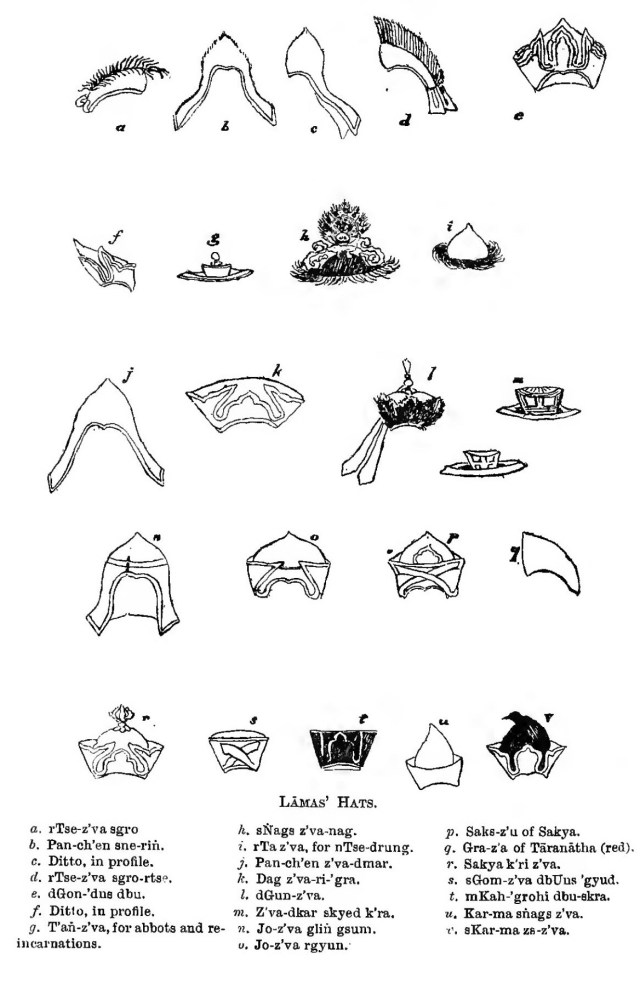
down to the waist. The abbots were given shorter tails, and the ordinary monk shorter still, while the novices were deprived altogether of the tails. It can be used when walking and riding.
Padma-sambhava’s mitre-like hat is the ” U-gyan-Pandit,” the typical hat of the unreformed Ñiṅ-ma sect. It is on the same Indian model, with the lappets turned up, and divided so as to suggest the idea of a red lotus, with reference to the etymology of St. Padmasambhava’s name, to wit, ” The Lotus- born,” and his legendary birth from a red lotus-flower. His native country was Udyana, between Afghanistan and Kashmīr ; and the tall conical crown is still a feature of the caps of those regions. It is also called the Sahor (Lahore ?) Pandit’s cap. It is worn by the Ñiṅ-ma sect in empowering (abisheka), and in offering oblations, and in sacred dances. The largest form of this hat, surmounted by a golden vajra, is called the ” Devil subduer ” (dreg-pa zil-non gyi cha lugs), and is figured in the foregoing- picture of St. Padma. It is only worn by the head Lāmas when giving the king holy water, and at the highest festivals.
Many of the hats are full of symbolism, as, for example, Figs, a and d, as described in the footnote. 1
1 rTse-zwa sgro-lugs (Fig. a). This helmet-like hat is common to all Ge-lug-pa Lāmas. It was invented by (gZ’i-bdag ne-ser, and adopted by the first Grand Lāma GedenDub. It is used along with the cope (zla-gam) when going to mass, and is taken off on entering the temple and thrown over the left shoulder, with the tails hanging down in front ; on emerging from the temple it is worn or not according to the monk’s own wishes. Its long tails are stitched to imitate the beaded covers of a book, so that when the monk grasps the tails, he is to conceive that he has a grasp of the scriptures ; and again that he is drawing to salvation thousands of animals represented by the pile on the cap. The three lateral stitches in the tails typify the three classes of scriptures — the Tripitaka, as well as the three original sins or ” fires ” and the sin of body, speech and mind, for which the Tripitaka are the antidotes. The long tails also have to suggest to him that the doctrines may be extended and long remain. The marginal stitches represent ” the twelve best commands.” The inside is often white to suggest that the monk should keep his heart clean and pure. The crest represents the doctrinal insight (lta-wa, Skt., darṣana) of the wearer. As he rises by taking a degree in divinity his crest is elevated by an extra stitch.
rTse-zwa sked-bts’em differs from the foregoing in having an extra stitch in its crest (see p. 172). It is confined to the re-embodied mts’an- ñid Lāmas and those who have taken the degree of dge-s’e, or B.D.
rTse-ewa sgro rts’e has the highest crest. It is confined to the dGe- bskul of De-pung monastic university and the degree of D.D).
rTse-zwa sgro-rtse-ma (Fig. d) is confined to the Dalai Lāma’s chapel-royal of rTse-j-Nam-gyal, and to the four Lings. It is worn during the gtor-rgyab sacrifices and dances at these temples only.
dGongs ‘dus zwa zur-zur (Figs, e and f ). Designed by Pan-ch’en bLo- bzsaṅ ch’os-kyi rgyal mts’an after the shape of dBen-dgon hill. It is worn by the Grand Pan-ch’en Lāma and the four abbots of Tashi-lhunpo on going to preside at the wrangling disputations.
Pan-zwa sne-rid’ ser-po (Figs, b and c). This is a yellow variety of the red one of the same name, with the tails much lengthened by Tsoṅ K’apa. It is only worn with these long tails by the Dalai Lāma, the Pan-ch’en (Tashi) Lāma, the Gah-ldan Khri-rinpo-ch’e, and the Tibetan Lāma-king or regent, during the assembly (ñal-k’u) mass and empowering. It is worn with the gos-ber robes.
sNe-rin zur zwa is worn by the abbots of the colleges and the head Lāmas of smaller monasteries.
T’aṅ -zwa dbyar-zwa (Fig. g) is the summer hat when riding on horse-back, and is confined to the Dalai and Pan-ch’en Grand Lāmas, the regent, or king, and the re-embodied Lāmas, and those abbots who, having obtained highest honours in divinity, have received from the Grand Lāma the diploma of bdag-rkyen.
rTa-zwa zur ltas dgun-zwa. This is the winter riding hat, and is confined to the above privileged persons.
Se-teb-rgyun zwa (Fig. o). The summer riding hat for the Tse-drung grade of Lāmas, who are selected on account of their learning and good looks as personal attendants of the Grand Lāma (sKyabs-mgon ch’en).
rTa zwa rgyun-zwa (Fig. i). The winter riding hat of the Tse-drung.
rTse-drung sga-p’ug is used only by the skyabs-myou ch’en-mo in ascending and descending (? Potala hill).
Zwa-dkar skyid-ka (Fig. m). “Worn by the Tse-drung attendants in summer when accompanying the Grand Lāma wearing preceding hat.
Jo-zwa-glin-gsum (Fig. n), ” the lord’s hat of the three continents.” It is formed after the fashion of the Asura cave, and was worn by the Indian Jo-wo (Atīṣa), the reformer of Lāmaism, while on his way to Tibet, at the Nepalese shrine Svayambhun āth (T., Rang-‘byuṅ) Chaitya ; afterwards it was the hat of his sect, the Kah-dam-pa. In hot weather its flaps are folded up, and in the cold let down. It was originally red, but changed to yellow by the Ge-lug-pa. Now it is worn only by the hermits (ri-k’rod-pa) of the Ge-lug-pa or established church, and is never worn within the monastery or in quarters.
Sa-skya K’ri-zwa (Fig. r). This hat of the Sa-kya sect is of later introduction. Originally all the Sa-kya Lāmas wore the Urgyen-pen-zwa of the unreformed party. When they attained the temporal lordship over the thirteen provinces of Tibet, the Chinese king “Se-ch’en” presented
this hat to the chief of the sect, his highness ‘Phag-pa Rin-po-ch’e, and its central vajra upon the “unchangeable ” crown is after the Chinese style. It is restricted to those of noble descent (gdung-pa), and is only worn when the gduṅ-brgynd Lāma ascends the throne, or in empowering devotees, or in the gTov rgyab sacrificial offering. Cf. also p. 57.
Sa-zu mt’oh grol (Fig. p). This is a hat of the Sa-kya-pa. It is believed to confer spiritual insight, and to have been invented by the God of Wisdom (Mañjuṣṛi). It is used when empowering the Khri-pa, and for mass.
Sa-skya grwa-zwa (Fig. q.) This is the hat of the Jonaṅ -pa sub-sect, to which Tāranātha belonged. It is worn by the junior Sa-kya monks during certain masses, at the beginning and the end, also in religious dances and in the Tor-gya sacrifice.
Karma-pal zwa nag(Fig. t). ” The black (fairy) hat of the Kar-ma-pa.” This hat was conferred upon the reverend Rang-‘byuh rDorje (Vajra Svayambhu) by the five classes of witches (Ḍākkinī) when he coerced them into granting him the Siddhi — power of flying in the air. Each of the Ḍākkinī s contributed a hair from their tresses, and plaited these to form this hat. Whoever wears it can fly through the air. It is kept as a relic at Sa-kya monastery, and only worn in state, or when a wealthy votary comes to the shrine. On such occasions a monk on either side holds the hat to prevent it from carrying off the wearer.
Karma snags-zwa (Fig. u). “The enchanter’s hat” of the K-arma- pa sect. It is shaped after the cake-oftering for the angry demons, and is worn during the dances and the grtor-rgyab sacrifice.
Dwag-zwa ri-‘gra (Fig. k). A hat of the Kar-gyu-pa sect, worn when empowering or preaching. It is shaped after the hill of Dwag-lha sgam-pa, and was invented by mÑam-med-diwag-po lha rjes-ts’eriṅ-ma.
sṄags paī zwa nag (Fig. h). The black necromancer’s hat. Worn by the sLob-dpan Lāma of the unreformed sect in their gTor-rgyab sacrifice, and in the mystic play in all the sects.
gZah-zwa (Fig. v). ” The planet hat.” This raven-crowned hat was designed by Lāma Gyun-ston-k’ro-rgyal on seeing the planet Mercury. It is worn by the Di-kung-pa, Kar-rna-pa, and Niṅ-ma-pa sects during the ceremony of “circling the planets ” (gzaī -bskor) and the striking and injuring one’s enemy (mt’u).
The hat of the Grand Lāma of Bhutan (head of the southern Dug-pa church), and figured at page 226, is called pad-ma-mt’ong or “the lotus-vision.” It has a vajra-spikelet which cannot be worn by any but the supreme Lāma. And the hat is finely embroidered with the cross-thunderbolts, lotus-flower, and thunder dragons (Dug).
1 rTse-zwa sgro-lugs (Fig. a). This helmet-like hat is common to all Ge-lug-pa Lāmas. It was invented by (gZ’i-bdag ne-ser, and adopted by the first Grand Lāma GedenDub. It is used along with the cope (zla-gam) when going to mass, and is taken off on entering the temple and thrown over the left shoulder, with the tails hanging down in front ; on emerging from the temple it is worn or not according to the monk’s own wishes. Its long tails are stitched to imitate the beaded covers of a book, so that when the monk grasps the tails, he is to conceive that he has a grasp of the scriptures ; and again that he is drawing to salvation thousands of animals represented by the pile on the cap. The three lateral stitches in the tails typify the three classes of scriptures — the Tripitaka, as well as the three original sins or ” fires ” and the sin of body, speech and mind, for which the Tripitaka are the antidotes. The long tails also have to suggest to him that the doctrines may be extended and long remain. The marginal stitches represent ” the twelve best commands.” The inside is often white to suggest that the monk should keep his heart clean and pure. The crest represents the doctrinal insight (lta-wa, Skt., darṣana) of the wearer. As he rises by taking a degree in divinity his crest is elevated by an extra stitch.
rTse-zwa sked-bts’em differs from the foregoing in having an extra stitch in its crest (see p. 172). It is confined to the re-embodied mts’an- ñid Lāmas and those who have taken the degree of dge-s’e, or B.D.
rTse-ewa sgro rts’e has the highest crest. It is confined to the dGe- bskul of De-pung monastic university and the degree of D.D).
rTse-zwa sgro-rtse-ma (Fig. d) is confined to the Dalai Lāma’s chapel-royal of rTse-j-Nam-gyal, and to the four Lings. It is worn during the gtor-rgyab sacrifices and dances at these temples only.
dGongs ‘dus zwa zur-zur (Figs, e and f ). Designed by Pan-ch’en bLo- bzsaṅ ch’os-kyi rgyal mts’an after the shape of dBen-dgon hill. It is worn by the Grand Pan-ch’en Lāma and the four abbots of Tashi-lhunpo on going to preside at the wrangling disputations.
Pan-zwa sne-rid’ ser-po (Figs, b and c). This is a yellow variety of the red one of the same name, with the tails much lengthened by Tsoṅ K’apa. It is only worn with these long tails by the Dalai Lāma, the Pan-ch’en (Tashi) Lāma, the Gah-ldan Khri-rinpo-ch’e, and the Tibetan Lāma-king or regent, during the assembly (ñal-k’u) mass and empowering. It is worn with the gos-ber robes.
sNe-rin zur zwa is worn by the abbots of the colleges and the head Lāmas of smaller monasteries.
T’aṅ -zwa dbyar-zwa (Fig. g) is the summer hat when riding on horse-back, and is confined to the Dalai and Pan-ch’en Grand Lāmas, the regent, or king, and the re-embodied Lāmas, and those abbots who, having obtained highest honours in divinity, have received from the Grand Lāma the diploma of bdag-rkyen.
rTa-zwa zur ltas dgun-zwa. This is the winter riding hat, and is confined to the above privileged persons.
Se-teb-rgyun zwa (Fig. o). The summer riding hat for the Tse-drung grade of Lāmas, who are selected on account of their learning and good looks as personal attendants of the Grand Lāma (sKyabs-mgon ch’en).
rTa zwa rgyun-zwa (Fig. i). The winter riding hat of the Tse-drung.
rTse-drung sga-p’ug is used only by the skyabs-myou ch’en-mo in ascending and descending (? Potala hill).
Zwa-dkar skyid-ka (Fig. m). “Worn by the Tse-drung attendants in summer when accompanying the Grand Lāma wearing preceding hat.
Jo-zwa-glin-gsum (Fig. n), ” the lord’s hat of the three continents.” It is formed after the fashion of the Asura cave, and was worn by the Indian Jo-wo (Atīṣa), the reformer of Lāmaism, while on his way to Tibet, at the Nepalese shrine Svayambhun āth (T., Rang-‘byuṅ) Chaitya ; afterwards it was the hat of his sect, the Kah-dam-pa. In hot weather its flaps are folded up, and in the cold let down. It was originally red, but changed to yellow by the Ge-lug-pa. Now it is worn only by the hermits (ri-k’rod-pa) of the Ge-lug-pa or established church, and is never worn within the monastery or in quarters.
Sa-skya K’ri-zwa (Fig. r). This hat of the Sa-kya sect is of later introduction. Originally all the Sa-kya Lāmas wore the Urgyen-pen-zwa of the unreformed party. When they attained the temporal lordship over the thirteen provinces of Tibet, the Chinese king “Se-ch’en” presented
this hat to the chief of the sect, his highness ‘Phag-pa Rin-po-ch’e, and its central vajra upon the “unchangeable ” crown is after the Chinese style. It is restricted to those of noble descent (gdung-pa), and is only worn when the gduṅ-brgynd Lāma ascends the throne, or in empowering devotees, or in the gTov rgyab sacrificial offering. Cf. also p. 57.
Sa-zu mt’oh grol (Fig. p). This is a hat of the Sa-kya-pa. It is believed to confer spiritual insight, and to have been invented by the God of Wisdom (Mañjuṣṛi). It is used when empowering the Khri-pa, and for mass.
Sa-skya grwa-zwa (Fig. q.) This is the hat of the Jonaṅ -pa sub-sect, to which Tāranātha belonged. It is worn by the junior Sa-kya monks during certain masses, at the beginning and the end, also in religious dances and in the Tor-gya sacrifice.
Karma-pal zwa nag(Fig. t). ” The black (fairy) hat of the Kar-ma-pa.” This hat was conferred upon the reverend Rang-‘byuh rDorje (Vajra Svayambhu) by the five classes of witches (Ḍākkinī) when he coerced them into granting him the Siddhi — power of flying in the air. Each of the Ḍākkinī s contributed a hair from their tresses, and plaited these to form this hat. Whoever wears it can fly through the air. It is kept as a relic at Sa-kya monastery, and only worn in state, or when a wealthy votary comes to the shrine. On such occasions a monk on either side holds the hat to prevent it from carrying off the wearer.
Karma snags-zwa (Fig. u). “The enchanter’s hat” of the K-arma- pa sect. It is shaped after the cake-oftering for the angry demons, and is worn during the dances and the grtor-rgyab sacrifice.
Dwag-zwa ri-‘gra (Fig. k). A hat of the Kar-gyu-pa sect, worn when empowering or preaching. It is shaped after the hill of Dwag-lha sgam-pa, and was invented by mÑam-med-diwag-po lha rjes-ts’eriṅ-ma.
sṄags paī zwa nag (Fig. h). The black necromancer’s hat. Worn by the sLob-dpan Lāma of the unreformed sect in their gTor-rgyab sacrifice, and in the mystic play in all the sects.
gZah-zwa (Fig. v). ” The planet hat.” This raven-crowned hat was designed by Lāma Gyun-ston-k’ro-rgyal on seeing the planet Mercury. It is worn by the Di-kung-pa, Kar-rna-pa, and Niṅ-ma-pa sects during the ceremony of “circling the planets ” (gzaī -bskor) and the striking and injuring one’s enemy (mt’u).
The hat of the Grand Lāma of Bhutan (head of the southern Dug-pa church), and figured at page 226, is called pad-ma-mt’ong or “the lotus-vision.” It has a vajra-spikelet which cannot be worn by any but the supreme Lāma. And the hat is finely embroidered with the cross-thunderbolts, lotus-flower, and thunder dragons (Dug).
Nuns wear a skull-cap of woollen cloth or fur, coloured yellow or red, according to their sect.
In the outer rainy districts of the Himalayas, in Bhutan and Sikhim, many Lāmas wear straw hats during the summer, or go bare-headed.
The Tibetans follow the Chinese in the practice of saluting by taking off their hat, so in their temples no hats are worn except during certain ceremonies, and then only a special kind.
THE ROBES.
The robes, which the monks of the established church and the more celibate monks of the other sects wear during certain celebrations, are the three vestments of the shape prescribed in the primitive code of ritual, the Vinaya, with the addition of a brocaded collared under-vest 1 and trousers, as seen in the figures.
The material of these robes is usually woollen cloth ; but silk, though against the precepts, 2 is sometimes worn by those who can afford the expense.
The colour of these robes is yellow or red, according to the sect. Yellow or saffron 3 colour in Tibet is sacred to the clergy of the established church, the Ge-lug-pa ; and its use by others is penal. The only instance in which it is permitted is when a layman is bringing a present to the Ge-lug-pa priests. He then is permitted to wear during his visit a flat yellow hat like a Tam-o’-Shanter bonnet. These three orthodox Buddhist raiments are : —
1. The Lower patched robe, named “?z’ān” 4 ( = Sanghāṭi). The cloth is in several largish patches (about twenty-three) and sewn into seven divisions, and fastened by a girdle at the waist. 5
1 stod ‘jag. 2 In common with most ascetics, Buddha decreed the monastic dress of his order to be of as frugal a material and cost as possible, and the colour selected was sad saffron, which, while affording a useful wearable colour not readily soiled, gave uniformity to the wearer and afforded no scope for worldly vanity in fine dress. Yet nothing can be more dignified and becoming than the thin loose robe of the Buddhist monk, falling in graceful drapery, endlessly altering its elegant folds with every movement of the figure. And the ease with which it lends itself to artistic arrangement is seen not only in the Grecian and Indian sculptures of Buddha in a standing-posture, but is even retained somewhat in the thicker and relatively unelegant robes of the Lāmaist monk, seen in the several figures. 3 Literally ṅur-smrig or “Brāhmani goose ” (coloured). This sad-coloured bird, the ruddy shell-drake, has from its solitary habits and conjugal fidelity been long in India symbolic of recluseship and devotion, and figures in such capacity on the capitals of the Aṣoka pillars. 4 gz’an or ? dras-drubs. 5 The patched robe, which gives the idea of the tattered garments of poverty, is stated to have originated with Ananda dividing into thirty pieces the rich robe given to Buddha by the wealthy physician Jīvaka, and that robe was sewn by Ananda into five divisions like this one.
2. The Outer patched robe, named Nam-jar (P., ? Antarvāsaka). The cloth is cut into very numerous pieces, about one hundred and twenty-five, which are sewn together in twenty-five
divisions.
3. The Upper shawl, named bLd-gos (Uttarāsanghāṭi) . Long and narrow, ten to twenty feet long and two to three feet broad. It is thrown over the left shoulder and passed under right arm, leaving the right shoulder bare, as in the Indian style, but the shoulders and chest are covered by an inner vest. It is adjusted all round the body, covering both shoulders, on entering the houses of laymen. And over all is thrown a plaited cloak or cope, crescentic in shape. 1
But the ordinary lower robe of Lāmas of all sects is an ample plaited petticoat, named ” S’am t’abs,” 2 of a deep garnet-red colour, which encircles the figure from the waist to the ankles, and is fastened at the waist by a girdle, and with this is worn an unsleeved vest, open in front like a deacon’s dalmatia. On less ceremonial occasions a sleeved waistcoat is used ; and when travel- ling or visiting, is worn the ordinary Tibetan wide-sleeved red gown, gathered at the waist by a girdle ; and always trousers. The
sleeves of this mantle are broad and long,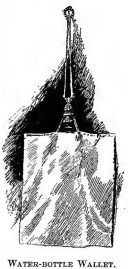
and in hot weather, or on other occasions
where greater freedom is wanted or the priest
has to administer with bare arms, the arms
are withdrawn from the sleeves, which latter then hang loose.
A sash is also usually worn, several yards long and
about three inches broad, thrown over the left shoulder,
across breast, and tied in a bow over the right hip, and the remainder swung round the body. 3 Thus it will be seen that Lāmas of every sect, the established church included, ordinarily wear red robes, and it is the colour of the girdles (sKe-rag) and the shape and colour of the hats which are the chief distinctive badges of the
1 zla-gam. 2 or mt’an-gos. 3 Koppen, ii., 268.
sect, The holy-water bottle (Ch’ab-lug), figured on page 201, which hangs from the left side of the girdle, is also fringed by a flap of cloth coloured red or yellow according to the sect,
The boots are of stiff red and particoloured felt, with soles of hide or Yak-hair.
From the girdle hangs, in addition to the holy-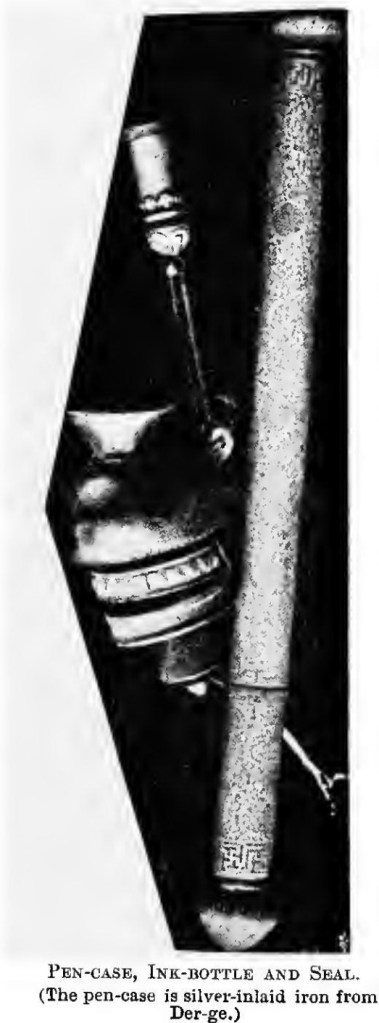
water bottle, a pen-case, purse, with condiments,
dice, etc., sometimes the rosary, when it is not in
use or worn on the neck or
wrist, and the amulet box. And in
the upper flap of the coat, forming a
breast pocket, are thrust his prayer-
wheel, drinking-cup, booklets,
charms, etc.
The dress of the nuns generally
resembles that of the monks. The
head is shaved, and no ornaments are worn. 1
THE ROSARIES.
The rosary is an essential part of
a Lāma’s dress ; and taking, as it
does, such a prominent part in the
Lāmaist ritual, it is remarkable that
the Tibetan rosary does not appear to have attracted particular notice.
As a Buddhist article the rosary appears only in the latest ritualistic stage when a belief had arisen in the potency of muttering mystic spells and other strange formulas. In the very complicated rosaries of Japan 2 it has attained its highest development. Amongst southern Buddhists 3 the rosary is not very conspicuous
1 Cf. Boyle, Mark., p. 109. 2 “Note on Buddhist Rosaries in Japan.” By J. M. James, Trans. Jap. As. Soc, p. 173, 1881. 3 I have described Burmese Buddhist rosaries, as well as some of the Lāmaist, in J. A. S. B., 1891.
but amongst Tibetans it is everywhere visible. It is also held in the hand of the image of the patron god of Tibet — Cha-ra-si (Skt., Avalokiteṣvara). And its use is not confined to the Lāmas. Nearly every lay man and woman is possessed of a rosary, on which at every opportunity they zealously store up merit ; and they also use it for secular purposes, 1 like the sliding balls of the Chinese to assist in ordinary calculations : the beads to the right
called ta-thaṅ and regis-
tering units, while those
to the left are called c’u-
do and record tens, which
numbers suffice for their
ordinary wants.
The Tibetan name for
the rosary is ” ‘pren-ba” .
pronounced t’eṅ -wa, or
vulgarly t’eṅ –ṅ a, and
literally means “a string
of beads.”The rosary contains
108 beads of uniform
size. The reason for this
special number is alleged to be merely a provision to ensure the repetition of the sacred spell a full hundred times, and the extra beads are added to make up for any omission of beads through absent-mindedness during the telling process or for actual loss of beads by breakage.
Che-re-si and Do-ma have each 108
1 The rosary has proved a useful instrument in the hands of our Lāma surveying spies. Thus we find it reported with reference to Gyantse town, that a stone wall nearly two-and-a-half miles goes round the town, and the Lāma estimated its length by means of his rosary at 4,500 paces. At each pace he dropped a bead and uttered the mystic ” Om mam padm hm,” while the good people who accompanied him in his Lin-k’or or religious perambulations little suspected the nature of the work he was really doing.
names, but it is not usual to tell these on the rosary. And in the later Kham editions of the Lāmaic scriptures — the ” bkā- ‘gyur,” — the volumes have been extended from 100 to 108, And the Burmese foot-prints of Buddha sometimes contain 108 sub-divisions. This number is perhaps borrowed, like so many other Lāmaist fashions, from the Hindūs, of whom the Vaishnabs possess a rosary with 108 beads.
The two ends of the string of beads, before being knotted, are passed through three extra beads, the centre one of which is the largest. These are collectively called ” retaining or seizing beads,” rdog-‘dsin. The word is sometimes spelt mdo-‘dsin, which means ” the union holder.” In either case the meaning is much the same. These beads keep the proper rosary beads in position and indicate to the teller the completion of a cycle of beads.
This triad of beads symbolizes ” the Three Holy Ones ” of the Buddhist trinity, viz., Buddha, Dharma (the Word), and Sangha (the church, excluding the laity). The large central bead represents Buddha, while the smaller one intervening between it and the rosary beads proper represents the church and is called ” Our radical Lāma ” (or spiritual adviser), 1 the personal Lāma-guide and confessor of the Tibetan Buddhist ; and his symbolic presence on the rosary immediately at the end of the bead-cycle is to ensure becoming gravity and care in the act of telling the beads, as if he were actually present.
The Grelug-pa, or established church, usually has only two beads as dok-dsin, in which case the terminal one is of much smaller size, and the pair are considered emblematic of a vase from which the beads spring. In such cases the extra bead is sometimes strung with the other beads of the rosary, which latter then contains 109 beads; thus showing that the beads really number 111.
Counters.
Attached to the rosary is a pair of strings of ten small pendant metallic rings as counters. One of these strings is terminated by a miniature dorje (the thunderbolt of Indra) and the other by a small bell — in Tantric Buddhist figures the dorje is ususlly associated with a bell. The counters on the dorje-string register units
1 tsa-waī bla-ma.
of bead-cycles, while those on the bell-string mark tens of cycles. The counters and the ornaments of the strings are usually of silver, and inlaid with turquoise. These two strings of counters, called ” count-keepers,” 1 may be attached at any part of the rosary string, but are usually attached at the eighth and twenty-first bead on either side of the central bead.
They are used in the following manner : When about to tell the beads, the counters on each string are slid up the string. On completing a circle of the beads, the lowest counter on the dorje– string is slid down into contact with the dorje. And on each further cycle of beads being told, a further counter is slid down. When the ten have been exhausted, they are then slid up again, and one counter is slipped down from the bell-string. The counters thus serve to register the utterance of 108 x 10 x 10 = 10,800 prayers or mystic formulas. The number of these formulas daily repeated in this way is enormous. The average daily number of repetitions may, in the earlier stages of a Lāma’s career, amount to 5,000, but it depends somewhat on the zeal and leisure of the individual. A layman may repeat daily about five to twenty bead-cycles, but usually less. Old women are especially pious in this way, many telling over twenty bead-cycles daily. A middle-aged Lāma friend of mine has repeated the spell of his tutelary deity alone over 2,000,000 times. It is not uncommon to find rosaries so worn away by the friction of so much handling that originally globular beads have become cylindrical.
Affixed to the rosary are small odds and ends, such as a metal toothpick, tweezer, small keys, etc.
Material of the Beads.
The materials of which the Lāmaist rosaries are composed may to a certain extent vary in costliness according to the wealth of the wearer. The abbot of a large and wealthy monastery may have rosaries of pearl and other precious stones, and even of gold. Turner relates 2 that the Grand Tāshi Lāma possessed rosaries of pearls, emeralds, rubies, sapphires, coral, amber, crystal and lapis-lazuli.
1 grang-‘dsin, but vulgarly they are known as chub-she (c’u-bs’ad) or “the ten makers.” 2 Embassy to Tibet, p. 261, 1800.
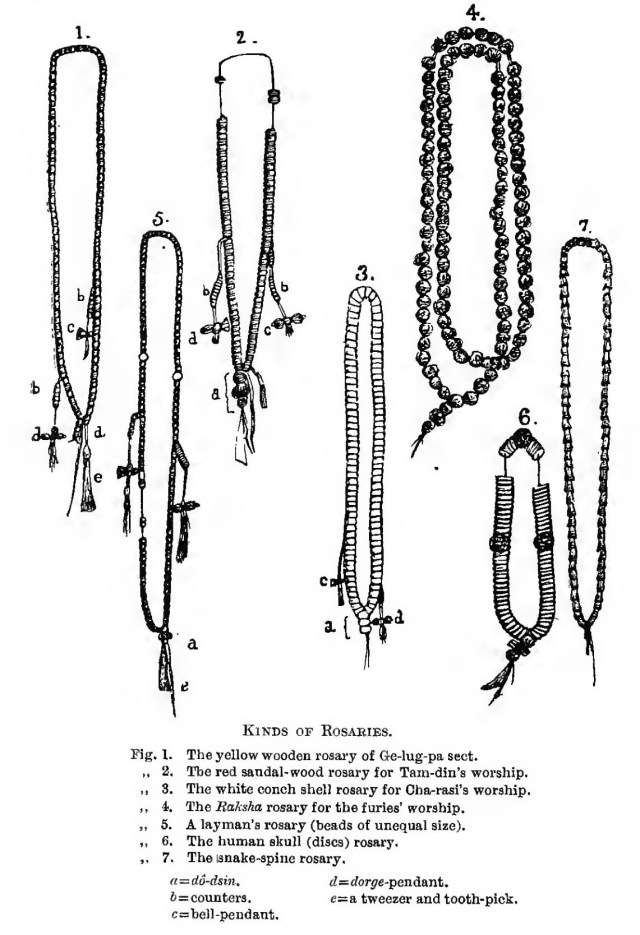 But the material of the rosary can only vary within rather narrow limits, its nature being determined by the particular sect to which the Lāma belongs and the particular deity to whom worship is to be paid.
But the material of the rosary can only vary within rather narrow limits, its nature being determined by the particular sect to which the Lāma belongs and the particular deity to whom worship is to be paid.
Kinds of Rosaries.
Fig. 1. The yellow wooden rosary of Ge-lug-pa sect.
„ 2. The red sandal- wood rosary for Tam-din’s worship.
,, 3. The white conch shell rosary for Cha-rasi’s worship.
,, 4. The Raksha rosary for the furies’ worship.
,, 5. A layman’s rosary (beads of unequal size).
„ 6. The human skull (discs) rosary.
,. 7. The snake-spine rosary.
a = do-dsin. b = counters. c=bell-pendant. d=dorge-pendant. E a tweezer and tooth-pick.
Kinds of Rosaries.
The yellow rosary or Ser-t’eṅ, Fig. 1 , is the special rosary of the Ge-lug-pa or ” reformed school,” also called ” the yellow hat sect ” (S’ā-ser). The beads are formed from the ochrey yellow wood of the C’aṅ-ch’ub tree, literally ” the Bodhi tree ” or tree of supreme wisdom, which is said to grow in central China. The wood is so deeply yellow that it is doubtful whether it be really that of the Pīpal (Ficus religiosa), of which was the Bodhi tree under which Gautama attained his Buddhahood. These beads are manufactured wholesale by machinery at the temple called by Tibetans Ri-wo tse-ṅa and by the Chinese U-tha Shan, or ” The Five Peaks,” about 200 miles south-west of Pekin. Hue gives a sketch 1 of this romantic place, but makes no mention of its rosaries. This rosary is of two kinds, viz., the usual form of spherical beads about the size of a pea, and a less common form of lozenge-shaped perforated discs about the size of a sixpence. This rosary may be used for all kinds of worship, including that of the furies.
The Bo-dhi-tse rosary is the one chiefly in use among the Ñiṅ-ma-pa, or ” old (i.e., unreformed) school ” of Lāmas, also called the S’a-mar or ” red-hat sect.” It is remarkable that its name also seeks to associate it with the Bodhi tree, but its beads are certainly not derived from the Ficus family. Its beads are the rough brown seeds of a tree which grows in the outer Himalayas. This rosary can be used for all kinds of worship, and may also be used by the Ge-luk-pa in the worship of the fiercer deities.
The white conch-shell rosary Tuṅ-t’eṅ, 2 Fig. 3, consists of cylindrical perforated discs of the conch shell, and is specially used in the worship of Avalokita — the usual form of whose image holds a white rosary in the upper right hand. This is the special rosary of nuns.
The rosary of plain crystal or uncoloured glass beads is also peculiar to Avalokita.
The red sandal-wood rosary Tsan-dan-mar, Fig. 2, consists of perforated discs of red sandal-wood (Adenanthera pavonina) or
1 Travels in Tartary, Tibet, and China. By M. HUC (Hazlitt’s trans.), i., p. 79, and figured under Shrines. 2 Druṅ-p’reṅ.
other wood of a similar appearance. It is used only in the worship of the fierce deity Tam-din (Skt., Hayagrīva), a special protector of Lāmaism.
The coral rosary — Ch’i-ru-t’eṅ — is also used for the tutelary fiend, Tam-din, and by the unreformed sects for their wizard-saint Padma-sambhava. Coral being so expensive, red beads of glass or composition are in general use instead. With this rosary it is usual to have the counters of turquoise or blue beads.
The rosary formed of discs of the human skull — the t’od-teṅ, Fig. 6 — is especially used for the worship of the fearful tutelary fiend Vajra-bhairava as the slayer of the king of the Dead. It is usually inserted within the Bo-dhi-tse or other ordinary rosary ; and it frequently has its discs symmetrically divided by four large Raksha beads into four series, one of these beads forming the central bead. There is no rosary formed of finger-bones, as has been sometimes stated.
The ” elephant-stone ” rosary — Laṅ-ch’en-grod-pa — is prepared from a porous bony-like concretion, which is sometimes found in the stomach (or brain) of the elephant. As it is suggestive of bone, it is used in worship of Yama. The real material being extremely scarce and expensive, a substitute is usually found in beads made from the fibrous root of the bow-bambu (Z’u-shin), which shows on section a structure very like the stomach-stone, and its name also means ” stomach or digestion ” as well as ” bow.”
The Raksha rosary, Fig. 4, formed of the large brown warty seeds of the Elaeocarpus Janitrus, is specially used by the Ñiṅ-ma Lāmas in the worship of the fierce deities and demons. The seeds of this tree are normally five-lobed and ridged, and it is interesting from a botanical point of view to find how relatively frequent is the occurrence of six lobes. Such abnormal seeds are highly prized by the Tibetans, who believe them to be the offspring of some seeds of Padma-sambhava’s rosary, which, the legend states, broke at his Halashi hermitage in Nepal, and several of the detached beads remaining unpicked up, these were the parents of the six-lobed seeds. The demand for such uncommon seeds being great, it is astonishing how many of them are forthcoming to diligent search. This rosary is also commonly used by the indigenous Bon-po priests, and it is identical with the rosary of the Hindūs — the rudraksha (Rudra’s or the fierce god Siva’s eyes, with reference to their red colour), from which the Tibetan name of Raksha is apparently derived.
The Naṅ-ga pā-ni rosary is used only for the worship of Namsra, or Vaiṣravana, the god of wealth ; and by the wizards in their mystical incantations. It consists of glossy jet-black nuts about the size of a hazel, but of the shape of small horse chestnuts. These are the seeds of the Luṅ-t’aṅ tree which grows in the sub-tropical forests of the S.E. Himalayas. They are emblematic of the eyes of the Garuḍa bird, a henchman of Vajra-paṇi (a form of Jupiter) and the great enemy of snakes, and hence is supposed to be derived the Sanskritic name of the beads, from nāga, a serpent. Its use in the worship of the god of wealth is interesting in associating snakes, as the mythological guardians of treasure, with the idea of wealth. 1
The rosary of snake-spines (vertebrae), Fig. 7, is only used by the sorcerers in necromancy and divination. The string contains about fifty vertebrae.
The complexion of the god or goddess to be worshipped also determines sometimes the colour of the rosary-beads. Thus a turquoise rosary is occasionally used in the worship of the popular goddess Tārā, who is of a bluish-green complexion. A red rosary with red Tam-din, a yellow with yellow Mañjuṣṛi ; and Vaiṣravan, who is of a golden-yellow colour, is worshipped with an amber- rosary.
The rosaries of the laity are composed of any sort of bead according to the taste and wealth of the owner. They are mostly glass beads of various colours, and the same rosary contains beads of a variety of sizes and colours interspersed with coral, amber, turquoise, etc. The number of beads is the same as with the Lāmas, but each of the counter-strings is usually terminated by a vajra: both strings record only units of cycles, which suffice for the smaller amount of bead-telling done by the laity.
Mode of telling the Beads.
When not in use the rosary is wound round the right wrist like a bracelet, as in figure on page 172, or worn around the neck with the knotted end uppermost.
1 See p. 368.
The act of telling the beads is called taṅ-c’e, which literally means “to purr” like a cat, and the muttering of the prayers is rather suggestive of this sound.
In telling the beads the right hand is passed through the rosary, which is allowed to hang freely down with the knotted end upwards. The hand, with the thumb upwards, is then usually carried to the breast and held there stationary during the recital. On pronouncing the initial word “Om” the first bead resting on the knuckle is grasped by raising the thumb and quickly depressing its tip to seize the bead against the outer part of the second joint of the index finger. During the rest of the sentence the bead, still grasped between the thumb and index finger, is gently revolved to the right, and on conclusion of the sentence is dropped down the palm-side of the string. Then with another “Om” the next bead is seized and treated in like manner, and so on throughout the circle.
On concluding each cycle of the beads, it is usual to finger each of the three “keeper-beads,” saying respectively, “Om !” “Ah!” “Hūṃ ‘,”
The mystic formulas for the beads have already been illustrated. They follow the prayer, properly so-called, and are believed to contain the essence of the formal prayer, and to act as powerful spells. They are of a Sanskritic nature, usually containing the name of the deity addressed, and even when not gibberish, as they generally are, they are more or less unintelligible to the worshipper.
The formula used at any particular time varies according to the particular deity being worshipped. But the one most frequently used by the individual Lāma is that of his own tutelary deity, which varies according to the sect to which the Lāma belongs.
The other articles of equipment comprise, amongst other things, a prayer-wheel, vajra-sceptre and bell, skull-drum and smaller tambour, amulet, booklets. Some, even of the higher Lāmas wear ornaments and jewellery. 1
1 The Grand Lāma of Tashi-lhunpo wore a jewelled necklace, which he presented to Mr. Bogle (MARKH., cxl.)
MENDICANT’S STAFF.
A few possess a begging-bowl and the mendicant’s staff, 1 but these are mostly for ritualistic displays, as the Lāma is no longer a mendicant monk living on alms like the Indian Bhikshu of old.
1 Khar-sil ; Skt., the onomatopoetic hi-ki-le or kha-kha-reann, the alarm-staff with jingling rings carried by the mendicant monk to drown out by its jingling worldly sounds from the ears of the monk and to warn off small animals lest they be trod upon and killed. Its use is explained in Kāh-gyur Do, Vol. xxvi., CSOMA, An., p. 479. The Tibetan form is usually tipped by a trident in place of the leaf-like loop.
DAILY LIFE AND ROUTINE.
He who eats Lāmas’ food -Wants iron jaws. “ — Tibetan Proverb. 1
Although the Lāmas are enslaved in the bonds of ritual they are not all gloomy ascetics, wrapped up in contemplation, but most can be as blithe as their lay brothers. Their heavy round of observances, however, often lies wearily upon them, as may be seen from the frequent interruptions in the ordinary Lāma’s saintly flow of rhetoric to yawn, or take part in some passing conversation on mundane matters.
The daily routine of a Lāma differs somewhat according to whether he is living in a monastery, or as a village priest apart from his cloister, or as a hermit. As with
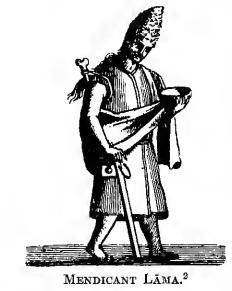 occidental friars, a considerable
occidental friars, a considerable
proportion of Lāmas have trades and
handicrafts, labouring diligently in
the field, farm, and in the lower
valleys in the forest. But scarcely
ever is he a mendicant monk, like his prototype the Indian Bhikshu of old.
The routine in the convents of the established church is seen at its best in the Grand Lāma’s private monastery or chapel-royal of Namgyal, on mount Potala, near Lhāsa, and I am indebted to one of the monks
1 dkor zas sa-la lchag-gi pram-pa dgos 2 After Giorgi.
of that monastery for the following detailed account of the practice followed there.
Routine in a Monastery of the Established Church.
Immediately on waking, the monk 1 must rise from his couch, even though it be midnight, and bow thrice before the altar in his cell, saying, with full and distinct enunciation : ” Guide of great pity ! hear me ! merciful Guide ! Enable me to keep the two hundred and fifty-three rules, including abstinence from singing, dancing, and music, and thoughts of worldly wealth, eating luxuriously, or taking that which has not been given,” etc., etc.
Then follows this prayer 2 : “0 Buddhas and Bodhisattvas of the ten directions, hear my humble prayer. I am a pure-minded monk, and my earnest desire is to devote myself towards benefiting the animals; and having consecrated my body and wealth to virtue, I vow that my chief aim will be to benefit all living things.”
Then is repeated seven times the following mantra from the Sutra on ”the wheel-blessing for the animal universe” 3 : “ Om! Sambhara, Sammahā jaba hūṃ ! ” Followed also seven times by this extract from bharabi manaskar mahā jaba hūṃ ! Om ! Smara Smarabi manaskara Norbu-r gyas-pahi-gzhal-med-k’aṅ : “Om! ruci ramini pravartya hūṃ.”
This is followed by ” Om ! Khrecara gaṇaya hri hri svaha ! ” — a spell which if the monk thrice repeats and spits on the sole of his foot, all the animals which die under his feet during that day will be born as gods in the paradise of Indra (Jupiter).
Having done this worship, the monk may retire again to sleep if the night is not far advanced. If, however, the dawn is near he must not sleep but employ the interval in repeating several mantras or forms of prayer (smon-lam) until the bell rings for the first assembly.
The first assembly, or matin, called ” the early gathering ” (sna-tsogs), is held before sunrise. The great bell goes and awakens everyone hitherto slumbering, and it is soon followed by the great conch-shell trumpet-call, on which signal the monks adjust their
1 I have translated by “monk” the word dge-sloṅ, which is literally “the virtuous beggar,” corresponding to the Indian Buddhist word Bhikshu, or mendicant. 2 Composed by m’as-grub-ṅag-dbaṅ-rdorje. 3 ‘gro-wa-yongs-su-bsngo-wai-‘khor-loi-mdo.
dress and go outside their cell or dormitory to the lavatory stone-flag or pavement (rdo-bchal) for ablution.
Standing on these stones, and before washing, each monk chants the following mantra, and mentally conceives that all his sins, as well as the impurities of his body, are being washed away : ” Oml arghaṃ tsarghaṃ bimanase! utsusma mahā krodh hūmphat !”
Then with water brought in copper vessels, and with a pinch of saline earth as soap, 1 they perform ablutions usually of a very partial kind.
After ablution each monk repeats, rosary in hand, the mantra of his favourite deity (usually Mañjuṣṛi or Tārā), or his tutelary fiend, as many times as possible.
On the second blast of the conch-shell, about fifteen minutes after the first, all the fully-ordained monks bow down before the door of the temple, while the novices bow upon the outer paved court. All then enter the temple and take their places according to their grade, the most junior being nearest the door; and during the ingress the provost -marshal stands rod in hand beside the door.
The monks seat themselves in rows, each on his own mat, cross-legged in Buddha-fashion, and taking care not to allow his feet to project, or his upper vestments to touch the mat. They sit in solemn silence, facing straight to the front. The slightest breach of these rules is promptly punished by the rod of the provost- marshal, or in the case of the novices by the clerical sacristan.
At the third blast of the conch-trumpet the following services are chanted : —
Invoking the blessing of eloquence; the refuge-formula; Tson-
K’apa’s ritual of lha-brgya-ma.
After which tea is served, but before it is drunk the presiding
Lāma says a grace in which all join.
LĀMAIST GRACES BEFORE MEAT.
The Lāmas always say grace before food or drink. Most of these graces are curiously blended with demonolatry, though they always are pervaded by universal charity and other truly Buddhist principles.
1 This earth is called sug-pa, but the higher Lāmas use soap : “The Lāma minister of the Grand Lāma,” say’s Sarat’s narrative, ” formerly used to wash his holiness’s head with water and sug-pa powder, but now he uses a cake of Pear ‘s transparent soap.”
And they throw some light on the later Mahāyāna ritual of Indian Buddhism, from which they are alleged to have been borrowed.
Before drinking, the Lāmas, like the Romans, pour out some of the beverage as a libation to their Lares, and other gods. A common
grace before drinking tea (which is served out eight or ten times daily at the temples and cathedrals — the service being interrupted for this temporal refreshment) is :—
” We humbly beseech thee ! that we and our relatives throughout all our life-cycles, may never be separated from the three holy ones ! May the blessing of the trinity enter into this drink ! ” [ Then, here sprinkling a few drops on the ground with the tips of the fore and middle fingers, the grace is continued : —
“To all the dread locality, demons of this country, we offer this good Chinese tea ! Let us obtain our wishes ! And may the doctrines of Buddha be extended ! ”
The grace before food of the established church, the purest of all the Lāmaist sects, is as follows: —
“This luscious food 1 of a hundred tempting tastes, is here reverently offered by us — the animal beings— to the Jinas (the Dhyāni Buddhas) and their princely sons (celestial Bodhisattvas). May rich blessings overspread this food ! Om-Ah Hūṃ!
” It is offered to the Lāma— Om Guru vajra naividya-ah Hūṃ!
“It is offered to all the Buddhas and Bodhisattvas— Om sa’rva Buddha Bodhisattva vajra naividya-ah Hūṃ !
“it is offered to the tutelaries, witches, and defensores fidei 2—Om Deva Dakini Sri dharmapāla saparivāra vajra naividya-ah Hūṃ !
“One piece (is offered) to the powerful demon -lord (dbaṅ -bahi-‘byuṅ -po;Skt., Bhūtesvara)—Om-Agra-Pinda-ashi bhya svahā !
” One piece to h prog-ma — Om-Harite 3 – svahā !
” One piece to ‘ the five hundred brothers or sisters ‘ 4 — Om Harite maha-vajra- yakshini hara-hara sarva papi-mokshi svahā !
“This food, of little virtue, is offered compassionately and without anger or pride, or as a return for past favours ; but solely in the hope that we — all the animal beings — may become holy and attain the rank of the most perfect Buddhahood.”
When any flesh-meat is in the diet, then the following grace is repeated seven times in order to cleanse from the sin of slaughter and of eating flesh: ” Om abira Jche-ca-ra Hūṃ !” And by the efficacy of this spell, the animal, whose flesh is eaten, will be reborn in heaven.
The following grace is for the special benefit of the donors of provisions, tea, etc., to the monastery, and it is repeated before the monks partake of food so gifted : —
” Salutation to the all-victorious Tathagata Arhat. The most perfect Buddha. The fiery and most illuminating king of precious light ! Namo ! Samanta-prabhā -rāgāya Tathāgatāya Arhate samayak- Buddhāya Namo Mañjuṣṛi-ye. Kumāra-Bkutāya Bodhisattvaya maha-sattvaya ! Tadyathā ! Om
1 Z’a\-zas. 2 Yidam /«K’ah-gro ch’os-*kyon. 3 This is the celebrated man-eating Yakshini fiendess, with the 500 children, whose youngest and most beloved son, Pingala, was hid away by Buddha (or, as some Lāmas say, by his chief disciple, Maudgalyayana) in his begging-bowl until she promised to cease cannibalism, and accept the Buddhist doctrine as detailed in the Ratnakūta Sūtra. See also the Japanese version of this legend, footnote p. 99. The Lāmas assert that Buddha also promised Hariti that the monks of his order would hereafter feed both herself and her sons : hence their introduction into this grace ; and each Lāma daily leaves on his plate a handful of his food expressly for these demons, and these leavings are ceremoniously gathered and thrown down outside the monastery gate to these pretas and other starveling demons. 4 The children of the above Hariti.
ralambhe-nira-bhase jaye-jayelabdhe mahā-materakshinamme parisodhāyā
svahā. (The efficacy of reciting this mantra is thus described, says the Ge-lug-pa manual of daily worship, in the Vinaya- Sutra : “When this is repeated once all sins will be cleansed, and the dispensers of the gifts will have their desires fulfilled.” Then here follow with : — )
” May I attain bliss by virtue of this gift !
” May I attain bliss by deep meditation, the ceremonial rites, reverence and the offerings !
“May I attain perfect bliss and the supreme perfection of the real end (Nirvāṇa) !
” May I obtain the food of meditation of the hundred tastes, power, and brightness of countenance by virtue of this food-offering !
“May I obtain rebirths of wisdom, void of thirst, hunger, and disease, by virtue of this repentance-offering !
” May I obtain unalloyed happiness, free from worldly birth, old age, disease, and death !
” May the dispenser of these gifts attain perfection by virtue of these, his liberal gifts !
“May the human beings and all the other animals, obtain deliverance by virtue of this vast offering !
” May all the Buddhists, Nanda, Upananda. etc., the gods of the natural dwelling, the king, this dispenser of gifts, and the populace generally, obtain everlasting happiness, long life, and freedom from disease.
” May all the human beings, by virtue of this (gift), obtain luck in body and fore-knowledge.
” May the hopes of animals be realized as by the wish-granting gem (Cintāmaṇi) and the wish-granting tree (Kalpataru), and may glory come on all ! mangalam ! ”
After the tea-refreshment, the following services are performed : The Great Compassionators liturgy, the praise of the disciples or Sthaviras, the offering of the magic-circle or maṇḍala, though the great circle is not offered every day, Yon-ten-zhi-gyurma, and the worship of the awful Bhairava, or other tutelary, such as Saṅdus, Dem-ch’og, or Tārā. But as these latter liturgies are very long, they are interrupted for further tea-refreshment. And at this stage, that is, in the interval between the first and second portions of the tutelary’s worship, is done any sacerdotal service needed on account of the laity, such as masses for the sick, or for the soul of a deceased person. In the latter case it is publicly announced that a person, named so-and-so, died on such a date, and his relatives have given tea and such-and-such present, in kind or money, to the Lāmas for masses. Then the Lāmas do the service for sending the soul to the western paradise. 1 Or, if the service is for a sick person, they will do the Ku-rim 2 ceremony.
The tutelary’s service is then resumed, and on its conclusion tea and soup are served. Then is chanted the S’es-rab sñiṅ-po, after which the assembly closes, and the monks file out singly,
first from the extreme right bench, then from the extreme left, the youngest going first, and the most senior of the re-incarnated saintly Lāmas last of all.
1 See chapter on worship. 2 Not phonetic for ” cure him.”
The monks now retire to their cells, where they do their private devotions, and offer food to their tutelary deities ;
often marking the time to be 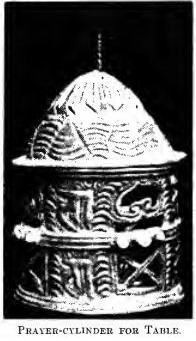 occupied by particular devotional exercises by twirling with the finger and
occupied by particular devotional exercises by twirling with the finger and
thumb their table-prayer-wheel, and
while it spins, the exercise lasts.
The orisons are chanted to the
clamour of noisy instruments when-
ever the sun’s disc is first seen in
the morning. Then the hat is
doffed, and the monk, facing the
sun, and uplifting his right hand to
a saluting posture, chants ” It has
arisen ! It has arisen ! The glorious
one has arisen ! The sun of happiness
has arisen ! The goddess Marīcī
has arisen ! Om- Marīcīnāṃ svā-hā ! ”
On repeating this mantra of .
Marīcī seven times, he continues
with: “Whenever I recall your name
I am protected from all fear. I pray Prayer-cylinder for Table
for the attainment of the great stainless bliss.
I salute you, goddess Marīcī ! Bless me, and fulfil my desires. Protect me, Goddess, from all the eight fears of foes, robbers, wild beasts, snakes, and poisons, weapons, firewater, and high precipices.”
The second assembly, called “the After-heat” (t’sa-gtiṅ) is held about 1 9 a.m., when the sun’s heat is felt. On the first blast of the conch all retire to the latrine. At the second blast all gather on the pavement, or, if raining, retire to a covered court to read, etc. At the third blast — about fifteen minutes after the
1 Time is only known approximately,as it is usually, as the name for hour (ch’u- ts’al) implies, kept by water-clocks (See ” C’u-ts’al,” Ramsay’s Dict., -p. 63), and also by the burning of tapers. second — all re-assemble in the temple and perform the service of ” Inviting the religious guardian (-fiend).” During this worship tea is thrice served, and on its conclusion the monks all leave the temple. The younger monks now pore over their lessons, and receive instructions from their teachers.
The third assembly, called ” Noon-tide,” is held at noon. On the first blast of the conch all prepare for the sitting. At the second they assemble on the pavement, and at the third they enter the temple and perform the worship of ” bS’ags-pa ” and ” bSkaṅ- wa,” during which tea is served thrice, and the meeting dissolves.
Each monk now retires to his cell or room, and discarding his boots, offers sacrifice to his favourite deities, arranging the first part of the rice-offering with scrupulous cleanliness, impressing it with the four marks, and surrounding it with four pieces bearing the impress of the four fingers. After this he recites the ” Praise of the three holy ones.” 1
Then lay servants bring to the cells a meal consisting of tea, meat, and pāk (a cake of wheat or tsam-pa). Of this food, some must be left as a gift to the hungry manes, Hariti and her sons. The fragments for this purpose are carefully collected by the servants and thrown outside the temple buildings, where they are consumed by dogs and birds. The monks are now free to perform any personal business which they have to do.
The fourth assembly, called ” First (after-) noon tea ” (dguṅ- ja-daṅ-po) is held about 3 p.m. The monks, summoned by three blasts of the conch as before, perform a service somewhat similar to that at the third assembly, and offer cakes and praise to the gods and divine defenders, during which tea is thrice served, and the assembly dissolves.
Then the junior monks revise their lessons, and the pār-pa or middle-grade monks are instructed in rhetoric and in sounding the cymbals and horns. And occasionally public wranglings as already described are held on set themes to stimulate theological proficiency.
The fifth assembly or vesper, called ” The Second (after-) noon tea ” is held about 7 p.m. The conch, as formerly, calls thrice to the temple, where is chanted the worship of Taṅ-rak and the prayers of glory (bkra-shis), during which tea is given thrice, and the assembly dissolves. After this the monks return to their rooms till the second night bell sounds, when the junior monks repeat from memory before their teachers certain scriptures and other texts ; and at the third bell all retire to their cells to sleep
ROUTINE IN AN UNREFORMED MONASTERY.
The routine in the monasteries of the unreformed or Ñiṅ-ma sects departs considerably from the high standard above described, and introduces more demonolatry and the worship of the deified wizard Guru Padma-sambhava.
The practice followed at Pemiongchi monastry is here
described : —
In the morning, after offering the sacred food, incense, and butter-incense, a conch-shell is blown, on which all the monks must come out of their chambers. On the second blast all collect in the great assembly hall, and during this entry into the hall the provost-marshal stands beside the door with his rod in hand. All the monks seat themselves in Buddha-fashion, as before described. The slightest breach of the rules of etiquette and discipline is promptly punished by the rod of the provost-marshal, or, in the case of the younger novices, by the sacristan.
When all have been properly seated, then two or three of the most inferior novices who have not passed their examination, and who occupy back seats, rise up and serve out tea to the assembly, as already described, each monk producing from his breast pocket his own cup, and having it filled up by these novices.
The service of tea is succeeded by soup, named gSol-jam t’ugpa, and served by a new set of the novice underlings. When the cups are filled, the precentor, joined by all the monks, chants “the Sacrificial Offering of the Soup.” Three or four cups of soup are supplied to each monk. The hall is then swept by junior monks.
The precentor then inspects the magic circle 1 to see that it is correct, and, this ascertained, he commences the celebration, consisting of the sNon-‘gro and the refuge-formula, and Las-sbyah, on the conclusion of which the assembly disperses.
1 No layman is allowed to serve out the monks’ food in the temple. The lay servants bring it to the outside door of the building, and there deposit it.
About 8 A.M. the conch-shell blast again summons the monks to the assembly hall, where, after partaking of refreshments of tea and parched grain in the manner already described, a full celebration is done. And on its conclusion the monks disperse.
About 10 a.m. a Chinese drum is beaten to muster the monks in the assembly hall. At this meeting rice and meat and vegetables are served out as before, and with this is also served beer called gSos-rgyab, the ” food-sacrifice ” (lTo-mch’od) being done as formerly. A full celebration is then performed, and the meeting dissolves.
In the afternoon a conch-shell is blown for tea, and a Chinese gong calls for beer, the monks assembling as before, and doing a full celebration of the worship of the lord (demon) Mahākālā and the guardians of religion respectively.
When sacerdotal celebrations on behalf of laymen have to be done, such are introduced within the latter celebration, which is interrupted for this purpose. And after each of these extra celebrations the monks remain outside the assembly hall for a very short time and then re-assemble. On finishing the extra services, the worship of the religious guardians is then resumed and concluded.
In the evening another assembly, preceded by tea as refreshment, conducts the celebration of sKaṅ -shags with one hundred and eight lamps.
Another and final assembly for the day is made by beat of drum, and rice and flesh-meat is served out.
The refreshments and meals usually number nine daily.
LIFE AS A VILLAGE PRIEST.
The monk, immediately on waking, must rise from his couch, even though it be midnight, and commence to chant the Mi-rtak- rgyud-bskul, taking care to pronounce all the words fully and distinctly. This contains the instructions of his special Lāma-preceptor, and in its recital the monk must recall vividly to mind his spiritual guide. This is followed by a prayer consisting of
numerous requests for benefits of a temporal nature desired by the petitioner.
Then he assumes the meditative posture of the seven attitudes, 1 and gets rid by physical means of the ” three original sins.”
Then, coercing his tutelary demon into conferring on him his fiendish guise, he chants ” the four preliminary services ” : —
The sNon-gro hzi-byor. These are the refuge formula, which cleanses the darkness of the body ; the hundred letters, which cleanse all obscurity in speech, and the magic-circle of rice, the Maṇḍala, which cleanses the mind ; and the prayer enumerating the Lāmas up to the
most perfect one, which confers perfection on the monk himself.
This is followed by the chanting of bLa-grub, “the obtaining of the Lāma,” and ” the obtaining of the ornaments, sÑen-grub.”
The mild deity in this worship is called ” The Placid One,” 2 and the demon ” The Repulsive.” 3 The demoniacal form must be recited the full number of times which the Lāma bound himself to do by vow before his spiritual tutor, namely, one hundred, one thousand, or ten thousand times daily. Those not bound in this way by vows repeat the charm as many times as they conveniently can.
Having done this, he may retire again to sleep, if the night be not very far advanced. But if the dawn is near, he must not go to sleep, but should employ the interval in several sorts of prayer.
As soon as day dawns, he must wash his face and rinse his mouth and do the worship above noted, should he not have already done so ; also the following rites : —
1st. Prepare sacred food for the six sorts of beings (Rigs-strug-gi-gtorma) and send it to tantalized ghosts.
2nd. Offer incense, butter-incense, and wine-oblation (gSer-sKyem). The incense is offered to the good spirits — firstly, to the chief god and the Lāma; secondly, to the class of ” king” gods; and thirdly to the mountain god ” Kanchinjinga.” Then offerings are made to the spirits
of caves (who guarded and still guard the hidden revelations therein deposited), the ” enemy-god of battle,” the country gods, the local demigods, and ” the eight classes of deities.” The butter-incense is only given to the most malignant class of the demons and evil spirits.
Some breakfast is now taken, consisting of weak soup, followed by tea with parched grain. Any especial work which has to be done will now be attended to, failing which some tantrik or other
1 See p. 145. 2 mt’un. 3 bzle-pa.
service will be chanted. And if any temple or Caitya be at hand, these will be circumambulated with ” prayer-wheel ” revolving in hand, and chanting mantras. Then is done any priestly service required by the villagers.
About two o’clock in the afternoon a meal of rice is taken followed by beer by those who like it, or by tea for non-beer drinkers.
About six o’clock p.m. is done the gtor-bsṅos service, in which, after assuming his tutelary dignity, he chants the sṅon-gro and refuge formula. Then is done a sacrificial worship 1 with bell and small drum, followed by an invocation to the hosts of Lāmas, tutelaries, and the supernatural defensores fidei. About 9 or 10 p.m. he retires to sleep.
IN HERMITAGE.
Buddhism in common with most religions had its hermits who retired like John the Baptist into the wilderness. And such
Hermit-Lāma.:
periodical retirement for a time, corresponding to the Buddhist Lent (the rainy season of India, or Varsha, colloq. ” barsat “), when travelling was difficult and unhealthy, was an essential part of the routine of the Indian Buddhist. Tsoṅ K’apa enforced the observance of this practice, but it has now fallen much into abeyance. –
1 mCh’oga. 2 After Huc.
Probably the booths which are erected for the head Lāmas in Sikhim during their visits to villages in the autumn, are vestiges of this ancient practice of retirement to the forest.
Theoretically it is part of the training of every young Lāma to spend in hermitage a period of three years, three months, and three days, in order to accustom himself to ascetic rites. But this practice is very rarely observed for any period, and when it is observed, a period of three months and three days is considered sufficient, During this seclusion he repeats the spell of his tutelary deity an incredible number of times. The Mūla-yoga sṅgon-gro, complete in all its four sections, must be repeated 100,000 times. In chanting the refuge-formula portion, he must prostrate himself to the ground 100,000 times. The repetition of the Yige-
brgya-pa itself takes about two months ; and in addition must be chanted the following voluminous services : P’yi-‘grub, naṅ-‘grub, gsaṅ-‘grub, bla-‘grub, sñen-grub, ‘prin-las, and bzi-‘grub. Those who permanently adopt the hermit life are called ” the packed-up ones ” 1 and those of the highest rank are ” the great recluses.” 2 They are engaged in ascetic exercises and are usually followers of the Vajrāyāna system, seeking Siddhi and its wizard powers by the aid of the Ḍākkinī she-devils and the king-devils who are their tutelaries.
TRADES AND OCCUPATIONS.
Like western friars, the Lāmas have a considerable proportion of their number engaged in trades and handicrafts. The monks are practically divided into what may be called the spiritual and the temporal. The more intelligent are relieved of the drudgery of worldly work and devote themselves to ritual and meditation. The less intellectual labour diligently in field or farm and in trading for the benefit of their monastery ; or they collect the rents and travel from village to village begging for their parent monastery, or as tailors, cobblers, printers, etc. Others again of the more intellectual members are engaged as astrologers in casting- horoscopes, as painters or in image-making, and in other pursuits contributing to the general funds and comfort of the monastery.
1 mts’am-s-pa, – sgom-ch’en.
THE DIET.
The diet of the Lāmas is the ordinary rather Spartan fare of the country 1 consisting mainly of wheat, barley, or buck-wheat and occasionally rice, milk and butter, soup, tea and meat. The
only flesh-meat allowed is sheep, goat, and yak ; fish and fowl are prohibited. The fully-ordained monks, the Ge-longs, are supposed to eat abstemiously and abstain totally from meat ; though even the Grand Lāma of Tashi-lhunpo appears to eat flesh-food.’ 2
Neither the monks of the established church nor the holier Lāmas of the other sects may drink any spirituous liquor. Yet they offer it as libations to the devils.
1 For food of Tibetans, see TURNER’s Embassy, 24-48, etc.; PEMBERTON, 156; Moorcroft, i., 182, etc. ; HUC, ii., 258; Cunningham’s Ladak, 305; Rock., L., passim. 2 Bogle in Markham, p. 100.
A Grand Lāma of Bhutan
THE HIERARCHY AND RE-INCARNATE LĀMAS.
” Le roi est mort, vive le roi ! “
” Adam . . . his soul passed by transmigration into David …his soul transmigrated into the Messiah.” — The Talmud.1
EARLY Buddhism had neither church nor ecclesiastical organization. It was merely a brotherhood of monks. Even after Buddha’s death, as the order grew in size and afflueuce under the rich endowments from Aṣoka and other kingly patrons, it still remained free from anything like centralized government.
1 HERSHON’s Treasures of the Talmud, p. 242.
The so-called patriarchs had only very nominal power and no generally recognized position or functions. And even the later Indian monasteries had each its own separate administration, and its own chief, independent of the others; a similar state of affairs seems to have prevailed in Tibet until the thirteenth century.
The hierarchical system of Tibet seems to date from the thirteenth century CE., when the Lāma of the Sas-kya monastery was created a pope by the Great Mongol emperor of China, Kubilai Khan. This Sas-kya Lāma, receiving also a certain amount of temporal power, soon formed a hierarchy, and some generations later we find the other sects forming rival hierarchies, which tended to take the power out of the hands of the petty chiefs who now parcelled out Tibet. In 1417, doctor Tsoṅ K’apa founded the Ge-lug-pa sect, which under his powerful organization soon developed into the strongest of all the hierarchies, and five generations later it leapt into the temporal government of Tibet, which it still retains, so that now its church is the established one of the country.
Priest-kingship, a recognized stage in the earlier life of social institutions, still extends into later civilization, as in the case of the emperors of China and Japan, who fill the post of high-priest. It was the same in Burma, and many eastern princes who no longer enjoy ” the divine right of kings,” still bear the title of ” god,” and their wives of ” goddess.”
The Grand Lāma who thus became the priest-king of Tibet was a most ambitious and crafty prelate. He was named Ṅag-waṅ Lo-zaṅ, and was head of the De-pung monastery. At his instigation a Mongol prince from Koko Nor, named Gusri Khan, conquered Tibet in 1640, and then made a present of it to this Grand Lāma, together with the title of Dalai or “the vast” (literally “ocean”) Lāma, 1 and he was confirmed in this title and kingly possession in 1650 by the Chinese emperor. On account of this Mongol title, and these priest-kings being first made familiar to Europeans through the Mongols,’ 2 he and his
1 The Tibetan for this Mongol word is rGya-mts’o, and in the list of Grand Lāmas some of his predecessors and successors bear this title as part of their personal name. And the Mongolian for rin-po-ch’e is “Ertenni.” 2 Through the works of Giorgi, Pallas, and Klaproth.
successors are called by some Europeans ” Dalai (or Tale) Lāma,” though the first Dalai Lāma was really the fifth Grand Lāma of the established church ; but this title is practically unknown to Tibetans, who call the Lhāsa Grand Lāmas, Gryal-wa Rin-po-ch’e, or “The gem of majesty or victory.”
In order to consolidate his new-found rule, and that of his church in the priest-kingship, this prelate, as we have seen, posed as the deity Avalokita-in-the-flesh, and he invented legends magnifying the powers and attributes of that deity, and trans-
Four-Handed Avalokita. (Incarnate in the Dalai Lāma.)
ferred his own residence from De-pung monastery to a palace which he built for himself on ” the red hill ” near Lhāsa, the name of which hill he now altered to Mount Potala, after the mythic Indian residence of his divine prototype. He further forcibly seized many of the monasteries of the other sects and converted them into his own Gre-lug-pa institutions 1 ; and he developed the
1 Amongst others he seized the monastery of the great Tāranātha, and demolished many of that Lāma’s buildings and books, for such an honest historian was not at all to his taste.
fiction of succession by re-incarnate Lāmas, and by divine reflexes. The other sects accepted the situation, as they were indeed forced to do ; and all now, while still retaining each its own separate hierarchical system, acknowledge the Grand Lāma of Lhāsa to be
Potala. The Palace of the Dalai Lāma .(From Kircher’s China Illustrata.)
the head of the Lāmaist church, in that he is the incarnation of the powerful Buddhist deity Avalokita. And they too adopted the attractive theory of the re-incarnate succession and divine reflexes.
It is not easy to get at the real facts regarding the origin and development of the theory of re-incarnate Lāmas, as the whole question has been purposely obscured, so as to give it the appearance of antiquity.
It seems to me that it arose no earlier than the fifteenth century, and that at first it was simply a scheme to secure stability for the succession to the headship of the sect against electioneering intrigues of crafty Lāmas, and was, at first, a simple re-incarnation theory ;which, however, must not be confused with the orthodox Buddhist theory of re-birth as a result of Karma, for the latter is never confined in one channel. On the contrary, it holds that the spirit of the deceased head Lāma is always reborn in a child, who has to be found by oracular signs, and duly installed in the vacant chair; and he on his death is similarly reborn, and so on ad infinitum, thus securing, on quasi-Buddhistic principles, continuous succession by the same individual through successive re-embodiments.
The first authentic instance of re-incarnate Lāmas which I can find is the first of the Grand Lāmas of the Ge-lug-pa, namely, Ge-den- ḍub. Had this theory been invented prior to Tsoṅ K’apa’s death in 1417 A.D., it is practically certain that the succession to Tsoṅ K’apa would have begun with an infant re-incarnation. But we find the infant re-incarnationship only beginning with the death of Tsoṅ K’apa’s successor, namely, his nephew and pupil, Ge-den- ḍub aforementioned ; and from this epoch the succession to the Ge-lug-pa Grand Lāmaship has gone on according to this theory. As the practice worked well, it was soon adopted by the Lāmas of other sects, and it has so extended that now nearly every great monastery has its own re-incarnate Lāma as its chief, and some have several of these amongst their higher officials.
The more developed or expanded theory, however, of celestial Lāma-reflexes, which ascribes the spirit of the original Lāma to an emanation (Nirmāna kāya, or, changeable body) 1 from a particular celestial Buddha or divine Bodhisat, who thus becomes incarnate in the church, seems to me to have been of much later origin, and most probably the invention of the crafty Dalai Lāma Ṅag-waṅ, or Gyal-wa Ṅa-pa, 2 about 150 years later. For, previous to the time when this latter Grand Lāma began to consolidate his newly-acquired temporal rule over Tibet, no authentic records seem to exist of any such celestial origin of any Lāmas, and the theory seems unknown to Indian Buddhism. 3 And this Dalai Lāma is known to have taken the greatest liberties with the traditions and legends of Tibet, twisting them to fit in with his divine pretensions, and to have shaped the Lāmaist hierarchy on the lines on which it now exists.
This Dalai Lāma, Gyal-wa Ṅa-pa, is the first of these celestial incarnate Lāmas which I can find. He was made, or, as I consider, made himself, to be the incarnation of the most popular Buddhist divinity possible, namely, Avalokita, and to the same rank were promoted the four Grand Lāmas who preceded him, and who,
1 Cf. ante. 2 Literally ”The fifth Jina.” Cf. also PAND., H.. No. 46. 3 None of the so-called biographies of Atīṣa and earlier Indian monks containing any such references can certainly be placed earlier than this period.
together with himself, were identified with the most famous king of Tibet, to wit, Sroṅ Tsan Gampo, thus securing the loyalty of the people to his rule, and justifying his exercise of the divine right of kings ; and to ensure prophetic sanction for this scheme he wrote, or caused to be written, the mythical so-called history, Mani kah-‘bum. It was then an easy task to adjust to this theory, with retrospective effect, the bygone and present saints who were now affiliated to one or other of the celestial Buddhas or Bodhisats, as best suited their position and the church. Thus, Tsoṅ K’apa, having been a contemporary of the first Grand Lāma, could not
be Avalokiteṣvara, so he was made to be an incarnation of Mañjuṣṛī, or ” the god of wisdom,” on whom, also, Atīṣa was affiliated as the wisest and most learned of the Indian monks who had visited Tibet; and so also King Thi Sroṅ Detsan, for his aid in founding the order of the Lāmas.
It also seems to me that Ṅa-pa was the author of the re -incarnate Lāma theory as regards Tashi-lhunpo monastery and the so-called double-hierarchy ; for an examination of the positive data on this subject shows that the first re-incarnate Lāma of Tashi-lhunpo dates only from the reign of this Ṅa-pa, and seven years after his accession to the kingship of Tibet.
Tashi-lhunpo monastery was founded in 1445 by Geden-dub, the first Grand Ge-lug-pa Lāma, who seems, however, to have mostly lived and to have died at De-pung.
It will be noticed from the list of Tāshi Grand Lāmas 1 that Geden-dub, the founder of Tashi-lhunpo, contrary to the current opinion of European writers, does not appear as a Tashi Lāma at all. This official list of Tashi-lhunpo, read in the light of the biographies of these Lāmas, 2 clearly shows that previous to the Lāma who is number two of the list, and who was born during the latter end of Dalai Lāma Ṅa-pa’s reign as aforesaid, none of the Tashi-lhunpo Lāmas were regarded as re-incarnations at all. The first on this list, namely, Lo-zaṅ Ch’o-kyi Gyal-ts’an, began as a private monk, and travelled about seeking instruction in the ordinary way, and not until his thirty-first year was he promoted to the abbotship, and then only by election and on
1 Presently to be given. 2 Some of which have been translated by SARAT (J.A.S.B., 1882, 26 seq.).
account of distinguished ability. It is also interesting to note that on the death, in 1614, of the fourth Grand Lāma of the Ge-lug-pa (named Yon- tan), whom he had ordained, he was installed in the abbotship at Gāh-ldan monastery, and in 1622, at the age of 53, he initiated, as fifth Grand Lāma, the infant Ṅa-pa, who was then seven years old, and who afterwards became the great Dalai Lāma.
And he continued to be the spiritual father and close friend and adviser of Ṅa-pa, and seems to have begun those political negotiations which culminated in the cession of Tibet to his protege. When he died, in 1662, his spiritual son Ṅa-pa, who was 47 years old, and had been 22 years in the kingship, promptly re-incarnated him, and also made him out to be his own spiritual father, even as regards the divine emanation theory. Thus the new-born babe was alleged to be an incarnation of Avalokita’s spiritual father, Amitābha, the Buddha of Boundless Light ; and he was given a considerable share in the management of the established church. This, however, merely perpetuated the relations which had actually existed between these two Grand Lāmas as father and son, and which had worked so well, and had such obvious political advantages in providing against interregnums.
In the hierarchical scheme of succession by re-incarnate Lāmas, the Lhāsa Grand Lāma, who wields the sovereign power, thus gave himself the highest place, but allotted the Tashi-lhunpo Grand Lāma a position second only to his own. Below these come the other re-incarnate Lāmas, ranking according to whether they are regarded to be re-embodiments of Indian or of Tibetan saints. The former class are called ” the higher incarnations ” or Tul-Ku, 1 and by the Mongols Khutuktu. They occupy the position of cardinals and archbishops. The lowest re-incarnate Lāmas are regarded as re-embodiments of Tibetan saints, and are named ordinary Tul-ku or ” Ku-s’o,” 2 or by the Mongols Khublighan or Hoblighan ; these mostly fill the post of abbots, and rank one degree higher than an ordinary non-re-incarnate abbot, or K’an-po, who has been selected on account of his proved abilities. Most of
1 sPrul-sku. 2 sKu-s’ogs. The use of the term for a re-incarnate Lāma seems restricted to Ladāk. In Tibet proper this title is applied to any superior Lāma, and is even used in polite society to laymen of position.
these so-called re-incarnate Lāmas are by a polite fiction credited with knowing all the past life and deeds of individuals, not only in the present life, but also in former births.
In the unreformed sects, where the priests are not celibate, the children succeed to the headship. The ordinary hierarchical distinctions of grades and ranks have already been noted in describing the organization of the order.
The greatest of the Lāma hierarchs, after the Grand Lāmas of Lhāsa and Tashi-lhunpo, are the great Mongolian Lāma at Urgya, the Sas-kya Lāma, and the Dharma Rāja of Bhutan, this last being practically independent of Lhāsa, and the temporal ruler of Bhutan. Here also may be mentioned the female incarnate goddess, ” The diamond sow ” of Yam-dok Lake monastery.
The following list of Tibetan popes, the Grand Lāmas of Lhāsa, is taken from the printed list. 1 The birth-dates are given upon the authority of a reliable, trustworthy Lāmaist calculator. 2
List of Grand (Dalai) Lāmas or Popes.
No. Name. Birth. Death. Remarks.
A.D. A.D.
1 dGe-‘dun grub-pa 1391 1475
2 dGe-‘dun rGya-mts’o 1475 1543
3 bSod-nams 1543 1589
4 Yon-tan 1589 (3) 1617
5 Ṅag-dbaṅ blo-bsaṅ rGva-mts’o .- 1617 1682 First ” Dalai.”
6 Ts’aṅs-dbyans rGya-mts’o 1683 (4) 1706 Deposed & murdered.
7 sKal-bzan “” 1708 1758
8 ‘Jam-dpal “” 1758 1805 5
9 Luṅ-rtogs “” 1805 6 1816 Seen by Manning.
10 Ts’ul-K’rims “” 1819 7 1837
11 mK’as-grub “” 1837 1855
12 ‘P’rin-las “” 1856 1874
13 T’ub-bstan “” 1876 Present pope.
The first Grand Lāma, Ge-‘dun-ḍub, was born near Sas-kya, and
1 The modern list precedes the historical names by a series of fifty more or less
mythic personages, headed by Avalokita himself.
2 Lāma S’e-rab Gya-ts’o, of the Ge-lug-pa monastery, Darjiling.
3 DESGODINS {La Miss., etc., p. 218) gives 1588.
4 DESG. gives 1682.
5 Other accounts give 1798, 1803, 1808; cf. also Koppen’s List, i., 235.
6 Desg., and this corresponds with Manning’s account (MARKH., 265).
7 Desg. gives 1815.
not far from the site whereon he afterwards founded Tashi-lhunpo. His successors, up to and inclusive of the fifth, have already been referred to in some detail.
On the deposition and death of the sixth Grand Lāma for licentious living, the Tartar king, Gingkir Khan, appointed to Potala the Lāma of C’ag-poh-ri, named Nagwaṅ Yeshe Gyamtso, into whom the sorcerers alleged that, not the soul but the breath of the former Grand Lāma had passed. It was soon announced, however, that the sixth Grand Lāma was re-born in the town of Lithang as Kal-zaṅ, the son of a quondam monk of De-pung monastery. This child was imprisoned by the Chinese emperor, who had confirmed the nominee of the Tartar king, until the war of 1720, when he invested him with spiritual rule at Lhāsa ; but again, in 1728, deposed him, as he was privy to the murder of the king of Tibet. So he set in his place the Lāma ” Kiesri ” Rim-poch’e, of the Chotin monastery, four days’ journey from Lhāsa. 1
He seems latterly to have returned to power, and during his reign in 1749, the Chinese put his temporal vice-regent to death, when the people flew to arms and massacred the Chinese. 2
The ninth is the only Grand Lāma of Lhāsa ever seen by an Englishman. He was seen by Manning in 1811, while still a child of six years old. Manning relates that : ” The Lāma’s beautiful and interesting face and manner engrossed almost all my attention. He was at that time about seven years old ; had the simple and unaffected manners of a well-educated princely child. His face was, I thought, poetically and affectingly beautiful. He was of a gay and cheerful disposition, his beautiful mouth perpetually unbending into a graceful smile, which illuminated his whole countenance. Sometimes, particularly when he looked at me, his smile almost approached to a gentle laugh. No doubt my grim beard and spectacles somewhat excited his risibility. . . . He enquired whether I had not met with molestations and difficulties on the road,” etc. 3 This child died a few years afterwards, assassinated, it is believed, by the regent, named Si-Fan.
The tenth Grand Lāma also dying during his minority, and suspicions being aroused of foul play on the part of the regent,
1 This latter Lāma was in power at Potala in 1730 on the arrival of Horace Dellapenna, from whose account (Markh., p. 321) most of the latter details have been taken. 2 Ibid., lxv. 3 Ibid., p. 266.
the latter was deposed and banished by the Chinese in 1844, at the instance of the Grand Lāma of Tashi-lhunpo, and a rising of his confederates of the Sera monastery was suppressed. 1
The eleventh also died prematurely before attaining his majority, and is believed to have been poisoned by the regent, the Lāma of Ten-gye-ling. A young Lāma of De-pung, named Ra-deng, 2 was appointed regent, and he banished his predecessor ” Pe-chi,” who had befriended Huc ; but proving unpopular, he had eventually to retire to Pekin, where he died. 3 Pe-chi died about 1869, and was succeeded by the abbot of Gāh-ldan.
The twelfth Grand Lāma was seen in 1866 by one of our Indian secret surveyors, who styles him a child of about thirteen, and describes him as a fair and handsome boy, who, at the reception, was seated on a throne six feet high, attended on either side by two high rank officials, each swaying over the child’s head bundles of peacock feathers. The Grand Lāma himself put three questions to the spy and to each of the other devotees, namely :
” Is your king well ? ” ” Does your country prosper ? ” ” Are you yourself in good health ? ” He died in 1874, and his death is ascribed to poison administered by the regent, the Tengye-ling head Lāma. The thirteenth is still (1894) alive. He was seen in 1882 by Sarat Candra Dās, whose account of him is given elsewhere.
The Tashi-lhunpo Grand Lāmas are considered to be, if possible, holier even than those of Lhāsa, as they are less contaminated with temporal government and worldly politics, and more famous for their learning, hence they are entitled ” The precious great doctor, or Great gem of learning ” (Pan-ch’en Rin-po-ch’e)4 or (Gyal-gon 5 Rin-po-ch’e, or “The precious lordly victor.” The Sa-kya Grand Lāmas had been called ” Pan-ch’en,” or the “Great doctor ” from the twelfth century, but have ceased to hold the
1 HUC, ii., p. 166. This account is disbelieved by .Mr. Mayers, J.R.A .S., iv., 305. 2 rva-sgren, the ” gyal-po Riting ” of the Pandit, p. xxiv. 3 MARKH., xcvii. 4 Pan is a contraction for the Indian ” Pandit,” or learned scholar, and rin-po-ch’e = ratna or gem, or precious, or in Mongolian Irtini or Erdeni, hence he is called by Mongolians ” Pan-ch’en Irtini.” 5 Vulgarly ” gyaṅ-gon.”
title since the era of the Dalai Lāmas, when the established church appropriated it to itself.
The following list of ” Tashi ” Lāmas is taken from that printed at the monastery itself. 1
List of “Tashi’ Grand Lāmas.
No. Name. Birth. Death. Remarks.
A.D. A.D
1 bLo-bzaṅ ch’os-kyi rgyal-mts’an 1569 1662
2 bLo-bzaṅ ye-she dpal bzaṅ-po 1663 1737
3 bLo-bzaṅ dpal-ldan ye-s’es 1738 2 1780 Bogle’s friend,
installed 1743.
4 rJe-bstaṅ pahi ñima 1781 1854 Seen by Turner.
5 rJe-dpal-ldan ch’os-kyi grags-pa) 1854 1882 Died in August.
bstaṅ-pahi dbaṅ p’yug )
6 1883 Installed last week of February, 1888.
The third Tashi Lāma was the friend of Mr. Bogle, who seems to be the only European who had the advantage of close and friendly intercourse with one of the Grand Lāmas. Mr. Bogle gives us a delightful glimpse into the amiable character of this holy man. 3 ” The Lāma was upon his throne, formed of wood carved and gilt, with some cushions about it, upon which he sat cross-legged. He was dressed in a mitre-shaped cap of yellow broad-cloth with long-bars lined with red satin; a yellow cloth jacket, without sleeves ; and a satin mantle of the same colour thrown over his shoulders.
1 The official list is entitled pan-sku-p’ren rim-pa ltar byon-pa-ni, and gives no dates. It ends with No. 3 of my list as above, and extends the list backwards to ten additional names, beginning with the somewhat mythical disciple of Buddha, Su-bhuti ; and including legendary Indian personages as re-incarnations, as -well as the following six Tibetans, the fourth of which is usually held to be the first of the Tashi-lhunpo Grand Lāmas. As, however, Tashi-lhunpo was only built in 1445, only the latter two of this list could be contemporary with it, and as is noted in the text, their biographies show that they were ordinary monks who held no high post, if any at all, at Tashi lhunpo.SUPPLMENTARY LlST OF SO-CALLED PAN-CH’EN GRAND Lāmas.
2. Sa-skya Pandita (1182-1252).
3. gYtin-sto/i rdo-rje dpal (1284-1376).
4. mK’as-sgrub dGe-legs-dpal zang-po (1385-1439).
5. pan-ch’en-bSod-nams p’yogs kyi-glaṅ-po (1439-1505)
6. dben-sa-pa blo-bzaṅ Don-grub (1505-1570).
2 At ” Tashi-tzay,” N.E. of Tashi-lhunpo (M., p. 92).
3 Loc, cit., p. 83.
On one side of him stood his physician with a bundle of perfumed sandal-wood rods burning in his hand ; on the other stood his So-pon Chumbo 1 or cup-bearer. I laid the governor’s presents before him, delivering the letter and pearl necklace into his own hands, together with a white Pelong handkerchief on my own part, according to the custom of the country. He received me in the most engaging manner. I was seated on a high stool covered with a carpet. Plates of boiled mutton, boiled rice, dried fruits, sweet-meats, sugar, bundles of tea, sheeps’ carcasses dried, etc., were set before me and my companion, Mr. Hamilton. The Lāma drank two or three dishes of tea along with us, asked us once or twice to eat, and threw white Pelong handkerchiefs on our necks at retiring.
” After two or three visits, the Lāma used (except on holidays) to receive me without any ceremony, his head uncovered, dressed only in the large red sarong which is worn by all the gylongs, red Bulgar hide boots, a yellow cloth vest with his arms bare, and a piece of yellow cloth thrown around his shoulder. He sat sometimes in a chair, sometimes on a bench covered with tiger skins, and nobody but So-pon Chumbo present. Sometimes he would walk with me about the room, explain to me the pictures, make remarks on the colour of my eyes, etc. For, although venerated as God’s vicegerent through all the eastern countries of Asia, endowed with a portion of omniscience, and with many other divine attributes, he throws aside in conversation all the awful part of his character, accommodates himself to the weakness of
mortals, endeavours to make himself loved rather than feared, and behaves with the greatest affability to everybody, especially to strangers.
” Teshu Lāma is about forty years of age, of low stature, and though not corpulent, rather inclining to be fat. His complexion is fairer than that of most of the Tibetans, and his arms are as white as those of a European ; his hair, which is jet black, is cut very short ; his beard and whiskers never above a month long ; his eyes are small and black. The expression of his countenance is smiling and good-humoured. His father was a Tibetan, his
1 He held, according to Turner (p. 246), the second rank in the court of the Tashi Lāma, and was by birth a Manchu Tartar. He was then only about twenty-two years of age.
mother a near relation of the Rājas of Ladak. From her he learned the Hindūstani language, of which he has a moderate knowledge, and is fond of speaking it. His disposition is open, candid, and generous. He is extremely merry and entertaining in conversation, and tells a pleasant story with a great deal of humour and action. I endeavoured to find out in his character those defects which are inseparable from humanity, but he is so universally beloved that I had no success, and not a man could find in his heart to speak ill of him
” Among the other good qualities which Teshu Lāma possesses is that of charity, and he has plenty of opportunities of exercising it. The country swarms with beggars, and the Lāma entertains besides a number of fakirs (religious mendicants), who resort hither from India. As he speaks their language tolerably well he every day converses with them from his windows, and picks up by this means a knowledge of the different countries and governments of Hindūstan. … He gives them a monthly allowance of tea, butter, and flour, besides money, and often bestows something considerable upon them at their departure. The Gosains who are thus supported at the Lāma’s expense may be in number about one hundred and fifty, besides about thirty Musulman fakirs.
For although the genius of the religion of Muhammad is hostile to that of the Lāma, yet he is possessed of much Christian charity, and is free from those narrow prejudices which, next to ambition and avarice, have opened the most copious source of human misery.” And observing the universal esteem in which the Grand Lāma is held by the monks and people, the looks of veneration mixed with joy with which he is always regarded, Mr. Bogle adds ” one catches affection by sympathy, and I could not help, in some measure, feeling the same emotions with the Lāma’s votaries, 1 and I will confess I never knew a man whose manners pleased me so much, or for whom, upon so short an acquaintance, I had half the heart’s liking.” 2
This Grand Lāma, soon after Bogle’s departure, died of smallpox. He had, in response to the invitation of the Chinese emperor, set out for Pekin, attended by 1,500 troops and followers, and sumptuous provision was made for his comfort during the whole
1 Op. cit., p. 95. 2 p. 133.
of the long journey in Chinese territory. The emperor met him at Sining, several weeks’ march from Pekin, and advanced about forty paces from his throne to receive him, and seated him on the topmost cushion with himself and at his right hand. To the great grief of the empress and the Chinese the Lāma was seized wth small-pox, and died on November 12th, 1780. His body in a golden coffin, was conveyed to the mausoleum at Tashi-lhunpo.1
His successor, while still an infant of about eighteen month, was seen by Captain Turner as the envoy of the British government . This remarkable interview took place at the monastery of Terpaling.2 He found the princely child, then aged eighteen months seated on a throne of silk cushions and hangings about four feet high, with his father and mother standing of the left hand. Having been informed that although unable to speak he could understand, Captain Turner said “that the governor general on receiving the news of his decease in China was overwhelmed with grief and sorrow, and continued to lament his absence from the world until the cloud that had overcast the happiness of this nation was dispelled by his reappearance ……
The governor anxiously wished that he might long continue to illumine the world by his presence, and was hopeful that the friendship which had formerly subsisted between them would not be diminished…….” The infant looked steadfastly at the British envoy, with the appearance of much attention, and nodded with repeated but slow motions of the head, as though he understood every word. He was silent and sedate, his whole attention was directed to the envoy, and he conducted himself with astonishing dignity and decorum. He was one of the handsomest children Captain Turner had ever seen and he grew up to be an able and devout ruler, delighting the Tibetans with his presence for many years, and dying at a good old age.3 He is described by Huc 4 as of fine majestic frame, and astonishing vigour for his advanced age, which was then about sixty.
1 Oriental Repertory, ii.,p. 145 and Markham, p. 208. 2 On the 4th December, 1783. 3 TURNER’s Embassy, etc. The new Tashi Lāma was installed in October, 1784, in the presence of the Dalai Lama, the Chinese Minister or Amban, the Gesub Rimboc’e, and the heads of all the monastery in Tibet, as described by Purangir Gosain, the native agent of the Warren Hastings, M., lxxv. 4 ii., 157.
The Mongolian hierarch at Urgya-Kuren, in the Khalka country, is called ” His holy reverence,” or Je-tsun Dam-pa” 1 and is regarded as an incarnation of the celebrated historian Lāma, Tāranātha, who, it will be remembered, was of the Sa-kya sect, which had identified itself with Mongolian Lāmaism, having introduced the religion there and given the translations of the gospels.
Urgya monastery was doubtless founded by the Sa-kya-pa. However this may be, on the development of the reincarnate Lāma theory, the Khalka 2 Mongols fixed upon Tāranātha as the source of the re-incarnations for their chief hierarch. And the Dalai Lāma, Ṅag-pa, who had climbed into power on the shoulders of the Mongols, had to accept the high position thus accorded to Tāranātha, whom he detested, but he, or one of his early successors, converted the monastery into a Ge-lug-pa institution.
The hierarch, Je-tsun Dam-pa, was the most powerful person in the whole of Mongolia 3 during the reign of the emperor Kang-hi (1662-1723), and had his headquarters at Koukou-Khoton, or ” Blue town,” beyond the bend of the Yellow river, when the Khalkas quarrelled with the Kalmuks or Sleuths and escaped into territory under Chinese protection. The Kalmuks demanded the delivery of Je-tsun Dam-pa and his brother, the prince Tuschetu-Khan, which of course the emperor refused, and sought the mediation of the Dalai Lāma. But the latter, or, rather, his regent (Tis-ri), for he had been defunct for seven years, to the emperor’s surprise, advised the delivering up of these two princes, and such a decision was, perhaps, the first sign to him of the great fraud which was being enacted as Lhāsa. To make matters worse, when
the emperor was warring with the Kalmuks ” he paid a visit to Je-tsun Dam-pa, and owing to some, fancied want of respect on the part of the holy man, one of the emperor’s officers drew his sword and killed him. This violence caused a tumult, and soon afterwards it was announced that Je-tsun Dam-pa had reappeared among the Khalkas, who threatened to avenge his former death. The emperor engaged the diplomatic interposition of the Dalai
1 rJe-btsun-gdam-pa. 2 The Khalkas, so called after the Khalka river, are the representatives of the Mongol or Yuen dynasty of China, founded by Jingis and Kubilai Khan, and driven from the throne in 1368. — MARKH., p. xlix. 3 Koppen, ii., 178.
Lāma, who succeeded in pacifying the Khalkas. But it was arranged that the future births of the Je-tsun Dam-pa should be found in Tibet, so that the Khalkas might not again have a sympathizing fellow-countryman as their high-priest.” 1 His ” re-incarnation ” is now always found in central or western Tibet. The present one is said to have been born in the bazaar (S’ol) of Lhāsa city, and to be the eighth of the series. He is educated at the De-pung monastery as a Gre-lug-pa Lāma; but the present one was carried off, when four or five years of age, to Urga, accompanied by a Lāma of De-pung as tutor. A complete list of these hierarchs and fuller historical information in regard to them is much needed. 2
The Sa-kya hierarchs, as we have seen, were once extremely powerful and almost de facto kings of Tibet. Although the Sa-kya hierarch is now eclipsed by the established church, he still retains the sympathy of the numerous adherents of the unreformed sects, and is now regarded by the Ñiṅ -ma-pa as their head and an incarnation of the Gruru himself, and as such scarcely inferior to the Grand Lāma of Lhāsa. Sa-kya was founded, as we saw, by Kungah Ñiṅ -po, born in 1090 , and became famous under Sa-kya Paṇḍita, born 1180, and his nephew was the first of the great hierarchs.
The list of the earlier Sa-kya hierarchs, whose most prosperous era was from 1270 to 1340, is as follows 3 : —
List of SA-KYA HIERARCHS.
1. Sas-kya bsaṅ-po. 12. ‘Od-ser-seṅ-ge.
2. S’aṅ-btsun. 13. Kun-rin.
3. Ban-dKar-po. 14. Don-yod dpal.
4. Chyaṅ-rin bsKyos-pa. 15. Yon-btsun.
5. Kun-gs’aṅ. 16. ‘Od-ser Seṅ-ge II.
6. gS’aṅ-dbaṅ. 17. rGyal-va Saṅ-po.
7. Chaṅ-rdor. 18. Dbaṅ-p’yng-dpal.
8. Aṅ-len. 19. bSod-Nam-dpal.
9. Legs-pa-dpal. 20. rGyab-va-Tsan-po II.
10. Seṅ-ge-dpal. 21. dBaṅ-btsun.
11. ‘Od-zer-dpal.
Its head Lāma is still called by the unreformed Lāmas “Sa-kya
1 Markham’s Tibet, xlix. 2 For an account of the journey of the present hierarch from Lhāsa to Urga, see Peking Gazette for 1874, pp. 68, 74 and 124 (Shanghai abstract 1875). The new incarnation met by the Abbe Huc in 1844, journeying from Urga to Lhāsa appears to have been the seventh. 3 Cf. also list by Sanang Setsen, p. 121 ; Csoma, Gr., 186 ; Koppen, ii., 105 ; Sarat, J.A.S.B., 1881, p. 240.
Pan-ch’en.” 1 The succession is hereditary; but between father and son intervenes the brother of the reigning Lāma and uncle of the successor, so as to secure an adult as holder of the headship.
The Bhotān hierarchy is still a strong one and combines the temporal rule of the country. It ousted all rival sects from the land, so that now it has its own sect, namely, the southern Duk-pa form of the Kar-gyu-pa. According to Mr. (Sir Ashley) Eden, the Bhotānese only overran the country about three centuries ago, displacing the then natives, who are said to have come originally from Koch Bihar. The invaders were Tibetan soldiers, over whom a Lāma named “Dupgani Sheptun” acquired paramount influence as Dharma Rāja. On his death the spirit of the Sheptun became incarnate in a child at Lhāsa, who was conveyed to Bhotan. When this child grew up he appointed a regent for temporal concerns, called Deb Rāja, 2 but this latter office seems to have lapsed long ago, and the temporal power is in the hands of the lay governors (Pen-lo) of the country.
The head Lāma is held to be re-incarnate, and is named Lāma Rin-po-ch’e, also ” The religious king ” or Dharma Rāja. His hat, as seen in the illustration at the head of this chapter, 3 bears the badge of cross thunderbolts, and is surmounted by a spiked thunderbolt, typical not only of his mystical creed, but also of the thunder dragon (Dug), which gives its name to his sect — the Dug-pa. His title, as engraved on his seal figured by Hooker, 4 describes him as ” Chief of the Realm, Defender of the Faith, Equal to Sarasvati in learning, Chief of all the Buddhas, Head Expounder of the Sastras, Caster out of Devils, Most Learned in the Holy Laws, An Avatar of God, Absolver of Sins, and Head of the Best of all Religions.”
List of the Bhutān HIERARCHS.
1. Nag-dbaṅ rnam rgyal bdud ‘jom-rdorje.
2. Nag-dbaṅ ‘jig-med rtags-pa.
3. Nag-dbaṅ ch’os-kyi rgyal mtshan.
4 Nag-dbaṅ ‘jig med dbaṅ po.
5. Nag-dbaṅ Shakya seṅ go.
6. Nag-dbaṅ ‘jam dbyans rgyal mts’an.
7. Nag-dban ch’os kyi dban p’ug.
8. Nag-dbaṅ ‘jig-med rtags-pa (second re-incarnation).
9. Nag-dbaṅ ‘jig-med rtags norbu.
10. Nag-dbaṅ ‘jig-med rtags ch’os-rgyal — the present Great Bhotan Lāma in 1892.
1 He is entitled by Turner (op. cit., p. 315) ” Gongoso Rimbochhe.” 2 Rept. cf. Markh., p. lv. 3 The figure is from a photo of a Bhotān Lāma, and the hat is that of the present (1893) Grand Lāma of Bhotan. 4 Himal. Jours, i.
Each of these Grand Lāmas has a separate biography (or nam- t’ar). The first, who was a contemporary of the Grand Lāma Sonam Gya-tsho, seems to have been married ; the rest are celibate. A celebrated Lāma of this Dug-pa sect was named Mi-pam ch’os-Kyi gyal-po.
The Dharma Rāja resides, at least in summer, at the fort of Ta-shi-ch’o. The palace is a large stone building, with the chief house seven storeys high, described and figured by Turner and others. Here live over five hundred monks.
http://upload.wikimedia.org/wikipedia/commons/3/33/Tashichoedzong-Bhutan-2001.JPG
Bogle describes the Lāma of his day as ” a thin, sickly-looking man of about thirty-five years of age.” 1 He exercises, I am informed, some jurisdiction over Lāmas in Nepal, where his authority is officially recognized by the Gorkha government.
The number of the lesser spiritual chiefs held to be re-embodied Lāma saints is stated 2 to be one hundred and sixty, of which thirty are in Tibet (twelve being “Shaburuṅ “), nineteen in north Mongolia, fifty-seven in south Mongolia, thirty-five in Kokonor, five in Chiamdo and the Tibetan portion of Sze-ch’wan, and fourteen at Pekin. But this much under-estimates the number in Tibet.
Amongst the re-embodied Lāmas in western Tibet or Tsang are Seṅ -c’en-Rin-po-ch’e, 3 Ya ṅzin Lho-pa, Billuṅ, Lo-ch’en, Kyi-zar, Ti ṅki, De-ch’an Alig, Kaṅla, Koṅ (at Phagri). In Kham, Tu, Ch’amdo, Derge, etc.
The Lāmaist metropolitan at Pekin is called by the Tibetans
” lC’aṅ -skya,” and is considered an incarnation of Rol-pahī Dorje. His portrait is given in the annexed figure. He dates his spiritual descent from a dignitary who was called to Pekin during the reign
1 MARKH., p. 27. 2 In the Sheng Wu Ki, and registered by the Colonial Board at Pekin. (Mayer) J.R.A.S., vi., p. 307. 3 The last re-incarnate Lāma bearing this title, and the tutor of the Tashi Grand Lāma, was beheaded about 1886 for harbouring surreptitiously Sarat C. Das, who is regarded as an English spy; and although the bodies of his predecessors were considered divine and are preserved in golden domes at Tashi-lhunpo, his headless trunk was thrown ignominiously into a river to the S.W. of Lhāsa, near the fort where he had been imprisoned. On account of his violent death, and under such circumstances, this re-incarnation is said to have ceased. From the glimpse got of him in Sarat’s narrative and in his great popularity, he seems to have been a most amiable man. of K’ang Hi, probably about 1690-1700 CE., and entrusted with the emperor’s confidence as his religious vicegerent for inner Mongolia. 1
In Ladāk only four monasteries have resident re-incarnate Lāmas or Ku-s’o. Although. they are of the red sect, these head
educated at Lhāsa.
The present (1893)
re-incarnate Lāma of
Spitak, the seventeenth
of the series, is thus de-
scribed by Captain
Ramsay. 2 ” A youth,
26 years of age, who
lately returned from
Lhāsa, where he had
been for 14 years. He
was handsomely dressed
in a robe made of a
particular kind of dark
golden – coloured and
yellow embroidered
China silk, which none
but great personages
are allowed to wear,
and he had on Chinese
long boots, which he Head Lāma of Pekin. :
did not remove when he entered the house. His head and face were closely shaved, and one arm was bare. On entering the room he bowed, and then presented the customary ‘ scarf of
salutation,’ which I accepted. He impressed me very favourably ; his manner and general appearance was superior to anything I had seen among other Lāmas or people of Ladāk.”
In Sikhim, where few Lāmas are celibate and where the Labrang Lāma is the nominal head of the fraternity with the title of ” Lord protector ” (sKyab mGon), the fiction of re-incarnation was only practised in regard to the Pemiongchi and La-brang
1 Z.E. 21, Pand., No. 53. 2 Op.cit., p. 69. 3 After Grunwedel.
monasteries, but has ceased for several generations. In Sikhim, too, the same tendency to priest-kingship cropped out. Several of the Sikhim kings were also Lāmas ; and when the king was not a monk, the Lāmas retained most of the temporal power in their hands ; and the first king of Sikhim was nominated by the pioneer Lāmas ; and the ancestor of the present dynasty, a descendant of the religious king, Thi-Sroṅ Detsan, one of the founders of Lāmaism, was canonized as an incarnation of the Buddhist god, Mañjuṣṛī.
The female re-incarnation, the abbess of the monastery of the Yamdok lake, who is considered an embodiment of the goddess Vajra varāhī, or ” The diamond sow,” is thus described by Mr. Bogle 1 : ” The mother went with me into the apartment of Durjay Paumo, who was attired in a gylong’s dress, her arms bare from the shoulders, and sitting cross-legged upon a low cushion. She is also the daughter of the Lāma’s (Tashi) brother, but by a different wife. She is about seven and twenty, with small Chinese features, delicate, though not regular fine eyes and teeth ; her complexion fair, but wan and sickly ; and an expression of languor and melancholy in her countenance, which I believe is occasioned by the joyless life that she leads. She wears her hair, a privilege granted to no other vestal I have seen ; it is combed back without any ornament, and falls in tresses upon her shoulders. Her Cha-wa (touch),like the Lāmas’, is supposed to convey a blessing, and I did not fail to receive it. Durjay Paumo spoke little. Dr. Hamilton, who cured her of a complaint she had long been subject to, used to be there almost every day.”
Let us now look at the manner in which the new re-embodiments or re-births of the hierarchs are discovered. On the death of a re-incarnate Lāma his spirit is believed to flit into the soul of some unknown infant who is born a few days after the death of the Lāma. The mode of determining the child who has been so favoured is based upon the practice followed in regard to the Grand Lāma of Lhāsa, which we will now describe.
Sometimes the pontiff, before he dies, indicates the particular place and even the family in which he will be re-born, but the usual practice is to ascertain the names of all the likely male
1 Markh., p. 109.
infants who have been born under miraculous portents just after the death of the deceased Lāma, and with prayer and worship to ballot a selected list of names, which are written by a committee of Lāmas on slips of paper and put into a golden jug, and then amid constant prayer, usually by 117 selected pure Lāmas, to draw by lot in relays, and extending over 31 to 71 days, one of these, which is the name of the new incarnation. As, however, the Pekin
Testing a Claimant to the Grand Lāmaship. 1
court is believed to influence the selection under such circumstances, the state oracle of Na-ch’uṅ has latterly superseded the old practice, and the present Grand Lāma was selected by this oracle. Lāma Ugyen Gya-tsho relates 2 that the present Na-ch’uṅ oracle prophesied disaster in the shape of a monster appearing as the Dalai Lāma, if the old practice were continued. On the other hand he foretold that the present Dalai would be found by a pious monk in person, and that his discovery would be accompanied with “horse neighings.” The “pious monk “proved to be the head Lāma of Gāh-ldan monastery, who was sent by the oracle to Chukorgye,
1 After Huc. 2 Loc. cit., para. 59 ; of. also Huc, ii., 197.
where he dreamed that he was to look in the lake called Lha-moi-lamtsho for the future Dalai. He looked, and it is said that, pictured in the bosom of the lake, he saw the infant Dalai Lāma and his parents, with the house where he was born, and that at that instant his horse neighed. Then the monk went in search of the real child, and found him in Kongtoi, in the house of poor but respectable people, and recognized him as the child seen in the lake. After the boy (then a year old) had passed the usual ordeal required of infants to test their power to recognize the property of the previous Dalai Lāma, he was elected as spiritual head of Tibet.
These infant candidates, who, on account of their remarkable intelligence, or certain miraculous signs, 1 have been selected from among the many applicants put forward by parents for this, the highest position in the land, may be born anywhere in Tibet. 2 They are subjected to a solemn test by a court composed of the chief Tibetan re-incarnate Lāmas, the great lay officers of state, and the Chinese minister or Amban. The infants are confronted with a duplicate collection of rosaries, dorjes, etc., and that one particular child who recognizes the properties of the deceased Lāma is believed to be the real re-embodiment.
To ensure accuracy the names are written as aforesaid, and each slip encased in a roll of paste and put in a vase, and, after prayer, they are formally drawn by lot in front of the image of the emperor of China, 3 and the Chinese minister, the Amban, unrolls the paste and reads out the name of the elect, who is then hailed, as the great God Avalokita incarnate, hence to rule over Tibet.
An intimation of the event is sent to the emperor, and it is duly acknowledged by him with much formality, and the enthronement and ordination are all duly recorded in like manner.
Interesting details of the ceremonies as well as of the prominent part played by China in regulating the pontifical succession, have
1 Circumstantial stories are told of such applicants to the effect, that when only a few months old the infants have obtained the power of speech for a few moments and informed their parents that the Lāmas have left Potala to come and claim them.
2 The distant villages of Gada, south-west of Darchhendo (Ta-chhien Lu) and Lithang, have each produced a Dalai Lāma.
3 The emperor Pure Kien Lung, who died 1796, since his final subjugation of Tibet, has continued to receive homage even posthumously as sovereign of the country (Marco P., loc. cit., L., p. 290.)
been supplied by Mr. Mayers 1 from the original Chinese document of Meng Pao, the senior Amban at Lhāsa, and from which the following historic extract is made by way of illustration :—
I. Memorial drawn up on the 9th day of the 12th month of the 20th year of Tao Kwang (January 30th, 1841), reporting that, on instituting an investigation among young children for the embodiment of Dalai Lāma, miraculous signs, of undoubted authenticity, have been verified, which is laid in a respectful memorial before the Sacred Glance.
In the matter of the appearance of the embodiment of the Dalai Lāma, it has already been reported to your majesty that a communication had been received from Ke-le-tan-si-leu-t’u-sa-ma-ti Bakhshi reporting the dispatch of natives in positions of dignity to inquire into the circumstances with reference to four young children born of Tibetan parents, respectively at Sang-ang-k’iuh-tsung in Tibet, the tribalty of K’ung-sa within the jurisdiction of Ta-tsien-lu in Sze-ch’wan, and [two] other places. The chancellor has now made a further report, stating that in the case of each of the four children miraculous signs have been shown, and that bonds of attestation have been drawn up in due form on the part of members of both the priesthood and laity of the Tibetans. He annexes a detailed statement in relation to this matter ; and on receipt of this communication your Majesty’s servants have to observe that on the previous occasion, when the embodiment of the tenth Dalai Lāma entered the world, three children were discovered [whose names] were placed in the urn for decision by lot. As the chancellor now writes that each of the four children discovered by the Khan-pu on this occasion has been attended by auspicious and encouraging omens, we do not presume to arrogate to ourselves the choice of any one of their number, but, as regards the whole four, have on the one hand communicated in a Tibetan dispatch with the chancellor respecting the two children born within the territory of Tibet, and as regards the two children born within the jurisdiction of the province of Sze-ch’wan, have addressed a communication to the viceroy of that province calling upon them respectively to require the parents and tutors of the children in question to bring the latter to Anterior Tibet. On this being done, your majesty’s servants, in accordance with the existing rules, will institute a careful examination in person, conjointly with the Panshen Erdeni and the chancellor, and will call upon the children to recognize articles heretofore in use by the Dalai Lāma ; after which your servants will proceed with scrupulous care to take measures for inscribing their names on slips to be placed in the urn, and for the celebration of mass and drawing the lots in public. So soon as the individual shall have been ascertained by lot, your servants will forward a further report for your majesty’s information and commands. They now present for imperial perusal a translation of the detailed state-
1 W. F. Mayer, Illustrations of the Lāmaist System in Tibet, drawn from Chinese Sources, J.R.A.S., vi. (1872), p. 284 seq.
ment of the miraculous signs attending the children that were discovered on inquiry.
[Enclosure.]
Detailed statement of the miraculous signs attending upon four children, drawn up for his majesty’s perusal from the despatch of the chancellor reporting the same : —
I. A-chu-cho-ma, the wife of the Tibetan named Kung-pu-tan-tseng, living at the Pan-je-chung post-station in Sang-ang-k’iuh-tsung, gave birth to a son on the 13th day of the 11th month of the year Ki-hai (19th December, 1839), upon a report concerning which having been received from the local headmen, the chancellor despatched Tsze-feng-cho- ni-‘rh and others to make inquiry. It was thereupon ascertained that on the night before the said female gave birth to her child, a brilliant radiance of many colours was manifested in the air, subsequently to which the spring-water in the well of the temple court-yard changed to a milk-white colour. Seven days afterwards, there suddenly appeared upon the rock, behind the post-station, the light of a flame, which shone for a length of time. Crowds of people hastened to witness it, when, however, no single trace of tire remained, but upon the rock there was manifested an image of Kwan Yin (Avalokita) and the characters of Na-mo O-mi-to-Fo (Amitābha), together with the imprint of footsteps. On the night when the child was born, the sound of music was heard, and milk dropped upon the pillars of the house. When the commissioners instituted their inquiry, they found the child sitting cross-legged in a dignified attitude, seeming able to recognize them, and showing not the slightest timidity. They placed a rosary in the child’s hands, whereupon he appeared as though reciting sentences from the Sutra of Amita Buddha. In addressing his mother he pronounced the word A-ma with perfect distinctness. His features were comely and well-formed, and his expression bright and intellectual, in a degree superior to that of ordinary children.
In addition to the foregoing report, certificates by the local headmen and members of the priesthood and laity, solemnly attesting personal knowledge of the facts therein set forth, were appended, and were transmitted after authentication by the chancellor to ourselves, etc., etc.
II. Memorial drawn up on the 8th day of the 6th month of the 21st year of Tao Kwang (25th July, 1841), reporting the verification of the child in whom the re-embodiment of the Dalai Lāma has appeared, the drawing of lots in accordance with the existing rule, and the fact that the entire population of Tibet, both clergy and laity, are penetrated with feelings of gratitude and satisfaction : upon the memorial bringing which to the imperial knowledge the Sacred Glance is reverently besought.
Your servants have already memorialized reporting that the embodiment of the Dalai Lāma having made its appearance, a day had been fixed for the drawing of lots ; and they have now to state that they subsequently received a letter from the chancellor to the effect that the children had successively arrived and had all been lodged in the Sangha monastery at Te K’ing, to the eastward of Lassa, whereupon he had appointed the 21st day of the 5th month for proceeding to put them to the proof. On that day, accordingly, your servants proceeded to the Sangha monastery in company with the Panshen Erdeni, the chancellor, and all the hut’ukht’u, khan-pu, ko-pu-lun, etc., when it was ascertained by a careful inquiry into each individual case that the two children born respectively at Sang-ang-k’iuh-tsung and at La-kia-jih-wa in Tibet are both aged three years, and the two children born respectively in the tribalty of K’ung-sa in the district of Ta-tsien-lu and at the Tai Ning monastery are both aged four years — that their personal appearance is uniformly symmetrical and proper, and that all alike display an elevated demeanour. Hereupon the Panshen Erdeni and his associates laid before them for recognition the image of Buddha worshipped by the late Dalai Lāma, together with the bell-clapper, swinging drum, and other like articles used by him, all in duplicate, the genuine objects being accompanied by imitations. The children showed themselves capable of recognizing each individual article, without hesitation, in presence of the assembled clergy and people, who, as they crowded around to behold the sight, gave vent aloud to their admiration of the prodigy.
A despatch was subsequently received from the chancellor to the effect that the supernatural intelligence of the four children having been tested by joint investigation, and having been authenticated in the hearing and before the eyes of all, he would request that the names be placed in the urn and the lot be drawn on the 25th day of the 5th month ; in addition to which, he forwarded a list of the names bestowed in infancy on the four children and of the names of their fathers. Your servants having in reply assented to the proposed arrangement, masses were performed during seven days preceding the date in question by the hut’ukht’u and Lāmas, of mount Potala and the various monasteries ; and, on the appointed day, the Panshen Erdeni, the chancellor, and their associates, followed by the entire body of Lāmas, chanted a mass before the sacred effigy of your majesty’s exalted ancestor, the emperor Pure, offering up prayers subsequently in devout silence. On the 25th day of the 5th month your servants reverently proceeded to mount Potala, and placed the golden vase with due devotion upon a yellow altar before the sacred effigy. After offering incense and performing homage with nine prostrations, they inscribed upon the slips, in Chinese and Tibetan characters, the infant-names of the children and the names of their fathers, which they exhibited for the inspection of the respective relatives and tutors, and of the assembled Lāmas. This having been done, your servant, Haip’u, recited a chapter from the scriptures in unison with the Panshen Erdeni and the other [ecclesiastics], in presence of the multitude, and, reverently sealing up the inscribed slips, deposited them within the vase. The slips being small and the urn deep, nothing was wanting to secure perfect inviolability. After the further recital of a chapter by the Panshen Erdeni and his associates, your servant, Meng Pao, inserting his hand within the urn upon the altar, turned the slips over and over, several times, and reverently proceeded to draw forth one of their number, which he inspected in concert with the children’s relatives and tutors and the assembled Lāmas. The inscription upon the slip was as follows: “The son of Tse-wang-teng-chu, Tibetan, from the Tai Ning monastery. Infant-name, Na-mu-kio-mu-to-urh-tsi. Present age, four years.” The remaining slips having been drawn out and inspected publicly, the Penshen Erdeni, the chancellor, with the greater and lesser hutukhtu and all the attendant Lāmas, exclaimed unanimously with unfeigned delight and gladsome ness that ” by the favour of his imperial majesty, who has given advancement to the cause of the Yellow Church, the established rule has now been complied with for ascertaining by lot the embodiment of the Dalai Lāma, and the lot having now fallen upon this child — who, the son of a poor Tibetan fuel-seller, has manifested prodigies of intelligence, abundantly satisfying the aspirations of the multitude — it is placed beyond a doubt that the actual and genuine re-embodiment of the Dalai Lāma has appeared in the world, and the Yellow Church has a ruler for its governance. The minds of the people are gladdened and at rest, and the reverential gratitude that inspires us humble priests is inexhaustible.” After this they performed with the utmost devotion the homage of nine prostrations in the direction of your majesty’s abode, expressing their reverential acknowledgments of the celestial favour. Your servants observed with careful attention that the gratitude not alone of the Panshen Erdeni and his attendant ecclesiastics proceeded from the most sincere feelings, but also that the entire population of Lessa, both clergy and laity, united in the demonstration by raising their hands to their foreheads in a universal feeling of profound satisfaction.
The infant is taken to Lhāsa at such an early age that his mother, who may belong to the poorest peasant class, 1 necessarily accompanies him in order to suckle him, but being debarred from the sacred precincts of Potala on account of her sex, she is lodged in the lay town in the vicinity, and her son temporarily at the monastic palace of Ri-gyal Phodaṅ n, 2 where she is permitted to visit her son only between the hours of 9 a.m. and 4 p.m. She, together with her husband, is given an official residence for life in a palace about a mile to the west of Potala and on the way to De-pung, and the father usually receives the rank of Kung, said to be the highest of the five ranks of Chinese nobility.
1 As, for example, in the case of the eleventh Grand Lāma, whose father was a poor fuel-seller. 2 Another account (Mayer, loc. cit., p. 295) states that he is kept at the ” Jih-kia ” monastery to the east of Lhāsa, or ” Chih-ta-wang-pu.”
At the age of four the child assumes the monkish garb and tonsure, and receives a religious name, and is duly enthroned at Potala in great state and under Chinese auspices, as shown from the annexed state paper : —
” Memorial dated the 18th day of the 4th month of the 22nd year of Tao Kwang (27th May, 1842), reporting the conclusion of the ceremony of enthronement of the embodiment of the Dalai Lāma
” In obedience to these commands, Your servants proceeded on the 13th day of the 4th month in company with the Chany-Chia Hut’uklitfu (the Pekin metropolitan) and the chancellor, followed by their subordinate functionaries, the hut’ukhtfu, Lāmas, and Tibetan officials, to the monastery on mount Jih-kia, for the purpose of escorting the Dalai
Lāma’s embodiment down the mountain to the town of Chih-ta-hwang-pu, on the east of Lassa, where his abode was temporarily established. Your servants, in respectful conformity with the rules for attendance upon the Dalai Lāma, appointed detachments of the Chinese garrison troops to form an encampment, and to discharge the duty of bodyguards during the two days he remained there. On the 15th, your servants escorted the embodiment to the monastery at mount Potala, where reverent prostrations were performed, and the ceremonial observances were fulfilled before the sacred effigy of your majesty’s elevated ancestor, the emperor Pure. On the 16th, your servants reverently took the golden scroll containing the mandate bestowed by your majesty upon the Dalai Lāma’s embodiment, together with the sable cape, the coral court rosary, etc., and the sum of ten thousand taels in silver, being your majesty’s donations, which they caused to be conveyed upon yellow platforms to the monastery at mount Potala, and deposited with devout care in due order in the hall called Ta Tu Kang.
The couch and pillows were then arranged upon the divan ; and on the arrival of the Dalai Lāma’s embodiment in the hall, your servants and the secretary of the Chang-chia Hut’ukht’u, reverently read out the golden scroll, embodying your majesty’s mandate, to the perusal of which the embodiment listened in a kneeling posture, facing toward the east. After the reading was concluded, he received with veneration the imperial gifts, and performed the ceremonial of three genuflections and nine prostrations in the direction of the imperial abode, thus testifying” his respectful gratitude for the celestial favours. Having been invested with the garments conferred by your majesty, the embodiment was supported to his seat upon the throne ; whereupon the chancellor, at the head of the Tibetan priesthood, intoned a chant of Dharani formulas, invoking auspicious fortune. All the hut’ukht’u and Lāmas having performed obeisances, a great banquet was opened, and the ceremonial of enthronement was thus brought to a close. The day was attended by the utmost fine weather, and everything passed off auspiciously and well, to the universal delight of the entire body of clergy and laity of Lassa. This we accordingly bring to your majesty’s knowledge ; and in addition we have to state, that as the embodiment of the Dalai Lāma has now been enthroned, it is proper, in conformity with the existing rules, to cease henceforth from using the word ‘ embodiment.’ This we accordingly append, and respectfully bring before your majesty’s notice.” 1
He is now admitted as a novice to the Nam-gyal monastery of Potala, and his education is entrusted to a special preceptor and assistants learned in the scriptures and of unblemished character. 2
At the age of eight he is ordained a full monk and abbot of the Nam-gyal convent and head of the Lāmaist church.
The Dalai Lāma is, as regards temporal rule, a minor till he reaches the age of eighteen, and during his minority a regent carries on the duties of temporal government. And the frequency with which the Dalai Lāma has died before attaining his majority gives some support to the belief that the regents are privy to his premature death; and the Chinese government are usually credited with supporting such proceedings for political purposes.
On the death of a re-incarnate Lāma, his body is preserved. The tombs of the Dalai, and Pan-ch’en Lāmas form conspicuous gilt monuments, sometimes as many as seven storeys high, named Ku-tuṅ, 3 at Potala and Tashi-lhunpo. The holiness of such a Lāma is estimated in proportion to the shrinkage of his body after death. The temporal rule of Tibet is vested in a Lāma who has the title of ” king.” For when Ṅag-waṅ acquired the temporal power he retained this title for one of his agents, also called ” The regent,” 4 and “Protector of the earth,” 5 and « Governor,” 6 and by the Mongols Nomen-Khan.
A regent is necessary to conduct the temporal government, especially under the system of papal succession by re-births, where the new Dalai Lāma does not reach his majority and nominal succession to temporal rule till his eighteenth year. In order to avoid plotting against the hierarchs, Ṅag-waṅ ruled that the regent must be a Lāma, and he restricted this office to the head Lāmas of the monastic palaces or Ling of Lhāsa, named Tan-gye-ling, 7 Kun-de-ling, 8 Ts’e-ch’og-ling, 9 ancl Ts’amo-ling, 10 whom, he alleged, by a
________________________________________________________________
1 Mayer, loc. cit., p, 296. 2 The preceptor of the tenth and eleventh Grand Lāmas was ” Kia-mu-pa-le-i-hi-tan- peī-gyam-tso.” Mayer, loc cit. 3 skumdun. 4 Gyal-tshab. 5 Sa-Kyoṅ. 6 de-sid 7 bsTan-rgyas-gliṅ. 8 Kun-‘dus gliṅ 9 Tse-mch’og gliṅ.10 Ts’a-mo-gliṅ. A Lāma of this monastic palace and a member of Sera, became the celebrated regent Tsha-tur numa-hang ( ? “Nomen Khan “).
polite fiction, to be re-embodiments of the spirits of the four most celebrated ministers of the monarchical period. Thus the spirit of king Sroṅ Tsan Grampo’s minister Lon-po Gar is believed to be incarnate in the Lāma of Tan-gye-ling. The office when falling vacant through death (or deposition) passes caeteris paribus to the surviving senior of those Lings. The present regent (1893) is the Kun-de-ling Lāma. The regent is assisted in the government 1 by four ministers called Kā-duṅ, 2 who were formerly all laymen, but now some of them are being replaced by Lāmas ; also secretaries (Kā-duṅ) and district magistrates (Jon-pon). And the two Chinese political residents, or Am bans, 3 have administrative as well as consulting functions.
With such large bodies of monks comprising so many fanatical elements, and not at all subject to the civil authorities, who, indeed, possess almost no police, it is not surprising that fracas are frequent, and bloody feuds between rival monasteries occasionally happen. Every monastery has an armoury, and in the minor quarrels the lusty young monks wield their heavy iron pencases with serious and even fatal effect.
Since the temporal power passed into the hands of the Lāmas, the Tibetans who, in Sroṅ Tsan Gampo’s day, were a vigorous and aggressive nation, have steadily lost ground, and have been ousted from Yunnan and their vast possessions in eastern Tibet, Amdo, etc., and are now hemmed in by the Chinese into the more inhospitable tracts.
1 ” De-ba zhuṅ.” 2 bKah-blon. 3 ” Amban” is not Chinese. It is probably Manchu or Mongolian, cf. Rock., L., 51. The resident imperial minister of Tibet is colloquially called Chu-tsaṅṭu-chon, and he is always a Manchu, that is, of the ruling race.
MONASTERIES
Key Gompa or Ki Monastery is a thousand year old Tibetan Buddhist monastery located prominently on top of a hill at an altitude of 4,166 meters (13,668 feet) in the Spiti Valley. The village of Kibar below the monastery is said to be the highest village in India. The monastery has been attacked many times during its long history by Mongol and other armies and was also ravaged by fire and earthquakes. The successive trails of destruction and restorations have resulted in a box-like construction, and the monastery looks like a fort, where temples are built on top of one another. –
ISOLATION from the world has always been a desideratum of Buddhist monks ; not as penance, but merely to escape temptations, and favour meditation. The monastery is named in Tibetan Gon-pa, 2 vulgarly Gom-pa, or ” a solitary place ” or hermitage ; and most monasteries are situated, if not actually in solitary places, at least some distance off from villages, while around others which were originally hermitages villages have grown up later.
The extreme isolation of some of the Tibetan cloisters has its
1 After Huc.
2 dgon-pa. The title C’og-sde, or Choi-de, a ” religious place,” is especially applied to temple-monasteries within a village or town. ” Liṅ,” or ” continent,” is applied to the four greatest monasteries of the established church especially associated with the temporal government, and is evidently suggested by the four great fabulous continents of the world. gT’sug-lag-k’aṅ‘ is an academy, though it is used for temples frequently.
counterpart in Europe in the alpine monasteries amid the everlasting snows. Some of them are for the greater part of the year quite cut off from the outer world, and at favourable times only reachable by dangerous paths, so that their solitude is seldom broken by visitors. The monastery of Kye-lang in Little Tibet stands on an isolated spur about 12,000 feet above the sea, and is approached over glaciers, so that sometimes its votaries are buried under avalanches. And the site is usually commanding and picturesque. Shergol in Ladak, like so many monasteries in central Tibet, is set on the face of a cliff. It is ” carvedout of a honeycombed cliff, forming, with some other cliffs of the same description, a giant flight of stairs on the slope of a bleak mountain of loose stones. The Gompa itself is painted white, with-bands of bright colour on the projecting wooden gallery, so that it stands out distinctly against the darker rocks. There is not a sign of vegetation near — all round is a dreary waste of stone. 1
Such remote and almost inaccessible sites for many of the convents renders mendicancy impossible ; but begging-with-the-bowl never seems to have been a feature of Lāmaism, even when the monastery adjoined a town or village.
Several monasteries, especially of the Kar-gyu sect, are called “caves” (hermitages) (or tak-p’u), although any caves which may exist accommodate only a very small proportion of the residents of the cloister so named. Yet many gompas, it is reported, passed through the state of cave-residence as a stage in their career. Firstly a solitary site with caves was selected, and when the monks by extra zeal and piety had acquired sufficient funds and influence, then they built a monastery in the neighbourhood. While, if the venture were not financially successful, the hermitage remained in the cave. One of these struggling cave-hermitages exists at Ri-kyi-sum near Pedong, in British Bhutan. Such caves, as a rule, are natural caverns, wholly unadorned by art, and are specially tenanted by the wandering ascetics named Yogācā rya and Zi- jepa. 2
1 Mr. Knight, loc. cit, p. 127, where a picture of the monastery also is given. 2 Under this heading come the four great caves of Sikkim hallowed as the traditional abodes of St. Padma and Lhatsun Ch’embo, and now the objects of pilgrimage even to Lāmas from Tibet. These four caves are distinguished according to the four cardinal points, viz. : — The North Lha-ri Ñiṅ-p’u, or “the old cave of God’s hill.” It is situated about three days’ journey to the north of Tashiding, along a most difficult path. This is the most holy of the series. The South Kah-do saṅ p’u, or “cave of the occult fairies.” Here it is said is a hot spring, and on the rock are many footprints ascribed to the fairies.
The East sBas p’u, or “secret cave.” It lies between the Tendong and Mainom mountains, about five miles from Yangang. It is a vast cavern reputed to extend by a bifurcation to both Tendong and Mainom. People go in with torches about a quater of a mile. Its height varies from five feet to one hundred or two hundred feet.
The West bDe-ch’en p’u, or “cave of Great Happiness.” It is in the snow near Jongri, and only reachable in the autumn.
The site occupied by the monastery is usually commanding and often picturesque. It should have a free outlook to the east to catch the first rays of the rising sun ; and it should be built in the long axis of the hill ; and it is desirable to have a lake in front, even though it be several miles distant. These latter two conditions are expressed in the couplet : —
“ Back to the hill-rock, And front to the tarn.” 1
The door of the assembly room and temple is ceteris paribus built to face eastwards. The next best direction is south-east, and then south. If a stream directly drains the site or is visible a short way below, then the site is considered bad, as the virtue of the place escapes by the stream. In such a case the chief entrance is made in another direction. A waterfall, however, is of very good omen, and if one is visible in the neighbourhoood, the entrance is made in that direction, should it not be too far removed from the east.
The name of the monastery is usually of a religious nature, ideal or mystic, or, like De-pung, borrowed from the name of a celebrated Indian monastery ; but others are merely place-names which are often descriptive of the site, 2 thus : —
Tashi-Lhun-po, ” The mass of glory.”
Sa-skya, the tawny soil.
Min-pol-liṅ, ” The place of perfect emancipation.”
The ” Hīmis, ” monastery in Ladāk is called ” The support of the meaning of Buddha’s precepts.” 3
1 rgyab ri brag daṅ mdun ri mts’o. 2 See my “Place, River and Mountain Names of Sikkim,” etc., J.A.S.B., 1891. 3 Schlag., 179.
Ganden Monastery is one of the ‘great three’ university monasteries of Tibet, located at the top of Wangbur Mountain at an altitude of 4,300 meters (14,107 feet). The other two are Sera Monastery and Drepung Monastery. Being the farthest from Lhasa of the three university monasteries, Ganden traditionally had a smaller population with some 6,000 monks in the early 20th century. In 1959 the monastery was completely destroyed by the Red Guards and the mummified body of Tsongkhapa, the founder of the Monastery, was burned. Reconstruction of the Monastery has been continuing since the 1980s. –
The extreme isolation of some of the Tibetan cloisters has its counterpart in Europe in the alpine monasteries amid the everlasting snows. Some of them are for the greater part of the year quite cut off from the outer world, and at favourable times only reachable by dangerous paths, so that their solitude is seldom broken by visitors. The monastery of Kye-lang in Little Tibet stands on an isolated spur about 12,000 feet above the sea, and is approached over glaciers, so that sometimes its votaries are buried under avalanches. And the site is usually commanding and picturesque. Shergol in Ladak, like so many monasteries in central Tibet, is set on the face of a cliff. It is ” carved out of a honeycombed cliff, forming, with some other cliffs of the same description, a giant flight of stairs on the slope of a bleak mountain of loose stones. The Gompa itself is painted white, with-bands of bright colour on the projecting wooden gallery, so that it stands out distinctly against the darker rocks. There is not a sign of vegetation near — all round is a dreary waste of stone. 1
Such remote and almost inaccessible sites for many of the convents renders mendicancy impossible ; but begging-with-the-bowl never seems to have been a feature of Lāmaism, even when the monastery adjoined a town or village.
Several monasteries, especially of the Kar-gyu sect, are called “caves” (hermitages) (or tak-p’u), although any caves which may exist accommodate only a very small proportion of the residents of the cloister so named. Yet many gompas, it is reported, passed through the state of cave-residence as a stage in their career. Firstly a solitary site with caves was selected, and when the monks by extra zeal and piety had acquired sufficient funds and influence,
then they built a monastery in the neighbourhood. While, if the venture were not financially successful, the hermitage remained in the cave. One of these struggling cave-hermitages exists at Ri-kyi-sum near Pedong, in British Bhutan. Such caves, as a rule, are natural caverns, wholly unadorned by art, and are specially tenanted by the wandering ascetics named Yogācā rya and Zi- jepa. 2
1 Mr. Knight, loc. cit, p. 127, where a picture of the monastery also is given. 2 Under this heading come the four great caves of Sikkim hallowed as the traditional abodes of St. Padma and Lhatsun Ch’embo, and now the objects of pilgrimage even to Lāmas from Tibet. These four caves are distinguished according to the four cardinal points, viz. : — The North Lha-ri Ñiṅ-p’u, or “the old cave of God’s hill.” It is situated about three days’ journey to the north of Tashiding, along a most difficult path. This is the most holy of the series. The South Kah-do saṅ p’u, or “cave of the occult fairies.” Here it is said is a hot spring, and on the rock are many footprints ascribed to the fairies.
The East sBas p’u, or “secret cave.” It lies between the Tendong and Mainom mountains, about five miles from Yangang. It is a vast cavern reputed to extend by a bifurcation to both Tendong and Mainom. People go in with torches about a quater of a mile. Its height varies from five feet to one hundred or two hundred feet.
The West bDe-ch’en p’u, or “cave of Great Happiness.” It is in the snow near Jongri, and only reachable in the autumn.
The site occupied by the monastery is usually commanding and often picturesque. It should have a free outlook to the east to catch the first rays of the rising sun ; and it should be built in the long axis of the hill ; and it is desirable to have a lake in front, even though it be several miles distant. These latter two conditions are expressed in the couplet : —
” Back to the hill-rock,And front to the tarn.” 1
The door of the assembly room and temple is caeteris paribus built to face eastwards. The next best direction is south-east, and then south. If a stream directly drains the site or is visible a short way below, then the site is considered bad, as the virtue of the place escapes by the stream. In such a case the chief entrance is made in another direction. A waterfall, however, is of very good omen, and if one is visible in the neighborhood, the entrance is made in that direction, should it not be too far removed from the east.
The name of the monastery is usually of a religious nature, ideal or mystic, or, like De-pung,
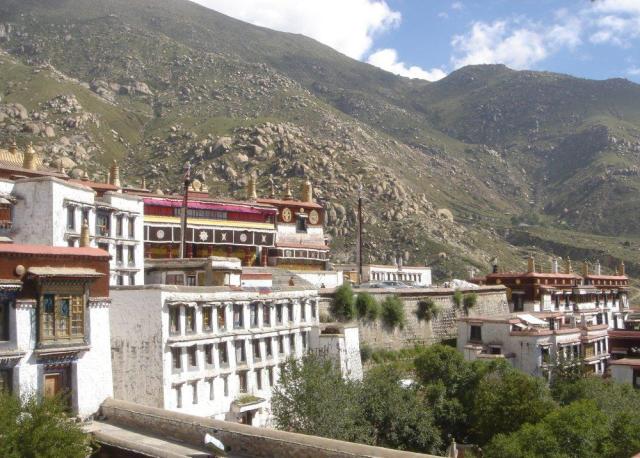
http://upload.wikimedia.org/wikipedia/commons/a/a9/Drepung_monastery.jpg
borrowed from the name of a celebrated Indian monastery ; but others are merely place-names which are often descriptive of the site, 2 thus : —
Tashi-Lhun-po, ” The mass of glory.”
http://en.wikipedia.org/wiki/File:BKraShisLhunPo_Tashilhunpo_Monestary,_Tibet_1985.jpg
Sa-skya, the tawny soil.
Min-pol-liṅ, ” The place of perfect emancipation.”
The ” Hīmis, ” monastery in Ladāk is called ” The support of the meaning of Buddha’s precepts.” 3
1 rgyab ri brag daṅ mdun ri mts’o. 2 See my “Place, River and Mountain Names of Sikhim,” etc., J.A.S.B., 1891. 3 Schlag., 179.
SAṄ -ṄA-CHO-LIṄ (Ang., Sangngak Chöling) gsan, secret or occult, + snags, spell or magic + c’os religion + glin, a place. ” The place of the occult mystic religion.” A catholic Buddhist monastery open to all classes, including deformed persons, nuns, Lepchas and Limbus.
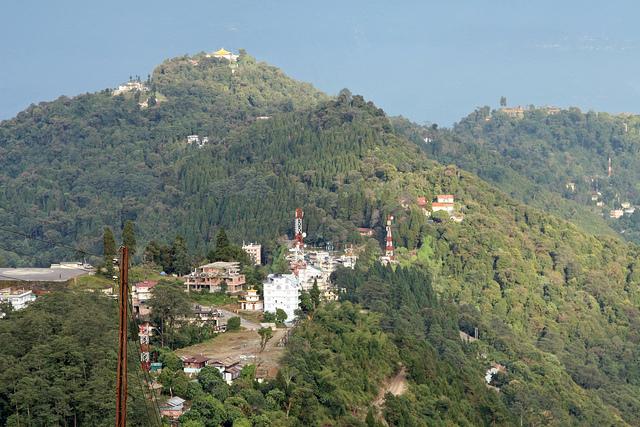
Earth > Asia > Greater Himalayas & Tibetan Plateau > China > Tibet Autonomous Region > Lhokha > Lhüntsé > Sangngak Chöling
PADMA-YAṄ -TSE(Ang.,Pemiongchi) = padma (pr. “pama”)a lotus + yaṅ, perfect or pure + rtse, the highest ” the monastery of the sublime perfect lotus (-born one, i.e., Padma-sambhava) .” A monastery professing, we believe, only well-born, celibate, and undeformed
monks, and especially associated with St. Padma, who is worshipped here.
TA-KA-TASHI-DIṄ (Ang., Tashiding) = brag { = tag,) a rock +dkar , white + bkra-sis (pr. ta shi) glory + lding, a soaring up or elevation.
The original name is likely to have been ‘bring, pronounced ” ding,” and meaning the middle, with reference to its romantically elevated site between two great rivers at their junction. ” The gompa of the elevated glorious white rock.” The site, a bold high promontory at the junction of and between the Great Rangit and Katong rivers, is believed to have been miraculously raised up by St. Padma, and amongst other traces a broad longitudinal white
streak in the rock is pointed out as being the shadow of that saint.
PHO-DAṄ (Ang., Fadung) = p’o-ldaṅ, a sloping ridge ; such is the site of this gompa and the usual spelling of the name. As, however, this is the ” chapel royal ” of the raja, it seems possible that the name may be p’o-bran (pr. p’o-daṅ) = palace, ” the gompa of the palace.”
LA-BRAṄ = Bla, a contraction of Lāma or high-priest + braṅ, a dwelling. Here resides the hierarch or chief Lāma. [N. B. — This is one of the very few words in which br is literally
pronounced as spelt.]
DORJE-LIṄ (Ang., Darjeeling) = rdo-rje “the precious stone”* or ecclesiastical sceptre, emblematic of the thunder-bolt of Sakra (Indra or Jupiter) + gliṅ, a place. The monastery from which Darjīling takes its name, and the ruins of which are still visible on observatory-hill, was a branch of the Dorjeling, usually curtailed into Do-ling {Ang., Dalling) monastery in native Sikhim; and to distinguish it from its parent monastery, it was termed Ank-du Dorje-ling (dbang, power + bdus, accumulated or concentrated) on account of its excellent situation, and powerful possibilities.
DE-T’AṄ = De, a kind of tree (Daphne papyraceae, Wall.), from the bark of which ropes and paper are made + t’aṅ, a meadow = ” the gompa of the De meadow.” Here these trees are abundant.
RI-GON (Ang., Ringim = (rl + dgon, a hermitage = “the hermitage hill.” It is situated near the top of the hill.
TO-LUṄ = rdo, a stone + luṅ, a valley. This valley is remarkably rocky, and avalanches of stones are frequent.
EN-CE = dben {pr. en), a solitary place + lc’e, a tongue. A monastery on a tongue-shaped spur.
DUB-DE = sgrub (pr. “dub”), a hermit’s cell + sde, a place. “The place of the hermits cell “—the oldest monastery in Sikhim, founded by the pioneer missionary Lha-tsun Ch en-bo.
P’EN-ZAṄ = p’an bliss or profit + bzaṅ, excellent. The monastery of “excellent bliss.”
KA-CO-PAL-RI {Ang. Ketsuperi) = mk’ā, heaven + spyod (pr. cho) to accomplish or reach + dpal, noble + ri = the monastery of “the noble mountain of the Garuḍa (a messenger of the gods) ” or “of reaching heaven.”
MA-ṆI = ” mā-nī’ a tablet inscribed with “Om mani, etc,” a Mendoṅ. “The gompa of the Mendoṅ “; here the gompa was erected near an old mendong.
SE-NON = Se , a sloping ridge + non, depressed. It is situated on a depressed sloping ridge ; and is also spelt gzigs (pr. zī), a see-er or beholder + mnon, to suppress ; and in this regard it is alleged that here St. Padma-sambhava beheld the local demons underneath and kept them under.
YAṄ-GAṄ =yaṅ,perfect, also lucky + sgaṅ “ a ridge ” ” The monastery of the lucky ridge.”
LHUN-TSE =lhun,lofty +rtse, summit. The monastery of the lofty summit”
NAM-TSE = RNam, a division or district + RTse. “Lofty division” one of the subdivisions of native Sikhim, on the flank of Tendong. It is probable that this is a Lepcha name from tsu = ” Seat of government, as the site is a very old Lepcha one.
TSUN-T’AṄ (Ang., Cheungtham)= btsun, a queen; also ” respected one ” i.e., a Lāma or monk; also marriage + thaṅ, a meadow. This gompa is situated overlooking a meadow at the junction of the Lachhen and Lachhung rivers. It may mean “the meadow of marriage (of the two rivers),” or ” the meadow of the Lāmas,” or the meadow of Our Lady “-its full name as found in manuscript being btsun-mo rin-chen t’an,” implies that the Lāmas derive its name from “the precious Lady (Dorje-p’ag-mo) ” whose image is prominently displayed within the gompa.
RAB-LIṄ (Ang., Rawling) = rab, excellent or high + gliṅ, a place. This monastery is situated on a high cliffy ridge
NOB-LIṄ (Ang. Nobling) = nub, the west + gliṅ = “The gompa of the Western place or country.” It lies on the western border of Sikhim.
DE-KYI-LIṄ (Ang ,Dikiling) = bde-skyid, happiness + gliṅ = ” The place of Happiness ” ,It is a rich arable slte With the beer -millet (murwa) cultivation.
The site chosen for a monastery must be consecrated before any building is begun. A chapter of Lāmas is held, and the tutelary deity is invoked to protect the proposed building against all injury of men and demons. At the ceremony of laying the first stone prayers are recited, and charms, together with certain forms of benediction (Tashi-tsig jod), together with relics, are deposited in a hollow stone. 1 And other rites are done. And in repairing a sacred building somewhat similar services are performed.
The size of the Tibetan monasteries is sometimes immense, several containing from 3,000 to 10,000 monks, in this the most priest-ridden country in the world. The larger monasteries are like small towns, as seen in the original drawing of Tashi-lhunpo here given, with long streets of cells, two or three storeys high, and usually surrounding small courtyards which generally contain a shrine in the centre. The chief building is “The assembly hall,” which, however, is practically a temple, and is considered under that head.
There are always small halls for teaching purposes, as the monasteries serve also as colleges. But these colleges are for the clergy alone, as Lāmas, unlike Burmese monks, are not the schoolmasters of the people. They teach only those who enter the order. And the lay populace have to be content with the poor tuition obtainable in a few schools (Lob-ta) conducted by laymen.
The architecture seems to have preserved much of the mediaeval Indian style. Mr. Fergusson shows 2 that Nepal, in its architecture as well as ethnologically, presents us with a microcosm of India as it was in the seventh century, when Hiuen Tsiang visited it ; and that the Sikhim monasteries show a perseverance in the employment of sloping jambs (as in the Tashiding doorway), 3 as used two thousand years ago in the Behar and early western caves ; and the porch of the temple at Pemiongchi shows the form of roof which we are familiar with in the rock examples of India.
The architecture of the monastery resembles that of the houses of the wealthy Tibetans, and is often ostentatious. It has been described in some detail by Schlagintweit, Huc, Rockhill, 4 etc., as regards Tibet, and by General Cunningham and Mr. Conway as regards the large monasteries of Ladāk. The monasteries in Sikhim are mean and almost devoid of any artistic interest.
1 SCHLAG., 178, who there translates the historical document on the founding of Himis; Csoma’s An., p. 508; Cunningham’s Ladāk,309. 2 Hist. Ind. and Eastn. Arch., p. 299, et seq.3 Figured by Hooker, Him. Jour. 4 See also detailed description of the houses of the Lāmas of Kumbum in Land of the Lāmas, p. 65.
Tashi-Tashi lhunpo Monastery.(From a native drawing.)
As wood is scarce in Tibet most of the monasteries are built of stone or sun-dried bricks. Most have flat roofs, some are in the Chinese style, and -most are surmounted by the cylinders of yak- hair cloth crossed by a few white ribbons at right angles to each other, and topped by a crescent and spear, as in figures, and a curtain of yak-hair cloth bearing similar stripes in the form of a Latin cross closes the windows. In the outer Himalayas the cells and dormitories and other buildings cluster round the temple. And in the temple-monasteries, the ground floor is without windows and is generally used as a storehouse, and the upper storeys are reached by a staircase or an inclined beam on which notches are cut for steps ; and the scanty furniture is of the plainest.
The well-known Indian name of a Buddhist monastery, namely Ārāma, or Saṅghārāma (“the resting-place of the clergy”) more strictly applied to the grove in which the monastery was situated is applied in Tibet, which is almost destitute of groves, to the’ auditory or library of the monastery. 1
Ch’orten and Mendoṅ in Ladāk.2
Lining the approaches to the monastery are rows of tall
1 Cf., JAESCH., D., 4. 2 After Mr. Knight.
” prayer “-flags, and several large funereal monuments — Ch’orten and long wall-like Mendoṅ monuments.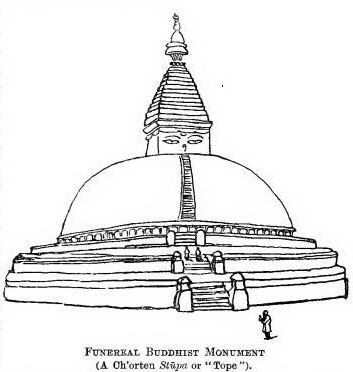
The Ch’or-tens, 1 literally
” receptacle for offerings,” 2 are
usually solid conical masonry
structures, corresponding to
the Caityas and Stupas or”Topes” of
Indian Buddhism, and originally intended as relic-holders; they are now mostly erected
as cenotaphs in Funereal Buddhist Monument
memory of (A Ch’orten Stupa or ” Tope “).
Buddha or of canonized saints; and they present a suggestively funereal appearance. Some commemorate the visits of Lāmaist saints ; and miniature ones of metal, wood, or clay often adorn the altar, and sometimes contain relics.
The original form of the Caitya, or Stupa, 3 was
a simple and massive hemisphere or solid dome
(garbha, literally ” womb ” enclosing the relic) of
masonry, with its convexity upwards and crowned
by a square capital (toran) surmounted by one or
more umbrellas, symbols of royalty. Latterly they
became more complex in form, with numerous
plinths, and much elongated, especially in regard Mediaeval. Indian
to their capitals, as seen in the small photograph brazen Caitya
here given. 4 . (from Tibet.)
1 mCh’od-r-ten. 2 Skt., Da-garbha. 3 Cf . HODGSON., Il., 30, et seq., for descriptions ; also his views about the respective meanings of ” Caitya ” and ” Stūpa.” 4 In Mr. Hodgson’s collection are nearly one hundred drawings of Caityas in Nepal ; Fergusson’s Hist. Ind. and East. Arch., 303; Ferg. and Burgess’ Cave-Temples ;Cunningham’s Bhilsa Topes, p. 12.
The Lāmaist Caityas, or Ch’ortens, are mainly of the two forms here shown. They generally adhere to the Indian type ; but differ most conspicuously in that the dome in the commonest form is inverted. Both have more or less elaborate plinths, and on the sides of the capital are often figured a pair of eyes, like the
sacred eyes met with in ancient 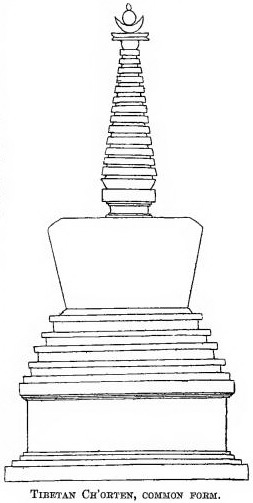
Egyptian, Greek, and Roman
vases, etc., and believed to be
connected with sun-worship.
Above the toran is a bluntly
conical or pyramidal spire,
Cūḍāmani, of thirteen steplike segments, typical of the thirteen Bodhisat heavens of the Buddhists. This is surmounted by a bell-shaped symbol (usually copper-gilt) called the kalsa, the handle of which forms a tapering pinnacle sometimes modelled after a small Caitya, but often moulded in the form of one or two or all of the following objects : a lotus – flower, a crescent moon, a globular sun a triple canopy, which are finally surmounted by a tongue-shaped spike, representing the jyoti or sacred light of Buddha. And sometimes round the base of the kalsa is a gilt canopy or umbrella (catra). 1 Many of the Lāmaist Caityas are, like those of the Japanese, symbolic of the five elements into which a body is resolved upon death ; thus, as in the annexed figure, the lowest section, a solid rectangular block, typifies the solidity of the earth ; above it water is represented by a globe ; fire by a triangular tongue ; air by a
1 Cunningham’s Bhilsa Topes, 12.
crescent— the inverted vault of the sky, and ether by an acuminated circle, the tapering into space.A miniature Ch’orten, containing an enormous number of small images of Lāmaist deities, in niches and in several inner compartments within folding doors, is called
“the glorious (Ch’orten) of many doors.” 1 It is
carried about from village to village by itinerant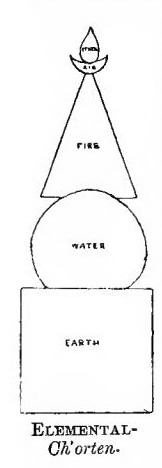
Lāmas for exhibition to the laity.
In the wealthier monasteries the Ch’ortens
are regularly white-washed.
The Mendoṅs, as figured on page 261, are long
wall-like erections sometimes
over a mile in length, which divide
the road into two lateral halves to
allow of the respectful mode of
passing it, namely, with the right hand to the wall.
They are faced with blocks bearing in rudely cut characters the six-syllabled mystic sentence ” Oṃ maṇi padme hūṃ “— the same which is revolved in the “prayer- wheels ” and usually called Maṇi ; and its name is said to be derived from these, namely, Maṇi-doṅ, or ” The Maṇi-faced.” It usually has a ch’orten terminating it at either end; and occasionally it contains niches to burn incense or to deposit the small clay funereal Caityas, 2 and also bears coarsely outlined figures of the three especial protecting divinities of Lāmaism. 3 As it is a pious act to add to these ” Maṇi ” slabs, a mason is kept at the larger temples and places of special pilgrimage, who carves the necessary number of stones according to the order and at the expense of the donating pilgrim.
The small cairns, surmounted by a few sticks, to which rags are attached by passers by as offerings to the genius loci, like the “rag-bushes ” of India, are called Lab-ch’a, and figured at page 286.
As with all sacred objects, these monuments must always be passed on the right hand, 4 according to the ancient custom of showing respect. And thus, too, it is that the prayer-cylinders must always be turned in this direction.
In addition to the foregoing objects, there is frequently found in
1 Ta-shi-‘go-maṅ. 2 dharma-sarīra. 3 The Rig-sum gon-po. 4 pradakshina.
the vicinity of the monastery a stone seat called a ” throne ” for the head Lāma, when he gives al-fresco instruction to his pupils.
One of the reputed thrones of the founder of Sikhim Lāmaism exists at the Pemiongchi Ch’orten, where the camp of visitors is usually pitched.
There is no regular asylum for animals rescued from the butchers, to save some person from pending death ; but occasion- ally such ransomed cattle are to be found in the neighbourhood
of monasteries where their pension-expenses have been covered by a donation from the party cured. The animals have their ears bored for a tuft of coloured rags as a distinctive and saving mark.
In Sikhim not far from most monasteries are fertile fields of murva (Eleusine corocana), from which is made the country beer, a beverage which the Sikhim and Bhutanese monks do not deny themselves.
Over 3,000 monasteries are said to be in Tibet. But before giving a short descriptive list of some of the chief monasteries of Lāmadom it seems desirable to indicate the chief
provinces into which Tibet is divided. 1
Tibet is divided into three sections, namely : —
1. Pod or “Tibet” proper, or the provinces of U and Tsang,
hence the name ” Weitsang ” applied to Tibet by the Chinese.
2. High (or Little) Tibet, or the northern provinces of Tod,
Ṅari, and Khor-sum.
3. Eastern Tibet, or the provinces of Kham, Do, and Gang.
In Tibet proper the central province of U and the western one of Tsang have their capitals at Lhāsa and Tashi-lhunpo respectively. U contains the districts of Gryama (and Kongbu, including Pema- Koi), Di-gung, Tsal-pa, Tsang-po, Che’-va, Phag-du, Yah-sang, and
Yaru-dag, including the great Yamdok lake. Tsang comprises the districts of north and south Lo-stod, Grurmo, Ch’umig, S’ang, and S’alu.
Little Tibet is divided into the three circles of sTag-mo Ladvags (” Ladāk “), Mang-yul S’ang Shum, Gruge Burang (“Purang”),
1 The best vernacular account of the geography of Tibet is contained in the Dsam-ling Gye-she of Lāma, Tsan-po Noman Khan of Amdo, and translated by SARAT, J.A.S.B., 1887, p. 1, seq. ; Csoma, J.A.S.B., 1832, p. 123. For scientific geography, see Markham’s Tibet, Indian Survey Reports, Prejvalsky, Rockhill, etc. D’Anville’s map of 1793, compiled on data supplied by Lāmas, is still our chief authority for a large portion of Tibet.
comprising the districts of Purang, Mang-yul Sangs-dKar, hCh’i- va, bLas’a, sBal-te, Shang-shung, upper and lower Khrig-se, East Ṅari includes Dok-t’al and lake Manasarovar.The Ladāk
and Balti districts of west Ṅari were conquered by Kashmīr in 1840 and are now British dependencies. Ka-che, sometimes used synonymously with Kashmīr, includes the lofty northern steppes and the gold fields of Thog-Jalung.
Eastern Tibet is the most populous- section of the country. The greater part of the low-lying Do province (Amdo) seems to have been detached from Tibet by the Chinese about 1720. The south-eastern province of Kham borders on Assam and upper Burma,
and includes the districts of Po, Lhari-go. The Gang province consists mostly of high bleak ridges, Pombor, Tsawa, and ‘Tsa- Ch’u. The northern Tsai-dam, comprising many marshes between Nan-sban and Altentagh mountains, is peopled by Tanguts and Mongols.
The chief monasteries of central Tibet are : —
http://upload.wikimedia.org/wikipedia/commons/a/ad/Samye_Monastery_cropped.JPG
བསམ་ཡསSam-yas,which as the first monastery founded in Tibet, deserves first mention.
Its full title is ” bSam-yas Mi-‘gyur Lhun-gyis grub-paī Tsug-lug-K’aṅ ” or ” The academy for obtaining the heap of unchanging Meditation.”
The explorer Nain Singh resided in this monastery in 1874 and has given a good account of it. It is situated (N. lat. 29° 20’, E. long. 91° 26, altitude about 11,430ft.) about thirty miles to the S.E. of Lhāsa, near the north bank of the Tsang-po river amidst hillocks of
deep sand, clothed with scanty herbage. It was built about 774 by Thi-Sroṅ Detsan with the aid of the Indian monks, Padma-sambhava and Ṣanta-rakshita, after the model of the Udandapur, 1 temple-monastery of Bihar. But the building is believed to have been altogether miraculous, and an abstract of the legend is given underneath. 2
1 For some details see Sarat, in J. Budd. Texts. Ind., i., p. 4, seq.
2 To consecrate the ground and procure supernatural workers St. Padma made the
magic-circle of rDo-r je-P’ur-pa with coloured stone-dust, and having the K’ro-wo of the five kinds, and all the necessary offerings arranged in his presence, he worshipped for seven days. Then the five Jinas (Dhyāni Buddhas, Gyal-wa-rigs-lṅa) appeared to him, and the king, being empowered, also saw the faces of these five. Then the Guru created several incarnations of himself, some of whom entered the Mandala, while some flew up into the sky. These incarnations caused the Tibetan devils to bring stones and wood from the hills and rivers, and thus the foundation of bSam-yas academy was begun. Human beings built it by day, while the devils worked at it by night, and so the great work rapidly progressed. When the king saw the great piles of gathered wood he was surprised and was awestruck, and asked the Guru to explain. The Guru thereon made the Maṇḍala of the ” Five,” and worshipping for seven days, the Five transformed themselves into five kinds of Garuḍa birds, which were visible to the king. And at that very time the Guru himself became invisible, and the king saw in his stead a great Garuḍa holding a snake in his clutches and beak ; but not seeing the Guru, the king cried out in fear. Then the Garuḍa vanished and the Guru reappeared beside him.
The country to the south of Samye was then, it is said, inhabited by the savage “kLa-klo ” tribes, which the Tibetans, through their Indian pandits, termed Nāgās (cognate with those of the Brahmaputra valley). The next day, a Nāgā, having transformed himself into a white man on a white horse, came into the presence of the king and said, ” O king ! How much wood do you need for building Sam-yas ? as I will supply you with all you want.” On being informed of the requirements, the Nāgā collected wood to an enormous extent.
The building of the Sam-ye academy (gtsug-lag- k’aṅ) swallowed up the wealth
of the king. So the Guru, accompanied by the king and his ministers, went to the bank of
Mal-gro lake, and keeping the ministers concealed in a small valley, the Guru began to make a Maṇḍala of the ” Five,” and worshipped for seven days, after which Avalokita sinhada, with Amitābha on his head, stood at each of the four directions, where dwell the four gods of the Five. On this the Nāgās of the depths became powerless, and the Guru, addressing them, said, “The wealth of my kin being exhausted, I have come to ask wealth.” Next day the banks were found lined with glittering gold, which the Guru caused the ministers to carry off to the palace
On this account all the images of gods at Sam-yas are made of solid gold, and of a quality unequalled in any part of our world of Jambudvīp.
Part of the original building yet remains. The monastery, which contains a large temple, four large colleges, and several other buildings, is enclosed by a lofty circular wall about a mile and a half in circumference, with gates facing the cardinal points, and along the top of the wall are many votive brick chaityas, of which the explorer, Nain Singh, counted 1,030, and they seemed to be covered with inscriptions in ancient Indian characters. In the centre of the enclosure stands the assembly hall, with radiating cloisters leading to four chapels, facing at equal distances the four sides of the larger temple. This explorer notes that ” the idols and images contained in these temples are of pure gold, richly ornamented with valuable cloths and jewels. The candle-sticks and vessels are nearly all made of gold and silver.” And on the temple walls are many large inscriptions in Chinese and ancient Indian characters. In the vestibule of the chief temple, to the left of the door, is a colossal copy of the pictorial Wheel of Life.
The large image of “Buddha,” over ten feet high, seems to be called ” the Sam-yjis Jing ” (Samyas Gyal-po).
The library contains many Indian manuscripts, but a great number of these were destroyed at the great fire about 1810 CE. In a temple close by among the sand is a celebrated chamber of horrors, built of large boulders, and containing gigantic figures of the twenty-five Gon-po demons. The images are made of incense, and are about twenty feet high, of the fiercest expression, and represented as dancing upon mangled human corpses, which they are also devouring. And great stains of blood are pointed out by the attendants as the fresh stains of bodies which the demons have dragged to the place during the previous night.
We have already referred to the miraculous account of the building of this monastery, which is said to rest upon Raksha fiends. On account of the peculiar safety imparted to the locality by the spells of the wizard priest, Padma-sambhava, the Tibetan government use the place as a bank for their reserved bullion and treasure, of which fabulous sums are said to be stored there.
Although it is now presided over by a Sa-kya Lāma, the majority of
its members are Ñiṅ-ma.
GĀH-LDAN, the monastery founded by Tsoṅ-K’a-pa, is one of the four great Ge-lug-pa or established church monasteries, the others being De-pung, Sera and Tāshi-lhunpo.
Its full name is dGah-ldan rNam-par Gyal-wahi glin, or the Continent of completely victorious happiness.
This monastery stands enthroned on the db Aṅ-K’or hill, about twenty-five miles E. N.E. of Lhāsa. Its founder, Tsoṅ-K’a-pa, raised it to a high pitch of fame and filled it with costly images. The chief object of veneration is the grand tomb of Tsoṅ-K’a-pa, which is placed in the Tsug-la-k’aṅ. It is a lofty mausoleum-like structure of marble and malachite, with a gilded roof. Inside this outer shell is to be seen a beautiful Ch’orten, consisting of cube pyramid and surmounting cone, all said to be of solid gold. Within this golden casket, wrapped in fine cloths, inscribed with sacred Dharani syllables, are the embalmed remains of the great reformer, disposed in sitting attitude. Other notable objects here are a magnificent representation of Cham-pa, the Buddha to come, seated, European fashion, on a throne. Beside him stands a life-sized image of Tsoṅ-K’a-pa, in his character of Jam-pal
Nin-po, which is supposed to be his name in the Galdan heavens. A rock-hewn cell, with impressions of hands and feet, is also shown as Tson-K’a-pa’s. A very old statue of S’inje, the lord of Death, is much reverenced here ; every visitor presenting gifts and doing it infinite
obeisance. The floor of the large central chamber appears to be covered with brilliant enamelled tiles, whilst another shrine holds an effigy of Tson-K’a-pa, with images of his five disciples (Shes-rab Sen-ge, K’a-grub Ch’os-rje, etc.) standing round him. The library contains
manuscript copies of the saint’s works in his own handwriting. 1 ‘
Unlike the other large Ge-lug-pa monasteries, the headship of Gāh- ldan is not based on hereditary incarnation, and is not, therefore, a child when appointed. He is chosen by a conclave from among the most scholarly of the monks of Sera, De-pung, and this monastery. The late abbot became ultimately regent of all Tibet. The number of inmates here is reckoned at about 3,300.
DE-PUNG (‘bras-spuṅiis), the most powerful and populous of all the monasteries in Tibet, founded in and named after the great Indian- Tantrik monastery of “The rice-heap” (Srī -Dhanya Kataka) in
1 Abstract from Survey Reports, etc., by Rev. G. Sandberg.
Kaliṅga and identified with the Kālācākra doctrine. It is situated about three miles west of Lhāsa, and it contains nominally 7,000 1 monks. It is divided into four sections clustering round the great cathedral, the resplendent golden roof of which is seen from afar. It contains a small palace for the Dalai Lāma at his annual visit. Many Mongolians study here. In front stands a stūpa, said to contain the body of the fourth Grand Lāma, Yon-tenn, who was of Mongolian nationality.
Its local genii are the Five nymphs of long Life (Ts’erin-ma), whose images, accompanied by that of Hayagriva, guard the entrance. And effigies of the sixteen Sthavira are placed outside the temple door. In its neighbourhood is the monastery of Na-Ch’uṅ, the residence of the state sorcerer, with a conspicuous gilt dome.
SER-RA, or ” The Merciful Hail.” 2 It is said to have been so named out of rivalry to its neighbour, ” The rice-heap ” (De-pung), as hail is destructive of rice, and the two monasteries have frequent feuds. In connection with this legend there is also exhibited here a miraculous ” Phurbu,” or thunderbolt sceptre of Jupiter Pluvius.
It is romantically situated about a mile and a half to the north of Lhāsa, on the lower slopes of a range of barren hills named Ta-ti-pu, famous for silver ore, and which surround the monastery like an amphitheatre.
Its monks number nominally 5,500, and have frequently engaged in bloody feuds against their more powerful rivals of De-pung. The Indian surveyor reported only on the idols of the temple. He says : ” They differ in size and hideousness, some having horns, but the lower parts of the figures are generally those of men.” Huc gives a fuller description : ” The temples and houses of Sera stand on a slope of the mountain-spur, planted with hollies and cypresses. At a distance these buildings, ranged in the form of an amphitheatre, one above the other, and standing out upon the green base of the hill, present an attractive and picturesque sight. Here and there, in the breaks of the mountain above this religious city, you see a great number of cells inhabited by contemplative Lāmas, which you can reach only with difficulty. The monastery of Sera is remarkable for three large temples of several storeys in height, all the rooms of which are gilded throughout. Thence the name from ser, the Tibetan for ‘gold.’ In the chief of these three temples is preserved the famous tortche, which, havingflown through the air from India, is the model from which all others, large and portable, are copied. The tortche of Sera is the object of great veneration, and is sometimes carried in procession to Lhāsa to receive the adoration of the people.” This ” dorje,” or rather “phurbu,” is what is called a Tam-din-phurbu, and is said to have originally belonged to an Indian sage named Grub-thob mdah-‘phyar. It was found on the hill in the neighbourhood named P’urba-Ch’og, having flown from Indin. In the 12th month of every year (about the 27th
1 Lāma U.G., loc.cit., p. 34, says 10,000. 2 This word is usually spelt ser, and seems never to be spelt gSer, or “gold”’
day) it is taken out of its casket and carried in state to Potala, where the Dalai Lāma puts it to his head. It is thereafter carried by a high official of Sera monastery to the Chinese Amban, the governors (Shape) and the regent, all of whom touch their heads with it. Afterwards thousands throng to Sera to receive its holy touch on their heads as a defence against all evil and spells. In the great assembly hall is a huge image of Avalokita with eleven heads.
TASHI-LHUNPO (bkra-s’is Lhun-po), or the ” Heap of Glory,” the headquarters of the Pan-ch’en Grand Lāma, who to some extent shares with the Lhāsa Grand Lāma the headship of the church. Its general appearance will be seen from the foregoing plate on page 260, from a native drawing. The monastery forms quite a small town, and not even Lāmas other than established church can stay there over-night. It is well known through the descriptions of Bogle, Turner, etc. It is situated near the south bank of the Tsang-po, at the junction of the Nying river, in 89° 7 ‘ E. long., 29° 4’ 20″ N. lat., and altitude, 11,800 feet (Markh., xxvii.). This celebrated establishment has been long known to European geographers as ” Teeshoo Loombo.”
Mr. Bogle describes it 1 as being built on the lower slope of a steep hill (Dolmai Ri, or hill of the goddess Tārā). The houses rise one over another ; four churches with gilt ornaments are mixed with them, and altogether it presents a princely appearance. Many of the courts are flagged with stone, and with galleries running round them. The alleys, which are likewise paved, are narrow. The palace is large, built of dark-coloured bricks, with a copper-gilt roof. It is appropriated to the Lāma and his officers, to temples, granaries, warehouses, etc. The rest of the town is entirely inhabited by priests, who are in number about four thousand. Mr. Bogle also describes the interior of several of the state rooms and temples. On the top of mount Dolmai Ri is a stone cairn, where banners are always fluttering, and where, on high festivals,
huge bonfires are set ablaze. The lay capital of the province, Shigatse, lies on the upper ridges to the N.E. of this hill, hardly a mile from this, the ecclesiastical capital.
The lofty walls enclosing the monastic town are pierced by five gateways. Over the eastern gate has been placed, in large carved letters, a prohibition against smoking within the monastic precincts. The western gateway seems to be regarded as the main entrance. So, entering the monastic premises there, you find yourself in a sort of town, with lanes lined by lofty houses, open squares, and temples.
In the centre of the place is the grand cathedral or assembly hall. Its entrance faces the east. Its roof is supported by one hundred pillars, and the building accommodates two to three thousand monks seated in nine rows on rugs placed side by side on the floor. The four central pillars, called the Ka-ring, are higher than the rest, and support a detached roof to form the side skylights through which those seated in the upper gallery can witness the service. The rows of seats arranged
1 Mark., p. 96.
to the right side of the entrance are occupied by the senior monks, such as belong to the order of Rigch’en, Pharch’enpha, Torampa, Kāh-c’an, etc. The seats to the left side are taken up by the junior monks, such as Ge-ts’ul and apprentice monks, etc., of the classes called Dura and Rigding.
The court around it is used by the monks for religious dances and other outdoor ceremonies. Round the space are reared the halls of the
college, four storeys in height, provided with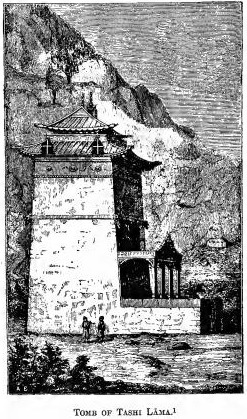
upper-floor balconies. North of these buildings
are set up in a line the huge tombs of deceased
Pan-ch’en Lāmas. The body of each is em-
balmed and placed within a gold-plated
pyramid raised on a tall marble
table, and this structure stands within a stone
mausoleum, high and decorated with gilt
k a nj i r a and small cylinder-shaped finials
made of black felt. One of these tombs is much
bigger than the rest. It is that of Pan-ch’en Er-
teni, who died in 1779.
There are four conventual colleges at-
tached to Tashi-lhunpo, all of which receive
students from every part
of Tibet, who are instructed in Tantrik ritual,
and learn large
portions of that division of the scriptures.
The names of these
colleges are
Shar-tse
Tā-ts’an,
Nag-pa Ta ts’an, Toi-sam Liṅ,
Tomb of Tashi Lāma. 1
and Kyil-k’aṅ Ta-ts’aṅ. Each of these institutions has an abbot, who is the tul-wa, or avatar of some bygone saint ; and the four abbots have much to do with the discovery of the infant successor to a deceased Pan-ch’en, or head of the monastery. From these abbots, also, one
1 After Turner.
is selected to act as the prime minister, or chief ecclesiastical adviser in the government of Tsang. The most imposing building of the monastery is the temple and hall of the Ṅag-pa Ta-ts’aṅ, known as the ” Ṅagk’aṅ,” which is the chief college for mystic ritual in Tibet.
Another college, the Toi-san-liṅ, stands at the extreme northern apex of the walls, some way up the slope of the Dolmai-Ri hill.
Hard by the last-named premises, is to be observed a lofty building of rubble-stone, reared to the amazing height of nine storeys. This edifice, which forms a very remarkable object on the hill-side, was sketched by Turner, who visited Tashi-lhunpo one hundred years ago,
and his drawing of it is here annexed on opposite page. It is called Go-Ku-pea, or ” The Stored Silken Pictures,” as it is used to exhibit at certain festivals the gigantic pictures of Maitreya and other Buddhist deities, which are brought out and hung high up as great sheets outside the walls of the tall building. By the vulgar it is styled Kiku Tamsa. It is used as a storehouse for the dried carcases of sheep, goats, and yak, which are kept in stock for feeding the inmates of the monastery. A wide-walled yard fronts the Kiku Tamsa, and this space is thronged by a motley crowd when (as is the custom in June and November) the pictures are exhibited.
The number of monks generally in residence at Tashi-lhunpo is said to be 3,800. The division into wards and clubs has already been referred to.
The head of the whole monastic establishment resides in the building called bLa-brang, or ” The Lāma’s palace.”
NAM-GYAL CH’OI-DE is the monastery-royal of the Grand Lāma on the red hill of Potala, where the Dalai Lāma holds his court and takes part in the service as a Bhikshu, or common monk.
RAMO-CH’E and KARMAKYA monasteries, within Lhāsa, are, as already noted, schools of sorcery, and the latter has a printing house.
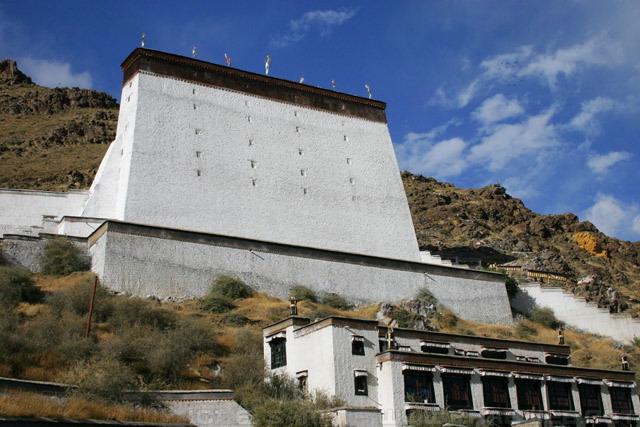
The “go-Ku-pea ” or “Kiku-Tamsa.” Tower at Tashi-lhunpo 1 After Turner.
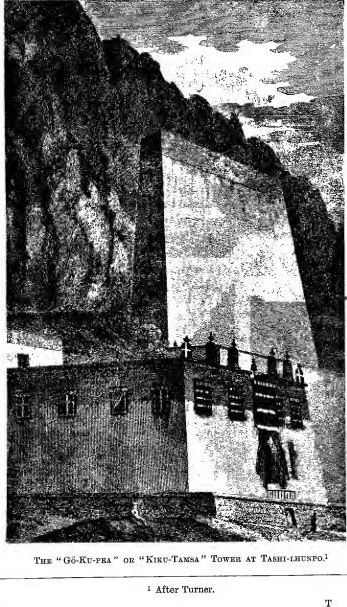
pp.274
Chamnamrin (Nam-lin), in the valley of the Shing river, a northern affluent of the Tsang-po, 12,220 feet, seen and visited by Mr. Bogle.
Dorkya lugu-doṅ, on the bank of the great Tengri-nor lake.
Ra-deng (Ra-sgren), north-east of Lhāsa, a Ka-dam-pa monastery, founded in 1055 by Brom-ton, Atīṣa’s pupil.
Sa-kya (Sa-skya) ” Tawny-soil,” is about 50 miles north of Mount Everest, 48 miles east from Shigatse,and 30 miles from Jang-lache; E.long. 87° 54′, lat. 28° 53′ . This monastery gives its name to the Sākya sect, which has played an important part in the history of Tibet. A considerable town nestles at the foot of the monastery. The foundation of the monastery and its future fame are related to have been foretold by the Indian sage, Atīṣa, when on his way to central Tibet, he passed a rock, on the present site of the monastery, on which he saw the mystic Om inscribed in ” self -sprung,” characters. Afterwards this establishment became famous as a seat of learning and for a time of the priest-king.
It is said to contain the largest single building in Tibet, — though the cathedral at Lhāsa is said to be larger. It is seven 1 storeys in height, and has a spacious assembly hall known as ” the White Hall of Worship.” It is still famous for its magnificent library, containing numerous unique treasures of Sanskrit and Tibetan literature, unobtainable elsewhere. Some of these have enormous pages embossed throughout in letters of gold and silver. The monastery, though visited in 1872 by our exploring Paṇḍit No. 9, and in 1882 by Babu Sarat Candra Dās, remains undescribed at present. The Sakya Lāma is held to be an incarnation of the Bodhisattva Mañjuṣṛī, and also to carry Karma, derivable from Sakya Paṇḍita and St. Padma.
The hall of the great temple, called ‘P’rul-pahī Lha-k’aṅ, has four enormous wooden pillars, Ka-wa-miṅ ches zhi, of which the first pillar is white, and called Kar-po-zum-lags, and is alleged to have come from Kongbu ; the second yellow, Ser-po zum-lags, from Mochu valley ; the third red, Marpo Tag dzag, from Nanam on Nepal frontier ; and the fourth pillar black, Nak-po K’un-shes, from Ladāk. These pillars are said to have been erected by K’yed-‘bum bsags, the ancestor of the Sikkim king.
Ting-ge is a very large Ge-lug-pa monastery to the north of Sakya and west of Tashi-lhunpo.
Phuntsholing (p’un-ts’ogs-gliṅ) monastery, formerly named rTag-brten by Tāranātha, who built it in his forty-first year, was forcibly made a Ge-lug-pa institution by the fifth grand Lāma, Ṅag-waṅ. It is situated on the Tsangpo, about a day’s journey west of Tashi-lhunpo, and one mile to the south-west of it is Jonang, which has a very large temple said to be like BudhGaya, and, like it, of several storeys and covered by images ; but both it and Phuntsholing are said to have been deserted by monks and now are occupied by nuns.
Sam-ding (bsam-ldiṅ ch’oinde). It lies in N. lat 28° 57′ 15″, and E long 90° 28.Altitude, 14,512 feet.
1 De-pung and the larger monasteries in Tibet have several much smaller buildings distributed so as to form a town.
An important establishment, noteworthy as a monastery of monks as well as nuns, presided over by a female abbot— the so-called re-incarnate goddess already referred to this august woman is known throughout Tibet as Dorje-Pag-mo, or ‘the diamond sow’ ; the abbesses of Samding being held to be successive appearances in mortal form of the Indian goddess Vajra-
Varahī. The present incarnation of this goddess is thirty-three years old (in 1889) ; and is described as being a clever and capable woman, with some claim to good looks, and of noble birth. She bears the name of Ṅag-dbaṅ Rin-ch’en Kun-bzaṅ-mo dbAṅ-mo, signifying “The most
precious power of speech, the female energy of all good “). Under this lady the reputation which Samding has long enjoyed for the good morals of both monks and nuns has been well maintained. Among other rules, the inmates are forbidden to lend out money or other valuables on interest to the rural folk, usurious dealings being commonly resorted to by the
monastic orders. It is said to be of the Ñiṅ-ma sect. The monastery was founded by one Je-tsun T’inle Ts’oma, a flower of the philosophy of Po-doṅ P’yog Legs Nam-gyal, whose writings, to the amazing extent of one hundred and eighteen volumes, are treasured up in the monastic library.
Yamdok lake is remarkable for its scorpionoid shape, the grotesque shaped semi-island anchored to the main shore by two necks of land. Samding is itself placed on the main shore at the juncture of the northern neck. Being built on a conical hill, it appears to be guarding
the sacred island from intrusion. The monastery stands like a fortress on the summit of the barren hill some 300 feet above the level of the surrounding country. Huge flags of stone are piled in ascending steps up this hill, and a long low wall mounts beside them like a balustrade.
At the top of the steps, a narrow pathway conducts to the foot of the
monastery which is circled by a high wall. Samding is finely placed. To the N E. it fronts the dark and precipitous mountain spurs which radiate from the lofty central peak of the islands. To the S.E. it looks over the land towards the illimitable waters of the weird and mighty Lamdok herself. To the S. it frowns down on the Dumo T’so the inner lake betwixt the connecting necks of land above-mentioned into which are cast the bodies of the defunct nuns and monks, as food for fishes.
On entering the gates of the monastery, you find yourself in an extensive courtyard, flanked on three sides by the conventional buildings. Part of the fourth side of the parallelogram is occupied by a kind of grand-stand supported on pilasters of wood. Ladders with broad steps
cased in brass, give admission to the first floor of the main building Here in a long room are ranged the tombs of celebrities connected in past times with Samding including that of the founder, T’inle Ts’omo .The latter tomb is a richly ornamented piece of workmanship, plated
with gold and studded with jewels. At the base, on a stone slab is marked the reputed footprint of the saint. In a private strongly barred chamber, hard by to which no one may be admitted, are laid the dried mortal remains of all the former incarnations of Dorje P’ag-mo.
Here, in this melancholy apartment, will be one day placed the body of the present lady abbess, after undergoing some embalming process. To the grim charnel-house, it is considered the imperative duty of each incarnate abbess to repair once, while living, to gaze her fill on her predecessors, and to make formal obeisance to their mouldering forms.
She must enter once, but only once, during her lifetime.
Another hall in this monastery is the dus-k’aṅ, the walls of which are frescoes illustrative of the career of the original Dorje P’ag-mo. There, also, have been put up inscriptions recording how the goddess miraculously defended Samding, when, in the year 1716, it was beset by a Mongol warrior, one Yung Gar. When the Mongol arrived in the vicinity of Yamdok, hearing that the lady abbess had a pig’s head as an excrescence behind her ear, he mocked at her in public, sending word to her to come to him, that he might see the pig’s head for himself. Dorje P’ag-mo returned no angry reply, only beseeching him to abandon his designs on the monastery. Burning with wrath, the warrior invaded the place and destroyed the walls ; but, entering, he found the interior utterly deserted. He only observed eighty pigs and eighty sows grunting in the du-khang under the lead of a bigger sow. He was startled by this singular frustration of his project ; for he could hardly plunder a place guarded only by hogs. When it was evident that the Mongol was bent no longer on rapine, the pigs and sows were suddenly transformed into venerable-looking monks and nuns, headed by the most reverend Dorje P’ag-mo; as a consequence, Yung Gar, instead of plundering, enriched the place with costly presents.
A certain amount of association is permitted between the male and female inmates of this convent, who together number less than 200. Dorje P’ag-mo retains one side of the monastic premises as her private residence. It is asserted by the inmates that the good woman never
suffers herself to sleep in a reclining attitude. During the day she may doze in a chair, during the night she must sit, hour after hour, wrapt in profound meditation. Occasionally this lady makes a royal progress to Lhāsa, where she is received with the deepest veneration. Up in northern Tibet is another sanctuary dedicated to Dorje P’ag-mo. This convent also stands on an islet situated off the west shore of the great lake, 70 miles N.W. of Lhāsa, the Nam Ts’o Ch’yidmo, and is much akin to Samding, comprising a few monks and nuns under an abbess.
At Markula, in Lahul, is a third shrine of the goddess. Abstract of SARAT’s Report, by Rev. G. Sandberg.
Di-kung (‘bri-guṅ) about one hundred miles N.E. of Lhāsa, is one of the largest Kar-gyu-pa monasteries. It is said to receive its name, the “she- Yak,” from the ridge on which it is situated, which is shaped like the back of a yak. It was founded in 1166, by the son of theSakya Lāma, Koncho Yal-po.
Mindolling (smin grol-glih), close to the S. of Samye, a great Ñiṅ-ma monastery, sharing with Dorje Dag, not far off, the honour of being the supreme monastery of that sect. It lies across the Tsangpo from Sam-yas in the valley of the Mindolling river, the water of which turns numerous large prayer-wheels. Its chief temple is nine storeys high, with twenty minor temples with many ” beautiful images ” and books. A massive stone stairway forms the approach to the monastery.
Its chief Lāma is a direct descendant of the revelation-finder Dag-liṅ. The succession is by descent and not by re-incarnation. One of his sons is made a Lāma and vowed to celibacy, another son marries and continues the descent, and in like manner the succession proceeds, and has not yet been interrupted since its institution seventeen generations ago ; but should the lay-brother die without issue the Lāma is expected to marry the widow. The married one is called g Dun-pa or ” the lineage.” The body of the deceased Lāma is salted and preserved. The discipline of this monastery is said to be strict, and its monks are celibate. A large branch of this monastery is Na-s’i, 1 not far distant from its parent.
Dorje-dag, between Sam-yas and Lhāsa, is a headquarters of the Unreformed Lāmas. It has had a chequered history, having been destroyed several times by the Mongols, etc., and periodically restored.
Pal-ri (dpal-ri), a Ñiṅ-ma monastery between Shigatse and Gyangtse, where lives the pretended incarnation of the Indian wizard, Lo-pon Hūṅkāra.
Shalu monastery, a few miles E. of Tashi-lhunpo. Here instruction is given in magical incantations, and devotees are immured for years in its cave-hermitages. Amongst the supernatural powers believed to be so acquired is the alleged ability to sit on a heap of barley without displacing a grain ; but no credible evidence is extant of anyone displaying such feats.
Guru ch’o-waṅ, in Lhobrak, or southern Tibet, bordering on Bhutān. This monastery is said by Lāma U. G. 2 to have been built after the model of the famous monastery of Nālanda in Magadha. The shrine is surrounded by groves of poplars, and contains some important relics, amongst others a stuffed horse of great sanctity (belonging to the great Guru) which is called Jamliṅ-nin-k’or, or ” the horse that can go round the world in one day.” 3 Observing that the horse was bereft of his ” left leg,” U. G. enquired the cause, and was told how the leg had been stolen by a Khamba pilgrim with a view of ” enchanting ” the ponies of Kham. The thief became insane, and his friends took him to the high priest of the sanctuary for advice, who instantly divined that he had stolen some sacred thing. This so frightened the thief that the leg was secretly restored, and the thief and his friends vanished from the place and never were seen again.
1 U. G., loc. cit., p. 26. 2 Loc. cit., p. 23. 3 Compare with the sacred horse of Shintoism, etc.
The upper Lhobrak is well cultivated ; barley, pea, mustard, wheat, and crops of rape were noticed by U. G., surrounding the monastery of Lha Lung. With some difficulty he obtained permission to see the sacred objects of the monastery, whose saintly founder, Lha Lung, has three incarnations in Tibet. One of them is the present abbot of the monastery, who was born in Bhutan, and is a nephew of the Paro Penlo. The monastery is well endowed by the Tibetan government, and rituals are encouraged in it for the suppression of evil spirits and demons.
Sang-kar Gu-t’ok, also in the Lhobrak valley, has one hundred monks, and is a small printing establishment. 1
Kar-ch’u, also in the Lhobrak valley, said 2 to be one of the richest monasteries in Tibet, and to contain many bronzes brought from Magadha in the Middle Ages. Pilgrims carry off from here the holy water which percolates into a sacred cave.
Gyan-tse, on the Painom river, east of Tashi-lhunpo. Its monastery is named Palk’or Ch’oide. Its hall is reported by Lāma Ugyan Gya-ts’o to be lit by 1,000 lamps. In lofty niches on the three sides, N., E., and W. (implying evidently that the entrance is on the S.), are placed “three huge images of Buddha — Jam-yang, Chanrassig, and Maitreya,” copper-gilt. Here also he notes ” stone images like those at Buddha Gaya. In the lobby is a collection of stuffed animals, including tigers.”
The foregoing are all in the U and Tsang provinces. In Kham, in eastern Tibet, are many large monasteries, the largest of which are perhaps Derge and Ch’ab-mdo (Chiamo), with about 2,000 monks and large printing press.
Derge (sDe-sge), at the town of that name, and capital of one of the richest and most populous of Tibetan provinces, containing ” many Lāma- serais of 200 or 300 monks, some indeed of 2,000 or 3,000. Each family devotes a son to the priesthood. The king resides in a Lāmaserai of 300 monks.” 3
Other large monasteries of eastern Tibet are Karthok and (?) Ri-wochce on the Ṅul river, under the joint government of two incarnate abbots.
In southern Tibet in the district of Pema Kod (map-name Pemakoi) are the monasteries of Dorje-yu (founded by Terton Dorje-thokmi), Mar-puṅ Lek-puṅ (built by Ugyen Dich’en-liṅ-pa), Mendeldem, Phu-pa-ron, Kon-dem, Bho-lun, C’am-nak, Kyon-sa, Narton, Rinc’h-ensun (built by Ugyen Doduliṅ-pa, the father of Dich’en-liṅ-pa), Tsen-c’uk, Gya-pun, Gilin, and Demu, which are all Ñiṅ-ma, except Chamnak and Demu, which are Ge-lug-pa, and all except the last are on the west or right bank of the Tsangpo river, and the number of monks in each is from ten to thirty. Amongst the chief shrines are Horasharki Ch’orten, Mendeldem’s shrine, and ” Buddu Tsip’ak.”
1 Explorer R.N.’s account (S.R., 1889, p. 50). 2 Lāma Ugyen Gya-ts’o, loc. cit, 25. 3 BABER, Suppl. Papers, R. Geog. Socy. ; see also ROCKHILL, L., 184, etc., 96.
IN CHINA,
In China proper there seem to be no truly Lāmaist monasteries of any size except at Pekin and near the western frontier. The Pekin monastery is called “everlasting peace” (Yun-ho Rung), and is maintained at the imperial expense. 1 Its monks, over 1,000 in number are almost entirely Mongolian, but the head Lāma, a re-incarnate abbot, and Ins two chief assistants, are usually Tibetans of the De-pung, Sera and Gāh-ldaṅ monasteries, and appointed from Lhāsa. The abbot who is considered an incarnation of Rol-pa-dorje, already figured,’ lives within the yellow wall of the city, and near by is the great printing house called “Sum-ju Si,” where Lāmaist books are printed in Tibetan, Chinese, and Mongolian.
MONASTERY U-TAI-SHAN.
In the chief temple ” the great wooden image of Buddha,seventy feet high,richly ornamented
and clothed holding an enormous lotus in each hand, and with the traditional jewel on his breast. In each section of his huge gold crown sat a small Buddha ‘ as perfect and as much ornamented as the great one. His toe measured twenty-one inches. On each side of him hung a huge scroll seventy-five feet long, bearing Chinese characters and a series of galleries, reached by several flights of stairs , surrounded him. The expression of his great bronze face was singularly lofty. Near by were two magnificent bronze lions and a wonderful bronze urn :many temples filled with strange idols hung with thousands of silk hangings, and laid with Tibetan carpets ; all sorts of bronze and
1 EDKIN’s Relig. in China, 65. 2 After HUC.
enamel altar utensils, presented by different emperors, among them two elephants in cloisonne ware, said to be the best specimens of such work in China, and the great hall, with its prayer-benches for all the monks, where they worship every afternoon at five.”
Another celebrated monastery is the Wu-tai or U-tai-shan, “The five towers” in the north Chinese province of Shan-si, and a celebrated shrine.
The great monastery of Kubum (Kumbum), in Sifau. lies near the western frontiers of China. It is the birth-place of St. Tsoṅ -K’a-pa, and has been visited and described by Hue, Rockhill, etc. Its photograph by Mr. Rockhill is here by his kind permission given. Mongolian name is T’a-erh-ssu. 3
KUMBUM (T’A-ERH-SSU).-
Here is the celebrated tree, the so-called “white sandal” (Syringa Villosa, Vahl), which the legend alleges to have sprung up miraculously from the placental blood shed at Tsoṅ-K’a-pa’s birth. Its leaves are said to bear 100,000 images, hence the etymology of the name of
the place (sKu-‘bum). The image markings on the leaves are said to represent ” the-Tathagata of the Lion’s Voice ” (Sen-ge Na-ro), but Huc describes the markings as sacred letters. 4
1 Newspaper Acct., 1890. 2 After Rockhill. 3 Rockhill, L., 57 said to mean ” the Great Tent (Tabernacle) ” 4 Cf. also ibid., 58, etc.
Huc’s account of it is as follows : ” At the foot of the mountain on which the Lāmaserai stands, and not far from the principal Buddhist temple, is a great square enclosure, formed by brick walls. Upon entering this we were able to examine at leisure the marvellous tree, some of the branches of which had already manifested themselves above the wall. Our eyes were first directed with earnest curiosity to the leaves, and we were filled with absolute consternation of astonishment at finding that, in point of fact, there were upon each of the leaves well-formed Tibetan characters, all of a green colour, some darker, some lighter, than the leaf itself. Our first impression was suspicion of fraud on the part of the Lāmas ; but, after a minute examination of every detail, we could not discover the least deception, the characters all appeared to us portions of the leaf itself, equally with its veins and nerves, the position was not the same in all ; in one leaf they would be at the top of the leaf ; in another, in the middle ; in a third, at the base, or at the side ; the younger leaves represented the characters only in a partial state of formation. The bark of the tree and its branches, which resemble those of the plane-tree, are also covered with these characters. When you remove a piece of old bark, the young bark under it exhibits the indistinct outlines of characters in a germinating state, and, what is very singular, these new characters are not infrequently different from those which they replace. We examined everything with the closest attention, in order to detect some
trace of trickery, but we could discern nothing of the sort, and the perspiration absolutely trickled down our faces under the influence of the sensations which this most amazing spectacle created.
” More profound intellects than ours may, perhaps, be able to supply a satisfactory explanation of the mysteries of this singular tree ; but, as to us, we altogether give it up. Our readers possibly may smile at our ignorance ; but we care not so that the sincerity and truth of our
statement be not suspected.” 1 The large temple (Jo-wo-k’aṅ) is described by Rockhill. 2
IN MONGOLIA.
In Mongolia the chief monastery is at Urgya-Kuren, on the Tula river in the country of the Khalkas, about forty days’ journey west of Pekin, and the seat of a Russian consul and two Chinese ambassadors. It is the seat of the Grand Lāma, who is believed to be the incarnate
historian, Lāma Tāranātha, and he is called Je-tsun Tamba, as detailed in the chapter on the hierarchy, and its monks are said to number over 14,000, and during the great new year festival over 20,000 are present. It contains twenty-eight colleges (sGgra-ts’aṅ).
The monastery is named Kurun or Kuren, and is described by Hue. The plain at the foot of the mountain is covered with tents for the use of the pilgrims. Viewed from a distance, the white cells of the Lāmas,
1 Hue, ii., p. 53. 2 Rockhill, L., 66.
built on the declivity in horizontal lines one above the other, resemble the steps of an enormous altar, of which the temple of Tāranātha Lāma appears to constitute ” the tabernacle.” Hue says it contains 30,000 monks !
Kuku Khotun, or ” blue city,” near the northern bend of the Yellow River, is said by Huc to have formerly been the seat of Jetsun-Dam-pa. It contains five monasteries with about 20,000 Lāmas.
IN SIBERIA.
In south Siberia, amongst the Buriats, near the Baikal lake, a large monastery is on a lake thirty versts to the north-west of Selinginsk, and the presiding monk is called the K’an-po Paṇḍita, and claims to be a re-incarnate Lāma. 1
IN EUROPE.
The Kālmak Tartars on the Volga have only temporary, nomadic cloisters and temples, that is to say tents, in which they put up their holy pictures and images, and celebrate divine service. Such temporary cloisters are called ” Churull,” and consist of two different sorts of tents
or Jurten (Oergo), the assembly hall of the clergy (Churullun-Oergo) and of the gods and image hall (Schitani or Burchanun-Oergo). Some of these Churulls contain a hundred priests.
IN LADĀK AND LITTLE TIBET.
He-mi (or ” Himis ” of survey map). This fine old monastery is situated about 11,000 feet above the sea-level, in a lateral ravine that joins the Indus, a day’s journey (eighteen miles SSE.) above Leh, on the left bank of that river. From its secluded position this was one of
the few monasteries which escaped destruction on the invasion of the country by the Dogras under Wazir Gerawar, who ruthlessly destroyed much Lāmaist property, so that more interesting and curious objects, books, dresses, masks, etc., are found at Himis than in any other monastery in Ladāk. It was built by sTag-stan-ras-ch’en, and its
proper title is Ch’aṅ-ch’ub sam-liṅ.
The ” Himis-fair,” with its mask plays, as held on St. Padma-sambhava’s day in summer, is the chief attraction to sight-seers in Ladāk. This Lāmasery is at present still the greatest landowner in Ladāk, and its steward one of the most influential persons in the country. The Lāmas seem to be of the Ñiṅ-ma sect (according to Marx 2 they are Dug-pa, but he appears to use Dug- pa as synonymous with Red cap sect). To the same sect also belongs Ts’en-re and sTag-na. A fine photograph of this monastery is given by Mr. Knight, 3 and one of its courts is shown in his illustration of the mystic play reproduced at p. 528
” The principal entrance to the monastery is through a massive door, from which runs a gently sloping and paved covered way leading into a courtyard about 30 x 40 yards square,
1 Koppen, op. cit. 2 Loc.cit., 133. 3 When Three Empires Meet.
having on the left hand a narrow verandah, in the centre of which stands the large prayer-cylinder above mentioned. The larger picturesque doorway, the entrance of one of the principal idol rooms, is in the extreme right hand corner, massive brass rings affixed to large bosses of brass are affixed on either door, the posts of which are of carved and coloured woodwork. The walls of the main building, with its bay windows of lattice work, enclose the courtyard along the right hand side, the roof is adorned with curious cylindrical pendant devices made of cloth called ” Thook ” ; each surmounted with the Trisool or trident, painted black and red. On the side facing the main entrance the courtyard is open, leading away to the doorways of other idol rooms. In the centre space stand two high poles ” Turpoche,” from which hang yaks’ tails and white cotton streamers printed in the Tibetan character. Innumerable small prayer-wheels are fitted into a hitch that runs round the sides of the courtyard. A few large trees throw their shade on the building, and above them tower the
rugged cliffs of the little valley, topped here and there by Lhatos, small square-built altars, surmounted by bundles of brushwood and wild sheep horns, the thin sticks of the brushwood being covered with offerings of coloured flags printed with some mantra or other. 1
Lāma-Yur-ru, elevation about 11,000 feet. 2 Said to be of the Di-kung sect, as also the monasteries of sGah-noh and Shan.
The name Yur-ru is said to be a corruption of Yuṅ-druṅ — the Svastika or mystic fly-foot cross.
Tho-ling or Tho’lding (mt’o-gliṅ), on the upper Sutlej (in map of Turkistan it is Totlingmat, ” mat ” = ” the lower,” i.e. lower part of the city). It has a celebrated temple in three storeys, said by some to be modelled after that of Budha Gaya, and the Sham-bha-la Lam-yig con-
tains a reference to this temple : ” It had been built (a.d. 954, Schl.) by the Lo-tsa-wa Rin-zaṅ -po. The Hor (Turks?) burnt it down, but at some later date it was rebuilt, and now, in its lowest compartment, it contains the ‘ cycle of the collection of secrets.’ ” Adolph von
Schlagintweit visited it. 3
Theg-Ch’og is a sister-Lāmasery to He-mi, north of the Indus, in a valley which opens out opposite He-mi. Che-de, vulg. Chem-re (survey map : Chim-ray) is the name of the village to which the Lāmasery belongs.
Kor-dzogs in Ladāk, 16,000 feet above the sea (J.D., 11). Tik-za (Thik-se) is said (Marx) to be a Ge-ldan (?Ge-lug-pa) monastery, as also those of Sa-kar (a suburb of Leh), Likir and Ri-dzoṅ. It is pictured by Mr. Knight. 3
Wam-le (or ” Han-le “) in Rukshu, a fine Lāmasery figured by Cunningham. It is about 14,000 feet above sea level. Its proper name is De-ch’en, and it was built by the founder of the one at Hemi.
Masho is affiliated to Sa-s kya.
1 Godwin-Austen, loc. cit., p. 72. 2 Marx, loc. cit. ; Cunningham, et. al. 3 See Results of Scientific Mission.
Spi-t’ug, Pe-tub, or ” Pittuk ” (sPe-t’ub), a Lāmasery and village on the river Indus, five miles south-west of Leh. The Lāmas belong to the ” Ge-ldan-pa ” order of Lāmas. The Lāmasery has an incarnated Lāma.
Sher-gal, figured by Knight, loc. cit., p. 127.
Kilang (Kye-lan) in British Lahul, romantically situated near glaciers, at an elevation of about 12,000 feet.
Gu-ge, where several translations were made over 800 years ago, and still of repute for printing and for its elegant manuscripts.
Kanum, in Kunaor or Kanawar, where Csoma studied. Also Duh-liṅ, Poyi, and Paṅgi.
In Nepal
There appear to be no Lāmaist monasteries of any size, at least in the lower valleys. At the principal Buddhist shrines in that country a few resident Lāmas are to be found.
IN BHOTAN
In Bhotan the largest monasteries are Tāshi-ch’o-dsong and Pun-t’an or ? ” Punakha” (spun-t’aṅ bde-ch’en), each, it is usually said, with over 1,000 monks, though according to other accounts, under 500.
Tashi-ch’o-dsoṅ (bKra-shis ch’os rdsoṅ), or “The fortress of the glorious religion,” forms the capital of Bhotān and the residence, at least in summer, of the Grand Lāma of Bhotān — the Dharma Rāja and Deb Rāja. It has been visited and described by Manning, Bogle, Turner, 1 Pemberton, 2 etc.
The other chief monasteries in Bhotān, all of the Duk-pa sect, the established church of the country, are : dbU-rgyan rtse, Ba-kro (Pāto or Pāro) ‘Bah, rTa-mch’og rgan, Kra-ha-li, Sani-‘jin, K’a Ch’ags-rgan-K’a, Ch’al-p’ug. Of these the first three were formerly Kart’og-pa.
In British Bhotān there are a few small monasteries, at Kalimpong, Pedong, etc.
IN SIKHIM.
In regard to Sikhim, as my information is complete, I give it in detail in tabular form on opposite page.
In addition to the monasteries in this list are several religious buildings called by the people gompas, but by the Lāmas only ” temples ” (Lha-k’aṅ ), such as De-thaṅ, Ke-dum, etc.
The oldest monastery in Sikhim is Dub-de, founded by the pioneer Lāma, Lhatsun Ch’embo. Soon afterwards shrines seem to have been erected at Tashiding, Pemiongchi, and Sang-ṅa-ch’o-ling over spots consecrated to the Guru, and these ultimately became the nuclei of monasteries.
1 Bogle and Turner in 1774 and 1783. Markham, Op. cit. 2 In 1837-38. Op. cit.
As the last-named one is open to members of all classes of Sikhimites, Bhotiyas, Lepchas, Limbus, and also females and even deformed persons, it is said that the monastery of Pemiongchi was
List of Monasteries in Sikhim.
| Serial No | Map Name. | Vernacular Name. | Meaning- of the Name | Date built. | Monks present. |
| 1 | Sanga Chelling | gsaṅ nags ch ‘os gliṅ | The place of secret spells | 1697 | 25 |
| 2 | Dubdi | sgrub-sde | The hermit’s cell | 1701 | 30 |
| 3 | Pemiongchi | pad-ma yaṅtse | The sublime perfect lotus | 1705 | 108 |
| 4 | Gantok | btsan-mk’ar | The Tsen’s house | 1716 | 3 |
| 5 | Tashiding | bkra-s’is-ldaṅ | The elevated central glory | 1716 | 20 |
| 6 | Senan | gzil-gmon | The suppressor of intense fear. | 1716 | 8 |
| 7 | Rinchinpong | rin-ch’en spuṅs | The precious knoll | 1730 | 8 |
| 8 | Ralong | ra-blaṅ | ……………… | 1730 | 80 |
| 9 | Mali | mad-lis | ……………… | 1740 | 15 |
| 10 | Ram thek | Ram-tek | A Lepcha village name | 1740 | 80 |
| 11 | Fadung | P’o-braṅ | The chapel royal | 1740 | 100 |
| 12 | Cheungtong | btsun-t’aṅ | The meadow of marriage(of the two rivers) | 1788 | 8 |
| 13 | Ketsuperri | mk’a spyod dpal ri | The noble heaven-reaching mountain | …. | 11 |
| 14 | Lachung | t’aṅ-mi-ch’en | The large plain | 1788 | 5 |
| 15 | Talung | rdo-luṅ | The stony valley | 1789 | 90 |
| 16 | Entchi | rab-brten-gliṅ | The high strong place | 1840 | 15 |
| 17 | Phensung | p’an-bzaṅ | The excellent banner, or good bliss | 1840 | 100 |
| 18 | Kartok | bKah-rtog | The Kartok (founder of a schism) | 1840 | 20 |
| 19 | Dalling | rdo-gliṅ | “The stony site,” or the place of the” Dorjeling ” revelation-finder .. | 1840 | 8 |
| 20 | Yangong | gyaṅ sgaṅ | “ The cliffy ridge,” or “the lucky ridge “ | 1841 | 10 |
| 21 | Labrong | bla-braṅ | The Lama’s dwelling | 1844 | 30 |
| 22 | Lachung | pon-po sgaṅ | The Bon’s ridge | 1850 | 8 |
| 23 | Lintse | lhun-rtse | The lofty summit | 1850 | 15 |
| 24 | Sinik | zi-mig | …………………. | 1850 | 30 |
| 25 | Ringim | rl-dgon | Hermitage hill | 1852 | 30 |
| 26 | Lingthem | liṅ-t’am | A Lepcha village name | 1855 | 20 |
| 27 | Changhe | rtsag-nes | ……………………… | …… | …… |
| 28 | Lachen | La-ch’en | The big pass | 1858 | 8 |
| 29 | Giatong | zi-‘dur | 1860 | 8 | |
| 30 | Lingqui | lin-bkod | The uplifted limb | 1860 | 20 |
| 31 | Fadung | ‘p’ags rgyal | The sublime victor | 1862 | 8 |
| 32 | Nobling | nub-gliṅ | The western place | 1875 | 5 |
| 33 | Namchi | rnam-rtse | The sky-top | 1836 | 6 |
| 34 | Pabia | spa-‘bi-‘og | 1875 | 20 | |
| 35 | Singtam | siṅ -ltam | A Lepcha village name | 1884 | 6 |
designed, if not actually built, by Lha-tsun as a high-class monastery for orthodox celibate monks of relatively pure Tibetan race. Pemiongchi still retains this reputation for the professedly celibate character and good family of its monks ; and its monks alone in Sikhim enjoy the title of ta-saṅ or ” pure monk,” and to its Lāma is reserved the honour of anointing with holy water the reigning sovereign.
The great majority of the monasteries in Sikhim belong to the Lha-tsun-pa sub-sect of the Ñiṅ -ma, only Namchi, Tashiding, Sinon, and T’aṅ-moch’e belong to the Ṅa-dak-pa sub-sect, and Kar-tok and Doling to the Kar-tok-pa sub-sect of the same. All the Ñiṅ -ma monasteries are practically subordinate to that of Pemiongchi, which also exercises supervision over the Lepcha convents of Ling-t’am, Zimik, and P’ag-gye. Lepchas are admissible to Rigon as well as Sang- ṅa-ch’oling.
Nuns are admitted to a few monasteries in Sikhim, but their number is extremely small, and individually they are illiterate.
The names of the monasteries, as will be seen from the translations given in the second column of the table, are mostly Tibetan, and of an ideal or mystic nature ; but some are physically descriptive of the site, and a few are Lepcha place-names, which are also of a descriptive character.
XII. TEMPLES AND CATHEDRALS.
In primitive Buddhism the temple had, of course, no place. It is the outcome of the theistic development with its relic-worship and idolatry, and dates from the later and impurer stage of Buddhism. The Lāmaist temple is called ” God’s house” (Lha-k’aṅ).
It is usually the central and most conspicuous building in the monastery, and isolated from the other buildings, as seen in the foregoing illustrations. The roof is surmounted by one or two
small bell-shaped domes of gilt copper 1 ; if a pair, they are placed one on either end of the ridge, and called jira 2 ; if a solitary one in the middle of the ridge, it is called ” the banner.” 3 They are emblematic of the royal umbrella and banner of victory. At the corners of the roof are erected cloth cylinders called gebi.4 The building is often two storeys in height, with an outside stair on one flank, generally the right, leading to the upper flat. In front is an upper wooden balcony, the beams of which are rudely carved, also the doors. The orientation of the door has already been noted.
In approaching the temple-door the visitor must proceed with his right hand to the wall, in conformity with the respectful custom of pradakshiṇa widely found amongst primitive people. 5 In niches along the base of the building, about three feet above the level of the path, are sometimes inserted rows of prayer-barrels
1 See pp. 271 and 273. 2 Spelt “kñjira,” (?) from the Skt., kanca, golden. 3 rgyal-mts’an. 4 Gebi — cylindrical erections from three feet high and about a foot wide to a greater size, covered by coiled ropes of black yak-hair and bearing a few white bands transverse and vertical, and when surmounted by a trident are called C’ ab-dar. 5 The Romans in circumambulating temples kept them to their right. The Druids observed the contrary. To walk around in the lucky way was called Deasil by the Gaels, and the contrary or unlucky way withershins or widdersinnis by the lowland Scotch. See JAMIESON’s Scottish Dict. ; R. A. ARMSTRONG’s Gaelic Dict., p. 184; CROOKE’s Introd. ; Rockhill. L., p. 67.
which are turned by the visitor sweeping his hand over them as they proceed.
The main door is approached by a short flight of steps ; on ascending which, the entrance is found at times screened by a large curtain of yak-hair hung from the upper balcony,
and which serves to keep out rain and snow from the
frescoes in the vestibule.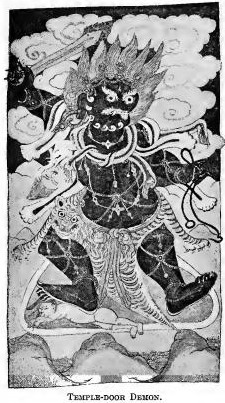 Entering the vestibule,
Entering the vestibule,
we find its gateway guarded by several fearful figures. 1These usually are —
1. The tutelary demon
of the ground, usually a
red devil (Tsan) a brawny-
limbed creature of elabor-
ate ugliness, clad in skins,
and armed with various
weapons, and differing in
name according to the locality. 2
2. Especially vicious demons or dii minores of a more or less local character. Thus, at Pemiongchi is the Gyal-po S’uk-den with a brown face and seated on a white elephant. He was formerly the learned Lāma Sod-nams Grags-pa, who being falsely charged with licentious living and deposed, his spirit on his death took this actively malignant form and wreaks his wrath on all who do not worship him — inflicting disease and accident.’ 3
1 Compare with description of Chinese Budd. temples by EITEL, Lects. on Buddhism. 2 Thus the local devil of Ging temple near Darjeeling is called ” The Entirely Victorious Soaring Religion” (Ch’os-ldin rnam-rgyal). 3 Compare with the malignant ghost ,of Brāhmans in India. Cf .TAWNEY’s Katha Sarit Sāgara,ii.,388, 511
3. A pair of hideous imps, one on either side, of a red and bluish-black colour, named S’em-ba Marnak rKi-kaṅ. who butcher their victims.
Guardian King of the West.( Virūpaksha.)
4. Here also are sometimes portrayed the twelve Tan-ma — the aerial fiendesses of Tibet, already figured, who sow disease and who were subjugated by St. Padma.
Confronting the visitor in the vestibule are the four colossal images (or frescoes) of the celestial kings of the Quarters, who guard the universe and the heavens against the attacks of the Titans and the outer demons, as described at page 84. They are clad in full armour and are mostly of defiant mien, as seen in their figures over the page and at pages 83 and 330. Two are placed on each side of the doorway.
Sometimes the guardian of the north is given a yellow, and the guardian of the south a green, complexion, thus suiting the complexion of the guardians to the mythic colours of the cardinal
points. They are worshipped by the populace, who credit them with the power of conferring good luck and averting the calamities due to evil spirits. And in the vestibule or verandah are also sometimes displayed as frescoes the Wheel of Life and scenes from the Jātakas or former births of Buddha ; and here also may be figured the sixteen great saints or Sthavira (Arhans or
” Rahans “).1
In the smaller temple- which possess no detached chapels for larger prayer-barrels, one or more huge prayer-barrels are set at either end of the vestibule, and mechanically revolved by lay- devotees, each revolution being announced by a lever striking a bell. As the bells are of different tones and are struck alternately, they form at times a not unpleasant chime.
The door is of massive proportions, sometimes rudely carved and ornamented with brazen bosses. It opens in halves, giving entry directly to the temple.
Such grand cathedrals as those of Lhāsa will be described presently. Meanwhile let us look at a typical temple of ordinary size. The temple interior is divided by colonnades into a nave and aisles, and the nave is terminated by the altar — generally as in the diagram-plan here annexed. The whole of the interior, in whichever direction the eye turns, is a mass of rich colour, the walls to right and left being decorated by frescoes of deities, saints, and demons, mostly of life-size, but in no regular order; and the beams are mostly painted red. picked out with lotus rosettes and other emblems.
1 For their descriptions and titles see p. 376 Amongst the common scenes also represented here are “The Harmonious Four ” (mt’un-pa mam b’zi), ; a happy family, of an elephant, monkey, rabbit, and parrot ; and the long-lived sage (mits’e-riṅ ) with his deer, comparable to the Japanese (?) Ju-ro, one of the seven genii of Good Luck, and the long-lived hermit, Se-nin
The brightest of colours are used, but the general effect is softened in the deep gloom of the temple, which is dimly lit only by the entrance door.
Above the altar are placed three colossal gilt images in a sitting attitude, “The Three Rarest Ones,” as the Lāmas call their trinity; though none of the images are considered individually to represent
Diagrammatic Ground-plan of a Temple in Sikhim.
the two other members of the Tri-ratna or ” Three Gems,” namely Dharma or Sangha. The particular images of this triad depend on the sect to which the temple belongs ; Ṣākya Muni is often given the central position and a saint (Tsoṅ K’a-pa or Padma-sambhava) to the left of the spectator and Avalokita to the right. Particulars and figures of the principal of these idols are given in the chapter on images.
Ṣākya Muni is figured of a yellow colour with curly blue hair, and often attended by standing figures of his two chief disciples, Maugdalayāna on his left and Ṣariputra on his right, each with an alarm-staff and begging-bowl in hand. In the temples of the unreformed sects, St. Padma-sambhava and his two wives are given special prominence, and many of these images are regarded as ” self-sprung : ”
“No hammers fell, no ponderous axes rung ;
Like some tall palm the mystic fabric sprung.” 1
But even this order of the images is seldom observed. Most frequently in the Ge-lug-pa temples Tsoṅ K’a-pa is given the chief place, while in Ñiṅ-ma it is given to the Guru, and this is
justified by the statement put into his mouth that he was a second Buddha sent by Ṣākya Muni specially to Tibet and Sikhim, as Buddha himself had no leisure to go there. Sometimes Ṣākya’s image is absent, in which case the third image is usually the fanciful Buddha of Infinite Light, Amitābha, or Amitāyus, the Infinite Life. In many sectarian temples the chief place is given to the founder of the particular sect or sub-sect.
Ranged on either side of this triad are the other large images of the temple. Though in the larger fanes the more demoniacal images, especially the fiendish ” lords “and protectors of Lāmaism, are relegated to a separate building, where they are worshipped with bloody sacrifices and oblations of wine and other demoniacal rites inadmissible in the more orthodox Buddhist building. Some of such idol-rooms are chambers of horrors, and represent some of the tortures supposed to be employed in hell.
The alleged existence of images of Gorakhnāth in Tashiding, Tumlong, and other Sikhim temples 2 is quite a mistake. No such image is known. The name evidently intended was ” Guru Rinbo-ch’e.”
1 HEBER’s Palestine . 2 CAMPBELL, J.A.S.B.,1849; HOOKER, Him. Jours., i.. 323; ii., p. 195; Sir R. TEMPLE, Jour., p.212; Sir M.WILLIAMS, Buddhism, p.490.
The large images are generally of gilded clay, and in Sikhim the most artistic of these come from Pa-to or ” Paro” in Bhotan. A few are of gilded copper and mostly made by Newaris in Nepal. All are consecrated by the introduction of pellets of paper inscribed with sacred texts as detailed in the chapter on the pantheon.
Amongst the frescoes on the walls are displayed numerous Lāmaist saints and the pictorial Wheel of Life, though this last is often in the vestibule.
There are also a few oil-paintings of divinities framed, like Japanese Kakemonos, in silk of grotesque dragon-patterns with a border, arranged from within outwards, in ” the primary ” colours in their prismatic order of red, yellow, and blue. Some of these pictures are occasionally creditable specimens of art.
The seats for the several grades of officials and the Lāmaist congregation are arranged in definite order. The general plan of a small temple interior is shown in the foregoing diagram. Along each side of the nave is a long low cushion about three inches high, the seat for the monks and novices. At the further end of the right-hand cushion on a throne about 2.5 feet high sits the abbot or professor (Dorje Lo-pon), 1 the spiritual head of the monastery.
Immediately below him, on a cushion about one foot high, is his assistant, who plays the sī-ñen cymbals. Facing the professor, and seated on a similar throne at the farther end of the left-hand cushion, is the Um-dse 2 or chief chorister or celebrant, the temporal head of the monastery ; and below him, on a cushion about one foot high, is the deputy chorister, who plays the large ts’ogs-rol or assembly-cymbals at the command of the Um-dse, and officiates in the absence of the latter. At the door-end of the cushion on the right-hand side is a seat about one foot high for the provost-marshal, who enforces discipline, and on the pillar behind
his seat hangs his bamboo rod for corporal chastisement. During the entry and exit of the congregation he stands by the right side of the door. Facing him at the end of the left-hand cushion, but merely seated on a mat, is the water-man.
To the left of the door is a table, on which is set the tea and soup which is to be served out, by the yet passed boy-candidates, during the intervals of worship.
1 rdo-rje slob-dpon. 2 dbU-mdsad.
THE LĀMAS TABLES.
To the right front of the altar stands the chief Lāma’s table, 1 about two-and-a-half feet in length, and one foot in height, and often elaborately carved and painted with lotuses and other sacred symbols, as figured at page 215. Behind it a cushion is placed, upon which is spread a yellow or blue woollen rug, or a piece of a tiger or leopard skin rug, as a seat. The table of the abbot or professor contains the following articles in the order and position
shown in this diagram : — 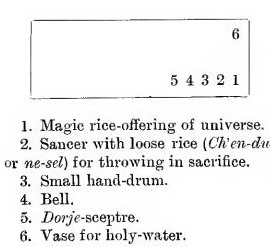 The other two monks who are allowed tables in the temple are the chief chorister or celebrant and the provost -marshal. The chief chorister’s table faces that of the abbot, and contains only a holy water vase, bell, dorje and the large cymbals. The table of the provost stands in front of the seat of that officer,near the door, and contains an incense-goblet (sang-bur), a bell and dorje.
The other two monks who are allowed tables in the temple are the chief chorister or celebrant and the provost -marshal. The chief chorister’s table faces that of the abbot, and contains only a holy water vase, bell, dorje and the large cymbals. The table of the provost stands in front of the seat of that officer,near the door, and contains an incense-goblet (sang-bur), a bell and dorje.
1. Magic rice-offering of universe. . *2. Saucer with loose rice (Ch’en-du or ne-sel) for throwing in sacrifice.3. Small hand-drum. 4. Bell 5. Dorje-sceptre.6. Vase for holy-water.
At the spot marked ” 13″ on the plan is placed the lay-figure of the corpse whose spirit is to be withdrawn by the abbot. At the point marked ” 12″ is set, in all the larger temples in Sikkim, the throne of the king, or of the re-incarnated Lāma — the “protecting lord”‘ 2 — when either of them visits the temple.
On each pillar of the colonnade is hung a small silk banner with five flaps, 3 and others of the same shape, but differently named, 4 are hung from the roof, and on each side of the altar is a large one of circular form.5
THE ALTAR AND ITS OBJECTS.
The altar 6 occupies the upper end of the nave of the temple ;and on its centre is placed, as already mentioned, the chief image.
1 mdum-lc’og 2 Kyab-mgon. 3 Ka-‘p’an. 4 Ba-dan 5 p’ye-p’ur, 6 mch’od s’am.
THE ALTAR.
Above the altar is suspended a large silken parasol, 1 the
Altar (domestic) of a Ñiṅ-ma Lāma.
oriental symbol of royalty, which slightly revolves in one or
Umbrella-Canopy.
other direction by the ascending currents of the warm air from
1 dug.
the lamps. And over all is stretched a canopy, called the “sky” 1 on which are depicted the thunder dragons of the sky.
The altar should have at least two tiers. On the lower and narrow outer ledge are placed the offerings of water, rice, cakes, flowers and lamps. On the higher platform extending up to the images are placed the musical instruments and certain other utensils for worship, which will be enumerated presently.
or sometimes upon the
altar itself, stands the
temple-lamp, 2 a short
pedestalled bowl, into
a socket in the centre
of which is thrust a
cotton wick, and it is
fed by melted butter.
As the great mass of butter solidifies and re-mains mostly in this state, the lamp is practically a candle. The size varies according to the means and the number of the temple votaries, as it is an act of piety to add butter to this lamp. One is necessary, but two or more are desirable, and on special occasions 108 or 1,000 small lamps are offered upon the altar. Sometimes a cluster of several lamps form a small candelabrum of the branching lotus-flower pattern.
1 nam-yul but its more honorific title is bla-bras 2 mch’od-skoṅ.
Below the altar stand the spouted water-jug 1 for filling the smaller water-vessels, a dish to hold grain for offerings, 2 an incense-holder, and a pair of flower-vases. And on the right (of the spectator) on a small stool or table is the magic rice-offering, with its three tiers, daily made up by the temple attendant, and
 symbolic of an offering of all the continents and associated islands of the world.
symbolic of an offering of all the continents and associated islands of the world.
The ordinary water and rice-offerings are set in shallow brazen bowls, 3 composed of a brittle alloy of brass, silver, gold and pounded precious stones. Their number is five or seven, usually the former. Two out of the five or seven bowls should be filled with rice heaped up into a small cone ; but as this must be daily renewed by fresh rice, which in Tibet is somewhat expensive, fresh water is usually employed instead.
Another food-offering is
a high, conical cake of
dough, butter and sugar,
variously coloured, named
torma or z’al-ze, that is, Sacred Cakes.
“holy food.” It is placed on a metal tray supported by a tripod. To save expense a painted dummy cake is often
Upon the top of the altar are also usually placed the following objects, though several of them are special to the more demoniacal worship :
1. A miniature funereal monument. 4
1 ch’ab-bum. 2 nas bzeḍ. 3 mch’od tiṅ. 4 ch’orten. In the room in which worship is done there must be present these three essential objects : sku-gsum (Skt., Trikāyā ) (a) an image, (b) a ch’orten, and (c) a holy book, which are symbolic of ” the Three Holy Ones.” In the early Indian caves this triad seems to have been represented by (?) a Caitya for Buddha, and a Wheel for Dharma.
2. One or more sacred books on each side of the altar.
3. The Lāmaist sceptre or Dorje, typical of the thunderbolt of Indra (Jupiter), and a bell. The dorje is the counterpart of the bell, and when applied to the shoulder of the latter should be of exactly the same length as the bell-handle.
4. The holy-water vase 1 and a metal mirror hanging from its spout. The holy-water of the vase is tinged with saffron, and is
sprinkled by means of a long stopper-rod, which is surmounted by a fan of peacock’s feathers and the holy kusa grass. Another form is surmounted by a chaplet, etc., as its frontispiece.
5. The divining-arrow bound with five coloured silks called dādar 2 for demoniacal worship.
6. A large metal mirror 3 to reflect the image of the spirits.
7. Two pairs of cymbals. The pair used in the worship of Buddha and the higher divinities are called sī- ñen,4 and are of about twelve or more inches in diameter, with very small central bosses. They are held vertically when in use, one above the other, and are manipulated gently. The pair of cymbals used in the worship of the inferior deities and demons are called rol-mo, and are of shorter diameter with very much broader bosses. They are held horizontally in the hands and forcibly clanged with great clamour. Chinese gongs also are used.
8. Conch-shell trumpet (tuṅ 5),often mounted with bronze or silver, so as to prolong the valves of the shell and deepen its note— used with the sī- ñen cymbals.
1 k’rus-bum See fig. Rock., L., 106 2 m-dar 3 me-long. 4 sil-smyan. 5 duṅ\
Devils’ Altar
9. Pair of copper flageolets. 1
10. Pair of long telescopic copper horns in three pieces, 2 and often six feet long (see illustration on page 17).
11. Pair of human thigh-bone trumpets. 3 These are sometimes encased in brass with a wide copper flanged extremity, on which are figured the three eyes and nose of a demon, the oval open extremity being the demon’s mouth. In the preparation of these thigh-bone trumpets the bones of criminals or those who have died by violence are preferred, and an elaborate incantation is done, part of which consists in the Lāma eating a portion of the skin of the bone, otherwise its blast would not be sufficiently powerful to summon the demons.
12. Pair of tiger thigh-bone trumpets. 4 These are not always present, and the last three instruments are only for the worship of the inferior gods and demons.
13. Drums (ch’os rṅa) : —
(a) A small rattle hand-drum or ṅa-chun 5 or damāru, like a large double egg-cup. Between its two faces are attached a pair of pendant leather knobs and a long-beaded flap as a handle.
When the drum is held by the upper part of the cloth handle and jerked alternately to right and left the knobs strike the faces of the drum. It is used daily to mark the pauses between different forms of worship.
(b) The big drum,called ch’o-ṅa, 6 or religious drum. These are of two kinds, one of which is suspended in a frame and beat only occasionally and in Buddha’s worship. The other is carried
in the hand by means of a stem thrust through its curved border. These are beaten by drum-sticks with straight or curved handles.
(c) The human skull-drum made of skull-caps, and of the same style as the smaller drum (a) above described.
14. Libation jugs, figured on page 225.
THE CATHEDRAL OF LHĀSA.
The greatest of all the temples of Lāmadom is the great cathedral of Lhāsa, the St. Peter’s of Lāmaism, the sketch of which, here given, was drawn for me by a Lāma artist, who visited Lhāsa with this object, and who deliberately sketched the sacred city and its great temple from the hillock about half a mile to the south of the city. And with the description of it 7 we will close our account of temples.
This colossal temple, called “The Lord’s House” (Jo-wo K’aṅ).
1 rgye-glin, 2 rag-dun. 3 rkan-glin. 4 stag dun. 5 rna-ch’un. 6 ch’os-rna. 7 Summarized from the accounts of Huc, etc., and from Koppen, ii.. 334.
stands in the centre of the city of Lhāsa, to which it gives its name, ” (God’s place ; 1 and it is also considered the centre of the whole land. All the main roads, which cut through Tibet, run out of it and meet again in it. But it is also the centre of the united Lāmaist church, as it is the first and oldest Buddhist temple of Tibet, the true metropolitan cathedral of Lāmaism. Founded in the seventh century, on commencing the conversion of the gloomy snow land, by King Sroṅ Tsan Gampo, for the preservation of those wondrous images brought to him by his two wives, as before mentioned, it has, no doubt, in the course of a millennium, received many additions and enlargements, and in the seventeenth century it was restored and rebuilt.
Its entrance faces the east, and before it, in a square, stands a flagstaff, about forty feet high with yak’s hair, and horns of yak and sheep, tied to its base. The main building is three storeys high, and roofed by golden plates. 2 The entrance is in the shape of a hall, which rests on six wooden pillars, very handsomely decorated with engravings, paintings, and gilding. The walls are covered with rough pictures out of the biography of the founder of the religion. In the centre of the hall is a swing door, which is decorated on the outside with bronze, and on the inside with iron reliefs.
Through this you pass into the ante-court, which is covered by the first storey. In the wall, opposite the entrance, is a second door, which brings you inside, on both sides of which stands the colossal statues of the four great guardian kings ; two on the right and two on the left side. This brings us into a large pillared hall, which has the form of the basilica, and is divided by colonnades into three long and two cross-aisles. The light comes from above in the middle or broadest aisle, where a transparent oilcloth serves instead of glass. Through this the whole temple is lighted, because there are no side windows. On the outside of the two
1 The name Lhāsa is properly restricted to the great temple. Sroṅ Tsan Gampo appears to have been the founder of the city now generally known to Europeans as Lhāsa. It is recorded that he exchanged the wild Yarlung valley, which had been the home of his ancestors, for the more central position to the north of the Tsangpo, a village named Rasa, which, on account of the temple he erected, was altered to Lhā-sa, or ” God’s place.” An old form of the name is said to be Lnga-Ldan. 2 These plates are said to be of solid gold, and gifted by the son of the princeling Ananmal, about the end of the twelfth century CE.
side aisles, i.e., on the north and south side, as the entrance is towards the east, is a row of small cells or chapels, fourteen to the right and just as many to the left. The two cross-aisles form the background, and are separated from the long aisle by silver lattice-work. Here are the seats of the lower priests for common prayer-meetings.
From the west cross-aisle a staircase leads into the holy of holies. On the left of this we see, by ascending behind silver rods, fifteen plates of massive silver, which are covered with
innumerable precious stones, and contain representations of the Buddhist dogmatises and mysticism. We see there, for instance, the Buddhist system of the world, the circle of the metempsychosis
1 After Giorgi. l have not reproduced the references as they are not sufficiently concise.
with its different states. From the stairs above we come into a cross-aisle, which has just as many pillars as the two lower ones, and is also the inner front hall of the sanctuary. The latter has the form of a square, in which are six chapels, three on each of the north and south flanks. In the middle is the place for the offering altar, which, however, is only erected on certain occasions. On the other side of the altar, on the west side of the holy of holies, also in the lowest depth of the whole edifice, is the quadrangular niche, with the image of Ṣākya Muni. Before the entrance in this, to the left, is raised the throne of Dalai Lāma, very high,
richly decorated, and covered with the customary five pillows of the Grand Lāmas. Beside this stands the almost similar one of the Tashi Grand Lāma; then follow those in rotation of the regenerated Lāmas The abbots, and the whole non-incarnate higher priesthood have their seats in the cross-aisle of the sanctuary. Opposite the throne of Dalai Lāma, on the right from the entrance of the niche, is the chair of the king of the Law, not quite so high as those of the regenerate Grand Lāmas, but higher than those of the others. Behind him are the seats of the four ministers, which are not so high as those of the common Lāmas.
On the west side of the niche stands the high altar, which is several steps high. Upon the top of the higher ones we see small statues of gods and saints made of massive gold and silver ; upon the lower ones, as usual on Buddhist altars, lamps, incensories, sacrifices, and so on ; upon the highest, behind a silver gilt screen, the gigantic richly-gilded image of Buddha Ṣākya Muni, wreathed with jewelled necklaces as native offerings. This image is named ” The gem of majesty ” (Jo-vo Rin-po-ch’e), and represents Buddha as a young prince in the sixteenth year of his age. It, according to the opinion of the believers, was made in Magadha during Buddha’s lifetime, and afterwards gifted by the Magadha king to the Chinese emperor in return for assistance rendered against the Yavan invaders ; and given by the Chinese emperor to his daughter on her marriage with the king of Tibet, in the seventh century CE. Flowers are daily showered upon it. Beside this one — the highest object of reverence — the temple has also inumerable other idols ; for instance, in a special room, the images of the goddess Ṣrī Devi (Pal-ldan Lha-mo). There is also a celebrated image of the Great Pitying Lord — Avalokita —
named ” the self-created pentad.” 1 Also images of historical persons who have made themselves worthy of the church ; amongst whom one sees there the aforesaid pious king and his two wives, all three of whom are canonized ; also his ambassador, who was sent by him
to India to fetch from there the holy books and pictures. 2
In this large and oldest temple are lodged great numbers of other precious things and holy relics, consecrated presents, gold and silver vessels, which are openly exhibited at the beginning of the third Chinese month.
Round about these stand many wooden or copper prayer-machines. The surrounding wings of the building contain the state-treasures, the magazines, in which are stored everything necessary for divine service, the monks’ cells, the lecture-rooms ; in the higher storeys also the residences of the highest state officers, and special rooms for the Dalai Lāma. The whole is surrounded with a wall, at which are several Buddhist towers, which, as in the case of the large temple, are covered with gilded plates. No women are allowed to remain within the walls during the night, a prohibition which extends to many Lāmaist cloisters.
1 raṅ byuṅ lṅa-ldan. So called because it is reputed to have formed itself by emanations from : Thug-je ch’enpo (Avalokita ), T’ul -ku-geyloṅ— the artist, Sroṅ Tsan Gampo, his Chinese wife, and his Newari wife. Ami the location of each of these in the image is pointed out. 2 Koppen -says an image of Hiuen Tsiang is also there.
Grand Lāma blessing Pilgrims. 1
SHRINES, RELICS, AND PILGRIMS.
PILGRIMAGES are most popular in Tibet. The country contains an infinite number of sacred sites, reputed re-incarnated or supernatural Lāmas, self-created images, relics of the Buddhas, holy footprints, sanctified trees, etc., to which the pious throng with gifts of gold and other precious offerings ; while many extend their pilgrimages to places outside Tibet, to China, Bhotan, Sikhim, Nepal, Kashmīr, Turkestan, and India, to places hallowed by St. Padma-sambhava, or by Buddha himself.
The most holy of all sites, according to the Lāmas, in common with all Buddhists — like Mecca to the Muhammadans — is the Tree of Wisdom at Buddh-Gayā, in India, with its temple known to Tibetans as Gandhola, 2 where Ṣākya Muni attained his Buddha-
1 After Giorgi. 2 dri-gtsaṅ -k’aṅ, or ” The Untainted (pure) House.” It was built in seven days by the high-priest ” Virtue ” (dge-ba). See also Tāranātha, 16, 4, etc. At the Bodhimaṇḍa (byaṅ-ch’ub-sñiṅ-po) is the diamond-throne (vajrāsana, Tib., Dorje-dan), so called on account of its stability, indestructibility, and capacity of resisting all worldly shocks.
hood, and which is believed to be the hub of the world. After this come the site of Buddha’s death, Kuṣinagara ; and the eight great Caityas which enshrined his bodily relics ; the mythical mount Potala 1 in the south; the mythical Shambhala in the north ; the Guru’s Fairy-land 2 in Udyāna in the west ; and ” The three hills,” or U-tai Shan, in northern China, the original seat of the God of Wisdom, Mañjuṣṛī ; and Lhāsa, the St. Peter’s of the Lāmas, and the seat of Buddha’s vice-regent upon earth.
The Indian shrines are seldom visited by Lāmas and Tibetans on account of the great distance and expense. I have listened several times to the prayers of Lāmas and Tibetan laity at the great Buddh-Gayā temple, which, strange to say, is still held by unsympathetic Hindū priests who prey upon the Buddhist pilgrims.
These prayers were divided
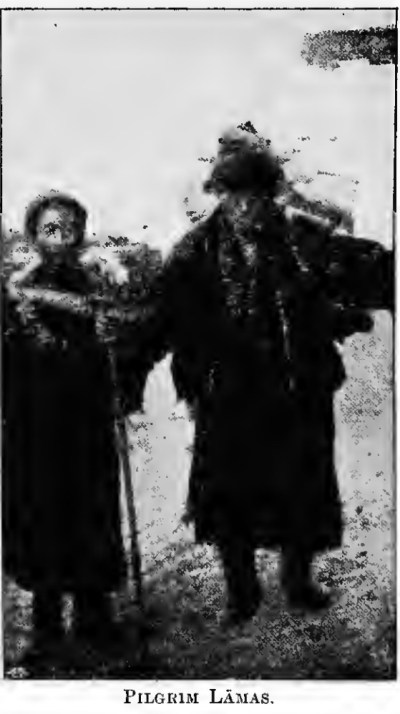 between petitions for temporal prosperity and for “the great ultimate perfection,” or Nirvana. They make offerings to the Tree of Wisdom, but their oblations do not take the form of watering it with eau de Cologne and gilding it, as do some of the Burmese.
between petitions for temporal prosperity and for “the great ultimate perfection,” or Nirvana. They make offerings to the Tree of Wisdom, but their oblations do not take the form of watering it with eau de Cologne and gilding it, as do some of the Burmese.
At the shrines under Buddhist management, the pilgrims carry off, as relics, printed charms and fragments of the robes of re-incarnated Lāmas and other holy men, leaves of sacred trees, etc.,which are carefully treasured as amulets and fetishes. And these objects and holy water work most miraculous cures in a manner which is not unknown even in Christian Europe. 3
1 ri-bo gru-‘dsin. 2 mk’ā-‘gro gliṅ. 3 Those Europeans who sneer at the ” pagan ” superstitions of the East may find amongst themselves equally grotesque beliefs. For example, the Holy Coat of Treces, and one of the most recent miracles, the Lady of Lourdes. Lourdes, as a miracle place,dates from 1858, when a little girl had a vision of “a beautiful and radiant lady.”Eighteen times the glorious apparition was seen by the girl ; then it was seen no more. Twenty thousand persons by that time had gathered to the rendezvous. On one of the last occasions the girl, as if obeying a sign from her visitant, went to a corner of the grotto where the appearances occurred, and scratched in the dry earth. The gaping crowd saw water rise and the girl drink. Then a little streamlet made its way to the river. In a short time the spring gave 120,000 litres a day. And the wonders of miraculous healing effected by this water are the theme of the learned and the ignorant alike. In 1872 the number of pilgrims amounted to 140,000, and this year the same number appeared at the health-giving spring. Over 12,000 brought 1 100 sick. They had come from Paris and the north in seventeen pilgrimage trains and this year (1894), according to the newspapers, two train-loads steamed out of London for the same convent. There is a band of trained attendants, who do good service, and the sick are dipped by experts and cared for. As the patient is immersed, some of the assistants, with arms uplifted, pray with him. Some of the sick quietly undergo the dip, as if resigned to whatever may befall them.
Others beat the water in agony, and clutch at hands near, but all pray—these last with loud cries of despair to heaven: ” Cure us, Holy Virgin. Holy Virgin, you must cure us.” There is great ecclesiastical ceremonial, elevation of the host, priests with lighted tapers, and high dignitaries be-robed and be-mitred. “The cures ” are duly certified—they are as marvellous as any by a well-advertised specific.
The fullest Tibetan account of Indian shrines is found in the book named Jambu-gliṅ spyi bs’ad, a compilation containing a very confused abstract of Hiuen Tsiang’s celebrated treatise. 1 In regard to the site of Buddha’s death, the Lāmas have placed it in Assam.
In conversations some years ago with Lāmas and lay Buddhists at Darjeeling, I was surprised to hear that Assam contained a most holy place of Buddhist pilgrimage called ” Tsam-ch’o- ḍuṅ ,” 2 which, it was alleged, next to the great temple at Buddh-Gayā, was the most holy spot a Buddhist could visit. Assam is usually regarded as being far beyond the limits of the Buddhist Holy Land, and the Chinese pilgrims, FaHian and Hiuen Tsiang in the fifth and seventh centuries of our era, to whom we are mainly indebted for our knowledge of ancient Buddhist geography, not only do not mention any holy site in Assam, but Hiuen Tsiang, who visited Gauhaṭī at the invitation of the king of Kāmrūp, positively notes the absence of Buddhist buildings in Assam. 3
I therefore felt curious to learn further particulars of this important site in Asam, which had apparently been overlooked by geographers.
1 For a translation of a smaller one see my article in Proc. A.S.B., Feb., 1893. 2 rTsa-mch’og-groṅ. See J.A.S.B., lxi., pp.33 seq. 3 Si-yu-ki, trans, by Beal, ii., p. 196.
In Jaschke’s Tibetan dictionary1 I found the name ” rTsa- mch’og-groṅ ” defined as a ” town in west Asam where Buddha died,” and this statement, it is noted, is given on the authority of the ” Gryalrabs,” a vernacular history of Tibet. Csoma de Koros also notes 2 that “the death of Shakya, as generally stated in the Tibetan books, happened in Asam near the city of Kuṣa or Cama-rūpa (Kāmrūp).”
Here, then, was a clue to the mystery. Buddha’s death, it is well known, occurred between two sāl trees near Kuṣinagara or K’uṣanagara, in the north-west provinces of India, thirty-five miles east of Grorakbpur, and about one hundred and twenty miles N.N.E. of Benares ; and the site has been fully identified by Sir A. Cunningham 3 and others from the very full descriptions given by Hiuen Tsiang and FaHian. The name Kuṣanagara means ” the town of Kusa grass ” ; 4 and as the early Lāma missionaries in their translation of the Buddhist scriptures habitually translated all the Sanskrit and Pali names literally into Tibetan, Kuṣanagara was rendered in the “Kah-‘gyur” canon as “rTsa-mch’og-groṅ,” from “rtsa-mch’og,” kuṣa grass, ” grong,” ‘ a town ( = Sskt., nagara).
Now, near the north bank of the Brahmaputra, almost opposite Gauhaṭī, the ancient capital of Kāmrūp, is, I find, an old village named Sāl-Kuṣa, and it lies on the road between Gauhaṭī, and Dewangiri, one of the most frequented passes into Bhotān and Tibet. With their extremely scanty knowledge of Indian geography, the Lāmas evidently concluded that this ” town of Sāl-Kuṣa, ” was the “town of Kusa,” where Buddha entered into Nirvāṇa between the two sāl trees — seeing that the word sāl was also incorporated with the equivalent of ” Tsam-ch’o-duṅ,” and that in the neighbourhood was the holy hill of Hājo, where, as will be seen hereafter, there probably existed at that time some Buddhist remains.
1 P. 437. 2 Asiatic Researches, XX, p. 295. 3 Arch. Surv. India Repts., i., 76; xvii.,55, etc.4 Kusa grass (Poa cynosuroides), the sacrificial grass of the Hindūs, is also prized by the Buddhists (in account of its having formed the cushion on which the Bodhisattva sat under the Bodhi tree. It is also used as a broom in Lāmaist temples and as an altar decoration associated with peacock’s feathers in the pampa or holy water vase.
No description of this Buddhist site seems to be on record, except a very brief note by Col. Dalton 1 on the modern Hindū temple of Hājo, which shrines a Buddhist image. So as I have had an opportunity of visiting the site, and enjoyed the rare advantage of being conducted over it by a Lāma of eastern Tibet who chanced to be on the spot, and who had previously visited the site several times, and possessed the traditional stories regarding it, I give the following brief description of it in illustration of how the Lāmas, originally misled by an identity of name, have subsequently clothed the neighbourhood with a legendary dress in keeping with the story of Buddha’s death, and how this place, with its various associated holy spots, is now implicitly believed by the pilgrims to be the real site of Buddha’s parinirvāṇa.
And in this belief, undeterred by the intemperate heat of the plains, Buddhist pilgrims from all parts of Bhotān, Tibet, and even from Ladāk and south-western China visit these spots and carry off scrapings of the rocks and the soil in the neighbourhood, treasuring up this precious dust in amulets, and for placing beside their dead body, as saving from dire calamities during life, and from transmigration into lower animals hereafter. Authentic specimens of this dust, I was informed, commanded in Tibet high prices from the more wealthy residents, who had personally been unable to undertake the pilgrimage.
The Hājo hill, or rather group of hills, where is situated, according to the current tradition of the Lāmas, the spot where Buddha ” was delivered from pain,” lies to the north (right) bank of the Brahmaputra about nine miles north-west from Gauhaṭī (Kāmrūp), north latitude 26° 11′ 18″ and east long. 91° 47′ 26″, and four or five miles north of Sāl-Kuṣa. The hill rises directly from the plain, forming a strikingly bold and picturesque mass ; and it is a testimony to its natural beauty to find that the hill has attracted the veneration of people of all religious denominations. The semi-aboriginal Mech and Koch worship it as a deity under the name of Hājo, which means in their vernacular ” the hill.” The Buddhists formerly occupied one of the hillocks, but are now displaced by the Brāhmans, who restored the temple, which is now one of the most frequented Hindū temples in Asam. The Muhamrnadans also have crowned the summit of the highest peak with a mosque.
The cluster of hills presents a very symmetrical appearance as seen from a distance, forming a bold swelling mass culminating in three trident-like peaks, the central one of which is pre-eminent, and is regarded by the Buddhists as emblematic of Buddha.
1 J.A.S.B., 1855, lxxi., p. 8,
The high peaks on either side of this are identified with Buddha’s two chief disciples,
Sāriputra and Maudgalyayāna, This triad of peaks is seen from a great distance, and it is only on near approach that the smaller hillocks are observed. These latter number about sixteen, and are called Ne-ten c’u-du, or ” the sixteen disciples ” of Buddha.
The most holy site, according to the Buddhists, is a bare flattish shoulder of rock, about eight yards in diameter, situated at the north-west base of the hill. This is stated to be the Sil-wa ts’al-gi tur-do, or ” the pyre of the cool grove,” where Buddha died, and where his body was cremated. The rock here bears several roughly-cut inscriptions in Tibetan characters of the mystic sentences, ” Om maṇi padme hūṃ,” ” Om ah hūṃ ” ” Om” etc., and coloured rags torn from the vestments of the pilgrims are tied to the bushes in the neighbourhood. The Hindūs have carved here on the rock a figure of the four-armed Vishnu, which the Brāhman priests call Dhūbī , or ” the washerwoman of the gods,” and the rock they call “Letai dhupinir pāt.”
It is worthy of note that the Lāmas, for the benefit of the resident population of Tibet, have made copies of this spot in at least four places in Tibet, viz., at : —
1. Ra-rgyab, in the south-east outskirts of Lhāsa city.
2. P’a-poṅ k’ar, in the north suburbs of Lhāsa.
3. Pur-mo c’he, about twelve miles to the north-east of Tashi-lhunpo.
4. Sel-brag
These sites were consecrated by placing on them a piece of rock brought from this Asam site, now under report ; but the latter spot bears the distinctive prefix of Gyā-gar, or Indian, implying that it is the original and genuine site.
A high cliff, close to the west of this spot, is called ” the vulture’s mound hill,” as in Tibet vultures usually frequent the neighbourhood of the tur-do cemeteries, and in belief that it is the Gridha Kuta Giri hermitage of Buddha. 1
A short distance beyond this spot, in the jungle, is a roughly-hewn stone basin, about six feet in diameter, called by the Lāmas “ Saṅ-gyāmā ko-ko”, or the pot in which the S in-je — the death-demons — boil the heads of the damned. The Brāhmans, on the other hand, assert that it is the bowl in which Ṣiva or Adi-purusha brewed his potion of lust-exciting Indian hemp, and they point to its green (confervoid) watery contents in proof of this. They also state that a snake inhabits the depths of the bowl; but it was certainly absent at the time of my visit.
Advancing along the pathway, Leading up-hill, we pass a few columnar masses of rock lying near the path, which are pointed to as fragments of Buddha’s staff with which he unearthed this monster bowl.
1 bya-rgyod p’uṅ poī rī
Climbing up the hill we reach the temple of Kedāranāth, which is approached by a very steep roughly-paved causeway. At the entrance is a long inscription in granite in old Bengālī characters, those being the characters adopted by the Asamese. Adjoining this temple is the shrine of Kamalesvar or ” the lord of the Lotus.” Here is a tank called by the Lāmas ” Tso mani bhadra,” or ” the lake of the notable gem ” ; and they state that many water-sprites (Nāga, serpents or dragons) came out of this pond on the approach of Buddha and presented him with jewels. A small cell by the side of this pond is said to be the place where Buddha set down a mass of butter which had been brought to him as a gift, and the stone linga and yoni (phallus and its counterpart), now enshrined here by the Hindūs, are pointed to as being this petrified butter.
Crowning the summit of the hill is a large masjid built by Lutfullah, a native of Shirāz, in the reign of the emperor Shāh Jahān, in 1656 C.E., with a Persian inscription. 1
A detached conical hillock, about 300 feet above the plain, lying about half-a-mile to the north-east of the hill, and now crowned by the Hindū temple of Mādhava, is identified with ” the great caitya ” which was erected over the cremated relics of the Tathāgatha’s body.
The present shrine of the temple seems to be the original shrine of an older Buddhist temple, which, according to both Buddhist and Asamese tradition, formerly existed here — the upper portion only is modern. Col. Dalton has described the general details of this building, and he states: ” The Brahmans call the object of worship Mādhab, the Buddhists call it Mahāmuni, the great sage. It is in fact simply a colossal image of Buddha in stone. Its modern votaries have, to conceal mutilation, given it a pair of silver goggle-eyes and a hooked gilt silvered nose and the form is concealed from view by cloths and chaplets of flowers ; but remove these and there is no doubt of the image having been intended for the ‘ ruler of all, the propitious, the asylum of clemency, the all-wise, the lotus-eyed comprehensive Buddha.'”
This large image of Buddha is called by the more learned Lāma-visitors Munir Muni Mahāmuni, i.e., “The Sage of Sages, The Great Sage.” It is the original image of the shrine, and is stated by the Brāhmanic priests, who call it Mādhab, to be of divine origin and an actual embodiment or avatar of the god, in contradistinction to the other images which are called mere “ mūrtis ” or hand-fashioned copies of typical forms of the respective gods represented. This may merely mean that the Brahmans found this image here, while the others were brought from the neighbourhood or elsewhere. What seems to be the history of the mutilation of this image is found in the account of the invasion of the Koch kingdom of lower Asam by the Musalmans under Mir Jumlah in 1661 a.d. This chief issued ” directions to destroy all the idolatrous temples and to erect mosques in their stead To evince his zeal for religion, the general himself, with a battle-axe, broke the celebrated image of Narain, the principal object of worship of the
1 See J.A.S.B., lxi., p. 37.
Hindūs of that province.” 1 Nārāyana is one of the names of Mādhab and a patronymic of the Koch raja’s ; and Hajo was a seat of the Koch rājas. And it was at Hājo that Mīr Jumlah took the Koch king prisoner. 2
The other images, not mentioned by Dalton, but which must have existed at the time of his visit, are also of stone and are placed on either side of the large image. They are four in number and are of considerable size. According to the Lāma-pilgrims they are all Buddhist
images ; but the crypt was so dimly lit, and the images so enveloped in clothes and wreaths of flowers that I could not distinguish their specific characters, with the exception of the head and peculiar trident of the first, and the head of the second, which were characteristic and justified their recognized names, viz. : —
No. 1. — –Ugyan Guru to the left of Mahāmuni.
No. 2. — Dorje Dol’o to the right of Mahāmuni.
No. 3. — Sākya Thuba to the right of No. 2.
No. 4. — ” Sencha ” Muni to the right of No. 3.
Although Hindū priests, as a rule, are not very methodical in their bestowal of names upon the images which they have appropriated from Buddhist ruins, still I here give the Brāhmanical names as reported by the attendant priests, as, this being a wealthy temple, the priests were more learned than usual, and the names should give some idea of the nature of the images. After stating that the Buddhist pilgrims gave the above noted names to the images, these priests said that the Brāhmanical names were as follows, which, it will be noticed, are Bengali.
I give them in the order of the previous list : —
No. 1. Dwitīya Mādhaver mūrti.
No. 2. Lāl Kanaiyā Bankat Vihārer mūrti.
No. 3. Basu Dever mūrti.
No. 4. Hayagrīver mūrti.
In the vestibule are lotus ornamentations and several articles of the usual paraphernalia of a Buddhist temple, including the following: A pyramidal framework or wheel-less car like the Tibetan Ch’aṅ-ga chutuk, with lion figures at the corners of each tier, such as is used to seal the image of a demon which is to be carried beyond the precincts of the temple and there thrown away. The present frame is used by the priests of this temple to parade in the open air one of the smaller images of the shrine (? Hayagrīver), but the image is again returned to the shrine. Above this throne is stretched a canopy containing the figure of an eight-petal led lotus flower, and has, as is customary, a dependant red fringe. On either side is hung a huge closed umbrella. These articles have been in the temple from time immemorial. Of the external decoration of the temple, the row of sculptured elephants along the basement, evidently a portion of the old Buddhist temple, has been figured by Col. Dalton in the paper above referred to ;
1 STEWART’s History of Bengal, p. 289. – BEVERIDGE, Col. Review, July. 1890, p.12.
and is identical with the decorative style of the Kailas cave temple of Ellora figured by Fergusson in Plate xv. of his Cave Temples. The upper walls are covered with sculptured figures nearly life-size. The ten avataras of Vishnu are represented with Buddha as the ninth. The remaining figures are of a rather nondescript character, but they are mostly male, and nearly every figure carries a trident (trisula) — the khatam of the Buddhists. The Lāmas state that these figures were formerly inside the temple, but that Buddha ejected them. And it is stated that the temple was built in one night by Viṣvakarma, the Vulcan of the Hindūs and Buddhists.
Attached to the temple is a colony of Naṭī, or dancing girls, 1 who are supported out of the funds of the temple, and who on the numerous feast days dance naked in a room adjoining the shrine. These orgies are part of the Sākti worship so peculiar to Kāmrūp, but nowhereis it so grossly conducted as at this temple. 2 The Naṭī and the idol-car are also conspicuous at the degenerate Buddhist temple of Jagannāth at Puri.
At the eastern base of the hillock, on which this temple stands, is a fine large tank, called by the Lāmas ” the lake of excellent water.” 3 This pond, it is said, was made by Buddha with one prod of his staff, when searching for the huge bowl already described which he unearthed here. This pond is also said to be tenanted by fearful monsters.
I have been unable to ascertain positively whether any Buddhist building existed here previous to the Lāmas fixing on the site as the Kuṣanagara of Buddha’s death. Certainly no monastery existed here at the time of Hiuen Tsiang’s visit to the Kāmrūp (Gauhaṭī) court in the seventh century CE., for he says of this country that “the people have no faith in Buddha, hence from the time when Buddha appeared in the world even down to the present time there never as yet has been built one Saṅghārāma as a place for the priests to assemble.” The reference which Tāranātha 4 makes to the great stupa of Kuṣanagara as being situated here, in Kāmrūp, was taken from report, and thus would merely show that the present Lāma-tradition was current during his time. Any caitya or other Buddhist building would seem to have been subsequent to the seventh century ; and in all probability marked a site visited by the great founder of Lāmaism, St. Padma-sambhava, or one of his disciples. The different accounts of this saint’s wanderings vary considerably, but he is generally credited with having traversed most of the country between lower Asam and Tibet. And in this view it is to be noted that the Bhotān Lāmas call the chief
1 ” Asam, or at least the north-east of Bengal (i.e., Kāmrūp), seems to have been in a great degree the source from which the Tantrica and Sākta corruptions of the religion of the Vedas and Purānas proceeded” (H. H. Wilson, Preface to Vishnu Purāna). 2 They have their counterpart in the story of the Greek Strabo : viii., 6, p. 20.
3 Yon-ch’ab-mts’o. 4 VASSILIEV’s Le Bouddisme, trad, du Russe par M. G. A. Comme, p. 44.
image of this shrine Namo Guru or “the teacher,” one of the epithets of St. Padma-sambhava. And the images on either side of it are also forms of that saint.
The form of Buddhism here represented is of the highly Tantrik and demoniacal kind, propagated by Padma-sambhava and now existing in the adjoining country of Bhotān. Even this mild form of the image of Ogyan Guru has decapitated human heads strung on to his trident. The second image is of a more demoniacal kind. The third image is, of course, Ṣākya Muni. The fourth image, from its Brāhmanical name, is Tam-din Skt.. Hayagrīva), one of the fiercest forms of demons and an especial protector of Lāmaism. The trident is everywhere conspicuous in the hands of the sculptured figures on the walls, and Shakti rites are more pronounced here than in any other place in northern India. 1
It is also remarkable to find that the high-priest of the Hājo temple, in common with the other high-priests in Kāmrūp, is called Dalai, — a title which is usually stated to have been conferred on the fifth Grand Lāma of Lhāsa by a Mongolian emperor in the seventeenth century CE. ; though the Tibetan equivalent of this title, viz., Gyam-ts’o, or ” ocean,” is known to have been used by Grand Lāmas previously. As, however, the word is Mongolian, it is curious to find it naturalized here and spontaneously used by Brāhmans. It seems also to be the title of village-headman in the adjoining Garo hills. The dalai of this temple is a married man, but the office is not hereditary. He is elected by the local priests from amongst their number, and holds office till death. He resides at the foot of the hill, below the temple, in a large house, the exterior of which is profusely decorated with the skulls of wild buffalo, wild pig, deer, and other big game, etc., like the house of an Indo-Chinese chieftain.
”There does not seem to be in Tibet,” says Mr. Fergusson, 2 “a single relic-shrine remarkable either for sanctity or size, nor does relic-worship seem to be expressed either in their architecture or their religious forms,” and he supports this by saying that as their deity is considered to be still living, no relics are needed to recall his presence.
Certainly no immense mounds of the colossal proportions common in Indian Buddhism, and in Burma and Ceylon, appear to exist in Tibet, but smaller stūpas are of very common occurrence; and the tombs of the departed Grand Lāmas at Tashi-lhunpo, etc., are special objects of worship.
It is said that Tibet possesses several large stūpas as large as
1 Dancing girls appear to figure to some extent in certain Lāmaist ceremonies in Bhotān,vide TURNER’s Embassy to Tibet, p. 32. 2 Hist. of Ind. Ind. and Eastern Architecture, p. 311.
the Maguta stūpa of Nepal. This latter is one of the celebrated places of Lāmaist pilgrimage outside Tibet. It is called the Ja1-ruṅ k’a-ṣor ch’o-rten, and lies about two miles to the north-east of Kathmandu, and it is figured at page 262. Immense numbers of Tibetans, both Lāmas and laity, visit the place every winter, and encamp in the surrounding field for making their worship and offerings, and circumambulating the sacred spot. It is the chief place of Lāmaist pilgrimage in Nepal, attracting far more votaries than the Svayambhūnāth stūpa, 2 which is not far distant. Its special virtue is reputed to be its power of granting all prayers for worldly wealth, children, and everything else asked for. Dr. Buchanan-Hamilton, in his account of Nepal, written about the beginning of the present century, gives a drawing of the monument, which is of an almost simple hemispherical form, of the type of the earliest stūpas ; and Wright, 3 under the title of ” temple of Bodhnāth,” gives a rough chromo-lithograph of its more modern appearance, with its additional buildings and investing wall. But no description or account of the monument seems to be on record.
As I have obtained a copy of the printed booklet which is sold at the stūpa to the pilgrims, I here give a short abstract of its contents, which are interesting as showing how the stupa is
brought into intimate relation with the chief legendary and historic persons of early Lāmaism. The print is a new revision by Punya-vajra and another disciple of ” the great Lāma Z’ab-dkar.” This latter Lāma, I am informed, lived about thirty years ago, and gilded the short spire of the stupa and built the present investing wall.
The book states as follows : — ” This stūpa enshrines the spirit of the Buddhas of the ten directions, and of the Buddhas of the three times (i.e., the present, past and future), and of all the Bodhisats, and it holds the Dharma-kāya.
1 Spelt pya. 2 Called by the Lāmas ‘P’ags-pa Sin Kun (or ? Zan-bkod) ; cf. also Svayambhū purāna,transld., J.R.A.S., 1894, 297. Another stūpa not far off, namely, about ten miles S.E. of Bhātgaon, and twelve from Kathmandu, is called sTags-mo-lus-sbyin, and identified as the site where Buddha in a former birth gave his body to a starving tiger, though the orthodox site for this story was really northern India, cf. FaHian, c. xi. 3 Nepal, pp. 22, 100. .
“When king Thi-Sroṅ Detsan 1 asked the Guru, 2 at Samyas, 3 to tell him the history of the Ma-gu-ta stupa in Nepal, made by the four Bona of ‘ the bestower of gifts,’ named ‘the poor mother Pya-rdsi-ma (fowl-keeper),’ then the Guru thus related (the story) : —
“‘In a former Kalpa — time beyond conception — the Bodhisattva Mahāsattva Avalokiteṣvara, approached the Tathāgatha Amitābha and prayed for the animals immersed in the miry slough, and after saving these he went to mount Potala. There he saw hosts of unsaved animals, innumerable like unto mounds of murwa 4 lees, and (seeing this he) wept. Two of his pitying tears were born into Indra’s heaven as god’s daughters, named respectively Kaṅ-ma and the little Kaṅ-ma or Kaṅ-ch’uṅ-ma. This latter having stolen in heaven some flowers,was as a punishment reborn in earth, in a low pig herder’s family in Maguta in Nepal, under the name of Samvara or ” the Chief Happiness,” her mother’s name being Puma. On marriage she had four sons, and her husband’s early death left her with the sole care of the family. She with her family undertook the herding and rearing of geese for the wealthy, and having in this pursuit amassed much wealth, , she — Ma-pya-rdsi-ma (or mother fowl-keeper)— decided to build a large stūpa in honour of the Tathāgatha. She, thereon, went to the king and begged for a site, saying she wanted only so much ground as one hide could cover. The king assented, saying “Ja-ruṅ,” which literally means” do ” + ” can,” i.e., “you can do (so).” 5 Then she cutting a hide into thin thongs (forming a long rope), enclosed that very large space which now is occupied by this caitya. And she, with her four sons, and a servant, and an elephant and an ass, as beasts of burden, brought earth and stones, and commenced to build this caitya by their own personal labour.
” ‘Then the king’s ministers appealed to the king to stop such an ambitious building, as they asserted its magnificence put to shame the religious buildings of the king and the nobles. But the king answered ” K’a-Sor” — which literally means ” mouth + (has) spoken” and so
refused to interfere. (Thus is the name of the stūpa — ‘ Ja-run K’a-Sor ‘ — accounted for.)
” ‘ After four years, when only the base had been laid, the mother died, but her sons continued the building till its completion. And in the receptacle was placed one Magadha measure (drona) of the relics of the Tathāgatha Kāśyapa. This event was celebrated by the manifestation in the sky, above the stupa, of Kāśyapa himself, and the circles of celestial Buddhas and Bodhisattvas, and their hosts of retinue, and
1 The king of Tibet who introduced Lāmaism. 2 i.e. Padma-sambhava, or Ugyan, the founder of Lāmaism.
3 The first Lāmaist monastery in Tibet 4 The millet seed(elusine crocanum), about the size of mustard seed, from which is made the Himalayan beer. 5 This story, and, indeed, the greater part of the legend, seems to have its origin in a false etymology of the the proper names.
amongst showers of flowers the gods contributed divine music and rained perfume. Earthquakes thrice occurred, and through the glory of the assembled divinities there was no darkness for five nights.
” ‘ One of the sons then prayed, ” May I in my next re-birth be born as a great scholar (to benefit mankind) ” — and he was born as Thunmi Sambhota 1 (the introducer of the so-called ” Tibetan ” character, and the first translator of Indian Buddhist texts into Tibetan), circa 650 CE.
” ‘ The second son prayed in a similar manner, and was re-born as “The Bodhisattva” 2 (the abbot of the first monastery of Tibet).
” ‘ Then the elephant or laṅ-po (hearing these prayers) said, ” These two, neglecting me who contributed so much assistance, are asking all the good things for themselves, therefore let me be re-born in a form to destroy them or their work.” And he was afterwards re-born as Laṅ-darma (the persecutor of Lāmaism).
” ‘ The third son, hearing the elephant’s request, prayed that he might be re-born in a form to neutralize the evil of the elephant’s incarnation; and he was born as Lho-luṅ phel kyi rdorje (the Lāma who murdered Laṅ-darma, the Julian of Lāmaism).’
” This stūpa is also worshipped by the Nepalese Buddhists, viz., the Newars — the semi-aborigines of the Nepal valley, and the Murmi, a cis-Himalayan branch of Tibetan stock. The name ‘ Maguta ‘ — pronounced ‘ Makuta ‘ — is doubtless a contraction for Makuta bandhana,
the pre-Buddhist ‘ crested chaitya,’ such as existed at Buddha’s death at Kusinagara, in the country of the Mallas.”
The Gyan-tse Caitya-temple is thus described 3 : —
It is nine storeys high, and is about 100 to 120 feet high and capped by a gilt dome. A magnificent view of Gyantse town and monasteries from top storey. Numberless niches filled with images of Buddha and Bodhisattvas. In the first floor is an image of the religious king Rabtan. The base is fifty paces square. It is only open to public at the full and new moon.
At those shrines holding or professing to hold relics the fiction of miraculous increase of the relics is frequently enacted. Thus at the Maguta stūpa and Tashiding Ch’orten are sold small granules, 4 alleged to be obtained by miraculous efflorescence on
1 Who introduced a written character to Tibet. 2 The Indian monk Ṣanta-rakshita, abbot of the first monastery of Tibet (Samyas). 3 SARAT’s Narrative 4 On the cremation of the body of a Buddha it is believed that no mere ash results, but, on the contrary, the body swells up and resolves into a mass of sago-like granules of two kinds, (a) Phe-duṅ, from the flesh as small white granules, and (b) ring-srel, yellowish larger nodules from the bones. It is the former sort which are believed to be preserved at the holiest Caitya of Sikhim, namely, Toṅ -wa raṅ grol, or ” Saviour by mere sight.” It owes its special sanctity to its reputedly containing some of the funereal granules of the mythical Buddha antecedent to Ṣākya Muni, namely Od-sruṅ, or Kāsyapa, the relics having been deposited there by Jik-mi Pawo, the incarnation and successor of St. Lha-tsun, the surface of the building from the legendary relics of the fictitious Buddha, Kāṣyapa, alleged to he enshrined therein. But this practice is common also to southern Buddhism. In the Burmese chronicles 1 it is stated that the tooth of Buddha, enshrined at Ceylon, yielded in the eleventh century CE.,to the Burmese king, “a miraculous incarnation or mysterious growth of homogeneous substances from the holy tooth,” and Col. Phayre adds ” and a somewhat similar mission with alike result occurred about twenty years ago (about 1860 CE.).
And in 1892 similar relics were sent from Ceylon to the Tibetan commissioner at Darjeeling. But, after all, such relics are no more spurious than the innumerable “bits of the true cross,” holy coats, and keys of St. Peter, of Christendom ; nor is their worship more remarkable than the vestiges of relic-worship which still survive in the structural features of our chancels, and the black-letter day of the Holy Cross in the calendar.
The temple of Buddha’s tooth at Fu-chau in China is also a known place of Lāmaist pilgrimage. The tooth is evidently an elephant’s molar.’ 2 That one also at the “Clear water P’u-hsein monastery” in western Ssū-ch’an seems to be somewhat similar. It is described by Mr. Baber as ” dense fossil ivory,” ” about a foot long, and of a rudely triangular outline.”
The sacred mountain of Wu-t’ai or U-tai in northern China, and the alleged birth-place of Mañjuṣṛī, now identified with the metaphysical Bodhisattva of Wisdom, is a favourite place of pilgrimage. It has been visited and figured by Huc and others. 3
On mount O in western Ssū-ch’an, at an elevation of about 11,000 feet, is to be seen ” The glory of Buddha” 4 — a mysterious apparition like the giant of the Brocken,”‘ which is seen occasionally by looking over the top of a cliff about 2,000 feet high into the terrible abyss below. It is a radiant halo of rainbow tints and it is deemed an emanation from the aureole of Buddha. The Tibetans visit the place.
1 PHAYRE’s History of Brit. Burma. 2 SIR HENRY YULE’s Marco Polo, iii, ch. xv., where it is figured after Mr. Fortune. 3 Visited and described also by Rev. J. Edkins (Religion in China), Gilmour, Reichthofen, Rockhill, and more fully described by D. Pokotiloff, St. Petersburg,1893. 4 in Chinese Fo-Kuang. Cf. BABER’s Suppl. Papers Geog. Soc.,p. 42. 5 BREWSTER’s Natural Magic, 1833., p. 180.
The sacred sites of Tibet are cited in considerable detail in the vernacular geography already mentioned. And stories abound of the miraculous efficacy of such pilgrimages, and even of the
manifestations of the divine spirit to worthy worshippers.
Thus a story is related regarding the great image of ” the Lord” at Lhāsa, which is a parallel to that of the widow’s mite : A poor old widow, destitute of friends and of means, made a long pilgrimage to Lhāsa, but had nothing left as an offering. By begging she ultimately obtained a morsel of butter, which she offered in a tiny lamp to the great idol. The god there-upon revealed himself through the idol, which thanked her for her gift, and spoke to her a few words of comfort. On this miracle getting noised abroad, a rich merchant set out for Lhāsa, arguing that if the Lord appeared to a poor woman who presented only one tiny lamp, he would certainly appear to the donor of a host.
80 he offered many thousands of lamps with tons of butter, but the idol remained impassive and irresponsive.
The circling of the great temple by prostrations on the ground is an essential part of the devotions, not only of the pilgrims but of the residents. The day’s devotions begin at Lhāsa with the gun-fire about 4 a.m. from the Chinese minister’s house, and they close with another gun at 9 or 10 p.m.
After the morning report the people are to be seen in dense crowds on the circular road, all moving in one and the same direction, as with the hands of a watch. A similar circuit is made by the devout in the evening, to say nothing of smaller circuits around individual shrines : at least this is imperative on common folk ; as to the great and wealthy, 1 they urge that their presence would only interfere with the piety of the people, so they engage substitutes, who, however, are rigorously required to circumambulate for their masters. But whether clone in person or by proxy, a careful reckoning is kept of the number of circuits performed, and these, in occasional cases of excessive devotion, are even executed by the method of successive prostrations full length on the road, each prostration beginning where the preceding one ended, called ” Kiang K’or.”
Of the places sacred to the Guru, the most celebrated is the ….
1 .Says A. K. (HENESSY’s Abstract, p. 293).
” Lotus lake ” (Ts’o Padma-c’an), on which he is believed to have been born. It is usually stated to be in Udyāna, but other accounts place it near Haridwar.1 In Nepal at Halāsi on the bank of the Dudh-Kusi is the famous hermitage of the Guru on a hill with many fossil remains, which from their description suggest the outlying Siwaliks range.
In the mountains, two days’ journey south of Gyang-tse, near the unreformed monastery of Ṣe-kar, is a celebrated rock-cut cave of St. Padma, called Kyil-k’or ta-ḍub. It is thus described’ 2 : — ” We took lighted lamps, and after going 120 paces inside the cavern we reached an open flat space about twenty feet square, from which a rock-cut ladder led us up to another open space about ten feet square ; thirty paces further brought us to a stone seat, said to be the seat of Guru Padma-sambhava. Behind the seat was a small hole drilled through the rock: through this hole a wooden spoon about two feet long was passed by the sister of the Lāma who accompanied us, and a small amount of reddish dust was extracted which is said to be the refuse of the Guru’s food. This we ate and found very sweet to the taste. Then after lighting some sacred lamps and asking a blessing, we descended by another flight of steps to a place where a stream issues from the face of the rock. The total length of the cave from the entrance of the stream is about a quarter of a mile. There are ascents and descents, and many turns and twists through narrow passages where only one man can go at a time, and many people are afraid to risk exploring the place, if the lamp were to go out there would be no finding the way back again.”
Colossal images of Jam-pa or ” The Loving One” (the Buddha to come), and sometimes of Avalokita are occasionally carved on cliffs. A monster image of the god Maitreya (Jam-pa), three storeys in height, is mentioned by explorer A. K. ; 3 the figure is internally of clay, and is well gilded externally; it is seated on a platform on the ground floor, and its body, passing successively through the second and third floors, –
1 one account given me says that three days from the town in northern India named Nirdun (? Dehra Dun) lies Ramnagar, thence four days Haraduar, where there is a railway station, thence on foot two days to Guruduar, whence Ts’o Padma is eight days distant amongst seven hills, like Mt. Meru. In regard to it. the Sham-bha-la Lam-yig contains the following passage: “At the city of the king Da-ya-tse of Pu-rang, in consequence of water striking against coal, at night the coal is seen burning, it is said of this coal and water, that they have the peculiarity that the water, if introduced into the stomach of man or beast, turns into stone” 2 Lāma U.G. S.R., loc.cit. p. 20. 3 HENESSY, S.R.,loc. cit., para 19. an image similar to this, thirty feet high, but of gilt copper, is noted by the Lāma U.G., loc. cit., p. 22. Lake at Roṅch’am Ch’en, near the crossing of the Tangpo, near Yam-dok.
terminates in a jewelled and capped colossal head above the latter floor ; in all, the figure
and platform are said to be seventy or eighty feet high. Now, as an essential feature in Tibetan worship is the performance of circuits around an image, it will be seen that the pilgrim in circling this image of Jam-pa is compelled by circumstances to perform three different series of circumambulations on as many floors ; at first around the god’s legs, next around his chest, and lastly around his head.
But, after all, the greatest pilgrimage to which a Lāmaist devotee looks is to the Buddhist-god incarnate at Lhāsa, the Grand Dalai Lāma.
Accounts of the culmination of such a pilgrimage have been recorded by Manning and others. The infant Grand Lāma, who received Manning, was altogether a prodigy. A reception by the Grand Tashi Lāma, one of the many witnessed by Mr. Bogle, is thus described by that gentleman 1 (see figure, page 305) : —
” On the 12th November, a vast crowd of people came to pay their respects, and to be blessed by the Lāma. He was seated under a canopy in the court of the palace. They were all ranged in a circle. First came the lay folks. Everyone according to his circumstances brought some offering. One gave a horse, another a cow ; some gave dried sheep’s carcasses, sacks of flour, pieces of cloth, etc. ; and those who had nothing else presented a white Pelong handkerchief. All these offerings were received by the Lāma’s servants, who put a bit of silk with a knot upon it tied, or supposed to be tied, with the Lāma’s own hands, about the necks of the votaries. After this they advanced up to the Lāma, who sat cross-legged upon a throne formed with seven cushions, and he touched their head with his hands, or with a tassel hung from a stick, according to their rank and character. The ceremonial is this : upon the gylongs or laymen of very high rank he lays his palm, the nuns and inferior laymen have a cloth interposed between his hand and their heads ; and the lower class of people are touched as they pass by with the tassel which he holds in his hand There might be about three, thousand people
1 Op. cit., p. 85. A grander reception is described by him at p. 98.
— men, women, and children — at this ceremony. Such as had children on their backs were particularly solicitous that the child’s head should also be touched with the tassel. There were a good many boys and some girls devoted to the monastic order by having a lock of hair on the crown of the head cropped by the Lāma with a knife. This knife came down from heaven in a flash of lightning.
. . . After the Lāma retired, many people stayed behind that they might kiss the cushions upon which he had sat.”
The ordinary receptions by his holiness have been described by the survey spy A. K. 1 Since his worshippers are in thousands, and it is only to those who are wealthy or of high degree that he can afford to address even a brief sentence or two, this is always done in a deep hoarse voice, acquired by training in order to convey the idea that it emanates from maturity and wisdom. Seated cross-legged on a platform some six feet high, he is dressed to be
worshipped in the usual colours of priesthood, i.e., red and yellow, and with bare arms, as required of all Buddhist priests, and holds a rod from the end of which hangs a tassal of silk, white, red, yellow, green, and blue. The pilgrim, coming in at the entrance door, advances with folded hands as if in prayer, and resting his head against the edge of the platform above him, mentally and hastily repeats the petitions he would have granted. These unuttered
prayers the Dalai Lāma is understood to comprehend intuitively ; he touches the pilgrim’s head with the bunch of silk in token of his blessing, and the worshipper is hurried out at the east door by attendants, only too happy if he has passed say half a minute in the vicinity of the great priest. This is the common procedure. Persons of rank or substance are permitted to mount the platform and to perform obeisance there, receiving the required blessing by actual touch of the Dalai Lāma’s hand ; subsequently such worshipper may be allowed a seat below the platform where a few hoarse utterances of enquiry may be addressed to him by the
Dalai Lāma, and he may also be given some food.
The account of one of these more select receptions, to which Baber Sarat gained admission in disguise, is here abridged from his narrative.
” We are seated on rugs spread in about eight rows, my seat being in the third row,
1 Loc. Cit., edited by HENESSY, para. 20.
at a distance of about ten feet from the Grand Lāma’s throne, and a little to his left. There was perfect silence in the grand hall. The state officials walked from left to right with serene gravity, as becoming their exalted rank in the presence of the supreme vice-regent of Buddha on earth. The carrier of the incense-bowl (suspended by three golden chains), the head steward, who carried the royal golden teapot, and other domestic officials then came into his holiness’s presence, standing there motionless as pictures, fixing their eyes, as it were, on the tips of their respective noses.
” The great altar, resembling an oriental throne, pillared on lions of carved wood, was covered with costly silk scarves ; and on this his holiness, a child of eight, was seated. A yellow mitre covered the child’s head, his person was robed in a yellow mantle, and he sat cross-legged, with the palms of his hands joined together to bless us. In my turn I received his holiness’s benediction and surveyed his divine face. I wanted to linger a few seconds in the sacred presence, but was not allowed to do so, others displacing me by pushing me gently. The princely child possessed a really bright and fair complexion with rosy cheeks. His eyes were large and penetrating. . . . The thinness of his person was probably owing to the fatigues of the ceremonies of the court, of his religious duties, and of ascetic observances to which he
had been subjected since taking the vows of monkhood. . . . When all were seated after receiving benediction, the head steward poured tea into his holiness’s golden cup from the golden teapot. Four assis- tant servers poured tea into the cups of the audience. Before the
Grand Lāma lifted his cup to his lips a grace was solemnly chanted. Without even stirring the air by the movements of our limbs or our clothes, we slowly lifted our cups to our lips and drank the tea, which was of delicious flavour. Thereafter the head butler placed a golden
dish full of rice in front of his holiness, which he only touched ; and its contents were then distributed. I obtained a handful of this consecrated rice, which I carefully tied in one corner of my handkerchief. After grace had been said, the holy child, in a low indistinct voice, chanted a hymn. Then a venerable gentleman rose from the middle of the first row of seats, and, addressing the Grand Lāma as the Lord Avalokita Incarnate, recited the many deeds of mercy which that patron saint of Tibet had vouchsafed towards its benighted people.
At the conclusion he thrice prostrated himself before his holiness, when a solemn pause followed ; after which the audience rose, and the Grand Lāma retired.
“One of the butler’s assistants gave me two packets of pills, and the other tied a scrap of red silk round my neck. The pills, I was told, were Chinlab (blessings consecrated by Buddha-Kashyapa and other saints), and the silk scrap, called sungdu (knot of blessing), was the
Grand Lāma’s usual consecrated return for presents made by pilgrims and devotees.”
” Since we left off to burn incense to the Queen of Heaven and to pour out drink-offerings to her, we have wanted all things and have been consumed by the sword and famine.” — Jeremiah xliv., 18. 1
Lāmaist mythology is a fascinating field for exploring the primitive conceptions of life, and the way in which the great forces of nature become deified. It also shows the gradual growth of legend and idolatry, with its diagrams of the unknown and fetishes ; and how Buddhism with its creative touch bodied forth in concrete shape the abstract conceptions of the learned, and, while incorporating into its pantheon the local gods of the country, it gave milder meanings to
the popular myths and legends.
The pantheon is perhaps the largest in the world. It is peopled by a bizarre crowd of aboriginal gods and hydra-headed demons, who are almost jostled off the stage by their still more numerous Buddhist rivals and counterfeits. The mythology, being largely of Buddhist authorship, is full of the awkward forms of Hindū fancy and lacks much of the point, force, and picturesqueness of the myths of Europe. Yet it still contains cruder forms of many of these western myths, 2 and a wealth of imagery.
Primitive Buddhism, as we have seen, knows no god in the sense of a Creator or Absolute Being ; though Buddha himself
1 Compare with the analogous Buddhist ” Queen of Heaven, “Tārā or Kwān-yin, pp. 435, etc
2 Cf. V. A. Smith ” On the Graeco-Roman influence on the Civilization of Ancient India,” J.A.S.B., 1891-92, p. 50, etc. Also Prof. Grunwedel, loc. cit.
seems to have been in this respect an agnostic rather than an atheist.
But, however, this may be, the earliest Buddhist mythology known to us gives the gods of the Hindūs a very prominent place in the system. And while rendering them finite and subject to the general law of metempsychosis, yet so far accepts or tolerates the current beliefs in regard to their influence over human affairs as to render these gods objects of fear and respect, if not of actual adoration by the primitive Buddhists.
The earliest books purporting to reproduce the actual words spoken by the Buddha make frequent references to the gods and demons. And in the earliest of all authentic Indian records, the edict-pillars of Asoka, we find that model Buddhist delighting to call himself ” the beloved of the gods.” The earlier Buddhist monuments at Barhut, etc., also, are crowded with images of gods, Yakshas and other supernatural beings, who are there given attributes almost identical with those still accorded them by present-day Buddhists. Every Buddhist believes that the coming Buddha is at present in the Tushita heaven of the gods. And the Ceylonese Buddhists, who represent the purer form of the faith, still worship the chief Indian gods and are addicted to devil-worship and astrology. 1
But the theistic phase of Buddhism carried objective worship much further than this. For as Buddha himself occupied in primitive Buddhism the highest central point which in other faiths is occupied by a deity, his popular deification was only natural.
In addition to the worship of Buddha, in a variety of forms, the Mahāyāna school created innumerable metaphysical Buddhas and Bodhisattvas whom it soon reduced from ideal abstractness to idolatrous form. And it promoted to immortal rank many of the demons of the Sivaist pantheon ; and others specially invented by
1 Rhys Davids, B., p. 7. ” In the courtyard of nearly all the wihāras (monasteries ) in Ceylon there is a small dewāla (or god-temple in which the Brāhmanical deities are worshipped. The persons who officiate in them are called Kapavas. They marry. The incantations they use are in Sanskrit (East. Mon., p. 201). The chief gods worshipped are Vishṇu, Kataragaina, Nāta who in the next Kalpa is to become Maitreya Buddha, and Pattini Deva. Other temples belong to tutelaries. e.g., Saman Deva, the tutelary of Buddha’s foot-print, Srī-pade (Rept. Service Tenures Commission, Ceylon, 1872, p. 62). It is probable that this Pattini is the tutelary goddess of Asoka’s capital, Patna. Cf. my Discovery of exact site of Pāṭaliputra, etc., 1892.”
itself as defensores fidei; and to all of these it gave characteristic forms. It also incorporated most of the local deities and demons of those new nations it sought to convert. There is, however, as already noted, reason for believing that many of the current forms of Brāhmanical gods were suggested to the Brāhman s by antecedent Buddhist forms. And the images have come to be of the most idolatrous kind, for the majority of the Lāmas and almost all the laity worship the image as a sort of fetish, holy in itself and not merely as a diagram or symbol of the infinite or unknown.
The Lāmaist pantheon, thus derived from so many different sources, is, as may be expected, extremely large and complex. Indeed, so chaotic is its crowd that even the Lāmas themselves do not appear to have reduced its members to any generally recognized order, nor even to have attempted complete lists of their motley deities. Though this is probably in part owing to many gods being tacitly tolerated without being specially recognized by the more orthodox Lāmas.
The nearest approach to a systematic list which I have seen, is the Pekin Lāma’s list so admirably translated by the late Mr. Pander, 1 but this, as well as all the other extant lists, is
defective in many ways and only fragmentary. The chief Tibetan treatises on the Lāmaist pantheon according to my Lāma informants, are : —
(a) Z’ā-lu Lo-tsa-wa’s, “The means of obtaining The Hundred (gods). 2 This is said to be the oldest of the extant systematic works on Lāmaist deities and seems to date from about 1436., when Z’ā-lu succeeded to the great Pandit Atīsa’s chair at Gāh-ldan monastery. Zhā-lu Lo-
ch’en,” the great translator,” states that he translated his description from one of the three great Indian works by Pandit Bhavaskanda entitled ” Slokas on the means of obtaining (tutelary and other deities).” 3 The term ” the hundred ” which occurs in the title of this
and the following treatises refers only to the chief divinities ; for the total number described is much greater.
(b) Pāri Lo-tsa-was ” The Hundred precious Manifestations of Narthang.” 4 This work issuing from the great press at Narthang near Tashi-lhunpo is said to deal mainly, if not solely, with those omitted by Z’ālu, and is placed about the sixteenth century.
1 Das Pantheon des Tschangtscha Hutuktu, etc. 2 sGrubs-t’ub brgya-rtsa. 3 Sgrub-t’ub ts’ig bc’ad, Skt. ? Sadanaṅ sloka. 4 rin-byuṅ sNar-t’aṅ brgya-rtsa.
(c) Tāranātha’ s “The Hundred precious Appearances.” 1 This work by the great historiographer Lāma Taranatha contains mainly residual deities omitted by the two previous writers ; but it is chiefly devoted to the more demoniacal forms.” This work dates from about 1600 CE. and was, I think, printed at Phun-ts’o-ling near Narthang ; but I omitted to note this point specially while consulting the book at Darjeeling.”
(d) The Dalai Lāma Ṅag-waṅ Lo-zaṅ Gya-ts’o’s “autobiography,” written in the latter half of the seventeenth century. In its mythological portion it describes chiefly those aboriginal Tibetan deities which had become grafted upon orthodox Lāmaism.
All the foregoing works have been consulted by me except the second or Narthang text, which seems to be the same book referred to by Pander. 4 The Pekin work translated by Pander and dating from 1800 CE., seems to have been a compilation from the above sources in regard to those particular deities most favoured by the Chinese and Mongolian Lāmas, though the descriptions with the Peking list are often meagre and frequently different in many details compared with the earlier work of Z’ā-lu.” Another book, also, it would seem, printed in China, was obtained by Mr. Rockhill. 6
I cannot attempt, at least at present, to give any satisfactory classification of such a disorderly mob, but I have compiled from the foregoing sources a rough general descriptive list, so as to give a somewhat orderly glimpse into this chaotic crowd of gods, demons, and deified saints.
Arranged in what appears to be the order of their rank, from above downwards, the divinities seem to fall under the following seven classes : —
1. Buddhas. — Celestial and human.
- Bodhisattvas. — Celestial and human, including Indian saints and apotheosized Lāmas.
3. Tutelarles. — Mostly demoniacal.
4. Defenders of the Faith, and Witches (Ḍākkinī).
5. Indian Brāhmanical gods, godlings, and genii.
6. Country gods (yul-lha) and guardians (sruh-ma), and Local gods.
7. Personal gods, or familiars.
1 Rin-‘byuṅ-brgya rtsa. 2 Gon-po, Skt., Nātha ; and Lha-mo, Skt., Kalī. 3 It may probably be a version of this work which Pander (Zeitschrift fur Ethnologie, p. 54, Berlin, 1889) refers to as published at Urgya by a successor of Tāranātha rJe-btsun gdam-pa. 4 Op. cit., p. 63. 5 With these lists may also be compared the illustrated Buddhist pantheon of the Japanese, Butzu dso-sui, reproduced in parts in Prof. J. Hoffman at Leyden in Siebold’s Nippon Archiv zur Beschreibung von Japan, Vol. V., and by Dr. W. Anderson in his admirable Catalogue of Jap. Paintings in British Museum. 6 It gives pictures of the gods and saints with their special mantras.
The tutelaries, however, overlap the classes above them as well as the next one below, and some of the ” guardians ” are superior to the Indian gods. The first four classes, excepting their human members, are mostly immortal, 1 while the remainder are within the cycle of re-births.
Before giving the list of these various divinities, and descriptive details of the images of the more important ones, let us look at the typical forms and attitudes, the material, and methods of execution of images in general.
The immense numbers of images abounding in Tibet are not confined to the temples, but are common in the houses of the laity, in the open air, as talismans in amulet-boxes, and painted or printed as screens, and on the title-pages of books, and as charms, etc.
The artists are almost exclusively Lāmas, though a few of the best idols in Lhāsa are made by Newari artisans from Nepal, who are clever artisans in metal and wood. Some also are painted by lay-artists, but such images must, be consecrated by Lāmas in order to be duly efficacious as objects of worship, for most of the images are credited with being materially holy, like fetishes, and capable of hearing and answering prayers. The mode of executing
the images, as regards the materials, the auspicious times to commence the image, and to form the most essential parts, such as the eyes, are all duly defined in the scriptures, whose details are more or less strictly observed. Many of the more celebrated idols are believed by the people and the more credulous Lāmas to be altogether miraculous in origin— ” self-formed,” or fallen from heaven ready fashioned. 2
The images are executed in various ways : as statues or bas-reliefs (sku) and medallions, and as pictures (sku-t’aṅ or z’al-t’aṅ). 3 The statues are sometimes of colossal size, 4 especially those of Maitreya, or “The coming Buddha,” which are occasionally rock-cut ; but most are less than life-size.
1 The Lāmas do not generally, as do the Nepalese Buddhists, restrict immortality to Ādi-Buddha. 2 The Hindūs entertain the same belief as regards their āp-rupi idols, which are mostly ancient Buddhist ones. 3 Lit. =flat + image. 4 Schlagintweit describes (Bud, p. 220) one of these colossal images at Leh as “the Buddha in Meditation,” and as higher than the temple itself, the head going through the roof. ” The body is a frame of wood, dressed with draperies of cloth and paper,the head, the arms, and the feet are the only parts of the body moulded of clay.”
Of statues the most common form is the plastic, 1 all of which are gilt or coloured. They are often cast, as bas-reliefs, in moulds, and are formed of coarse papier-mâché , or clay, bread-
dough, compressed incense, or variously-tinted butter, 2 and the larger ones have a central framework of wood. The plastic image or moulded positive is then dried in the sun — excepting, of course, those made of butter, -and it is afterwards painted or gilt.
The gilt-copper images 3 are more prized. The costly ones are inlaid with rubies, turquoises, and other precious stones. Less common are those of bell-metal, 4 while the poorer people are content with images of brass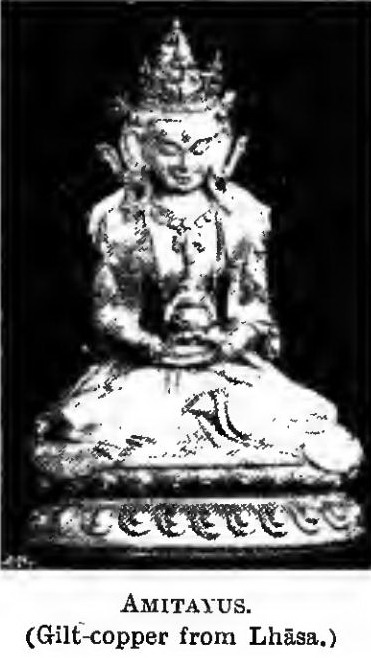
or simple copper. Wooden images 5 are not
common, and stone images 6 are least frequent
of all, and aremostly confined to the shallow
bas-reliefs on slabs, or rock-cut on cliffs.
Internal organs of dough or clay are sometimes
inserted into the bodies of the larger images,
but the headis usually left empty; and into
the more valued ones are put precious stones
and filings ofthe noble metals, and a few
grains of consecrated rice, a scroll bearing
“the Buddhist creed,” and occasionally other
texts, booklets, and relics. These objects are
sometimes mixed with the plastic material, but
usually are placed in the central cavity, the
entrance to which, called ” the charm-place,” ‘
is sealed up by the consecrating Lāma. 8 And
the image is usually veiled by a silken scarf. 9
Here also may be mentioned the miniature funereal images or
1 ‘jim-gzugs. 2 HUC’s Souv., ii.,p.95 :ROCKHILL, Land, i.. p. 69. In Ceylon temporary images are said to be made of rice.- HARDY’s East. Mon.,202 3 gser-zaṅs-sku. 4 li-ma. 5 S’ in-sku, 6 rdo-sku. 7 zuṅ-zhug. 8 This ceremony is called “rabs-gnas zhug-pa.” Cf. CSOMA, A., p.403. 9 The images of the fierce gods and goddesses especially are veiled. The veil covering the face of Devi is called ” Lha-moi zhab-k’ebs. It is a white silken scarf, about eighteen inches broad, with red borders about a foot wide. And on it are drawn in colours several of the auspicious symbols, the swastika, elephants’ tusks, conch, jewels, also the goad, etc., and the mystic spell Bhyo-?.
caityas, moulded of clay or dough, with or without the addition of
relics, 1 and corresponding to the dharma-ṣarira of the Indian stūpas, and mentioned by Hiuen Tsiang in the seventh century .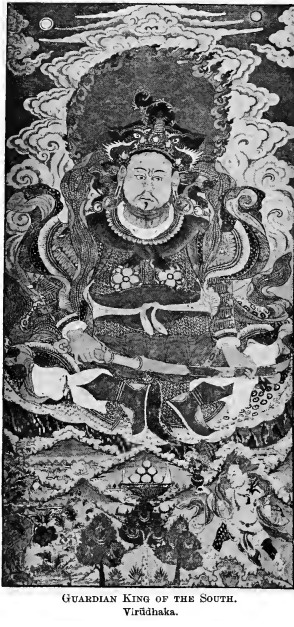
Small consecrated medallions of
clay are also given by the Dalai
and Tashi Grand Lāmas
to donors of largess, in
return for their gifts,
one of which is already figured .
The pictures are
mostly paintings, seldom
uncoloured drawings,
and many of them are
of considerable artistic
merit. The style and
Guardian King of the South or Virudhaka
technique are, in the main, clearly of Chinese origin. This is especially seen in the conventional form of clouds, water, etc.,though the costumes are usually Tibetan,when not Indian. The eye of the Buddhas and the more benign Bodhisattvas is given a dreamy look by representing the upper eyelid as dented at its centre like a cupid’s bow,
but I have noticed this same peculiarity in mediaeval Indian Buddhist sculptures.
1 Called sa-tsch’a.
THE PAINTINGS.
The paintings are usually done on cloth, frescoes 1 being mostly confined to the mural decoration of temples. The colours are very brilliant and violently contrasted, owing to the free use of crude garish pigments, but the general colour effect in the deep gloom of the temple, or when the painting is toned down by age, is often pleasing.
The cloth used is canvas or cotton — seldom silk. It is prepared by stretching it while damp over a wooden frame, to which the margin of the cloth is stitched ; and its surface is then smeared over with a paste of lime and flour, to which a little glue is sometimes added. On drying, its surface is rubbed smooth and slightly polished by a stone, and the drawing is then outlined either by hand with a charcoal crayon, or, in the more technical subjects, by
a stencil-plate consisting of a sheet of paper in which the pattern is perforated by pin-holes, through which charcoal dust is sifted.
The lines are then painted in with Chinese ink, and the other colours, which are usually crude pigments imported from China or India. The colours are simply mixed with hot thin glue, and as the picture is unvarnished, Lāmaist paintings are especially subject to injury by damp.
On completion, the artist puts a miniature figure of himself in a corner at the bottom in an adoring attitude. The painting is then cut out of its rough easel-frame, and it has borders sewn on to it, consisting of strips of coloured silk or brocade, and it is mounted on rollers with brazen ends, somewhat after the manner of a map or a Japanese Kakemono. 2 But it is not so elongated as the latter, nor is it so artistically mounted or finished.
The mounted Tibetan painting has a tricoloured cloth border of red, yellow, and blue from within outwards, which is alleged to represent the spectrum colours of the rainbow, which separates sacred objects from the material world. The outer border of blue is broader than the others, and broadest at its lowest border, where it is usually divided by a vertical patch of brocade embroidered with the dragons of the sky.
A veil is usually added as a protection against the grimy smoke of incense, lamps and dust. The veil is of flimsy silk, or often
1 ‘dabs-ris. 2 Cf. W. Anderson’s Catalogue Japanese Pictures; Nott and Gliddon, Indig. Races, 302
adorned with sacred symbols, and it is hooked up when the picture is exhibited.
Now we are in a position to consider the detailed description of the images. The various forms of images fall into characteristic types, which, while mainly anthropomorphic, differ in many ways as regards their general form, attitude, features, dress, emblems, etc., yet all are constructed, according to a special canon, so that there is no difficulty in distinguishing a Buddhist image from a Brāhmanical or a Jain.
The forms of images differ broadly, as regards the general type or mode of the image, the posture of the body (sedent or otherwise), and the attitude in which the hands are held, the number of arms, which are emblematic of power, and the symbols signia which they bear, as signifying their function. .
The general type of Buddha’s image is well-known. It is that of a mendicant monk, without any ornaments and with tonsured hair, and it is also extended to most of the mythical Buddhas. It is called the Muni or saint-type, 1 and it is usually represented upon a lotus-flower, the symbol of divine birth.
Extra to this type, the three others most common are: —
1st. “The Mild ” calm form (Z’i-wa 2 ) or Bodhisat type.
2nd. “The Angry ” type (T’o-wo3), of the ” Howler ” (Rudra and Marut), or Storm-deity of
Vedic times.
3rd. ” The Fiercest ” fiend type (Drag-po or Drags’e’ 4 ) ;
a fiercer form of No. 2, and including the ” lord “- fiends. 5
These latter two types are confined mainly to Tāntric Buddhism, which, as with Tāntric Hindūism, gives each divinity a double or treble nature with corresponding aspects. In the quiescent state the deity is of the mild Bodhisattva type; in the active he is of the Angry or Fiercest-fiend type. Thus the Bodhisattva Mañjuṣṛī, the (rod of Wisdom, in his ordinary aspect is a ” Mild ” deity (Z’i-wa ; as”The Fearful Thunderbolt” (Bhairava-vajra), he is an “Angry”
1 t’ub-bzugs. 2 Tibeto-Sanskrit dictionaries give ” Ṣiva” as well a* “Santi” as the Sanskrit equivalent of this word, so it may literally mean a mild form of the Ṣivaist gods. 3 K’ro-bo from the Skt. Krodha, anger. 4 Drags-po or Drag-gs’ed. 5 mGon-po Skt.Nātha
deity (T’o-wo) ; and as ” The six-faced dreadful King-demon,” 1 he is of ” The Fiercest Fiend ” type (Drag-po). 2
To avoid unnecessary repetition in the detailed descriptions, it seems desirable to give here a general note on these typical mild and demoniacal aspects, and also on the attitudes of the body and of the fingers.
The “Mild” (Z’i-wa) deities are of what has been called by some European writers “the Bod-
figured as young hand-
some Indian princes and
princesses, seated
usually on lotus thrones,
and are thus described
by Z’ā-lu : The figure
looks proud, youthful,
beautiful, 3 and refined.
The body emits a halo
of innumerable rays of
light, figured as radiat-
ing wavy lines, with
tremulous lines alter-
nating. The dress is
of the Indian style,
with one silk shawl for
the lower limbs, and
one for the upper, a
head ornament (or
crown) of precious
things, an ear-ring, a
close – fitting necklace,
and a doshal or garland
reaching down to the
thigh, and a Semondo
or shorter garland reach-
ing to the navel, an
armlet, wristlet, brace-
let, anklet, girdle (‘ok-
pags), and a sash (dar-
‘p’yaṅ) with fringes.
The above ornaments
are accounted thirteen.
Amitāyus.
The Buddha of Boundless Life.
1 gdoṅ -drug-ch’an. ‘jig-byed bdud-las rnara rgyal.
2 According to the rhyme :
rje-btsun ‘jam dbyaṅs k’ros-pa-ni
rdo-rje ‘jigs byed ‘jigs par byed,
k’ro-bor rgyal-po gdoṅ drug c’an.
3 For the (30 or 81) secondary beauties, cf. Burnouf’s Lotus, App., viii., Hardy’s Man., 367, Raj. L. Mitra’s Lalita Vist. For description of Hindū Idols, see Bṛihat Saṃhitā, translated by Dr. Kern, J.R.A.S.,vi., 322.
The hair of the gods is dressed up into a high cone named ral-pa’-t’or- tshugs, and the forehead usually bears the tilak or auspicious mark. The goddesses are given a graceful form with slender waist and swelling breasts, and their hair is dressed into plaits which lie on the hinder part of the neck, and they beam with smiles.
The ” Angry” type (T’o-wo) is terrible in its elaborate ugliness, with disproportionately large head, 1 scowling brows, and
and usually with a
third eye in the centre
of the forehead. 2
Z’ā-lu describes them
as fat, brawny-limbed,
and menacing in
attitude, standing or
half-seated upon some
animal, their lips
agape, showing their
great canine fangs,
and rolling tongue;
their wolfish eyes
are glaring, the
beards, eyebrows, and
hair are either
yellow, red, reddish-
yellow, or greyish-
yellow, and the hair
is erect, with
occasionally a fringe of
curls on the forehead,
believed by some to represent
coiled snakes. The females, as in
the annexed figure, 3 except for
their full breasts and the absence
of beards, do not differ in
appearance from the males.
Devi T. Lha-mo
1 Cf. SCHLAG B.,p. 222, for measurements of proportions of several of these images. 2 Trilocana, a character also of the Hindū Bhairava and Kālī and their demon troop of followers, the gana. 3 after Pander.
FIERCE DEITIES AND POSTURES.
All these fiends have six ornaments of human bones, namely (1) ear ornament, (2) necklet, (3) armlet, (4) bracelet, (5) anklet (but some have snake-bracelets and anklets), and (6) a garland of circular bodies fixed to bone-heads (seralkha), and corresponding to the semodo of the Z’i-wa, and occasionally they have a doshal garland. The foregoing is according to the Indian canon, but the Tibetan style enumerates for them thirteen ornaments, namely : (1 ) the raw hide of an elephant, as an upper covering, (2) skins of human corpses as a lower garment, (3) a tigerskin inside the latter, (4) Brāhma’s thread (ts’aṅ-skud), (5 to 10)
the six bone ornaments above noted, (11) Tilak mark on forehead, of blood, (12) Grease (Z’ag) on either side of mouth, and (13) ashes smeared over body.
The “Fiercest” Fiends— {Drag-po and Gon-po) closely resemble the above “Angry Deities.” They have usually chaplets
tongues of flames ; and they
tread upon writhing victims
and prostrate bodies.
As regards the Postures of
the images, the chief sedent
postures, and especially char-
acteristic of the several forms
of Buddha himself, and
secondarily of the celestial
Buddhas and Bodhisats are
as follows : —
(1) “The adamantine, un-
changeable, or fixed pose”
(Skt., Vajra (?) Palaṅa 1 ) sedent
in the well-known cross-legged
Buddha posture. The legs are
locked firmly and the soles
directed fully upwards. This
is the pose of deepest meditation
.., hence it is also called, when the
hands he loosely in the lap, the Sakya in Meditation.
” Dhyāna or meditative mudra.” –
(2) ” The Bodhisat-pose” (Skt.,Satva (?)palaṅa 2) differs from No. 1 in having the legs looser and unlocked. The soles are scarcely seen. This is the pose of first emergence from meditation.
(3) “ The sub-active pose ” (Skt. (?) Niyampalaṅa) 3 is emerged farther from meditation. It has the legs unlocked, the left being quite under the right, and the soles invisible.
1 rdo-rje skyil-druṅ. 2 Sems-dpa skyil druṅ. 3 Skyil dkruṅ chuṅ zad.
(4) “The Enchanter’s pose” (Skt., Lalita 1 ), i.e., after the manner of ” The Enchanter ” Mañjuṣṛī. Here the right leg hangs down with an inclination slightly inwards and the left is loosely bent.
(5) Maitreya’s pose. 2 Sedent in the European style with both legs pendant.
The chief attitudes of the hands and fingers (mudras 3 ) are the following, and most are illustrated in the figures : —
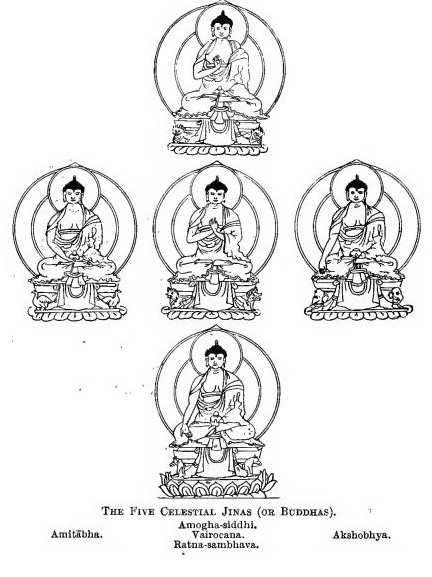
The Five Celestial Jinas (or Buddhas).
Amogha-siddhi.
Amitābha Vairocana Akshobhya.
Ratna Sambhava,
1. “Earth-touching,”‘ or (he so-called “Witness” attitude (Skt.,Bhūṣparṣa 4 ). with reference to the episode under the Tree of Wisdom, when Ṣākya Muni called the Earth as his witness, in his temptation by Mara. –
1 rol-ba bzugs. 2 byams bzugs. 3 p’yag-rgya, 4 sa-gnon
It affects only the right hand, which is pendant with the knuckles to the front. It is the commonest of all the forms of the sedent Buddha, and almost the only form found in Burma and Ceylon.It is also given to the celestial Buddha Akshobhya, as seen in the figure preceding.
2. “The Impartial” (Skt., Samāhitan 1 ), or so-called “meditative posture ” (Skt., Samādhi 2). Resting one hand over the other in the lap in the middle line of the body, with the palms upwards, as in Amitābha Buddha (see the attached figure).
3. “The best Perfection” (Skt., Uttara-bodhi 3 ). Index-finger and thumb of each hand are joined and held almost in contact with the breast at the level of the heart, as in the celestial Buddha Vairocana in the figure on the opposite page.
4. “Turning the Wheel of the Law” (Skt., Dharma-cakra 4 ). Dogmatic attitude with right index-finger turning down fingers of left hand, figured at page 134.
5. ” The best Bestowing ” (Skt., Varada 5 ). It signifies charity. The arm is fully extended, and the hand is directed downwards with the outstretched palm to the front, as in ” the Jewel-born” Buddha Ratna-sambhava, who is figured.
6. ” The Protecting,” or ” Refuge-giving ” (Skt., Ṣaraṇ 6 ). With arm bent and palm to front, and pendant with fingers directed downwards, as in No. 5.
7. ” The Blessing of Fearlessness ” (Skt.? Abhaya). The arm is elevated and slightly bent. The hand elevated with the palm to the front, and the fingers directed upwards, as in Amogha-siddha Buddha, figured over page. It is also the pose in the episode of the mad elephant.
8. “The Preaching” 7 differs from No. 7 in having the thumb bent, and when the thumb touches the ring-finger it is called “The triangular 8 (pose), see figure on page 5.
9. ” The Pointing Finger.” ” A necromantic gesture in bewitching, peculiar to later Tāntrism.
The halo, or nimbus, around the head is sub elliptical, and never acuminate like the leaf of the pipal or Bodhi tree (Ficus religiosa). The fierce deities have their halo bordered by flames (see
figure page 330). An additional halo is often represented as surrounding the whole body, as figured at pages 333 and 335. This consists of the six coloured rays of light, and it is conventionally represented by wavy gilt lines with small tremulous lines alternating.
Colour, too, is frequently an index to the mood. Thus, white and yellow complexions usually typify mild moods, while the red, blue and black belong to fierce forms, though sometimes light blue, as indicating the sky, means merely celestial.
1 mñam-bz’ag. 2 tiṅ-ṅe’dsin. 3 byaṅ-chub-mch’og. 4 ch’os ‘k’or-bskor. 5 mch’og-sbyin.
6 skyab-sbyin. 7 ch’os ‘c’ad. 8 pa-dan rtse gsum. 9 sdigs-dsub.
Generally the gods are pictured white, goblins red, and the devils black, like their
European relative.
The Buddhas and other divinities, as well as the superior devils, are figured upon a lotus-flower, a symbol of divinity. The lotus-flower, on which the Buddhas and mild divinities are
figured, is the red lotus (Nelumbium speciosum) ; while the fiercer divinities, including frequently Avalokita, and all those demons who are entitled to lotus-cushions, should have a pinkish variety of the white lotus (Nymphaea esculenta), the petals of which are much notched or divided, so as to resemble somewhat the Acanthus in Corinthian capitals. The blue lotus is the special flower of Tārā, but it is conventionally represented by the Lāmas as different from the Utpal (Nymphaea sp.), as figured on the opposite page.
A remarkable feature of most Tāntrik Buddhist images is the frequent presence of a Buddha seated on the head of the image
TABLE SHOWING
The Surmounting JINAS in Buddhist Images.
| JINAS. | Vairocana. | Akshobhya. | Ratnasam-bhava. | Amitābha. | Amogha-siddha. |
| Surmounted BUDDHAS. | Maitreya | Muni-vajrāsan | Amitāyus | Maitreya | |
| Surmounted BODHISATS. | ? Samanta-bhadraPrajña-pāra-mitā(pita)Vetuda-MarīcīMahāsahasranVijayaPita-VijayaSita-Ushṇīsha | Vajra-pāṇiMañjughosha(adhicakra)JñanasattvaMañjuṣṛīSitaPrajña-pāramitā | Ratna- pāṇiPita JambhalaPita Vaisra-vanaVasudhara” Kan-wa-bhadra” | AvalokitaPadma- pāṇiTārā | Viṣva- pāṇi |
| SurmountedKRODHA-fiends | Kāla-YamariSasmuka-YamaKāla-JambhalaAcala-KhrodarajaRi-khra-loma-gyon mar”Hun mdsad “Khroda raja“san-nags rje ‘dsin-ma”Mahā-pratyan-gira | Rakta-yakiha | HayagrīvaKrodhaAvalo-kita PitaBṛikuṭi(?’. Kal-pa)Kuru-kulle“ rTogs-pa las- junwa-Kuru-kulla”“gsilba tsal ch’en-mo” | Kuru-kulleMahā- Mayuri |
or amidst the hair. The existence of such surmounting images in the Tāntrik Buddhist sculptures of India was noted by Dr. Buchanan-Hamilton in his survey of Bihar 1 at the beginning of this century, but since his time the subject has attracted only
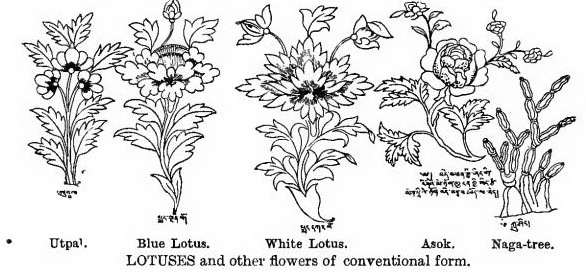 Utpal, Blue Lotus. White Lotus. Asok. Naga-tree.
Utpal, Blue Lotus. White Lotus. Asok. Naga-tree.
LOTUSES and other flowers of conventional form.
the merest incidental notice of writers on Indian Buddhist antiquities, 2 who seem to have considered all such images to be figures only of Avalokita, because Hiuen Tsiang mentioned that a certain image of Avalokita had Amitābha seated in his hair.
As the subject is interesting, and of some importance, I give in the table the results of my study of a large series of Lāmaist pictures containing such figures, and descriptions of others extracted from the works of Pandits ” gZ’onnu ” Gupta, Ṣrītāri, Kalamtāra, Lhan-skyes rolwa-kun-rigs, and Bhavaskandha.
The surmounting image represents the spiritual father of the particular Bodhisat or deity ; and he nearly always is one or other of the five Jinas, as the Tibetans term them, 3 or the Buddhas of Meditation (Dhyāni-Buddha), as they are called by the Nepalese Buddhists. In a few cases the coming-Buddha Maitreya is figured with Ṣākya Muni on his head, as indicating spiritual succession rather than parental relationship, but it is the latter which is the rule.
1 Eastern India, i. 2 India Archaeological Survey Repts.,by Sir A. Cunningham ; West India Arch. S. Repts., by J. BURGESS; Catalogue of Archaeolog. Collection in Indian Museum, by J.ANDERSON. 3 rgyal-ba rigs-lṅa — or “The Pentad Victors.” No one seems to have noticed this constant use by the Lāmas of the word Jina for the celestial Buddhas, whom the Nepalese term Dhyāni -Buddha, though it is interesting in regard to Jainism in its relations to Buddhism.
Occasionally the surmounting Jinas are represented by their mystic emblems of a wheel, vajra, jewel, lotus, or viṣva-vajra, as will be described presently. Thus Ratna-sambhava is usually represented by a jewel on the head of his spiritual reflex Jambhala, the god of wealth. And it is to be noted that when, as often happens, the image is surrounded by figures of the five Jinas in an arc outside the halo, then its own special surmounting parent occupies the central position in that arc, whilst the others are placed two on each side at a lower level.
| English Name. | Tibetan. | Sanskrit. |
| 1. a pikea trident | K’atvaṅK’a- ‘tvaṅ- rtse-gsum | khāṭvānga triṣūla |
| 2. hand-drum | Da-ma-ru | damaru |
| 3. chisel-knife | Gri-gug | Kartrikā |
| 4. thunderbolt | rDo-rje | vajra |
| 5. cross-thunderbolt | sNa-ts’ogs rdo-rje | viṣva-vajra |
| 6. rosary | Preṅ-ba | mālā |
| 7. Lotus-flower (white or red)blue lotus1Asoka-flower 1“Naga’s tree” (cactus or coral) 1 | Pad-maUt-palMya-ṅan-med pahi-shiṅkLu-shin | padma utpal aṣoka nāgā-taru |
| 8. alarm-staffbegging-bowl | K’ar-gail’Luṅ-bzed | hikile, or khakhara pa tra |
| 9. wish-granting gem | (Yid bz’in) Noi bu | (cintā-) maṇi |
| 10. flames | Me-ris, | |
| 11. snare 2 | z’ags-pa | pāṣa |
| 12. bell | dril-bu | ghanta |
| 13. wheel | ‘K’or-lo | cakra |
| 14. skull-cup | Tod-k’rag | Kapāla |
| 15. thunderbolt-dagger | p’ur-bu | Phurbu (?) |
| 16. spear | gDuṅ | |
| 17. club | Be-con | gadā |
| 18. dirk or dagger | ‘Chu-gri | |
| 19. sword | Ral-gri | adi |
| 20. axe | dGra-sta | paraṣu (?) |
| 21. hammer | T’o-ba mt’o-ba | mudgara |
| 22. iron -goad | lC’ags-kyu | |
| 23. mace | Ben | |
| 24. thigh-bone trumpet | r Kaṅ-duṅ | |
| 25. conch-shell trumpet | Dun | ṣaṅkha |
| 26. iron -chain | lChags-sgrog | |
| 27. skeleton -staff | dByug-pa | |
| 28. See No. 1 (a) | – | – |
| 29. water-potanointing vasefly-whiskbanner | Bum-pasPyi-glugsrṄa-yabrGyal-mts’an | kalāsa –chauridhvaja |
1 See figures on previous page. 2 To rescue the lost or to bind the opponents. A symbol of Ṣiva, Varuṇa, and Lakshmi.
The objects or insignia which the several figures hold in their hands refer to their functions. Thus, Mañjuṣṛī, the god of wisdom, wields the sword of the truth in dissipating the darkness of ignorance, and in his left he carries the book of Wisdom upon a Lotus-flower, thus symbolizing its supernatural origin ; and he rides upon a roaring lion to typify the powerfully penetrating voice of the Law.
The chief of these insignia and other objects held in the hands of the images are shown in the foregoing illustration x and are as follows ; the numbers in this list correspond to those in the figures. We now can look into the details of the principal members of the pantheon.
The vast multitude of deities forming the Lāmaist pantheon is, as already mentioned, largely created by embodying under different names the different aspects of a relatively small number of divinities with changing moods. Such expressed relationship, however, seems occasionally a gratuitous device of the Lāmas in order to bring some of their indigenous Tibetan deities into relationship with the earlier and more orthodox celestial Bodhisattvas of Indian Buddhism. But the various forms have now all become stereotyped, and even a trivial difference in title yields a different form of image. Thus the images of ” Maitreya ” and ” Bhrikuti ” differ much from those of ” Bhadraka Maitreya ” and “Arya Bhrikuti.” And different writers differ in some of the minor details in their description of some of these stereotyped forms. Thus we have images described as ” in the fashion of Nāgārjuna,” or of some one or other celebrated Indian monk or Lāma.
First in our classification come the Buddhas, human and celestial.
I. The Buddhas.
The innumerable forms of the Buddhas, the fabulous terrestrial, the celestial and metaphysical, are all, with a few exceptions, based upon the five conventional attitudes ascribed to the historical Buddha, as marking the chief episodes of his Buddhahood. Andof these ” the Witness attitude ” is in Tibet, as in Indian and southern Buddhism, the most common. Additional varieties are obtained by giving to these images different colours, ornaments, and symbols. Almost all are sedent in the well-known cross-legged attitude of Buddha’s image ; few are standing, and the recumbent or lying posture is very rarely seen in Tibet.
The typical Buddha is conventionally represented as a man of
342………..
…..386
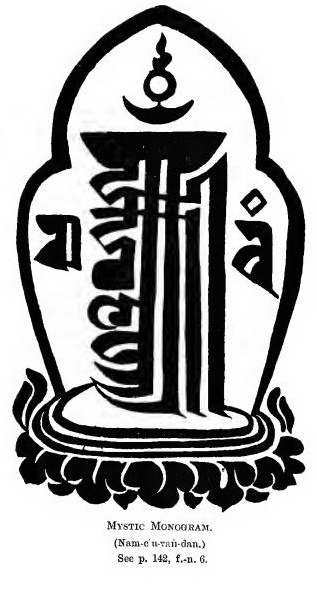
Mystic Monogram. (Nam-c’u-vaṅ-dan.)
GARUḌA YANTRA Charm.
XV. SACRED SYMBOLS AND CHARMS.
MOST religions of the present day teem with symbolism,which is woven so closely into the texture of the creeds that it is customary to excuse its presence by alleging that it is impossible to convey to the people spiritual truths except in material forms. Yet we have only to look at Muhammadanism, one of the great religions of the world, and still actively advancing, to see that it appeals successfully to the most uneducated and fanatical people, although it is practically devoid of symbolism, and its sanctuary is a severely empty building, wholly unadorned with images or pictures. People, however, who are endowed with artistic sense, tend to clothe their religion with symbolism.
The symbols proper, extra to the symbolic representations of the deities dealt with in the preceding chapter, are conventional signs or diagrams, or pictures of animals, mythological or otherwise, or of plants and inanimate objects ; and in Tibet they are very widely met with. They are painted or carved on houses and furniture, and emblazoned on boxes and embroidery, and on personal ornaments, trinkets, charms, etc.
The extremely rich symbolism found in Lāmaism is largely of Indian and Chinese origin. Its emblems are mainly of a conventional Hindū kind, more or less modified to adapt them to their Buddhist setting. Others are derived from the Chinese, and a few only are of Tibetan origin. These latter are mostly of a very crude kind, like the rebuses common in mediaeval England for the use of the illiterate.
In this place, also, we can most conveniently glance at the mystic value of numbers ; the ” magic-circle ” offering in effigy of the universe, etc., which enters into the daily worship of every Lāma ; and the charms against sickness and accidents, ill-luck, etc., and the printed charms for luck which form the ” prayer- flags,” and the tufts of rags affixed to trees, bridges, etc.
The Lotus. — Most of the sacred emblems, as well as the images of divinities, it will be noticed, are figured upon a lotus-flower. This expresses the Hindū idea of super-human origin. The lotus upon the lake seems to spring from the body of the waters without contact with the sordid earth, and, no matter how muddy the water may be, the lotus preserves its own purity undefiled.
The various kinds of lotuses figured at page 339 are given special uses. The red lotus is common to most deities and divine symbols; the white lotus is special to Avalokita; the blue one to Tārā ; and when a demon is figured upon a lotus the latter is a pinkish variety of the white form, with the petals much notched or divided.
The Three Gems (Tri-ratna 1 ), symbolic of the Trinity : Buddha, his Word, and the Church. These are usually figured (as in No. 2 on next page) as three large egg-shaped gems, with the narrow ends directed downwards, and the central member is placed slightly above the other two, so as to give symmetry to the group, which is usually surrounded by flames.
1 Tib., dKon-mch’og-gsum, or “The rarest ones.”
The Svastika, 1 or ” fly-foot cross,” is a cross with the free end of each arm bent at right angles to the limbs. It is one of the most widely diffused of archaic symbols, having been found at Troy by Schliemann, and among ancient Teutonic nations as the emblem of Thor. In Buddhism, the ends of the arms are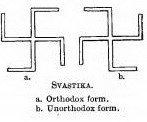
always bent in the respectful attitude,
that is, towards the left ; for the
Lāmas, while regarding the symbol as one of good augury, also consider it to typify the continuous moving, or the ceaseless becoming,” which is commonly called, Life. Sir A. Cunningham believed lt-to be a monogram formed from the Aṣoka characters for the auspicious words Su + Asti, or “that which is good.” 2 It was especially associated with the divinity of Fire, as representing the two cross pieces of wood 3 which by friction produce fire. The Jains, who seem to be an Indian offshoot of Buddhism, 4 appropriate it for the seventh of their mythical saints. 5 The heterodox Tibetans, the Bon, in adopting it have turned the ends inthe reverse direction.
The Seven Gems.6 These are the attributes of the universal monarch,7 such as prince Siddhārta was to have been had he not become a Buddha. They are very frequently figured on the base of his throne, and are : —
1. The Wheel. 8 The victorious wheel of a thousand spokes. It also represents the symmetry and completeness of the Law. It is figured in the early Sanchi Tope. 9
2. The Jewel. 10 The mother of all gems, a wish-procuring gem (Cintamaṇi).
1 Yun-druṅ. Chinese, Chu’-Vang, or “The ten thousand character ” ; cf. also Indian Antiquary, ix., 65, etc., 135, etc., and numerous references in DUMOUTIER, op. cit., 22-23. 2 Su, meaning “good” or ” excellent ” (in Greek, eu), and Asti is the third person singular present indicative of the verb As, “to be,” and Ka is an abstract suffix.
3 Skt., Arani. 4 But see JACOBI’s works. 5 Namely, the Jina Su-parṣva. 6 Skt., Sapta-ratna. T., Rin-ch’en sna-bdun ; cf. HARDY’s Man, p. 130, and ALABASTER’s Wheel of the Law, p. 81. 7 Cakra-vartin Rāja. 8 Skt,, Cakra; T., ‘K’or-lo. 9 Fergusson, Tree and Serp. Worship,pl. xxix., Fig. 2. 10 Skt., Ratna ; T., Norbu.
The Seven Gems.6 These are the attributes of the universal monarch,7 such as prince Siddhārta was to have been had he not become a Buddha. They are very frequently figured on the base of his throne, and are : —
1. The Wheel. 8 The victorious wheel of a thousand spokes. It also represents the symmetry and completeness of the Law. It is figured in the early Sanchi Tope. 9
2. The Jewel. 10 The mother of all gems, a wish-procuring gem (Cintamaṇi).
1 Yun-druṅ. Chinese, Chu’-Vang, or “The ten thousand character ” ; cf. also Indian Antiquary, ix., 65, etc., 135, etc., and numerous references in DUMOUTIER, op. cit., 22-23. 2 Su, meaning “good” or ” excellent ” (in Greek, eu), and Asti is the third person singular present indicative of the verb As, “to be,” and Ka is an abstract suffix.
3 Skt., Arani. 4 But see JACOBI’s works. 5 Namely, the Jina Su-parṣva. 6 Skt., Sapta-ratna. T., Rin-ch’en sna-bdun ; cf. HARDY’s Man, p. 130, and ALABASTER’s Wheel of the Law, p. 81. 7 Cakra-vartin Rāja. 8 Skt,, Cakra; T., ‘K’or-lo. 9 Fergusson, Tree and Serp. Worship,pl. xxix., Fig. 2. 10 Skt., Ratna ; T., Norbu.
The Seven Gems.6 These are the attributes of the universal monarch,7 such as prince Siddhārta was to have been had he not become a Buddha. They are very frequently figured on the base of his throne, and are : —
1. The Wheel. 8 The victorious wheel of a thousand spokes. It also represents the symmetry and completeness of the Law. It is figured in the early Sanchi Tope. 9
2. The Jewel. 10 The mother of all gems, a wish-procuring gem (Cintamaṇi).
1 Yun-druṅ. Chinese, Chu’-Vang, or “The ten thousand character ” ; cf. also Indian Antiquary, ix., 65, etc., 135, etc., and numerous references in DUMOUTIER, op. cit., 22-23. 2 Su, meaning “good” or ” excellent ” (in Greek, eu), and Asti is the third person singular present indicative of the verb As, “to be,” and Ka is an abstract suffix. 3 Skt., Arani. 4 But see JACOBI’s works. 5 Namely, the Jina Su-parṣva. 6 Skt., Sapta-ratna. T., Rin-ch’en sna-bdun ; cf. HARDY’s Man, p. 130, and ALABASTER’s Wheel of the Law, p. 81. 7 Cakra-vartin Rāja. 8 Skt,, Cakra; T., ‘K’or-lo. 9 Fergusson, Tree and Serp. Worship,pl. xxix., Fig. 2. 10 Skt., Ratna ; T., Norbu.
3. The jewel of a Wife. 1 ” The Jasper-girl ” who fans her lord to sleep, and attends him with the constancy of a slave.
4. The gem of a Minister, 2 who regulates the business of the empire.
5. The (white) Elephant. 3 The earth-shaking beast, who as a
The Seven Gems.
symbol of universal sovereignty the Buddhist kings of Burma and Siam borrowed from Indian Buddhism. It seems to be Indra’s elephant Airāvata. 4
6. The Horse. 5 It seems to symbolize the horse-chariot of the sun, implying a realm over which the sun never sets, as well as the celestial Pegasus-steed, 6 which carries its rider wherever the latter wishes. 7
7. The gem of a General, 8 who conquers all enemies.
1 Skt., Slri; T., Tsun-mo. 2 Skt., (?) Girti or Mahājana ; T., bLon-po. 3 Skt., Hasti ; T.,glaṅ-po. 4 This elephant is frequently represented as a miniature bronze ornament or flowerstand on the Lāmaist altar. Mr. Baber records (R. G. Soc. Suppl., paper, p. 33) a colossal elephant with six tusks, cast in silvery-bronze, in western Ssu-ch’uan. It is of artistic merit, and carries on its back, in place of a howdah, a lotus-flower, in which is enthroned an admirable image of Buddha. 5 Skt., Aṣra ; T., rTa-mch’og. 6 Aṣwin or Uchchaihsravas. 7 Compare with the divine horse named ” Might of a Cloud,” from the thirty-three heavens, which delivered the merchants from the island of Rākshasis. — See Hiuen Tsiang’s ,Si-Yu-Ki. 8 Skt., Kshatri or Sena-pati ; T., dMag-dpon.
And to these the Lāmas add an eighth, namely, the Vase, 1 for storing all the hidden riches of the three regions of life.
The Seven (Royal) Badges 2
1. The precious House (palace). (Kaṅ-saṅ Rinpoch’e)
2. „ „ Royal Robes (Gos Rinpoch’e)
3. „ „ Boots (embroidered). (Lham Rinpoch’e)
4. „ „ Elephant’s tusk (Laṅ-ch’en ch’em Rinpoch’e)
5. „ „ Queen’s earring. (Tsumno na-ja )
6. „ „ King’s earring. (Gyalpo na-ja)
7. „ „ Jewel. (Norbu)
The above list seems somewhat confused with ” The seven world-
The Seven World-Ravishing Gems. 3
ravishing Gems ” here figured. 3
The Seven Personal Gems. 4
1. The Sword-jewel — confers invincibility.
2. The Snake (Nāga)-skin jewel. It is ten miles long by five broad; water cannot wet it, nor the wind shake it ; it warms in the cold weather and cools in the hot ; and shines brighter than the moon.
3. The Palace-jewel.
4. The Garden-jewel.
5. The Robes.
6. The Bed-jewel.
7. The Shoe-jewel. Conveys the wearer one hundred miles without fatigue and across water without wetting the feet.
1 Bum-pa-ter ; Skt., Kalaṣa. 2 Gyal-ts’an sna bdun. 3 ‘Jigs-yoṅs-gyi rin-po-ch’e, namely, bSeru, conch-shell curd, king’s earring, queen’s earring, jewelled tiara, three-eyed gem, and the eight-limbed coral. Another enumeration gives Padmaraga, indranila, baidurya, margad, vajra, pearl, and coral. 4 Ne-wai rin-poch’e sna bdun.
A selection of four of these, with the addition of the royal umbrella, is termed “The five Royal Insignia,” 1 namely :—
The Seven Personal Gems.
The Eight Glorious Emblems. 2
These auspicious symbols are figured in Buddha’s footprints,3 and on innumerable articles, lay and clerical.
1 Cf CSOMA’S An., p. 76; Jaeschke’s Dict.,p. 454. 2 Skt., Ashta-maṅgala ;T.,bkra-s’i rtags-brgyad 3 Said to be symbols of the Vita-raga. HODGSON’ s L.L., p. 136, also J.A.S.B., art.“Naipālya Kalyāṇa”
The Eight Glorious Offerings. 4
1. Mirror. — The light-holding goddess-form offered a looking-glass to Buddha Bhagavāt when he was turning the wheel of religion,
The Eight Glorious Offerings.
and he blessed it and rendered it holy. (Compare with the mirror in the Shinto religion of Japan.;
2. The intestinal concretion (gi-ham or gi-‘vaṅ found in the entrails
1 The credulous Lāmas of north-eastern Tibet credited Mr. Rockhill with having captured the golden fish in the Tosu lake, “When I came back from Tosu-nor to Sbang, the Khanpo (abbot), a Tibetan, asked me where I proposed going; ‘To Lob-nor,’ I replied, not wishing to discuss my plans. ‘I supposed that was your intention,’ he rejoined ; ‘you have caught our horse and fish of gold in the Tosu-nor, and now you want to get the frog of gold of the Lob-nor. But it will be useless to try; there is in the whole world but the Panchen Rinpoche,of Tashi-lhunpo, who is able to catch it” (“A Journey in Mongolia and Tibet,” The Geog. Journ., May, 1894, p. 376). The Japanese use a wooden fish as a gong. 2 In Sanchi Tope. Fergus.,Tree and Serp. Worship, pi. xxxv., Fig. 2. 3 Also the symbol of the tenth Jina (Sītala) of the Jāins. Compare with ” Buddha’s entrails,” see number 2 of next list, also on this page. 4 bkras’s-rdsas brgyad. These, together with the foregoing, may be compared with the Navakosa or Navanidhi, or nine treasures of Kuvera, the god of riches, namely, Padma, Mahapadma, Makara, Kacchapa, Mukunda, Nanda, Mia, Kharwa. And these are related to the so-called Nāga kings, “the nine Nandas” of Magadha.
of certain animals and on the neck of an elephant. The land-guarding elephant offered this to Buddha, and he blessed it.
3. Curds (zo). — The farmer’s daughter (legs-skyes-ma) offered Buddha curdled milk, and he blessed it.
4. Darwa grass. — Mangalam, the grass-seller, offered Buddha darwa grass, which he blessed.
5. The Bilwa fruit (AEgle marmelos). — Brahma offered him bilwa, which he blessed as the best of fruits.
6. Conch-shell. — Indra offered him a white conch-shell, and he blessed it.
7. Li-khri. — The Brahman ” King-star,” offered him Li-khri, and he blessed it as the overpowering knowledge.
8. The white turnip. — Vajrapāṇi, ” the Secret Lord,” offered him white turnip (yaṅ-dkar), which he blessed as the demon-defeating turnip. *
| Sanskrit | Tibet | |
| l. The Golden Fish 1 | matsya | gser-ña |
| 2 The Umbrella (“Lord of the White Umbrella “2 ) | chatra | gduga |
| 3. Conch-shell Trumpet— of Victory | saṅkha | duṅ |
| 4. Lucky Diagram 3 | ṣrīvatsa | d pal -be |
| 5. Victorious Banner | dhvaja | rgyal-mts’an |
| 6. Vase | kalaṣa | bum-pa |
| 7. Lotus | padma | padma |
| 8. Wheel | cakra | k’or -lo |
The Five Sensuous Qualities. 1
These are figured at page 297. They seem to be a Buddhist adaptation of the Hindū ” eight enjoyments ” (Ashtabhoga), namely, a grand house, a bed, fine clothes, jewels, wives, flowers, perfumes, areca-nut and betel. They are offered on the altars and are : —
1. Pleasing form (Rupa). 2. Sound (Sapta). 3. Perfumes (Gandhe). 4. Luscious eatables (Naiwete). 5. Pleasing-touch and feelings (Sparsa).
Distinctly Chinese in origin are the TRIGRAMS and the following symbolic animals.
The Trigrams are especially used in astrology, and are described in the chapter on
that subject. They are based upon the very ancient Chinese theory of the Yin- Yang or “the great extreme ” (” Tai-Ky” 2),where two parallel lines, in a circle divided spirally into two equal tadpole-like segments, represent, as in the doctrine of the Magi, the two First Causes and great principles, or contrary influences ( Yin+ Yang) ; such as light and darkness, good and evil, male and female,
1 Skt., Kāmaguna, T., ‘dod-yoṅs. 2 DUMOUTIER, Les Symboles, etc., Annamites
heat and cold, movement and repose, and so on. The circular diagram 1 is divided by the Lāmas, like the Japanese, into three segments (as in the annexed figure a); and it will be noticed that the tails are given the direction of the orthodox fly-foot cross, for it too, according to the Lāmas, signifies ceaseless change or ” becoming.”
The LONGEVITY-trigram or hexagram,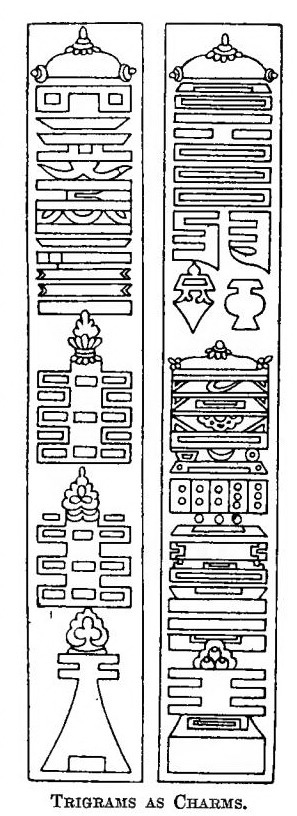
in both its oblong and circular forms
(fig. b and c), is a modification of the
Chinese symbol for longevity called Tho2
The Lāmas have also incorporated the
four greatest amongst the Chinese
symbolic animals, to wit, the Tortoise
, the Phoenix, Dragon, and Horse-dragon,
as well as the Chinese Tiger, and the Bats.
The TORTOISE symbolizes the universe
to the Chinese as well as the Hindūs. Its
dome-shaped back represents the vault
of the sky, its belly the earth, which
moves upon the waters ; and its fabulous
longevity leads to its being considered
imperishable.
The DRAGON 3 seems to perpetuate thetradition of primaeval flying saurians of
geologic times, now known only through
their fossilized remains. The Lāmas and
Chinese Buddhists have assimilated them
with the mythical serpents (Naga) of Indian myth.
The HORSE-DRAGON figures, as it seems to me,
very prominently in the prayer-flags of Tibet, as
we shall presently see.
The PHOENIX (or “Garuḍa”). This mythical
“ sky-soarer ” 4 is the great enemy of the dragons,
and has been assimilated to the Indian Garuḍa,
the arch-enemy of the Nāgas.
Trigrams as Charms.
1 Called rGyan-‘k’yil, probably a corruption of the Chinese name. 2 Cf. DUMOUTIER, op. cit., p. 21. 3 Tib., ‘drug ; Chinese Long. 4 Tib., nam-K’ah-ldiṅ. The Chinese call it Con-phu’ong (DUMOUTIER, p. 48).
And anyone who has, like myself, seen the bird popularly called Garuḍa (namely the Adjutant or Stork) devouring snakes, must realize why the Indians fixed upon such a homely simile to represent their myth. It seems to be analogous to the Thunder-bird of the North American Indians. In a more mystic sense the Lāmas, like the Chinese, believe it to symbolize the entire world ; its head is the heaven, its eyes the sun, its back the crescent moon, its wings the wind, its feet the earth, its tail the trees and plants. 1
The TIGER is a deity of the pre-Lāmaist religion of Tibet ; and the ” Red-Tiger,” as already noted, appears to me to be the prototype of the favourite Lāmaist demon (Tām-din). The tiger is displayed on all the Tibetan prayer-flags in contest with the dragon,’ 2 and the five tigers (see figure, page 519) are conspicuous in the Chinese symbolism prevalent in Annam. 3
The group is mystically reputed to symbolize the five elements : the central yellow tiger is the earth, the upper right blue one is wood, the lower right red one is fire (also the south), the upper left black one is water (also the north), and the lower left is metal (also the west).
The BATS, five in number, have come by a confusion of homonyms to symbolize the five good Fortunes, 4 namely, Luck, Wealth, Long life, Health, and Peace. They are embroidered on dresses of high Lāmas, sorcerers, maskers, etc. 5
Astrology also uses many other symbols,
as will be seen hereafter. The symbolism of colours is referred to in the chapter on images and incidentally elsewhere.
The Five Bats of Fortune.
Symbolic Words used as Numerals in Chronograms.
In chronograms and astronomical and other works, symbolic names are often used instead of numerals. The rationale of the
1 Cf. also Dumoutier, p.48. 2 Ngu Ho, see figure, p. 413. 3 Dumoutier, p. 55.. 4 Chinese Ngu Phu’o’c; cf. Dumoutier, p. 51. 5 See also their form on page 4.
use of such names is generally obvious; thus the individual’s body, the moon, the (one-horned) rhinoceros, express unity from their singleness. The hand, the eye, wings, twins, denote a pair. And many of the others are derived from the mythology of the Hindūs.
The following are some additional illustrations 1 : —
3 = the world — i.e., the three Buddhist worlds of Kāma Rūpa, Arupa.
= quality — i.e., the three Guna.
= fire — evidently from its triangular tongue.
= top — probably from the Chinese ideograph of a hill.
4 = a lake or sea — i.e., the idea of fluid requiring to be hemmed in on all four sides.
5 = the senses — the five senses.
= an element — the five elements.
= an aggregate — the five Skandha.
7 = a sage — the seven Ṛishi.
8 = a snake — the eight great Nāgas.
9 = a treasure — the nine treasures of Kuvera and the Nandas.
10 = points — the ten points or directions.
12 = the sun — with its twelve signs of the Zodiac.
24 = Jina or victor — the twenty-four Jina and Tirthaṅkara.
32 = tooth — the human set of thirty-two teeth.
0= sky — the ” empty ” space.
The ” Mandala ” or Magic Circle-offering of the Universe.
It is almost a matter of history how the great emperor of Aṣoka thrice presented India to the Buddhist church, and thrice redeemed it with his treasure. But it seems to be little, if at all, known that the Lāmas systematically ape Aṣoka in this particular gift; and they are much more magnificently generous than he. For every day, in every temple in Lāmadom, the Lāmas offer to the Buddhas (as well as to the saints and demons) not only the whole of India, but the whole universe of Jambudvīpa and the three other fabulous continents of Hindū cosmogony, together with all the heavens and their inhabitants and treasures. And although this offering is made in effigy, it is, according to the spirit of Lāmaism, no less effective than Aṣoka’s real gifts, upon which it seems to be based.
1 Taken mostly from Csoma’s Grammar, pp. 150, et seq.
The mode of making this microcosmic offering of the universe in effigy is as follows ; but to fully understand the rite, reference should be made to the illustrated description of the Buddhist universe, already given at page 79.
MODE OF OFFERING THE MANDALA.
Having wiped the tray with the right arm or sleeve, the Lāma takes a handful of rice in either hand, and sprinkles some on the tray to lay the golden foundation of the universe. Then he sets down the large ring (see figure, p. 296), which is the iron girdle of the universe. Then in the middle is set down a dole of rice as mount Meru (Olympus), the axis of the system of worlds. Then in the order given in the attached diagram are set down a few grains of rice representing each of the thirty-eight component portions of the universe, each of which is named at the time of depositing its representative rice. The ritual for all sects of Lāmas during this ceremony is practically the same. I here append the text as used by the Kar-gyu sect.
During this ceremony it is specially insisted on that the performer must mentally conceive that he is actually bestowing all this wealth of continents, gods, etc., etc., upon his Lamaist deities, who themselves are quite outside the system of the universe.
The words employed during the offering of the Maṇḍala are the following, and it should be noted that the figures in brackets correspond to those in the diagram and indicate the several points in the magic circle where the doles of rice are deposited during this celebration or service.
” Oṃ! Vajra bhummi Āḥ Hūṃ “
” On the entirely clear foundation of solid gold is Oṃ ! bajra-rekhe Āḥ Hūṃ .
” In the centre of the iron wall is Hūṃ and Ri-rab (Meru), the king of Mountains (1).
” On the east is Lus-‘p’ags-po (2),
” On the south ‘Jam-bu-gliṅ (3),
” On the west Ba-laṅ-spyod (4), and
” On the north Gra-mi-sñan (5).
” On either side of the eastern continent are Lus (6) and Lus’p’ags (7).
” On either side of the southern continent are rNa-yab (8) and
rNa-yab-gz’an (9).
“On either side of the western continent are Yonten (10) and Lam-mch’og-‘gra (11).
And on either side of the northern continent are sGra-mi-sñan (12) and sGra-mi-shañ-gyi-mda (13). ” There are mountains of jewels (14), wish-granting trees (15), wish-granting cows (16), unploughed crops (17), the precious wheel (18), the precious Norbu jewel (19), the precious queen (20), the precious minister (21), the precious elephant (22), the precious horse (23), the precious battle-chief (24), the vase of the great treasure (25), the goddesses sgeg-pa-ma (26), ‘P’reṅ-wa-ma (27), gLu-ma (28), Gar-ma (29), Me-tog-ma (30), bDug-spos-ma (31), sNaṅ-gsal-ma (32),Dri-ch’al-ma (33), the sun (34), moon (35), jewelled umbrella (36), the ensign of victory (37), which is entirely victorious from all directions, and in the middle are the gods (38), the most accomplished and wealthy of the beings !
” I offer you all these constituent parts of the universe in their entirety, O! noble, kind, and holy Lāma! O! tutelary gods of the magic-circle, and all the hosts of Buddhas and Bodhisattvas!
” I beg you all to receive these offerings for the benefit of the animal beings !
” I offer you ! Buddhas ! the four continents and mount Meru adorned with the sun and moon on a foundation of incense and flowers. Let all the animal beings enjoy happiness !
” I offer you ! assembly of all the accomplished supreme beings of the outside, inside, and hidden regions, the entire wealth and body of all these ideal regions. I beg you all to give us the best of all real gifts, and also the real gift of rDsogs-pa-ch’en-po (the mystic insight
sought by the Ñiṅ-ma)!
” I offer up this fresh magic-circle, through the virtue of which let no injury beset the path of purity, but let us have the grace of the Jinas of the three times, and let us, the innumerable animal beings, be delivered from this illusive world !
” I offer up salutations, offerings, confessions of sins, and repentance. What virtue has been accumulated by myself and others, let it go to the attainment of our great end. Idam-ratna maṇḍala kamnir-yaiteyāmi !
” I humbly prostrate myself three times to all who are worthy of worship, with my whole heart and body.” Let glory come ! 1
But the commonest use of sacred symbols is as talismans to ward off the evils of those malignant planets and demons who cause disease and disaster, as well as for inflicting harm on one’s enemy. The symbols here are used in a mystical and magic sense as spells and as fetishes, and usually consist of formulas in corrupt and often unintelligible Sanskrit, extracted from the Mahāyāna and Tantric scriptures, and called dhāraṇi,2 as they are believed to “hold” divine powers, and are also used as incantations. Shorter
1 For details of the rest of this service, see my Lāmaism in Sikhim, p. 105. 2 z’uṅs
forms of these, consisting often of a single letter, are also used as representing the essence or ” germ ” of these spells or mantras, and hence named vīja. And the mystic diagram in
which they are often arranged is named Yantra, as in Hindū Tāntrism. 1
The forms of these talismans and amulets are innumerable. The majority are luck-compelling, but different diseases, accidents and misfortune have each their special kinds.
The eating of the paper on which a charm has been written is an ordinary way of curing disease, as indeed it had been in Europe till not so many centuries ago, for the mystic Rx heading our prescriptions is generally admitted to have had its origin in the symbol of Saturn, whom it invoked, and the paper on which the symbol and several other mystic signs were inscribed constituted the medicine, and was itself actually eaten by the patient. The spells which the Lāmas use in this way as medicine are shown in the annexed print, and are called ” the edible letters ” (za-yig).
A still more mystical way of applying these remedies is by the washings of the reflection of the
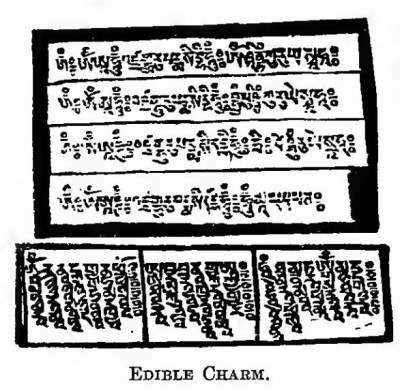 writing in a mirror, a practice not without its parallels in other quarters of the globe. 2 Thus to cure the evil eye as shown by symptoms of mind-wandering and dementia condition — called”byad-‘grol” — it is ordered as follows: Write with Chinese ink on a piece of wood the particular letters and smear the writing over with myrobalans and saffron as varnish, and every twenty-nine days reflect this inscribed wood in a mirror, and during reflection wash the face of the mirror with beer, and collect a cupful ofsuch beer and drink it in nine sips.
writing in a mirror, a practice not without its parallels in other quarters of the globe. 2 Thus to cure the evil eye as shown by symptoms of mind-wandering and dementia condition — called”byad-‘grol” — it is ordered as follows: Write with Chinese ink on a piece of wood the particular letters and smear the writing over with myrobalans and saffron as varnish, and every twenty-nine days reflect this inscribed wood in a mirror, and during reflection wash the face of the mirror with beer, and collect a cupful ofsuch beer and drink it in nine sips.
Edible Charm.
1 Monier Williams’s Hindūism, 127. 2 “In Gambia,” writes the colonial surgeon in his report for 1890 (quoted in Nature )” the treatment relied upon for cure, and much practised in the country, is to call in a man who is supposed to be a ‘doctor,’ who, after looking at the patient, sits down at his bedside and writes in Arabic characters on a wooden slate a long rigmarole, generally consisting of extracts from the Koran. The slate is then washed, and the dirty infusion is drunk by the patient.”
But most of the charms are worn on the person as amulets. Every individual always wears around the neck one or more of these amulets, which are folded up into little cloth-covered packets, bound with coloured threads in a geometrical pattern. Others are kept in small metallic cases of brass, silver, or gold, set with turquoise stones as amulets, and called ” Ga-u” These amulets are fastened to the girdle or sash, and the smaller ones are worn as lockets, 1 and with each are put relics of holy men — a few threads or fragments of cast-off robes of saints or idols, peacock feathers, sacred Kuṣa grass, and occasionally images and holy pills.
Other large charms are affixed overhead in the house or tent to ward off lightning, hail, etc., and for cattle special charms are chanted, or sometimes pasted on the walls of the stalls, etc. 2
Most of these charms against accident, disease, and ill-fortune are in the form figured on the opposite page, which is called ” The Assembly of all the Lāmas’ Hearts,” as it is believed to contain the essence of all that is most powerful in the Lāmaist spells.
It consists of a series of concentric circles of spells surrounded by flames, amid which in the four corners are the symbols of the Buddhist trinity symbolized as three gems, a lotus-flower, a thunder-bolt sceptre, and a flaming dagger with a vajra-hilt. In the interior is an eight-petalled lotus-flower, each petal of which bears mystic syllables, and in the centre of the flower is a circular space of about an inch in diameter, in which is placed the especial mystic
charm, prepared as presently described, and varying according to the purpose for which the charm is wanted. The outer spells are : —
In the Outmost Circle. — Guard the Body, Mind, and Speech of this charm-holder !
Rakhya rakhya kuruye svāhā! Angtadyatha! Om muni muni mahamuniye svāhā.
(Here follows ” The Buddhist creed ” already given ; followed by the Dhyāni Buddhas : — ) Vairocana Om vajra Akshobhya ,Hūṃ , Ratna-sambhava Hri, Bargudhara Hri, Amogasiddha Āḥ!
In Second Circle,—Om ! Nama Samanta Buddhanam, Nama Samanta Dharmanam, Nama Samanta Saṅghanam. Om Sititabatrai. Om Vimala, Om Shadkara, Om Brahyarigar Vajra ustsikhatsa krawarti sarvayana manta mūla varma hana dhanamhā.
Namkilanibā makriayena keni chatkramtamtata sarban rātsin rātsin dakhinda
bhinda tsiri tsiri giri giri mada mada HūṃHūṃ phat phat.
1 Figured on page 571. The kidney-shaped ones are called Ga-u ke-ri-ma. 2 Cf. also CSOMA and W. E. CARTE, J.A.S.B., IX., 904. See figures of some of these charms at pages 568, 571, and 572.
In Third Circle. — Guard the Body, Mind, and Speech of this charm-holder ! Mama rakhya rakhya kuruye svāhā!. Here follows the letters of the alphabet:—) Ang, a, ā, i, ī, u, ū, ṛi, ṛī, ḷi, ḷī, e, ai, o, au, ang, a, k, kh, g, gh, ṅ, ts, tsh, ds, dsā, ñ, ta, th, d, dh, n, p, ph, b, bh, m, y, r, l, w, ṣ, sh, s, ḥ, aṃ !
In Fourth Circle. — Hūṃ,Hūṃ, etc.
In Fifth Circle. — Hri Hri , etc.
The General Charm Print. Entitled ” The Assembly of Lāmas’ Hearts.” (Reduced 50%.)
In Sixth Circle. — Om ! A! Hūṃ! Hri! Guru! Deva! Dakkini ‘. Sarvasiddhipala Hūṃ! A!
The special charm, which occupies the centre of the diagram, varies according to the object for which the charm is required. It consists of a monogram or mystic letter (Sanskrit, vīja, or seed), which represents the germ of a spell or mantra. This letter is often in the old Indian character of about the fourth or fifth century A.D., and is inscribed in cabalistic fashion with special materials as prescribed in the manual on the subject.
As most of these specific charms are of the nature of sympathetic magic, and evidently derived from very ancient Indian sources, probably dating back to Vedic times when the ritual consisted largely of sympathetic magic, 1 I give here a few examples : 2 —
Thus to make the
Charm against Bullets and Weapons. — The directions are as these : With the blood of a wounded man draw the annexed monogram and insert in the vacant space in the centre of the aforesaid print of “The Assembly of the Hearts of the Lāmas.” The sheet should then be folded and wrapped in a piece of red silk, and tie up with a piece of string 1 and wear around the neck or an unexposed part of your breast immediately next the skin, and never remove it.
Charm for Clawing Animals (i.e., tigers, cats, bears, etc.). — On a miniature knife write with a mixture of myrobalans and musk-water the monogram (? ZAH) and tie up, etc. (Here the knife seems to represent the animal’s claw.)
For Domestic Broils. — Write the monogram (? RE) and insert in print and fold up and bind with a thread made of the mixed hairs of a dog, goat, sheep, and enclose in a mouse-skin, and tie, etc. (This seems to represent union of domestic elements.)
For Kitchen Cooking Smells offensive to the House-Gods. —
With the blood of a hybrid bull-calf write the monogram GAU ( = cow), and insert it in the print, and fold up in a piece of hedge-hog-skin. (Compare with the western Aryan myth of the Greek hearth-god Vulcan, whose mother Hera as Io is represented as a cow.)
1 Cf. BERGAIGNE’s La religion vedique ; also FRAZER. 2 For a fuller account, with illustrations, see my article in Jour. Anthrop. Institute, 1894.
For Cholera (or “the vomiting, purging, and cramps” ). — With the dung of a black horse and black sulphur and musk-water write the monogram (? ZA), and insert in the print, and fold up in a piece of snake-skin, and wear, etc. (Here the dung seems to represent the purging, the horse the galloping course, the black colour the deadly character, and the snake the virulence of the disease.)
Charm against Plagues.
This charm, figured at the head of this chapter, consists of a monster figure of the Garuḍa, the king of birds, with a snake in its mouth, and each of its outstretched plumes bears a text, and it also contains the ” Buddhist creed.” The inscription runs :—
Om ! Bhrum satrirbad namkhamjamram.
Om ! bisakhrilimili hala svāhā !
Om ! bisakhrilimilihalayā skachig !
Guard the holder (i.e., the wearer) of this from all the host of diseases of evil spirits and injuries, including contagious diseases, sore-throat’ cough, rheumatism, the black ” rgyu-ghgyel,” brum-bu, and all kinds’ of plague of the body, speech, and mind ! [Here follows the Buddhist creed.] Habatse habatse hūṃ sod. Suru suru hūṃ sod. Sukarjuka hūṃ sod. Sati karur hūṃ sod. Kularakhyi hūṃ sod. Merumthuntse hūṃ sod. Mahakuruṇa guru triga gurunam Nāgashara ramram duldul nagaṣita pho naga chunglinga shag thumamnyogs sos.
Guard the holder.
Om I thamitharati sadunte dswaramghaye svāhā !
Another charm for disease is given at page 62, where the fierce demon Tam-din, clad in human and animal skins, bears on his front a disc with concentric circles of spells.
Scorpion-Charm against Injury by Demons.
This charm, figured at page 474, is in the form of a scorpion, whose mouth, tipped by flames, forms the apex of the picture. On its shoulder are seated the especial demons to be protected against. The inscription runs : — Ayama durur cashana zhamaya. hūṃ! Om! A! hūṃ! Artsignirtsig ! Namo Bhagavāti hūṃ! hūṃ! Phat !
A guard against all the injuries of ” rgyalpo,” ” drimo ” (a malignant demon specially injuring women), ” btsan ” (or red demons), ” sa-dag ” (or earth-demons), klu (or nāga), including ” gñan ” (a plague-causing subordinate of the nāga).
Against injury by these preserve !
And the figures are hemmed in by the mystic syllables: Jsa! hūṃ! hūṃ! Bam! Ho!
The huge Tibetan mastiffs are let loose at night as watch-dogs, and roaming about in a ferocious state are a constant source of alarm to travellers, most of whom therefore carry the following charm against dog-bite. It consists of a picture of a dog fettered and muzzled by a chain, terminated by the mystic and all-powerful thunderbolt-sceptre ; and it contains the following inscribed Sanskrit mantras and statements : ” The mouth of the blue dog is bound beforehand! Omrlti-sri-tl svāhā! Omriti-sri-ti svāhā” And this is repeated along the body of the dog, followed by : — Om Vajra ghana kara kuku ratsa sal sal nan marya smugs smugs kuku ratsa khathamtsa le tsa le mun mun sar sar rgyug kha tha ma chhu chhinghchhang maraya rakkhya rakkhya! (It is) fixed ! fixed !
Charm against Eagles and Birds of Prey.
Eagles play havoc with the young herds of the pastoral Bhotiyas of the Sikhim uplands and Tibet. For this the people use the annexed charm, which they tie up near their huts. The central figure is a manacled bird, representing the offending eagle or other bird of prey ; and around it is the following text : — ” A guard against all injuries of the covetous, sky soaring monarch bird. (It is) fixed ! fixed ! Om smege smege bhum bhummu!”
The necromantic charms for killing one’s enemy are resorted to mostly in inter-tribal feuds and warring with foreigners. I have given details of these rites elsewhere. 1 They require the following objects : —
1. An axe with three heads, the right of which is bull-headed, the left snake-headed, and the middle one pig-headed.
2. On the middle head a lamp is to be kept.
3. In the pig’s mouth an image of a human being made of wheaten flour (a linga). The upper part of the body is black and the lower part red. On the side of the upper part of the body draw the figure of the eight great planets, and on the lower part of the body the twenty-eight
constellations of stars. Write also the eight parkha (trigrams), the nine mewa, the claws of the Garuḍa in the hands, the wing of the eagles and the snake tail.
4. Hang a bow and an arrow on the left and load him with provisions on the back. Hang an owl’s feather on the right and a rook’s on the left ; plant a piece of the poison-tree on the upper part of the body, and surround him with red swords on all sides. Then a red Rgyangbu
wood on the right, a yellow one on the left, a black one in the middle, and many blue ones on diverse places.
5. Then, sitting in quiet meditation, recite the following :—
” hūṃ! “ This axe with a bull’s head on the right will repel all the injuries of the Ṅag-pas and Bon-pos— sorcerers ; the snake on the left will repel all the classes of plagues ; the pig’s head in the middle will repel the sa-dag and other earth-demons; the linga image in the mouth
will repel all the evil spirits without remainder, and the lamp on the head will repel the evil spirits of the upper regions ! the axe will cleave the heart of the angry enemy and also of the hosts of evil spirits ! etc., etc., etc., etc.
During the Sikhim expedition of 1888, near Mt. Paul on the Tukola ridge, where the final attack of the Tibetans was made, there was found one of the mystic contrivances for the destruction of the enemy. It consisted of an obliquely carved piece of wood, about fourteen inches long, like a miniature screw-propeller of a steamer, and acted like the fan of a windmill. It was admittedly a charm for the destruction of the enemy by cleaving them to pieces, a device for which there are western parallels. And on it was written a long, unintelligible Bon spell of the kind called z’aṅ -z’uṅ on it, followed by a call for the assistance of the fierce
deities Tam-din, Vajrapāṇi, and the Garuḍa, and concluding with “ phat, phat ” — Break ! Destroy ! It may also be mentioned here that the bodies of all the Tibetans slain in these encounters were found to bear one or more charms against wounds, most of them being quite new; and some of the more elaborate ones, which contained in their centre figures of the other weapons charmed against, swords, muskets, etc., had cost their wearers as much as twenty-five rupees a-piece.
And for torturing one’s enemy short of death, there is the same popular practice which is found amongst occidentals, 1 namely, of making a little clay image of the enemy and thrusting pins into it. The directions for this procedure are : —
Take some of the earth from his footprints ; or better from the house of some wrecked person, and mixing with dough prepare a small figure of a man. On its head put thorns. Through the heart’s region thrust a copper needle. Then say following spell : Om Ghate Jam-mo hāmo hādsam . during the recital of which move the needle briskly over the region of the heart. If this process is long continued then the bewitched person will surely die within the day; but if done only for a time, and the needle and thorns are again withdrawn, and the image- body and needles are washed, the enemy who is thus bewitched will only suffer temporary anguish, and will recover (for it is against Buddhist principles to take life).
” Prayer-Flags.”
The tall flags inscribed with pious sentences, charms, and prayers, which flutter picturesquely around every Lāmaisl settlement, curiously combine Indian with Chinese and Tibetan symbolism. It seems a far cry from Aṣoka pillars to prayer-flags, but it is not improbable that they are related, and that ”the Trees of the Law,” so conspicuous in Lāmaism, are perverted emblems of Indian Buddhism, like so much of the Lāmaist symbolism. Everyone who has been in Burma is familiar with the tall masts
1 Cf. VIRGIL. Bucol. viii. : THEOCRITUS ,Pharmaceutria.
(tagūn-daing), 1 with their streaming banners, as accessories of every Buddhist temple in that country. Each mast in Burma is surmounted by an image of one or more Brahmani geese, and the streamers are either flat or long cylinders of bamboo framework pasted over with paper, which is often inscribed with pious sentences. The monks whom I asked regarding the nature of this symbol believed that it was borrowed from Indian Buddhism.
Now, the resemblance which these posts bear to the Aṣoka pillars is certainly remarkable. Both are erected by Buddhists for the purposes of gaining merit and displaying aloft pious wishes
or extracts from the law; and the surmounting geese form an essential feature of the abacus of several Aṣoka pillars. The change from pillar to post could be easily explained, as great monoliths were only possible to such a mighty emperor as Aṣoka ; but everyone could copy in wood the pious practice of that great and model Buddhist who had sent his missionaries to convert them.
Such wooden standards may have been common in Indian Buddhism, as some Burmese believe, and yet, from their perishable nature, have left no trace behind. At most of the old rocky Buddhist sites in Magadha I have seen sockets in the rock, some of which may have been used for such standards, although many of the smaller sockets were doubtless used for planting umbrellas to shelter the booth-keepers in their sale of flower and other offerings for the shrines. Most also of the clay models of Caityas in relief, dug out of the earlier Indian Stupas, show streamers’ tied to the top of the Caityas ; and in Ceylon the old Stūpas are surrounded by what seems to be similar posts. 2
Lāmaism, which, more than any other section of Buddhism, has, as we have seen, substituted good words for the good works of the primitive Buddhists, eagerly seized upon all such symbolism, as for instance, Aṣoka’s historic gifts in their daily rice-offerings. The decided resemblance of its ” prayer-flags ” to the tagūn-daing of the Burmese is 3 not more striking, perhaps, than the apparent homology which they present to the Aṣoka pillars.
1 Mr. St. A. St. John kindly informs me that the etymology is ta, something long and straight + gun, bark or husk + daing, a post. 2 See figures in Ferguson’s History of India and Eastern Architecture. 3 These instances seem something more than the simple cloths and banners as propitiatory offerings, which, of course, are found in most animistic religions — from the ” rag-bushes ” of India to the shavings of the Upper Burmese and the Ainos. And the hypothetical relationship between the Burmese and the Tibetans, based on the affinity of their languages, does not count for much, as no real racial relation has yet been proved. Probably related to these prayer-flags are the stone pillars called masts or poles (wei-kan), found in western Su-Ch’uan in China, ami Figured by Mr. Baber (“A Journey,” etc., Roy. Geog. Soc. Suppl. Papers, i.. p. 19).
They are called by the Lāmas Da-cha, 1 evidently a corruption of the Indian Dhvaja, the name given by the earlier Indian Buddhists to the votive pillars offered by them as railings to Stūpas. 2
The planting of a Lāmaist prayer-flag, while in itself a highly pious act, which everyone practises at some time or other, does not merely confer merit on the planter, but benefits the whole countryside. And the concluding sentence of the legend inscribed on the flag is usually ” Let Buddha’s doctrine prosper ” — which is practically the gist of the Aṣoka inscriptions. 3
Horse-Dragon, ” Long-ma”.
But the Lāmas have degraded much of their Indian symbolism, and perverted it to sordid and selfish objects. The prayer-flags are used by the Lāmas as luck-commanding talismans ; and the commonest of them, the so-called ” Airy horse,”
1 dar-lch’og. 2 Cunningham’s Stupa of Barhut. 3 As the legend usually bears a lion and a tiger in its upper corners, while below are a Garuḍa-bird and dragon (Nāga), it seems, not impossible that these may he related, to the surmounting lion and the so-called geese of Aṣoka’s pillars. The rites related to the erection of the Lāmaist standard are somewhat suggestive of the Vedic rite of “raising Indra’a banner,” which in its turn is probably the original of our Maypole, and Aṣoka’s pillars seem to have been somewhat of the nature of the Jayas-tambha.
horse,” seems to me to be clearly based upon and also bearing the same name as ” The Horse-dragon ” of the Chinese.
This Horse-dragon or ” Long horse ” is one of the four great mythic animals of China, and it is the symbol for grandeur. It is represented, as in the figure on the opposite page, as a dragon- headed horse, carrying on its back the civilizing Book of the Law.
Now this is practically the same figure as ” The Lung-horse ” (literally “Wind-horse”) of the Lāmaist flag, which also is used for the expressed purpose of increasing the grandeur of the votary; indeed, this is the sole purpose for which the flag is used by the Tibetan laity, with whom these flags are extremely popular.
And the conversion of ” The Horse-dragon ” of the Chinese into the Wind-horse of the Tibetans is easily accounted for by a confusion of homonyms. The Chinese word for ” Horse-dragon ” is Long-ma, 1 of which Long = Dragon, and ma = Horse. In Tibet, where Chinese is practically unknown, Long, being the radical word, would tend to be retained for a time, while the qualifying word, ma, translated into Tibetan, becomes ” rta.” Hence we get the form ” Long-rta.” But as the foreign word Long was unintelligible in Tibet, and the symbolic animal is used almost solely for fluttering in the wind, the ” Long ” would naturally become changed after a time into Lung or ” wind,” in order to give it some meaning, hence, so it seems to me, arose the word Lung-rta, 2 or ” Wind-horse.”
In appearance the Tibetan “Lung-horse” so closely resembles its evident prototype the ” Horse-dragon,” that it could easily be mistaken for it. On the animal’s back, in place of the Chinese civilizing Book of the Law, the Lāmas have substituted the Buddhist emblem of the civilizing Three Gems, which include the Buddhist Law. But the Tibetans, in their usual sordid way, view these objects as the material gems and wealth of good luck which this horse will bring to its votaries. The symbol is avowedly a luck-commanding talisman for enhancing the grandeur 3 of the votary.
Indian myth also lends itself to the association of the horse with luck; for the Jewel-horse of the universal monarch, such as Buddha was to have been had he cared for worldly grandeur, carries its rider, Pegasus-like, through the air in whatever direction wished for, and thus it would become associated with the idea of realization of material wishes, and especially wealth and jewels. This horse also forms the throne-support of the mythical celestial Buddha named Ratna-sambhava, or ” the Jewel-born One,” who is often represented symbolically by a jewel. And we find in many of these Luck-flags that the picture of a jewel takes the place of the horse. It is also notable that the mythical people of the northern continent, subject to the god of wealth, Kuvera, or Vaiṣravana, are ” horse-faced.”
The flags are printed on the unglazed tough country paper,and are obtainable on purchase from the Lāmas, but no Lāma is necessarily needed for the actual planting of the flag and its attendant rites.
1 DUMOUTIER, op.cit., p.30. 2 rLuṅ-rta; another form of spelling sometimes, though rarely, met with, is kLuṅ-rta. i. where kluṅ is said to mean ” year of birth.” 3 T., rgyas.
These luck-commanding or “prayer-flags” are of four kinds : —
I. The Lung-ta proper, as above figured. It is almost square in form, about four to six inches long, and contains in the centre the figure of a horse with the mystic jewel Norbu on its back. It is hung upon the ridges of the houses,
War of the Tiger and Dragon.
and in the vicinity of dwellings. The printed text of this sort of flag varies somewhat in
the order in which the deified Lāmas are addressed, some giving the first place to St. Padma, while others give it to the celestial Bodhisat, Mañjuṛṣī ; but all have the same general form, with the horse bearing the jewel in the centre, and in the four corners the figures or the names of the tiger, lion, the monstrous Garuḍa -bird, and the dragon — the tiger being opposed to the dragon, in accordance with Chinese mythology, as figured over the page.
A translation of one of the prayer-flags is here given : —
Hail! Vagishwari Hūṃ ! (i.e., yellow Mañjuṛṣī ‘s spell.)
TIGER, LION.
Hail ! to the jewel in the Lotus ! Hūṃ ! (i.e., Avalokita’s spell).
Hail ! to the holder of the Dorje ! Hūṃ ! (i.e., Vajrapāṇi’s spell).
Hail ! to Vajrasattva (The Diamond-souled one ! )
Hail ! Amarahnihdsiwantiye swāhā.
[The above is in Sanskrit. Now follows in Tibetan : — ]
Here ! May all of the above (deities whose spells have been given) prosper [here is inserted the year of birth of the individual], and also prosper —
the Body (i.e., to save from sickness),
the Speech (i.e., to give victory in disputations),
and the Mind (i.e., to obtain all desires) ;
GARUḌA. of this year-holder [above specified] DRAGON,
and may Buddha’s doctrine prosper !
Here it will be noted that the three great celestial defensores fidei of Lamaism are invoked through their spells, namely : —
- Mañjuṛṣī, who conveys wisdom; 2. Avalokita, who saves from fear and hell ; and 3. Vajrapāṇi, who saves from accident and bodily injury. And in addition to the above are also given the spells of: 4. Vajrasattva, who purifies the soul from sin; and 5. Amitāyus, who confers long life.
It is interesting to compare with these Tibetan luck-flags the somewhat similar prayer-flags 1 which the Burmese Buddhists offer at their shrines. “These,” says Mr. Scott, 2 “are fancifully cut into figures of dragons and the like, and in the centre contain, in Pali or the vernacular, sentences like these : —
” By means of this paper the offerer will become very strong.” ” By the merit of this paper Wednesday’s children will be blessed by spirits and men.” ” May the man born on Friday gain reward for his pious offering.” “ May the man born on Monday be freed from Sickness and the Three Calamities.”
1 Kyet sha-taing 2 The Burman,i.,p.225
The large Luck-flag “The Victorious Banner.’
The second form of the Tibetan luck-flag is called cho-pen. 1 It is of a long, narrow, oblong shape, about eight to ten inches in length. This sort of flag is for tying to twigs of trees or to
bridges, or to sticks for planting on the tops of hills. Its text has generally the same arrangement as form No. 1, but it wants the horse-picture in the centre. Its Tibetan portion usually closes with “May the entire collection (of the foregoing deities) prosper the power, airy horse, age and life of this year-holder and make them increase like the waxing new moon.”
Very poor people, who cannot afford the expense of the printed charms, merely write on a short slip of paper the name of the birthyear of the individual, and add ” May his lung-horse prosper.”
One lung-horse for each member of a household must be planted on the third day of every month (lunar) on the top of any hill near at hand, or on the branch of a tree near a spring, or tied to the sides of a bridge; and on affixing the flag a stick of incense is burned. And a small quantity of flour, grain, flesh, and beer are offered to the genius loci of the hill-top by sprinkling them around, saying, So ! So ! Take ! Take !
A more expanded form of the luck-flag is the Gyal-tsan dse-mo, or “Victorious banner,” 2 which is generally of the same form as that first mentioned, but containing a much larger amount of holy texts, and also usually the eight glorious symbols, of which the lotus forms the base of the print. It prospers not only Luck in wealth, but also the life, body, and power of the individual, and seems to contain also spells addressed to the goddess Durga, Ṣiva’s spouse.
The Vast Luck-flag
. This fourth form of Lung-ta is named “gLaṅ-po stob ryyas” or “That which makes vast like the Elephant.”3 It is pasted to the walls of the houses, or folded up and worn around the neck as a charm for good luck. It consists of crossed vājras in the centre with a Garuḍa and a peacock, the jewelled elephant and the jewelled horse, each bearing an eight-
leaved lotus-disc on which are inscribed the following Sanskrit and Tibetan text-. The other symbols are the eight glorious symbols already described.
1 sbyod-pan. 2 Sometimes rendered into Sanskrit as Arya agra-keyur rana maharani. 3 gLaṅ-po stob-rgyas
And around the margin is the familiar legend ” the Buddhist creed,” repeated several times, also the letters of the alphabet, together with the words ” May the life, body, power, and the
‘ airy horse ‘ of the holder of this charm prosper his body, speech, and wishes, and cause them to increase like the growing new moon; may he be possessed of all wealth and riches, and be guarded against all kinds of injury.”
In the upper left hand disc : ” May the life of this charm-holder be, raised sublimely (like the flight of the Garuḍa here represented). Om ! sal sal hobana sal sal ye svāhā ! Om ! Om ! sarba kata kata sata kata sala ya nata sah wa ye svāhā ! Om ! kili kili mili mili kuru kuru hūṃ,hūṃ ye svāhā ! Om ! May the life of this charm-holder be raised on high !
In the upper right-hand disc : ” May the body of this charm-holder
be raised sublimely (like the flight of the peacock here represented).
Om ! yer yer hobana yer yer ye svāhā ! Om ! sarba Taihagata bhiri
bhiri bata bata miri miri mili mili ae bata sarba gata-gata shramana
sarba gata-gata shramana sarba ! O !
May the body of this charmholder be raised on high.”
In lower left-hand disc : ” May the power of this charm-holder be
raised sublimely (like the precious elephant here represented). Om !
Mer mer hobana mer mer ye svāhā ! Om sarva dhara dhara bara dhara
ghi kha ye svāhā ! Sarva kili kili na hah kang li sarba bhara bhara
sambhara sambhara ! O !
May the power and wealth of this charmholder be increased and all the injuries be guarded against.
In lower right-hand circle : “May the ‘Airy horse’ of this charmholder be raised sublimely (with the celerity of ‘ the precious horse ‘ here represented).
Om! lam lam hobana lam lam lam svāhā! Om ! Sarva kara kara phat ! Sarbha dhuru dhuru na phat! Sārbā kata kata kata na phat! Sarba kili kili na phat! Sarbha mala mala svāhā ! O !
May the ‘ Lung-horse ‘ of the charm-holder be raised on high and guarded against all injury.”
In the central disc over the junction of the cross Dor-je is written :
” Om ! neh ya rani jiventi ye svāhā ! O !
May this charm-holder be given the undying gift of soul everlasting (as the adamantine cross
Dor-je herein pictured).”
In planting these luck-flags a special form of worship is observed. And the planting of these flags with the due worship is advised to be done when ever anyone feels unhappy and down in luck, or injured by the earth-demons, etc. It is called ” The great statue of the Lung-horse,” and is as follows : —
First of all is made a rice-oftering of the universe, under a yellow canopy, but screened on the four sides by curtains of different colours, blue on the east, red on the south, white on the west, and black on the north. The canopies are to be fixed in the ends of a perfect square
set in the four directions, around which are the twelve-year cycle, the nine cakes (bs’os) representing the nine Mewas, eight lamps representing the eight parkha, eight planets, twenty-eight constellations of stars, five Tormas, five glud (small balls of wheaten flour offered to demons as ransom), five arrows with silk streamers (mda-dar) of the five different
colours, and many more mdā rgyan-bu and ‘p’aṅ. The above must be arranged by a practical man, and then the ceremony begins with the fingers in the proper attitude of the twelve cycle of years, and recitation of the following in a raised and melodious voice : —
” Kye ! Kye ! In the eastern horizon from where the sun rises, is a region of tigers, hares, and trees. The enemy of the trees is the Iron, which is to be found in the western horizon, and where the enemy, the life-cutting bdud-devil, is also to be found. In that place are the
demons who injure the life, body, power, and the ‘ Lung-horse* The devil who commands them also lives in the occidental region : he is a white man with the heads of a bird and a monkey, and holds a white hawk on the right and a black demon-rod on the left. Oh ! Bird and
monkey-headed demon ! Accept this ransom and call back all the injuring demons.
ā Ā ī Ī ū Ū ṛ Ṛ ṝ ḷ l ṅ Ṅ ñ Ñ ṭ Ṭ ḍ Ḍ ṇ Ṇ ś Ś ṣ Ṣ ṃ ḥ ē ō ṇḍ
” Kye ! Kye ! In the southern horizon is a region of horses, snakes, and fire. The enemy of the fire is the water, etc., etc. O ! Rat and pig-headed demon ! Accept this ransom and call back all the injuring demons.” ……….
” Kye ! Kye ! In the boundary of the south-eastern horizon is a yellow dragon-headed demon. O ! Dragon-headed devil ! Accept this ransom and call back all the injuring devils.
“Kye! Kye! In the boundary of the south-western horizon is a yellow sheep-headed woman. ! Sheep-headed she-devil ! Accept this ransom and call back all the injuring demons.
” Kye ! Kye .’ In the boundary of the north-western horizon there is a yellow dog-headed demon. O ! Dog-headed devil ! Accept this ransom and call back all the injuring demons.
” Kye ! Kye! In the boundary of the north-eastern horizon there is a yellow bull-headed demoness. ! Bull-headed she-devil ! Accept this ransom and call back all the injuring demons !
” O ! Upset all the injuring evil spirits, the ill-natured devils, the demons who injure the life, body, power, and the lung-horse, the wandering demons, the ill-luck of bad ‘lung-horses,’ the fearful goblins, the bad omens, the doors of the sky, and the earth, and the injuries of all malignant devils.
“May we be freed from all kinds of injuries and be ‘ favoured with the real gift, which we earnestly seek ! ‘ ”
” May virtue increase !
” Glory ! ”
The “Vast” Luck-flag
(Reduced 50%.)
Dough Sacrificial Effigies of the Tibetan Bon Religion.
WORSHIP AND RITUAL.
WORSHIP and priestcraft had no place in primitive Buddhism. Pious regard for admirable persons, such as Buddha and the elders, and for ancient cities and sacred sites, was limited to mere veneration, and usually took the form of respectful circumambulation (usually three times), with the right hand towards the admired object, as in western ceremonial, 1 and this veneration was extended to the other two members of the Buddhist trinity, namely, Buddha’s
Word or Dharma, and the Assembly of the Faithful.
After Buddha’s death such ceremonial, to satisfy the religious sense, seems soon to have crystallized into concrete worship and sacrifice as an act of affection and gratitude towards the Three
___________________________________________________________________
1 For instance, as in the Scotch highlands, “to make the deazil” or walk thrice in the direction of the sun’s course around those whom they wish well (Gordon-Cuming, From the Hebrides to the Himalayas, ii., 164); We also follow the same rule in passing decanters round our dinner-tables; and it is the direction in which cattle tread out
the corn. — Cf. Pradakshina, p. 287
Holy Ones; and it was soon extended so as to include the worship of three other classes of objects, namely (1), Bodily relics (Ṣarīrika); (2), Images of Buddha’s person, etc.(Uddesika); and (3),Vestments, utensils, etc. (Paribhogika). And in justification of such worship the southern Buddhists quote the sanction of Buddha himself, 1 though of course without any proof for it.
And we have seen how, in the objective phase of Buddhism, and especially in its Tāntrik development, ritual is elevated to the front rank in importance, and binds the votaries in the bonds of sacerdotalism and idolatry. Even in southern Buddhism there is a good deal of
priestcraft. The monks draw out horoscopes, fix auspicious days for weddings, etc. and are sent for in cases of sickness to recite the scriptures, and the pirit as a charm against snakes, and evil spirits, and devil dances.2
But in Lāmaism the ritualistic cults are seen in their most developed form and many of these certainly hear a close resemblance outwardly to those found within the church of Rome, in
the pompous services with celibate and tonsured monks and nuns, candles, bells, censers, rosaries, mitres, copes, pastoral crooks, worship of relics, confession, intercession of “the
Mother of God,” litanies and chants, holy water, triad divinity organized hierarchy, etc. 4
It is still uncertain, however, how much of the Lāmaist symbolism may have been borrowed from Roman Catholicism, or
1 Hardy’s East. Mon., 216. 2 “After the conclusion of the perahera (in the month of Ehala [July] in the god’s temples) the officers, etc., engaged in it, including the elephants, have ceremonies for the conciliation of lesser divinities and evil spirits performed called Balibat-neṭima,Garayakun-neṭima, and Waliyakun-neṭima.. The Balibat-neṭima is a devil dance performed for five days after the perahera by a class of persons, named Balibat Gammehela,superior to Yakdesso or devil dancers”-Report of Service Tenure Commisioners,Ceylon,1872,p.60-82. 3 After Giorgi. 4 Cf . HUC ii.,p.50.
vice versa. Large Christian communities certainly existed in western China, near the borders of Tibet, as early as the seventh century a.d. 1 Thus has it happened, in a system which acknowledged no Creator, that the monks are in the anomalous position of priests to a host of exacting deities and demons, and hold the keys of hell and heaven, for they have invented the common saying, “‘without
1 At Si-ngan-fu, near the eastern border of Tibet, is an edict stone, erected by the Chinese emperor Tetsung, 780-783 a.d., which contains an account of the arrival of the missionary Olopan (probably a, Chinese form of Rabban-monk) from Tat’sin (Roman empire), in the year equivalent to a.d. 635, bringing sacred books and images ; of the translation of the said books ; of the imperial approval of the doctrine, and permission to teach it publicly. There follows a decree of the emperor Taitsung, a very famous prince, issued in 638 in favour of the new doctrine, and ordering a church to be built in the square of Peace and Justice at the capital. The emperor’s portrait was to be placed in the church (in the royal garden of Inifan). Kaotsung(650-683, the devout patron also of the Buddhist traveller Hiuen Tsiang) continued tofavour it. — See Yule in Marco Polo, ii., 23, where a photograph of the inscription is given. The edict also states (Kikcher’s China Illustrata) that in the years 699 and 713, the Bonzes, or Buddhist idolatrous priests, raised a tumult against the Christians, which was quelled by order of the emperor Yven-Sun-ci-tao.
The Muhammadan traveller, Abu Zeid al Hassan, writing in the ninth century (Renaudot’s transl., Lond., 1733, p. 42), states that ” thousands of Christians ” were massacred in S. W. China.
In the twelfth century Jenghiz Khan and his successors were well inclined to Christianity; his principal wife was the daughter of king Ung Khan, who was a Christian. In the thirteenth century Marco Polo found in the north of Yunnan a few Nestorian Christians.— YULE, M.P., ii., 52. ” In 1246,” writes HUC (Chinese Empire . i., p. 141), ” Plan-Carpin was sent to the great Khan of the Tartars by pope Innocent the Fourth. At Khara Khoroum,the capital of the Mongols, he saw, not far from the palace of the sovereign, an edifice on which was a little cross ; ‘then,’ says he, ‘ I was at the height of joy, and supposing that there must be some Christians there, I entered, and found an altar magnificently adorned; there were representations of tlie Saviour, the Holy Virgin, and John the Baptist, and a large silver cross, with pearls and other ornaments in the centre: and a lamp with eight jets of light burned before the altar. In the sanctuary was seated an Armenian monk of swarthy complexion, very thin, wearing nothing but a coarse tunic reaching only down to the middle of his leg, and a black mantle fastened with iron clasps.’ “
And in 1336 letters reached pope benedict XII. from several Christian Alans holding high office at the court of Cambaluc, in which they conveyed their urgent request tor the nomination of an archbishop in succession to the deceased John of Monte Corvino. John Marignalli says of these Alans that in his day there were 30,000 of them at the great Khan’s service, and all at least nominally Christians. — YULE, M.P., ii , 164
And in the fourteenth century, still before Tsong Khopa’s era, not only were missionaries of the Roman church established in the chief cities of China, but a regular trade was carried on overland between Italy and China by way of Tana, Astracan, Otrar, and Kamul. — YULE’s Marco Polo, i., 135; Conf. also The Nestorians and their Rituals, by Dr. Badger.
a Lāma in front (of the votary), there is (no approach to) God.” And so instilled is such belief in the minds of the laity that no important business is undertaken without first offering worship or sacrifice. The necessity for offerings at the shrines of the images, etc., is now insisted on in all the forms of Buddhism.
The regular offerings will be detailed presently. But there is no limit to the variety of things that are offered. Wealthy votaries offer art objects, rich tapestries, gold and silver vessels, jewels, and the plunders of war, including weapons.’ In Burma, some of the earliest knitting and embroidery efforts of young girls are devoted to Buddha’s shrine, along with American clocks and chandeliers, tins of jam and English biscuits, sardines, and Birmingham um-
brellas. And most of these, and still more incongruous objects, are offered on Lāmaist altars ; even eggs are sometimes given.
We have already seen the general form of daily service as practised at Potala and lesser cathedrals and temples, and by isolated monks in hermitage. Here we shall look at some details of particular acts of worship and celebrations.
Personal ablution is enjoined, as a sacerdotal rite preparatory to worship, on the principle of purity of body being emblematic of purity of heart. But this ceremonial purification seldom extends to more than dipping the tips of the fingers in water, and often even not that, for the Tibetans, like most mountaineers, are not remarkable for their love of water or soap.
Before commencing any devotional exercise, the higher Lāmas perform or go through a manoeuvre bearing a close resemblance to ” crossing oneself,” as practised by Christians. The Lāma gently touches his forehead either with the finger or with the bell, uttering the mystic Om, then he touches the top of his chest, uttering Ah, then the epigastrium (pit of stomach), uttering Hum. And some Lāmas add Svāhā, while others complete the cross by touching the left shoulder, uttering Dam and then Yam. It is alleged that the object of these manipulations is to concentrate the parts of the Sattva, namely, the body, speech and mind, upon the image or divinity which he is about to commune with. 1
1 The svāhā, etc., are held to mean knowledge (Yon-ton) and a kind of Karma (‘p’rin-las), and the five syllables are mystically given the following colours from above downwards : white, red, blue, yellow and green.
In the worship of every Buddhist divinity there are seven recognized stages, 1 evidently framed on a Hindū model.’ 2 The stages are 3 : —
1. The Invocation — Calling to the feast or sacrifice.
2. Inviting the deity to be seated.
3. Presentation of offerings, sacred cake, rice, water, flowers, incense, lamps, music, and
occasionally a maṇḍala or magic-circle offering, for which there is a special manual.
4. Hymns in praise.
5. Repetition of the special spell or mantra.
6. Prayers for benefits present and to come.
7. Benediction.
Many of the Lāmaist offerings are of the nature of real sacrifice. Some of the objects are destroyed at the time of offering. Ceremonies to propitiate demons are usually done after dark, and the objects are then commonly thrown down ” delibare.” Frequently the sacrifice is given the form of a banquet, and accompanied by games and sacred plays and dances.
What are called ” the Essential Offerings or Sacrifice ” 4 seem to represent the earlier and purer offerings of Indian Buddhism, and are little more than the fresh-cut flowers and incense which were
1 Tib., Yan-lag-bdun. 2 In thr Hindū worship of a deity there are sixteen stages of ceremonial adoration following on the Invocation to come (āvāhan ), and the Invitation to be seated (āṣan), and in each stage mantras are chanted. I have italicized those stages which are found in the above Lāmaist ritual :—
1. Pādya, washing the idol’s feet. 2. Azgha, washing the idol’s hands. 3. Achmana, offering water to rinse mouth. 4. Snāna, bathing the idol. 5. Vastra, dressing the idol. (The Lāmas bathe and dress their idols only once or twice a year.) 6. Chandan, offering sandal wood, saffron, or holi powder. 7. Akshat, offering rice. 8. Pushpa, offering flowers. 9. Dhupa, offering incense. 10. Dipa, offering lamp. 11. Naividya, offering food. 12. Achmana, second offering of water to rinse mouth. 13. Tāmbula, offering betel. 14. Supāri or puga, offering Areca nuts 15. Dakshana, offering money. 16. Nizājan, waving lights or camphor. It may also be compared with the Jaina ritual by Dr. J. BURGESS, Indian Antiquary, i., 357, etc. 3 Another enumeration gives: 1, Salutation ; 2, Offering; 3, Confession of sins (sdig-‘s’ags) ; 4, Rejoicing (yid-rangs) ; 5, Exhortation (‘skul-wa) 6., Prayers for temporal and other blessings (gsol-gdeb) ; 7, Prayers for spiritual blessing (bṣṅo-ba). 4 Ner-spyod mch’od-pa.
customary offerings even in the seventh century, at the time of Hiuen Tsiang. These offerings are set upon the altar already described, before the image worshipped, accompanied by the rhythmic recital of incantations and music.
These ” essential ” or necessary offerings, which are needed
Dough Sacrificial effigies of the Lāmas.
in every service of worship, are seven in number, and each bears a special Sanskritic name descriptive of its nature, 1 and must be
1
1. Ar-gham (in Tibetan co-yon), or excellent drinking river water.
2. Pā dyam (Tib., zāb-sel / mch’od yon. ), or the cool water for washing feet.
3. Pukh-pe (Tib., me-tok / z’abṣ g-sil), flower.
4. Dhu-pe (Tib., du-po), incense fumes.
5. A-loke (Tib., snaṅ-gsal / dug-spoṣ.), lamp.
6. Gan-dhe (Tib., ti-chab), perfumed water for anointing body.
7. Nai-vi-dya (Tib., zāl-ze / dri-ch’ab. ), sacred food.
8. Shabta (Tib., rol-mo / zal-zaṣ), cymbals.
This order is reversed in established church and Kar-gyu-pa temples when doing a certain kind of tutelary deity’s worship. The Lāmaist account of the history of these offerings, is that each was offered to Buddha by some celestial or other person, namely :—
Ar-gham.— Indra, the king- of gods, offered this, the water of eight-fold virtues, to the Buddha for general use.
Pā dyam.— gTsug-na-rin-ch’en, the king of the Nāgas, offered z’abs-gsil, the purifying water, to the Buddha for washing his feet.
Pukh-pe — Ganga Devi, the fiendess, offered a flower-rosary to the Buddha for decorating his head.
Dhu-pi. — ” The glorious Kheu,” the incense-seller, offered sweet-smelling incense to the Buddha.
A-loke.— The gold-handed king offered the darkness-clearing light for invigorating his eyes.
placed in the bowls already described, 1 and in line in the above order. In the third and fourth bowls on the top of the rice heaps should be placed respectively a flower 2 and a stick of incense; and in the sixth bowl should be placed perfumed water ; and lastly a cake, into which have been incorporated a few filings of the precious metals 3 ; but these details are only observed on special occasions. Ordinarily all of the bowls are filled with plain water.
On placing the above offerings in position in the order noted, the benefit of a full service of worship is obtained by merely chanting the following hymn : —
A-va-tā-ya, .A-va-tā-ya. Om vajra! Argham, Pā-dyam,Pūkh-pe, Dhū-pe, A-loke, Gan-dhe, Nāi-vi-dya, Shab-ta, Prāti-dsa-yī Swāhā !
Which being interpreted is : ” Come ! Come ! Om ! The Thunderbolt ! Partake of these offerings : Excellent river water for drinking, cool water for washing your feet, flowers for
decking your hair, pleasing incense fumes, lamps for lighting the darkness, perfumed water for anointing your body, sacred food, the music of cymbals ! (here the cymbals are sounded). Eat fully ! Swāhā !”
But the high-church Lāma, or Ge-lug-pa monk, must chant a longer service, which is noted below. 4
Gan-dhe. — Zur-phud-lnga-pa, the King of Gandarvas, offered Dri-ch’al, the soothing
scent, to the Buddha for refreshing his body.
Nai-wi-dya. — Mgon-Anātha-med-dānu athara data zas-sbyin (the lordless+food+give) the house-owner, offered the food of hundred tastes to the Buddha for supporting his health.
Shapta. — The divine and Nāga-smiths offered Gsil-snyan, the pleasant music, to the Buddha for cheering his ears. The Buddha blessed each of the offerings, and since then they are considered sacred.
1 See p. 297. 2 The flowers most commonly used for this purpose at Lhāsa and sold in booths near the temples, are the common marigold {Calendula — Tib., gur-Kum me-tog), and white and blue asters (skal-bzaṅ), and hollyhocks. 3 See annexed figure for the block containing these metals (named Rin-ch’en brdar-ru, [or p’yema]) ; the metals are usually gold, silver, copper, brass and iron. 4 Na-mo ratnatrayaya! Namo Bhagavate vajra sara foramardu Tathagataya arhate samayagasa buddhaya! Tadyatha! Om Vajra Vagra! Mahabodhitsattva Vajre ! Mahabodhimandop asam Kramana Vajra! Sarbo karma awarana bigodhana vajra svāhā ‘.
This mantra invites all the Jinas and their (celestial) sons). Om! Namo bhagavate puhpe ketu rajaya! Tathagataya! Arhate samayaka san Buddhaya! Tadyatha! Om! puhpe puhpe svāhā! puhpesu puhpesu puhpesudbhave! puhpe avakarane svāhā !
This should be repeated seven times, after which the magic-circle and food grains should
be offered. When the lamp is offered, the following should be repeated
“I arrange this lamp with great reverence, and offer it to the Buddha, the Law. and the Order. Through the power of this virtuous deed, let me be possessed of illuminating knowledge, and let the animal beings be cleared of the misty impurities which surround them.”
Then he must rise up, and joining his hands in devotional attitude, chant ” TheInvitation ” :–” I beg you Patrons of the animal beings ! Demon-vanquishing gods Jinas and your retinues ! to approach this humble dwelling. I beg you, merciful owners of miracles, to approach this humble dwelling and receive these offerings.” [Then holding hands horizontally, bow down and say ;—] ” I bow down before the Lamas of the three times and of the ten directions, and before the precious Three Holy Ones with greatest reverence and oceans of praise.” Om! Namo Mañjuṣṛīye ! Namassce Shriye ! Namo uttamshriyesloaha ! [bow down at once at each recitation of this mantra].
The Presentation of offerings: “I here offer up all the most excellent offerings of holy drinking water, foot-washing water, flowers, incense, lamp, scented toilet water, food and music, which I have here arranged in full, to you with all my heart.
” I confess all my past sins and repent of all my sinful deeds. I beg you to bless me with mahabodhi, so that I may turn the wheel of the Law and be useful to all the animal beings.
“I have here arranged the flowers on the pure soil of incense, and the Mt. Meru, decked with sun, moon, and the four continents, all of which I offer up to the Buddhas with my whole heart.
” May all the animal beings be blessed with perfection and purity, and be born in brighter regions. Idam Guru ratna mandala kam niryata yami ! [Then offer up the magic-circle in suitable manner, for description of which see previous chapter, and continue.]
“May my Lāma, tutelary deity and the Holy Ones, and the potent Mahā-Vajradhāra remain inseparably with the Kumuda flower.
“May all the animal beings be freed from re-births by being born into the pure regions.
“May I be endowed with firm resolve and ability to rescue animal beings from the worlds of woe.
“May I be endowed with an unfailing ocean of knowledge to enable me to advance the holy religion among both orthodox and heterodox.
” May my misty ignorance be cleared by the bright rays of Mañjuṣṛī from on high.
” May my desires be all realized through the grace of the Jinas and their celestial sons, and the auspicious breath of the Supreme Ones.
It is customary for every votary on special occasions to offer one hundred and eight lamps, together with an equal number of vessels of rice and of cake. These are placed in four rows, the
Filing the Five Precious Metals for the sacrifice.
order of which from before backwards is rice, water, lamps, and cakes. And for the great demoniacal tutelary’s service extra cakes used on a separate altar with five ledges (see also figure on page 299),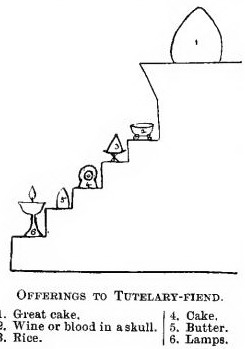 on each of which are set a series of one hundred and eight of the offerings noted, and on special feasts great bas reliefs of coloured butter are offered, many of them of artistic-designs. 1
on each of which are set a series of one hundred and eight of the offerings noted, and on special feasts great bas reliefs of coloured butter are offered, many of them of artistic-designs. 1
A still more elaborate arrangement of food-offerings is seen in the banquet to the whole assembly of the gods and the demons, entitled Kon-ch’og -chī- du, or ” Sacrifice to the whole assembly of Rare Ones,” which is frequently held in the temples. This feast is observed by Lāmas of all sects, and is an interesting sample of devil-worship. The old fashion is here detailed, but it differs from that of the reformed or high church only Offerings to Tutelary-Fiend.
1. Great cake. 2. Wine or blood in a skull. 3. Rice. 4. Cake. 5. Butter 6. Lamps.
in providing for a slightly larger party of demoniacal guests ; the Ge-lug-pa inviting only the following, to wit, their chief Lāma, St. Tsoṅ-K’a-pa, their tutelary deity Vajra-bhairava, Vajrasattva Buddha, the deified heroes, the fairies, the guardian demons of the Ge-lug-pa
1 Cf. HUC, ii.. 12; Rockhill, L ., 70.
creed, the god of wealth, the guardian demons of the caves where the undiscovered revelations are deposited, the five sister sprites of mount Everest, the twelve aerial fiendesses (Tan-ma), who sow disease, and the more important local gods.
This sacrifice should be done in the temples for the benefit of the Lāmas on the 10th and 15th of every month. On behalf of laymen it must be done once annually at the expense of every individual layman who can afford it ; and on extra occasions, as a thanksgiving for a successful undertaking, and as a propitiation in sickness, death, and disaster.
The arrangement of the banquet is shown in the foregoing diagram : —
In the inmost row are placed the large coloured and ornamented Baling cakes for
(a) the chief Lāma-saint, who in the case of the old school is St. Padma,
(b) the tutelary deity, in this case Guru tak-po, a fierce demoniacal form of the saint, and
(c) the she-devil with the lion-face.
For the saint there is also placed on either side of his cake a skull-cap, the one to his right containing country wine, here called “Ambrosia” (amrita), in Tibetan literally ” devils’ juice ” ; and the contents of the other are called blood (rakta), though tea-infusion is usually offered instead. In the second row are the cakes for the guardians and protector of Lāmaism, usually with Buddha’s cake (No. 4) in centre.
The order of the cakes for these guardian demons is as follows — the attached figures relate to the foregoing diagram : —
| No. 5. The Lion-faced demoness. | No. 13. The Nun-fiendess of Di-kung monastery |
| „ 6. The four-armed ” Lord,”a form of Mahākāla. |
,, 14. The five everlasting sisters of Mount Everest.
,, 7. The god of wealth.
,, 15. The spirits of the tank-drowned persons,
„ 8. The “Ruler of Tibet’s guardian” (and in Sikhim the special guardian of the Na-dukpa – monasteries),,. 16. The homestead demon-owner.
,, 9. The demon blacksmith(red and black colour rides a goat and carries an anvil and a bellows, was made a protector of Lāmaism by St. Padma).17. The country-god Kang-ehen-dsonga (mountain). –
10. The Lord of the Rākshas devils18. The black devil, red devil and Nāga of Darjiling or special locality of temple.11. The Locality protector.,, 19. The demons who cause disease.12. The Nāga demi-gods, white and black.„ 20. The twelve aerial fiendesses of disease (Tan-ma)No. 21. The demon owners of the “Ter” caves where the hidden revelations are deposited.
No. 22. The black and red devils and Nāga of parent monastery of the priests of this temple.
“In the third row are placed the “essential offerings ” already described, which are especially intended for the superior gods.
In the fourth and outmost row are an indefinite number of T’sog-cakes, which are especial dainties as an extra course for all. These cakes contain ordinary torma cake of cooked rice or barley, with the addition of some wine, and a mixture of cooked flesh and all sorts of eatables available.
The stages of the worship in this feast are as follows: —
1st. Invitation to the deities and demons to come to the feast (Skt., āvāhan). This is
accompanied by great clamour of drums, cymbals, horns and fifes, so as to
attract the attention of the gods and demons.
2nd. Requesting the guests to be seated (Skt.,āsan).
3rd. Begging them to partake of the food offered.
4th. Praises the goodness and admirable qualities of the guests. This is done while the
guests are partaking of the essence of the food.
5th. Prayers for favours immediate and to come.
6th. The especial delicacy, the T’sog cake, is then offered to all, on four plates, a plate
for each row of guests, and one plateful is reserved for the Lāmas themselves.
Then is done the ceremony of “Expiation for religious duties left undone,” 1 which wipes off all arrears of religious duty. Here the sacristan throws skywards, amid great clamour of wind and
brass instruments, several of the T’sog-cakes to all the demi-gods and demons not specially included in the feast. One T’sog-cake is then given to each Lāma in the order of his rank, from the highest to the lowest, as the food has been consecrated by the gods having partaken of it.
Each Lāma must, however, leave a portion, which is collected carefully, in a plate, in order, from the lowest to the head Lāma. And on the top of these collected fragments is placed a whole cake. Then a celebration called Lhak-dor is done, and the whole of these crumbs — the leavings of the Lāmas — are contemptuously thrown down on to the ground, outside the temple-door to the starveling ghosts and those evil-spirits who have not jet been subjected by St. Padma or subsequent Lāmas.
1 bsKaṅ-gso.
The efficacy of these cake-offerings is urged at length in the manual of the established church. 1 The special rites and celebrations are usually detailed in separate manuals ; but each Ge-lug-pa monk has a general manual of worship, etc., entitled ” the monk’s timely Memoranda,” 2 and seems to correspond in some measure to the Dina Chariyāwa of the Ceylonese, 3 in which are given directions for personal and general devotions as well as for monastic conduct, from which I have already made extracts in the chapter on the order.
The service is mostly in Tibetan, which is like the Latin of the papal mass-books used throughout Mongolia and Lāmaist temples in China, the only exception being the privileged temple at Pekin. 4 Music is much used, though it is in the main an earpiercing din of drums, loud trumpets, horns, and clashing cymbals.
The leaders of the choir also have a psalter or score in which the swelling, rising, and falling notes are curiously represented by curves, as shown in the annexed photograph ; and the points at which the several instruments join in the choir are also duly noted therein. The pauses are marked by bells and cymbals, and the effect at times of the noisy din and clamour suddenly lapsing into silence is most solemn, and even impressive in the larger cathedrals
with their pious and sombre surroundings. 5
1 The Ge-lug-pa manual says :—
The advantages to the chanter of the above service are that : His wishes will be all realized ; wealth and luck will increase according to his wishes ; he will obtain power, and all his sins will be blotted out ; he will subject the evil spirits and will duly perform charity, and the preta will obtain deliverance by being re-born in the heavens, and he himself will also obtain heaven, and it has been said that he will ultimately obtain Buddhahood.
The burnt-offering of incense, analogous to the Vedic Homa, but specially intended for demons, includes by name the Tan-ma and other Tibetan fiends. It is a mixture of incense and butter heated to ignition on coals. The celebration is detailed above. Cf. also Schlag., p. 249 ; JAESCH., p. 210, for kinds of cakes 2 dGe-slon-gi dus dran. 3 East Mon., 24, and also ” the Daily Manual of the Shaman” of the Chinese. Beal’s Catena, 239. 4 Cf. KOPPEN, ii., 228. 5 Although the instruments are wielded with greaT clamour, each is manipulated strictly according to rule. Thus with the cymbals, at the word Argham the cymbals are held horizontally and struck with mid-finger erect. On Parghaṃ ,held below waist and the upper cymbal is made to revolve along the rim of the lowest, etc., etc.
The daily celebrations of the high church monk, or the Ge-lug-pa Lāma, comprise the following services : —
1. The “Refuge-formula” (mT’un-moṅ).
2. mT’uṅ-moṅ ma-yiṅ-pa.
3. The four-fold prayer for the Animals (Sems-bskyed).
4. Another prayer for Animals (K’yad-par gyi smes-bskyed).
5. Prayer for the Earth (Sa-gz’i byin brlabs).
6. Sacrificial offerings (mCh’od-pa byin brlabs).
7. Invocation to the Jinas (Spyan-‘dren).
8. Offering of bathing water to the Gods and Jinas (K’rus-gsol. ” Tui-Sol”).
9. Salutation to Buddhas, Saints and Lāmas (P’yag-‘t’sal).
10. Offerings of ” the necessary things ” (mCh’od-pa).
11. Offerings of ” five sensuous things” (‘Dod-yon-lṅa).
12. Offerings of ” seven precious things ” (rgyal-sri sna bdun).
13. Confession of Sins (bS’ags-pa).
14. In praise of the Jinas and Buddha-putras (rJes-su yi-raṅs).
15. Turning the Wheel of the Law (Ch’os-‘k’or bskor-wa).
16. Prayer for attaining Nirvāṇa (Mya-ṅan las-mi ‘das was gsol-wa ‘debs-pa).
17. Prayer for Blessing (bsṅo-wa).
18 Magic-circle — Offering of the Universe.
19. Prayer to Lāma-tutor. 1
20. The Tutelary’s invocation — Yamāntaka, etc. (for Ge-lug-pa) and
Guru Tak-po Kah-gye, etc., for Ñiṅ-ma.
21. Sacrificial worship (ch’oga) to the demons, after dark with cake (torma), incense and wine with the libations (gSer-skyems) the Kang-so banquet.” 2
We will illustrate a few of these services by some abstracts and extracts : —
A good sample of the worship of a Lāmaist divinity is seen in that of Tārā, the Virgin of northern Buddhism, and the “Goddess of Mercy.”
The manual of Tārā’s worship 3 is one of the commonest booklets in Tibet, and is in the hands of nearly all laymen, most of whom can repeat her hymn and chief service by heart. 4
1 La-mai-gsol-‘debs. 2 See p. 429. 3 Abstracted by me in considerable detail in J.R.A.S., 1894, p.68. etc. 4 The book is entitled “sGrol-ma dkar sṅon-gyi bstod-pa gzuṅs,” or ” The praise and spells (Dhāraṇī) of The Pure Original Tārā.” And in some editions she is termed “Mother of the Jinas” (rgyal-yum), also ” Mother of the Tathāgathas.” The manual extends to thirty-eight or forty pages of five lines each. The greater portion, including ” The Exhortation” and “The Hymn,” is alleged internally to have been composed by “The great Vairocana-Buddha of the Ultimate Perfection” [dsog,-pai saṅs-rgyas rnam par snaṅ-mdsad ch’en-po] and usually interpreted by the Lāmas as referring to Vairochana, the first of the mythical Jina-Buddhas ; but it may probably be the Kashmir Monk Vairocana, of the ” Great Ultimate Perfection (Mahā-utpanna) ” form of the Buddhist doctrine, who lived in the eighth century CE., and a noted translator of Sanskrit Scriptures into the Tibetan. An appendix is signed by Gedun Ḍub The Grand Lāma, who built Tashi-lhunpo monastery circa 1445 A.D.
TĀRĀ THE SAVIOUR AND GODDESS OF MERCY.
Tārā’s Worship.
Tārā’s worship, like that of most of the Mahāyāna and Tāntrik deities, is divided into the seven stages already mentioned. The service is chanted in chorus, and the measure used in chanting the hymn, namely trochaic in eight-syllabled lines, I have indicated in a footnote to the hymn.
A portion of the manual is here translated —
” If we worship this sublime and pure-souled goddess when we retire in the dusk and arise in the morning, then all our fears and worldly anxieties will disappear and our sins be forgiven. She— the conqueror of myriad hosts— will strengthen us. She will do more than this ! She will convey us directly to the end of our transmigration — to Buddha and Nirvāṇa !
“She will expel the direst poisons, and relieve us from all anxieties as to food and drink, and all our wants will be satisfied; and all devils and plagues and poisons will be annihilated utterly ; and the burden of all animals will be lightened ! If you chant her hymn two or three or six or seven times, your desire for a son will be realized ! Or should you wish wealth, you will obtain it, and all other wishes will be gratified, and every sort of demon will be wholly overcome.”
“Hail! 0! verdant Tārā!
The Saviour of all beings !
Descend, we pray Thee, from Thy heavenly mansion, at Potala,
Together with all Thy retinue of gods, titans, and deliverers ! ‘
We humbly prostrate ourselves at Thy lotus-feet !
Deliver us from all distress ! holy Mother ! ”
Presentation of Offerings (Sacrificial).
” We hail Thee ! rever’d and sublime Tārā !
Who art adored by all the kings and princes
Of the ten directions and of the present, past and future.
We pray Thee to accept these offerings
Of flowers, incense, perfumed lamps,
Precious food, the music of cymbals,
And the other offerings !
We sincerely beg Thee in all Thy divine Forms
To partake of the food now offered !
On confessing to Thee penitently their sins
The most sinful hearts, yea ! even the committers of the
Ten vices and the five boundless sins,
Will obtain forgiveness and reach
Perfection of soul — through Thee !
If we (human beings) have amassed any merit
In the three states, 2
We rejoice in this good fortune, when we consider
The unfortunate lot of the poor (lower) animals
Piteously engulphed in the ocean of misery.
On their behalf, we now turn the wheel of religion !
We implore Thee by whatever merit we have accumulated
To kindly regard all the animals.
And for ourselves !
When our merit has reached perfection
Let us not, we pray Thee,
Linger longer in this world ! ”
Hymns in Tārā’s Praise.3
(The translation I have made almost literal. Each separate stanza
is addressed to a special one of Tārā’s twenty-one forms — the name of
which is given in the margin for reference.)
(Tārā, the Mother.) Arya Tārā ! Hail to Thee !
Our Deliverers sublime !
Avalok’ta’s messenger
Rich in power and pity’s store.
1 The polymorphism already referred to. 2 Kāma, Rūpa, and Arūpa 3 As this hymn is so popular amongst Lāmaist people in Tibet, Sikhim, etc., I give here in the Lhāsa dialect its, second stanza, which is the proper commencement of the hymn, in order to -how its metre.
Ch’ag ts’al | Do-ma | nur-ma | pa-mo |
Ch’en-ni | ke-c’ig | log-taṅ | ta-ma |
Jlg-ten | sum gon | c’u kye | z’al-gyi |
Ke-sar| c’e-wa | le-ni | juṅ-ma | .
(1. Tārā, the Supremely
Courageous.) Hail O Tārā ! quick to Save !
Lotus-born of pitying tear
Shed down by The Three-World-Lord,
(Grieving sad for sunken souls.)
(2. Tārā, of White-moon
Brightness.) Hail ! to Thee with fulgent face,
Brilliant as a hundred moons
Of harvest gleaming in the light
Of myriad dazzling stars.
(3. Tārā, the Golden-
Coloured.) Hail ! to Thee whose hand is decked
By the lotus, golden blue.
Eager Soother of our woe,
Ever tireless worker, Thou !
(4. Tārā, the Grand
Hair-piled.) Hail ! to Thee with pil’d-up hair,
Where Tathāgata sits shrin’d,
Victor 1 of the universe.
Thou a saintly victor too !
(5. Tārā, the ” Huṅ”
Shouter.) Hail to thy ” tut-Tārā-huṅ,” ~
Piercing realms of earth and sky,
Treading down the seven worlds,
Bending prostrate everyone !
(6. Tārā, the best Three-
World Worker.) Hail ! adored by mighty gods,
Indra, Brāhma, Fire and Wind,
Ghostly hordes and Gandharvas
All unite in praising Thee !
(7. Tārā, the Suppressor
of Strife.) Hail ! with Thy dread ” tre ” and “phat ” 3
Thou destroyest all Thy foes :
Striding out with Thy left foot
Belching forth devouring fire !
(8. Tārā, the Bestower
of Supreme Power.) Hail ! with fearful spell ” tu-re “
Banishing the bravest fiends,
By the mere frown of Thy brows,
Vanquishing whole hordes of foes!
etc., etc., etc., etc
1 rgyal-wa = Sanskrit Jina. 2 This is a portion of Tārā’s spell, for which see over page. 3 Mystic spells used by wizards — phat means break or smash !
Telling the Rosary.
[Here is repeated on the rosary 108 times, or as often as possible, the spell or mantra of Tārā, namely : Om ! Tā-re-tu-tā-re tu-re Svā hā !
The mantra of Sīta Tārā is Om! Tā-re tu-tā-re ma-ma ā-yur-pun-ye jna- na-push-tin ku-ru Svā-hā !
The rosary used in Sīta Tārā’s worship is a Bodhitse, while Tārā requires either a Bodhitse or turquoise one. 1 ]
Prayers for Blessings.
We implore thee, O ! Revered Victorious Bhagavāti ” and Merciful One ! to purify us and all other beings of the universe thoroughly from the two evil thoughts ; and make us quickly attain the perfection of Buddhahood. If we cannot attain this perfection within a few life cycles, then grant us the highest earthly and heavenly happiness and all knowledge. And preserve us, we beseech Thee, from evil spirits, plague, disease, untimely death, bad dreams, bad omens, and all the eight fears and accidents. And in our passage through this world grant unto us the most perfect bliss, beyond possibility of increase, and may all our desires be realized without exertion on our part.
Let the holy religion prosper. And in whatever place we dwell, we beg thee to soothe there disease and poverty, fighting and disputes, and increase the Holy Religion.
And may Thy benign 3 face always beam on us and appear large like the waxing moon in forwarding our heart’s desire of admission to the heavenly circle and Nirvāṇa.
Let us obtain the favourite gods 4 of our former lives and entry into the prophesied paradise of the Buddhas of the past, present and future !
Now ! O ! Thou ! The Great Worker !
Thou Quick Soother and Gracious Mother,
Holding the uptal flower !
Let Thy glory come. Maṅgalam ! 5
The offering of the universe as a so-called ” magic-circle ” is an essential part of the daily service of the Lāmas, and has been described in the previous chapter.
The following hymn in praise of the Three Holy Ones is recited at noon with the presentation of the offering of rice.
1 But see page 206 for details on ” Lāmaist Rosaries.” 2 bc’om-ldan-‘das-ma, pronounced “chom-den-de-ma.” 3 In contradistinction to “fury-face” (khro-bo; Skt. krodha). 4 sGrub-bahi-lha. 5 bgra-shis shok, pronounced ” Tā-shi-sho.”
Hymn to the Three Holy Ones.
OM ! Salutation to the Omniscient Ones! Buddha, The Law and The Church !
Salutation to Buddha Bhagavān, the Victorious and All-wise Tathāgata Arhat, who has gone to happiness !
| He is the guide of gods and men ! | His melodious voice is all-pleasing. |
| He is the root of virtue. | He is without equal. |
| He is the fountain of all treasure. | He is without desires. |
| He is adorned with perfect endurance. | He is without evil. |
| He is adorned with all-beauty. | He delivers all from sorrow. |
| He is the greatest flower of all the race. | He delivers all from sin. |
| He is admirable in all his actions. | He is free from worldliness. |
| He is admirable in the eyes of all. | His senses are the sharpest |
| He delights in the faithful ones. | He bravely cuts all knots. |
| He is The Almighty Power. | He delivers all from deepest misery. |
| He is The Universal Guide. | He delivers all from this woeful world. |
| He is The Father of all the Bodhisats | He has crossed the ocean of misery. |
| He is The King of all the revered Ones. | He is perfect in fore-knowledge. |
| He is The Leader of all the dead. | He knows the past, present and future. |
| He owns infinite knowledge. | He lives far from death. |
| He owns immeasurable fortitude. | He lives in the pure blissful land where, |
enthroned, he sees all beings !His commands are all-perfect.
Salutation to the Holy Law ! — (Dharma)
| It was the virtue of the ancient times. | It is all-perfect and illuminating. |
| It was the virtue of the middle ages. | It is the all-pure Law. |
| It is the virtue of the present hour | It is perfectly clear. |
| It has excellent sense. | It is free from disorder. |
| It has excellent words. | It is everlasting. |
| It is unalloyed Law. | It points the direct path |
| It benefits the wisest men. | It realizes the desires of all. |
The Law has been well ordered and taught in the Vinaya by Bhagavān. It brings all to perfection ! It fulfils all desires ! It is an all-sufficient support, and it stops re-birth.
Salutation to The Assembly or Clergy (Saṅgha) of the Mahāyāna !
| They live in peace. | They live in unison. |
They live in wisdom.They merit respect.
They live in truth.
They merit the grandest gifts.
They merit glory.
The goodness of Buddha is immeasurable !
The goodness of The Law is immeasurable !
And the goodness of The Clergy is immeasurable !
By planting our faith on The Immeasurable Ones we shall reap immeasurable fruit in the land of bliss.
Salutation to the Tathāgata ! The Merciful Patron, the omniscient Guide, the ocean of knowledge and glory.
Salutation to the softening Dharma ! the pure gift of the heart, the deliverer from evil, and the best of Truth.
Salutation to the Assembly ! the deliverer, and guide to the true faith, the teacher of pure wisdom, and the possessor of the holy knowledge for cultivating the (human) soil.
The ” Refuge-Formula ” of the Lāmas.
The ” Refuge-formula ” of the Lāmas, which I here translate, well illustrates the very depraved form of Buddhism professed by the majority of Lāmas ; for here we find that the original triple
Refuge-formula (Skt., Triṣaraṇa ; Pali, Ṣaraṇagamama) in the Three Holies, the Triratna— Buddha, The Word, and The Assembly — has been extended so as to comprise the vast host of deities, demons and deified saints of Tibet, as well as many of the Indian Mahāyāna and Yogācārya saints.
The version here translated is that used by the Kar-ma-pa and Ñiṅ-ma sects of Lāmas, but it is practically the same as that in general use in Tibet, except among the reformed Lāmas of the established church — who address a less extensive circle of saints and demons, and who substitute St. Tsoṅ-K’a-pa for St. Padma-sambhava. It is extracted from the manual of worship entitled the sKyabs-‘gro, commonly pronounced “Kyamdo,” 1 which literally means “the going for protection or refuge”; and its text is as follows : —
” We — all beings — through the intercession of the Lāma, 2 go for refuge to Buddha !
” We go for refuge to Buddha’s Doctrine {Dharma) !
” We go for refuge to the Assembly of the Lāmas (Sangha) ! 3
We go for refuge to the Host of the Gods and their retinue of tutelaries and she-devils, the defenders of the Religion, who people the sky !
_________________________________________________________________________-
1 Contributed to Ind.Antiq. 1893. 2 It is a Lāmaist axiom, as already noted, thai no layman can address the Buddhas except through the medium of a Lāma. 3 The Ge-lug-pa formula begins thus: bdag sogs nam-mkah daṅ mñams-paī sems-c’an t’ams-c’ad bLa-ma la skyabs su mch’io, Saṅs-rgyas-kyi skyabs-su mch’io Ch’os-kyi skyabs su mch’io, dGe-‘dun-gyi skyabs su-mch’io.
” We go for refuge to the victorious Lāmas, who have descended from heaven, the holders of Wisdom and the Tāntras ! ” We go for refuge to the Buddhas of the Ten Directions, and to the primordial Samantabhadra. Buddha with his spouse!”
Then the following deities and saints are addressed as refuges : The Incarnate Sambhoga-kāya, the Mild and Angry Loving One the Nirmāṇa-kāya Māha Vajradhara ; the Diamond-souled Guide — Vajrasatva ; the Jina — the Victorious Ṣākya Muni ; the most pleasing Vajra Incarnate ; the Fierce Holder of the Thunderbolt — Vajra-pāṇi the Goddess-Mother, Marīcī Devi ; the Learned Teacher, Acārya-Mañjuṣṛī ; the Great Paṇḍita Ṣrī Siṅha ; the Jina Suda ; the Great Paṇḍita Bimala Mitra ; the Incarnate Lotus-born Dharmakāya Padma-sambhava ; (his wife) the Fairy of the Ocean of Fore-knowledge ; the Religious King, Thi-Sroṅ-deu-Tsan ; the Noble Apocalypse-Finder, Myaṅ-ban ; the Teacher’s disciple, the Victorious Sthavira Dang-ma :
the Reverend Sister, the Lady Siṅheṣwara ; the Incarnate Jina ” Zhang-ton “; the Guru, clever above thousands ; the Religious Lord (Dharma-nātha) Guru Jo-Ber ; the Illusive Lion Gyāba ; the Great Siddhi, the Clearer of the Misty moon — grub-ch’en zla-wa-mun-sel ; the Sage
Kumaraja; the Prince, Bimāla Bhāskara ; the renowned Candrakīrti ; the Three Incarnate Kind Brothers ; the Bodhisat, The noble Ocean ; the Incarnate Sage, the Holder of the religious vajra ; the Entirely accomplished and renowned Speaker ; the Great Teacher Māhaguru
Dharmarāja ; the Revelation-Finder T’ig-po-liṅ ; the Religious King of Accomplished Knowledge 1 ; the Banner of Obtained Wisdom ; the Peerless active Vajra; the Radical (Skt.. Mūla ) Lāma Aṣoka;2 the Lāma of the Mūla Tantra of the Three Times; the Sage, the Accomplished Soul ; the Religious Loving King, the Holder of the Doctrines 3 ; the Reverend Abbot, the Sky Vajra ; the Noble Jewelled Soul — ” Palzaṅ ” ; the Assembly of Mild and Angry tutelary Deities; the Holy Doctrine of the Great End — Mahotpanna !
“ We go for refuge to the Male and Female Saints of the Country !
“ O ! Lāma ! Bless us as You have been blessed. Bless us with the blessings of the Tāntras! —
“ We beg You to bless us with OM, which is the (secret) Body. We beg You to purify our sins and pollutions of the body. We beg You to increase our happiness without any sickness of the body. We beg You to give us the real undying gift of bodily life !
” We beg You to bless us with AH, which is the (secret of the) Speech. We beg You to purify the sins and pollution of our Speech.
1 The first Bhotiya king of Sikhim, circ. 1650 CE. 2 This may be a reference to the great emperor Aṣoka, or his confessor Upagupta, the fourth patriarch of the early Buddhist church in India, or it may be only the title of a Lāma. Several also of the foregoing titles which I have translated are proper names. 3 The sixth Bhotiya king of Sikhim, circ.1770-90
We beg You to give us the power of Speech. We beg You to confer
on us the gift of perfect and victorious Speech !
“We beg You to bless us with HŪṂ (pronounced ” hūṃ”) which is the (secret) Thought. We beg You to purify the pollution and sins of our Mind. We beg You to give us good understanding. We beg you to give us the real gift of a pure heart. We beg You to empower us with The Four Powers (of the heart) !
” We pray You to give us the gifts of the True Body, Speech, and Mind. 1 Om ! Ah ! Hūṃ !
” O ! Give us such blessing as will clear away the sins and defilement of bad deeds !
” We beg You to soften the evils of bad causes !
” We beg You to bless us with the prosperity of our body (i.e., health) !
” Bless us with mental guidance !
” Bless us with Buddhahood soon !
” Bless us by cutting us off from (worldly) illusions !
” Bless us by putting us in the right path !
” Bless us by causing us to understand all things (religious) !
” Bless us to be useful to each other with kindliness !
” Bless us with the ability of doing good and delivering the animal beings (from misery) !
” Bless us to know ourselves thoroughly !
” Bless us to be mild from the depths of our heart !
” Bless us to be brave as Yourself !
” Bless us with the Tāntras as You Yourself are blessed ! “
” Now ! we — the innumerable animal beings — conceiving that (through the efficacy of the above dharanis and prayers, we have become pure in thought like Buddha himself ; and that we are working for the welfare of the other animal beings ; we, therefore, having now acquired the qualities of the host of the Gods,and the roots of the Tāntras, the Z’i-wa, rGyas-pa, dBaṅ and P’rin-las, we desire that all the other animal beings be possessed of happiness, and be freed from misery ! Let us —all animals ! — be freed from lust, anger, and attachment to worldly affairs, and let us perfectly understand the true nature of The Religion !
“Now! O! Father-Mother — Yab-yum — the Dharmakāya Samanta-bhadra ! The Sambhogakāya Ṣānti Khroda Prasaraka, mild and angry Loving Ones ! The Nirmāṇa-kāya, Sages of the skull-rosary ! And the Mūla-tāntra Lāma ! I now beg You all to depart !
” O ! Ghosts of Heroes ! Witches ! Demoniacal Defenders of The Faith! The holy Guardians of the Commandments! And all those that we invited to this place ! I beg You all now to depart !
” O! most powerful King of the Angry Deities ! The powerful Isvara, and the host of the Country Guardian Gods ! And all those
1 This triad refers to the mystic Yoga or union of “The three secrets,” which the Japanese call, San-mitsu-sō–ō.
others that we invited to this place, with all their retinue ! I beg You all now to depart ! ! ! May glory come ! Tashi-shok ! and Virtue ! Ge-o ! Sarva-maṅgalaṃ ! “
Confession of Sins.
The Confession of Sins 1 is done twice a month in public assembly, in presence of the abbot and senior monks. It is no proper confession, only a stereotyped form chanted in chorus.
The full form is practically the same as in southern Buddhism. 2 The shortest form is here given : —
” I here confess the sins which I may have committed by the body, speech and mind, and through lust, anger and stupidity.
” Listen to me, O ! great Vajra-holding Lāmas 3 and all the Buddhas and Bodhisattvas of the ten directions ! I repent of all the sinful acts which I have committed from the time of my birth up to the present, such as : committing the ten non virtuous deeds and the five waverings, transgressing the vows of deliverance, the teachings of the Bodhisatta, the vows of the secret mantras, irreverence, and want of faith in The Three Rarest Ones, irreverence and want of faith in the abbots and teachers ; separation from the holy religion and the best commands ; want of reverence to the revered clergy ; want of reverence to parents, and want of reverence to one’s faithful fellow-mortals. In short, I here confess to all the Vajra -holding Lāmas, the Buddhas and Bodhisattvas of the ten directions, all the sins which hinder my reaching the heaven of deliverance; and I promise never again to commit these sins.”
There are also numerous rites on the same lines or by magic-circles, posturing and mummery, for obtaining supernatural powers and for purposes of sorcery. Some of these latter I have abstracted in the chapter on necromancy.
The Magic-Circle Tabernacle.
1. Chart or Mosaic. 2. Cakes. 3.Umbrella. 4. Banners.
1 gso-byoṅ. See pages 323 and 501 ; and cf. Schlagintweit, p. 123. 2 Cf . Pratimoksha sutra, ” The Book of Deliverance ” and its Tibetan version, trans, by Rockhill. 3 Probably mythical Buddha, Vajradhara.
Of special celebrations it will suffice to refer only to one of the most interesting, which some Europeans who witnessed its pompous and solemn service, have compared to the Christian Eucharist.
The ” Eucharist ” of Lāmaism. 1
This Lāmaist liturgy, the celebration of which is pictured as the frontispiece, on account of its dispensation of consecrated wine and bread, has been compared by Huc and others to the Christian Eucharist, although it is in reality, as here shown, a ceremony for gratifying the
rather un-Buddhistic craving after long earthly life. Still, it nevertheless presents many
parallels to the Christian rite for conferring on the worthy recipient ” the life everlasting.”
It is entitled ” The Obtaining of (long) Life,” 2 and is a very good sample of the Lāmaist blending of Buddhists’ ideas with demon- worship. It seems to incorporate a good deal
of the pre-Lāmaist ritual, and its benedictions and sprinkling of holy water are suggestive of
Nestorian or still later Christian influences.
This sacrament is celebrated with much pomp at stated periods, on a lucky day, about once a week in the larger temples, and attracts numerous votaries.
1 In the Asiatic Quarterly, 1891, part of this article was published by me. 2 Tib. Ts’e-grub.
Crowds throng to the temple to receive the coveted blessing. Its benefits are more particularly sought in cases of actual illness, and when death seems imminent; but every village must have it performed at least once a year for the life of the general community, and after its performance any prolongation of life is credited to this service: while a fatal result is attributed
to the excessive misdeeds of the individual in his last life or in previous births.
The chief god addressed is Buddha Amitāyus or Aparamita,1 “The (god of) infinite Life,” or “The Eternal.” Unlike the Chinese Buddhists the Lāmas never confuse Amitābha the Buddha of infinite Light) with his reflex Amitāyus . they represent these differently, and credit them with different functions. The other gods specially identified with life-giving powers are “The five long-Life Sisters,’- mountain nymphs presiding over the everlasting snows, and to a less degree the white Tārā, and Ushṇīsharāni ; and even Yarna, the Lord of Death himself, may occasionally be propitiated into delaying the day of death.
The priest who conducts this ceremony for propitiation of Amitāyus and the other gods of longevity must be of the purest morals, and usually a total abstainer from meat and wine. He must have fasted during the greater part of the twenty four hours preceding the rite, have
repeated the mantras of the life-giving gods many times, 1.00,000 times if possible, and he must have seemed ceremonial purity by bathing.
The rite also entails a lot of other tasks tor the preparation of the consecrated pills and the arrangement of utensils, etc., and extends over two or three days.
The arrangements are as follow : —
Upon an altar, under the brocaded dragon-canopy, within the temple or in a tent outside, are placed the following articles : —
1. Las-bum, the ordinary altar water-vase.
2. Ti-bum, the vase with pendant mirror and containing water tinged with saffron,
3. dBaṅ-bum. the “empowering vase” with the chaplet of the Five Jinas.
4. Ts’e-bum, the “vase of Life,” special to Amitāyus, with a banner of peacock’s
feathers and sacred Kuṣa-grass.
5. Ts’e-ch’aṅ, or ” the wine of Life,” consisting of beer in a skull-bowl.
6. Ts’e-ril, or the “pills of Life,” made of flour, sugar and butter.
7. Chi-mar, or wafers of flour and butter and rice.
8. mDah-dar, or sacred divining-dagger with silk tassels.
9. rdor-jehi gzuṅ t’ag , or the divining-bolt, a vajra or thunderbolt-sceptre with eight
ridges to which a string is attached.
In the preliminary worship the pills are made from buttered dough, and the ambrosia or amṛita (Tib., dud-tsi or “devil’s juice”) is brewed from spirit or beer, and offered in a skull-bowl to the great image of Buddha Amitāyus.
1Tib., Ts’e-pag-med. 2 Ts’e-riṅ-che-ṅa
Everything being ready and the congregation assembled, the priest, ceremonially pure by the ascetic rites above noted, 1 and dressed as in the frontispiece, abstracts from the great image of Buddha Amitāyus part of the divine essence of that deity, by placing the vajra of his rdor-jehi gzuṅ-t’ag upon the nectar-vase which the image of Amitāyus holds in his lap, and applying the other end to his own bosom, over his heart. Thus, through the string, as by a telegraph wire, passes the divine spirit, and the Lāma must mentally conceive that his heart is in actual union with that of the god Amitāyus, and that, for the time being, he is himself that god. 2
Then he invokes his tutelary-fiend, and through him the fearful horse-necked Hayagrīva (Tamdin), the king of the demons. The Lāma, with this divine triad (namely, the Buddha and the two demon kings) incorporate in him, and exhibiting the forms of all three to spiritual eyes, now dispenses his divine favours. He takes up the Las-bum-va.se and consecrates its contents, saying,
” Om! namo Tathāgata Abhi-khita samayasriri hūṃ ! Nama candra vajra krodha
Amṛita hūṃ phat! ”
Then he sprinkles some of the water on the rice-offerings (gtor-ma) to the evil spirits, saying, “I have purified it with svabhava, and converted it into an ocean of nectar within a precious Bhum-bowl. Om akaromu-kham ! Sarva dharma nantyanutpanna tatto ! Om ! A !
Hūṃ ! phat ! Svāhā ! I now desire to bestow the deepest life-power on these people before me ; therefore, I beg you demons to accept this cake-offering, and depart without doing further injury.”
Here the Lāma, assuming the threatening aspect of the demon-kings, who are, for the time being, in his body, adds, ” Should you refuse to go, then I, who am the most powerful Hayagrīva and the king of the angry demons, will crush you — body, speech and mind — to dust ! Obey my mandate and begone, each to his abode, otherwise you shall suffer.
Om sumbhani,” etc. Now, the Lāmas and the people, believing that all the evil spirits have been driven away by the demon-king himself, shout, ” The gods have won ! the devils are defeated ! ”
The Lāma then proceeds to secure for himself the benedictory power of life-conferring. He first meditates on “the guardian-deities,” murmuring thus : “The upper part (of the divine abode) is of thunderbolt tents and hangings;
1 He usually wears a mantle (stod-gyog), on which are embroidered mystic Chinese emblems of luck, including the 5 Bats, etc. See pp. 394, 396. 2 In southern Buddhism is found a very similar instance of ceremonial union with a Buddhist fetish. At the pirit (paritta) celebration ” a sacred thread, called the pirit nula, is fastened round the interior of the building, the end of which, after being fastened to the reading platform, is placed near the relic (of Buddha). At such times as the whole of the priests who are present engage in chanting in chorus, the cord is untwined, and each priest takes hold of it, thus making the communication complete between each of the officiating priests, the relic, and the interior walls of the building.” — HARDY’s E. Monachism, p. 241.
the lower part of earth-foundation and adamantine-seat ; and the walls are of thunderbolts. The entire building is a great tent, protected by precious charms, so that the evil spirits can neither destroy it, nor can they gain entry. Om! vajra rakhya rakhya sūtra tikhtha vajraye svā hā !”
Then the magic-circle (maṇḍala) is offered up, saying : —
” If I fail to refer to the successive Lāma-saints, my words and deeds will count for nothing. Therefore must I praise the holy Lāmas to secure their blessing towards the realization of my plans, O holy Padma-sambhava1 in you are concentrated all the blessings of the present, past and future! You are the Buddha of the great final Perfection (Maha-utpanna) who beheld the Face of Lord Amitāyus. O Saint possessed of the gift of undying life, of life lasting till the worlds of re-births are emptied ‘. You hid away from us, in the snowy regions, the revelation upon the true essence of the five hundred ‘Obtainings of Life.’ The one which we now perform is ‘the iron palace of the attainment of life’ ( Ts’e-grub lc’ags-kyi-pho-braṅ), and is extracted from dKon-mchog-spyi-dus, It was discovered by the saint ‘Dsah-Ts’on-sñiṅ-po in the cave where you hid it ; and this mode of endowering a person with life has come down to me through many generations of saints. Now, O Lord Amitāyus and the host of radiant
gods ! I beg you to sustain the animal beings, vast as the starry host, who now, with
great reverence and praise, approach you. Om a hūṃ! O holy shrine of our refuge !
Hri.”2 O Hosts of the Bright World of Light! Pad-ma t’od-phreṅ-rtsal-vajrasa-
mayaja siddhi phala hūṃ .‘ ”
Then here is repeated ” Ts’e-‘gug” or “The Invoking of Life,” thus :
“0 Lord Amitāyus, residing in the five shrines whence glittering rays shoot forth ! Gandharva in the west ! Fama in the south ‘. Nāga rāja in the west ! Yaksha in the north! Brāhma and Indra in the upper regions! and Nanda and Taksha in the lower regions ! And especially all the Buddhas and Bodhisatvas ! I beg you all to bless me and to gratify my wishes by giving me the gift of undying life and by softening all the injuries of the harmful spirits. I entreat you to grant life and implore you to cause it to come to me. Hrī! I beg your blessing, Buddhas of the three times. (Dipaṅkara, Ṣākya Muni and Maitreya).
At this stage the celestial Buddhas, Bodhisattvas, and other gods are now supposed to have consecrated the fluid in the vase and transformed it into immortal ambrosia. Therefore the priest intones the following chant to the music of cymbals : “This Vase is filled with the immortal ambrosia which the Five celestial Classes have blessed with the best Life. May life be permanent as adamant, victorious as the kings-banner. May it be strong like the eagle (Gyuṅ -druṅ) and last for ever. May I be favoured with the gift of undying life, and all my wishes be realized.
“Buddha! Vajra! Ratna!
Padma! Karma, Kapalāmāla.
Hrī mahārinisaayu Siddhi phala hūṃ.’
Om A hūṃ vajra Guru Padma siddhi ayukke Hum nijā ! “
The priest now bestows his blessing as the incarnate Amitāyus as well as the other gods of longevity, by laying-on of hands, and be distributes the consecrated water and food to the assembled multitude. When the crowd is great, the votaries the past the holy Lāma.
1 A Lāma of the established church would usually invoke St. Tsoṅ-K’a-pa, and the subsequent prayer would be slightly different. 2 The Vija-mantra of Avalokita and Amitābha.
In smaller congregations the Lāma, with the Ti-bum vase in hand, walks along the rows of kneeling worshippers near the temple door, and pours a Few drops of the holy fluid into the hands of each votary. With the first Few drops the worshipper rinses his mouth, and with the next Few drops he anoints the crown of his head, and the third few drops are reverently swallowed.
Then the Lāma brings the vase of Life and places it for an instant on the bowed head of each of the kneeling votaries, reciting the spell of Amitāyus (Om Amarani jivantiye svāhā), which all repeat. Then the Lāma touches the head of each one with the power-conferring vase; and afterwards, in similar manner, with the divining-dagger, saying: ‘The life which you now have obtained is unfailing like the vajra-armour. Receive it with reverence! As the vajra is unchangeable, so now is your life. Vajra rakhya rakhya svāhā! Worship Amitāyus, the god of boundless Life, the chief of all world-rulers ! May his glory come, with virtue and all happiness.” And all the people shout. ” Glory and all-happiness ! ”
Each worshipper now receives from the skull-bowl a drop of the sacred wine, which he piously swallows; and each also receives three of the holy pills, the plateful of which had been consecrated by the touch of the Lāma. These pills must be swallowed on the spot. They are represented as beads upon the vase which the image of the god of Infinite Life holds in his lap.
The Lāma then takes a seat on a low throne, and the votaries file past him offering him a scarf and any money presents they may have to make : the majority pay in grain, which is piled up outside the door of the temple. Each then receives a benediction from the Lāma, who places his hand on their heads and repeats the spell of Amitāyus , and on, its conclusion he throws over their shoulder a knotted white scarf (Tsim-tu) from a heap of consecrated scarves lying at his side. Tlie colours of the scarves are white for the laity and red for the priests.
Other ceremonies for prolonging life, especially resorted to in severe sickness, are -‘The Saving from Death ” (‘ch’i-bslu) ; the “Ransoming of another’s Lite” (srog-bslu) ; Substitution-offering to the devils of an effigy of the patient, or as a sacrifice for sin ( Ku-rim) 1 as in the illustration given on the opposite page ; Libation of wine to the demons (gSer-sky ems); gyal-gsol, etc. All of these services are more or less mixed up with demonolatry.
Numerous other ceremonies have already been referred to in other chapter-, such as the Water Baptism ” (“Tui-Sol “), 2 “The Calling lor Luck ” (Yaṅ-gug ), 3 etc.. -The Continued Fast ” (Ñuṅ-gnas).4
1 sKu-rim: cf. JAESCH., D., 22 GIORGI’s Alphab. Tib.,p. 442; ROCKHILL’s L. p. 114. 2 bKrus-gsol = ablution + to pray or entreat ; see SCHLAGINTWEIT, Budd, p. 239 3 See p. 447 : also SCHLAG., p.263, 4 SCHLAG., p.240.
SACRIFICE-OFFERINGS TO DEVILS.
The rites for the attainment of supernatural powers, and for downright demonolatry, are detailed in the chapter on sorcery and necromancy. And it is evident that the Lāmas or professing
A Guilt-Offering at Tankar.1
Buddhists are conscious of the unorthodoxy of these practices, for the so-called reformed Lāmas, the Ge-lug-pa, do their demoniacal worship mostly after dark.
1 After Rockhill.
ASTROLOGY AND DIVINATION.
“That mendicant does right to whom omens, planetary influences, dreams,
and signs are things abolished; he is free from all their evils.”
Samma Paribbājaniya Sutta, 2.
Like most primitive people, the Tibetans believe that the planets and spiritual powers, good and bad, directly exercise a potent influence upon man’s welfare and destiny, and that the portending machinations of these powers are only to be foreseen, discerned, and counteracted by the priests.
Such beliefs have been zealously fostered by the Lāmas, who have led the laity to understand that it Is accessary for each Individual to have recourse to the astrologer-Lāma or Tsi-pa on each of t he three great epochs of life, to wit, birth, marriage, and death : and also at the beginning of each year to have a forecast of the year’s ill-fortune and its remedies drawn out for them.
These remedies are all of the nature of rampant demonolatry for the appeasing or coercion of the demons of the air, the earth, the locality, house, the death-demon, etc. Indeed, the Lāmas are themselves the real supporters of the demonolatry. They prescribe it wholesale, and derive from it their chief means of livelihood at the expense of the laity.
Every large monastery has a Tsi-pa, 1 or astrologer-Lāma, recruited from the cleverest of the monks.And the largest monasteries may have as astrologer a pupil of the great government oracle-Lāma, the Ch’o-c’on. The astrologer- Lāmas have always a constant stream of persons coming to them for prescriptions as to what deities and demons require appeasing and the remedies necessary to neutralize these portending evils.
The nature of these prescriptions of worship will best be illustrated by a concrete example. But to render this intelligible it is necessary to refer, first of all, to the chronological nomenclature current in Tibet, as it is used for indicating the lucky and unlucky times, as well as much of the worship. And it will be seen to be more Chinese than Indian in nature. The Chinese calendar is said to have been introduced by king Sroṅ Tsaṅ’s Chinese wife,but the first sixty-year cycle does not begin until 1026 a.d. 2 The Tibetan system of reckoning time, derived from China and India, is based upon the twelve-year and sixty-year cycles of Jupiter. 3 The twelve-year cycle is used for short periods, and the particular year, as in the Chinese style, bears the name of one or other of the twelve cyclic animals : —
1. Mouse. 2. Ox. 3. Tiger. 4. Hare. 5. Dragon. 6. Serpent. 7. Horse. 8. Sheep.9. Monkey
10. Bird. 11. Dog.12. Hog.
And in the case of the sixty-year cycle these animals are combined with the five elements (namely : Wood, Fire, Earth, Iron, and Water), and each element is given a pair of animals, the first being considered male and the second female. I append a detailed list of the years of the current cycle as an illustration, and for reference in regard to the horoscopes which I shall translate presently.
1 rTsis-pa — the Chebu of HOOKER’s Himalayan Jours. 2 Csoma, Gr., 148. The Chinese ” Description of Tibet,” translated by KLAPROTH (Nouv. Jour., Asiat., iv., 138), states that the Chinese system was introduced by the Chinese wife of Sroṅ Tsaṅ Gampo, in 642 a.d.3 There is also a cycle of 252 years seldom used. Conf . Giorgi, 464-69. Huc, ii., 368, and Schlag , 284.
The Tibetan Chronological Table.
The table here given differs from that of Schlagintweit (op. cit., p. 282) in making the initial year of the current sixty-year cycle, namely, the fifteenth cycle (Bab-jun), coincide with the year 1867 A.D., as this is alleged by the learned astrologer Lāma of Darjeeling to be the true epoch, and not the year 1866.
Tibetan Era. |
Tibetan Era. |
||||||
YearA.D. |
CycleNo. |
CyclicalYear. |
Year-Name |
YearA.D. |
CycleNo. |
Cyclical |
Year-Name |
1858 |
XIV. |
52 |
Earth-Horse |
1890 |
XV.- |
24 |
Iron-Tiger |
1859 |
contd. |
53 |
Earth-Sheep |
1891 |
,, |
25 |
Iron- Hare |
1860 |
,, |
54 |
Iron-Ape |
1892 |
,, |
26 |
Water-Dragon |
1861 |
,, |
55 |
Iron -Bird |
1893 |
,, |
27 |
Water-Serpent |
1862 |
,, |
56 |
Water-Dog |
1894 |
,, |
28 |
Wood-Horse |
1863 |
,, |
57 |
Water-Hog |
1895 |
,, |
29 |
wood-Sheep |
1864 |
,, |
58 |
Wood-Mouse |
1896 |
,, |
30 |
Fire-Ape |
1865 |
,, |
59 |
Wood-Ox |
1897 |
,, |
31 |
Fire-Bird |
1866 |
,, |
60 |
Fire-Tiger |
1898 |
,, |
32 |
Earth-Dog |
1867 |
XV. |
01 |
Fire-Hare |
1899 |
,, |
33 |
Earth-Hog |
1868 |
contd. |
02 |
Earth-Dragon |
1900 |
,, |
34 |
Iron-Mouse |
1869 |
,, |
03 |
Earth-Serpent |
1901 |
,, |
35 |
Iron-Ox |
1870 |
,, |
04 |
Iron-Horse |
1902 |
,, |
36 |
Water-Tiger |
1871 |
,, |
05 |
Iron-Sheep |
1903 |
,, |
37 |
Water-Hare |
1872 |
,, |
06 |
Water-Ape |
1904 |
,, |
38 |
Wood-Dragon |
1873 |
,, |
07 |
Water-Bird |
1905 |
,, |
39 |
Wood-Serpent |
1874 |
,, |
08 |
Wood-Dog |
1906 |
,, |
40 |
Fire-Horse |
1875 |
,, |
09 |
Wood-Hog |
1907 |
,, |
41 |
Fire-Sheep |
1876 |
,, |
10 |
Fire-Mouse |
1908 |
,, |
42 |
Earth-Ape |
1877 |
,, |
11 |
Fire-Ox |
1909 |
,, |
43 |
Earth-Bird |
1878 |
,, |
12 |
Earth-Tiger |
1910 |
,, |
44 |
Iron-Dog |
1879 |
,, |
13 |
Earth-Hare |
1911 |
,, |
45 |
Iron-Hog |
1880 |
,, |
14 |
Iron-Dragon |
1912 |
,, |
46 |
Water-Mouse |
1881 |
,, |
15 |
Iron-Serpent |
1913 |
,, |
47 |
Water-Ox |
1882 |
,, |
16 |
Water-Horse |
1914 |
,, |
48 |
Wood-Tiger |
1883 |
,, |
17 |
Water-Sheep |
1915 |
,, |
49 |
Wood-Hare |
1884 |
,, |
18 |
Wood-Ape |
1916 |
,, |
50 |
Fire-Dragon |
1885 |
,, |
19 |
Wood-Bird |
1917 |
,, |
51 |
Fire-Serpent |
1886 |
,, |
20 |
Fire-Dog |
1918 |
,, |
52 |
Earth-Horse |
1887 |
,, |
21 |
Fire-Hog |
1919 |
,, |
53 |
Earth-Sheep |
1888 |
,, |
22 |
Earth-Mouse |
1920 |
,, |
54 |
Iron-Ape |
1889 |
,, |
23 |
Earth-Ox |
1921 |
,, |
55 |
Iron-Bird |
It is by giving a realistic meaning to these several animals and elements, after which the years are named, that the Lāma-astrologers arrive at their endless variety of combinations of attraction and repulsion in regard to their casting of horoscopes and their prescriptions of the requisite worship and offerings necessary to counteract the evils thus brought to light. The animals are more or Less antagonistic to each other, and their most unlucky combinations are as follows : —
Mouse and Horse. Hare and Bird.
Ox and Sheep. Dragon and Dog.
Tiger and Monkey. Serpent and Hog.
But it is with the five elements that the degrees of affinity and antagonism are most fully defined, according to certain more or
Astrological Figures1 (On the Tortoise.)
less obvious inter-relations of the elements. The recognized degrees of relationship are: (1) mother, or greatest affection; (2) son, or neutrality; (3) friend, or mediocre affection, and (4) enemy or antagonism. The relationships of the elements are thus stated to be the following : —
Wood’s mother is Water (for wood cannot grow without water).
Water’s mother is Iron (for water-channels for irrigation cannot be made, and therefore water cannot come, without iron).
Iron’s mother is Earth (for earth is the matrix in which iron is found).
Earth’s mother is Fire (for earth is the ash-product of fire).
Fire’s mother is Wood [for without wood (carbon) fire is not].
1 Modified from Sarat’s figure.
This is merely a reverse way of presenting the above details.
Wood’s son is Fire
Fire’s son is Earth
Earth’s son is Iron
Iron’s son is Water
Water’s son is Wood
Wood’s enemy is Iron (as Iron instruments cut down wood).
Iron’s enemy is Fire (as fire melts iron and alters its shape).
Fire’s enemy is Water (as water extinguishes fire).
Water’s enemy is Earth (as earth hems in water).
Earth’s enemy is Wood (as wood grows at the expense of and im-
poverishes earth).
Wood’s friend is Earth (as wood can’t grow without earth).
Water- friend is Fire (as it warms water).
Fire’s friend is Iron (as it absorbs heat, and thus assists the continuance of the fire).
Iron’s friend is Wood (as it supplies the handles to iron-weapons and is non-conducting).
The Tibetan year is lunar, and numbers nominally three hundred and sixty days-; so that in order to bring it into keeping with the moon’s phases one day is occasionally omitted, and as it is the unlucky day- which are omitted, and these occur irregularly, the Tibetan year and months do not always correspond exactly with the Chinese months and years. And the solar difference is compensated by inserting seven intercalary months (Da-s’ol) every nineteen 1years.
The year begins in February with the rise of the new moon. The months (Da-wa) 2 are named first, second, etc., and the word Da-wa prefixed thus. Da-wa-tang-po, ” first month.” The week is divided into seven days (Za), bearing, as with as (for the Lāmas adopted the Aryan system . the names of the sun. moon, and the five planets, two bring allotted to each day, and is represented by a symbol (see figure) which is a concrete picture of the name.
1 So says SCHLAG.,op.cit.288 The intercalary month seems to be added at less intervals. According- to the Baidyur-Kar-po in 1891 the duplicated month was the tenth. 2 Zla-wa = moon,
THE PLANET’S AND CALENDAR.
| Name. | Celestial Body. | Its Symbol. |
| Sunday (Tib. , Nyima) | Sun | A sun. |
| Monday [Da va) | Moon | Crescent moon. |
| Tuesday (Mig mar) | Mars | A red eye. |
| Wednesday (Lh’ag-pa) | Mercury | A hand. |
| Thursday ( Ph’ur-bu) | Jupiter | A thunderbolt. /3 nails |
| Friday (Pā-saṅ) | Venus | A garter. |
| Saturday (Pen-ba) | Saturn | A bundle. |
The different days of the week are associated with the elements ; thus Sunday and Tuesday with Fire,Monday and Wednesday with Water, Thursday with Air. and Friday and Saturday with Earth.1
Each hour and day of the week possesses a lucky or unlucky character, and the days of the month according to their order introduce 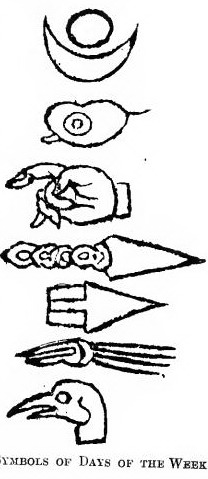
other sets of unlucky combinations.
Thus the individual days of the
week are divided : Monday and Thursday
are best. Sunday and Tuesday are
rather ” angry.” Saturday and Wednes-
day are only good for receiving things
(Yang-sa) and not for giving away.
Saturday is not quite so gloomy and
malignant as in Western mythology.
The days of the month in their
numerical order are unlucky per se
in this order. The first is unlucky for
starting any undertaking, journey, etc.
The second is very bad to travel.
Third is good provided no bad
combination otherwise.
Fourth is bad for sickness and accident
(Ch’u-‘jag). Eighth bad. The dates
counted on fingers, beginning from
thumb and counting second in the
hollow between thumb and index finger,
the hollow always comes out bad, thus
second, eighth, fourteenth, etc. Ninth is good
for long journeys but not for short (Kut-da).
Fourteenth and twenty-fourth are
1 According to the rhyme:
” Ñi-ma mik-mar me K’am : Da-wa lhak-pa Ch’u-r K’am ;
P’ur-bu dā-c’en luṅ-i K’am: Pasaṅ p’em-ba Sa-i K’am.”
like fourth. The others are fairly good caeteris paribus. In accounts, etc., unlucky days are often omitted altogether and the dates counted by duplicating the preceding day. 1 Chinese geomantic figures, the Pu-Kwā (Par-k’a) and the Me-wa, enter largely into the calculations of the Lāma astrologer, and these are usually figured on the belly of a spread tortoise, as in the above figure, whose paws sometimes grasp a pole surmounted by or transfixing a frog. 2
The Pu-Kwā or Par-k’a symbolize the great productive and antagonistic powers of nature, as summarized in a most interesting manner by Dr. Legge.
The first character, pu, is the Chinese symbol for divining by the lines produced through a certain process on the back of a tortoise-shell. It consists of two lines, 3 which may possibly, says Dr. Legge, have been intended to represent the lines appearing on the shell. The second character, Kwā, was the symbol for divining by means of the eight famous trigrams of Fū-hsī, themselves called ” the eight Kwā ” They are not characters, but lineal figures composed of whole and divided lines, on which was built up the mysterious book called the Yī-Kiṅ, or “Book of Changes,” with its sixty-four hexagrams. The eight trigrams are here shown : —
The whole lines in the figures are styled “the strong,” and the divided lines “the weak.” The two represent the two forms of the subtle matter, whether eternal or created is not said, of which all things are composed. Under one form the mailer is active and is called
Yang; under the other it is passive, and is called Yin. Whatever is strong and active is of the Yang nature ; whatever is weak and passive is of the Yin. Eeaven and earth, sun and moon, light and darkness, male and female, ruler and minister, are examples of these antinomies.
The aggregate of them makes up the totality of being, and the Yi is supposed to give in its diagram a complete picture of the phenomena of that totality. It does not give us a sexual system of nature, though of course the antinomy of sex is in it ; but the lines on which it is constructed embrace other antinomies as well. Authority and power on one side ; inferiority and docility on the other.
1 KLAPROTH, iv.. 137 : HUC,II.,370 . 2 This maybe the sacred three-legged frog. Cf. also my article (Ind. Antiq., 1893) on Frog Worship among the Newars.” 3 LEGGE’s The Relig. of China, p. 14, do. 15.
Further, the hidden operation in and through which the change takes place in nature is said to be that of the Kwei shan, 1 usually meaning ” spirits,” but here held to be technical. ” Shan is Yang, and indicates the process of expanding ; Kwei is Yin, and indicates the process of
contracting.” The fashion of the world is continually being altered. We have action and reaction, flux and reflux, and these changes are indicated in the diagrams, which are worked in divination by manipulating a fixed number of stalks of a plant called shih (Ptarmica Sibirica), and, indeed, the form of the trigrams themselves is suggestive of divination by twigs.
The usual geomantic arrangement of the Par-k’a is given in figure. Individually they are named Heaven, Earth, Fire, Thunder, Mountains, Celestial Water, Terrestrial Water, though the fourth and eighth are sometimes called Iron and Tree. And Mountain, Iron, and Water are said to be sons of the Earth and Heaven, while Wind, Fire, and Tree are their daughters.
It is remarkable, however, that while the Chinese use only the hexagrams for divination purposes, the Tibetans use only the trigrams in this way.2
The Nine Mewa 3 are arranged in the form of a quadratic square
or circle, and the figures usually, as in a magic
square, so disposed as to give the same total
in all directions.
The spirits of the seasons also powerfully
influence the luckiness or unluckiness of the
days. It is necessary to know which spirit has
arrived at the particular place and time when
an event has happened or an undertaking is
entertained. And the very frequent and complicated migrations of these aerial spirits, good and bad, can only be ascertained by the Lāmas. The most malignant of these evil spirits are a black dog a monster with a dragon-tail, a man on horseback, and the fabulous Phoenix; and the seasons are specially assigned to these in the order of spring, summer, autumn, and winter respectively. 4
The almanac which the Lāmaist astrologer uses, gives for each
1 Legge, op.cit., p. 39. 2 Cf. Prof. DE LA COUPERIES’ Ancient Chinese Divination Manual— The Yi King- Paris, 1889. 3 sMe-ba = a blot. Cf. PALLAS, Mong., ii., 229 : Schlag., 297. 4 Schlag., 299.
day the six presiding influences. Thus the page of the almanack for the first day of the third month of 1891 (Iron-horse) gives: —
Cyclic Animal Par-kha Nidāna
Tiger Li Nāmarūpa
Week-day Mewa Star
5 C’ikar 26
P’urba (Thursday) She-sa
(giving Wind). (giving water).
And the general record for the particular month is: This month’s star is moderate and the celestial Mansion is the sheep. Nidāna, Avidya. Element is mid-summer, and named Great Fire-Horse. It is time for plants budding and marshes, thunder and birds. The empty vase is in the east (therefore do not go E.). On the 15th day the Teacher taught the Kālācakra ; it is a holiday. Thursday, Sunday, and Tuesday are good. Friday, Saturday, Monday, and Wednesday
are bad. The ” Yas ” road (i.e., the road on which cake and the devil’s image are to be thrown) is N.W. The “Zin-p’uṅ ” ( a kind of genius loci ) in the Ox and Sheep days at dawn passes from W. to E. (therefore at that time be careful).
Lāmaist Horoscopes.
The Lāmaist horoscopes or Tsis are of several kinds. Those most commonly sought are for:
(a) Birth 1 (b) Whole-Life Forecast 2 (c) Marriage 3 (d) Death 4 and the (e) Annual. 5
They are written in cursive characters on a long sheet of paper and attested by the stamp of the astrologer. Such manuscript divinations usually called Suṅ-ta, are in the case of the more
wealthy clients mounted on silk. A preliminary fee or presenl is usually given to the astrologer at the time of applying for the horoscope, in order to secure as favourable a presage as possible.
Each of the various horoscopes takes into account the conflict or otherwise of the elementary and astral influences dominant at the time of the person’s birth, as compared with the existing influences at the time consulted.
1 sKyed-rtsis 2 ts’-rabs las rtsis. 3 pag-rtsis 4 gs’in -rtsis. 5 sKag-rtsis. Other horoscopes for general and extra divinations are: Gab-tsi or “Concealed,” and Grub-tsi or “the perfect ” Astrology ; and the Chinese system is Termed Nak-tsi in distinction to the Indian or Kar-tsi.
The ordinary horoscope is usually arranged under the following six heads, namely : —
1. The year of birth of the individual in its auspicious or inauspicious bearings.
2. His Park’a, influences.
3. His ” Reversed calculation ” of age (Log-men). This is evidently introduced in order to afford a further variety of conflicts.
4. ” The Seizing-Rope of the Sky.” — This seems to refer to a popular idea of ultimate ascent to the celestial regions by means of an invisible rope.
5. ” The Earth-dagger.” — This is an invisible dagger, and is for the individual the emblem of stability and safety so long as it is reported to be fixed firmly in the earth.
6. The Mewa.
And each of these several heads is separately considered in detail with reference to its conflicts in regard to — (a) the Life (or srog) ; (b) the Body (or lus) ; (c) the Power or capability (baṅ-t’aṅ) ; (d) the Luck-horse (or rluṅ-rta) ; and (e) the Intelligence (bla).
The particular Parkha and Mewa for the several times are found by reference to the Lāma’s almanac as above noted ; but the other details are elicited by diverse calculations made upon the astrologer’s board, 1 and in consultation with the various manuals on the subject.
1 The astrologer’s board consists of a large napkin on which are drawn squares and
the other necessary geomantic figures, all in a definite and convenient relation to each
other. This napkin is spread on a table, and the calculations are made with coloured
buttons as counters which are kept in a bag— the several elements having each a
recognized colour: thus wood is green, fire is red, earth is yellow, iron is white, and
water is blue. These counters are placed on the coloured squares as in a chess-board,
and are moved according to rule, either transversely from right to left or vice versa, or
longitudinally over the requisite number of squares. In the top row of the board are
the sixty squares of the sixty-year cycle, all named and in the proper colour of their
elements. And the succeeding rows of squares are those of the Life, Body, Power,
Luck, and Intelligence series, each with its appropriate series of coloured elements.
The other divisions relate to the Parkhas and Mewas.
The calculations are made according to rule backwards or forwards a certain number
of years in the row of the sixty-year cycle squares, and the secondary results come out of
the vertical columns of the Life, Body, etc., series according to the conflict of their respective elements : the results being noted by white or black seeds or buttons, which have the following values : —
The seven recognized degrees of affinity or repulsion are expressed in the astrological
accounts by the following signs of circles and crosses, and during the calculation the
circles are represented by white buttons and the crosses by black buttons or seeds :—
When the conflict of the elements comes out — Mother, i.e., the best degree = OOO
Friend, i.e., the better degree = OO
{ Water + Water} i.e a harmless mixture
{Earth+ Earth } and therefore good =O
These manuals have their signs inscribed on the belly of a tortoise (see page 453), and the Mewa occupies the centre. With this explanation I now give here a sample of a horoscope
for one family for one year’s ill-luck, in which the prescribed worship is italicized. I have added in footnotes some further explanations which may be consulted by those interested in knowing
in more detail the methods by which the Lāmaist-astrologer makes his calculations.
The Misfortune Account of the Family of ______For the EARTH-MOUSE Year: (i.e., 1888 a.d.)
Salutation to MAÑJUṢṚĪ1
A. For the Father of the Family.
I.— According to the Birth-conflict.
This male, aged 26 years, being born in the Water-Hog year, that year conflicts with the Earth-Mouse year (the present year) as follows : —
I. Life = O, or good. 2
Body = OO, or better. 3
Power = XX, or worse.
Luck-horse = OOO, or best.
Intelligence = X, or bad.
1. As modified by ” Parkha.” — His Park’a for the year is Khon, which gives the Earth-Sheep year and the following conflict : Life = worse. Body = better.
When the conflict of the elements comes out Son, neutral = OX
“” Wood + Wood} i.e.,unmiscibility
Fire +Fire} and .: opposition
Iron +Iron} and bad = X
Enemy, i.e., worse = XX
Deadly hate, i.e., worst = X X X
For example, water meeting iron, i.e., its ” mother” is the very best and . . = OOO
and the same would be true of fire meeting wood. But wood meeting earth would
= friend” and therefore = OO: but should earth meet wood, then it would be
“enemy” and therefore = XX; and water meeting wood = “neutrality ” or OX.
While fire meeting water = ” deadly hate,” and therefore = XXX. Then the average
of the total is taken as the average result of the conflict. And the several remedies
necessary to avoid each and all of the calamities thus foretold are specified categorically in the astrologers’ books.
1 The metaphysical Bodhisattva MAÑJUṢṚĪ is the presiding divinity of the astrologers, and be is always invoked at the head of astrologic prescriptions.
2 The year of hit birth being the Water-Hog,gives according to the astrologic table, Water as the srog for that year, and the present year being the Earth-Mouse year, its srog according to the table, is also Water. Therefore Water meeting Water = O, i.e. “good”
3 The lus of these two years are found by the table to give the elements respectively of Water and Fire. Therefore Water meeting its friend Fire= OO or “better “,i.e. Good of the second degree.
Power = worse than bad.
Luck-horse = bad.
Intelligence = worse.
2. As modified by “Reversed Age Calculation.” — This gives a ” good ” result, 1 .-. = O.
3. As modified by ” The Seizing-Rope of the Sky.” — -This gives “good,” 2 = O
[If it were bad, then prescribed ” The closure of the door to the sky ” (spirits)]. 3
4. As modified by ” The Earth dagger” — This gives a medium average, [If it were bad would have to do ” The closure of the door to the earth ” (spirits)]. 4
Thus the summary of the year’s conflict as to birth, together with its prescribed remedies is : —
” Life ” has black in excess ; therefore to procure long life read very much The Sutra and
Dhāraṇīs for Long Life.
” Body ” has white in excess ; therefore the Body will be free from sickness (i.e., only as
regards this one aspect of the calculation).
“Power” has black in excess; therefore Food shall be scanty, and crops suffer, and cattle die or
be lost. To neutralize it (a) have read very much ” Yaṅ-gug ” or the Luck-Bestowing
and ” Norzaṅ ” {the Best Wealth) ; (b) offer holy cakes; (c) also give food and
sweets to monks and children.
” Luck ” has black in excess ; therefore be careful not to provoke a law-suit or go on a long
journey. To neutralize this (a) do “Du-kar“100 times : (h) plant as many” Luṅ-ta‘
– flags” as years of your age ; (c) offer in the temple 13 lamps with incense, etc. ;
(d) have read the “mDo-maṅ” very much; (e) make an image of yourself (of cooked
barley or rice) and throw it towards your enemy ; (f) also make an earthen Caitya.
“Intelligence” has black in excess; therefore have read the ” La-guk” or worship for recalling
the Intelligence.
1 1. —According to PARK ‘A —
His Park’a for the year being ” khon,” he cannot during the year excavate earth or remove stones. The Nāgas and the Earth master-demons are opposed to him. He is especially liable to the diseases of stiffened joints and skin disorders In the second month he is especially subject to danger. The N. and E. and S. directions are bad for him ; he must not go there. For removing
1 This Log-men or ” Reversed + downwards ‘” is a more abstruse calculation according to the saying : — ā Ā ī Ī ū Ū ṛ Ṛ ṝ ḷ l ṅ Ṅ ñ Ñ ṭ Ṭ ḍ Ḍ ṇ Ṇ ś Ś ṣ Ṣ ṃ ḥ ē ō ṇḍ
” skyes-pa pu-yi stag t’og nas lo graṅs t’ur,
” bud-med ma-yi sprel-t’og nas lo graṅs gyen.”
For males — the sons of elements — begin from Tiger and count age downwards.
For females — the mothers — begin from Ape and count age upwards.
Thus the birth-year of this individual being Water-Hog, and he being a male, and
the son of Water being Wood, gives us for his Log-men the Water-Tiger year (which =
1854 a.d.). And as he is male, en counting downwards from the Wood-Tiger the num-
ber of years of his age (i.e., 26), we get the year Earth-Hare (i.e., 1879 a.d.). And
according to the Log-men Manual, the Earth-Hare year is ” ‘byor-pa ” or Riches, which
is given the value of ” good,” i.e., = O- 2 This is calculated on the srog of the Log-men year, minus five years. In this case we have seen Log-men year is the Earth-Hare year. Counting back to the fifth year gives the Wood-Hog, which has its srog the element water, and the sr-og of the
present 1888 a.d. year, viz., Earth-Mouse, being also Water, therefore = O or good for
the ” sky-seizing Rope.”3 See next chapter. 4 See next chapter.
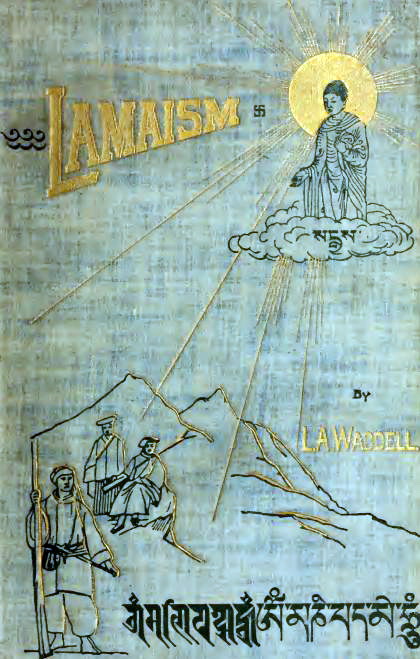
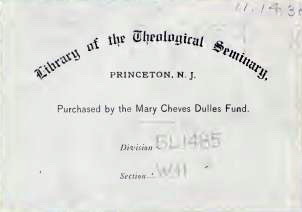
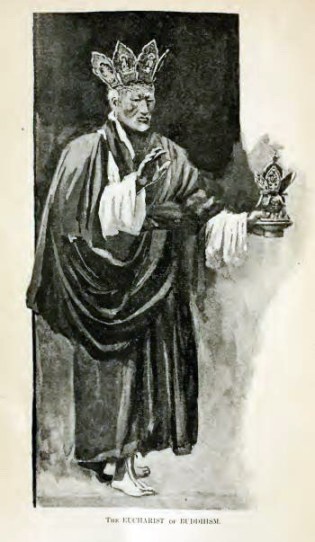
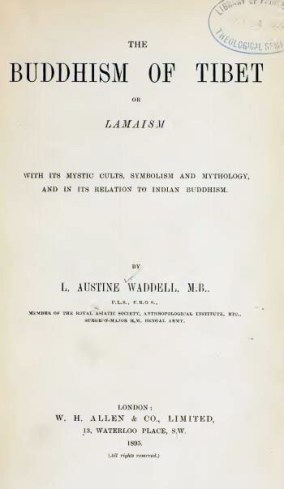
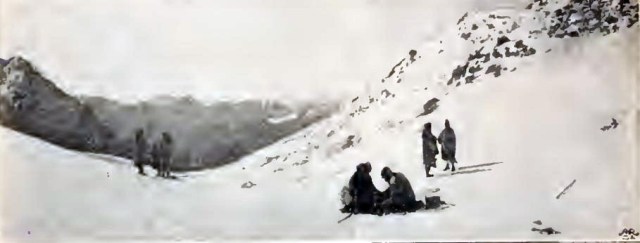
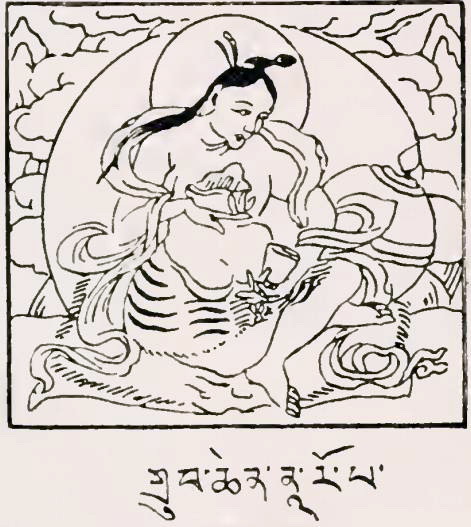
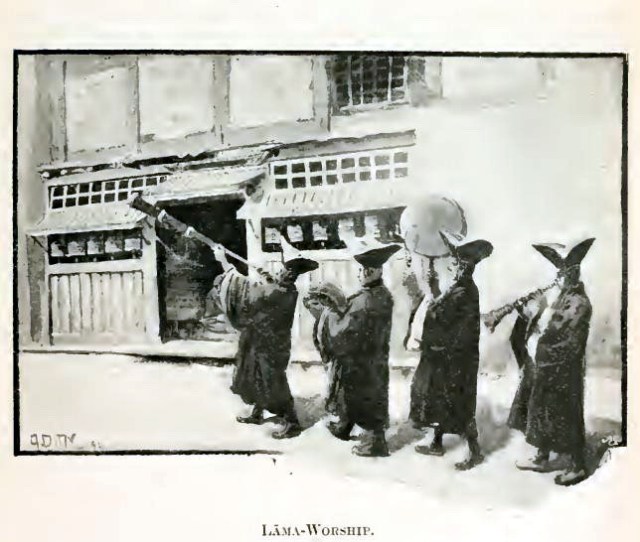
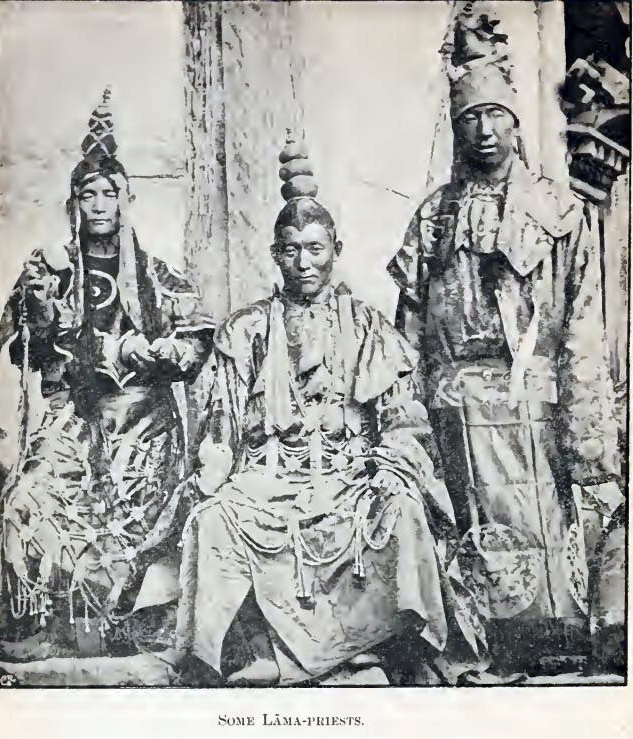
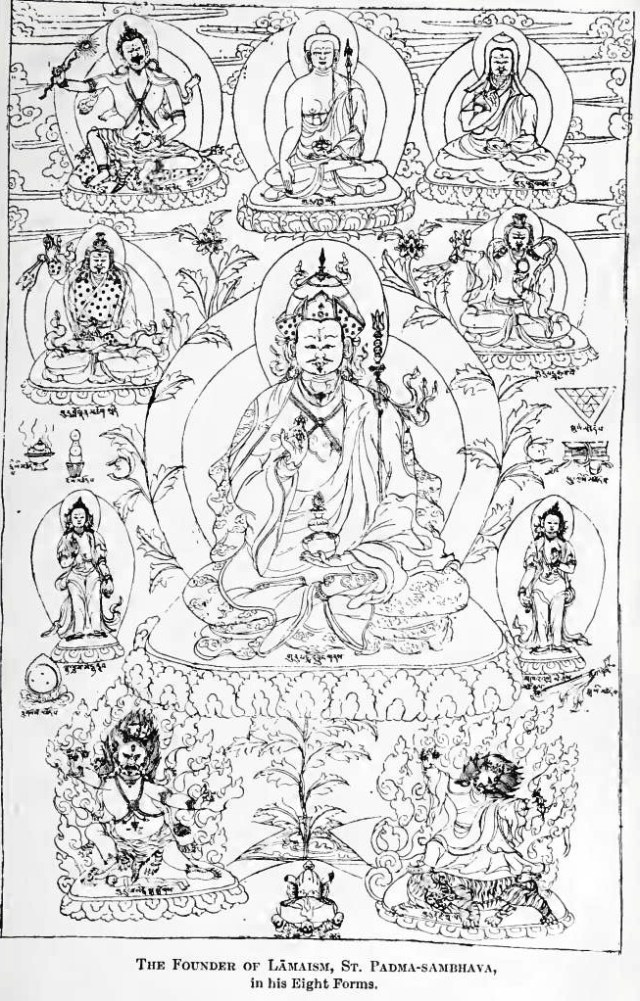
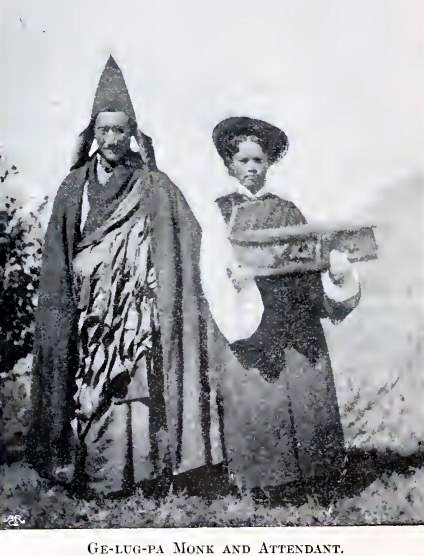
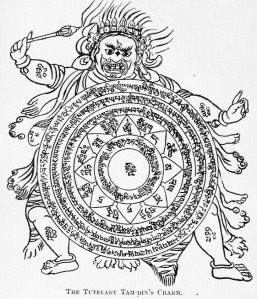
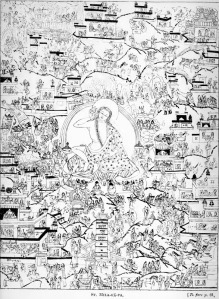
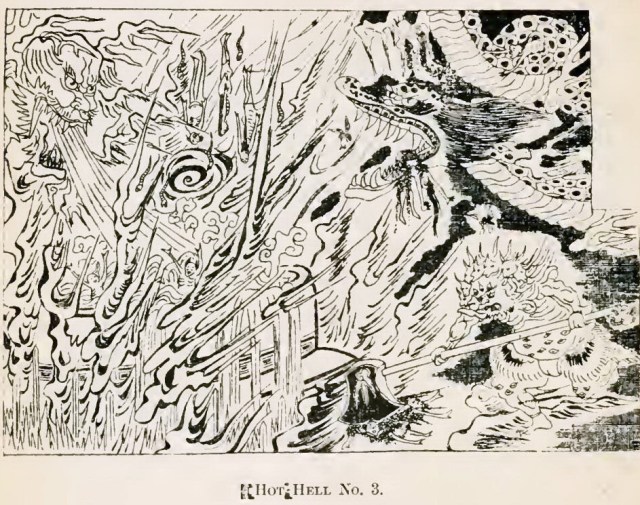
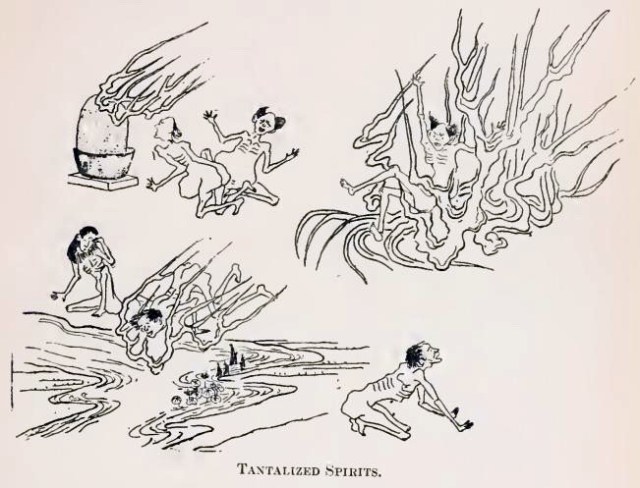
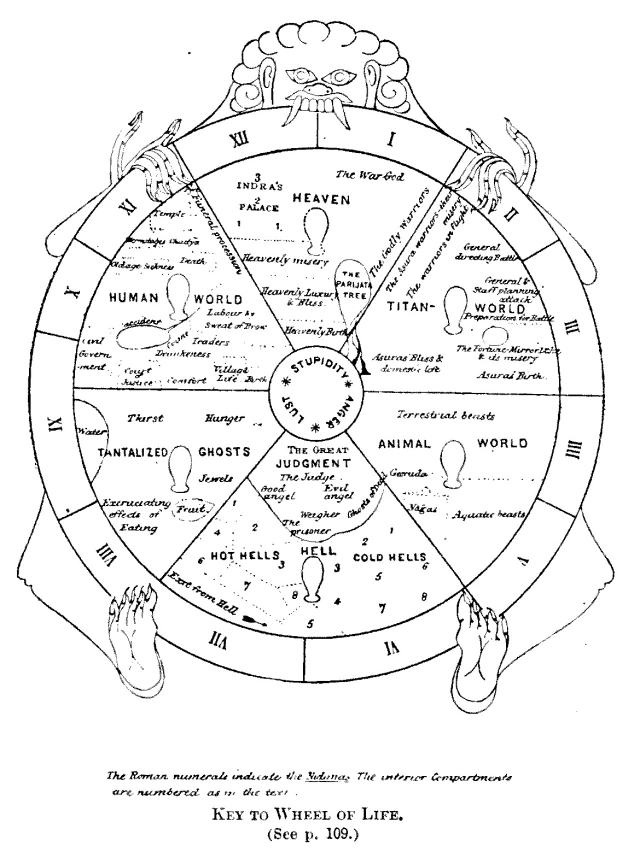
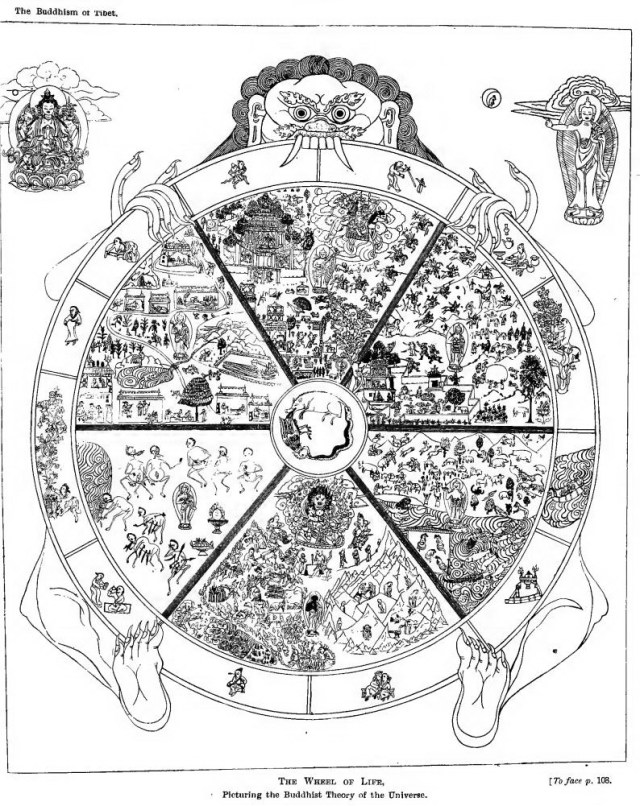
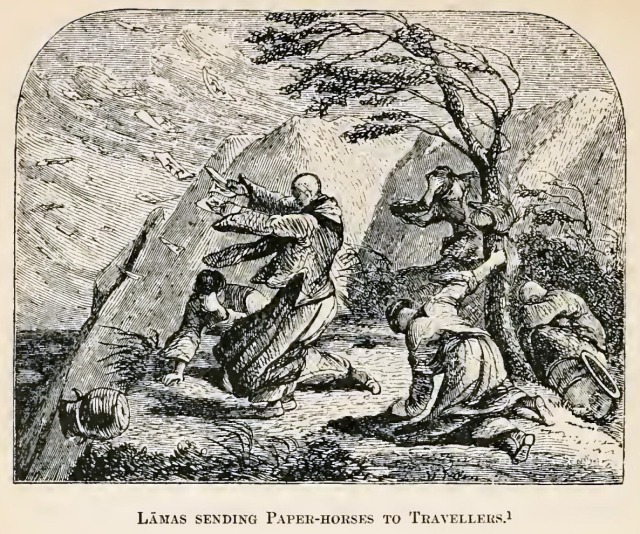
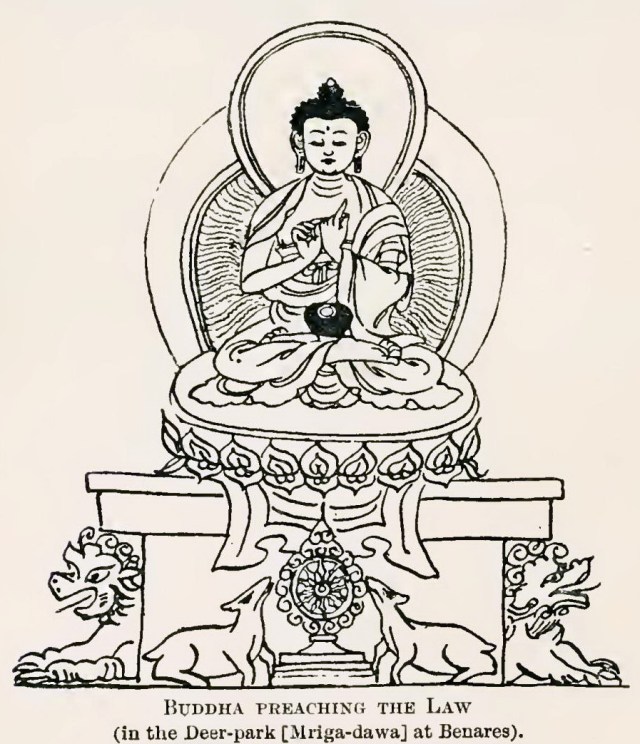
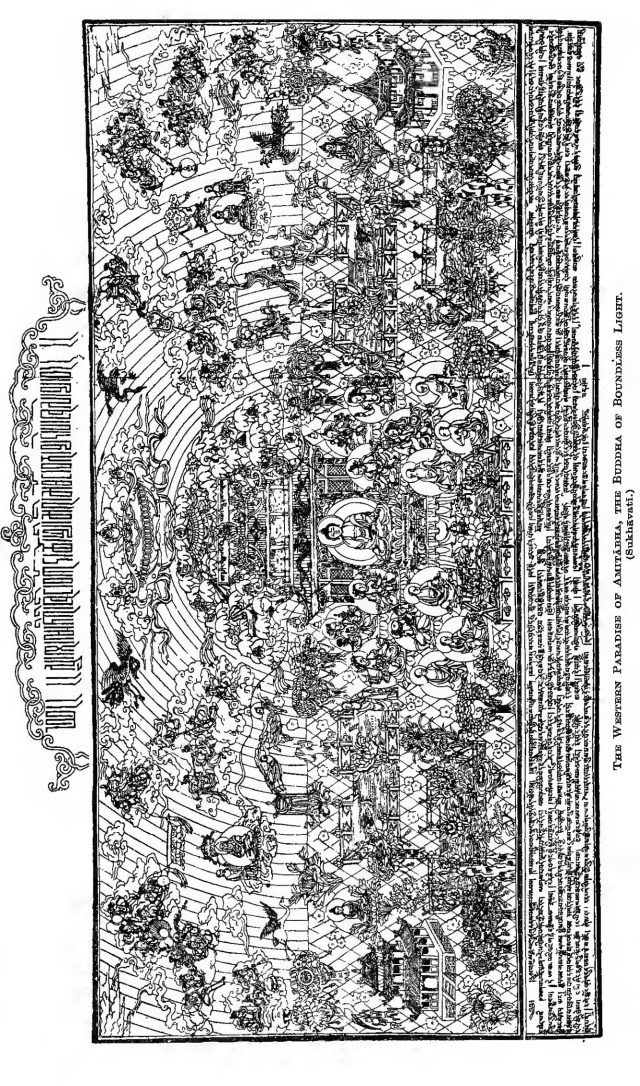
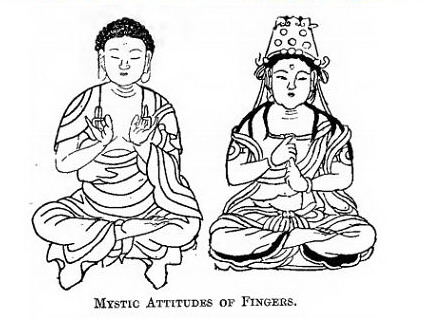
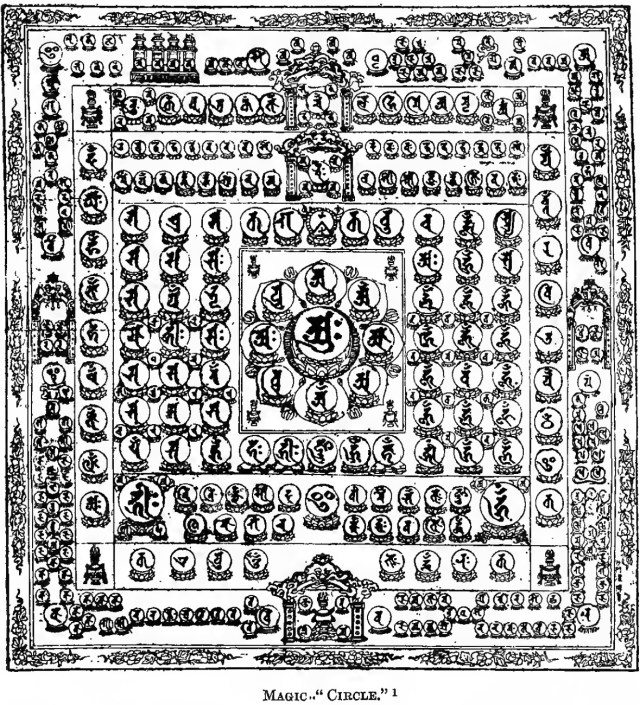
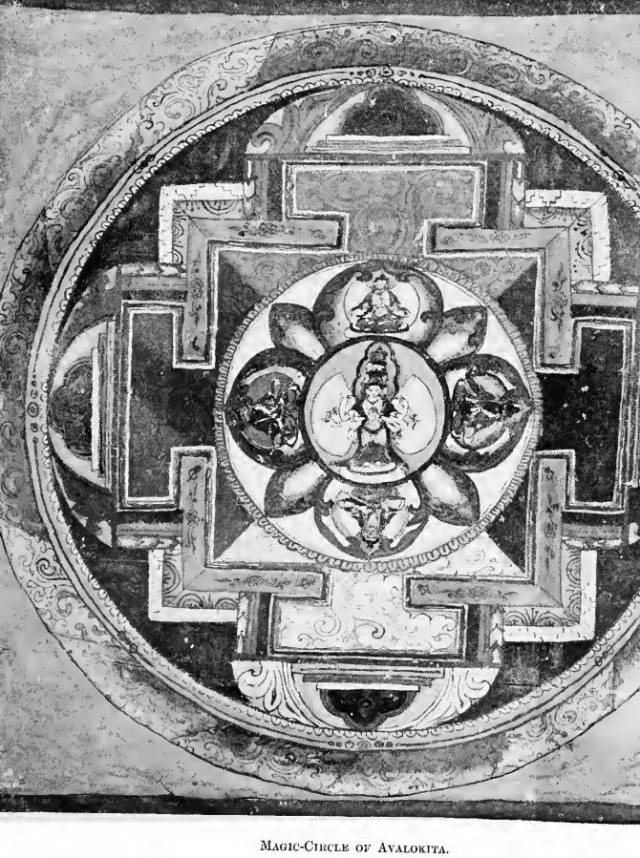
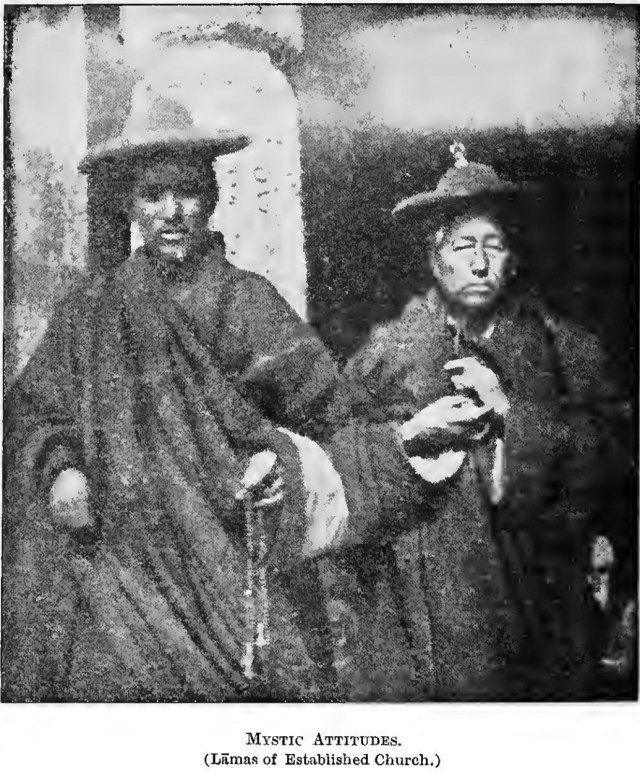
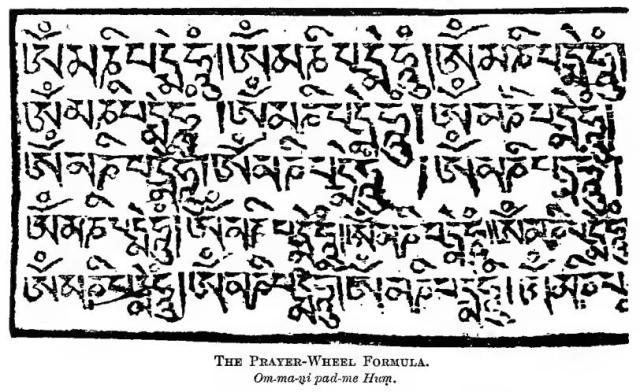
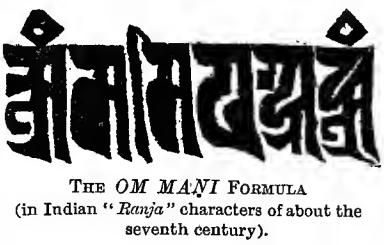

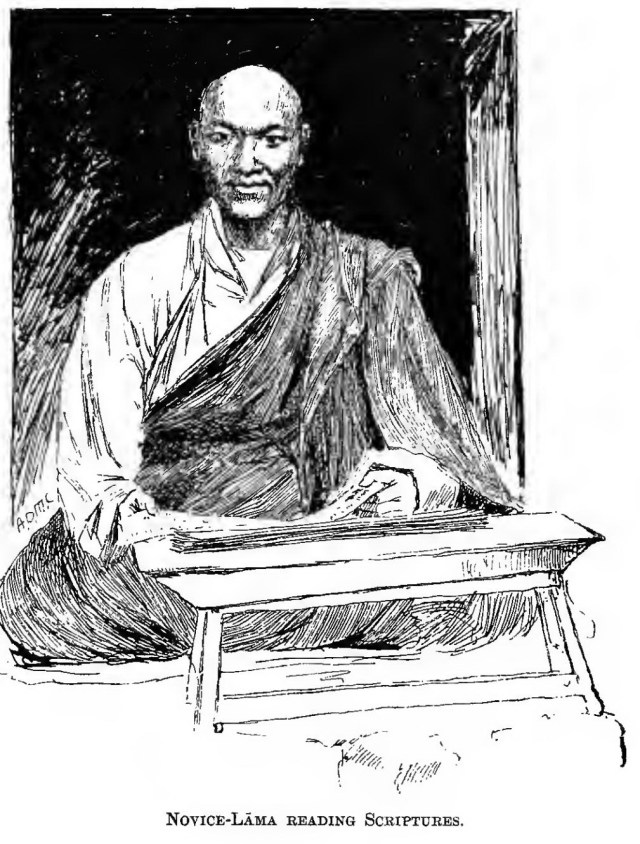
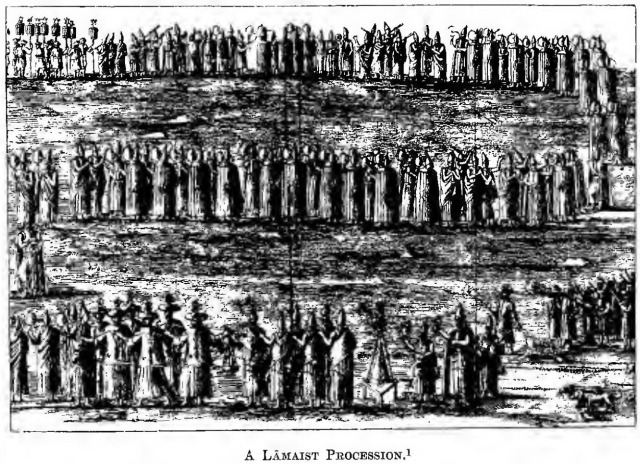
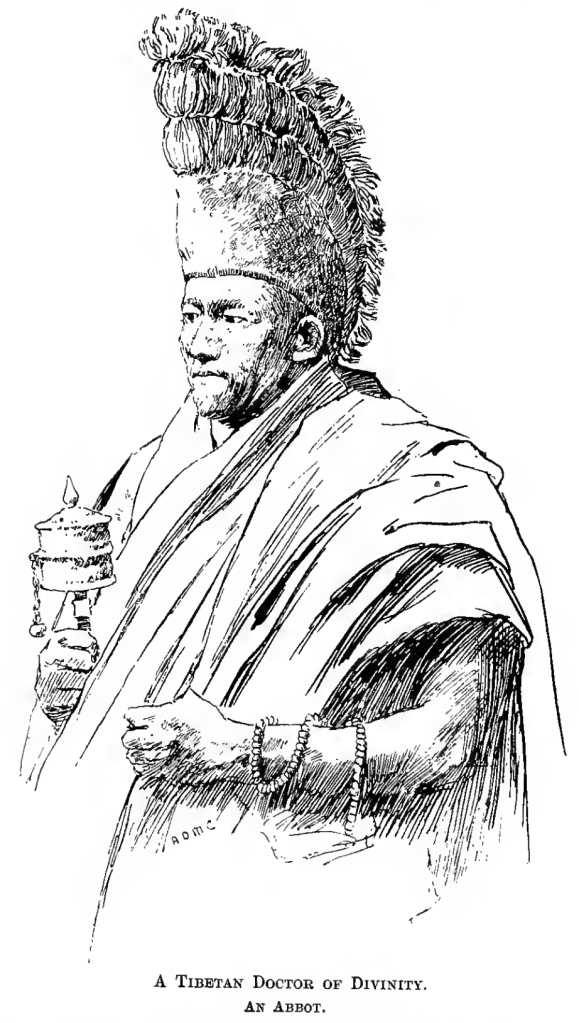
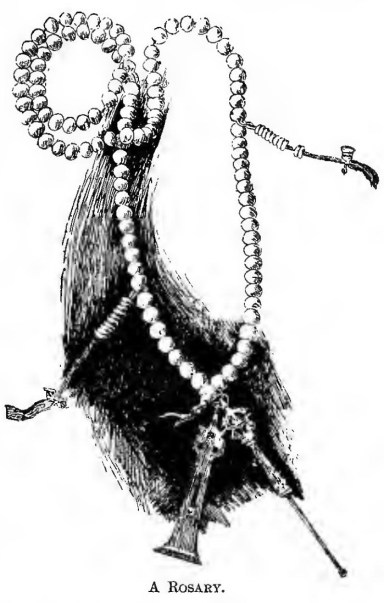
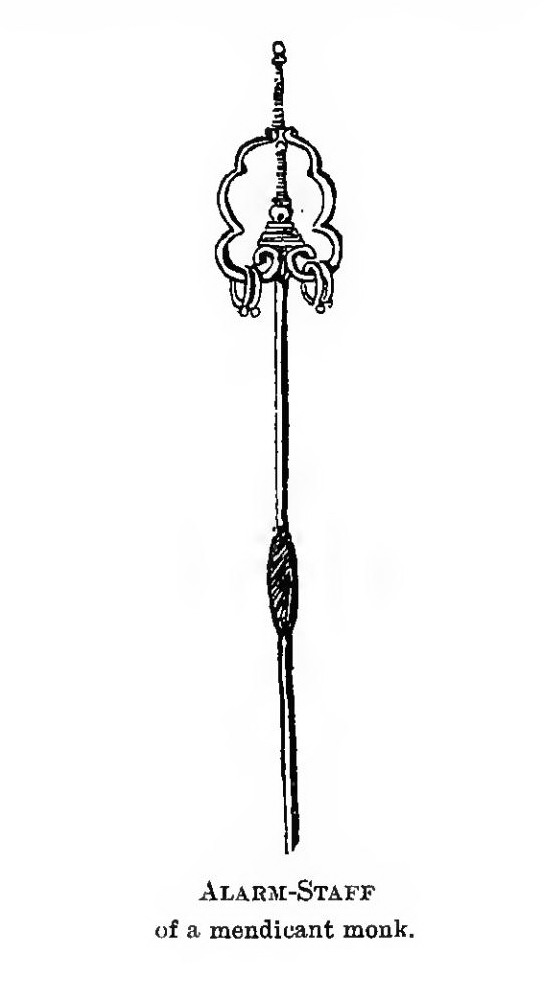
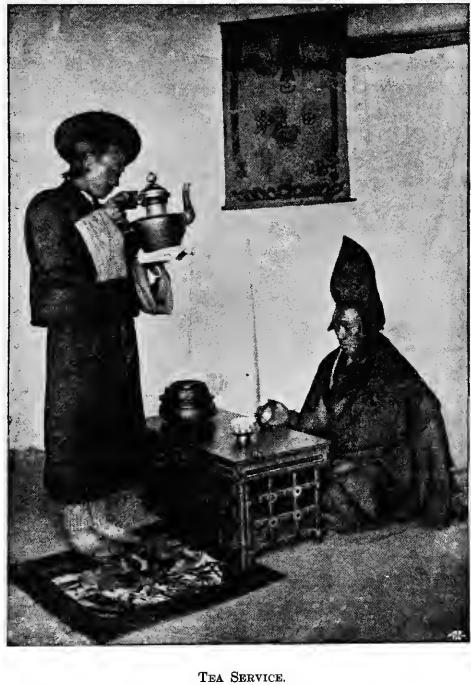
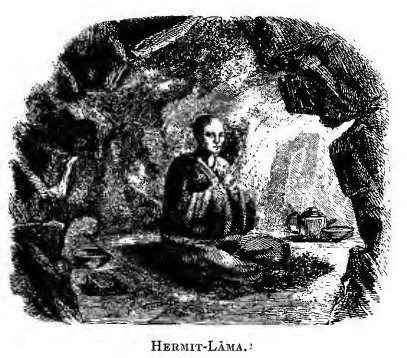
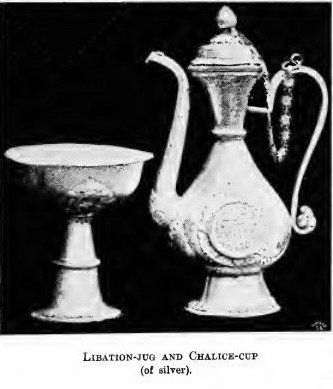
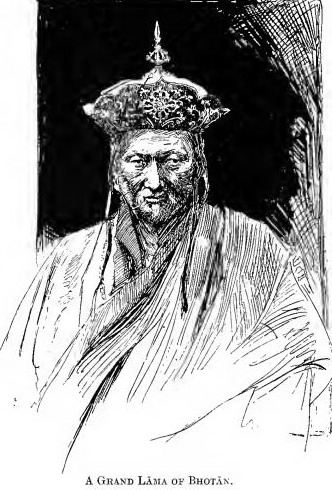
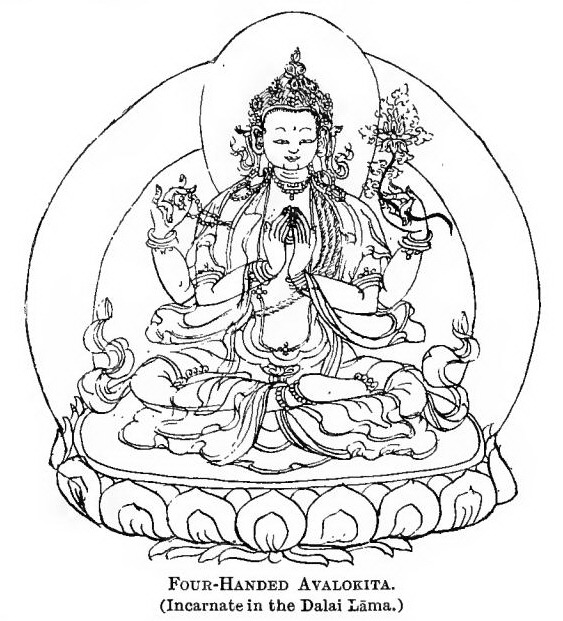
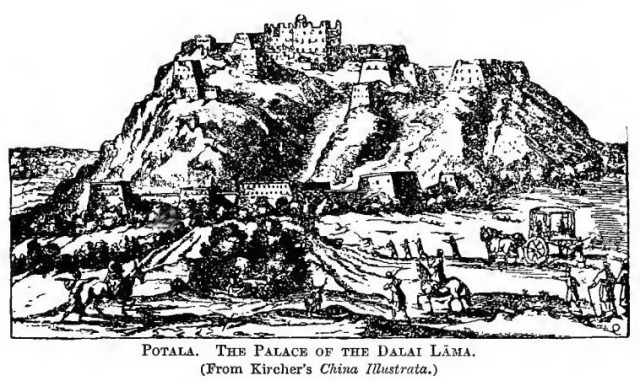
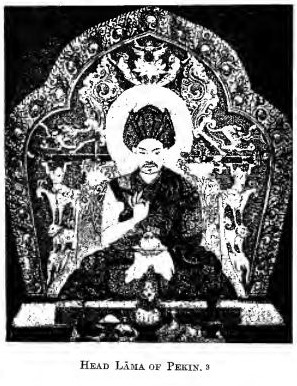
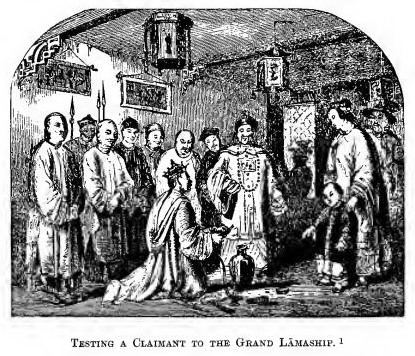
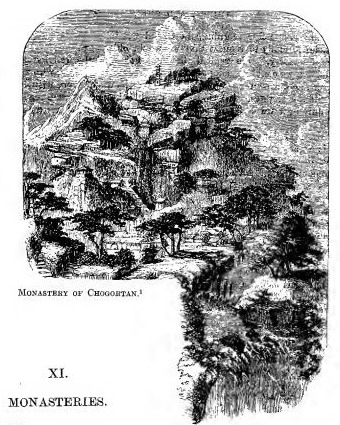
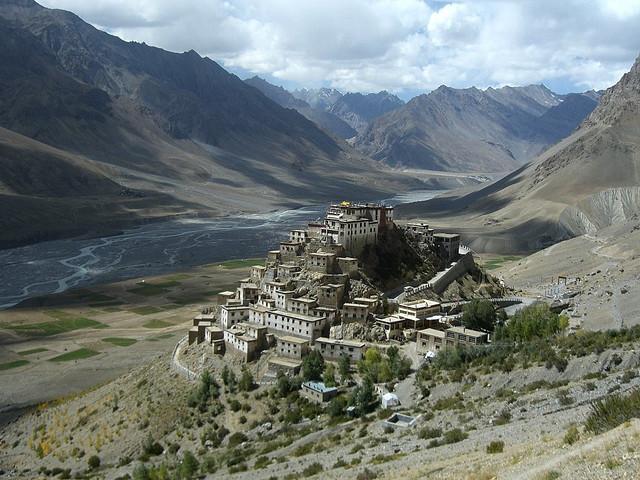
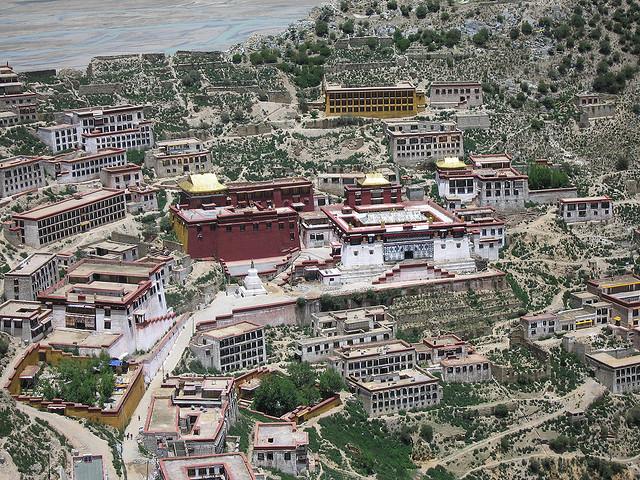
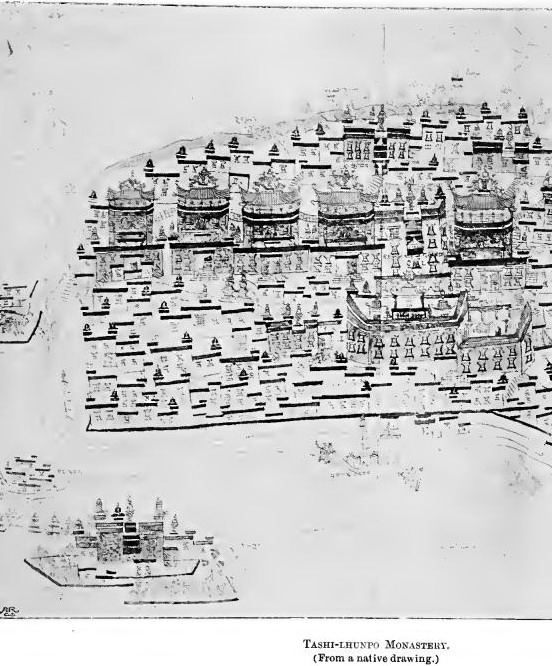
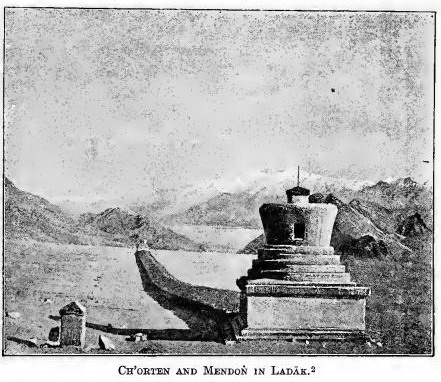
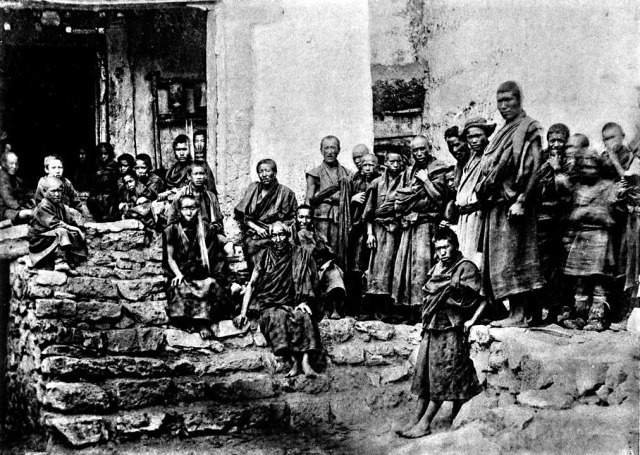

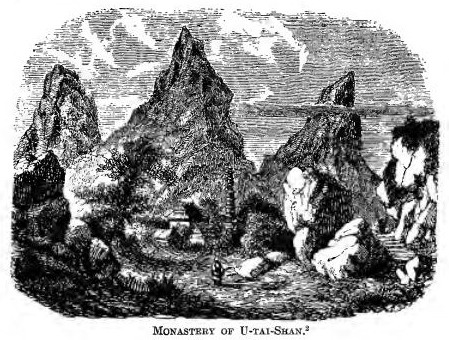
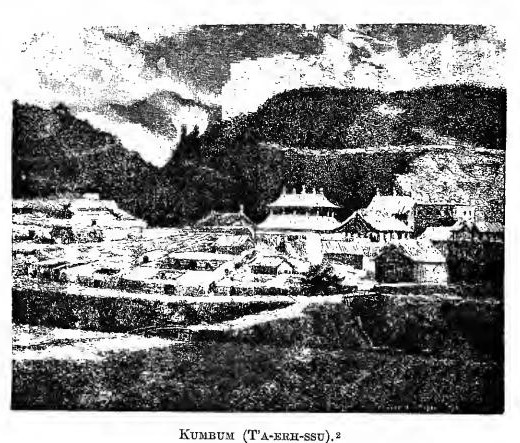
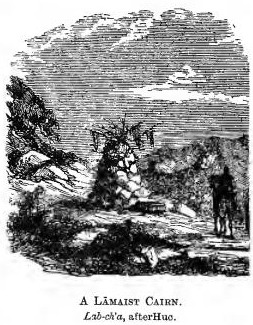
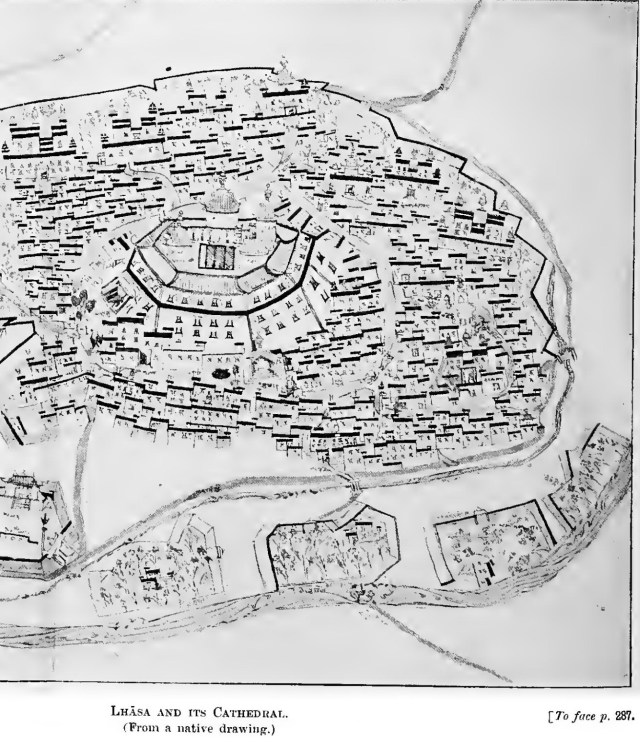
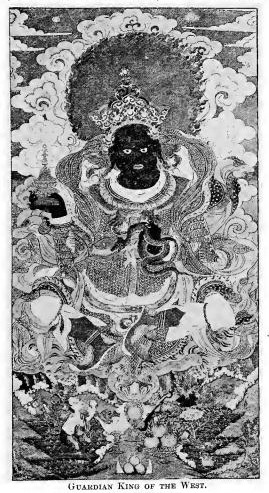
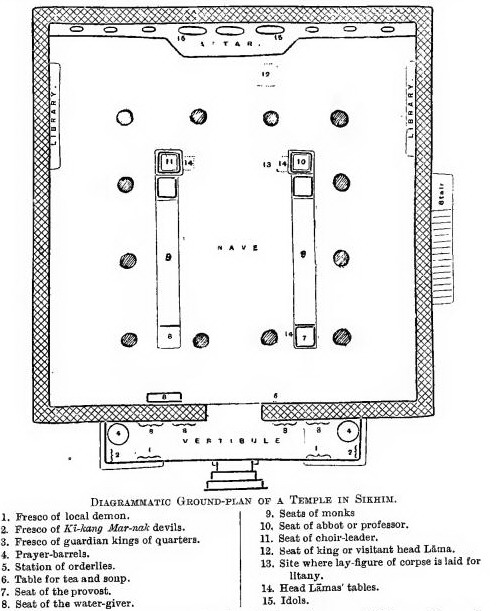
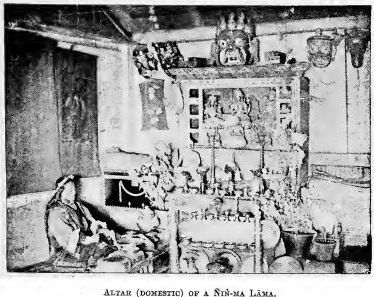
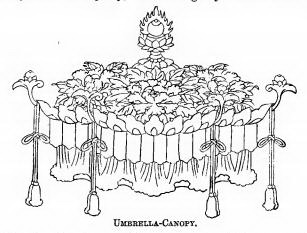
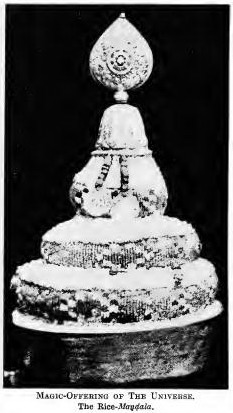
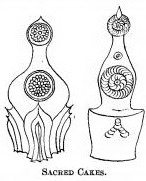
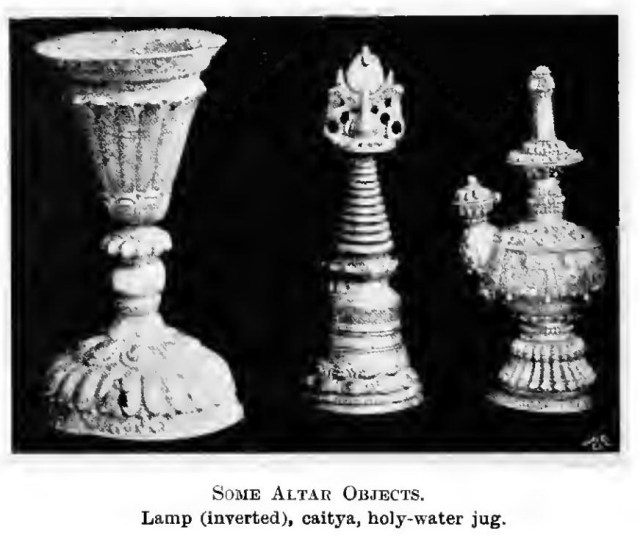
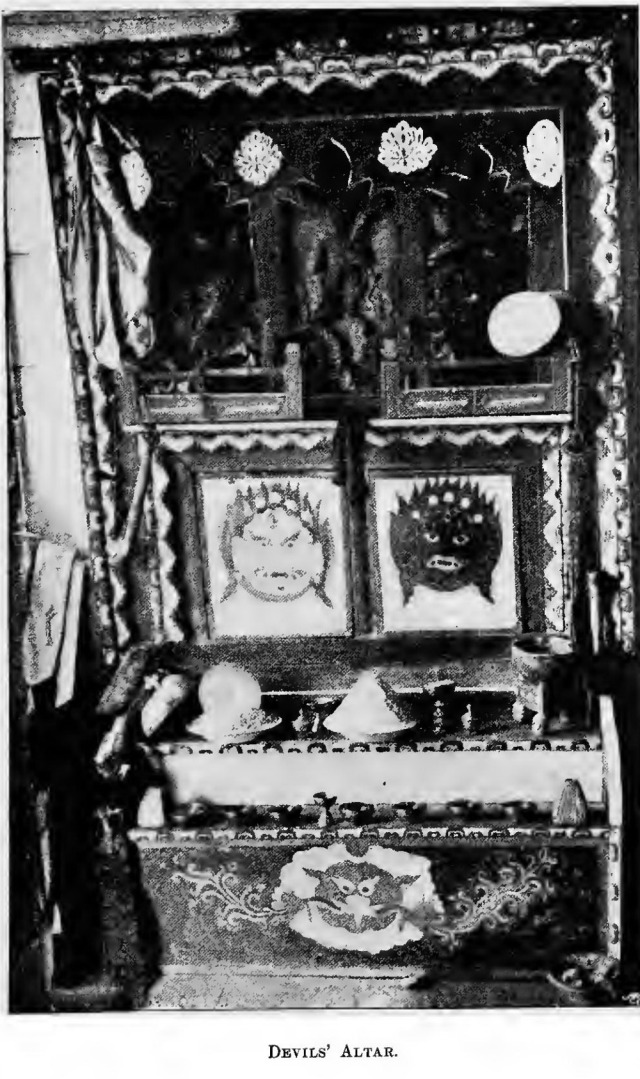
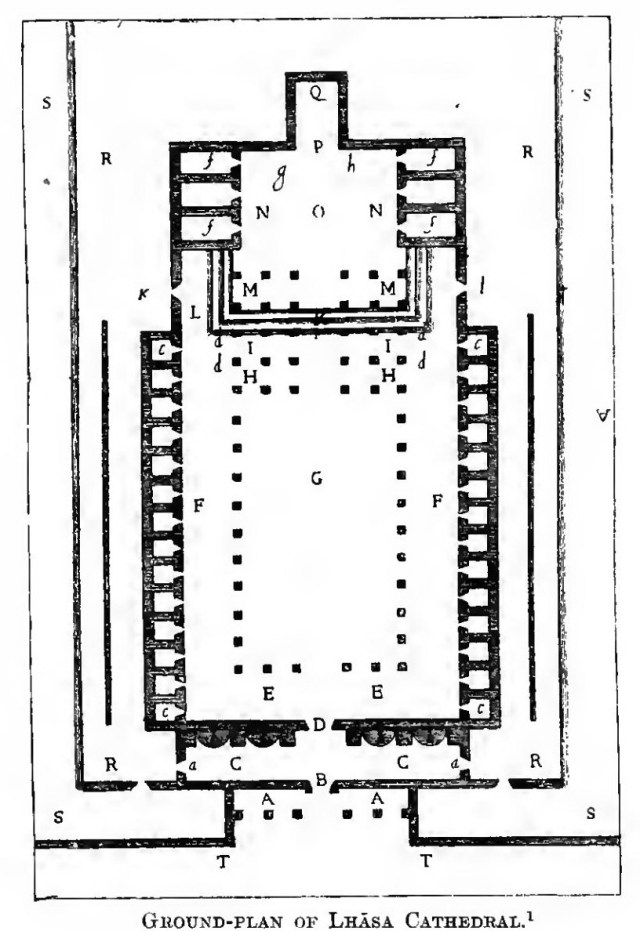
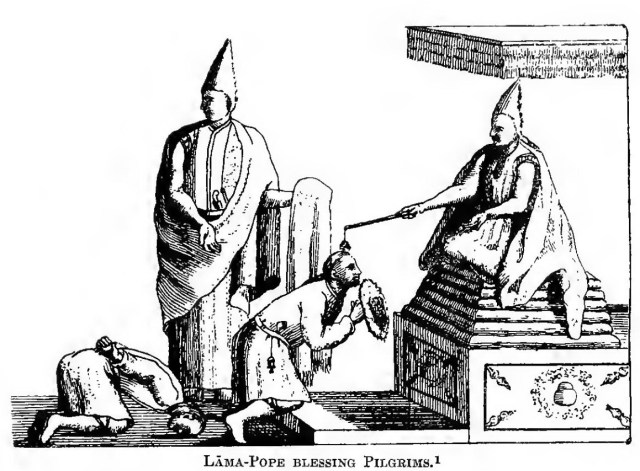
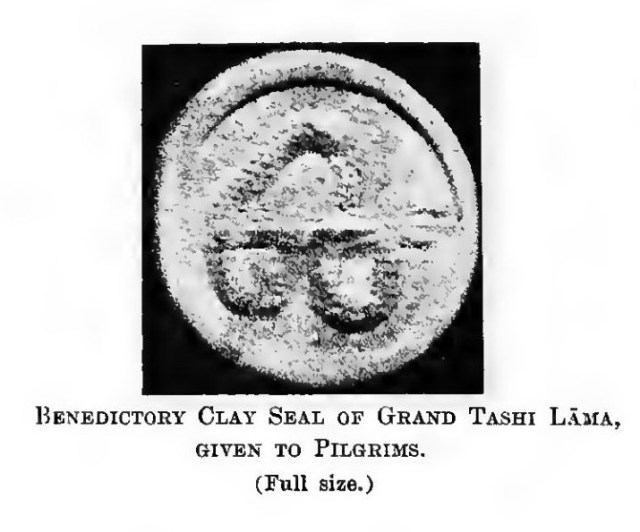
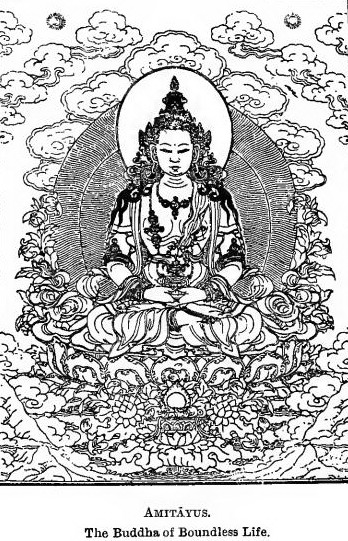
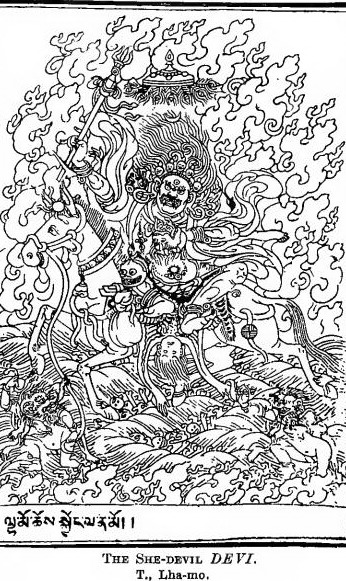
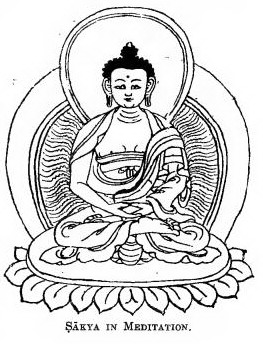
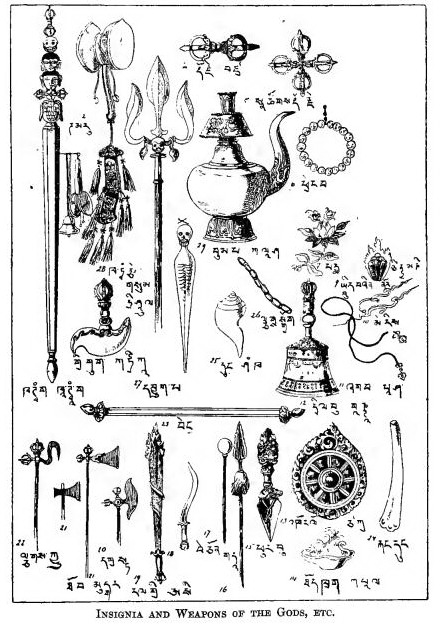
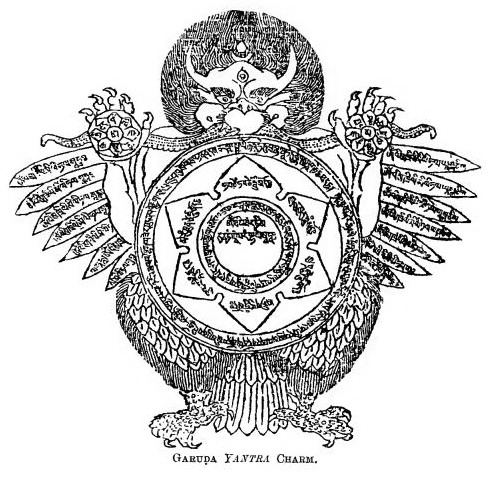
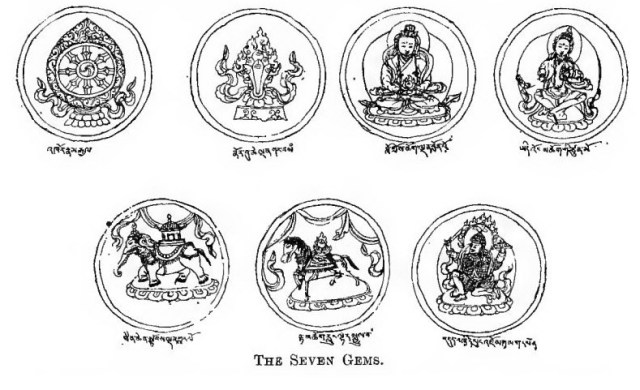
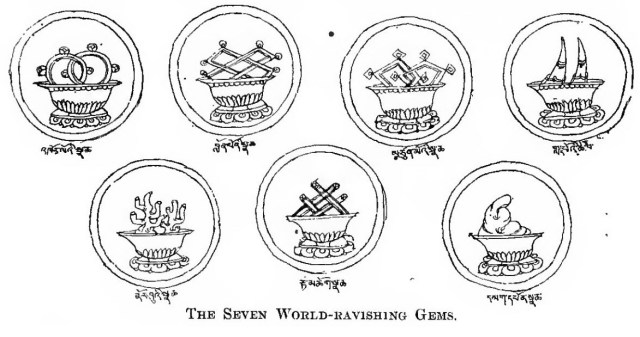
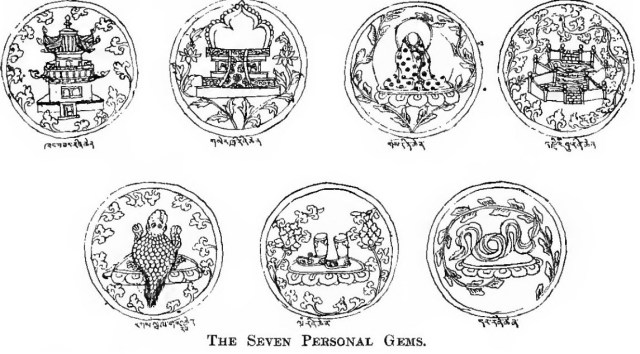
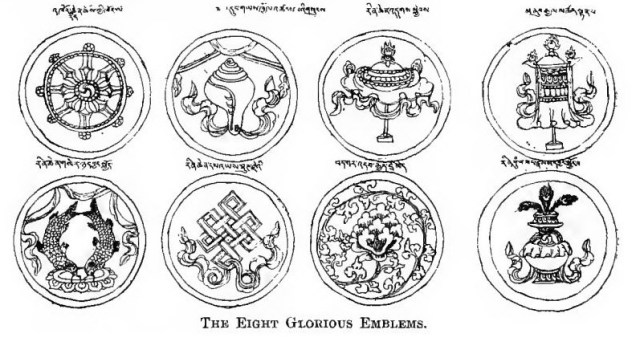
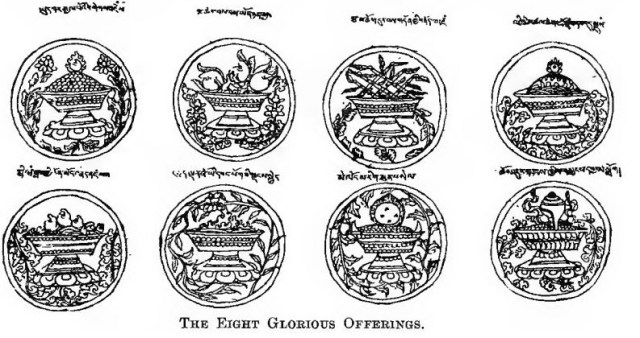
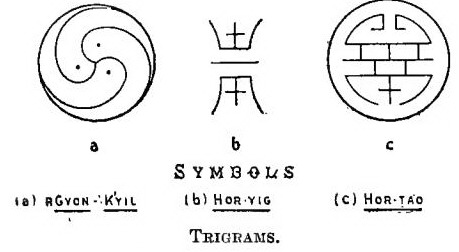
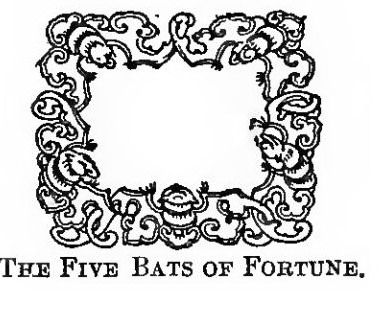
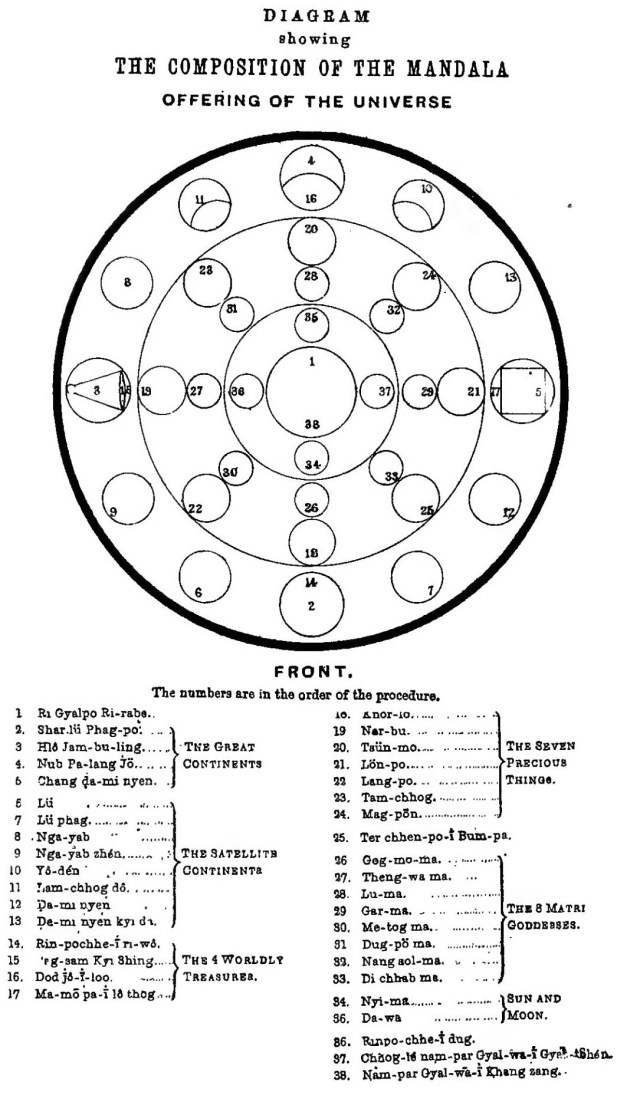
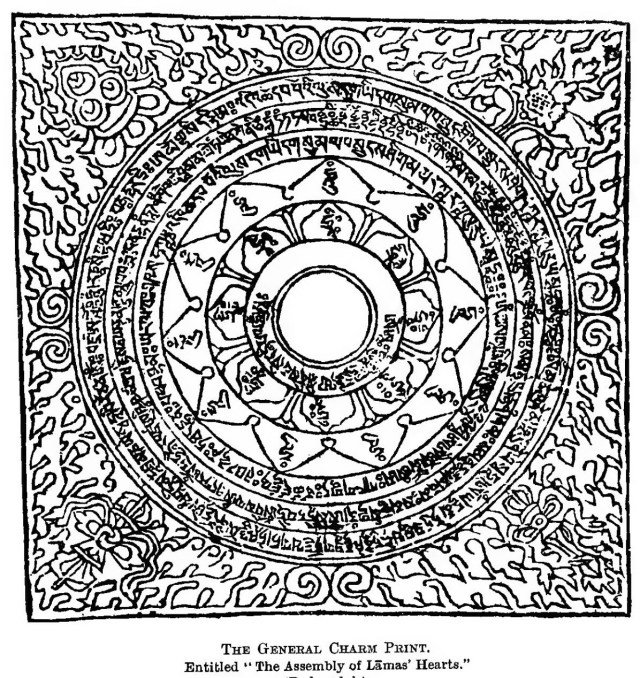
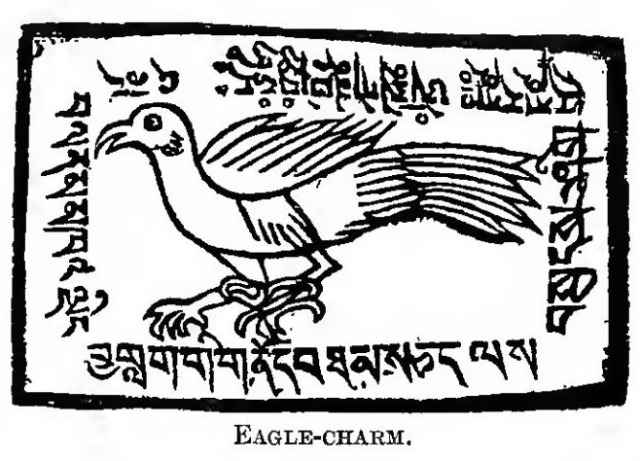
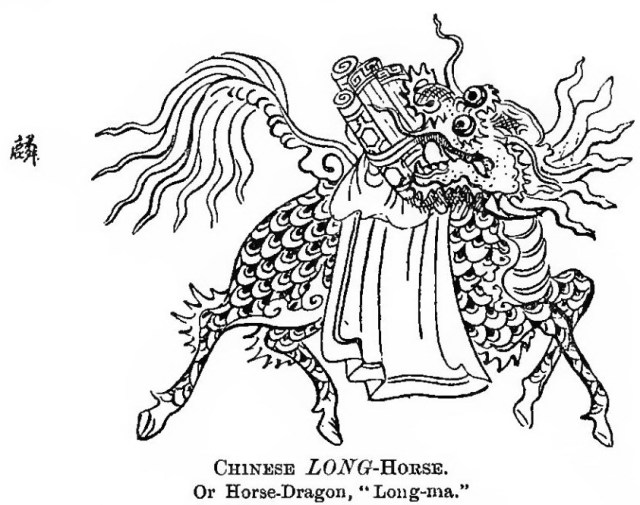
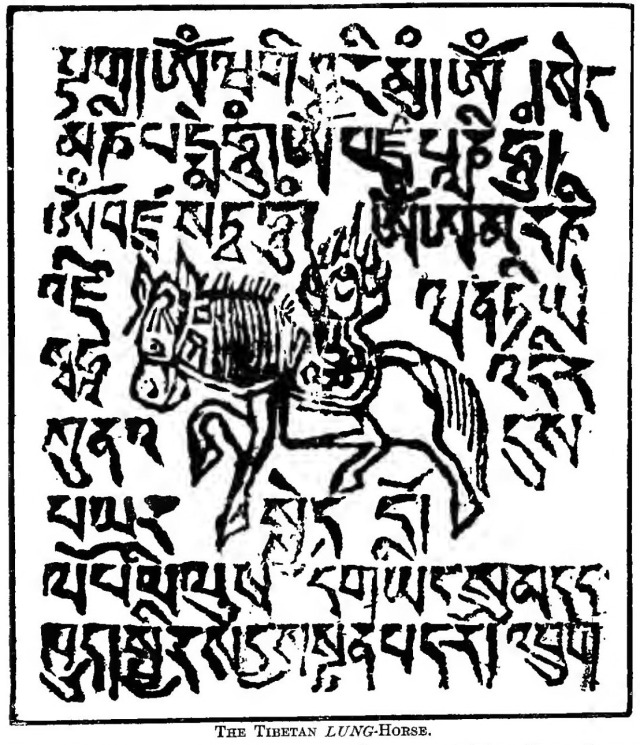
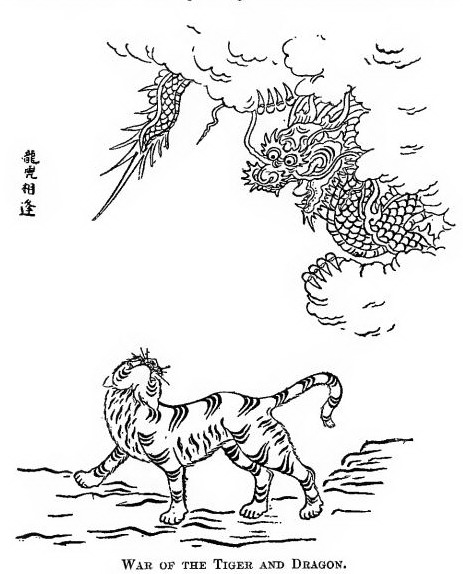
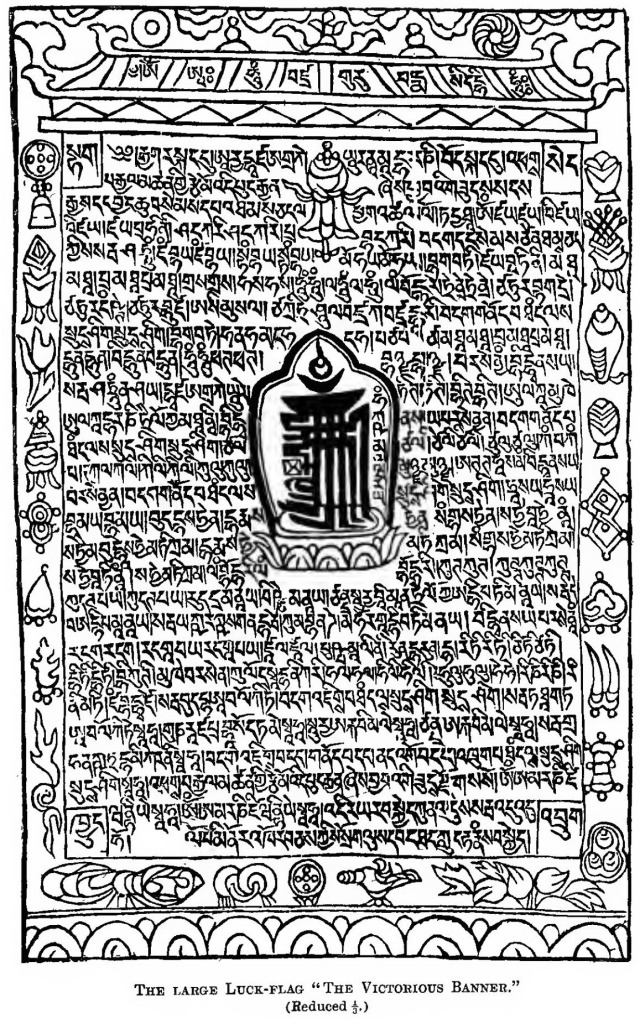
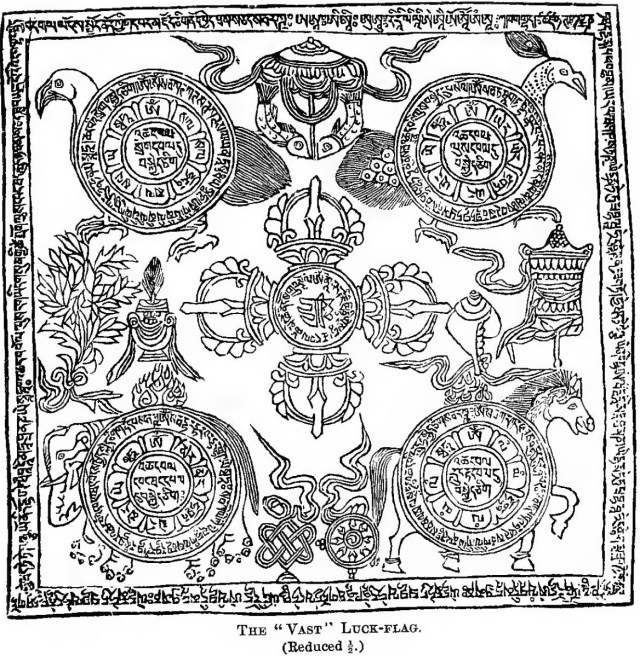
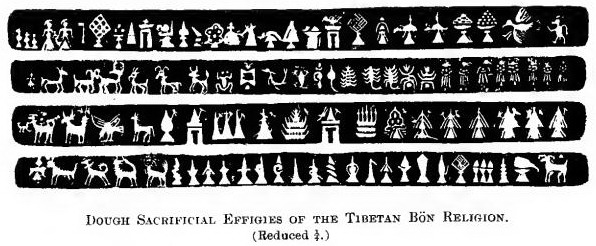
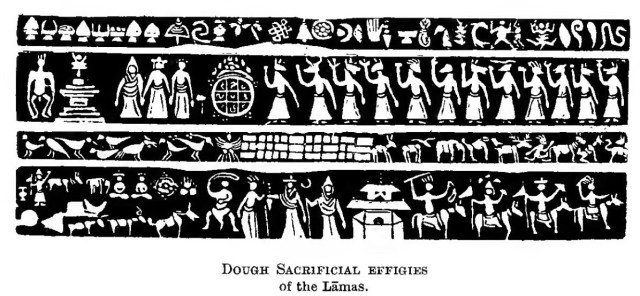
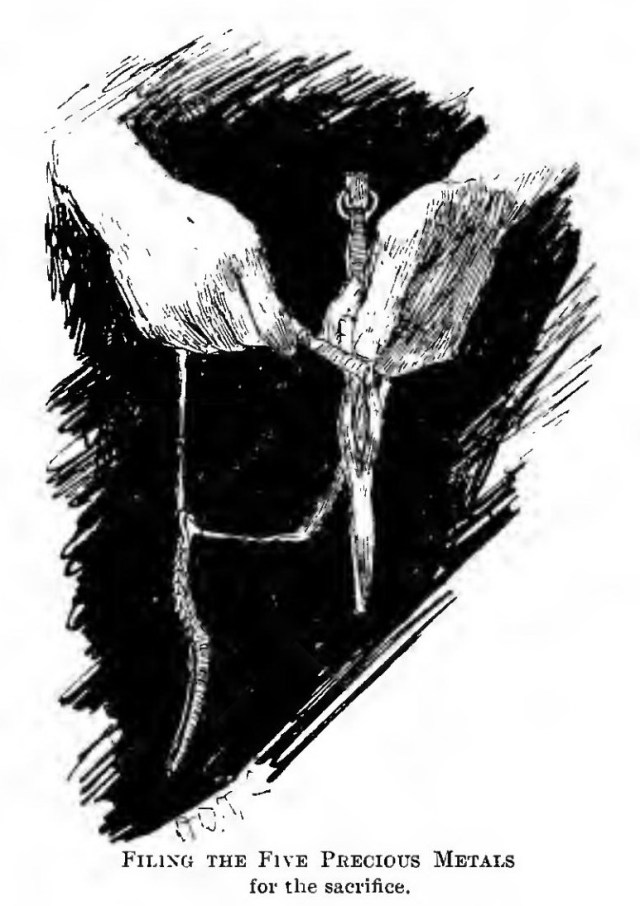
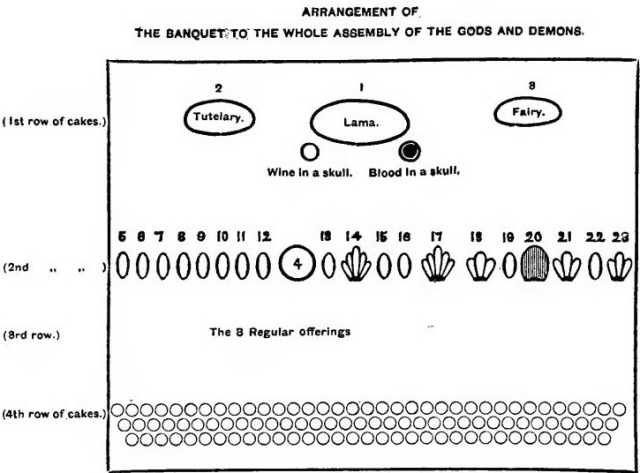
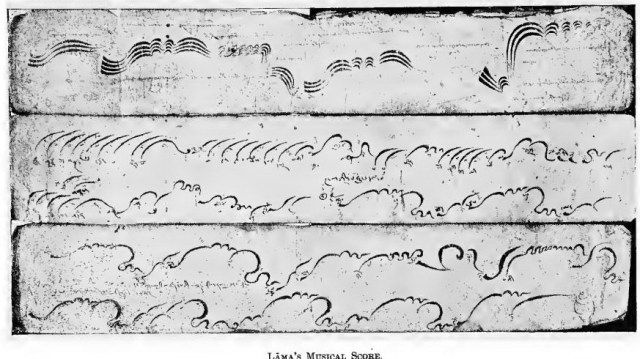
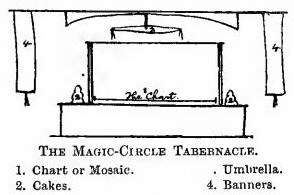
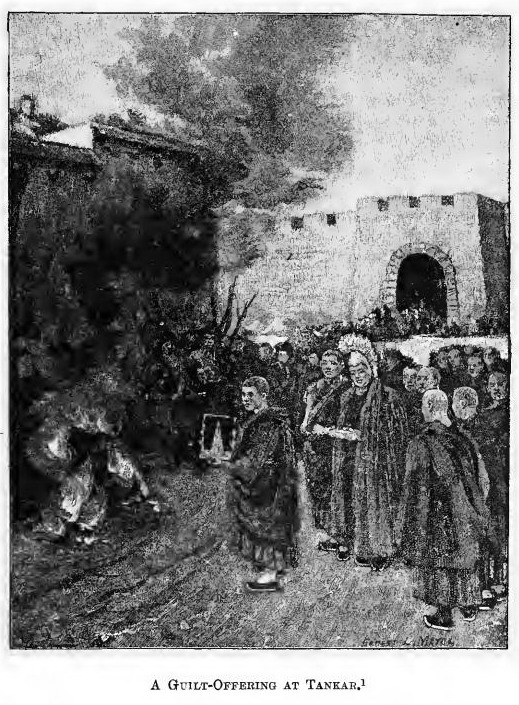
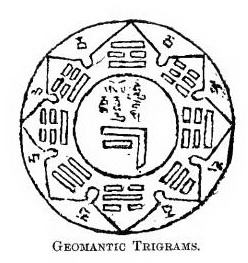
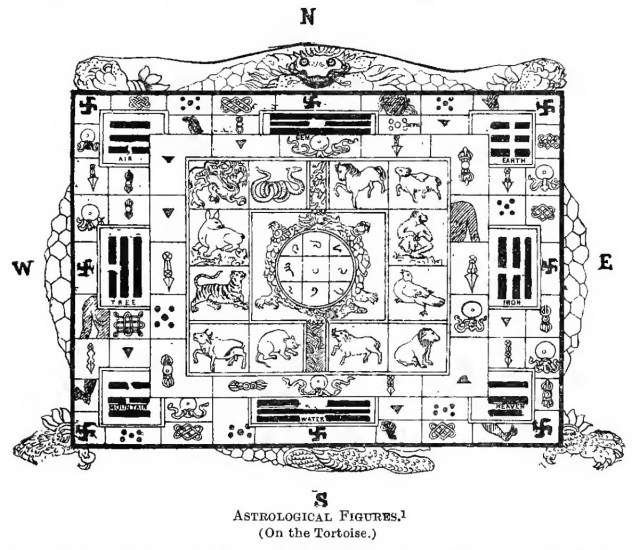















































This web site definitely has all of the information and facts I needed about this subject and didn’t know who to ask.
With havin so much written content do you ever run into any
issues of plagorism or copyright violation? My site has a lot of unique content
I’ve either written myself or outsourced but it appears a lot of it is popping
it up all over the web without my agreement. Do you know any solutions to help stop
content from being ripped off? I’d truly appreciate it.
Hello! I just wanted to ask if you ever have any issues with hackers?
My last blog (wordpress) was hacked and I ended up losing a few months of hard work due to no back up.
Do you have any methods to stop hackers?
Howdy exceptional website! Does running a blog similar to this take a large
amount of work? I have very little knowledge of programming however I had been hoping to start my own blog in the near
future. Anyway, should you have any ideas or tips for new blog owners please share.
I know this is off topic nevertheless I simply wanted to ask.
Thanks a lot!